CNG Feature Auction 124
September 19-20, 2023
Classical Numismatic Group, LLC
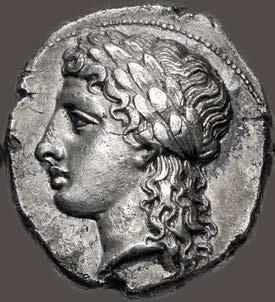
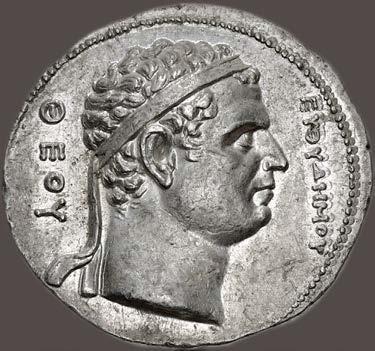
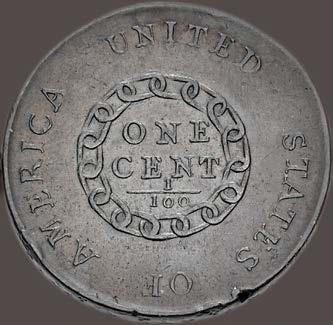
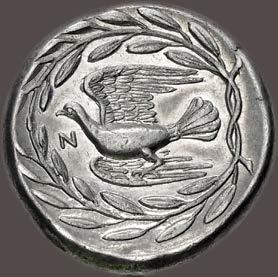
CNG
September 19–20, 2023
To Be Conducted Live Online at the CNG Lancaster Office
Featuring:
Diverse Selections from the Libertas, CJR, St. James, and James Fox Collections
Ancient Coins from the Weise Collection
Greek Coins from the GTP Collection
Two Mint State Pantikapaion Staters
A Selection of Tigranes II Tetradrachms
A Further Selection of the Denarii of Ptolemy of Mauretania
Choice Agathokles Commemorative Struck for Euthydemos I
An Excellent Portrait Tetradrachm of Antony & Cleopatra from Antioch
A Complete Run of the Muses of Q. Pomponius Musa
Extremely Rare Antony & Octavia Aureus from the Athens Mint
An Extensive Offering of Legionary Denarii of Mark Antony
Further Selections from the Gasvoda Collection of Byzantine Coins
Impressive Gold 12 Dukat of Johann Ernst von Thun und Hohenstein
Nazarana Rupee of the Last Mughal Emperor
A Rare Gold Sovereign of Queen Mary
A Majestic Mint State Elizabeth Pound
Classical Numismatic Group, LLC

US OFFICE PO Box 479, Lancaster, PA 17608-0479 Phone (717) 390.9194 Fax (717) 390.9978 UK OFFICE 20 Bloomsbury Street, London WC1B 3QA, UK Phone +44.20.7495.1888 Fax +44.20.7499.5916 EU OFFICE Noordeinde 64a, 2514GK The Hague, NL Phone +31.85.1301541 EMAIL & WEBSITE
cng@cngcoins.com Website www.cngcoins.com Pennsylvania License Number AY002406
Email
CNG Feature Auction 124
CNG
Grading Conditions
English Deutsch Français Italiano
Proof Polierte Platte Flan Bruni Fondo Specchio
Mint State/Uncirculated Stempelglanz Fleur de Coin Fior di Conio
Extremely Fine (EF) Vorzüglich Superbe Splendido
Very Fine (VF)
Sehr Schön Très Beau Bellissimo
Fine Schön Beau Molto Bello
Good/Fair Gut Bien Bello
Common Abbreviations
AD Anno Domini BE Bithynio-Pontic Era IY Indictional Year
Æ Bronze BI Billon MBS Mail Bid Sale
AE Actian Era CE Common Era mm Mintmark
AH Anno Hegirae Cf. Confer (compare) PB Lead
AR Silver c/m Countermark p. Page
AV Gold CY Civic Year (Era) pl. Plate
BBS Buy or Bid Sale EL Electrum RPE Roman Provincial Era
BC Before Christ FPL Fixed Price List RY Regnal Year
BCE Before the Common Era g Gram SE Seleukid Era
See Bibliography on our website, www.cngcoins.com, for a complete list of reference abbreviations.
Bank Accounts
Beneficiary: Classical Numismatic Group, LLC
IBAN: GB45HBUK40116071170910
BIC or SWIFT: HBUKGB4B
BIC or SWIFT: HBUKGB4B
Classical Numismatic Group, LLC is a United States limited company. Auction license number AY002406. United Kingdom Registration No. FC035702, Branch No. BR020787.
All lots in this auction were in the possession of CNG in CNG’s Lancaster, Pennsylvania office no later than 26 July 2023. This information is provided for the protection of buyers in the event that US import restrictions are introduced subsequent to that date on any of the types of coins that are included in this auction.
Notice Regarding “Slabs”
Coins that have been encapsulated (“slabbed”) by a grading and/or authentication service may not be returned for any reason, including authenticity, if they have been removed from the encapsulation (“slab”).
Acknowledgement
CNG would like to thank Jan Moens (jan.moens@bvdmc.com) for creating and providing the Numismatica Medievalis font used in this sale.
US$ Account: € Account: £ Account: PNC Bank, N.A. HSBC Bank plc HSBC Bank plc 249 Fifth Ave., Pittsburgh PA 15222 60 Queen Victoria Street, London EC4N 4TR 60 Queen Victoria Street, London EC4N 4TR Account Number: 5005069595 Account Number: 84309198 Account Number: 71170910
Number: 031000053 Sort code: 40 12 76 Sort code: 40 11 60 BIC or SWIFT:
IBAN:
ABA
PNCCUS33
GB82HBUK40127684309198
AUCTION TERMS
This is a public and Internet auction conducted by Classical Numismatic Group, LLC (CNG). Bidding in the auction constitutes acceptance of the following terms:
1. The property listed in this catalogue is offered for sale by CNG for itself and as agent for various owners and other consignors. We reserve the right to reject any bid, to determine the opening price, to set bidding increments, to vary the order of the auction, to reopen bidding in the case of a dispute, to withdraw any lot, to bid on behalf of CNG, to bid on behalf of the consignor, to permit the auctioneer to bid on his own behalf, and to permit the consignor, where reserves have been agreed, to bid on his own lots. CNG may loan or advance money to consignors or prospective bidders, and may have an interest other than commission charges in any lot. CNG may bid on its own account as an “insider” with information not available to the public.
2. A buyer’s fee will be charged to all successful bidders as follows on the hammer price:
A. 25% for written, fax, email, and telephone bids.
B. 22.5% for floor bids placed in person at the auction and electronic bids placed directly on www.cngcoins.com. All written bids, email bids, nonlive telephone bids, live internet bid registrations, and live telephone bid registrations must be received before 5PM Eastern time on the day before the auction begins. CNG reserves the right to change the format of www. cngcoins.com at any time.
3. All coins are guaranteed genuine. Attribution, date, condition, and other descriptions are the opinion of the cataloguer, and no warranty is expressed or implied. Please note that an auction sale is not an approval sale. Lots examined prior to the sale and lots purchased by floor bidders (including bidders executing commission bids on behalf of other parties) may not be returned for any reason except lack of authenticity. All claims of misdescription and all claims of return, except claims regarding authenticity, must be made within 5 days of receipt of material. No refund will be provided due to grade or “adjectival” comments by a third party grading service if a coin is submitted for grading after the sale. Any claim of lack of authenticity must be made in writing by the original purchaser immediately after discovery that an item is not authentic, and upon making such a claim the original purchaser must immediately return the lot to CNG in the same condition as at the time of the auction. Any coin returned as “not authentic” which CNG feels is genuine will be submitted to the International Association of Professional Numismatists Authentication Bureau (IBSCC) for final decision of authenticity. No refund shall be made on such coins until the IBSCC makes their determination. This includes coins that have been submitted to a third-party grading service after the auction. Coins that have been previously encapsulated (“slabbed”) by a grading and/or authentication service may not be returned for any reason, including authenticity, if they have been removed from the encapsulation (“slab”). If payment is made by credit card, rights of return are governed by these Auction Terms which supersede any rights of return promulgated by the card issuer. Estimates are intended as a guide only and not as a statement of opinion of value.
4. Invoices are due and payable immediately upon receipt. Interest and late fees of 2.0% per month, or at the highest rate permitted by law, whichever is less, from the date of the auction, shall be payable on invoices not settled within 30 days of the auction date. Payment may be made by check or bank wire. Credit cards (Visa or MasterCard) will be accepted; credit card payments will not be accepted more than 14 days after the sale date. Payment by credit card for printed sale auctions will be charged a 2.5% handling fee. Payment by check must be made in either US dollars ($) drawn on a US bank or British sterling (£) drawn on a British bank. All successful bidders outside North America and the United Kingdom will be charged an additional $20 fee for bank charges that are the result of international wire transfer fees; this fee will be deducted for credit card or check payment as described above. CNG may reduce or compromise any charge or fee at its discretion.
5. Bidders not known to us must provide us with satisfactory credit references or pay a deposit as determined at CNG’s discretion before bidding. Minors are not permitted to bid without written consent of a parent guaranteeing payment. CNG may require payment in full from any bidder prior to delivery of lots. Title does not pass until lots are paid in full. Upon receipt of lots, the buyer assumes full responsibility for loss or damage. Delivery to the buyer’s address of record shall constitute receipt by the buyer regardless of the identity of the person accepting delivery.
6. Estimates are in U.S. dollars ($US) and bids must be in even dollar ($) amounts. CNG will execute mail bids on behalf of mail bidders. Subject to reserves and opening prices, mail bids will be executed at one bidding increment (approximately 10%) over the next highest bid. In the case of identical bids, the earliest bid wins. A mail bid has priority over an identical floor bid. Bid by lot number. No lots will be broken. Bidders are responsible for errors in bidding. Check your bid sheet carefully.
7. All lots are subject to reserve unless otherwise indicated.
8. Bidders personally guarantee payment for their successful bids, including bidders executing commission bids from other parties and bidders representing corporations or other entities. Buyers accepting commission bids from other parties do so at their own risk and remain responsible for payment under these Auction Terms.
9. At the conclusion of bidding for each lot, the sale contract is concluded and the successful bidder becomes liable for immediate payment under these Auction Terms. In the event a successful bidder fails to make full payment within 30 days of the auction date, CNG reserves the right either:
(a) to require payment as provided under these Auction Terms; or (b) to deem the sale incomplete and to re-auction the material, in which case the successful bidder agrees to pay for the reasonable cost of such a sale and also to pay any shortfall between the re-auction price and the successful bidder’s purchase price. CNG reserves all rights that it is entitled to under the Pennsylvania Uniform Commercial Code, including the right to offset any sums due from a successful bidder against any future consignment or purchase or monies or goods in possession of CNG.
10. Sales tax, postage, handling and insurance are the responsibility of the buyer and are added to all invoices where appropriate. For buyers in the United Kingdom, CNG may import lots into the United Kingdom prior to shipment and charge buyers the import Value Added Tax. On any tax not paid by the purchaser which should have been paid, even if not invoiced by CNG, the purchaser agrees to pay the same on demand together with any interest or penalty that may be assessed. It is the responsibility of the buyer to comply with foreign customs and other regulations.
11. Prices realized are published after the sale and are mailed with CNG’s next publication. Prices realized are also posted after the sale on CNG’s web site: www.cngcoins.com
12. Bidders hereby waive any claim for incidental, consequential or exemplary damages arising from this auction. The sole remedy that any participant in the auction shall have for any claim or controversy arising out of the auction shall be a refund, without interest, of all or part of the purchase price paid by the participant.
13. All rights granted by CNG or otherwise available to bidders and purchasers, under these Auction Terms or otherwise, are personal and may not be assigned or transferred to any other person or entity, whether by operation of law or otherwise. No third party may rely on any benefit or right conferred by these Auction Terms. Bidders acting as agents must disclose the agency in writing to CNG prior to the auction; otherwise rights are limited to the agent and are not transferable to the undisclosed principal.
14. Any dispute regarding this auction shall be governed by the laws of Pennsylvania and shall be adjudicated only by the Lancaster County Court of Common Pleas or the U.S. District Court for the Eastern District of Pennsylvania; all bidders submit themselves to the personal jurisdiction of these courts for this purpose, consent to service of process by registered or certified mail, and waive any contrary provisions of Articles 14 or 15 of the French Civil Code and any similar provisions in any jurisdiction. All bidders consent to the confidentiality of consignors’ identities and waive any right to require disclosure of the name of the consignor or owner of any auction lot, whether such right is based on New York GOL §5-701(a) or any other provision in any jurisdiction. In any dispute regarding this auction, the prevailing party shall be entitled to recover its reasonable costs and attorney fees.





























 Mike Gasvoda Managing Director Lancaster Office
Steve Pruzinsky Chief Financial Officer Lancaster Office
Victor England Consulting Director Lancaster Office
Eric McFadden Consulting Director London Office
Dave Michaels Director Shows & Consignments Lancaster Office
Mike Gasvoda Managing Director Lancaster Office
Steve Pruzinsky Chief Financial Officer Lancaster Office
Victor England Consulting Director Lancaster Office
Eric McFadden Consulting Director London Office
Dave Michaels Director Shows & Consignments Lancaster Office
Meet the Team
Kate Rill Customer Relations Manager Lancaster Office
David James III Photographer Lancaster Office
Dylan Ossman Office Manager Lancaster Office
Julia Motter Shipping Lancaster Office
Jennifer Ventura Shipping Lancaster Office
Dawn Ahlgren Shipping Lancaster Office
Christian Ventura Photographer Lancaster Office
Travis Markel Manager IT & Production Lancaster Office
Veronica Morris Office Manager London Office
Additional
IT
A.J.
Sharon Pruzinsky Accounting Lancaster Office
Support
Consultant
Gatlin Printing Control Robert A. Trimble
Auctioneers Jeffrey B. Rill PA License No. AU006206 Brian Callahan PA License No. AU005870
Daniel Burch Numismatist Lancaster Office
Katie Vint Numismatic Intern Lancaster Office
Caroline Holmes Numismatist London Office
Bryan Kohn Numismatist Lancaster Office
Lance Hickman Managing Numismatist Consignment Staff Lancaster Office
Steve Lloyd Numismatist Islamic Specialist London Office
Julian Okun-Dubitsky Numismatist Lancaster Office
Jeffrey B. Rill Numismatist Lancaster Office
Bill Dalzell Managing Numismatist Cataloging Staff Lancaster Office
Bradley R. Nelson Senior Numismatist Lancaster Office
D. Scott VanHorn Senior Numismatist Lancaster Office
David Guest Director, London London Office
Paul Hill Director, London London Office
Max Tursi Director, EU EU Office
Tom Mullally Numismatist Lancaster Office
Participate in CNG 124 using CNG’s Bidding Portal
With the CNG Bidding Portal, you can:
• Log on and bid at any time at auctions.cngcoins.com
• View the lots, follow the bidding, and see hammer prices as they are sold
• Hear and see the auctioneer live
• Enjoy all the advantages of an auction room bidder to win your favorite lots

To bid live in this Feature auction:
• Visit our new Bidding Portal before the auction at auctions.cngcoins.com
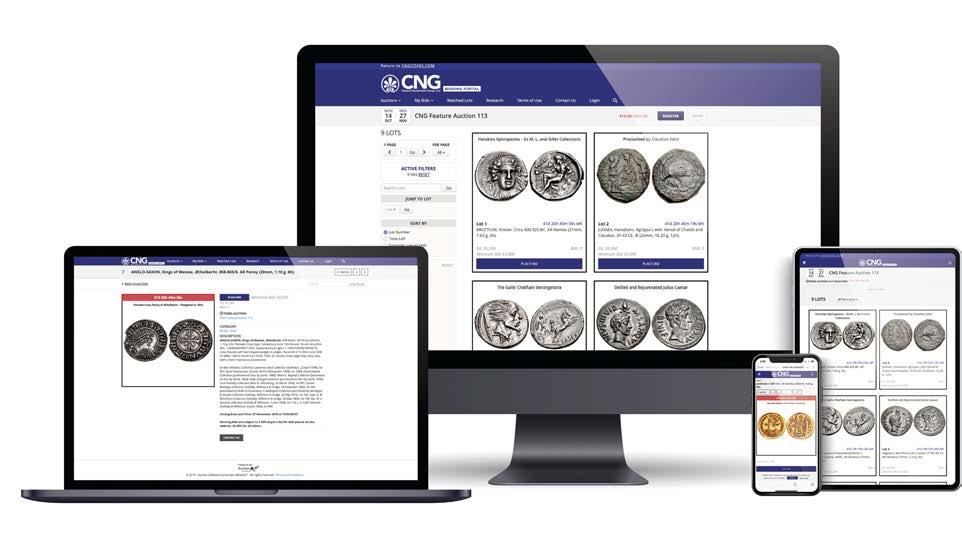
• Register online with your email address and a password

• Once approved, you may place pre-bids up until the moment the lot opens in the auction room
• On the auction day, login to join the auction and participate live
Please Note
• If you have not already registered for our bidding platform, you must create a new registration at auctions.cngcoins.com/register. Your old cngcoins.com handle and password will not allow you to log on or bid.
• You must register to bid before 5PM EST on Monday, September 18, 2023
• All lots won through the CNG Bidding Portal will be subject to a 22.5% buyer’s fee
our app today.
Download
Lot Viewing
Lancaster, PA
Auction lots may be viewed at our Lancaster Office from August 21 – September 18, 2023, by appointment only Lancaster Office Hours: 10 AM - 5 PM (Monday - Friday).
Online Viewing
Enlargements of all single lots and selected multiple lots may be viewed on the internet at
CNGCOINS.COM

NumisBids.com
We are sorry, but photographs of individual coins in multiple lots cannot be provided.
Auction Location
This Sale will be conducted live Online from our Lancaster, PA Office
Lot Pickup
Lots will be mailed from our Lancaster, PA Office subsequent to the sale
SIXBID.COM
Session One – Tuesday Morning – September 19 – 9:00 AM Celtic Coinage . . . . . . . . . . . . . . . . . . . . . . . . . . . . . . . . . . . . . . . . . . . . . . . . . . . . . . . . . . . . . . 1–8 Greek Coinage (Part 1) . . . . . . . . . . . . . . . . . . . . . . . . . . . . . . . . . . . . . . . . . . . . . . . . . . . . . 9–279 Session Two – Tuesday Afternoon – September 19 – 2:00 PM Greek Coinage (Part 2) 280–370 Oriental Greek Coinage 371–394 Central Asian Coinage 395–423 Roman Provincial Coinage 424–467 Roman Republican Coinage 468–593
Three – Wednesday Morning – September 20 – 9:00 AM Roman Imperial Coinage 594–728 Byzantine Coinage 729–779 Early Medieval Coinage 780–803 World Coinage (Part 1) 804–871 Session Four – Wednesday Afternoon – September 20 – 2:00 PM World Coinage (Part 2) 872–940 World Medals . . . . . . . . . . . . . . . . . . . . . . . . . . . . . . . . . . . . . . . . . . . . . . . . . . . . . . . . . . 941–960 United States Coinage . . . . . . . . . . . . . . . . . . . . . . . . . . . . . . . . . . . . . . . . . . . . . . . . . . . . 961–989 United States Medal . . . . . . . . . . . . . . . . . . . . . . . . . . . . . . . . . . . . . . . . . . . . . . . . . . . . . . . . . 990 British Coinage . . . . . . . . . . . . . . . . . . . . . . . . . . . . . . . . . . . . . . . . . . . . . . . . . . . . . . . . 991–1148 British Medals . . . . . . . . . . . . . . . . . . . . . . . . . . . . . . . . . . . . . . . . . . . . . . . . . . . . . . . . 1149–1151
ORDER OF SALE
Session
The CJR Collection
We are pleased to offer the first installment of the CJR Collection here. This lifetime collector, preferring to use only his initials, hails from the midwestern United States. His collecting interests have spanned many periods of history including: Greek; Roman Republican and Imperial; Byzantine; Medeival; World and US coinage. His eye for quality within the grade level he desired is exceptional and shows in the lots offered in CNG 124. Further selections from this fine collection appear in the related Esale 547 as well as other Esales this fall.
The St. George Collection
Named after his patron saint, the St. George Collection was formed by a devout gentleman whose large collection, totalling over 2,000 coins, reflects a lifetime of coin collecting. A widely-travelled, intelligent and curious man, the collection represents his deep and abiding interest in world history and its peoples. From ancient times to the modern age, the collection encompasses coins from ancient Greece and Rome, as well as early medieval and British coins and numerous world coinages from, amongst others, the U.S, China, Italy, Germany, Russia, India and the Islamic world. Highlights of the St George collection in this sale include a handsome Harold II Penny and a very high-grade Noble of Henry V. A rare and well struck gold ducat of Juan II and a mint state Dobla of Pedro the Cruel are highlights of the Spanish portion of the collection and amongst the ancient series is a rare bronze from the Sicilian Island of Lipara, a CNS plate coin previously in the Virzi collection. The above selection is just a small offering of the St. George collection, further coins will be sold in our autumn Islamic Sale and Electronic Auctions over the coming months.
8
Session 1 – Tuesday, September 19, 2023 — 9 AM
CELTIC COINAGE
Ex Flesche Collection
1. EASTERN EUROPE, Imitations of Philip II of Macedon. 3rd century BC. AR Tetradrachm (26mm, 14.11 g, 9h). Laureate head of Zeus right / Horseman riding right; below, ¬ above torch; monogram to right. OTA A2; Lanz 351; cf. CCCBM I 4; Flesche 637(this coin); KMW 963. Lightly toned with golden iridescence, patches of porosity on reverse. Near EF. ($750)
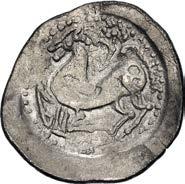
Ex Gorny & Mosch 141 (10 October 2005), lot 12; Christian Flesche Collection.
2. EASTERN EUROPE, Imitations of Philip II of Macedon. 2nd-1st centuries BC. AR Tetradrachm (27mm, 13.00 g, 5h). Zweigreiter type. Mint in the Banat region. Celticized laureate head of Zeus right / Figure on horse riding right; wreath to upper left, branch below. OTA 44A var. (rev. type left); Flesche 662; Lanz –; CCCBM I S24; KMW 1029-30. Toned, minor deposits. Good VF. Broad flan. ($2000)
Ex Mark & Lottie Salton Collection.
3. EASTERN EUROPE, Imitations of Macedonian 1st Meris. 1st century BC. AR Tetradrachm (30mm, 7.62 g, 11h). Artemiskopf type. Mint in the Transylvanian plain. Diademed and draped bust of Artemis right, bow and quiver over shoulder / Celticized horseman riding left; labrys below. Prokopov, Silver 805 var. corr. (O3/R– [unlisted rev. die]; symbol on rev. not noted); OTA 281; Flesche –; cf. Lanz 579; CCCBM I 59 and S71 (same obv. die); KMW 1203 var. (no symbol on rev.; same obv. die); Zürich –. Toned, light porosity and cleaning marks. VF. Extremely rare, only three in CoinArchives ($500)
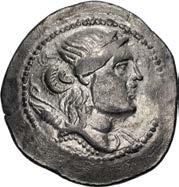
4. EASTERN EUROPE, Imitations of Thasos. Late 2nd-1st century BC. AR Tetradrachm (28.5mm, 16.62 g, 12h).
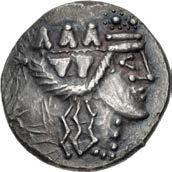
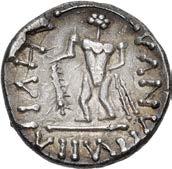

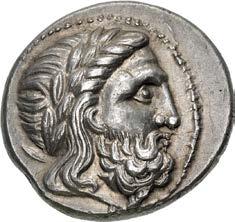
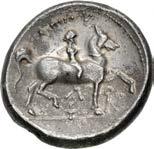
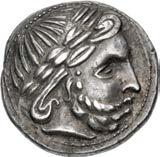
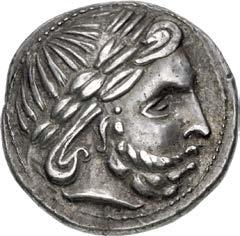
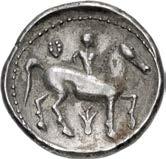
Mint in the lower Danube region. Stylized head of Dionysos right, wearing ivy wreath; schematic style / Stylized Herakles standing left, head right, holding club, lion skin draped over arm; legend highly degraded. OTA Class IV; Lukanc 1345; CCCBM I S218; Flesche 758; KMW 1533; Lanz 982; Zürich 1363. Toned, die break on reverse. Good VF. ($500)
From the W. Toliver Besson Collection. Ex Money Museum, Zurich (Triton XVIII, 6 January 2015), lot 807; Freeman & Sear FPL 5 (Spring 1998), no. 45.
9
3 4
5. CENTRAL EUROPE, Vindelici. Early 1st century BC. AV Stater (17mm, 7.66 g, 9h). ‘Vogelkopf’ type. Bird’s head left between half wreath and torc / Three pellets below torc. KMW 444; Flesche 294-5; De la Tour 9430. Lovely toning. VF. ($2000)
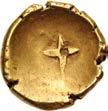
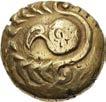

Ex Flesche Collection
6. CENTRAL EUROPE, Vindelici. Early 1st century BC. AV Stater (18mm, 7.78 g). ‘Regenbogenschüsselchen mit Stern’ type. Blank convex surface with central bulge / Four-ray star with concave circular incuse. KMW 462; Flesche 331 (this coin); de la Tour –. Toned, a few edge splits. VF. Rare. ($1500)

Ex Christian Flesche Collection; Lanz 92 (4 June 1999), lot 19.
7. GAUL, Northeast. Ambiani. Circa 58-55 BC. AV Stater (16.5mm, 6.27 g). Gallo-Belgic E. Gallic Wars Issue. Plain bulge / Large disjointed horse right; ornaments around; solid exergue line above pellets-in-crescents. Depeyrot, NC VI, 161; D&T 240; Van Arsdell 52-1; ABC 16; SCBC 11. Nicely centered and attractive. Good VF. ($1000)


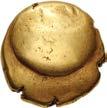
Ex Flesche Collection
8. GAUL, Northeast. Treviri. 50-30 BC. AV Stater (18mm, 5.55 g, 9h). APΔA type, Class VI. Celticized eye in profile; four stars to right, [pellets around] / Celticized horse prancing left on ground line; above, symbol flanked by pellets; star within pelleted circle below; [ÅrdÅ in exergue]. Scheers, Traité, 232; Depeyrot, NC VII 88; D&T 601 (Remi); Flesche 248 (this coin). Toned, traces of deposits, areas of peripheral weakness. Good VF. Rare. ($1000)
Ex Christian Flesche Collection; Gorny & Mosch 107 (2 April 2001), lot 1.
GREEK COINAGE




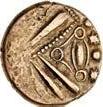
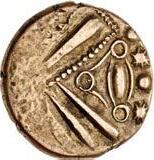
9. GAUL, Massalia. Circa 125-90 BC. AR Drachm (15mm, 2.79 g, 6h). Light standard. Diademed and draped bust of Artemis right; bow and quiver over shoulder / Lion standing right; Å between hind legs, Å below. F&P DRM-413; Depeyrot, Hellénistiques 41/3; SNG Copenhagen 764. In NGC encapsulation 6558557-021, graded MS, Strike: 5/5, Surface: 4/5. ($300)
10. GAUL, Massalia. Circa 125-90 BC. AR Drachm (15mm, 2.74 g, 6h). Light standard. Diademed and draped bust of Artemis right; bow and quiver over shoulder / Lion standing right; Å between hind legs, Å below, s between forepaws. F&P DRM-41-3 corr. (variety with s not noted) and 41-8 photo corr. (photo is not of 41-8, but this variety of 41-3); Depeyrot, Hellénistiques 41/3; SNG München 375. In NGC encapsulation 6558557-027, graded MS, Strike: 4/5, Surface: 4/5. ($300)
10
9 10 5 6 7
11. GAUL, Massalia. Circa 125-90 BC. AR Drachm (15mm, 2.70 g, 5h). Light standard. Diademed and draped bust of Artemis right, bow and quiver over shoulder / Lion standing left, raising foreleg; ¬ below, ÅZ in exergue. F&P DRM-44-2; Depeyrot, Hellénistiques 44/2; SNG Copenhagen –. In NGC encapsulation 6558557-031, graded MS, Strike: 5/5, Surface: 4/5. ($300)



12. GAUL, Massalia. Circa 125-90 BC. AR Drachm (15.5mm, 2.67 g, 6h). Light standard. Diademed and draped bust of Artemis right, bow and quiver over shoulder / Lion standing left, raising foreleg; ¬ below, ¬s in exergue. F&P DRM-44-19; Depeyrot, Hellénistiques –; SNG Copenhagen –. In NGC encapsulation 6558557-032, graded MS, Strike: 5/5, Surface: 4/5. ($300)
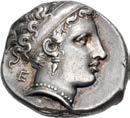
13. CAMPANIA, Neapolis. 350-325 BC. AR Nomos (20.5mm, 7.55 g, 12h). Head of nymph right, hair in band; E behind neck / Man-headed bull walking right; above, Nike flying right, placing wreath on bull’s head. Sambon 365; HN Italy 565. Beautiful iridescent tone, minor marks, slightly off center on reverse. Good VF. Fine style. A fantastic coin in hand. ($1500)
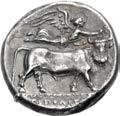



14. CAMPANIA, Neapolis. Circa 300 BC. AR Nomos (19mm, 6.02 g, 8h). Head of nymph right, wearing thick band in hair; kantharos behind neck, d5 below / Man-headed bull standing right, head facing; above, Nike flying right, crowning bull. Sambon 447; HN Italy 571. Deep iridescent tone, minor porosity. Good VF. Fine style. ($2000) Ex Ars Classica XIII (27 June 1928), lot 19.
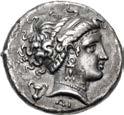
15.
Circa 480-470 BC. AR Nomos (17.5mm, 7.88 g). Taras, nude, raising hand, riding dolphin left; scallop shell below / Wheel of four spokes. Fischer-Bossert Group 4, 80 (V40/R55); Vlasto 84; HN Italy 833; SNG Fitzwilliam 225 (same dies); de Luynes 261 (same dies). Iridescent tone, edge splits. VF. ($750)
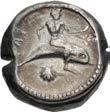
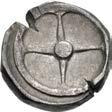
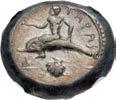
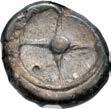
16.
480-470 BC. AR Nomos (17mm, 7.14 g). Taras, nude, raising hand, riding dolphin left; scallop shell below / Wheel of four spokes. Fischer-Bossert Group 4, 86 (V44/R58); Vlasto 84 (same dies); HN Italy 833; SNG Fitzwilliam 227 (same dies); Weber 514 (same dies). Iridescent tone. In NGC encapsulation 6054906-157, graded Ch VF, Strike: 4/5, Surface: 3/5. ($1000)
11
CALABRIA, Tarentum.
16 11 12 15
CALABRIA, Tarentum. Circa
Cited by Fischer-Bossert
17. CALABRIA, Tarentum. Circa 344-340 BC. AR Nomos (21mm, 7.69 g, 4h). Warrior, nude but for helmet, holding spear and shield, standing facing, head right, behind horse standing right; ^ to right / Phalanthos, nude, holding trident and shield, riding dolphin left; below, Å above waves. Fischer-Bossert Group 48, 678f (V259/R525 – this coin); Vlasto 516–7 (same dies); HN Italy 889; SNG ANS 963 (same dies); Pozzi (Boutin) 336-7 (same obv. die). Attractive collection tone, underlying luster, light roughness and minor die wear on reverse. Good VF. Well centered, struck with artistic dies. ($1000)
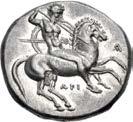
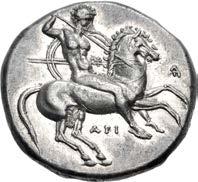
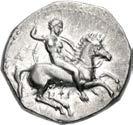
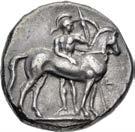
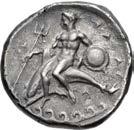
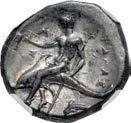
Ex Sigmund Collection (Classical Numismatic Group 118, 13 September 2021), lot 6; Peus 326 (1 November 1989), lot 40.
18. CALABRIA, Tarentum. Circa 315-302 BC. AR Nomos (20mm, 7.68 g, 7h). Warrior, nude, holding shield and two spears, preparing to cast a third, on horseback right; star on rump of horse; sÅ below / Phalanthos, nude, holding kantharos and trident, riding dolphin left; to left, W above arm, s below; below, dolphin left. Fischer-Bossert Group 73, 878 (V345/ R681); Vlasto 617; HN Italy 937; SNG Ashmolean 290 (same dies); SNG Fitzwilliam 281 (same dies). Deep iridescent tone. In NGC encapsulation 6057574-005, graded Ch XF, Strike: 5/5, Surface: 4/5, Fine Style. ($750) Ex Heritage 3094 (19 August 2021), lot 34010.

19. CALABRIA, Tarentum. Circa 315-302 BC. AR Nomos (21mm, 7.85 g, 11h). Warrior, nude, preparing to cast spear, and holding two spears and shield, on horse rearing right; Å to right, År5 below / Phalanthos, nude, holding kantharos and rudder, riding dolphin left; Å to upper left. Fischer-Bossert Group 74a, 907 (V355/R705); Vlasto 643 (same obv. die); HN Italy 939. Underlying luster, some die rust on obverse, flan flaw and die wear on reverse. EF. Well centered and struck from dies of fine style. ($1000)
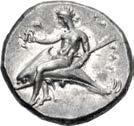
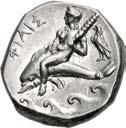
20. CALABRIA, Tarentum. Circa 290-281 BC. AR Nomos (21mm, 7.93 g, 3h). Warrior, nude, preparing to cast spear, and holding two spears and shield, riding horse leaping right; } to left, f5 below / Phalanthos, nude, holding distaff, riding dolphin left; to right, eagle, with wings closed, standing left; f5¬5s to left, waves below. Fischer-Bossert Group 78b, 1073 (V405/R827); Vlasto 571 (same dies); HN Italy 933; McClean 603 (same dies). Lustrous, some die wear on obverse. EF. ($1000)
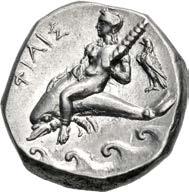
12
21. CALABRIA, Tarentum. Circa 280 BC. AR Nomos (21mm, 7.88 g, 12h). Nude youth, holding rein and crowning horse he rides right; sÅ to left, ÅrE>QW@ in two lines below / Phalanthos, nude, holding tripod, riding dolphin left; 4Ås below. Vlasto 666–7; HN Italy 957. Lightly toned, areas of luster, minor porosity and scratches. EF. Struck on a broad flan from dies of fine style. ($1000)
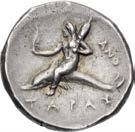
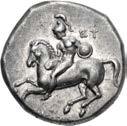
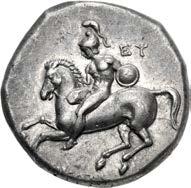

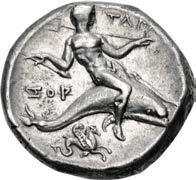
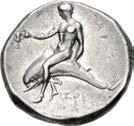
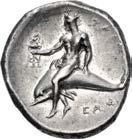
22. CALABRIA, Tarentum. Circa 280 BC. AR Nomos (21mm, 7.82 g, 5h). Nude youth, holding rein and crowning horse he rides right; ˚rÅt>5@os in two lines below / Phalanthos, nude, holding kantharos, riding dolphin left; zor below. Vlasto 678 (same dies); HN Italy 957. Underlying luster, a few light scratches on reverse. Near EF. ($750)
23. CALABRIA, Tarentum. Circa 280 BC. AR Nomos (20.5mm, 7.80 g, 10h). Warrior, nude but for helmet, shield on left arm, placing hand on head of horse he dismounts left; EU to right, [@]5˚Wt[tÅs] below / Phalanthos, nude, holding spear and trident, riding dolphin right; zor to left; below, hippocamp right. Vlasto 700; HN Italy 968. Lightly toned, underlying luster. EF. Fine style. ($1000)
24. CALABRIA, Tarentum. Circa 280-272 BC. AR Nomos (21mm, 6.53 g, 2h). Reduced standard. Nude youth, crowning self with wreath and holding reins in left, on horseback right; zW to upper left; zŬo and Ionic capital below horse / Phalanthos, nude, holding aphlaston and distaff, riding dolphin left; Å@Q to right. Vlasto 803–8; HN Italy 1014. Beautiful even gray tone, with iridescence around the devices. Good VF. ($750)
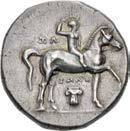
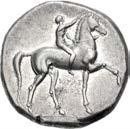

From the Otrera Collection. Ex Hansons (25 February 2021), lot 131. Includes an old B.A. Seaby’s ticket and flip, circa early 1960s.
Ex Jameson Collection
25. CALABRIA, Tarentum. Circa 280-272 BC. AR Drachm (16.5mm, 3.21 g, 6h). Helmeted head of Athena left; [EU below] / Owl standing right, head facing, on thunderbolt; sW to right, [d5o below]. Vlasto 1075–6; HN Italy 1018; Jameson 205 (this coin). Old collection tone, light cleaning scratches. Good VF. ($1500)

From the Otrera Collection, purchased from Edward J. Waddell, Ltd. (inv. 53905), 11 December 2017. Ex Triton IV (5 December 2000), lot 36; Münzen und Medaillen AG 54 (26 October 1978), lot 36; Robert Jameson Collection (1913).

13
21 22 24 25
26. CALABRIA, Tarentum. Circa 240-228 BC. AR Nomos (20mm, 6.36 g, 1h). Nude youth, holding rein and placing hand on mane, on horse leaping right; below, [zW∏Ur5W@] and facing boukranion surmounted by %W / Phalanthos, nude, holding hippocamp and trident, riding dolphin left; to right, head of Silenos left above 2. Vlasto 941 (same obv. die); HN Italy 1054. Attractively toned, with golden hues around the devices, slightly off center. EF. Early die state. ($1500)
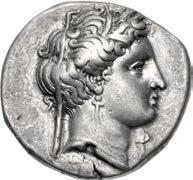

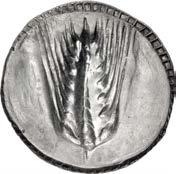

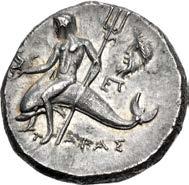


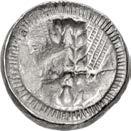
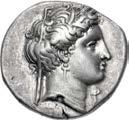
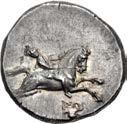
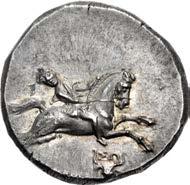
Ex Graeculus Collection (Peus 427, 4 November 2020), lot 49; Jacob Stein Collection (Gemini V, 6 January 2009), lot 9; Numismatic Fine Arts XVIII (31 March 1987), lot 8.
27. LUCANIA, Metapontion. Circa 540-510 BC. AR Nomos (29mm, 7.71 g, 12h). Barley ear with seven grains / Incuse barley ear with seven grains. Noe Class II, 40; HN Italy 1467. Bright surfaces, weakly struck, minor marks. Good VF. Struck on a broad flan. ($1000)
28. LUCANIA, Metapontion. Circa 510-470 BC. AR Nomos (23mm, 8.12 g, 12h). Ear of barley with seven grains / Incuse ear of barley with six grains. Noe Class IX, 191 (same dies); HN Italy 1482; SNG Ashmolean 657 (same dies). Toned, underlying luster, some die wear and die shift on obverse. Good VF. ($500)
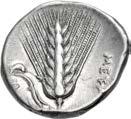
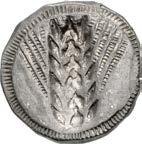
From the DFA Colection.
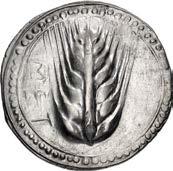
Overstruck on Akragas
14
29. LUCANIA, Metapontion. Circa 470-440 BC. AR Nomos (21mm, 7.54 g, 6h). Ear of barley with five grains; head of ram to left / Incuse ear of barley with six grains. Noe Class X, 223 (same obv. die); HN Italy 1485. Overstruck on a didrachm of Akragas (elements of the crab are visible on the obverse), die break on reverse. Good VF. ($750)
27 28
30. LUCANIA, Metapontion. Circa 340-330 BC. AR Nomos (20.5mm, 7.80 g, 7h). Wreathed head of Demeter right / Barley ear with leaf to left; mouse above leaf, f below. Johnston Class A, 8.8; HN Italy 1570; SNG ANS 419; HGC 1, 1061. Small flan flaw on obverse, sharply struck reverse. Good VF. Struck from dies of lovely style. ($750)
290-280 BC. AR
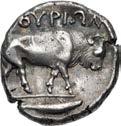
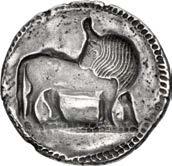
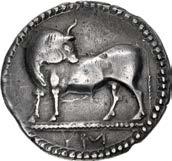
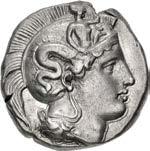
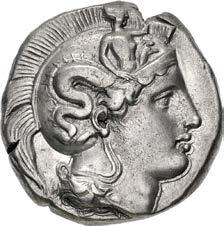
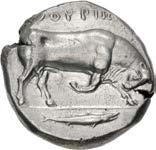
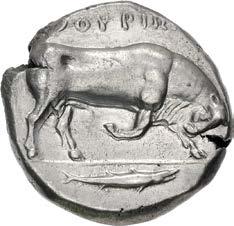
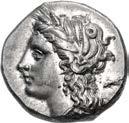
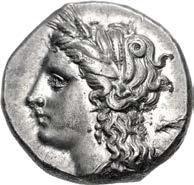
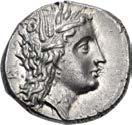
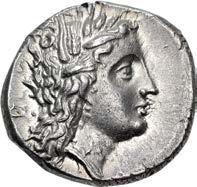
(20.5mm, 7.92 g, 3h). Wreathed head of Demeter left; d5 to right / Barley ear with leaf to right; spindle above leaf. Johnston Class D, 1.2 (same dies); HN Italy 1612; SNG ANS 507 (same obv. die); SNG Ashmolean 776 (same obv. die). Underlying luster, die rust, some die wear on reverse. EF. ($750)
Circa 290-280 BC. AR Nomos (20.5mm, 7.67 g, 3h). Wreathed head of Demeter right; d5 to left / Barley ear with leaf to left; amphora above leaf, tiny ^Å below. Johnston Class D, 3.10–1; HN Italy 1619. Underlying luster, minor roughness. EF. ($750)
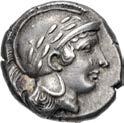
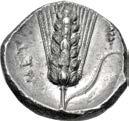
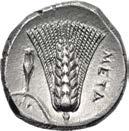

From the GTP Collection. Ex Vineyard Collection (Nomos 17, 26 October 2018), lot 15; Giessener Münzhandlung 95 (9 March 1999), lot 103.
From the DFA Collection. Ex G. Hirsch 293 (25 September 2013), lot 2049.
8.05
/
Ex de Vries Collection; Ex Noble 93 (13 April 2010), lot 4882.
15
31. LUCANIA, Metapontion. Circa
Nomos
32. LUCANIA, Metapontion.
33. LUCANIA, Sybaris. Circa 550-510 BC. AR Nomos (28.5mm,
g, 12h). Bull standing left, head right
Incuse bull standing right, head left. S&S Class B, pl. XLVIII, 4–8; Gorini 2; HN Italy 1729. Attractive collection tone, light scratches and scrapes. VF. ($1000)
34. LUCANIA, Thourioi. Circa 443-400 BC. AR Nomos (21mm, 7.94 g, 12h). Head of Athena right, wearing helmet decorated with wreath / Bull standing right, with head lowered; in exergue, fish right. HN Italy 1775; SNG ANS 900–14. Attractive old cabinet tone. Near EF. ($750)
33 34
35. LUCANIA, Thourioi. Circa 400-350 BC. AR Dinomos – Distater (25mm, 15.76 g, 1h). Head of Athena right, wearing helmet decorated with Skylla scanning / Bull butting right; in exergue, fish right. Noe, Thurian F44; HN Italy 1805; de Luynes 578. Slight obverse doubling, minor edge splits. Good VF. ($1500)
36. BRUTTIUM, Hipponion. Circa 350-300 BC. AR Stater (20mm, 8.45 g, 7h). Head of Athena right, wearing Corinthian helmet / Pegasos flying left; kerykeion below. Pegasi 1; HN Italy 2242. In NGC encapsulation 4531009-004, graded Ch XF, Strike: 5/5, Surface: 3/5. ($500)
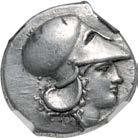
From the Otrera Collection. Ex Brighton Collection (Stack’s Bowers Galleries, 16 January 2018), lot 22010.
37. BRUTTIUM, Kroton. Circa 530-500 BC. AR Nomos (29mm, 8.85 g, 12h). Spread incuse type. Tripod, legs surmounted by wreaths and terminating in lion’s feet, two serpents rising from the bowl, set on basis of three lines, the center dotted / Incuse tripod as obverse, but wreaths and serpents in relief. Attianese 5; HN Italy 2075. Lightly toned. EF. ($1000)
38. BRUTTIUM, Kroton. Circa 530-500 BC. AR Nomos (29mm, 6.72 g, 12h). Spread incuse type. Tripod, legs surmounted by wreaths and terminating in lion’s feet, two serpents rising from the bowl, set on basis of three lines, the center dotted / Incuse tripod as obverse, but wreaths and serpents in relief. Attianese 5; HN Italy 2075. Lightly toned, with deeper area at upper edge, edge chip. Near EF. ($1000)
Ex San Vicente Collection; Numismatic Fine Arts XXXI (18 March 1993), lot 31.
39. BRUTTIUM, Kroton. Circa 530-500 BC. AR Third Nomos – Drachm (19.5mm, 2.72 g, 12h). Spread incuse type. Tripod, legs surmounted by wreaths and terminating in lion’s feet, two serpents rising from the bowl / Incuse tripod as obverse, but wreaths and serpents in relief. Attianese 16; HN Italy 2076. Lightly toned, with golden hues, some roughness, light cleaning marks. Good VF. ($500)
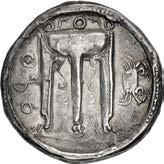
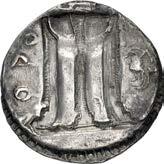

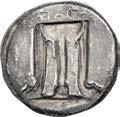
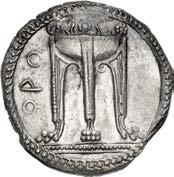
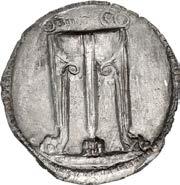
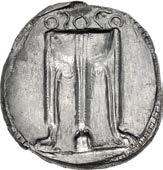
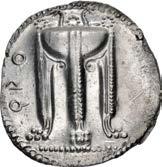
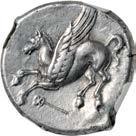
Ex Roma E-Sale 63 (7 November 2019), lot 79.
40. BRUTTIUM, Kroton. Circa 530-500 BC. AR Nomos (27mm, 7.83 g, 12h). Spread incuse type. Tripod, legs surmounted by wreaths and terminating in lion’s feet, two serpents rising from the bowl and the two outer legs below; crab to right / Incuse tripod as obverse, but wreaths and lower serpents in relief, no serpents rising from the bowl; crab to right, radiate border. Attianese 31–2 var. (ethnic on rev.); HN Italy 2078. Toned, minor die break and some weakness of strike on obverse. Good VF. ($1000)
From the DFA Collection. Ex North River Collection (Classical Numismatic Group 121, 6 October 2022), lot 85; Superior (3 December 1999), lot 1404.
16
37 38 39 40
From a Time of War
on edge. Good VF. High relief. ($10,000)
This issue of coinage corresponds to quite an eventful period in the history of Rhegion. Around 415/0 BC, the reverse type on the tetradrachms changed from a seated figure to the head of Apollo. It is thought that this significant change was precipitated by a change in regime in the city. In the mid 5th century, Rhegion was a steadfast supporter of Athenian interests in Magna Graecia, especially in 427 BC, when Rhegion provided its port as a base from which Athens could operate. By the time of the Athenian Expedition in 415 BC, however, Rhegion refused to participate, and remained neutral, an act that effectively blocked Athens’ access to the straits. The timing of the beginning of this issue roughly coincides with this event. Rhegion’s ambivalence towards Athens, though, did not translate into support for the interests of Syracuse. Perhaps wishing to distance itself from the turmoil in Sicily, Rhegion allied itself with the other major cities of southern Italy in a coalition against Dionysios I, the tyrant of Syracuse. Unfortunately, this decision proved disastrous, as Dionysios invaded Bruttium, and fought against the cities from 399-386 BC, with the result that Rhegion was reduced to near non-existence until it was refounded by Dionysios II in 360 BC. It seems likely that the bountiful tetradrachm coinage struck during this period was used to finance military activity. In any event, these coins exemplify the high aesthetic standard of the Classical Period that is common to the coins of Magna Graecia at this time. The facing lion head is rendered in a bold, detailed manner, as is the head of Apollo, carefully depicted as a serene deity. What separates these coins from their contemporaries is the depth of the relief, which was extraordinarily high. The effect is particularly striking on the obverse, where the lion head has an unsurpassed exceptional three-dimensional quality.
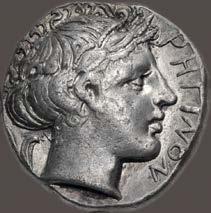
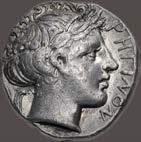

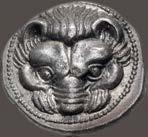
17
41. BRUTTIUM, Rhegion. Circa 415/0-387 BC. AR Tetradrachm (24mm, 17.14 g, 9h). Lion mask facing / Head of Apollo right, wearing laurel wreath; olive sprig to left, r˙˝5˜o˜ to right. Herzfelder 90bis–91 var. (D54d/R– [unlisted rev. die]); SNG ANS 661 (same obv. die); HN Italy 2496; SNG Fitzwilliam 851 (same obv. die). Iridescent tone, shallow test cut
From the Last Issue of Tetradrachms at Rhegion
flaw and light scratch on obverse. Near EF. Fine style tetradrachm from the final silver series at Rhegion.
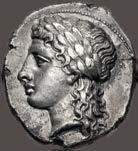
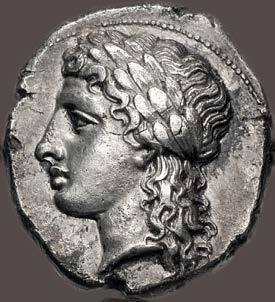
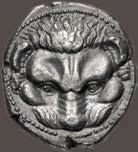
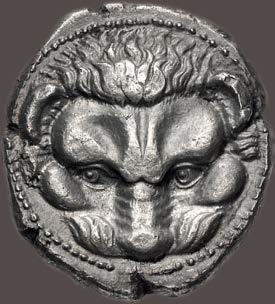
Dionysios I, after concluding a peace with the Carthaginians, went about securing his power in the island of Sicily. His troops, however, rebelled against him and sought help from, among others, the city of Rhegion (Diod. Sic. 14.8.2). In the ensuing campaigns, Dionyios I proceeded to enslave the citizens of Naxos and Katane, with whom the Rhegians shared a common history and identity (Diod. Sic. 14.40.1). This association was a source of anger and fear for the inhabitants of Rhegion. The Syracusan exiles living there also encouraged the Rhegians to go to war with Syracuse (Diod. Sic. 14.40.3). The overarching strategy of Dionysios I included extending his power into Italy by using Rhegion as a stepping stone to the rest of the peninsula. In 387 BC, after a siege that lasted eleven months, the Rhegians, on the brink of starvation, surrendered to Dionysios. Indeed, we are told that by the end of the siege, a medimnos of wheat cost about five minai (Diod. Sic. 14.111.2). Strabo remarks that, following Dionysios’ capture of the city, the Syracusan “destroyed the illustrious city” (Strabo 6.1.6).
The next decade or so of the history of Rhegion is unclear, but sometime during his reign, Dionysios II, who succeeded his father in 367 BC, rebuilt the city, giving it the new name of Phoibia (Strabo 6.1.6). Herzfelder argues that this issue was struck by Dionysios II of Syracuse after he rebuilt the city, and dates it to the period that Dionysios II is thought to have lived there. Due to civil strife at Syracuse, Dionysios II was forced to garrison Rhegion, but was ejected from the city by two of his rivals circa 351 BC (Diod. Sic. 16.45.9). This event marked the end of the silver coinage at Rhegion.
18
42. BRUTTIUM, Rhegion. Circa 356-351 BC. AR Tetradrachm (24mm, 17.11 g, 9h). Head of Apollo left, with long hair, wearing laurel wreath; [r˙˝5@os to left] / Lion mask facing. Herzfelder 115bis (D71/R97a); HN Italy 2501; SNG ANS 676 (same obv. die); SNG Lloyd 700 (same dies); BMC 36 (same dies); Jameson 460A (same dies). Toned, some find patina, flan
($20,000)
43. BRUTTIUM, Carthaginian occupation. Circa 216-211 BC. EL Three-eighths Shekel (14mm, 2.74 g, 12h). Janiform female heads, each wearing grain ear wreath / Zeus, holding thunderbolt in right hand, scepter in left, standing in quadriga right, driven by Nike, who stands beside him, holding reins. Robinson, Second, pl. V, 3 (Capua); Jenkins & Lewis 487–93 (Capua); CNP 290; HN Italy 2013. Light roughness, a couple of minor scrapes on obverse. VF. ($2000)
Ex Numismatica Ars Classica 72 (16 May 2013), lot 282 (as Capua in Campania).
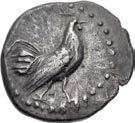
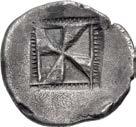

44. SICILY, Akragas. Circa 495-485 BC. AR Didrachm (16.5mm, 7.75 g, 11h). Sea eagle standing left / Crab within incuse circle. Westermark, Coinage, Period I, Group II, 141 (O57/R87); HGC 2, 93; SNG ANS 926 (same obv. die); SNG Delepierre 520 (same dies); BMC 12 (same obv. die). Lightly toned, underlying luster. Near EF. Well centered. ($2000)
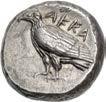
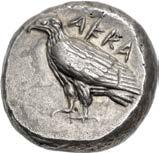
Ex Father & Son Collection (Classical Numismatic Group 118, 13 September 2021), lot 46; Triton XXII (8 January 2019), lot 108.
45. SICILY, Entella. Punic issues. Circa 300-289 BC. AR Tetradrachm (26mm, 17.03 g, 3h). Head of Herakles right, wearing lion skin / Head of horse left; palm tree to right, [†n]JM∆M[`] (Punic ‘MHMḤNT) below. Jenkins, Punic, Series 5a, 285 (O91/R233); CNP 271; HGC 2, 293. Slightly irregular flan, die break on obverse. Superb EF. High relief. ($1500)
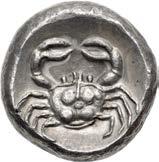
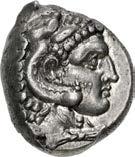
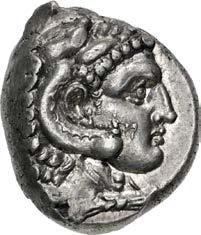
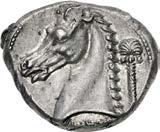
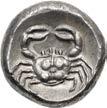
46. SICILY, Gela. Circa 480/75-475/70 BC. AR Drachm (20mm, 3.80 g, 11h). Nude horseman riding right, preparing to cast javelin / Forepart of man-headed bull running right. Jenkins, Gela Group III, 188 (O51/R109); HGC 2, 368. Lightly toned, obverse slightly off center, minor deposits, scratches. VF. Extremely rare – only six examples recorded by Jenkins, plus two further on CoinArchives. ($2000)



Ex Mercury Group Collection (Classical Numismatic Group Electronic Auction 500, 22 September 2021), lot 52; Freeman & Sear 8 (5 February 2003), lot 47.
47. SICILY, Himera. Circa 530-520/15 BC. AR Drachm (21.5mm, 5.46 g). Cock standing right / Incuse square with mill-sail pattern enclosed within segmented linear border. Kraay Group II, 31 (O20/R20); HGC 2, 420; Boston MFA 249 = Warren 235 (same dies); Dewing 610 (same dies). Old collection tone, granular surfaces. VF. ($500)
From the Libertas Collection.
19
46
47
48. SICILY, Kamarina. Circa 425-405 BC. AR Tetradrachm (26mm, 16.42 g, 7h). Athena, wearing crested Attic helmet and long chiton, holding kentron in right hand and reins in both, driving galloping quadriga right; above, Nike flying left, preparing to crown Athena with wreath held in both hands; in exergue, two amphorai dividing ˚ÅÂ-Å-r5@Å / Beardless head of Herakles left, wearing lion skin headdress tied at neck; bow to left. Westermark & Jenkins 152 (O10/R19); HGC 2, 526; SNG Fitzwilliam 945 (same dies); SNG Stockholm 431 = Pozzi 400 (same dies); Athena Fund I 1 (same dies); BMC 13 (same dies); Gillet 368 = Rizzo pl. V, 15 (same dies); Jameson 525a (same dies); Weber 1246 (same dies). Toned, minor double strike, minor marks, light scuff on reverse. Good VF. ($5000)
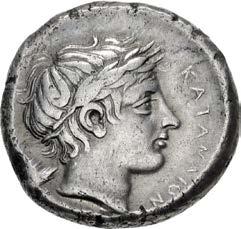
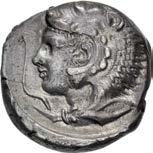

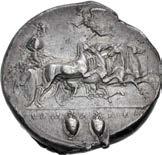
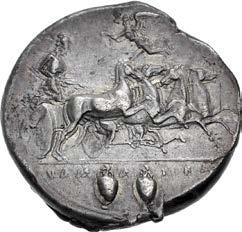
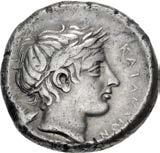
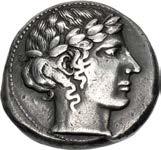
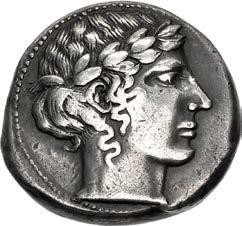
The “Maestro della Foglia”
49. SICILY, Katane. Circa 435-412 BC. AR Tetradrachm (25.5mm, 17.03 g, 6h). Reverse die signed by the “Maestro della foglia”. Charioteer, wearing long chiton, holding kentron in left hand and reins in both, driving fast quadriga of horses right; above, Nike flying right, crowning horses with wreath held in both hands / Head of Apollo right, wearing laurel wreath; plane leaf to left (signature), ˚ÅtÅ@Å5o@ to right. Mirone –; HGC 2, 572 (same dies as illustration); SNG ANS 1256; SNG Lloyd 898; Gillet 392; Gulbenkian 185 = Jameson 541; Pozzi 417; Rizzo pl. XII, 11 (all from the same dies). Lightly toned, minor pitting and marks, some light cleaning scratches on reverse. VF. Elegant style. ($5000)
During the second half of the 5th century the design of the Katanian tetradrachms underwent a radical change with the introduction of a racing chariot on the obverse and a head of Apollo on the reverse. While reflecting dramatic stylistic developments, these types were to remain relatively unchanged down to the time of the capture of the city in 404 BC by Dionysios, tyrant of Syracuse, who sold the population into slavery. The “Maestro della foglia” or “Master of the Leaf” is the appellation that Rizzo gave to the master engraver who began the transformation of Katanian coin design. The driver and horses come alive, as if they truly are trying to win the race, rather than merely posing. The face of Apollo begins to carry a hint of a bemused expression, and his locks of hair become more unruly. Over the course of the next decade the successors to this master – Euainetos, Herakleidas, and Choirion – would produce their own unrivaled masterpieces.
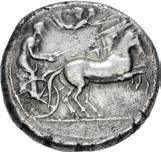
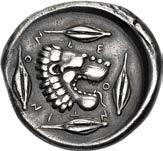
Boehringer Plate Coin – Pedigreed to 1930
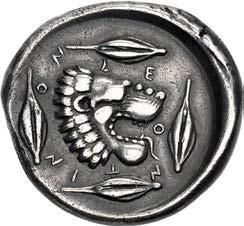
20
50. SICILY, Leontini. Circa 450-440 BC. AR Tetradrachm (26.5mm, 17.12 g, 6h). Laureate head of Apollo right / Head of lion right; four barley grains around. Boehringer, Münzgeschichte 47 (this coin illustrated); HGC 2, 667; SNG ANS 244 (same dies); Rizzo pl. XXIII, 16 (same dies). Old cabinet tone, with slight iridescence on the reverse, minor marks. VF. ($1500)
Ex A. Hess 254 (8 March 1983), lot 77; Ars Classica XV (2 July 1930), lot 294.
Ex
Collection of a Connoisseur - Harald Salvesen
Leontini. Circa 430-425 BC. AR Tetradrachm (24mm, 17.82 g, 1h). Head of Apollo left, wearing laurel wreath / Head of roaring lion right; 6E-o-n-t5-n-on around; three barley grains above, to left, and below; leaf behind. Boehringer, Münzgeschichte 55 (same dies); HGC 2, 671 (same dies as illustration); SNG ANS 257 (same dies); SNG Lloyd 1063 (same obv. die); Basel 353 (same dies); Rizzo pl. XXIV, 4 (same dies). Wonderful cabinet tone. Choice EF. Well centered and struck on a broad flan. ($6000)
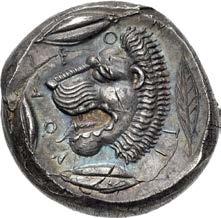
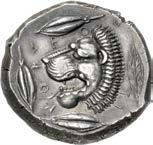
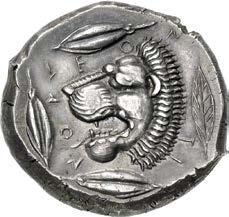
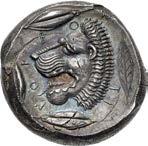
Ex Harald Salvesen Collection, purchased from Classical Numismatic Group, 1990s.
This attractive tetradrachm was probably struck about two decades after the initial introduction of the Apollo / Lion type. While early heads of Apollo were rendered in a highly stylized manner, here he appears as an idealized human. Apollo was especially revered at Leontini, as he was at the mother city of Naxos where there was a famous sanctuary of Apollo Archegetes. The lion was the emblem of Apollo but probably also represents a punning allusion to the city name. The surrounding barley-grains are indicative of the exceptional fertility of the Leontine territory and doubtless refer to the local worship of Demeter, the goddess of agriculture.
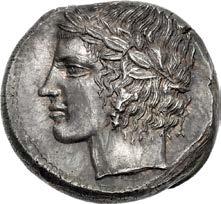
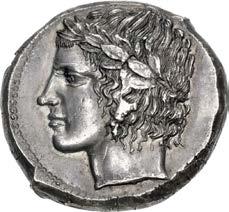
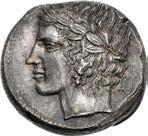
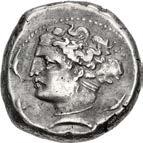
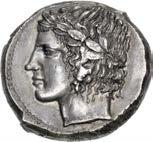
52.
AR Tetradrachm (23mm, 17.55 g, 10h). Head of Apollo left, wearing laurel wreath / Head of roaring lion right; 6E-o-n-t5-n-on around; three barley grains above, to left, and below; leaf behind. Boehringer, Münzgeschichte 55 (same dies); HGC 2, 671 (same dies as illustration); SNG ANS 257 (same dies); SNG Lloyd 1063 (same obv. die); Basel 353 (same dies); Rizzo pl. XXIV, 4 (same dies). Beautiful iridescent tone, minor flan flaws. EF. Not suitable for encapsulation. Includes IBSCC certificate of authenticity ($3000)
Ex Numismatica Genevensis SA 16 (14 November 2022), lot 9 (hammer CHF 6000); Sincona 1 (29 June 2011), lot 4.
Circa
AR Tetradrachm (22mm, 17.37 g, 9h). Head of Arethousa left, hair in ampyx and sakkos, wearing triple-pendant earring and pearl necklace; four dolphins swimming around / Crab. Jenkins, Punic 47 (O6/ R9 [but earlier die state of obverse]); Campana 22; CNP 502; HGC 2, 923 (same dies as illustration); Jameson 667 (same dies). Lightly toned, some porosity, minor marks, struck with worn obverse die. VF. ($5000)
In his die study, Jenkins did not notice that the obverse die for this series (O6) was reengraved at some point, which is easily discerned by the absence (early) or presence (late) of small hairs at the crown of Arethousa’s head. The two die states are visible in his plate coins for die combinations 46 and 47, respectively.
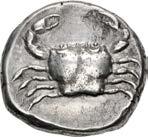
21
51. SICILY,
SICILY, Leontini. Circa 430-425 BC.
53. SICILY, Motya.
400-397 BC.
54. SICILY, Naxos. Circa 415-403 BC. AR Didrachm (21mm, 8.39 g, 12h). Youthful head of Apollo right, wearing laurel wreath; olive leaf and berry behind neck, @Å$5W@ to right / Silenos, nude and bearded, squatting half-left, holding kantharos in right hand and thyrsos in left; ithyphallic herm to left, ivy branch to right. Cahn 108 (V71/R90); Campana 22; HGC 2, 987 (same dies as illustration); SNG Copenhagen 494 (same dies); Hunterian 10 (same dies); Jameson 680 (same dies); Pozzi 512 (same dies). Toned, minor marks, flan flaw on obverse. VF. ($10,000)
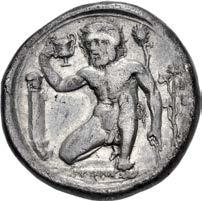
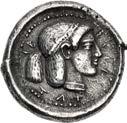
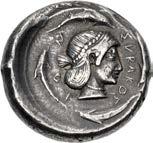
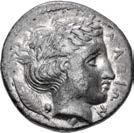
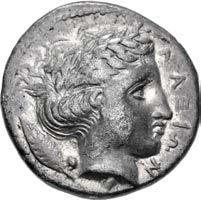
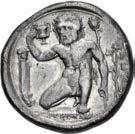
Hurter Plate Coin
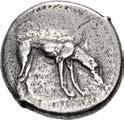
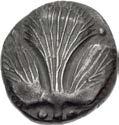
55. SICILY, Segesta. Circa 475/0-455/0 BC. AR Didrachm (20.5mm, 8.40 g, 8h). Hound scenting right / Head of Aigiste right. Hurter, Didrachmenprägung 40a (V12/R22 – this coin, illustrated); HGC 2, 1113. Lightly toned, porous, some smoothing in fields on obverse. VF. ($750)
From the Weise Collection. Ex Tony Hardy Collection (Classical Numismatic Group 67, 22 September 2004), lot 322.
Pedigreed to 1956
56. SICILY, Selinos. Circa 540-515 BC. AR Didrachm (20mm, 8.39 g). Selinon leaf; four pellets around / Incuse square divided into ten sections. Arnold-Biucchi Group I, 2 var. (no pellets); Selinus Hoard 10–7; HGC 2, 1209. Deep old collection tone, deposits, light cleaning scratches on reverse. VF. ($750)
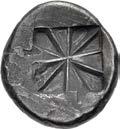
From the Libertas Collection, purchased 31 January 1984. Ex Coin Galleries (9 March 1956), lot 1525.
57. SICILY, Syracuse. Hieron I. 478-466 BC. AR Tetradrachm (24.5mm, 17.29 g, 10h). Struck circa 478-475 BC. Charioteer driving slow quadriga right; above, Nike flying right, crowning horses / Head of Arethousa right, wearing tainia; four dolphins around. Boehringer Series VIIIa, 113 (V51/R78); HGC 2, 1306. Old collection tone, with some iridescence, slightly off center. VF. ($2000)
Ex Bertolami Fine Arts E-Auction 105 (21 October 2021), lot 716.
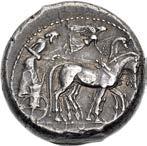
22
Pedigreed to 1888
58. SICILY, Syracuse. Second Democracy. 466-405 BC. AR Tetradrachm (23.5mm, 17.29 g, 12h). Struck circa 466460 BC. Charioteer driving slow quadriga right; above, Nike flying left, crowning charioteer; in exergue, ketos right / Head of Arethousa right, wearing pearl tainia; four dolphins around. Boehringer Series XIVb, 489 (V258/R351); HGC 2, 1312; SNG Lockett 927 (this coin); McClean 2656 (same dies); Pozzi 576 (same dies). Old cabinet tone. In NGC encapsulation 4373035004, graded Ch VF, Strike: 4/5, Surface: 3/5, lt. graffito, inked collection number. ($1500)
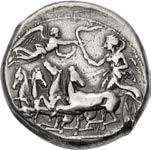
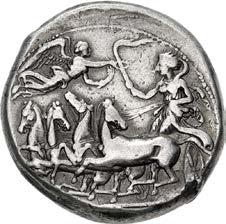
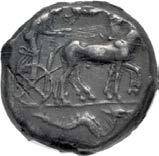

From the Otrera Collection. Ex Goldberg 103 (20 February 2018), lot 2009; Michael L. Fograty Collection (Stack’s Bowers Galleries, 12 January 2017), lot 5031; Numismatic Fine Arts [XVII] (27 June 1986), lot 114; Johns Hopkins University Collection [inv. 31.1.133] (Part III, Numismatic Fine Arts & Bank Leu, 29 March 1985), lot 120 (second coin); Wolfgang Helbig Collection [inv. 538, donated to Johns Hopkins University, 1888].
Signed by Phrygillos
59. SICILY, Syracuse. Second Democracy. 466-405 BC. AR Tetradrachm (25.5mm, 17.12 g, 3h). Obverse die signed by Phrygillos. Struck circa 415-409 BC. Head of Arethousa left, hair in ampyx, inscribed f[rU], and sphendone, wearing single-pendant earring; s¨rÅ˚os5o˜ above, four dolphins around / Charioteer, holding flaming torch in right hand and reins in left, driving fast quadriga left; above, Nike flying right, crowning charioteer with open wreath held in her extended hands; in exergue, grain ear left. Fischer-Bossert, Coins 51 (O18/R30); Tudeer 51; HGC 2, 1335; SNG Fitzwilliam 1246 (same dies); BMC 160 (same dies); Rizzo pl. XLIII, 13 = de Luynes 1216 (same dies); Weber 1604 (same dies). Attractive light toning. VF. ($5000)
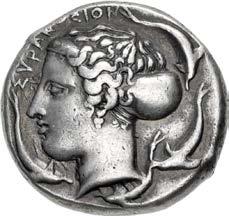
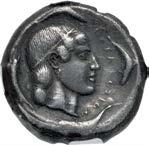
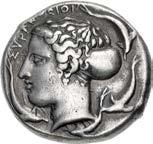

The magnificent artistic flowering in Sicily in the 5th century BC has its origins in times of great strife. By the middle of the century, the situation began to resemble that of Renaissance Italy, where local princes engaged in continual warfare among themselves while employing the finest artists and craftsmen of their time. The result was the patronizing of some of the most talented coin engravers in history. In Syracuse, by the late 5th century BC these engravers were proudly signing their work, preserving the names of Kimon, Euainetos, Eumenos, Sosion, Herakleidas, Eukleidas and others for posterity. Their handiwork included several collaborative efforts, including coins with obverse and reverse dies signed by different artists.
,
23
60. SICILY, Syracuse. Second Democracy. 466-405 BC. Æ Hemilitron (15.5mm, 4.02 g, 7h). Obverse die signed by Eu- (Eukleidas or Euainetos?). Struck circa 405 BC. Head of Arethousa left, hair gathered in amphyx and sphendone; EU on amphyx, grain ear behind / Wheel of four spokes; ethnic in upper quarters, dolphins in lower quarters. Holloway, Further
Series 3; CNS 22; HGC 2, 1479. Brown surfaces. EF. Well struck, and attractive for issue, with a clear signature. ($500)
Superb Syracusan “Pegasos”
61. SICILY, Syracuse. Timoleon and the Third Democracy. 344-317 BC. AR Stater (20mm, 8.67 g, 9h). Struck under Timoleon, 344-339/8. Pegasos flying left / Head of Athena right, wearing Corinthian helmet. Pegasi 2; HGC 2, 1400. Lightly toned with warm golden luster around the devices. Superb EF. An exquisite, wonderfully detailed example. ($3000)

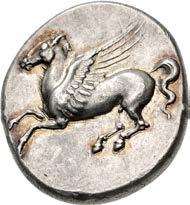
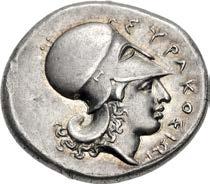
Ex E. Hyrcyna Collection; Peus 392 (4 May 2007), lot 4206.
By the early 4th century BC, Syracuse had become highly factionalized, and the political turmoil was taken advantage of by the Carthaginians. Eventually a delegation was sent by the Syracusans to Corinth to appeal to their mother city for help. Timoleon, from a prominent Corinthian family, was chosen to take control of Syracuse, drive the Carthaginian-backed government from power, and restore tranquility and prosperity to the great Sicilian city. In this endeavor Timoleon was successful, and his rule sparked a cultural and political revival. In contrast to most political strongmen of the age, termed tyrants, Timoleon never abused his power and abided by the limits of the democratic constitution he helped to create. After five years in power, he retired from public life, although his opinion was frequently sought and respected by his successors. His ascendancy is reflected in the city’s coinage, including this beautiful silver stater. While superficially mimicking the popular Corinthian “Pegasi” circulating widely in Greece, the style, relief and execution are all uniquely Syracusan.

62. SICILY, Syracuse. Timoleon and the Third Democracy. 344-317 BC. Æ Hemidrachm (24mm, 14.96 g, 11h). Timoleontic Symmachy coinage. 1st series, circa 344-339/8 BC. Laureate head of Zeus Eleutherios right / Upright thunderbolt; to right, eagle standing right. Castrizio series I, 1γ; CNS 72; HGC 2, 1440. Dark green-brown patina, trace deposits, minor edge split. Near EF. ($750)
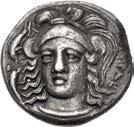


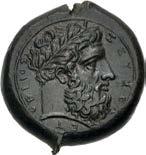
From the James Fox Collection. Ex Waddell II (2 September 1987), lot 80.
63. SICILY, Syracuse. Timoleon and the Third Democracy. 344-317 BC. AR Hemidrachm (14mm, 1.97 g, 12h). Attic standard. Helmeted head of Athena facing slightly left; three dolphins around / Horseman riding right; star and grain ear to
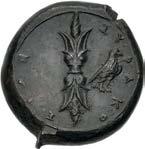
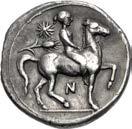
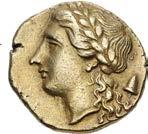

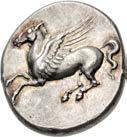
From
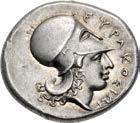
Ex Hunt Collection
24
left, @ below. HGC 2, 1370; SNG ANS 522; SNG Lloyd 1450. Toned, edge chip, some granularity along edge. VF. ($500)
the Weise Collection. Ex Classical Numismatic Group 97 (17 September 2014), lot 42.
64. SICILY, Syracuse. Agathokles. 317-289 BC. EL 50 Litrai – Hemistater (15mm, 3.40 g, 7h). Struck circa 306/5 BC. Laureate head of Apollo left; pilos to right / Tripod. Jenkins, Electrum, Group B, unlisted obv. die; BAR Issue 10; HGC 2, 1294; Hunt Sale II 281 (this coin). Faintly toned, minor marks. Good VF. ($1500)
From the Libertas Collection. Ex Nelson Bunker Hunt Collection (Part II, Sotheby’s New York, 21 June 1990), lot 281.
65. SICILY, Syracuse. Agathokles. 317-289 BC. AR Stater (18.5mm, 6.76 g, 11h). Reduced standard. Struck circa 304-289 BC. Helmeted head of Athena left / Pegasos flying left; triskeles below. Pegasi 17; BAR Issue 32; HGC 2, 1408. Lightly toned, trace deposits. Near EF. Well centered. ($1000)
From the Libertas Collection, purchased 28 July 1980.
Ex David Freedman Collection
66. SICILY, Syracuse. Hieron II. 275-215 BC. Æ Tetras (16mm, 3.28 g, 7h). Struck circa 269-263 BC. Head of Artemis left, hair in ampyx and sphendone; poppy head to right / Pegasos flying left. CNS 202 Ds 102; BAR issue 58; HGC 2, 1551. Dark green patina, small flaw on obverse, light encrustation on reverse. EF ($500)
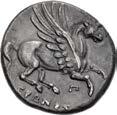

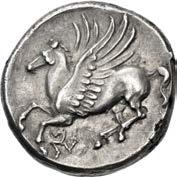
Ex Triton XII (6 January 2009), lot 113; Triton VIII (11 January 2005), lot 97; David Freedman Collection (Triton V, 15 January 2002), lot 268.
67. SICILY, Syracuse. Hieron II. 275-215 BC. AR Stater (19mm, 5.64 g, 5h). Reduced Corinthian standard. Struck circa 265-263 BC. Helmeted head of Athena left; altar to right / Pegasos flying right; π below. Carroccio 21–3 var. (D13/R–[unlisted rev. die]); BAR Issue 56; HGC 2, 1543 corr. (control marks); SNG Lloyd 1541 = Weber 1701 (same obv. die). Old collection tone, some find patina, tiny marks on obverse. Good VF. ($1000)
From the Libertas Collection, purchased 31 January 1984.
68. SICILY, Syracuse. Philistis, wife of Hieron II. 275-215 BC. AR 5 Litrai – Drachm (17.5mm, 4.42 g, 7h). Struck circa 217-215 BC. Diademed and veiled bust left; branch to right / Nike driving fast biga left; E to left. CCO 221 (D2/R2); BAR Issue 68; HGC 2, 1557; SNG ANS 893 (same dies); SNG Lloyd 1546 (same dies); Bement 556 (same dies); McClean 2918 (same dies). Iridescent tone, hairline flan crack. Good VF. Well centered. ($750)
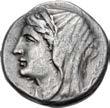
From the Weise Collection. Ex Classical Numismatic Group 53 (15 March 2000), lot 137.
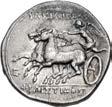
Ex Lockett Collection – Pedigreed to 1923
69. SICILY, Syracuse. Gelon, son of Hieron II. 275-215 BC. AR 8 Litrai – Didrachm (20mm, 6.65 g, 12h). Struck circa 217-215 BC. Diademed head left / Nike driving slow right; ∫Å above, f to right. CCO 281.5 and 7 (D1/R1) = SNG Lockett 1018 (this coin); BAR Issue 66; HGC 2, 1562; SNG Fitzwilliam 1408 (same dies). Old collection tone, small flan flaw on reverse. Good VF. ($1500)
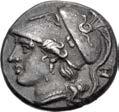
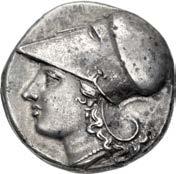


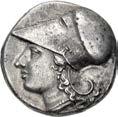
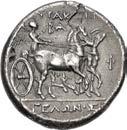
From the Weise Collection. Ex Triton IV (5 December 2000), lot 114; Richard Cyril Lockett Collection (Greek Part I, Glendining, 25 October 1955), lot 923; Naville V (18 June 1923), lot 1214.

25
68 67
70. SICILY, Syracuse. Fifth Democracy. 214-212 BC. AR 12 Litrai (24.5mm, 10.22 g, 3h). Helmeted head of Athena left / Artemis standing left, drawing bow; on her far side, hound springing left; xÅ to left. Burnett, Enna 20 (dies 8/m); BAR Issue 84; SNG Copenhagen 878 (same obv. die); McClean 2957 (same obv. die). Toned, some die wear. Good VF. ($1500)
Ex Triton VII (13 January 2004), lot 120; Numismatic Fine Arts IV (24 March 1977), lot 108.
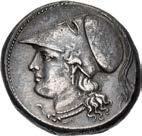
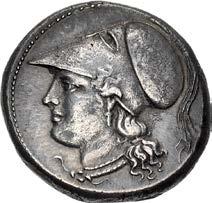
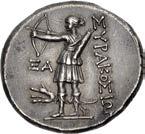
Ex Brand Collection – Pedigreed to 1907
71. SICILY, Syracuse. Fifth Democracy. 214-212 BC. AR 12 Litrai (23mm, 10.21 g, 5h). Helmeted head of Athena left / Artemis standing left, drawing bow; on her far side, hound springing left; xÅ to left. Burnett, Enna 24 (dies 9/q); BAR Issue 84; SNG ANS 1040 (same dies); SNG Fitzwilliam 1436 (same dies); Pozzi 664 (same dies). Toned, a little die wear. EF. ($3000)
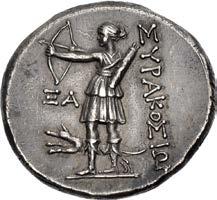
From the Otrera Collection, purchased from Terrasini Ancient Coins. Ex Triton XIX (5 January 2016), lot 68; G. Hirsch 275 (22 September 2011), lot 3328; Virgil M. Brand Collection (Part 3, Sotheby’s, 9 June 1983), lot 42; A. Hess (7 October 1907), lot 1706 (both Hirsch and Brand erroneously list this coin as being a Berlin Museum duplicate, but it is from a later part of the Hess sale, containing coins from other consignors).
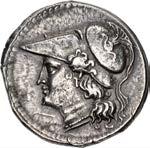
72. SICILY, Uncertain Punic mint. Circa 300 BC. AR Litra (9mm, 0.71 g, 2h). Bare head of female (Arethousa or Tanit?) left / Head of horse right. Jenkins, Punic, Addenda p. 58, E–F; CNP 263; HGC 2, –. Deep iridescent tone, slight doubling on obverse. Near EF. Extremely rare, only three examples noted by Jenkins, one additional by CNP, five additional in CoinArchives. ($750)



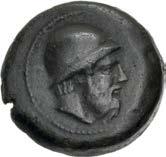
Ex ArtCoins Roma 15 (27 April 2015), lot 125.
Two possible mints have been mentioned in the literature. Based on the types, Jenkins suggested this issue may belong to the long RSMLQRT series (later placed at Entella), while CNP suggested Panormos.
CNS Plate Coin – Ex Olphin and Virzi Collections
73. ISLANDS off SICILY, Lipara. Circa 440-420 BC. Æ Hexas (27mm, 15.28 g, 1h). Head of Aiolos right, wearing pilos / Retrograde ethnic; two pellets (mark of value) above and below. Manganaro, Vittoria 126 = CNS 6/2 = Virzi 2090 (this coin); HGC 2, 1763. Dark green patina. VF. Rare and attractive. ($750)
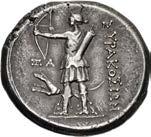

From the St. George Collection. Ex J. Olphin Collection (CNG inventory 851569; August 2009); Triton III (30 November 1999), lot 359; Thomas Virzi Collection (photofile), 2090.
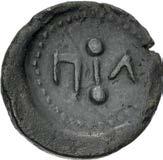
26
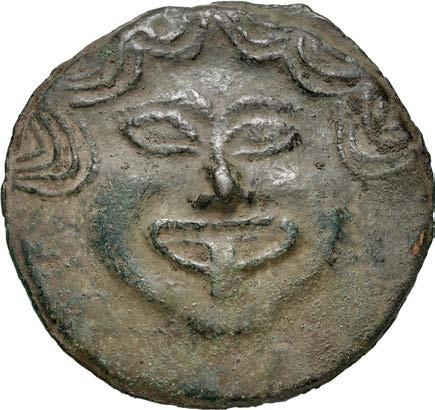
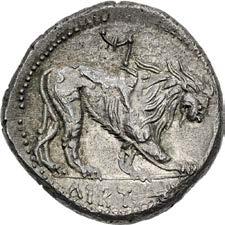
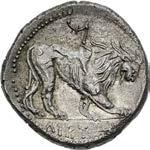
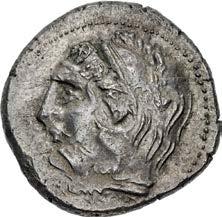
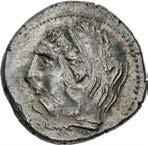
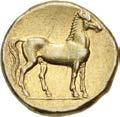
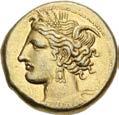

27
74. CARTHAGE. Circa 290-270 BC. EL Stater (19mm, 7.49 g, 11h). Carthage mint. Wreathed head of Tanit left, wearing necklace with ten pendants / Horse standing right on exergue line. Jenkins & Lewis Group VII, 345; CNP 2.6b; MAA 13; SNG Copenhagen 988. A few minor die breaks, faint graffito on reverse. Near EF. ($2000)
75. CARTHAGE, Libyan Revolt. Circa 241-238 BC. BI Shekel (25mm, 9.04 g, 11h). Head of Herakles left, wearing lion skin / Lion standing right; M (Punic M) above. Carradice & La Niece 1; CNP 433b; MAA 53; SNG Copenhagen 239–43. Toned, trace deposits, overstruck on an earlier Carthaginian issue (type: head of Tanit left / Horse standing right, pellet between hind legs, possibly CNP 51b). Near EF. Well struck for issue. ($1000)
76. SKYTHIA, Olbia. Circa 437-410 BC. Cast Æ (68.5mm, 127.07 g, 1h). Facing gorgoneion / Sea eagle flying right, wings spread, holding in its talons a dolphin right; Å-r-5-c around. Anokhin 168; Karyshkovskij p. 395, Таб. III=C, 2; Frolova & Abramzon 156–8; HGC 3, 1881. Dark green patina with light earthen dusting. VF. ($1000)
Ex Classical Numismatic Group 105 (10 May 2017), lot 42.
77. SKYTHIA, Olbia. Circa 437-410 BC. Cast Æ (68mm, 135.23 g, 1h). Facing gorgoneion / Sea eagle flying right, wings spread, holding in its talons a dolphin right; Å-r-5-c around. Anokhin 168; Karyshkovskij p. 396, Таб. IV=A, 1; Frolova & Abramzon 143–59 var. (orientation of ethnic); HGC 3, 1881. Earthen green patina. Near VF. ($1000)
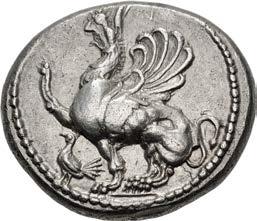
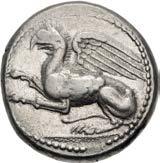

Ex Classical Numismatic Group Electronic Auction 394 (29 March 2017), lot 117.
78. THRACE, Abdera. Circa 450-425 BC. AR Tetradrachm (26.5mm, 14.77 g, 5h). Herodoto(s), magistrate. Griffin with curved wing seated left, raising left forepaw; to lower left, cock standing left / Eπ ˙-ro-do-to around raised quadripartite incuse square; all within shallow incuse square. May, Abdera, Period IV, 132 (A111/P108); AMNG II 50; HGC 3, 1136; SNG Spencer 98 (same dies); BMC 67 (same dies); Berlin 28–9 (same dies); de Luynes 1748 (same dies). Minor flan crack, some porosity, light marks. Near EF. ($5000)
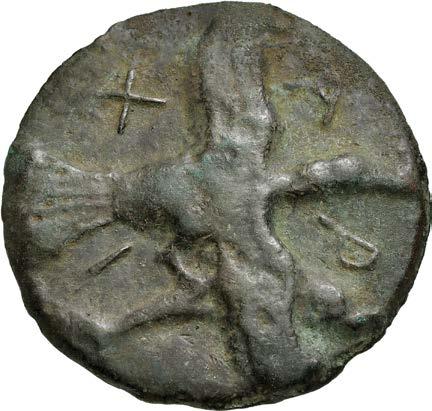

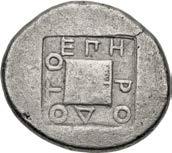
New Magistrate for Series
79. THRACE, Abdera. Circa 450-425 BC. AR Tetradrachm (25.5mm, 14.89 g, 7h). Istiaio(s), magistrate. Griffin with straight wing leaping left; ground in exergue / Eπ5 5st5-Å5-o around raised quadripartite incuse square; all within shallow incuse square. Cf. May Period IV (for general type); otherwise unpublished. Bright surfaces, area of weak strike, minor marks. Good VF. ($3000)
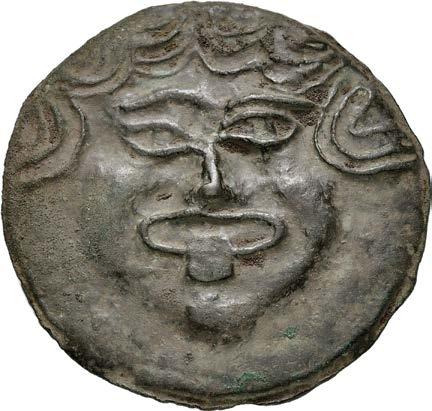
28
80.
AR Stater (23mm, 10.68 g, 3h). Hipponax, magistrate. Griffin lying left, raising right forepaw / Laureate head of Apollo right; shell below. C-N 125a (D1/R2) = M. J. Price, “Thrace, 1980” in CH VII, 14 corr. (this coin, incorrect weight cited); May 543 (same obv. die); HGC 3, 1211h. Toned. Good VF. ($3000)

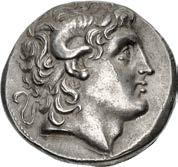
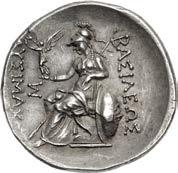
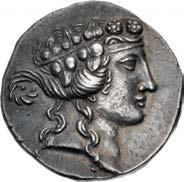
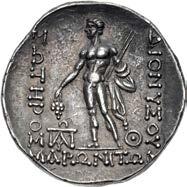
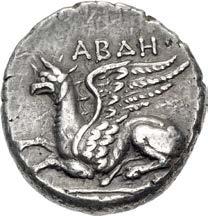
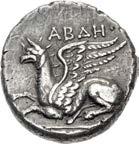
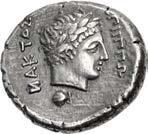
Ex Cayón Online Auction 80 (28 February 2022), lot 30046; Richard Winokur Collection (Triton X, 9 January 2007), lot 109; Hagen Tronnier Collection (Künker 94, 27 September 2004), lot 535; Münz Zentrum 53 (13 November 1984), lot 1560; Thrace, 1980 hoard (CH VII, 50).
81.
AR
(29.5mm, 16.98 g, 12h). In the name and types of Lysimachos. Uncertain mint. Early-mid 3rd century BC. Diademed head of the deified Alexander right, with horn of Ammon / Athena Nikephoros seated left, transverse spear in background; y to inner left. Marinescu Issue 17 (unlisted denomination, but is listed in his forthcoming revision of his dissertation); Müller –; HGC 3, 1394. Lightly toned, die break on obverse, a little off center on reverse. Near EF. Extremely rare, the sixth known of this issue (two in public collections [ANS and
Referenced in Schönert-Geiss
29
THRACE, Abdera. Circa 336-311 BC.
THRACE, Byzantion. Circa 260-245 BC.
Tetradrachm
BN], the others in commerce). ($2000)
82. THRACE, Maroneia. Late 2nd-mid 1st centuries BC. AR Tetradrachm (30.5mm, 16.04 g, 12h). Wreathed head of young Dionysos right / Dionysos, nude, standing half-left, holding grapes and cradling narthex stalks; U to inner left, Q to inner right. Schönert-Geiss 1305.1 (V35/R117 – this coin); HGC 3, 1556. Deep collection tone, slight die wear. Good VF. ($750)
From the James Fox Collection. Ex Spink Zurich 20 (6 October 1986), lot 138; Sternberg [9] (with P. Höflich, 15 November 1979), lot 20.
83. THRACE, Mesambria. Circa 150-125 BC. AR Tetradrachm (33.5mm, 16.80 g, 12h). In the name and types of Alexander III of Macedonia. Head of Herakles right, wearing lion skin / Zeus Aëtophoros seated left; to inner left, helmet above Ŀ; w below throne. Karayotov I 219 corr. (O83/R271; incorrect monograms); Callataÿ Group 3, dies D1/R1 corr. (same); Price 1090 corr. (same); HGC 3, 1568. Light scratches, slight die shift on obverse. Near EF. ($500)
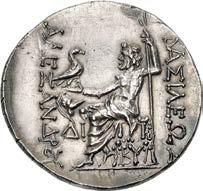
From the GTP Collection. Ex Heritage 3021 (6 January 2013), lot 21164.
84. THRACE, Mesambria. Circa 125-100 BC. AR Tetradrachm (33.5mm, 16.41 g, 12h). In the name and types of Alexander III of Macedon. Head of Herakles right, wearing lion skin / Zeus Aëtophoros seated left; to inner left, helmet above d5; ∫U below throne. Karayotov I 250 (O72/R245); Callataÿ Group 2, dies D27/R1; Price 1072; HGC 3, 1569. Iridescent tone, short hairline flan crack, slight die shift on obverse. EF. ($750)
Ex Triton V (15 January 2002), lot 1292.
85. ISLANDS off THRACE, Thasos. Circa 500-480 BC. AR Stater (20mm, 9.44 g). Ithyphallic satyr advancing right, carrying off protesting nymph / Quadripartite incuse square. Le Rider, Thasiennes 2; HGC 6, 331. Toned, a few light marks and deposits. Near EF. Choice for issue. ($1000)
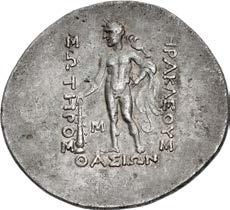

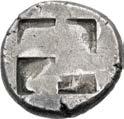
Ex LHS 103 (5 August 2009), lot 64.
86. ISLANDS off THRACE, Thasos. Circa 150-140 BC. AR Tetradrachm (37.5mm, 16.82 g, 1h). Wreathed head of young Dionysos right / Herakles standing facing, head left, holding club, lion skin draped over left arm; Â to inner left. Prokopov, Silberprägung, Group VI, 92 (V F1/R 79); Le Rider, Thasiennes 51; HGC 6, 358; SNG Klagenfurt 152 (same dies); Dewing 1339 (same dies). Toned, with golden hues and underlying luster. Good VF. Well centered on a broad flan. ($500)
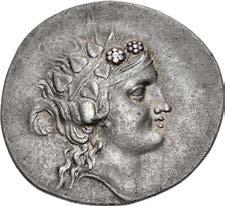
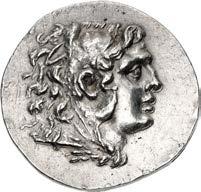
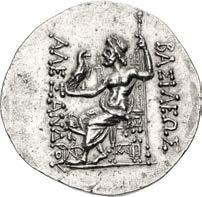
From the D.K. Collection.

30
87. ISLANDS off THRACE, Thasos. Circa 90-75 BC. AR Tetradrachm (32.5mm, 16.77 g, 12h). Imitative issue. Wreathed head of young Dionysos right / Herakles standing facing, head left, holding club, lion skin draped over left arm; Œ to inner left. Prokopov, Silberprägung, Group XIV, 1007 (V CB3/R806); Le Rider, Thasiennes 52; HGC 6, 359. Lightly toned. Near EF. Perfectly centered and well struck. ($1000)

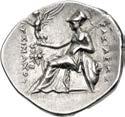
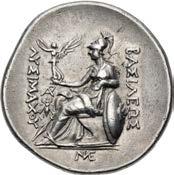
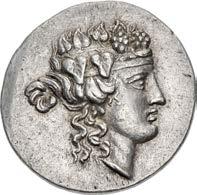
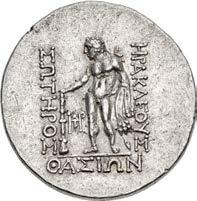
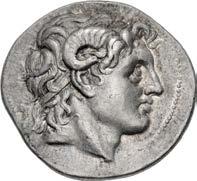
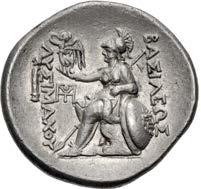
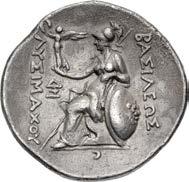
From the GTP Collection. Ex Lanz 159 (8 December 2014), lot 143 (hammer €1600).
88. KINGS of THRACE, Macedonian. Lysimachos. 305-281 BC. AR Tetradrachm (30.5mm, 17.18 g, 1h). Lampsakos mint. Struck circa 297/6-282/1 BC. Diademed head of the deified Alexander right, with horn of Ammon / Athena Nikephoros seated left, arm resting on shield, transverse spear in background; B to inner left, crescent in exergue. Thompson 49; Müller 399; HGC 3, 1750b. Toned, slight die shift. Good VF. Attractive style and high relief. ($1500)
89. KINGS of THRACE, Macedonian. Lysimachos. 305-281 BC. AR Tetradrachm (33mm, 17.06 g, 12h). Lampsakos mint. Struck 297/6-282/1 BC. Diademed head of the deified Alexander right, with horn of Ammon / Athena Nikephoros seated left, arm resting on shield, transverse spear in background; herm to outer left, É to inner left. Thompson 58; Müller 90; HGC 3, 1750b. Lightly toned. Near EF. ($2000)
90. KINGS of THRACE, Macedonian. Lysimachos. 305-281 BC. AR Tetradrachm (29mm, 16.77 g, 1h). Alexandreia Troas mint. Struck 297/6-282/1 BC. Diademed head of the deified Alexander right, with horn of Ammon / Athena Nikephoros seated left, arm resting on shield, transverse spear in background; to inner left, 1 above bee; Ô in exergue. Meadows, Earliest 15 var. (monogram in exergue), dies O9/R–; Thompson 160 var. (same); Müller 432 var. (same); HGC 3, 1750h. Lightly toned. Good VF. Extremely rare variety, only one other in CoinArchives (Künker 347, lot 659 [hammer €4400]). ($1500) Ex Triton XII (6 January 2009), lot 147.
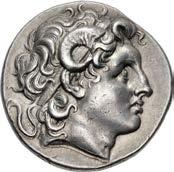

91. KINGS of THRACE, Macedonian. Lysimachos. 305-281 BC. AR Drachm (20mm, 4.28 g, 12h). Ephesos mint. Struck circa 294-287 BC. Diademed head of the deified Alexander right, with horn of Ammon / Athena Nikephoros seated left, arm resting on shield, transverse spear in background; to inner left, E f flanking bee; Ø on throne. Thompson 169; Müller 422; HGC 3, 1753d. Lightly toned, underlying luster. EF. ($750)
From the GTP Collection.
31
90 91
Struck Under Skostokos
92. KINGS of THRACE, Macedonian. Lysimachos. 305-281 BC. AR Tetradrachm (28mm, 16.09 g, 3h). Uncertain mint in Thrace (Kabyle?). Struck under Skostokos, circa 285-281 BC. Diademed head of the deified Alexander right, with horn of Ammon / Athena Nikephoros seated left, arm resting on shield, transverse spear in background; herm to inner left. Fischer-Bossert, Lysimacheier 1 (V1/R1); Youroukova 103 var. (name of Skostokos in exergue; same obv. die); HGC 3, 1470. Lightly toned, some porosity and flan flaws, cleaning marks. VF. Extremely rare, Fischer-Bossert notes only five examples of this issue without the name of Skostokos on the reverse (all from the same obverse die). ($1000)
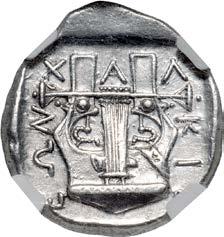
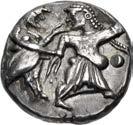

From the GTP Collection. Ex Künker 262 (13 March 2015), lot 7095.
While previous scholars viewed Skostokos as a dynast who took control of parts of Thrace following Lysimachos’ death, Fischer-Bossert’s die study demonstrates that Skostokos was most likely a local ruler in the vicinity of Kabyle, under Lysimachos, who was permitted to strike these coins near the end of Lysimachos’ reign.
93.
Lysimachos. 305-281 BC. AR Tetradrachm (30.5mm, 16.86 g, 12h). Uncertain mint. Early-mid 3rd century BC. Diademed head of the deified Alexander right, with horn of Ammon / Athena Nikephoros seated left, arm resting on shield, transverse spear in background; Ţ to inner left, Ť in exergue. Thompson –; Müller 553; cf. HGC 3, 1750 (for type); Künker 304, lot 248 (same obv. die). Toned. Good VF. ($1500)
94. THRACO-MACEDONIAN REGION, Siris. Circa 525-480 BC. AR Stater (21mm, 9.80 g). Ithyphallic satyr standing right, grasping hand of nymph fleeing right; pellets around / Quadripartite incuse square divided diagonally. Peykov A0020; HPM pl. VIII, 4; HGC 3, 531 (“Lete”). Deep cabinet tone. Near EF. ($1500)
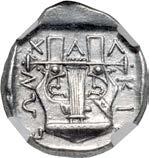
Ex “Dr. G.W Collection”; ex Crédit Suisse Monetarium Zurich List 60, 1993, No. 28.
Coinage of the Chalkidian League
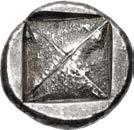
95. MACEDON, Chalkidian League. Circa 390 BC. AR Tetradrachm (26mm, 14.45 g, 2h). Olynthos mint. Head of Apollo left, wearing laurel wreath / Kithara; c-Å-¬-˚5d-EW@ around; all within incuse square. Robinson & Clement Group F, 6 (A6/P6); HGC 3, 497; SNG ANS 471. In NGC encapsulation 3808154-018, graded Ch AU★, Strike: 5/5, Surface: 4/5. ($5000)
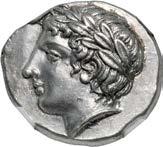
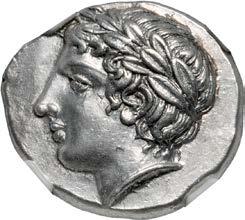
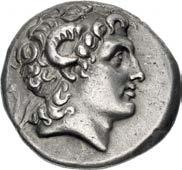
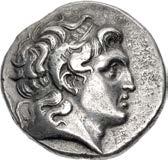
The Chalkidike is a three-fingered spit of land extending from eastern Macedon into the Aegean Sea. Wary of Athenian imperialism and the rising power of the Macedonian Kingdom, the free cities of the Chalkidike banded together in 432 BC to form a defensive coalition called the Chalkidian League, with its capital of Olynthos. The silver coinage struck at Olynthos was on the Macedonian standard, somewhat lighter than the Attic standard employed by most of Greece, and was legal tender at all cities belonging to the league. The standard design featured a head of Apollo, god of beauty, art and music, with a type of lyre called a kithara on the reverse. The heads of Apollo on these pieces are remarkable for the beauty of their style. Some of the most beautiful dies in the series were produced in the early fourth century BC, of which an outstanding example is seen here. The Chalkidian League’s coinage came to an end with the capture and destruction of Olynthos by King Philip II of Macedon in 348 BC.
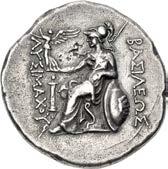
32
KINGS of THRACE, Macedonian.
93 94
96. MACEDON, Chalkidian League. Circa 382-379 BC. AR Tetrobol (15mm, 2.38 g, 6h). Olynthos mint; Ore–, magistrate. Laureate head of Apollo right / Kithara; orE across bottom of sound chest. Robinson & Clement Group H, 57 (A44/ P39); HGC 3, 502; SNG ANS 534 (same obv. die). Minor die flaws on obverse. EF. Rare with name on reverse. ($500)
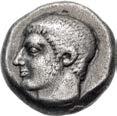
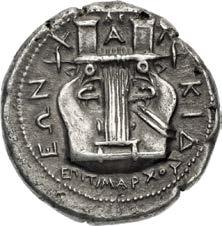
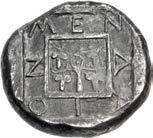
From the Weise Collection. Ex Classical Numismatic Group Electronic Auction 276 (21 March 2012), lot 70.
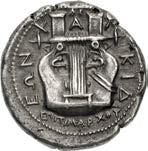

97. MACEDON, Chalkidian League. Circa 355 BC. AR Tetradrachm (24mm, 14.38 g, 12h). Olynthos mint; Timarchos, magistrate. Laureate head of Apollo right / Kithara; tiny dE above. Robinson & Clement Group Q, 98 (A64/P85); HGC 3, 497; SNG ANS 503 (same dies). Old collection tone. In NGC encapsulation 6826475-004, graded Ch XF★, Strike: 5/5, Surface: 4/5, Fine Style. ($2000)
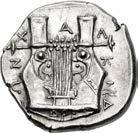
98. MACEDON, Mende. Circa 460-423 BC. AR Tetradrachm (25mm, 16.60 g, 11h). Inebriated Dionysos, wearing chiton draped from his
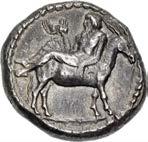



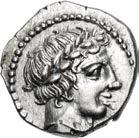
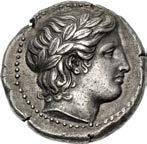
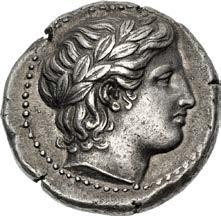
in right hand a kantharos propped on his right knee, reclining left, head right, on the back of an ass standing right; before, bird perched right upon branch / µE@-dÅ-5-o@ within shallow incuse around quadripartite square in linear border ornamented with dots; all within incuse square. Cf. Noe, Mende 84/85 (for same obv./rev. dies); AMNG
20;
3, 545;
346/347 (for same obv./rev. dies); Dewing 1055 (same obv. die). Toned, light smoothing in fields, faint cleaning marks. VF. ($3000)
Ex Ronald Cohen Collection (Triton VIII, 11 January 2005), lot 122; Gorny & Mosch 112 (17 October 2001), lot 4071.
The Dionysiac types of Mende proclaim it as a famous wine producing city, as attested by its amphoras that have been found throughout the Mediterranean. On this delightful coin Dionysos, who rules wine and winemaking, is shown being carried home drunk from a symposium, a representation of careless joy which links the world of men with the Olympians – at least until the morning.
From the St. George Collection. Ex Classical Numismatic Group 45 (18 March 1998), lot 162.
33
waist, holding
III
HGC
cf. SNG ANS
99. MACEDON, Skione. Circa 470-454/3 BC. AR Tetrobol (12mm, 2.75 g, 12h). Bare head of male left / Helmet left within incuse square. AMNG III/2, –; HGC 3, 673. Toned, granular surfaces. VF. Extremely rare with head left. ($600)
Le Rider Plate Coin – Pedigreed to 1957
100. KINGS of MACEDON. Philip II. 359-336 BC. AR Tetradrachm (24mm, 14.40 g, 12h). Pella mint. Struck 348/7343/2 BC. Laureate head of Zeus right / Youth, holding palm frond, on horseback right; in exergue, spearhead right. Le Rider Group I.A.1, 162a (D100/R132 – this coin, illustrated); SNG ANS 373 (same rev. die). Attractive old collection tone, minor die wear on obverse. Good VF. ($1500)
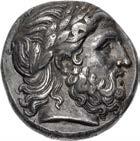

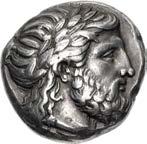

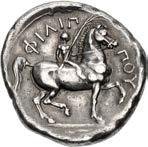

Ex Münzhandlung Funk inventory (ND; ticket included); Münzen und Medaillen AG FPL 181 (July 1958), no. 1; Münzen und Medaillen AG FPL 166 (March 1957), no. 8.
101. KINGS of MACEDON. Alexander III ‘the Great’. 336-323 BC. AR Tetradrachm (23mm, 14.39 g, 9h). In the name and types of Philip II. Amphipolis mint. Struck circa 336-333/26 BC. Laureate head of Zeus right / Youth, holding palm and reins, on horseback right; bee below horse’s belly, omphalos below raised foreleg. Le Rider Group II.A, 497 (D219/R445); SNG ANS 567 (same dies). Attractively toned, trace deposits, slightly weak strike in center and minor flan flaw on reverse. Good VF. ($1000)
From the W. Toliver Besson Collection. Ex Rockefeller University / Dr. Alfred E. Mirsky Collection (Gemini VII, 9 January 2011), lot 255.
From the First Gold Coinage of the Alexander Type
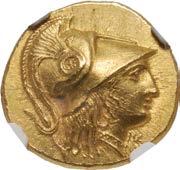
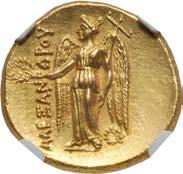
102. KINGS of MACEDON. Alexander III ‘the Great’. 336-323 BC. AV Stater (18mm, 8.61 g, 12h). Tarsos mint. Struck under Balakros or Menes, circa 332/1-327 BC. Head of Athena right, wearing crested Corinthian helmet decorated with a coiled serpent with a star within the coil, and pearl necklace / ŬE$Å@droU, Nike standing left, holding wreath in extended right hand and cradling stylis in left arm; wreath below right wing. Price 3456A (Sidon); Newell, Dated 1, Type B, dies B/β (Sidon); ANS inv. 1965.77.87 (same dies); Berlin obj. no. 18251308 (same dies). In NGC encapsulation 2413197-006, graded MS, Strike: 5/5, Surface: 4/5. Well centered. Very rare, only two in Pella (erroneously placed under Price 3456; including the sole example cited by Newell), none in CoinArchives, and none in the ANS Photofile. ($5000)
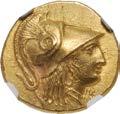
This issue was originally given to Sidon by Newell, along with seven other issues of staters (and two distaters) that lacked the mint signature and/or date that is found on nearly all other issues at Sidon. Newell later doubted the attribution, and suggested they may belong to an early mint at Damaskos (cf. G.F. Hill, “Alexander the Great and the Persian lion-gryphon,” JHS 43 [1923], p. 159). While Price retained Newell’s original attribution, he, too, remained skeptical (Price, p. 436). Le Rider, in his recent review of the coinage of Alexander the Great (Alexander the Great: Coinage, Finances, and Policy [Philadelphia, 2007]), recounted the various arguments, but also assimilated more recent research, and convincingly argues that these eight issues of gold actually were the first issues of Alexander type staters at the mint of Tarsos (Le Rider, op. cit., pp. 134–9).
The reattribution to Tarsos has a significant effect on the importance of these staters. It is generally thought that Alexander began issuing his new coinage, staters of Athena/Nike type and tetradrachms of Herakles/Zeus type, shortly after his capture of Tarsos in 333 BC. Recognizing the importance of this mint for Alexander, supported by the state of the evidence at the time, Newell originally attributed a large series of staters to the early period of Alexanders at Tarsos (E.T. Newell, “Tarsos under Alexander,” AJN 52 [1918]). Later research, however, moved nearly all of these issues to a mint in Macedon (cf. Price p. 371, and Troxell, Studies, pp. 99–110). This void of gold coinage is therefore filled with the reattribution of the eight issues from Sidon, resulting in these being not only the first issue of Alexander staters from Tarsos, but the first issues of Alexander’s new stater coinage anywhere.
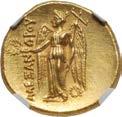
34
103. KINGS of MACEDON. Alexander III ‘the Great’. 336-323 BC. AR Tetradrachm (25.5mm, 17.11 g, 2h). Babylon mint. Struck under Stamenes or Archon, circa 324/3 BC. Head of Herakles right, wearing lion skin / Zeus Aëtophoros seated left; bee in left field; below throne, P above M. Price 3620 corr. (no strut); Waggoner Issue II, Series 1, dies 34/a; ANS inv. 1944.100.80371 (same dies). In NGC encapsulation 4167240-003, graded Ch AU, Strike: 5/5, Surface: 4/5. ($500)
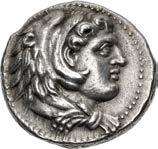
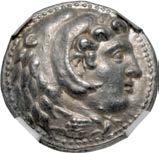
104. KINGS of MACEDON. Alexander III ‘the Great’. 336-323 BC. AR Tetradrachm (26mm, 17.01 g, 8h). Babylon mint. Struck under Stamenes or Archon, circa 324/3 BC. Head of Herakles right, wearing lion skin / Zeus Aëtophoros seated left; below throne, P above strut, Â below; club in exergue. Price 3639 (same dies as illustration); Waggoner Issue II, dies 27/f; ANS inv. 2002.46.533 (same dies). Lightly toned, minor cleaning marks in field on obverse, light scratch in field on reverse. Good VF. ($500)
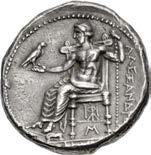
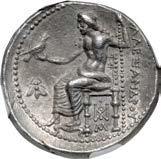
105. KINGS of MACEDON. Alexander III ‘the Great’. 336-323 BC. AV Stater (17mm, 8.53 g, 10h). Babylon mint. Struck under Stamenes or Archon, circa 324/3 BC. Head of Athena right, wearing crested Corinthian helmet decorated with a coiled serpent, and pearl necklace / Nike standing left, holding wreath and stylis; q and P below left wing. Price 3671 corr. (position of control marks); Waggoner Issue II, unlisted dies (cf. 18/a for type). Underlying luster, a little off center on obverse. Good VF. Extremely rare, only one noted by Waggoner (= the sole example in Pella), two in CoinArchives, none in the ANS photofile. ($2000)
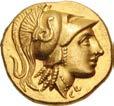
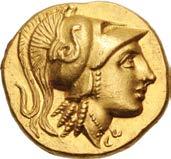
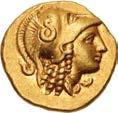
106. KINGS of MACEDON. temp. Alexander III – Philip III. Circa 325-319 BC. AV Stater (18mm, 8.61 g, 4h). In the name and types of Alexander III. Amphipolis mint. Struck under Antipater. Head of Athena right, wearing crested Corinthian helmet decorated with serpent, and necklace / ŬE$Å@droU, Nike standing left, holding wreath in extended right hand and cradling stylis in left arm; trident head downward in left field. Price 172; Troxell, Studies, p. 125, pl. 25, H. Underlying luster, a few tiny deposits, some scuffs and light scratches. EF. ($4000)
Alexander
325-319 BC. AV Stater (18mm, 8.57 g, 7h). In the name and types of Alexander III. Amphipolis mint. Struck under Antipater. Head of Athena right, wearing crested Corinthian helmet decorated with serpent, and necklace / ŬE$Å@droU, Nike standing left, holding wreath in extended right hand and cradling stylis in left arm; trident head downward in left field. Price 172; Troxell, Studies, p. 125, pl. 25, F. Trace deposits, a few minor marks, tiny die break on obverse. Good VF. ($3000)

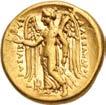
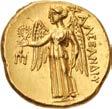

Ex Numismatik Naumann 111 (5 December 2021), lot 230.
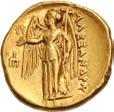
35
Ex David J. Fleischmann Collection, purchased from Harlan J. Berk.
107. KINGS of MACEDON. temp.
III – Philip III. Circa
103 104
Extremely Rare Abydos Quarter Stater
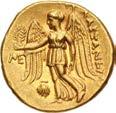
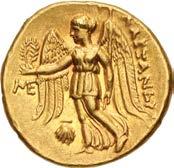

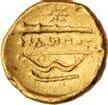
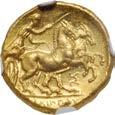
108. KINGS of MACEDON. Philip III Arrhidaios. 323-317 BC. AV Quarter Stater (11mm, 2.12 g, 12h). In the types of Philip II. Abydos mint. Struck under Leonnatos, Arrhidaios, or Antigonos I Monophthalmos. Head of Herakles right, wearing lion skin / Club and bow; star above, lagobolon below. Le Rider –; Thompson, Philip –; cf. ADM II Series V, 103b and 104c (for staters of the same group); SNG ANS –; Roma E-Sale 81, lot 177 (same dies). Minor marks. VF. Extremely rare, perhaps the second known (and finer than the Roma specimen, which hammered at £1700). ($1000)
109. KINGS of MACEDON. Philip III Arrhidaios. 323-317 BC. AV Stater (17mm, 8.56 g, 1h). In the types of Philip II. Teos mint. Struck under Menander or Kleitos, circa 323-319 BC. Head of Apollo right, wearing laurel wreath / f5¬5ππoU, charioteer, holding kentron in right hand, reins in left, driving fast biga right; S below. Thompson, Philip 17; Le Rider pl. 91, 16 (same dies); SNG ANS 321 (same obv. die). In NGC encapsulation 6827184-001, graded Ch MS, Strike: 5/5, Surface: 4/5, Fine Style, flan flaw. ($5000)
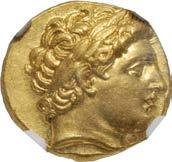
110. KINGS of MACEDON. Philip III Arrhidaios. 323-317 BC. AR Tetradrachm (25mm, 17.18 g, 12h). In the name and types of Alexander III. Babylon mint. Struck under Archon, Dokimos, or Seleukos I, circa 323-318/7 BC. Head of Herakles right, wearing lion skin / Zeus Aëtophoros seated left; Â in left field, ¬U below throne. Price 3692; Waggoner Issue III, obv. die 156. Underlying luster. Near EF. ($500)
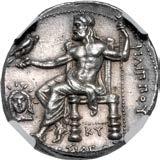
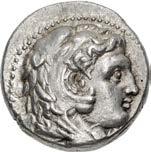
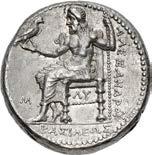
111. KINGS of MACEDON. Philip III Arrhidaios. 323-317 BC. AR Tetradrachm (27mm, 17.15 g, 10h). In the types of Alexander III. Babylon mint. Struck under Archon, Dokimos, or Seleukos I, circa 323-318/7 BC. Head of Herakles right, wearing lion skin / Zeus Aëtophoros seated left; in left field, facing head of Helios, drapery at neck; kU below throne. Price P205; Waggoner Issue VII, obv. die 255. Toned. In NGC encapsulation 6827184-004, graded Ch AU, Strike: 4/5, Surface: 4/5, Fine Style. ($500)

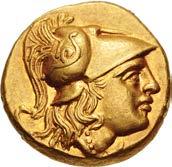
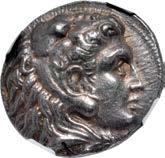



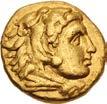
Ex Arthur J. Frank Collection; J. Schulman FPL 205 (June 1975), no. 35.
112. KINGS of MACEDON. Antigonos I Monophthalmos. As Strategos of Asia, 320-306/5 BC. AV Stater (18.5mm, 8.48 g, 12h). In the name and types of Alexander III. Abydos mint. Struck circa 310-301 BC. Helmeted head of Athena right / Nike standing left, holding wreath and stylis; / in left field, shell below left wing. Price 1559; ADM II Series XIX, 364 (same rev. die). Lightly toned. EF. Well centered and struck. ($4000)
Ex Guy Collection; Freeman & Sear FPL 13 (Winter 2008), no. 14.
36
110 111
113. KINGS of MACEDON. Antigonos I Monophthalmos. As Strategos of Asia, 320-306/5 BC. AR Tetradrachm (25mm, 16.83 g, 3h). In the name and types of Alexander III. Susa mint. Struck under Aspesias, Satrap of Susiana, circa 316311 BC. Head of Herakles right, wearing lion skin / Zeus Aëtophoros seated left; wreath in left field; below throne, Å5 above strut, Z below. Price 3857. Light porosity. EF. Very high relief. ($750)
114. KINGS of MACEDON. temp. Kassander – Antigonos II Gonatas. Circa 310-275 BC. AR Tetradrachm (29mm, 16.93 g, 12h). In the name and types of Alexander III. Uncertain mint in Greece or Macedon. Struck circa 275-272/1 BC. Head of Herakles right, wearing lion skin / Zeus Aëtophoros seated left; Ŧ in left field. Price 869. Lightly toned, minor marks and hairlines. Near EF. Well centered. ($500)
From the GTP Collection. Ex Munich Doctor Collection (Gorny & Mosch 253, 5 March 2018), lot 123.
115. KINGS of MACEDON. Demetrios I Poliorketes. 306-283 BC. AR Tetradrachm (25mm, 17.09 g, 9h). In the name and types of Alexander III. Corinth mint. Struck circa 304/3-290 BC. Head of Herakles right, wearing lion skin / Zeus Aëtophoros seated left; in left field, Elpis advancing left; @o below throne. Newell –; Price 679; Noe, Sicyon 26.2–3 var. (A45/P– [unlisted rev. die]). Lightly toned, hairlines on obverse. EF. Excellent style and well centered. ($750)
From the GTP Collection. Ex Stack’s Bowers Galleries (5 November 2015), lot 40014.
116. KINGS of MACEDON. Demetrios I Poliorketes. 306-283 BC. AR Tetradrachm (28mm, 17.10 g, 3h). In the name and types of Alexander III. Corinth mint. Struck circa 304/3-290 BC. Head of Herakles right, wearing lion skin / Zeus Aëtophoros seated left on throne decorated with Nikai; cornucopia in left field, @o below throne. Newell –; Price 691; Noe, Sicyon 35.6 (A69/P129). Lightly toned, small mark on obverse, double struck on reverse. Near EF. Attractive in hand. ($500)
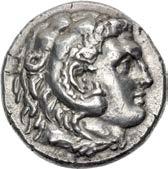
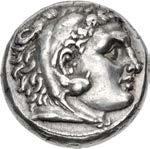
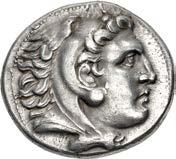
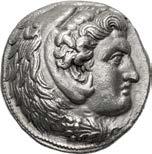
From the GTP Collection.
117. KINGS of MACEDON. Demetrios I Poliorketes. 306-283 BC. AR Tetradrachm (27mm, 17.09 g, 12h). Salamis mint. Struck circa 300-295 BC. Nike, blowing trumpet and holding stylis, standing left on prow of galley left / Poseidon Pelagaios standing left, preparing to throw trident; A to left, , to right. Newell 14, obv. die XI; HGC 3, 1012a. Lightly toned, slight die shift on reverse. Good VF. ($1500)
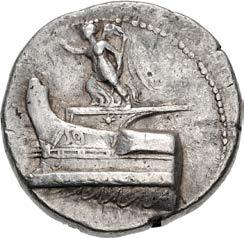

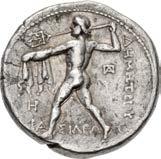
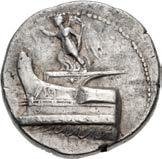

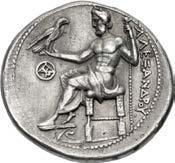
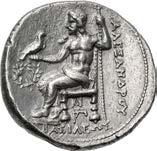
37
113 114 115 116
118. KINGS of MACEDON. Demetrios I Poliorketes. 306-283 BC. AR Tetradrachm (31.5mm, 17.16 g, 8h). Amphipolis mint. Struck circa 289-288 BC. Diademed and horned head right / Poseidon Pelagaios standing left, right foot on rock, holding trident; monograms to inner left and outer right. Newell 120, dies –/224 (unlisted obv. die); HGC 3, 1014b. Toned. Good VF. ($1000)
Ex CNG inventory 795034 (August 2007).
Pedigreed to 1969
119. KINGS of MACEDON. Demetrios I Poliorketes. 306-283 BC. AR Tetradrachm (28.5mm, 16.83 g, 5h). Uncertain mint in Macedon. Struck circa 291-290 BC. Diademed and horned head right / Poseidon Pelagaios seated left on rock, holding aphlaston and trident; to inner left, Phrygian helmet left. Newell 137, dies –/227 (unlisted obv. die); HGC 3, 1013c; Boston MFA 707 (same rev. die). Deep iridescent tone, flan crack, minor die break on obverse. Good VF. ($1000)
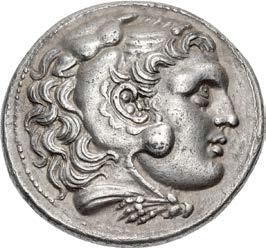
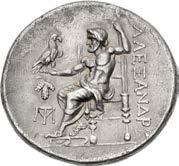
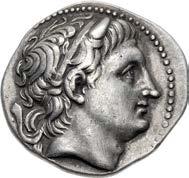
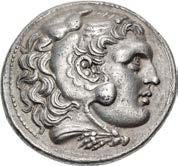
Ex CNG inventory 155910 (December 2004); Kölner Münzkabinett 4 (12 December 1969), lot 17.
120. KINGS of MACEDON. Antigonos II Gonatas. 277/6-239 BC. AR Tetradrachm (29.5mm, 16.71 g, 1h). In the name and types of Alexander III. Pella mint. Struck circa 276-274 BC. Head of Herakles right, wearing lion skin / Zeus Aëtophoros seated left; in left field, grapes above µ. Price 586; Mathisen, Administrative IV.10; HGC 3, 1041. Lightly toned, a little porosity and slight roughness in spots. Near EF. Well centered and fine style. ($750)
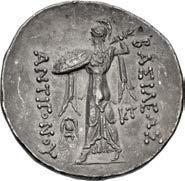
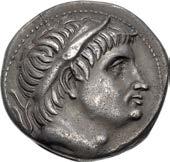
From the GTP Collection. Ex Leu Numismatik 3 (27 October 2018), lot 48; Gorny & Mosch 185 (8 March 2010), lot 95.
16.80 g, 10h). Amphipolis or Pella mint. Horned head of Pan left, lagobolon over shoulder, in the center of a Macedonian shield / Athena Alkidemos advancing left, holding shield decorated with aegis, preparing to cast thunderbolt; crested Macedonian helmet to inner left, ˚t to inner right. TEA Period IV, Group 5, 24 (O8/R23); HGC 3, 1042 (Antigonos II
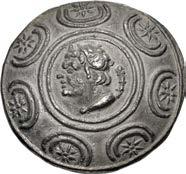
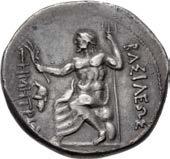
121.
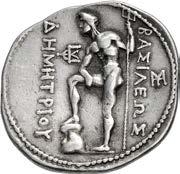
38
118 119
KINGS of MACEDON. Antigonos III Doson. 229-221 BC. AR Tetradrachm (31mm,
Gonatas). Toned, trace deposits, a couple of minor scrapes on obverse, a few light scratches on reverse. Good VF. ($750)
122. KINGS of MACEDON. Philip V. 221-179 BC. AR Didrachm (25mm, 8.23 g, 12h). Attic standard. Pella or Amphipolis mint; Zoilos, mintmaster. Struck circa 184-179 BC. Diademed head right / Club; g (mintmaster’s monogram) above, 6 to lower left, : to lower right; all within oak wreath tying to left; star to outer left. Mamroth, Philip 25; HGC 3, 1059. Faintly toned, some light marks. EF. Perfectly centered. ($1500)
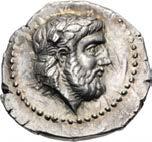

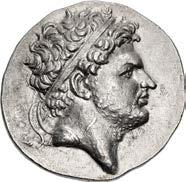

From the James Fox Collection.
123.
179-168 BC. AR Tetradrachm (31mm, 15.30 g, 12h). Reduced standard. Amphipolis mint. Struck circa 171-168 BC. Diademed head right / Eagle, wings spread, standing right on thunderbolt; ú above, Q to right, f between legs; all within oak wreath; below, plow left. De Luca, Tetradrachms 144–5 var. (O35/R– [unlisted rev. die]); Mamroth, Perseus 21b; HGC 3, 1091. Bright surfaces, slight die wear. Choice EF. ($2000)

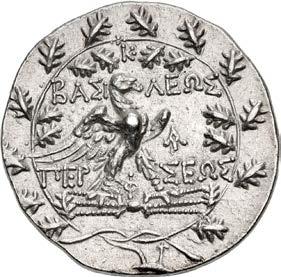
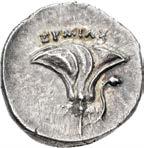
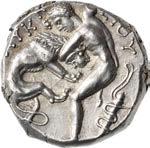
From the Libertas Collection, purchased from Numismatic Fine Arts (ticket included).
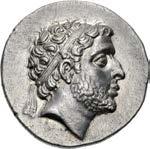
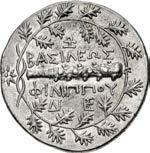
124.
179-168 BC. AR Drachm (16mm, 2.57 g, 12h). Third Macedonian War issue.

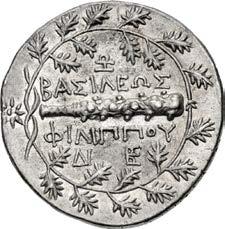
mint in Thessaly; Hermias, magistrate. Struck circa 171/0 BC. Head of Helios facing slightly right / Rose with bud to right; z-W flanking stem. Price, Larissa p. 241; SNG Keckman 795. Light iridescent tone. Superb EF. ($500)

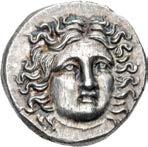
From the GTP Collection. Ex CNG inventory 956521 (August 2013).
(23.5mm, 12.79 g, 6h). Astibos or Damastion mint. Laureate head of Zeus right / Herakles standing left, hand raised to strike the Nemean Lion, which he has in a strangle-hold; bow and quiver to right. Paeonian Hoard 63 (same obv. die); Peykov E1000; NBRM Paeonia 32 (same dies); HGC 3, 142; Alpha Bank, Hellenic 82 (same dies); Šeldarov 760 (same dies). Lightly toned, with golden hues around the devices, underlying luster, typical slight die wear on obverse. Choice EF. ($1500)
From the Dr. Michael Slavin Collection, purchased from Harlan J. Berk.
AR
39
KINGS of MACEDON. Perseus.
KINGS of MACEDON. Perseus.
Uncertain
125. KINGS of PAEONIA. Lykkeios. Circa 358/6-335 BC.
Tetradrachm
126. KINGS of PAEONIA. Patraos. Circa 335-315 BC. AR Tetradrachm (24.5mm, 12.89 g, 6h). Damastion or Astibos mint. Laureate head of Apollo right / Warrior on horse rearing right, thrusting spear at enemy lying below who defends with shield; @ to left. Paeonian Hoard 336–8 (same dies); Peykov E2130; HGC 3, 148. Lightly toned, minor die break on obverse. Near EF. Exceptional for issue, well centered, with all elements visible. ($750)
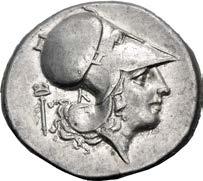
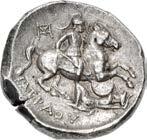
From the GTP Collection. Ex Antiqua XVII (2013), no. 23.
127. EPEIROS, Ambrakia. Circa 404-360 BC. AR Stater (20mm, 8.37 g, 8h). Pegasos flying left / Helmeted head of Athena right, Å on helmet bowl; to left, År[Åt] above Arachtos seated right on [facing head of bull]. Ravel, Colts 116 (A53/P78); Pegasi 74; HGC 3, 205; McClean 5105 (same dies). Lightly toned, some light porosity and granularity. EF. ($1000)
128. THESSALY, Magnetes. Circa 168-140 BC. AR Drachm (21mm, 4.02 g, 12h). Demetrias mint. Laureate head of Zeus right; 6 to left / Artemis, holding bow, seated left on prow left; O to right. BCD Thessaly II 407 (this coin); HGC 4, 58. Lightly toned, small chip at edge on reverse. VF. ($500)
From the Weise Collection. Ex BCD Collection (Triton XV, 3 January 2012), lot 407.
129. THESSALY, Methylion. Circa 465-460 BC. AR Hemidrachm (14mm, 2.99 g, 11h). Forepart of horse left, emerging from rock / Sprouting wheat grain within incuse square. Cf. Heyman 1 (drachm); cf. Franke, Geschicte 16 (drachm); BCD Thessaly 462; HGC 4, 685. Compact flan, minor pits. VF. Extremely rare as a hemidrachm. ($750)


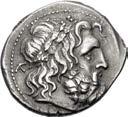
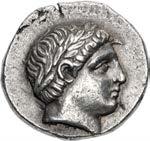
130. THESSALY, Thessalian League. Circa 470s-460s BC. AR Hemidrachm (13mm, 2.97 g, 8h). Forepart of horse right / Sprouting wheat grain within incuse square. Franke, Geschicte 7 var. (horse emerging from rock); BCD Thessaly II 22.2 (same dies); HGC 4, 197 var. (horse emerging from rock). Lightly toned, granular surfaces. Good VF. ($750)


131. AKARNANIA, Leukas. Circa 350-320 BC. AR Stater (20.5mm, 8.31 g, 3h). Pegasos flying right / Helmeted head of Athena right; kerykeion to left. Pegasi 94; Imhoof-Blumer, Akarnaniens –; BCD Akarnania 221; HGC 4, 823. Lightly toned. Near EF. Perfectly centered. ($750)
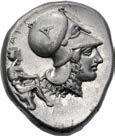
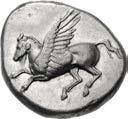
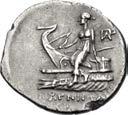
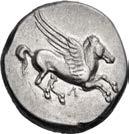
From the Weise Collection. Ex Triton III (30 November 1999), lot 436.
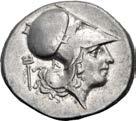
40
126 129 130 127
132. BOEOTIA, Haliartos. Circa 475-450 BC. AR Stater (17mm, 11.94 g). Boeotian shield / Square incuse with counterclockwise mill-sail pattern; refined aspirate in center. BCD Boiotia 157; HGC 4, 1194. Deeply toned. Near VF. Very rare. ($500)




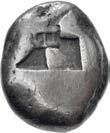

Ex Matthew Curtis Collection (Classical Numismatic Group Electronic Auction 460, 29 January 2020), lot 188.
133. BOEOTIA, Thebes. Circa 364-362 BC. AR Stater (21.5mm, 12.05 g). Epa(minondas), magistrate. Boeotian shield / Amphora within concave circle. Hepworth, Epaminondas, pl. 3, 2; Hepworth 34; BCD Boiotia 540; HGC 4, 1333. Lightly toned, some porosity, scratches. VF. ($1000)
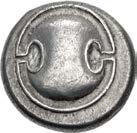
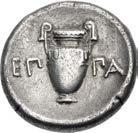
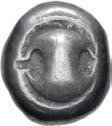
From the GTP Collection. Ex Gorny & Mosch 249 (11 October 2017), lot 234.
There are times when some of us wonder what the world would be like today if Alexander the Great had lived to a ripe old age. The same kind of “What if ...” thinking could be applied to Epaminondas. His premature death on the battlefield of Mantineia in 362 BC deprived Thebes of its greatest statesman and soldier, signalling the start of Thebes’ rapid decline into obscurity. If Epaminondas had lived to reap the benefits of his Mantineian victory he would have undoubtedly proceeded to unite all Greece under his leadership. The next step would be to turn to the North and face Philip who, instead of finding a divided Greece ready for the taking, would think twice before attempting to invade Thessaly. Whether then there would be a clash between the two emerging superpowers or a truce between them, is anybody’s guess. Perhaps Philip would remember the years he spent as a hostage in Thebes and his respect for the Theban statesman would prevail. The conquest of Asia might then materialize sooner and in a more permanent manner than it did. But, like many great soldiers, Epaminondas inspired his men by leading them into battle and, instead of capitalizing on his genius, Thebes paid the price for his bravery.
134. BOEOTIA, Thespiai. Early-mid 4th century BC. AR Hemidrachm (16.5mm, 2.91 g). Boeotian shield / Head of Aphrodite Melainis right; to right, vertical crescent facing left. BCD Boiotia 607 (same rev. die); HGC 4, 1400; BMC 10 (same rev. die); SNG Copenhagen 404 (same rev. die); Pozzi 1460; Weber 3316 (same rev. die). Light graffito in field on reverse. Near EF. Struck on a broad flan. ($500)
From the Weise Collection. Ex Triton XIII (5 January 2010), lot 137.
135. ATTICA, Athens. Circa 515-510 BC. AR Hemiobol (6.5mm, 0.42 g). “Wappenmünzen” type. Wheel with four spokes / Quadripartite incuse square, divided diagonally. Seltman pl. IV, αα; Svoronos, Monnaies, –; HGC 4, 1675. Old cabinet tone, light porosity. VF. ($500)
Ex Judy Day Frink Collection (Classical Numismatic Group 115, 17 September 2020), lot 132, purchased from Owl, Ltd (John Barton).
136. ATTICA, Athens. Circa 465/2-454 BC. AR Obol (9mm, 0.70 g, 8h). Helmeted head of Athena right, with frontal eye / Owl standing right, head facing; olive spray to left; all within incuse square. Starr Group V; HGC 4, 1664 corr. (photo is duplicate of 1665). Lightly toned, minor porosity. Near EF. Well centered. ($500)
From the Tiny Art Collection.
137.
Athens. Circa 454-404 BC. AR Tetradrachm (24mm, 17.14 g, 5h). Helmeted head of Athena right, with frontal eye / Owl standing right, head facing, closed tail feathers; olive sprig and crescent to left; all within incuse square. Kroll 8; HGC 4, 1597. Lightly toned, underlying luster, a couple of minor flan flaws on obverse. EF. Well centered. ($1000)




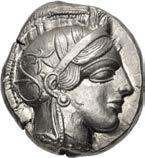
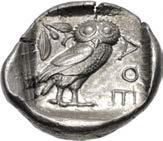

41
132 133 135 136
ATTICA,
138. ATTICA, Athens. Circa 400/390-353 BC. AR Tetradrachm (21mm, 17.13 g, 9h). Helmeted head of Athena right, with profile eye / Owl standing right, head facing; olive spray and crescent to left; all within incuse square. Kroll 15a-b; HGC 4, 1598 corr. (not pi-style). Lovely old collection tone, with some iridescence, slight die wear on obverse, traces of find patina on reverse. Near EF. ($500)
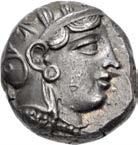
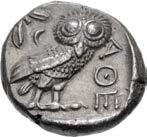
Ex Mark & Lottie Salton Collection (Stack’s Bowers Galleries, 14 January 2022), lot 4263.
139. ATTICA, Athens. Circa 165-42 BC. AR Tetradrachm (33.5mm, 16.52 g, 1h). New Style coinage. Struck 165-149/8 BC. Helmeted head of Athena Parthenos right / Owl standing right, head facing, on amphora; æ and ø flanking, piloi of the Dioskouroi to lower right; all within wreath. Thompson 64a–b (same obv. die); HGC 4, 1602; Dewing 1638 (same obv. die). Toned, patches of find patina. In NGC encapsulation 6557272-008, graded Ch XF, Strike: 5/5, Surface: 3/5. ($1500)
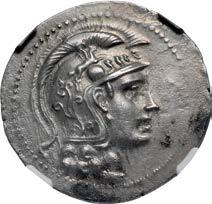
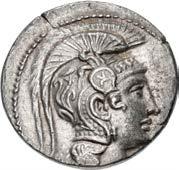
140. ATTICA, Athens. Circa 165-42 BC. AR Tetradrachm (33mm, 16.83 g, 12h). New Style coinage. Struck 165150/149 BC. Helmeted head of Athena Parthenos right / Owl standing right, head facing, on amphora; Ũ to left, aphlaston and H to right, uncertain letter on amphora, fs to lower left; all within wreath. Cf. Thompson 252 (same obv. die); HGC 4, 1602. Attractively toned, some weakness of strike at periphery. Good VF. ($1500)

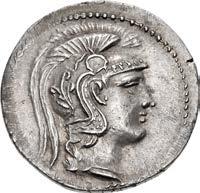
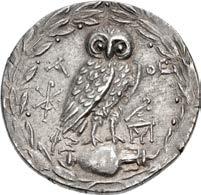
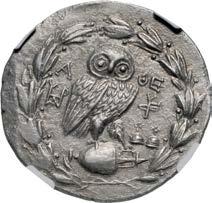
141. ATTICA, Athens. Circa 165-42 BC. AR Tetradrachm (29.5mm, 17.00 g, 11h). New Style coinage. Dorothe-, Dioph-, and Nikodo– magistrates. Struck 132/1 BC. Helmeted head of Athena right / Owl standing right, head facing, on amphora; magistrates’ names in fields; to right, forepart of lion right; H on amphora, ΣΦ below; all within wreath. Thompson 388d var. (letters below amohora; same obv. die); HGC 4, 1602. Lightly toned, edge split. EF. ($1500)
From the Weise Collection. Ex Classical Numismatic Group 45 (18 March 1998), lot 344.
142. ISLANDS off ATTICA, Aegina. Circa 456/45-431 BC. AR Stater (21.5mm, 12.33 g, 2h). Land tortoise with segmented shell / Large square incuse with heavy skew pattern. Meadows, Aegina, Group IIIb; Milbank Period IV, pl. II, 12; HGC 6, 437. Lightly toned, minor marks. EF. ($3000)
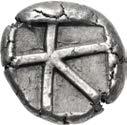
Ex Roma XIX (26 March 2020), lot 349.
The loss of Aegina’s sea power probably occasioned the replacement of the maritime turtle with the terrestrial tortoise as the emblem of the city, and it was also at this time that she formed the reverse “skew” pattern in a more rectangular five-part incuse punch, finally including letters and symbols within each sunken section. Subsequently in 431 BC, the Aeginetans were expelled from their homeland by the Athenians, only returning after the conclusion of the Peloponnesian War.
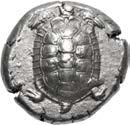
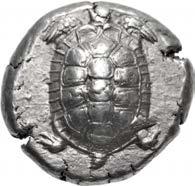
42
139 140
143. ISLANDS off ATTICA, Aegina. Circa 350-338 BC. AR Stater (23mm, 12.25 g, 1h). Ni–, magistrate. Tortoise with segmented shell; Å-5 flanking / “Thin skew” incuse pattern; @-5 in upper incuses, dolphin in lower left. Milbank p. 51, a; cf. HGC 6, 445 (drachm); SNG Copenhagen 526; SNG Lockett 1998; BMC 190; Hunt II 433; Pozzi 1639. Attractively toned, a touch of porosity, a little off center on obverse. Near EF. ($4000)
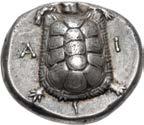

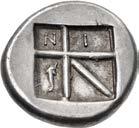
Ex Father & Son Collection; Künker 326 (7 October 2019), lot 781 (hammer €12,000). Reportedly ex inventory of Dr. Hans Nussbaum († January 7, 1939), circa 1902.
144. CORINTHIA, Corinth. Circa 400-350/45 BC. AR Stater (22mm, 8.43 g, 5h). Pegasos flying left / Helmeted head of Athena left; palmette to right. Ravel Period IV, 353 (P181/T276); Pegasi 111; BCD Corinth –; HGC 4, 1832; Naville IV, lot 566 (same dies). Lightly toned, a little die wear. EF. ($1000)
145. CORINTHIA, Corinth. Circa 400-350/45 BC. AR Stater (21mm, 8.36 g, 6h). Pegasos flying left / Helmeted head of Athena right; to left, hand left, holding torch. Ravel Period IV, 363 (P186/T285); Pegasi 115 (same dies as illustration); BCD Corinth –; HGC 4, 1833 corr. (illustration numbered 1834); ANS inv. 1944.100.36725 (same dies). Lightly toned, a little off center, minor porosity, slightly weak strike. EF. ($1000)
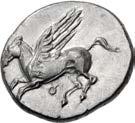
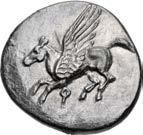

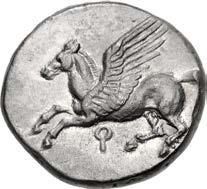
146.
Corinth. Circa 400-350/45 BC. AR Stater (22mm, 8.09 g, 7h). Pegasos flying left / Helmeted head of Athena left; Phrygian helmet to right. Ravel Period IV, 373 (P188/T293); Pegasi 120; BCD Corinth 50; HGC 4, 1832; BMC 134 (same dies); Pozzi 1667 (same dies). Toned, minor die wear, light scratch on reverse. EF. ($1000)
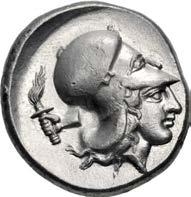
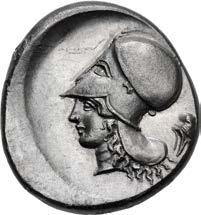
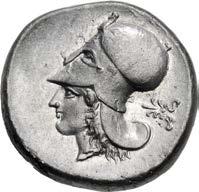
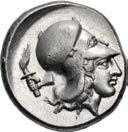
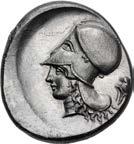

43
CORINTHIA,
147. CORINTHIA, Corinth. Circa 400-350/45 BC. AR Stater (22.5mm, 8.57 g, 2h). Pegasos flying left; tiny ˙ bellow belly / Helmeted head of Athena left; to right, forepart of horse right. Ravel Period IV, 423 (P205/T313); Pegasi 141; BCD Corinth 54; HGC 4, 1832. Lightly toned, die wear on obverse, minor double strike on reverse. EF ($750)
From the JTB Collection. Ex Nomos Obolos 22 (6 March 2022), lot 218.
148. CORINTHIA, Corinth. Circa 400-350/45 BC. AR Stater (20mm, 8.54 g, 1h). Pegasos flying right / Helmeted head of Athena right, without neck guard; to left, forepart of horse left. Ravel Period IV, – (P216/T320 [unlisted die combination]); Pegasi 145; BCD Corinth –; HGC 4, 1834 corr. (illustration numbered 1835). Lightly toned, a little die wear, slight die shift on reverse. EF. Very rare with Athena without neck guard on helmet. ($1000)

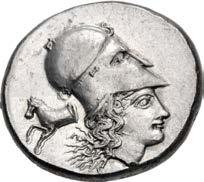
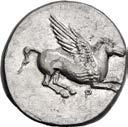
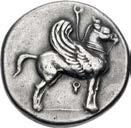
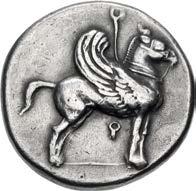
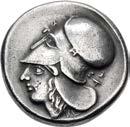

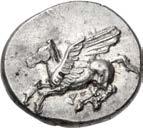
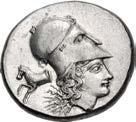
149. CORINTHIA, Corinth. Circa 400-350/45 BC. AR Stater (21mm, 8.19 g, 11h). Pegasos standing right, lead tied to a ring above / Helmeted head of Athena left; above, tiny U above t; behind neck, uncertain letter or symbol and E above t. Ravel Period IV, 632 corr. (control marks; P296/T423); Pegasi 244 corr. (same; same dies as illustration); BCD Corinth –; HGC 4, 1840; BMC 349 corr. (same; same dies). Toned, slight die wear, minor marks, small flan flaw on reverse. Good VF. Extremely rare issue, only the BM coin published, one additional in CoinArchives (a second is misattributed); and this is the finest of the three. ($1000)
From the Libertas Collection.
150. CORINTHIA, Corinth. Circa 350/45-285 BC. AR Drachm (12.5mm, 2.40 g, 10h). Pegasos standing left / Head of Aphrodite right, hair in sakkos; s[W] behind neck. BCD Corinth 169 (same dies); HGC 4, 1866; SNG Aarhus 615 (same obv. die). Dark iridescent tone, minor die break on reverse. EF. ($500)
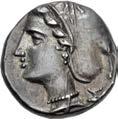

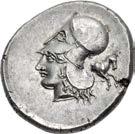
From the Weise Collection. Ex Triton XII (6 January 2009), lot 255.

44
151. SIKYONIA, Sikyon. Circa 335-330 BC. AR Stater (22.5mm, 12.22 g, 9h). Chimaera standing left; wreath above, sE below / Dove flying left; @ to left; all within wreath. BCD Peloponnesos 218; HGC 5, 201. Attractive iridescent tone over lustrous surfaces, a few minor marks and light scratches under tone. Near EF ($4000)
Ex Hess-Divo 310 (22 October 2008), lot 104.
152. SIKYONIA, Sikyon. Circa 335-330 BC. AR Stater (24.5mm, 11.97 g, 9h). Chimaera advancing left, forepaw raised; wreath above, sE below / Dove flying left; 5 below neck; all within wreath. BCD Peloponnesos 219; HGC 5, 201. Bright surfaces, traces of find patina, areas of corrosion. Near EF. ($2000)
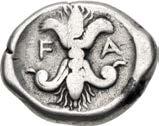
Ex Cayón Online Auction 80 (28 February 2022), lot 30014 (hammer €2900).
153. ELIS, Olympia. 83rd-85th Olympiad. 448-440 BC. AR Stater (23mm, 11.42 g, 11h). Eagle flying right, holding dead hare in its talons / Thunderbolt, with wings above and volutes below, within incuse circle. Seltman, Temple, Series VII, 58 (dies AH/αυ); BCD Olympia 31 var. (form of thunderbolt); HGC 5, 302. Lightly toned, minor marks, banker’s mark on obverse. VF. ($1500)
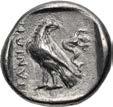
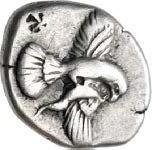
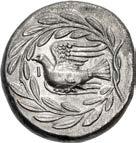
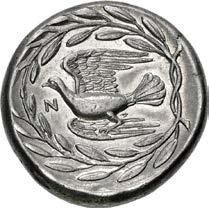

154. CRETE, Gortyna. Circa 300-280/70 BC. AR Drachm (19mm, 5.73 g, 8h). Head of female (Europa?) right / Bull standing right, head reverted. Svoronos, Numismatique 91; Le Rider, Crétoises, pl. XX, 16; SNG Copenhagen –. Struck with worn obverse die, overstruck on uncertain type. VF. Rare. ($750)
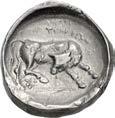
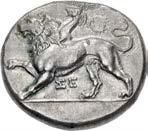
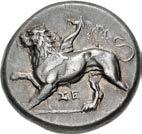

155. CRETE, Itanos. Circa 370-360 BC. AR Drachm (18.5mm, 5.11 g, 12h). Helmeted head of Athena left / Eagle standing left, head right; in right field, Triton upward, holding trident; all within incuse square. Puleo Period II, Series V; Svoronos, Numismatique 36; SNG Copenhagen 475. Lightly toned, minor porosity. VF. ($500)
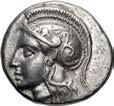
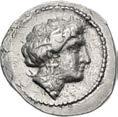
45
152 153 154 155
Extremely Rare Knossos Stater
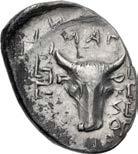
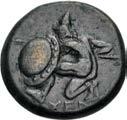
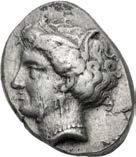
156. CRETE, Knossos. Circa 360-320 BC. AR Stater (21mm, 11.59 g, 2h). Head of female (Persephone?) left, wearing wreath of grain ears, triple-pendant earring, and pearl necklace / Head of bull facing; ˜Å˝ above, [˜o]5s-o˜˚ at sides; maeander pattern to outer left and right. Svoronos, Numismatique 17 var. (no legend above on rev.); Le Rider, Crétoises, pp. 15–16, pl. III, 1 var. (letters above on rev. retrograde; same obv. die); otherwise, unpublished in the standard references. Lightly toned, patches of find patina, some die wear on obverse, double struck and a little off center on reverse. VF. Extremely rare; an unpublished variety from one of the shortest issues at Knossos, which is a type missing from the major published collections. This is the only example in CoinArchives. ($5000)
Ex Berk BBS 199 (29 September 2016), lot 106; Brünn Collection (Nomos 12, 22 May 2016), lot 78, reportedly acquired in Italy prior to World War I.
157. TAURIC CHERSONESOS, Chersonesos. Circa 350 BC. Æ (20.5mm, 6.54 g, 6h). Artemis Parthenos, holding torch and reins, driving quadriga right / Hoplite, nude but for conical helmet, crouching left, holding shield and spear. Anokhin, Khersonesa 42; Anokhin 658; HGC 3, 2080. Dark green surfaces, traces of green encrustation. VF. ($500)
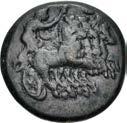
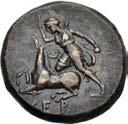
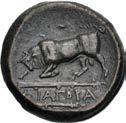
Ex David Freedman Collection (Triton V, 15 January 2002), lot 325 (erroneously attributed to Chersonesos in Thrace).
158. TAURIC CHERSONESOS, Chersonesos. Circa 300-290 BC. Æ (20.5mm, 6.99 g, 8h). Diagora–, magistrate. Artemis Parthenos left, striking stag, lying left, with spear she holds in her right hand, holding bow in her left / Bull butting left on horizontal club; horizontal bowcase in exergue. Anokhin, Khersonesa 78; Anokhin 701; HGC 3, –. Dark brown surfaces. Good VF. ($500)
Ex David Freedman Collection (Triton V, 15 January 2002), lot 326 (erroneously attributed to Chersonesos in Thrace).
46
Two Mint State Pantikapaion Staters
Pantikapaion was founded by Greek colonists from Miletos in the late seventh century BC. Situated on the west side of the Cimmerian Bosporos, in what is now called the Crimea, it achieved great prosperity through its exploitation of the abundant fisheries of the straits and the export of wheat from the Crimea. This wealth is attested by its splendid gold coinage, which commenced in the mid-4th century BC, and by the magnificently furnished rock tombs of its principal citizens in the same period. Later, it was to become a regional capital of the kingdom of Mithradates VI of Pontos (120-63 BC) and later still the seat of the kings of Bosporos (first century BC – fourth century AD). The coinage of Pantikapaion seems to have commenced with silver issues in the latter part of the fifth century BC, but it is for its beautiful gold staters that the mint is chiefly noted. They depict the head of the god Pan (a pun on the name of the city) and on the reverse, the griffin that Herodotos describes as being the guardian of the remote sources of gold.
160. CIMMERIAN BOSPOROS, Pantikapaion. Circa 340-325 BC. AV Stater (19mm, 9.10 g, 6h). Head of Pan left, wearing ivy wreath / Griffin, holding spear in its mouth, standing left, head facing, forepaw raised, on grain ear; ∏-Å-@ around. Frolova, Catalogue, dies unlisted; Anokhin 1021; MacDonald 54; HGC 7, 20; SNG BM Black Sea 864; Gulbenkian 588–90; Jameson 1361; Pozzi 1150; Sartiges 1580; Triton XXIII, lot 282 (same dies). In NGC encapsulation 6827265-001, graded MS, Strike: 5/5, Surface: 4/5, Fine Style. A beautiful example in higher relief than usual for series. ($75,000)

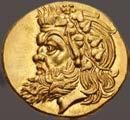
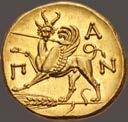
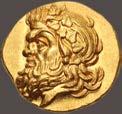
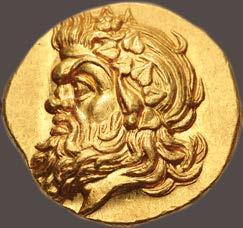
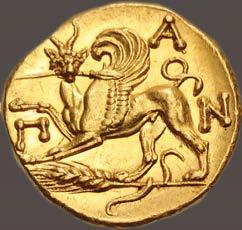
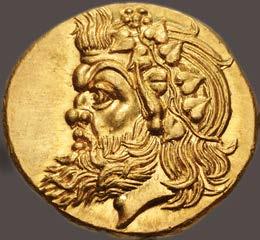
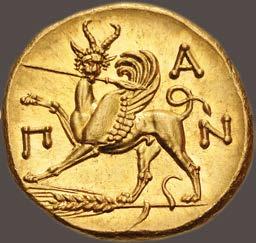
47
159. CIMMERIAN BOSPOROS, Pantikapaion. Circa 340-325 BC. AV Stater (20mm, 9.12 g, 11h). Head of Pan left, wearing ivy wreath / Griffin, holding spear in its mouth, standing left, head facing, forepaw raised, on grain ear; ∏-Å-@ around. Frolova, Catalogue, Group V, dies B/– (unlisted rev. die); Anokhin 1021; MacDonald 54; HGC 7, 20; SNG BM Black Sea 864; Gulbenkian 588–90; Jameson 1361; Pozzi 1150; Sartiges 1580; CNG 117, lot 165 (same dies); Triton XXVI, lot 181 (same dies); Triton VII, lot 151 (same dies). Lustrous. In NGC encapsulation 6827066-001, graded Ch MS, Strike: 5/5, Surface: 4/5, Fine Style. Well centered and struck on a broad flan. ($100,000)
159 160
161. KINGS of PONTOS. Mithradates VI Eupator. Circa 120-63 BC. AV Stater (20mm, 8.21 g, 12h). First Mithradatic War issue. In the name and types of Lysimachos of Thrace. Istros mint. Struck circa 88-86 BC. Diademed head of the deified Alexander right, with horn of Ammon / Athena Nikephoros seated left; d5 to inner left, 5% on throne; in exergue, ornate trident left. Callataÿ p. 139, dies D1/R1; AMNG I 482; HGC 3, 1799. Underlying luster. EF. Without the usual die wear, exceptional for issue. ($1500)
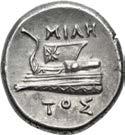
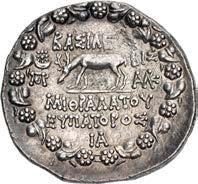
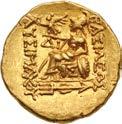
From the GTP Collection. Ex Tkalec (28 February 2013), lot 45; Tkalec (29 February 2008), lot 407.

162. KINGS of PONTOS. Mithradates VI Eupator. Circa 120-63 BC. AR Tetradrachm (32.5mm, 16.52 g, 12h). Pergamon mint. Dated BE year 212, month 11 (August 85 BC). Diademed head right / Stag grazing left; to left, star-in-crescent above (; to right, ∫5s (year) above ¬; 5Å (month) below; all within Dionysiac wreath of ivy and fruit. Callataÿ dies D3/R1; M.J. Price, “Mithradates VI Eupator, Dionysus, and the Coinages of the Black Sea” in NC 1968, pl. I, 6 = RG 16, pl. suppl. B, 12 = Mionnet II 10 (same dies); HGC 7, 338; DCA 688. Lightly toned, minor die break and a little roughness on obverse. Good VF. ($1500)
163. KINGS of PONTOS. Mithradates VI Eupator. Circa 120-63 BC. AR Tetradrachm (31.5mm, 16.86 g, 12h). Pergamon mint. Dated BE year 222, month 8 (May 75 BC). Diademed head right / Stag grazing left; to left, star-in-crescent above n; to right, ∫˚s (year) above o; ˙ (month) below; all within Dionysiac wreath of ivy and fruit. Callataÿ dies D30/R– (unlisted rev. die); RG 16; HGC 7, 338; DCA 692. VF. ($1500)
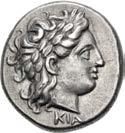

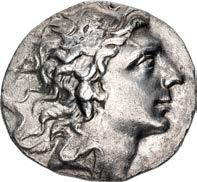
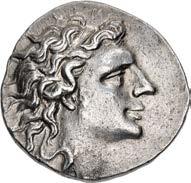
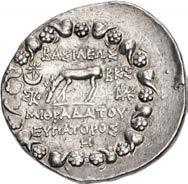


164. BITHYNIA, Kios. Circa 345-315 BC. AR Half Siglos – Hemidrachm (13mm, 2.67 g, 12h). Miletos, magistrate. Laureate head of Apollo right / Prow of galley left, decorated with star. RG 2; HGC 7, 553. Lightly toned. EF. Exceptional for issue. ($500)
From the GTP Collection. Ex Gorny & Mosch 240 (10 October 2016), lot 207; Gorny & Mosch 207 (15 October 2012), lot 258.
165. KINGS of BITHYNIA. Nikomedes IV Philopator. 94-74 BC. AR Tetradrachm (32mm, 16.30 g, 12h). Nikomedeia mint. Dated 206 BE (93/2 BC). Diademed head right / Zeus standing left, holding wreath and scepter; to left, eagle standing left on thunderbolt above Ů above 4% (date). Callataÿ p. 62, dies D169/R– (unlisted rev. die); RG 40; HGC 7, 646. Lightly toned, minor die wear on obverse, a few faint scratches in field on reverse. EF ($500)
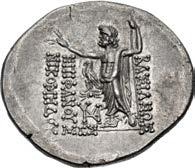
From the James Fox Collection.
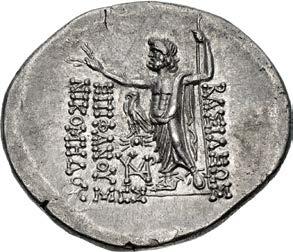
48
163
162
166. MYSIA, Kyzikos. Circa 600-550 BC. EL Myshemihekte – Twenty-fourth Stater (7mm, 0.64 g). Head of tunny left / Incuse square. Hurter & Liewald III 1.2; von Fritze I 5; Boston MFA 1388 = Warren 1420; SNG BN –. Slightly compact flan. EF. Well struck from fresh dies, with the tunny’s teeth clearly visible. ($750)


Ex Kleines Meisterwerk Collection.
167. MYSIA, Kyzikos. Circa 600-550 BC. EL Forty-eighth Stater (6mm, 0.33 g). Head of tunny left / Incuse square. Hurter & Liewald III 1.3; von Fritze I 3; cf. Boston MFA 1388 = Warren 1420 (twenty-fourth stater); SNG BN –; SNG von Aulock 7258. EF. Unusually clear tunny head. ($500)





Ex Kleines Meisterwerk Collection.
168. MYSIA, Kyzikos. Circa 600-550 BC. EL Hemihekte – Twelfth Stater (8mm, 1.19 g). Tunny left above tunny right / Quadripartite incuse square. Hurter & Liewald III 36.4; cf. Von Fritze I 15 (unlisted denomination); Boston MFA –;
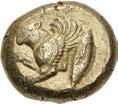
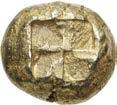

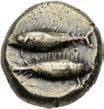

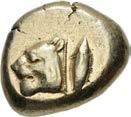
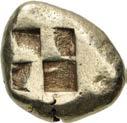


49
SNG BN –; Gulbenkian 604. Lightly toned. Good VF. Very rare, none in CoinArchives; not to be confused with the more common types with both tunnies facing the same direction. ($500)
169. MYSIA, Kyzikos. Circa 550-450 BC. EL Hemihekte – Twelfth Stater (7mm, 1.37 g). Fox standing left, head lowered, on tunny right / Quadripartite incuse square. Von Fritze I 35; Boston MFA 1410; SNG BN –; SNG von Aulock 1173 (same dies). Some roughness. VF. Extremely rare. ($500)
Ex Daniel Koppersmith Collecton (Classical Numismatic Group 94, 18 September 2013), lot 417; Classical Numismatic Group 88 (14 September 2011), lot 291.
170. MYSIA, Kyzikos. Circa 550-450 BC. EL Stater (20.5mm, 16.07 g). Head of lion left; to right, tunny upward / Quadripartite incuse square. Von Fritze I 39; Boston MFA 1414 = Warren 1537; SNG BN 178. Edge splits. VF. ($2000) Ex Siren Collection (Classical Numismatic Group Electronic Auction 502, 20 October 2021), lot 254.
171. MYSIA, Kyzikos. Circa 550-450 BC. EL Stater (16mm, 16.01 g). Forepart of winged lion left; to right, tunny upward / Quadripartite incuse square. Von Fritze I 96; cf. Boston MFA 1438 (hekte); SNG BN 237. Slightly off center, some roughness. Good VF. ($2000)
Ex Siren Collection (Classical Numismatic Group Electronic Auction 492, 26 May 2021), lot 180.
172. MYSIA, Kyzikos. Circa 550-450 BC. EL Stater (18mm, 15.71 g). Eagle, wings spread, tearing at and standing left on tunny left / Quadripartite incuse square. Von Fritze I 94; Boston MFA 1454 = Warren 1576; SNG BN –. Edge splits, a couple of light scratches. VF. Very rare. ($2500)
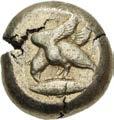
Ex Nomos 23 (30 November 2021), lot 122; Roma XX (29 October 2020), lot 212; Roma XIX (26 March 2020), lot 480.
173. MYSIA, Kyzikos. Circa 550-450 BC. EL Hekte – Sixth Stater (9.5mm, 2.67 g). Head of eagle left above head of tunny right / Quadripartite incuse square. Hurter & Liewald I 39 var. (unlisted denomination); Roma E-78, lot 469 (same dies); Gemini VII, lot 457 (same dies). Some die wear. VF. Extremely rare, apparently the third known hekte of this issue. ($750)
174. MYSIA, Kyzikos. Circa 550-450 BC. EL Hekte – Sixth Stater (11mm, 2.64 g). Head of ephebos left on diskos; below, tunny left / Quadripartite incuse square. Von Fritze I 105; Boston MFA 1476 = Warren 1496; cf. SNG BN 248 (stater). Weakly struck, light scratches, scuff on obverse. VF. Rare. ($500)
175. MYSIA, Kyzikos. Circa 550-450 BC. EL Stater (18mm, 16.04 g). Nude male kneeling left, holding a tunny by the tail / Quadripartite incuse square. Von Fritze I 112; Boston MFA 1487 = Warren 1502; SNG BN 253. Irregular flan, edge splits. VF. ($1500)
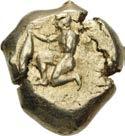

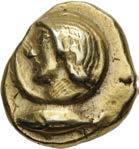
Ex Siren Collection (Classical Numismatic Group Electronic Auction 490, 21 April 2021), lot 684.
176. MYSIA, Kyzikos. Circa 450-330 BC. EL Myshemihekte – Twenty-fourth Stater (6mm, 0.65 g). Kithara; below, tunny right / Quadripartite incuse square. Cf. Von Fritze I 181 (unlisted denomination); cf. Boston MFA 1540 (stater); cf. SNG BN 325 (hemihekte); Gulbenkian 645. Slightly off center. VF. Rare. ($500)

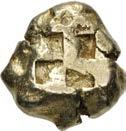





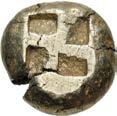
Ex Leu Numismatik Web Auction 15 (27 February 2021), lot 303.
177. MYSIA, Parion. 4th century BC. AR Hemidrachm (13mm, 2.52 g, 6h). Bull standing left, head right / Facing gorgoneion. SNG BN 1356–7. Attractive light iridescent tone. EF. ($500)



From the GTP Collection. Ex L. Shea Collection (Triton XX, 9 January 2017), lot 246; Classical Numismatic Group 82 (16 September 2009), lot 595.
178. ISLANDS off MYSIA, Prokonnesos. Circa 411-387 BC. AR Half Siglos – Hemidrachm (12mm, 2.42 g, 9h). Female head (Kore Soteira or Aphrodite?) left / Oinochoe. Thompson, Coinage 2; SNG Ashmolean 949. Lightly toned, slight die wear on obverse. Good VF. Attractive style. ($500)

From the Tiny Art Collection.

50
173 174 177 178
179. KINGS of PERGAMON. Eumenes I. 263-241 BC. AR Tetradrachm (28mm, 17.07 g, 12h). In the name of Philetairos. Pergamon mint. Struck circa 263-255/0 BC. Laureate head of Philetairos right / Athena enthroned left, right hand resting on shield set at her feet, left elbow resting on small sphinx seated right; transverse spear in background, ivy leaf above knee, v on throne, bow to right. Westermark Group III, obv. die XVIII; SNG BN 1607. Toned, a few marks. Near EF. ($2500)
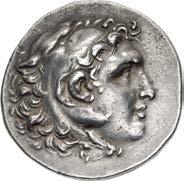
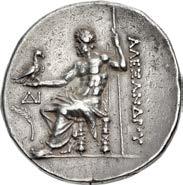
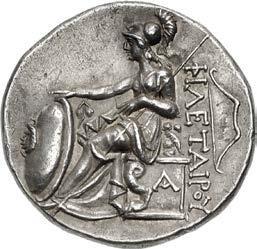
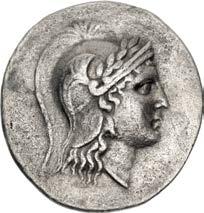
180. KINGS of PERGAMON. Eumenes I. 263-241 BC. AR Tetradrachm (30.5mm, 17.00 g, 12h). In the name of Philetairos. Pergamon mint. Struck circa 255/50-241 BC. Laureate head of Philetairos right / Athena enthroned left, elbow resting on shield to right, crowning dynastic name with wreath; transverse spear in background, ivy leaf to outer left, v to inner left, bow to right. Westermark Group IVA, obv. die XLIV:B; SNG BN 1610; SNG von Aulock 1356 (same obv. die); McClean 7674 (same obv. die). Lightly toned, minor marks. Good VF. ($2000)
181. KINGS of PERGAMON. Attalos I. 241-197 BC. AR Tetradrachm (30.5mm, 16.87 g, 11h). In the name and types of Alexander III of Macedon. Struck circa 210/05-197 BC. Head of Herakles right, wearing lion skin / Zeus Aëtophoros seated left; in left field, 6 above palm frond. Price 1485; Kleiner, Alexander, Series XIII, dies Q/40; SNG BN –; ANS inv. 1944.100.31393 (same dies). Lightly toned. Near EF. Fine style. Very rare, only two in Pella, one additional in CoinArchives, none in ANS Photofile. ($1500)

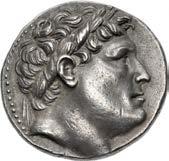

From the GTP Collection. Ex Nomos 5 (25 October 2011), lot 180 (hammer CHF 3800).
182. TROAS, Ilion. Circa 185-50 BC. AR Tetradrachm (33mm, 14.70 g, 12h). Dionysodoros, president of the aonothetai Helmeted head of Athena right / The Palladion: Athena Ilias standing right, holding distaff and filleted spear; monogram to inner left; to inner right, owl standing left, head facing. Ellis-Evans dies O8/R– (unlisted rev. die); Bellinger T42 (same obv. die). Toned, light roughness, numerous scratches. VF. Very rare, only two examples of this issue noted by Ellis-Evans, both in a museum collection (Berlin); one in CoinArchives. ($500)
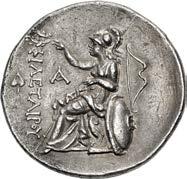
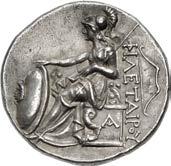
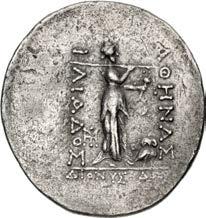
51
180 181
183. TROAS, Kebren. 5th century BC. AR Hemidrachm (11mm, 1.92 g, 3h). Head of ram right / Facing gorgoneion within incuse square. SNG Arikanturk 1, –; SNG Ashmolean –; SNG Copenhagen –; SNG von Aulock 7619 var. (obv. type left); Traité II 2331bis var. (same); CNG E-450, lot 117 (same dies); Gorny & Mosch 211, lot 310 (same dies [hammer €5000]). Attractively toned, light granularity. Good VF. Well centered and struck. Fine style. Very rare. ($500)

From the Tiny Art Collection.
184. AEOLIS, Kyme. Circa 215-200 BC. AR Tetradrachm (31.5mm, 17.06 g, 12h). In the name and types of Alexander III of Macedon. Head of Herakles right, wearing lion skin / Zeus Aëtophoros seated left; oinochoë in left field. Price 1612; ANS inv. 1954.39.3 (same obv. die). Lightly toned, slight die shift on obverse. EF. ($600)
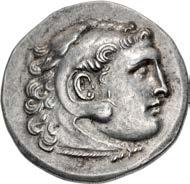
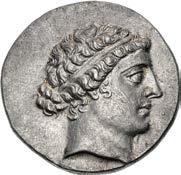
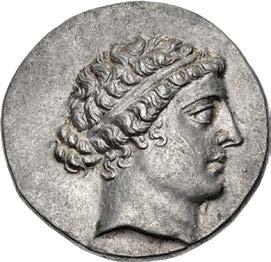

From the GTP Collection. Ex Gorny & Mosch 280 (11 October 2021), lot 289; Dr. W.R. Collection (Künker 333, 16 March 2020), lot 197; Numismatik Naumann 67 (1 July 2018), lot 116.
185. AEOLIS, Kyme. Circa 155-143 BC. AR Tetradrachm (30mm, 16.68 g, 12h). Stephanophoric type. Metrophanes, magistrate. Head of the Amazon Kyme right, wearing tainia / Horse prancing right; one-handled cup below raised foreleg; all within wreath. Oakley obv. die 1; SNG Copenhagen 104 (same obv. die); Jameson 1460 (same obv. die); de Luynes 2525 (same obv. die). Faintly toned, underlying luster, a little die wear and minor marks on obverse. Near EF. ($1500)
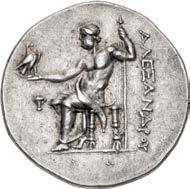
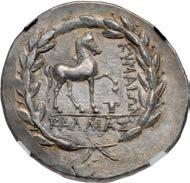


From the James Fox Collection.
186. AEOLIS, Kyme. Circa 155-143 BC. AR Tetradrachm (31mm, 16.73 g, 12h). Stephanophoric type. Kallias, magistrate. Head of the Amazon Kyme right, wearing tainia / Horse prancing right; one-handled cup below raised foreleg; all within wreath. Oakley obv. die unlisted; SNG Copenhagen 103. In NGC encapsulation 6557272-005, graded Ch XF, Strike: 4/5, Surface: 4/5. ($1500)

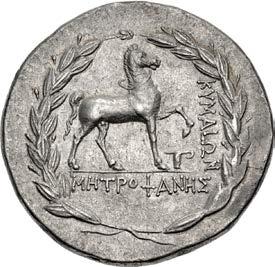
52
187. LESBOS, Unattributed Koinon mint. Circa 510-480 BC. BI Stater (20mm, 11..03 g). Confronted calves’ heads; olive tree between / Small incuse square punch. Lazzarini, Contribution, Series III; HGC 6, 1076. Deeply toned. VF. ($1000)




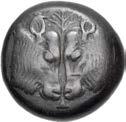
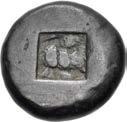
From the Libertas Collection, purchased 3 April 1987.
188. LESBOS, Mytilene. Circa 377-326 BC. EL Hekte – Sixth Stater (10.5mm, 2.57 g, 3h). Head of Apollo Karneios right, with horn of Ammon / Eagle standing right, head reverted, in linear square within incuse square. Bodenstedt Em. 104; HGC 6, 1030. Lightly toned, underlying luster. Choice EF. ($1500)

Ex North River Collection; Triton IV (5 December 2000), lot 247.
Ex Metropolitan Museum of Art and Ward Collections – Pedigreed to 1902
189. LESBOS, Mytilene. Circa 350-250 BC. AR Hemidrachm (12.5mm, 2.78 g, 12h). Laureate head of Apollo right / Kithara in linear square. SNG Arikantürk 2, 798–802 var. (ethnic); HGC 6, 1044; SNG Ashmolean 1551; Ward 656 (this coin). Old collection tone, slightly off center. Good VF. ($500)




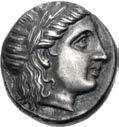

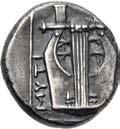


From the Libertas Collection. Ex Metropolitan Museum of Art Collection (Sotheby’s Zurich, 4 April 1973), lot 555; John Ward Collection (publ. 1902).
190. IONIA, Ephesos. Phanes. Circa 625-600 BC. EL Myshemihekte – Twenty-fourth Stater (6mm, 0.58 g). Forepart of stag right, head reverted / Abstract geometric pattern within incuse square. Fischer-Bossert, Phanes 42 (O24/R40T);

53
SNG von Aulock 7773. Some hairlines, a little die wear. Good VF. Well centered. ($750)
191. IONIA, Ephesos. Circa 600-550 BC. EL Trite – Third Stater (12.5mm, 4.69 g). “Primitive” bee / Two incuse squares. Karwiese Series II.1, Type 2, 6–8 (same die and punches); SNG Kayhan –; SNG von Aulock 1768 (same obv. die); Rosen 257 (same die and punches). VF. Rare. ($750)
192. IONIA, Ephesos. Circa 550-500 BC. AR Drachm (13.5mm, 3.41 g). Bee / Incuse punch. Karweise Series V, 10–2; SNG Kayhan 113. Lightly toned, granular surfaces, slightly off center on obverse. Good VF. ($500)
191 192
From the Tiny Art Collection.
193. IONIA, Ephesos. Circa 390-325 BC. AR Tetradrachm (23.5mm, 15.13 g, 12h). Demagores (I), magistrate. Struck circa 360-350 BC. Bee with straight wings / Forepart of stag right; palm tree to left. Karwiese II, Series 11.1, dies O88/R1; Kricheldorf XXII, lot 90 (same dies). Toned, traces of find patina, some minor marks, softly struck on obverse. VF. Well centered. ($1500)

From the Weise Collection. Ex CNG inventory 711411 (March 1999).
194. IONIA, Ephesos. Circa 390-325 BC. AR Tetradrachm (24mm, 15.22 g, 12h). Megaletor, magistrate. Struck circa 350-340 BC. Bee with straight wings / Forepart of stag right; palm tree to left. Karwiese II, Series 11.1, dies O119/R1; Giessener Münzhandlung 33, lot 176 = Schulten IV, lot 155 (same dies). Lightly toned, minor marks, trace deposits on obverse, minor flan flaw on reverse. Good VF. ($2000)
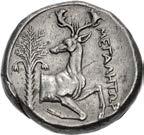
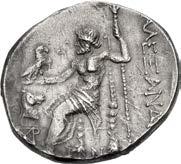
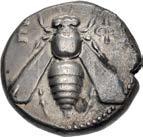
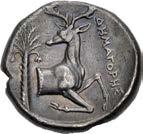

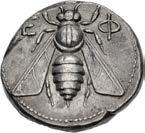

Unpublished Themistokles Obol
195. IONIA, Magnesia ad Maeandrum. Themistokles. Circa 465-459 BC. AR Obol (8mm, 0.69 g, 5h). Head of Hephaistos right, wearing laureate pilos; Q-E flanking / P in dotted square border within incuse square. Cf. Nollé & Wenninger Th3–5 (larger and smaller denominations). Porous. Near EF. Well struck. Unpublished as an obol. Extremely rare, none in CoinArchives (the CNG 55, lot 506 example is actually a trihemiobol). ($500)
Vădan Plate Coin

196. IONIA, Magnesia ad Maeandrum. Circa 225-200 BC. AR Tetradrachm (30.5mm, 16.15 g, 1h). In the name and types of Alexander III of Macedon. Head of Herakles right, wearing lion skin / Zeus Aëtophoros seated left; in left field, head of horse right above Ū; @ below throne, [maeander pattern in exergue]. Vădan Group 2, dies 33/108, 1 (this coin, illustrated); Price 2051 var. (monogram below throne); Mektipini 383 var. (same; same obv. die). Toned, die break on obverse, die rust/ wear on reverse. Good VF. Very rare. ($500)


From the Otrera Collection, purchased from Frank Kovacs, 4 November 2013.
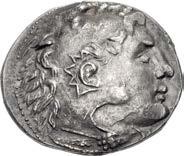
54
197. IONIA, Phokaia. Circa 625/0-522 BC. EL Hekte – Sixth Stater (10mm, 2.57 g). Head of griffin left; [to right, small seal upward] / Incuse square. Bodenstedt Em. 12. Some granularity, light scratches on reverse. EF. ($750)
198. IONIA, Phokaia. Circa 521-478 BC. EL Hekte – Sixth Stater (11mm, 2.56 g). Bearded head left, wearing crested helmet; below, small seal right / Quadripartite incuse square. Bodenstedt Em. 44. Near EF. Rare. ($750)

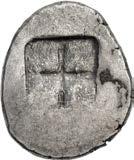

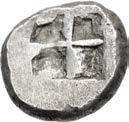

Ex Prospero and Hunt Collections – Bodenstedt Plate Coin

199. IONIA, Phokaia. Circa 478-387 BC. EL Hekte – Sixth Stater (10mm, 2.53 g). Bearded head of Silenos facing, wearing ivy wreath; to left, small seal upward / Quadripartite incuse square. Bodenstedt Em. 67.3, dies a/α (this coin, illustrated on pl. 47, obv. enlarged on pl. 7). In NGC encapsulation 4936354-013, graded AU, Strike: 5/5, Surface: 3/5, Fine Style, scuff. ($2500)




Ex New York Sale XL (12 January 2017), lot 1006; Prospero Collection (New York Sale XXVII, 4 January 2012), lot 521; Nelson Bunker Hunt Collection (Part II, Sotheby’s New York, 21 June 1990), lot 502; Numismatic Fine Arts V (23 February 1978), lot 158; Kastner 4 (27 November 1973), lot 125.

200. IONIA, Teos. Late 6th-early 5th century BC. AR Stater (20mm, 11.62 g). Griffin seated right, raising forepaw / Quadripartite incuse square. Matzke Series Bc1; Balcer 1–7; SNG Copenhagen –; SNG von Aulock 2252. Lightly toned, a little off center on obverse. VF. ($1000)
Ex J.B. Collection (Classical Numismatic Group Electronic Auction 455, 30 October 2019), lot 143, purchased from Calgary Coin Gallery, Autumn 2002.
201. IONIA, Teos. Circa 450-425 BC. AR Stater (22.5mm, 11.80 g). Griffin seated right, raising forepaw; grape bunch and leaf to lower right / Quadripartite incuse square. Matzke Group Cb1; Balcer Group LIII, 102 (dies A102/P134); Jameson 1517 (same dies). Lightly toned, underlying luster, some die wear and area of weak strike on obverse, deposits on reverse. Near EF. ($1000)
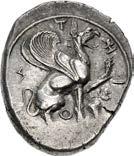
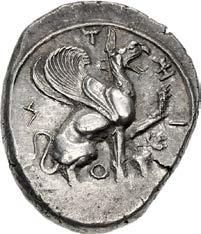
From the Libertas Collection.
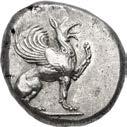
55
202. IONIA, Uncertain. Circa 650-600 BC. EL Trite – Third Stater (11.5mm, 4.63 g). Lydo-Milesian standard. Globular surface with cluster of pellets / Two incuse squares. Weidauer –; Traité I 3; SNG Kayhan –; SNG von Aulock 7761; Boston MFA 1749; Elektron –; Pozzi 2350; Rosen 253. Minor doubling on obverse. As made. ($1000)


203. IONIA, Uncertain. Circa 600-550 BC. EL Trite – Third Stater (11mm, 4.73 g). Lydo-Milesian standard. Uncertain type (carapace of scarab beetle?) / Two incuse squares. Cf. Triton XXV, lot 254 (same right side incuse, but in a slightly earlier die state). Struck with worn obverse die. As made. ($1500)
204. ISLANDS off IONIA, Chios. Circa 380-350 BC. AR Drachm (14.5mm, 3.66 g, 6h). Ippias, magistrate. Sphinx seated left; to left, grape bunch above amphora / Quadripartite incuse square, with striated quarters and thick bands; 5ππ5Ås on horizontal band. Mavrogordato 50; HGC 6, 1125. Lightly toned. Good VF. Rare. Struck in high relief. ($1000)
205. ISLANDS off IONIA, Chios. Circa 270-220 BC. AR Tetradrachm (30.5mm, 16.92 g, 11h). In the name and types of Alexander III of Macedon. Head of Herakles right, wearing lion skin / Zeus Aëtophoros seated left; in left field, sphinx seated left above Ŭ; A below throne. Bauslaugh, Posthumous, Series 15B var. (monogram not in circle; obv. die 24 [not recorded for series 15]); Price 2340 var. (monogram retrograde); HGC 6, 1132; Künker 333, lot 268 = Gorny & Mosch 233, lot 1320 (same rev. die). Lightly toned, underlying luster. EF. Extremely rare, only one other example published (the Gorny/ Künker piece in CoinArchives). ($500)
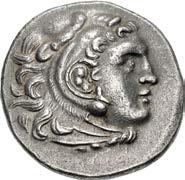
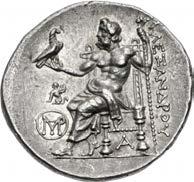
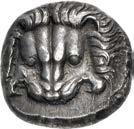

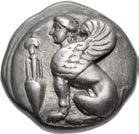
It is likely that this monogram is actually the correct reading for the monogram of Price 2341. Price 2341 references Bauslaugh Series 15B, but incorrectly copies the monogram, omitting the horizontal line at the top of the M. Bauslaugh, in turn, forgot the circle around the monogram on his Series 15A, so it is likely that it was also erroneously omitted on his Series 15B. If that is the case, the monogram matches that found here. Unfortunately, the only example cited for Bauslaugh 15B is a coin in Milan that is unpublished.
Ex Browne Collection – Pedigreed to 1926

AR Tetradrachm (22mm, 15.01 g, 9h). Rhodian standard. Hegesianax, magistrate. Facing lion scalp / Forepart of bull right; [˙˝˙s5Å@Åx above], olive branch to left, sÅ and g below; all within shallow incuse square. Barron Class X, 117b (A53/P115 – this coin); HGC 6, 1218. Lovely old cabinet tone, slightly off center. Good VF. ($7500)
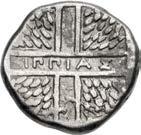
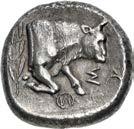
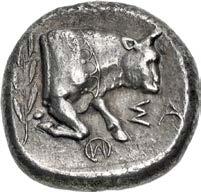
Ex Christopher Corbally Browne Collection (Sotheby’s, 25 March 1935), lot 338; Helbing [52] (24 October 1927), lot 3075; Ars Classica XII (18 October 1926), lot 1826.
CNG thanks John Voukelatos for providing the Ars Classica and Helbing pedigrees for this coin.


56
Ex Kleines Meisterwerk Collection.
206. ISLANDS off IONIA, Samos. Circa 408/4-380/66 BC.
202 203
207. KINGS of LYDIA. temp. Alyattes – Kroisos. Circa 620/10-550/39 BC. EL Trite – Third Stater (12.5mm, 4.73 g). Lydo-Milesian standard. Sardes mint. Head of roaring lion right; sun with multiple rays on forehead / Two incuse square punches. Weidauer Group XVI, 86–7; Kurth G24–5; cf. SNG Ashmolean 749–53. Light scratches, scrape on obverse. VF. ($1500)


From the Kenneth S. Abramowitz Collection.
208. KINGS of LYDIA. temp. Alyattes – Kroisos. Circa 620/10-550/39 BC. EL Trite – Third Stater (13.5mm, 4.58 g). Lydo-Milesian standard. Sardes mint. Head of roaring lion right; sun with multiple rays on forehead / Two incuse square punches. Weidauer Group XVI, 88; Kurth G24–5; cf. SNG Ashmolean 749–53. VF. ($1000)


209. KINGS of LYDIA. temp. Alyattes – Kroisos. Circa 620/10-550/39 BC. EL Hemihekte – Twelfth Stater (7mm, 1.19 g). Lydo-Milesian standard. Sardes mint. Head of roaring lion right, “sun” with no rays on forehead / Incuse square. Weidauer Group XVI, 90; Kurth G29–30; SNG Ashmolean 757. Trace deposits. Near EF. Well centered. ($500)
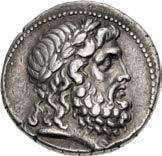



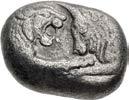
210. KINGS of LYDIA. Kroisos. Circa 564/53-550/39 BC. AV Twelfth Stater (6mm, 0.67 g). Light standard. Sardes mint. Confronted foreparts of lion and bull / Incuse square. Walburg Group VI; Berk 10–3; Kurth G56. A few minor marks. Good VF. Well centered. ($1000)



211. KINGS of LYDIA. Kroisos. Circa 564/53-550/39 BC. AR Stater (19.5mm, 10.60 g). Sardes mint. Confronted foreparts of lion right and bull left / Two incuse squares of unequal size. Berk 20; SNG Ashmolean 760. Darkly toned, light marks. VF. Excellent metal. Choice for issue. ($1500)
Ex Matthew Curtis Collection (Classical Numismatic Group Electronic Auction 460, 29 January 2020), lot 259.

212. KINGS of LYDIA. Kroisos. Circa 564/53-550/39 BC. AR Stater (20mm, 10.47 g). Sardes mint. Confronted foreparts of lion right and bull left / Two incuse squares of unequal size. Berk 20; SNG Ashmolean 760. Toned, typical granular surfaces. VF. ($1000)


213. CARIA, Antioch ad Maeandrum. Early-Mid 1st century BC. AR Tetradrachm (26.5mm, 16.04 g, 12h). Diotrephes, magistrate. Laureate head of Apollo right; bow and quiver over shoulder / Zebu bull standing left, head facing; maeander pattern in exergue. Thonemann Group A, 1.e (O1/R2); HN Online 1528. Lightly toned, scattered marks and scratches. Near VF. ($1000)
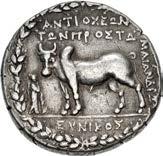
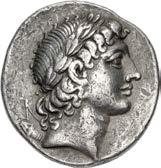
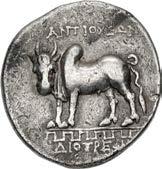
From the JTB Collection.
214. CARIA, Antioch ad Maeandrum. Early-Mid 1st century BC. AR Tetradrachm (27mm, 16.34 g, 12h). Eunikos (II), magistrate. Laureate head of Zeus right / Zebu bull standing left, head facing; to left. female standing right, placing hand on chin; all within circular maeander pattern. Thonemann Group A, 17.e–f (O18/R33); HN Online 2069. Lightly toned, light scratch in field on obverse. Good VF. Rare. ($1500)
57
211 212 207 208 209 210 213 214
Pedigreed to 1971
215. CARIA, Knidos. Circa 490-465 BC. AR Drachm (17mm, 6.19 g, 6h). Forepart of lion roaring right / Head of Aphrodite right within incuse square. Cahn Series III, 65 (V33/R47); HN Online 301; SNG Blackburn 982 (same dies); SNG Copehagen 225 (same dies). Toned, minor die flaw on reverse. VF. ($750)
From the Otrera Collection. Ex Vinchon (27 February 1971), lot 156.
216. CARIA, Knidos. Circa 411-405/4 BC. AR Drachm (16mm, 6.18 g, 3h). Forepart of lion roaring right / Head of Aphrodite right, hair in sphendone; Å behind neck; all within incuse square. Cahn Series VI.1, 93 (V45/R63); HN Online 302; SNG Keckman 138 (same dies); SNG von Aulock 2598 (same rev. die); SNG Copenhagen 252 (same dies); Waddington 2354 (same dies); de Luynes 2704 (same dies); Boston MFA 1956 (same rev. die). Toned, a little granularity. Good VF. Well centered. ($500)
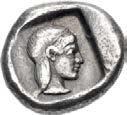
Lot includes an old Münzen und Medaillen AG stock ticket.
217. SATRAPS of CARIA. Maussolos. Circa 377/6-353/2 BC. AR Tetradrachm (22.5mm, 15.30 g, 12h). Halikarnassos mint. Struck circa 370-360 BC. Laureate head of Apollo facing slightly right, drapery around neck / Zeus Labraundos standing right, holding labrys and scepter; small ∫ between leg and scepter. Konuk, Identities 21; Babelon, Perses 400; HN Online 646. Lightly toned, minor marks, light scratch in field on reverse. Good VF. Well centered. ($1500)

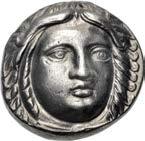
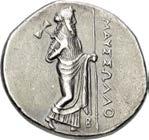
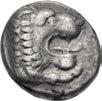
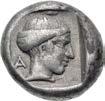

218. SATRAPS of CARIA. Hidrieus. Circa 351/0-344/3 BC. AR Didrachm (19mm, 6.81 g, 12h). Halikarnassos mint. Laureate head of Apollo facing slightly right, drapery around neck / Zeus Labraundos standing right; ß between leg and scepter. Konuk, Identities 27; HN Online 234. Toned, slight die wear, scrape on reverse. VF. ($750)
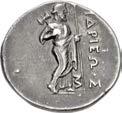



219. SATRAPS of CARIA. Pixodaros. Circa 341/0-336/5 BC. AV Sixth Daric (8mm, 1.38 g, 1h). Persian standard. Halikarnassos mint. Laureate head of Apollo left / Zeus Labraundos standing right, holding scepter. Konuk, Identities –; Babelon, Perses –; HN Online 56; SNG von Aulock 2372; SNG Kayhan 896. Lustrous, thin die break on obverse, slight die shift on reverse. EF. Well centered. ($2000)

58
217 218
Exceptional Specimen from the Pixodarus Hoard
220. SATRAPS of CARIA. Pixodaros. Circa 341/0-336/5 BC. AR Didrachm (20mm, 6.91 g, 12h). Halikarnassos mint. Head of Apollo facing slightly right, wearing laurel wreath, drapery around neck / Zeus Labraundos standing right; π5$odÅroU to right. Pixodarus 25h (A3/P11 – this coin); Konuk, Identities 30; HN Online 2216; SNG München 15 (same dies); Weber 6608 (same dies). In NGC encapsulation 6156139-005, graded Ch AU, Strike: 5/5, Surface: 5/5, Fine Style. ($4000)
Ex Classical Numismatic Group 117 (19 May 2021), lot 240; Künker 333 (16 March 2020), lot 823; Gasvoda Collection (Triton XXII, 9 January 2019) lot 270; CNG inventory 995859 (January 2015); Numismatica Ars Classica 78 (26 May 2014), lot 318; Roma VI (29 September 2013), lot 656; Leu 91 (10 May 2004), lot 173; Peus 343 (26 April 1995), lot 150; Pixodarus Hoard (CH IX, 421).
221. SATRAPS of CARIA. Pixodaros. Circa 341/0-336/5 BC. AR Didrachm (19mm, 6.99 g, 12h). Halikarnassos mint. Laureate head of Apollo facing slightly right, drapery around neck / Zeus Labraundos standing right. Konuk, Identities 30; HN Online 2216. Toned, underlying luster. Good VF. Perfectly centered portrait. ($1000)
222.
Pixodaros. Circa 341/0-336/5 BC. AR Didrachm (20mm, 6.93 g, 12h). Halikarnassos
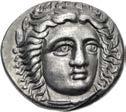
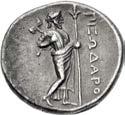

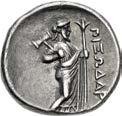
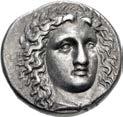
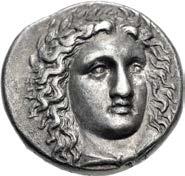
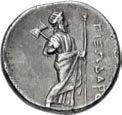
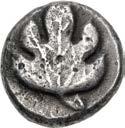
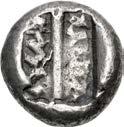
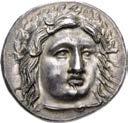
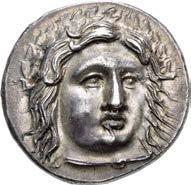
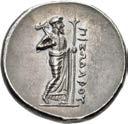
From the JTB Collection.
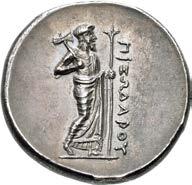
59
SATRAPS of CARIA.
mint. Laureate head of Apollo facing slightly right, drapery at neck / Zeus Labraundos standing right, holding scepter. Konuk, Identities 30; Babelon, Perses 414–21; HN Online 2216. Toned, traces of find patina. Good VF. ($1000)
223. SATRAPS of CARIA. Pixodaros. Circa 341/0-336/5 BC. AR Didrachm (19.5mm, 6.88 g, 1h). Halikarnassos mint. Laureate head of Apollo facing slightly right, drapery around neck / Zeus Labraundos standing right. Konuk, Identities 30; HN Online 2216. Remnants of find patina, underlying luster, area of minor pitting at edge on reverse. Good VF. ($1000)
224. ISLANDS off CARIA, Rhodos. Kamiros. Circa 480-460 BC. AR Stater (19.5mm, 11.98 g). Fig leaf / Rectangular incuse divided lengthwise by a thick band. HGC 6, 1380; HN Online 1235; SNG Ashmolean 508. Toned, some pitting and granularity. VF. ($750)
221
222
225. ISLANDS off CARIA, Rhodos. Kamiros. Circa 480-460 BC. AR Stater (15mm, 11.81 g). Fig leaf / Rectangular incuse divided lengthwise by a thick band. HGC 6, 1383; HN Online 368; SNG von Aulock 2779. Lightly toned, patches of find patina, some cleaning scratches. VF. ($750)
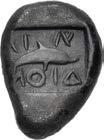
From the JTB Collection.
226. ISLANDS off CARIA, Rhodos. Lindos. Circa 500-475 BC. AR Stater (17.5mm, 12.98 g, 6h). Head of roaring lion right / Dolphin swimming right; ¬5-˜/˜o5d above and below; all within incuse square. Cahn, Archaischen, Group H; HN Online 1462; HGC 6, 1399; SNG Ashmolean 522 = Hamburger 98, lot 825; Kraay & Hirmer 641 = Traité I 781; Kunstfreund 12 = Jameson 2312; Gorny & Mosch 240, lot 241. Find patina, some roughness on obverse. VF. Extremely rare, only four examples published of this issue. ($10,000)
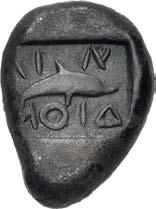
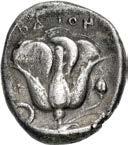

Ex Classical Numismatic Review XLV.2 (Summer 2020), no. 531643; Triton XXIII (14 January 2020), lot 438.
Facing Head of Helios in High Relief
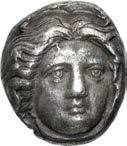
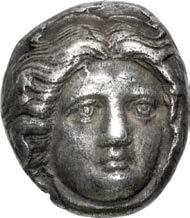
227.
Circa 404-385 BC. AR
(21mm, 14.65 g, 12h). Head of Helios facing slightly right / Rose with bud to right; to left, f above phiale; all within incuse square. Ashton 46; Hecatomnus 143 var. (A88/P– [unlisted rev. die]); HN Online 1042; HGC 6, 1418. Old cabinet tone, slight roughness, minor die break on obverse, light scratch in field on reverse. VF. High relief. ($2000)

The polis of Rhodes was created out of a union of the cities of Ialysos, Kamiros, and Lindos in 408/7 BC, and immediately began to issue a coinage that endured until the Roman era. The rose was chosen as the perennial reverse type, a punning allusion to the city’s name (Rhodes). The obverse type was the head of Helios, the city’s patron deity. The first issue of Rhodian coinage was a brief issue of tetradrachms that stand among the finest pieces of Classical Greek numismatic art. On the obverse, the head of Helios is displayed in a nearly frontal position, with his hair dramatically swept back from a central part. Such facing head coins were not novel by this time, but the boldness of the design and the particularly high relief of the dies sets the Rhodian coinage apart from all others. Moreover, this facing head type remained the standard obverse type for most of the Rhodian issues into the first century AD. The city’s devotion to Helios led it to build a gigantic bronze statue of the sun god, the Colossus of Rhodes, one of the Seven Wonders of the Ancient World.
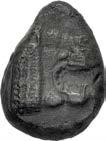
60
ISLANDS off CARIA, Rhodos. Rhodes.
Tetradrachm
88/42 BC-AD 14. AR Drachm (20mm, 4.00 g, 10h). Heliodoros, magistrate. Radiate head of Helios facing slightly right / Rose seen from above; thunderbolt below. Ashton & Weiss 207 (A60/ P204); HN Online 417; HGC 6, 1456; SNG von Aulock 2836 (same rev. die). Deep iridescent tone. EF. ($500)
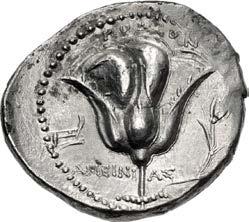
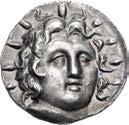
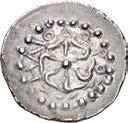
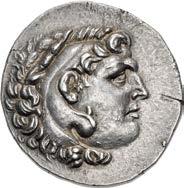
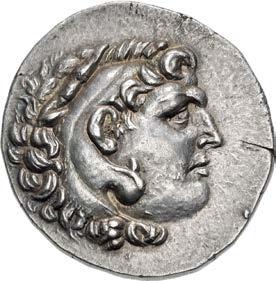
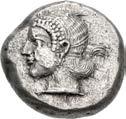
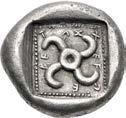
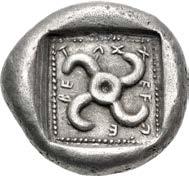
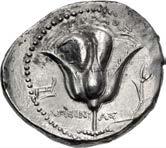
From the GTP Collection. Ex CNG inventory 973513 (January 2014); Stack’s (11 January 2010), lot 163.
11 (211/0 BC).
(30.5mm, 16.55 g, 12h). In the name and types of
of Herakles right, wearing lion skin / Zeus Aëtophoros seated left;
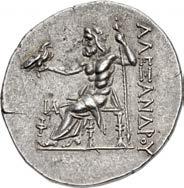
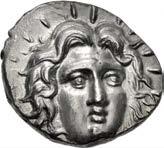
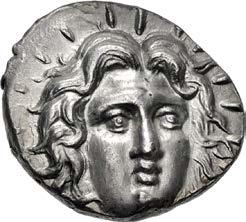
61
228. ISLANDS off CARIA, Rhodos. Rhodes. Circa 229-205 BC. AR Tetradrachm (27mm, 13.31 g, 12h). Ameinias, magistrate. Radiate head of Helios facing slightly right / Rose with bud to right; prow to left. Ashton 212; HN Online 387; HGC 6, 1432. Minor doubling on reverse. Near EF. ($1500)
229. ISLANDS off CARIA, Rhodos. Rhodes. Circa
230. LYCIA, Phaselis. Circa 218/7-186/5 BC. AR Tetradrachm
Alexander III of Macedon. Dated CY
Head
in left field, 5Å (date) above f. Heipp-Tamer 226–8 and 233 (unlisted dies); Price 2849; DCA 315. Light iridescent tone, minor flan crack. EF. ($750)
From the GTP Collection. Ex Lanz 164 (23 May 2017), lot 99 (hammer €1600).
231. DYNASTS of LYCIA. Teththiweibi. Circa 450-430/20 BC. AR Stater (19.5mm, 9.73 g, 6h). Wehñte (Phellos) mint. Head of Aphrodite left, hair in band and tied in bun at the back / Tetraskeles within incuse square. Müseler V, 31; Falghera –; SNG Copenhagen Supp. –; Reuter 59. Lightly toned, granular surfaces, some die wear on obverse. Near EF. Rare. ($1000)
232. DYNASTS of LYCIA. Teththiweibi. Circa 450-430/20 BC. AR Stater (16.5mm, 8.19 g, 11h). Xãkbi (Kandyba) mint. Winged lion standing right / Tetraskeles within incuse square. Müseler V, 42; Falghera 137; SNG Copenhagen Supp. 426. Toned, granular surfaces. Good VF. ($750)

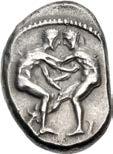
233. PAMPHYLIA, Aspendos. Circa 380/75-330/25 BC. AR Stater (19mm, 10.88 g, 1h). Two wrestlers grappling / Slinger in throwing stance right; clockwise triskeles to left; to right, Athena, holding spear and shield, standing right on pedestal; all within pelleted square border. Tekin Series 4; SNG BN –; SNG von Aulock 4503 var. (no pedestal). Lightly toned, struck with slightly worn obverse die, countermark on reverse. Good VF. Very rare, only three in CoinArchives. ($1000)
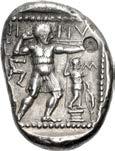
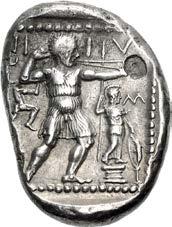
From the Libertas Collection, purchased 10 February 1980.
Enigmatic Obverse Legend
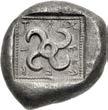
234. PAMPHYLIA, Aspendos. Circa 380/75-330/25 BC. AR Stater (22.5mm, 11.01 g, 11h). Two wrestlers grappling; V@ between, ÂE@Et¨s E¬¨fÅ in exergue / Slinger in throwing stance right; counterclockwise triskeles to right; all within dotted square border. Tekin Series 4; SNG BN 97-8; SNG von Aulock 4568 (same obv. die); Arslan & Lightfoot 92 (same dies); Izmir 195 (same obv. die). Lightly toned, underlying luster, struck with slightly worn obverse die. EF. ($750)
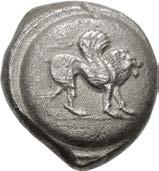

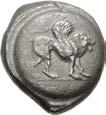
From the GTP Collection. Ex Lanz 166 (11 June 2018), lot 62.
As renderings of athleticism and action, the coins of Aspendos have seldom been matched. Aspendos was a colony of Argos located at the southern coast of Asia Minor on the navigable river Eurymedon, which made it an important emporium and naval base. Its famous wrestler coinage commences circa 410 BC. Wrestling was one of the premier events of Greek sports, practiced at the Olympic Games and at gymnasia throughout the ancient world. Poses of the wrestlers vary greatly. Sometimes, as here, they grasp each other’s arms; in other cases one tries to punch or trip the other. This specimen is notable for the tiny inscription below the wrestlers, which seems to spell out two complete names. They could represent mint magistrates; however, one 19th century scholar postulated that they referred to the wrestlers, naming one as Menetos (“Stalwart”) and the other as Elypsas (“Slippery”).
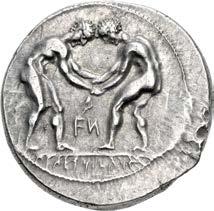
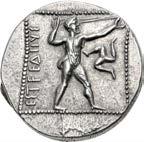
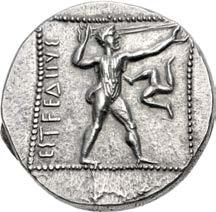
62
235. PAMPHYLIA, Side. Circa 180-170 BC. AR Tetradrachm (28mm, 16.04 g, 12h). Kleuch–, magistrate. Helmeted head of Athena right / Nike advancing left, holding wreath; pomegranate to left. SNG BN 699. In NGC encapsulation 6324089016, graded Ch AU, Strike: 5/5, Surface: 4/5. ($600)
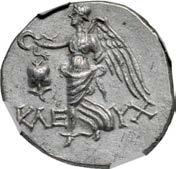
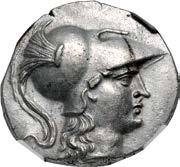
236. CILICIA, Kelenderis. Circa 410-375 BC. AR Stater (19.5mm, 10.44 g, 12h). Nude youth, holding whip, dismounting from horse rearing right / Goat kneeling left, head right; ivy leaf above, π to left; all within shallow incuse circle. Casabonne Type 4; Celenderis Series IV, unlisted variety; SNG BN –; BMC 26. Lightly toned, struck with slightly worn dies. Good VF. ($400)
237. CILICIA, Kelenderis. Circa 410-375 BC. AR Stater (22mm, 10.68 g, 3h). Nude youth, holding whip, dismounting from horse rearing right / Goat kneeling left, head right; branch with three ivy leaves above; [all within shallow incuse circle]. Casabonne Type 4; Celenderis Series IV, unlisted variety; SNG BN –; SNG Levante 24 (same dies); Triton XXV, lot 290 (same dies). Lightly toned, underlying luster. Near EF. ($400)
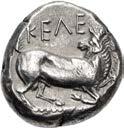
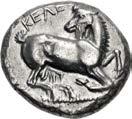
238. CILICIA, Kelenderis. Circa 410-375 BC. AR Stater (19.5mm, 10.54 g, 5h). Nude youth, holding whip, dismounting from horse rearing right / Goat kneeling left, head right; uncertain letter(s) or monogram in exergue; [all within shallow incuse circle]. Casabonne Type 4; Celenderis Series IV, unlisted variety; CNG 123, lot 171 (same dies); otherwise, unpublished in the standard references. Much residual luster, minor die wear. Near EF. ($400)
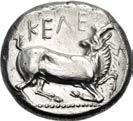
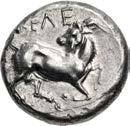
239. CILICIA, Kelenderis. Circa 410-375 BC. AR Stater (20.5mm, 10.60 g, 12h). Nude youth, holding whip, dismounting from horse rearing right / Goat kneeling right, head left, within shallow incuse circle. Casabonne Type 4; Celenderis Series IV, unlisted variety; SNG BN 69–70. Slightly compact flan. Near EF. ($400)
240. CILICIA, Kelenderis. Circa 410-375 BC. AR Stater (20mm, 10.69 g, 1h). Nude youth, holding whip, dismounting from horse rearing right / Goat kneeling right, head left, within shallow incuse circle. Casabonne Type 4; Celenderis Series IV, 24 var. (unlisted dies); SNG BN 69–70 var. (ethnic); SNG Levante 25. Lightly toned, some die wear on obverse. Near EF. ($400)

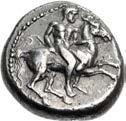
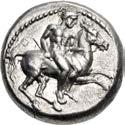
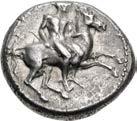
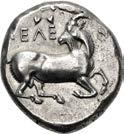
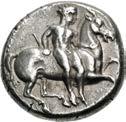
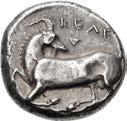
241. CILICIA, Kelenderis. Circa 410-375 BC. AR Stater (20mm, 10.75 g, 9h). Nude youth, holding whip, dismounting from horse rearing right / Goat kneeling right, head left, within shallow incuse circle. Casabonne Type 4; Celenderis Series IV, 24 var. (unlisted dies); SNG BN 69–70 var. (ethnic); SNG Levante 25. Residual luster, some die wear, a little off center on obverse. Near EF. ($400)
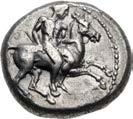
63
236 237 238 239 240 241
242. CILICIA, Kelenderis. Circa 410-375 BC. AR Stater (21.5mm, 10.71 g, 1h). Nude youth, holding whip, dismounting from horse rearing right / Goat kneeling right, head left; É above; all within shallow incuse circle. Casabonne Type 4; Celenderis Series IV, unlisted variety; SNG BN 73 (same dies); SNG Hunterian 923 (same dies). Lightly toned, underlying luster, double struck on reverse. Near EF. ($400)
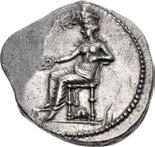
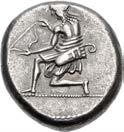
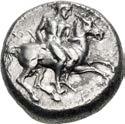

243. CILICIA, Kelenderis. Circa 410-375 BC. AR Stater (19.5mm, 10.63 g, 6h). Nude youth, holding whip, dismounting from horse rearing right / Goat kneeling right, head left; Ċ above. Casabonne Type 4; Celenderis Series IV, unlisted variety; SNG BN –; SNG Levante –; BMC 22 var. (letter on obv.). Residual luster, struck with worn obverse die, double struck on reverse. Near EF. ($400)
244. CILICIA, Nagidos. Circa 400-385/4 BC. AR Stater (23mm, 10.86 g, 3h). Aphrodite seated left, holding phiale over altar to left; to right, Eros standing left, crowning her with wreath / Dionysos standing left, holding grape bunch on vine and thyrsos. Casabonne Type 4; Lederer 25 (same dies); SNG BN –; SNG Levante –; BMC 12 (same dies). Attractive old iridescent tone, some die wear, a little die rust on obverse. Near EF. ($750)
From the JTB Collection.
245. CILICIA, Nagidos. Circa 385/4-375 BC. AR Stater (26mm, 10.14 g, 12h). Aphrodite seated left, holding phiale; to left, small Eros flying right, crowning her; below throne, mouse left / Dionysos standing left, holding grape bunch on vine and thyrsos; g to upper left, Å˚ to lower left; c/m: bull advancing right within incuse square. Casabonne Type 3; Lederer Group IXb, 47 var. = BMC 24 var. (letters on rev.; same obv. die); SNG BN 28 var. (same); SNG Levante –. Toned, a little porosity, test cut on reverse. Coin: Good VF; c/m: VF. ($750)
From the GTP Collection. Ex New York Sale XL (12 January 2017), lot 1117; Superior Stamp & Coin inventory 701833-84 (ND); Lawrence M. Cutler Collection (Numismatic Fine Arts [XXIV], 18 October 1990), lot 370; Numismatic Fine Arts Winter MBS (15 January 1982), lot 245.
246. CILICIA, Seleukeia. 2nd-1st centuries BC. Æ (24mm, 7.20 g, 12h). Helmeted and draped bust of Athena right; sÅ to left / Nike advancing left, holding wreath, branch cradled in arm; d5of/˙rÅ to left. SNG BN 901 (same dies); SNG Levante 682 (same obv. die). Dark green patina, light earthen deposits. Choice EF. ($500)
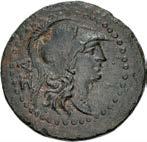
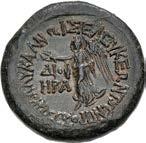
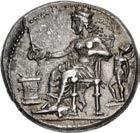

Ex Triton XII (6 January 2009), lot 348.
247. CILICIA, Soloi. Circa 440-410 BC. AR Stater (20.5mm, 10.59 g, 9h). Amazon kneeling left, holding bow, quiver on hip / Grape bunch on vine; Å-Q flanking stem, fly to lower right; all in dotted square within incuse square. Casabonne Type 2; SNG BN 132 (same obv. die). Lightly toned, a little off center, some die wear on obverse. Near EF. ($500)
248. CILICIA, Soloi. Circa 440-410 BC. AR Stater (19.5mm, 10.55 g, 3h). Amazon kneeling left, holding bow, quiver on hip / Grape bunch on vine; ˜5 to right of stem, e to lower right; all within dotted circle. Casabonne Type 2; SNG BN 137 (same dies). Lightly toned, slightly off center. Near EF. ($750)
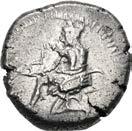

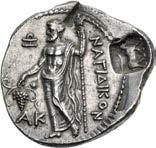
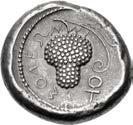

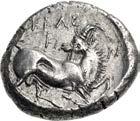
64
242 243 244 245 246 247
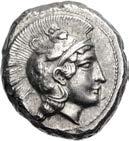
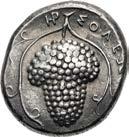
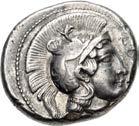
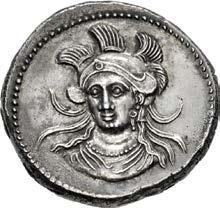
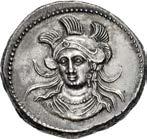
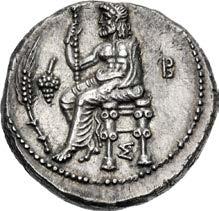
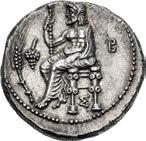
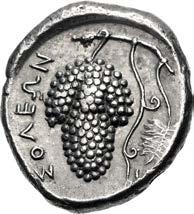
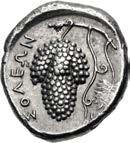
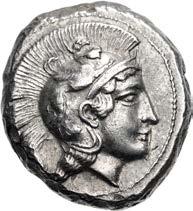
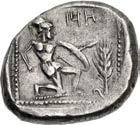
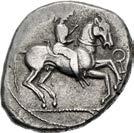
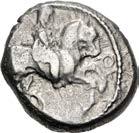
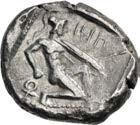
65
249. CILICIA, Soloi. Circa 410-375 BC. AR Stater (21.5mm, 10.72 g, 9h). Helmeted head of Athena right, helmet decorated with griffin / Grape bunch on vine tendril; A to upper left; all within incuse circle. Casabonne Type 5; SNG BN –; SNG Levante –; Athena Fund II 791 (same obv. die); Triton XXVI, lot 312 (same obv. die); Triton XXV, lot 294 (same obv. die). Lightly toned, a little off center on obverse. Good VF. ($750)
250. CILICIA, Soloi. Circa 410-375 BC. AR Stater (20.5mm, 10.71 g, 12h). Helmeted head of Athena right, helmet decorated with griffin / Grape bunch on vine tendril with leaves; A to lower right. Casabonne Type 5; SNG BN –; SNG Levante –; Triton XXVI, lot 313 (same dies); Triton XXV, lot 296 (same dies). Lightly toned, underlying luster, a couple of tiny flan flaws. Near EF. ($1000)
251. CILICIA, Soloi. Balakros. Satrap of Cilicia, 333-323 BC. AR Stater (24mm, 11.00 g, 6h). Baal of Tarsos seated left, holding lotus-tipped scepter; grain ear and grapes to left; ∫ to right, s below throne / Draped bust of Athena facing slightly left, wearing triple-crested Attic helmet. Casabonne Series 2; SNG BN 197 (same obv. die, but letter erased in die). Light iridescent tone over lustrous surfaces, minor marks. Near EF. ($750)
252. CILICIA, Tarsos. Circa 410-385 BC. AR Stater (21.5mm, 10.53 g, 9h). Satrap on horseback riding right; e to right / Hoplite, holding spear and shield, kneeling right; grain ear to right; all in dotted square within shallow incuse square. Casabonne Type F6; Müseler, Tarsos, Group 5, g; SNG BN –; SNG Levante 60. Lightly toned, area of weak strike. Good VF. ($500)
253. CILICIA, Tarsos. Circa 410-385 BC. AR Stater (22mm, 10.63 g, 11h). Satrap on horseback riding right; e to right / Hoplite, holding spear and round shield, kneeling right; 0 to lower left; all in dotted square within shallow incuse square. Casabonne Type F7; Müseler, Tarsos, Group 5, f; SNG BN 219–20; SNG Levante –. Struck with worn obverse die. Good VF. ($500)
252 253
254. CILICIA, Tarsos. Circa 410-385 BC. AR Stater (21mm, 10.62 g, 6h). Satrap on horseback riding right / Hoplite, nude but for helmet, holding spear and shield, kneeling left, within shallow incuse circle. Casabonne Type F10; Müseler, Tarsos, Group 5, l; SNG BN 226–31. Toned, slightly off center on obverse. Near EF. ($500)
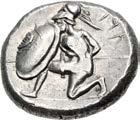
255. CILICIA, Tarsos. Circa 410-385 BC. AR Stater (22mm, 10.72 g, 1h). Satrap on horseback riding right / Hoplite, nude but for helmet, holding spear and shield, kneeling left, [within shallow incuse circle]. Casabonne Type F10; Müseler, Tarsos, Group 5, l; SNG BN 226–31. Lightly toned, underlying luster, weak strike at high points. Near EF. Detailed gorgoneion on boss of shield. ($500)
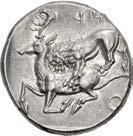
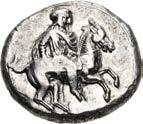
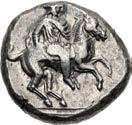

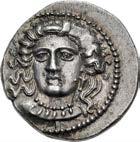

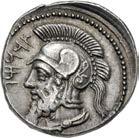
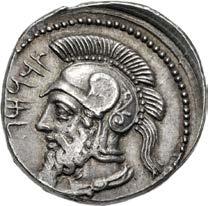

From the JTB Collection. Ex Roma XXII (7 October 2021), lot 389.
256. CILICIA, Tarsos. Tarkumuwa (Datames). Satrap of Cilicia and Cappadocia, 384-361/0 BC. AR Stater (23mm, 10.51 g, 5h). Struck circa 380 BC. Head of Arethousa facing slightly left / Helmeted and bearded male head (Ares?) left. Casabonne Series 1; Moysey Issue 4; SNG BN –; SNG Levante –; SNG von Aulock 5920–1. Iridescent tone, a little off center, area of weak strike, slight die wear. Near EF. ($750)
From the Libertas Collection.
257. CILICIA, Tarsos. Mazaios. Satrap of Cilicia, 361/0-334 BC. AR Stater (22mm, 10.83 g, 1h). Baal of Tarsos seated left, torso facing, holding lotus-tipped scepter / Lion attacking stag left; Î to lower right; all within incuse square. Casabonne Series 1, Group A; SNG BN 312–3. Lightly toned over lustrous surfaces, minor die wear on obverse, a little off center on reverse. Near EF. ($750)
From the GTP Collection, purchased from Kirk Davis (his ticket included).
Tarsos was a primary mint under the Achaemenid Persians, striking a diverse variety of coinage, particularly under the satrap Mazaios. His latest issues had an obverse type with Baal enthroned to left, as seen on this exceptional stater, that probably served as a model for the depiction of Zeus enthroned on the reverse of Alexander the Great’s silver coins after the Macedonians seized control of the city in 333 BC. The very close stylistic similarity between the Baal on the satrapal issues and the Zeus on the earliest Alexander issues indicates that there was no break in production and that the Alexander-type coinage at Tarsos was struck immediately upon the transfer of the city into Macedonian hands. The loyalties of many Achaemenid officials, many of them well versed in Greek culture, proved flexible. Indeed, Mazaios was one of the first Persian satraps to recognize Alexander as master of all Asia after the defeat of Persia in the battle of Gaugemela in 331 BC; in return, Alexander retained him as satrap of Babylon.
66
254 255
258.
Tarsos. Mazaios. Satrap of Cilicia, 361/0-334 BC. AR Stater (22.5mm, 11.07 g, 3h). Baal of Tarsos seated left, head and torso facing, holding eagle, grain ear, grape bunch and lotus-tipped scepter; rt (TN in Aramaic) to left, M (M in Aramaic) below throne / Lion left, attacking bull left; å below. Casabonne Series 2, Group C; SNG BN –; SNG Levante 106. Lightly toned, underlying luster. Choice EF. ($1500)
Ex Triton V (15 January 2002), lot 1475.
of Cilicia, 361/0-334 BC. AR Stater (23mm, 10.76 6h). Baal of Tarsos seated left, head and torso facing, holding eagle, grain ear, grape bunch and lotus-tipped scepter; rt (TN in Aramaic) to left, M (M in Aramaic) below throne / Lion left, attacking bull left; å below. Casabonne Series 2, Group C; SNG BN –; SNG Levante 106. In NGC encapsulation 3763304-012, graded MS, Strike: 5/5, Surface: 4/5. ($1500)
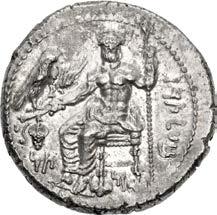
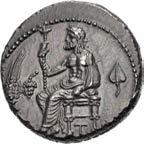
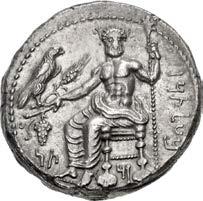
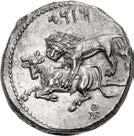
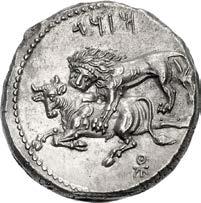
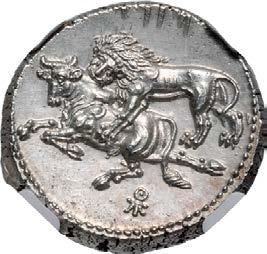
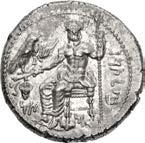
260.
Mazaios. Satrap of Cilicia, 361/0-334 BC. AR Stater (24mm, 10.75 g, 8h). Baal of Tarsos seated left, head and torso facing, holding eagle, grain ear, grape bunch and lotus-tipped scepter; rt (TN in Aramaic) to left, M (M in Aramaic) below throne / Lion left, attacking bull left. Casabonne Series 2, Group D; SNG BN 335. Underlying luster, double struck on obverse. EF. ($1500)
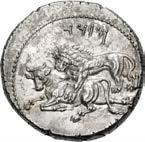

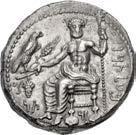
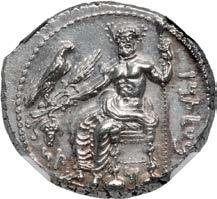
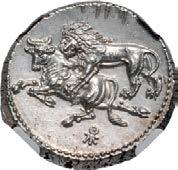
Cayón Online Auction 80 (28 February 2022), lot 30099.
(22mm, 10.82 g, 4h). Baal of Tarsos seated left, holding lotus-tipped scepter; grain ear and grape bunch to left, ivy leaf to right, t below throne / Helmeted and draped bust of Athena facing slightly left. Casabonne Series 2, unlisted dies; SNG BN 367–9 var. (B on rev.); SNG Levante 116 var. (helmet on rev.); SNG Copenhagen 324; CNG 106, lot 450 (hammer $2001). Dark iridescent tone, slightly off center. EF. ($1000)
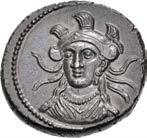
From the James Fox Collection.
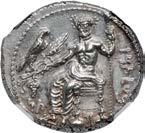
67
CILICIA,
259. CILICIA, Tarsos. Mazaios. Satrap
CILICIA, Tarsos.
Ex
261. CILICIA, Tarsos. Balakros. Satrap of Cilicia, 333-323 BC. AR Stater
262. CILICIA, Tarsos. Balakros. Satrap of Cilicia, 333-323 BC. AR Stater (24mm, 10.62 g, 1h). Baal of Tarsos seated left, holding lotus-tipped scepter; grain ear and grape bunch to left, ivy leaf and ∫ to right, p below throne / Helmeted and draped bust of Athena facing slightly left; crested helmet to upper left. Casabonne Series 2, unlisted dies; SNG BN –; SNG Levante 121. Toned, underlying luster, minor marks. Near EF. ($750)
Ex Harlan J. Berk inventory cc66655 (ND).
263. ASIA MINOR, Uncertain mint. Late 3rd-2nd centuries BC. AR Tetradrachm (31mm, 16.91 g, 1h). In the name and types of Alexander III of Macedon. Head of Herakles right, wearing lion skin / Zeus Aëtophoros seated left; trident head left in left field. CNG E-72, lot 7 (same dies); Heritage Europe & MPO 58, lot 2929 = NAC 51, lot 599 (same dies); otherwise unpublished. Die shift on obverse. Good VF. ($600)
From the GTP Collection. Ex Gorny & Mosch 276 (19 April 2021), lot 95; Classical Numismatic Group Electronic Auction 322 (12 March 2014), lot 328.
Symbols on Alexander type issues from this late period are typically recognizable civic types, such as the rose on Rhodian issues. In this late period, a trident head is only known on contemporary issues of Corinth, Mylasa, and Priene. However, the trident is always “ornate” at the former two mints, unlike the plain style of the symbol here, and at Priene, the city’s ethnic is always present. The style of these cities’ coins is also generally quite different from the present piece.
A Selection of Tigranes II Tetradrachms
Tigranes II won the epithet “The Great” by expanding the Artaxiad Armenian Kingdom to its greatest extent and claiming the title “King of Kings,” hitherto employed by the Achaemenid and Parthian rulers of Persia. The son of the Artaxiad king Artavasdes I (ruled 159-115 BC), Tigranes spent much of his youth as a hostage to his father’s loyalty in the Parthian court. Tigranes inherited the Armenian throne in 95 BC and began methodically turning his mountainous, feudal kingdom into a powerful, centralized Hellenistic state. At its peak his kingdom incorporated all of Seleukid Syria, Cilicia, Cappadocia, and large swaths of Parthia. Though a crafty and talented statesman, his success was due less to his own military prowess than the result of a power vacuum caused by internal strife within Parthia and the collapse of the Seleukid Kingdom, along with the turmoil caused by the titanic struggle between the Roman Republic and Mithridates VI of Pontus. Tigranes formed an alliance with Mithridates, but fared poorly against the Roman generals Lucullus and Pompey. He ultimately elected to formally submit to Rome, which allowed him to retain his core kingdom while giving up his conquests.
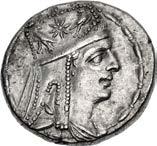
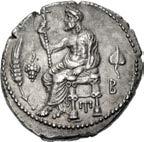
264. KINGS of ARMENIA. Tigranes II ‘the Great’. 95-56 BC. AR Tetradrachm (26mm, 16.12 g, 12h). Tigranocerta mint. Struck circa 80-68 BC. Diademed and draped bust right, wearing tiara decorated with star between two eagles / Tyche of Antioch seated right on rock, holding laurel branch; below, river-god Orontes swimming right; v to inner right, M on rock; all within wreath. SCADA Group 1, obv. die A10; Kovacs 74.1; M&D 2; CAA 17; AC 30. Trace deposits, light marks on obverse, a little die wear on reverse. Near EF. ($1000)
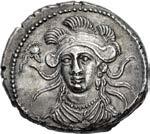



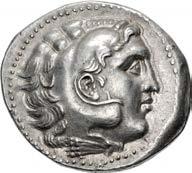
265. KINGS of ARMENIA. Tigranes II ‘the Great’. 95-56 BC. AR Tetradrachm (26.5mm, 15.69 g, 12h). Tigranocerta mint. Struck circa 80-68 BC. Diademed and draped bust right, wearing tiara decorated with star between two eagles / Tyche of Antioch seated right on rock, holding laurel branch; below, river-god Orontes swimming right; v to inner right, M on rock; all within wreath. SCADA Group 1, obv. die A13; Kovacs 74.1; M&D 2; CAA 17; AC 30. Trace deposits, minor marks. Good VF. ($750)
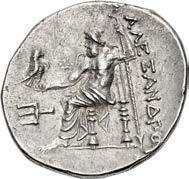
68
263 262 264 265
266. KINGS of ARMENIA. Tigranes II ‘the Great’. 95-56 BC. AR Tetradrachm (26mm, 15.79 g, 12h). Tigranocerta mint. Struck circa 80-68 BC. Diademed and draped bust right, wearing tiara decorated with star between two eagles / Tyche of Antioch seated right on rock, holding laurel branch; below, river-god Orontes swimming right; M on rock, small Q in right field; all within wreath. SCADA Group 2, obv. die A21; Kovacs 74.2; M&D 1; CAA 19; AC 30. Cleaning scratches and light scrapes on obverse. Near EF. ($1000)
267. KINGS of ARMENIA. Tigranes II ‘the Great’. 95-56 BC. AR Tetradrachm (26.5mm, 15.64 g, 12h). Tigranocerta mint. Struck circa 80-68 BC. Draped bust right, wearing jeweled diadem and tiara decorated with star between two eagles / Tyche of Antioch seated right on rock, holding laurel branch; below, river-god Orontes swimming right; no control marks; all within wreath. SCADA Group 7, obv. die A49, var. (monogram on rock on all reverses listed with this die); Kovacs 75.3 var. (monogram on rock); M&D 12 var. (same); CAA 23 var. (same); AC –; CNG 123, lot 198 (same dies). Light marks, die break in field on obverse. VF. ($500)
268. KINGS of ARMENIA. Tigranes II ‘the Great’. 95-56 BC. AR Tetradrachm (27.5mm, 15.52 g, 12h). Tigranocerta mint. Struck circa 80-68 BC. Diademed and draped bust right, wearing tiara decorated with star between two eagles / Tyche of Antioch seated right on rock, holding laurel branch; below, river-god Orontes swimming right; on rock, é above ·; all within wreath. SCADA Group 7, obv. die A55; Kovacs 75.1; M&D 9; CAA 33; AC 37. Lightly toned, traces of find patina, some porosity. Good VF. ($1000)
269. KINGS of ARMENIA. Tigranes II ‘the Great’. 95-56 BC. AR Tetradrachm (27mm, 15.81 g, 1h). Tigranocerta mint. Struck circa 80-68 BC. Diademed and draped bust right, wearing tiara decorated with star between two eagles / Tyche of Antioch seated right on rock, holding laurel branch; below, river-god Orontes swimming right; on rock, é above ·; all within wreath. SCADA Group 7, obv. die A55; Kovacs 75.1; M&D 9; CAA 33; AC 37. Minor marks on obverse. Good VF. ($750)
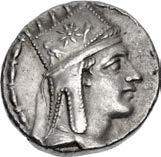

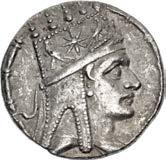
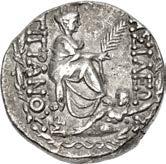
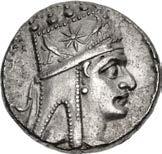

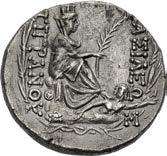
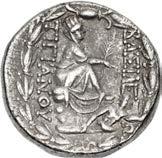
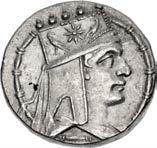
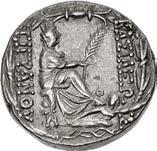
of ARMENIA. Tigranes II ‘the Great’. 95-56 BC. AR Tetradrachm (27.5mm, 15.66 g, 1h). Tigranocerta mint. Struck circa 80-68 BC. Diademed and draped bust right, wearing tiara decorated with star between two eagles / Tyche of Antioch seated right on rock, holding laurel branch; below, river-god Orontes swimming right; on rock, é above ·; all within wreath. SCADA Group 7, obv. die A55; Kovacs 75.1; M&D 9; CAA 33; AC 37. Trace deposits, minor marks. Good VF. ($750)
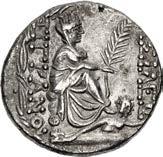
with star between two eagles / Tyche of Antioch seated right on rock, holding laurel branch; below, river-god Orontes swimming right; [· on rock]; all within wreath.
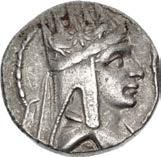
69
270. KINGS
266 267 268 269 270 271
271. KINGS of ARMENIA. Tigranes II ‘the Great’. 95-56 BC. AR Tetradrachm (26.5mm, 15.64 g, 12h). Tigranocerta mint. Struck circa 80-68 BC. Diademed and draped bust right, wearing tiara decorated
SCADA Group 7, obv. die A58; Kovacs 75.2; M&D 7; CAA 31–2; AC 33. Lightly toned. Good VF. ($750)
272. KINGS of ARMENIA. Tigranes II ‘the Great’. 95-56 BC. AR Tetradrachm (28.5mm, 15.75 g, 12h). Tigranocerta mint. Struck circa 80-68 BC. Diademed and draped bust right, wearing tiara decorated with star between two eagles / Tyche of Antioch seated right on rock, holding filleted laurel branch; below, river-god Orontes swimming right; · on rock, pellet in right field; all within wreath. SCADA Group 7, obv. die A60; Kovacs 75.2; M&D 7; CAA 31–2; AC 33. Trace deposits and minor marks on obverse. Near EF. ($1000)
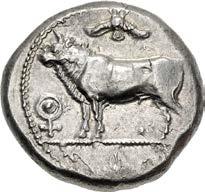

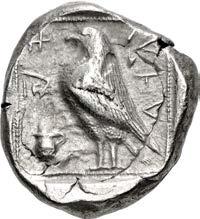
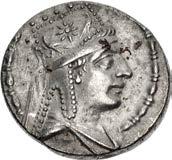
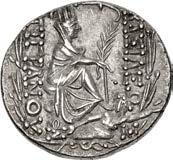
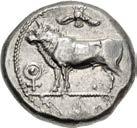
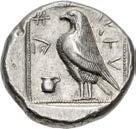
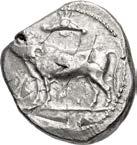
273. CYPRUS, Paphos. Stasandros. Second half 5th century BC. AR Stater (22.5mm, 10.98 g, 12h). Bull standing left; winged solar disk above, e to left, palmette ornament in exergue / Eagle standing left; one-handled vase to left, s1 ß^ß (Basi Stasa in Cypriot) around; all within dotted square in incuse square. Destrooper-Georgiades 15; Zapiti & Michaelidou 7; Tziambazis 7. Lustrous, slightly off center. Near EF. ($3000)
Overstruck on Aegina
274. CYPRUS, Paphos. Stasandros. Second half 5th century BC. AR Stater (21.5mm, 10.92 g, 12h). Bull standing left; winged solar disk above, e to left, palmette ornament in exergue / Eagle standing left; one-handled vase to left, s1 ß^ß (Basi Stasa in Cypriot) around; all within dotted square in incuse square. Destrooper-Georgiades 15; Zapiti & Michaelidou 7; Tziambazis 7. Edge split, minor die wear, overstruck on an Aegina stater of land tortoise/skew pattern type (cf. HGC 6, 437), with the undertypes visible. VF. ($1000)
Ex Heritage 232147 (25 November 2021), lot 64160.
275. CYPRUS, Salamis. Phausis(?). Circa 480-460 BC. AR Stater (21.5mm, 11.04 g, 5h). Ram couchant right; pelletin-crescent and ì1 (pa-u in Cypriot) above, [uncertain letters (in Cypriot) below] / Large ornate ankh enclosing 1 (pa in Cypriot); in corners, övsn (se-si-le-o in Cypriot) counterclockwise around from upper right; (pi-lo in Cypriot) across central field; all within incuse square. McGregor Group F.II.a, – (unlisted variety); Zapiti & Michaelidou –; Tziambazis –. Struck with worn obverse die. Good VF. Very rare. ($750)
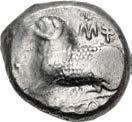
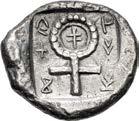
70
460-450 BC. AR Twelfth Stater – Obol (9.5mm, 0.58 g, 1h). Head of ram left / Head of ram right; traces of 1ò (pa-ni in Cypriot) above, branch below. McGregor –; cf. Zapiti & Michaelidou 21 (Euanthes); Tziambazis –; CNG 120, lot 406. Lightly toned, some roughness. Near EF. Very rare issue with branch symbol. ($1000)


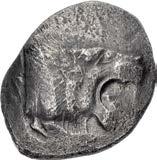
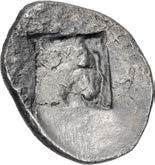
From the Tiny Art Collection.
BC. AR Stater (22.5mm, 11.11 g, 1h). Herakles seated right on rock draped with lion’s skin, leaning on club held in his right hand and holding cornucopia in left; [ü]èãìó (e-u-wa-ko[ro] in Cypriot) around / Goat couchant right; nrvs1 (pa-si-le-wo-se in Cypriot) counterclockwise around from right, E at end in exergue. McGregor Group K.AR.I.a, 414–5 var. (unlisted dies); Zapiti & Michaelidou 1; Tziambazis –. A little off center, some die wear on reverse. Near EF. ($1500)


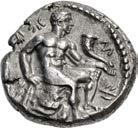
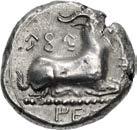
(22mm, 11.08 g, 6h). Herakles seated right on rock draped with lion’s skin, leaning on club held in his right hand and holding cornucopia in left; üèãìó (e-u-wa-ko-ro in Cypriot) around / Goat couchant right; nrvs1 (pa-si-le-wo-se in Cypriot) counterclockwise around from right, E at end in exergue. McGregor Group K.AR.I.a, 414–5 var. (unlisted dies); Zapiti & Michaelidou 1; Tziambazis –. Some die wear, slightly weak strike on reverse. Near EF. ($1500)

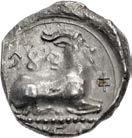
/ Incuse
Ex Asher D. Atchick Collection (Classical Numismatic Group Electronic Auction 459, 8 January 2020), lot 317; Classical Numismatic Group
The pieces in the Apadana (Kagan) and Asyut hoards had Cypriot letters on the shoulder of the lion. Although these letters are not visible here, it may be due to wear or weakness of strike on that part of the obverse, which is at a high point of the relief. Nonetheless, the style of the lion and the characteristics of the flan are identical to the hoard pieces. It is also possible that this may be an earlier, anepigraphic issue.
End of Session 1
71
276. CYPRUS, Salamis. Nikodamos. Circa
277. CYPRUS, Salamis. Evagoras I. Circa 411-374/3
278. CYPRUS, Salamis. Evagoras I. Circa 411-374/3 BC. AR Stater
279. CYPRUS, Uncertain. Late 6th-early 5th centuries BC. AR Stater (25.5mm, 10.28 g). Forepart of lion right
square. Kagan, Archaic 55a–b; Asyut 810; Zapiti & Michaelidou –, but cf. Soloi 1 and Uncertain 3 for similar obverse type. Toned, some roughness. VF. Extremely rare. ($1500)
Electronic Auction 394 (29 March 2017), lot 289.
Session 2 – Tuesday, September 19, 2023 — 2 PM
280. SELEUKID EMPIRE. Seleukos I Nikator. First satrapy, 321-315 BC. AR Tetradrachm (25mm, 17.05 g, 6h). In the name of Philip III of Macedon, types of Alexander III. Uncertain mint 6A in Babylonia. Head of Herakles right, wearing lion skin / Zeus Aëtophoros seated left; J in left field. SC Ad39.5; Taylor Series 1, 51–2 (A19/P1); Price P226; HGC 9, –. In NGC encapsulation 5872238-109, graded Ch XF, Strike: 5/5, Surface: 3/5. High relief. ($500)
281. SELEUKID EMPIRE. Seleukos I Nikator. Second satrapy and kingship, 312-281 BC. AR Tetradrachm (28mm, 16.93 g, 1h). In the name and types of Alexander III of Macedon. Babylon I mint. Struck circa 311-300 BC. Head of Herakles right, wearing lion skin / Zeus Aëtophoros seated left; ¶ in left field, Â5 below throne. SC 82.5b; Price 3747; HGC 9, 10f. Lightly toned, minor marks and pitting, slight doubling on obverse. Near EF ($750)
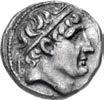
From the GTP Collection. Ex Berk BBS 182 (3 January 2013), lot 83.
282. SELEUKID EMPIRE. Seleukos I Nikator. Second satrapy and kingship, 312-281 BC. AR Tetradrachm (25.5mm, 17.23 g, 6h). In the name and types of Alexander III of Macedon. Ekbatana mint. Struck circa 311-295 BC. Head of Herakles right, wearing lion skin / Zeus Aëtophoros seated left; in left field, √ above forepart of horse grazing left; é below throne. SC 202.2a; Price 3889; HGC 9, 9e. Old collection tone, slightly off center. Near EF. Early die state. ($750)
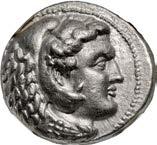
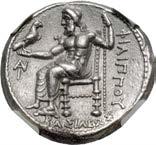
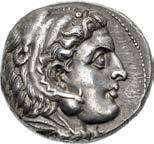
Boukephalas, or Seleukos’ Horse?
283. SELEUKID EMPIRE. Antiochos I Soter. 281-261 BC. AR Drachm (16.5mm, 3.94 g, 6h). Aï Khanoum mint. Struck circa 280-271 BC. Diademed head right / Horned and bridled head of horse right, with braided, flame-like forelock; ò to right. SC 431.3; SMAK A1DH-39–40 var. (a20/p– [unlisted rev. die]); HGC 9, 136. Toned, hairlines on obverse. Good VF. ($750)
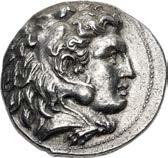
This coin is from one of the first issues of Seleukid coinage at Aï Khanoum, later a major Baktrian capital city. This unusual issue features the horned horse’s head, which had been a fairly common symbol in the reign of Seleukos I, father of Antiochos. While the exact identification of the steed is not certain the two prevailing theories are that it is either Alexander’s famed mount Boukephalas (‘ox head”), or the horse that carried Seleukos to safety when he fled Babylon from the invading Antigonos Monophthalmos in 315 BC. Seleukos revered the horse, and had it deified and erected a monument to it at Antioch.

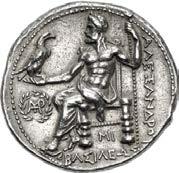
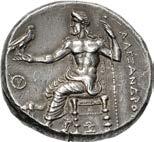

284. SELEUKID EMPIRE. Antiochos I Soter. 281-261 BC. AV Stater (17.5mm, 8.47 g, 6h). Aï Khanoum mint. Struck circa 266-261 BC. Diademed head right, with rejuvenated and idealized features / Apollo, testing arrow and placing hand on grounded bow, seated left on omphalos; d to inner left below arrow. SC 436.6; SMAK A1SA-17 (A13/P15); HGC 9, 122; SNG Copenhagen 60 (same dies). Slightly compact flan, scrapes and scratches. VF. Very rare. ($2000)
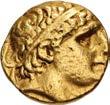
Ex Vilmar Numismaics inventory 8373 (2014); Heritage 3032 (10 April 2014), lot 23288; Künker 236 (7 October 2013), lot 648.
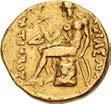
72
280 281
285. SELEUKID EMPIRE. Antiochos II Theos. 261-246 BC. AR Tetradrachm (27mm, 16.98 g, 11h). Myrina mint. Diademed head right / Herakles, holding club set on ground, seated left on rock draped with lion’s skin; amphora to outer left, ÷ in exergue. SC 500.1b; HGC 9, 241b. Toned. VF. Rare mint. ($600)
From the Weise Collection. Ex Classical Numismatic Group 55 (13 September 2000), lot 664.
286. SELEUKID EMPIRE. Seleukos II Kallinikos. 246-225 BC. AR Tetradrachm (29mm, 16.74 g, 8h). Nisibis mint. Diademed and bearded head right / Apollo, testing arrow, standing left, leaning on tripod to right; to outer left, hippocamp left above Ä; B to outer right. SC 750.3; HGC 9, 304b. Lightly toned, struck with a clashed obverse die, a touch off center on reverse. VF. Extremely rare, only two in SCO (including the one piece cited in SC), and this coin is the sole example in CoinArchives. ($500)
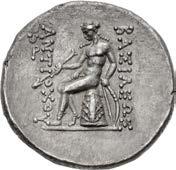
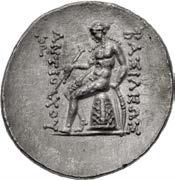
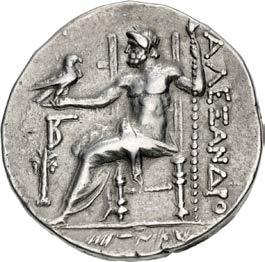


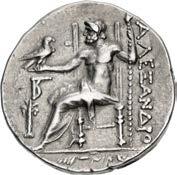
From the Weise Collection. Ex Gorny & Mosch 181 (12 October 2009), lot 1558.
Extremely Rare Gabala Alexander under Seleukos III
287. SELEUKID EMPIRE. Seleukos III Soter (Keraunos). 225/4-222 BC. AR Tetradrachm (29mm, 16.83 g, 12h). In the name and types of Alexander III of Macedon. Gabala mint. Dated CY 35 (of Arados, 225/4 BC). Head of Herakles right, wearing lion skin / Zeus Aëtophoros seated left; in left field, o (civic monogram) above palm tree; zzzzz0Ó tc (35 and ŠT [in Aramaic]) in exergue. SC 928; Duyrat, Ateliers 1 (same obv. die); Price 3433; HGC 9, –; HGC 10, 161. A little off center on obverse. Good VF. Extremely rare, two noted by Price (in Berlin [the sole piece in Pella] and Vienna), one additional noted by Duyrat (quoting Seyrig [in The Hague]), three in CoinArchives. Better than the CNG 109, lot 256 example that hammered at $7000. ($2000)
This coin was part of a joint issue of the cities of the Aradian Peraia (Arados, Balaneia, Karne, Gabala, Marathos, and Simyra), that may have been used to help finance Seleukos’ campaign in Asia Minor to recover the Seleukid territories that were lost to Attalos I during the reign of Seleukos II.

288. SELEUKID EMPIRE. Antiochos III ‘the Great’. 222-187 BC. AR Tetradrachm (29mm, 16.96 g, 1h). Antioch on the Orontes mint. Struck circa 204-197 BC. Diademed head right (Type Cii) / Apollo, testing arrow and placing hand on grounded bow, seated left on omphalos; © to outer left. SC 1044.1; Le Rider, Antioche, Series III-IV, 1–18 (obv. die A1); HGC 9, 447u. Lightly toned, minor flan flaw on reverse. EF. Well struck and high relief. ($750)
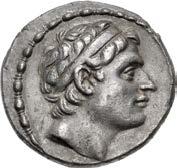
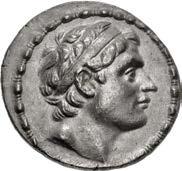

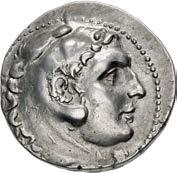
289. SELEUKID EMPIRE. Antiochos III ‘the Great’. 222-187 BC. AR Tetradrachm (29.5mm, 116.83 g, 1h). Antioch on the Orontes mint. Struck circa 204-197 BC. Diademed head right (Type Cii) / Apollo, testing arrow and placing hand on grounded bow, seated left on omphalos; © to outer left. SC 1044.1; Le Rider, Antioche, Series III-IV, 1–18 (obv. die A1); HGC 9, 447u. Toned, traces of find patina. Near EF. ($500)

73
285 286 288 289
290. SELEUKID EMPIRE. Antiochos IV Epiphanes. 175-164 BC. AR Tetradrachm (31mm, 16.55 g, 12h). Antioch on the Orontes mint. Series 3, struck 168-164 BC. Diademed head right / Zeus Nikephoros seated left; : to outer left. SC 1400a; Le Rider, Antioche, Series IIIB, 288–309 (obv. die A31); HGC 9, 620a. Toned, traces of find patina. Near EF. ($750)
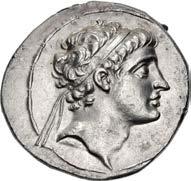
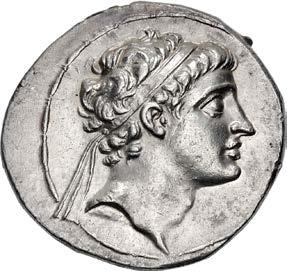
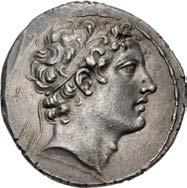
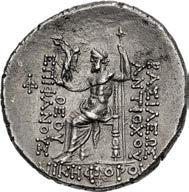
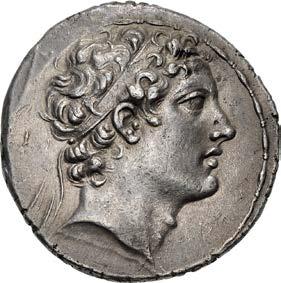
From the Weise Collection, purchased from Freeman & Sear, 4 December 1998.
291. SELEUKID EMPIRE. Antiochos IV Epiphanes. 175-164 BC. AR Tetradrachm (32mm, 16.74 g, 11h). Antioch on the Orontes mint. Series 3, struck 168-164 BC. Diademed head right / Zeus Nikephoros seated left; : to outer left. SC 1400a; Le Rider, Antioche, Series IIIB, 321–51 (obv. die A33); HGC 9, 620a. Lightly toned, minor marks, slightly off center. Good VF. ($500)
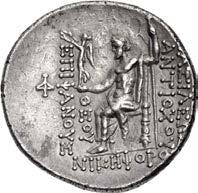
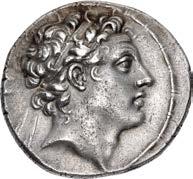
From the St. George Collection. Ex Classical Numismatic Group 50 (23 June 1999), lot 909.
Ex Hunt Collection – Referenced by Le Rider
292. SELEUKID EMPIRE. Antiochos V Eupator. 164-162 BC. AR Tetradrachm (32mm, 16.57 g, 1h). Antioch on the Orontes mint. Diademed head right / Zeus Nikephoros seated left; ∫ to outer left. SC 1575.2; Le Rider, Antioche 192 (A11/ P142) = Hunt Sale IV 592 (this coin); HGC 9, 752. Lightly toned over lustrous surfaces, die erasure in exergue on reverse. Near EF. ($1000)

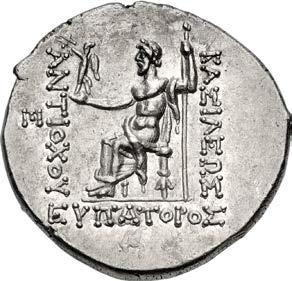
From the James Fox Collection. Ex Nelson Bunker Hunt Collection (Part IV, Sotheby’s, 19 June 1991), lot 592.

74
293. SELEUKID EMPIRE. Antiochos V Eupator. 164-162 BC. AR Tetradrachm (29mm, 16.50 g, 12h). Antioch on the Orontes mint. Diademed head right / Zeus Nikephoros seated left; , to outer left. SC 1575.6; Le Rider, Antioche 227–227A (A17/P168); HGC 9, 752. Iridescent tone, a little off center. Good VF. ($500)
From the St. George Collection. Ex Classical Numismatic Group 85 (15 September 2010), lot 491; Leu FPL (Autumn 1998), no. 91.
294. SELEUKID EMPIRE. Demetrios I Soter. 162-150 BC. Æ (25.5mm, 17.17 g, 1h). Uncertain Mint 83, probably in northern Syria. Head of lion left in fillet border / Head of boar right; . to left. SC 1660b; HGC 9, 823. Earthen green surfaces. Good VF. Rare and attractive for issue. ($500)
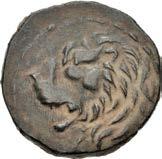
295. SELEUKID EMPIRE. Demetrios II Nikator. First reign, 146-138 BC. AR Tetradrachm (31mm, 16.00 g, 1h). Antioch on the Orontes mint. Dated SE 167 (146/5 BC). Diademed head right within wreath / Apollo, testing arrow and resting hand on grounded bow, seated left on omphalos; palm frond to outer left, , to inner left, z$r (date) and à in exergue. SC 1906.5a; HGC 9, 957d; DCA 146. Flan crack, a couple of light scratches, minor doubling on reverse. Near EF. ($500)

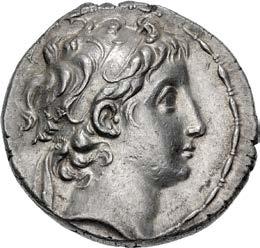
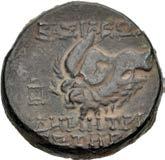
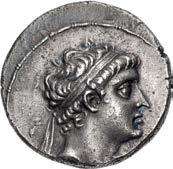
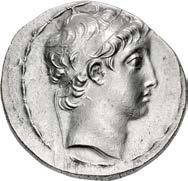
SELEUKID EMPIRE. Demetrios II Nikator. First reign, 146-138 BC. AR Tetradrachm (28.5mm, 16.78 g, 1h). Antioch on the Orontes mint. Dated SE 168 (145/4 BC). Apollo, testing arrow and resting hand on grounded bow, seated left on omphalos; palm frond to outer left; , to inner left, ™ between legs, ˙$r (date) in exergue. SC 1907.1c; HGC 9, 957d; DCA 146. Lightly toned. EF. ($750)

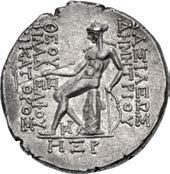
From the Weise Collection. Ex Russell Bement, Jr. Collection (Classical Numismatic Group 51, 15 September 1999), lot 534; Classical Numismatic Group XXXIV (6 May 1995), lot 188.
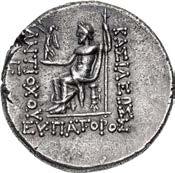
75
From the David Welsh Collection.
296.
293 294
297. SELEUKID EMPIRE. Demetrios II Nikator. First reign, 146-138 BC. AR Tetradrachm (26.5mm, 14.00 g, 12h). Phoenician standard. Laodikeia in Phoenicia (Berytos) mint. Dated SE 167 (146/5 BC). Diademed and draped bust right / Eagle standing left on prow left; palm frond over far shoulder; € to left; to right, z$r (date) above trident. SC 1952.1a; Sawaya 50–2 var. (D19/R– [unlisted rev. die]); HGC 9, 968; DCA 151. Toned, a few tiny flan flaws on obverse. EF. ($750)
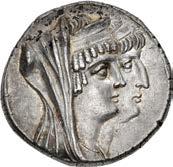


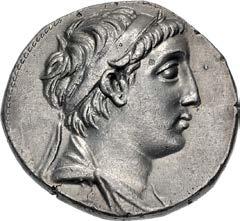
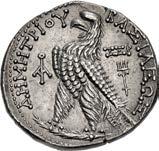
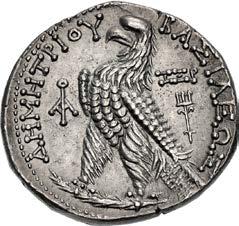
From the James Fox Collection.
298. SELEUKID EMPIRE. Antiochos VI Dionysos. 144-142 BC. AR Tetradrachm (31mm, 16.39 g, 1h). Antioch on the Orontes mint. Dated SE 170 (143/2 BC). Radiate and diademed head right / The Dioskouroi, holding reins and couched lances, on horses rearing left; to right, trU above “ above %tÅ; or (date) below; all within wreath of laurel, ivy, and grain ears. SC 2000.3e; HGC 9, 1032; DCA 178. Lightly toned, traces of horn silver on obverse. Good VF. ($1000)
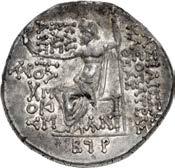
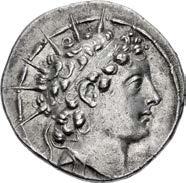
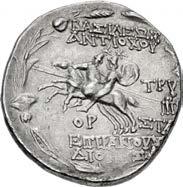
From the Weise Collection. Ex Classical Numismatic Group 61 (25 September 2002), lot 839; Russell Bement, Jr. Collection (Classical Numismatic Group 51, 15 September 1999), lot 537.
299. SELEUKID EMPIRE. Kleopatra Thea & Antiochos VIII. 125-121 BC. AR Tetradrachm (29mm, 16.50 g, 1h). Damaskos mint. Dated SE 192 (120/19 BC). Jugate heads right / Zeus Nikephoros seated left; H to outer left, &@ below throne, ∫rr (date) in exergue. SC 2267.2a; HGC 9, 1182e; DCA 253. Iridescent tone, traces of find patina. EF. ($2000)
From the JTB Collection.
300. PHOENICIA, Byblos (Gebal). ‘Ozba’al. Circa 400-365 BC. AR Shekel (23.5mm, 13.19 g, 11h). Three hoplites, holding shields, on galley left above waves, prow ending in lion’s head; below, hippocamp left above murex shell / Lion attacking bull left. E&E-B Series IV.2.1.c, 516 (O14/R25); HGC 10, 133 corr. (letters on obv. not noted). Lightly toned, die wear, slight doubling on obverse. Good VF. ($750)

From the Dr. Gary M. Duckett Collection.
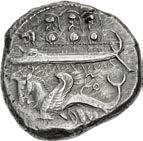
76
301. PHOENICIA, Sidon. `Abd`aštart (Straton) I. Circa 365-352 BC. AR Quarter Shekel (15mm, 3.15 g, 1h). Dated RY 7 (359/8). Phoenician galley left; ‹ ‹‹‹ ‹‹‹ (7 in Phoenician [date]) above, waves below / King of Persia and driver in chariot drawn by two horses left; bo (‘B in Phoenician) above. E&E-S Group IV.2.3.b, 1384 (D2/R2); HGC 10, 244; DCA 852. Toned, some granularity, struck with worn obverse die. Good VF. Rare. ($500)

From the Weise Collection. Ex Peus 393 (31 October 2007), lot 300.
302. PHOENICIA, Sidon. `Abd`aštart (Straton) I. Circa 365-352 BC. AR Dishekel (28.5mm, 25.73 g, 11h). Dated RY 9 (357/6). Phoenician galley left; ‹‹‹ ‹‹‹ ‹‹‹ (9 in Phoenician [date]) above, waves below / King of Persia and driver in chariot drawn by two horses left; to right, King of Sidon standing left, in Egyptian dress, holding cultic scepter and votive vase; bo (‘B in Phoenician) above. E&E-S Group IV.2.1.i, – (unlisted dies); HGC 10, 242; DCA 849. Iridescent tone, light deposits, struck with worn obverse die, flan flaw on obverse, die shift on reverse. Good VF. Well centered. ($1500)
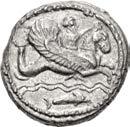

From the Weise Collection, purchased from Stack’s, 3 September 2003.
303.
Tyre. ‘Ozmilk (Azemilkos). Circa 349-311/0 BC. AR Shekel (20.5mm, 8.68 g, 12h). Dated RY 7 (343/2 BC). Deity, holding reins and arched bow, riding hippocamp right above two lines of waves; below, dolphin right / Owl standing right, head facing; crook and flail in background; ‹‹‹‹‹o above ‹‹ (’ [for ‘Ozmilk] and 7 [date], in Phoenician) in right field. E&E-T Group II.2.1.18, 971 (O23/R33); HGC 10, 349; DCA 918. Underlying luster, minor double strike on reverse. EF. ($1000)
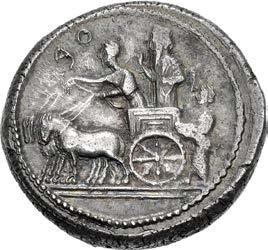
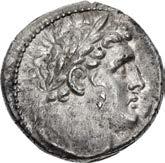

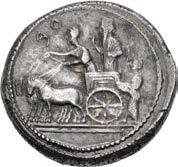
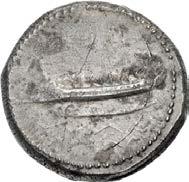
304. PHOENICIA, Tyre. 126/5 BC-AD 65/6. AR Shekel (27.5mm, 14.20 g, 12h). Dated CY 14 (113/2 BC). Laureate bust of Melkart right, lion skin around neck / Eagle standing left on prow; palm frond in background; to left, d5 (date) above
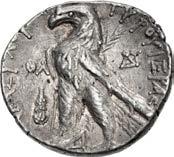
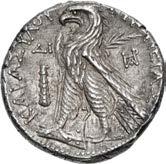
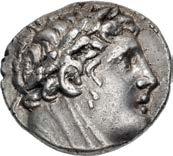
77
PHOENICIA,
club; Ê to right; b (Phoenician B) between legs. DCA-Tyre 37; HGC 10, 357; DCA 919. Toned, trace deposits. Good VF. ($1000)
305. PHOENICIA, Tyre. 126/5 BC-AD 65/6. AR Shekel (29mm, 14.36 g, 1h). Dated CY 39 (88/7 BC). Laureate head of Melkart right, [lion skin around neck] / Eagle standing left on prow; palm frond in background; to left, Q¬ (date) above club; ú to right; Å (Phoenician A) between legs. DCA-Tyre 142; HGC 10, 357; DCA 919. Attractive iridescent tone, traces of find patina. VF. ($750)
303
304
306. PHOENICIA, Tyre. 126/5 BC-AD 65/6. AR Half Shekel (22.5mm, 6.95 g, 12h). Dated CY 51 (76/5 BC). Laureate head of Melkart right, lion skin around neck / Eagle standing left on prow; palm frond in background; to left, &@ (date) above club; d to right, b (Phoenician B) between legs. DCA-Tyre 791; HGC 10, 358; DCA 921. A little off center. Superb EF. Struck from fresh dies. ($1000)

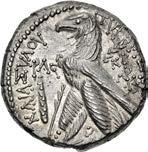
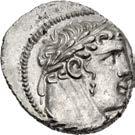
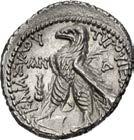




Ex Harlan J. Berk inventory cc30335 (ND).
307. PHOENICIA, Tyre. 126/5 BC-AD 65/6. AR Shekel (24.5mm, 14.21 g, 1h). Lifetime of Christ issue. Dated CY 136 (AD 10/11). Head of Melkart right, wearing laurel wreath, [lion skin around neck] / Eagle standing left on prow; palm frond in background; to left, r¬? (date) above club; to right, ˚r above …; b (Phoenician B) between legs. DCA-Tyre 488; HGC 10, 357; DCA 920. Toned, with golden hues around the devices, underlying luster. Good VF. ($750)
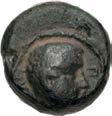
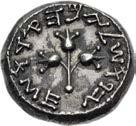

From the James Fox Collection.
308. SAMARIA, “Middle Levantine” Series. Circa 375-333 BC. AR Obol (8.5mm, 0.71 g, 3h). Two lions, each raising forepaw, facing one another; below, two ram’s heads confronted; all within dotted square / Horned head of griffin right within dotted square. Cf. Meshorer & Qedar 157 (for rev. type); cf. Sofaer 204 (for rev. type). Toned. EF. Well centered. Extremely rare. ($750)
309. JUDAEA, Herodians. Herod IV Philip. 4 BCE-34 CE. Æ (12mm, 2.09 g, 12h). Caesarea Panias mint. Dated RY 34 (CE 30/1). Head right / l¬d (date) within wreath. Meshorer 108; Hendin 6263; RPC I 4950. Earthen green patina, off center. VF. ($1000)
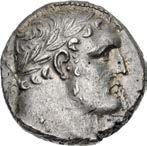
310. JUDAEA, Jewish War. 66-70 CE. AR Shekel (22.5mm, 14.19 g, 12h). Jerusalem mint. Dated year 3 (68/9 CE). Omer cup; Gc (“Y[ear] 3” in Hebrew = date) above, L!Rc¥ LQc (“Shekel of Israel” in Hebrew) around / Sprig of three pomegranates; YcurQY 2¥Lcur¥ (“Jerusalem the holy” in Hebrew) around. Deutsch 61 (O7/R56); Meshorer 202; Kadman 20; Hendin 1361; Bromberg I 69 (same obv. die); Shoshana I 20207–9; Sofaer 29; Spaer 174. Deeply toned, patches of find patina. Near EF. ($4000)
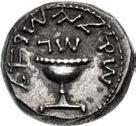
78
Unpublished
306 307
Deutsch Plate Coin
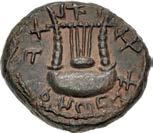
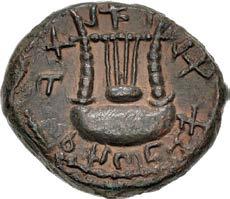
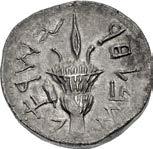
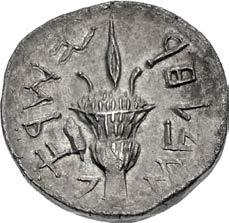

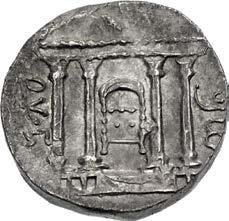
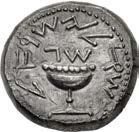
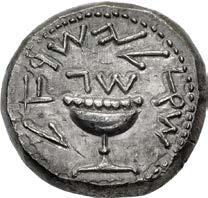
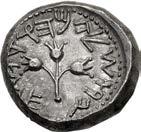
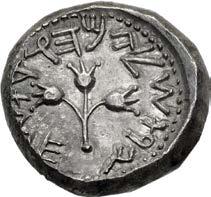
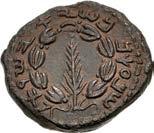
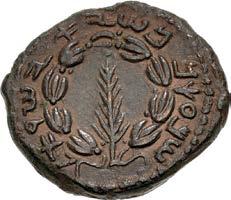
79
311. JUDAEA, Jewish War. 66-70 CE. AR Shekel (23mm, 13.98 g, 12h). Jerusalem mint. Dated year 3 (68/9 CE). Omer cup; Gc (“Y[ear] 3” in Hebrew = date) above, L!Rc¥ LQc (“Shekel of Israel” in Hebrew) around / Sprig of three pomegranates; YcurQY 2¥Lcur¥ (“Jerusalem the holy” in Hebrew) around. Deutsch 103 (O20/R96 – this coin referenced and illustrated); Meshorer 202; Kadman 20; Hendin 1361; Bromberg I 69; Shoshana I 20207–9; Sofaer 29; Spaer 174. Toned, slightly off center on reverse. EF. ($5000)
From the David Welsh Collection. Ex Heritage 351 (3 June 2004), lot 12034.
312. JUDAEA, Bar Kochba Revolt. 132-135 CE. Æ (25.5mm, 11.47 g, 12h). Dated year 1 (132/3 CE). Palm frond within laurel wreath / Nevel with five strings. Mildenberg 24 (O1/R5); Meshorer 223; Hendin 6406. Earthen brown surfaces, some die fill on reverse. Near EF. ($1000)
313. JUDAEA, Bar Kochba Revolt. 132-135 CE. AR Sela – Tetradrachm (25.5mm, 15.17 g, 1h). Dated year 2 (133/4 CE). Façade of the Temple at Jerusalem; showbread table within, star above, 3∑o2C (“Shim‘on” in Hebrew) at sides / Bundle of lulav; etrog to left, L!RC¥ RHL @C (“Year two of the Freedom of Israel” in Hebrew) around. Mildenberg 37 (O8’/R27); Meshorer 233; Hendin 6417; Bromberg 409 (same dies). Toned, traces of undertype. Near EF. ($5000)
Ex Gemini II (10 January 2006), lot 141; Harlan J. Berk inventory cc44820 (ND).
Hendin Plate Coin
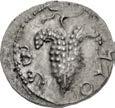
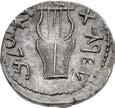
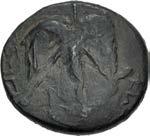
314. JUDAEA, Bar Kochba Revolt. 132-135 CE. Æ (24mm, 10 g, 7h). Irregular issue. Dated year 2 (133/34 CE). Seven-branched palm tree with two bunches of dates; countermark X on undertype visible in branches of tree / Vine leaf on tendril. Cf. Mildenberg 198 (without countermark); Meshorer 260a; Hendin 6436 (this coin illustrated). Dark green patina, overstruck on uncertain type. VF. Crude. ($750)
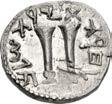
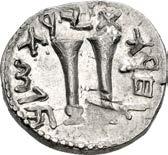
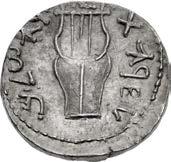
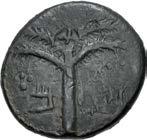

Ex David Hendin Collection.
315. JUDAEA, Bar Kochba Revolt. 132-135 CE. AR Sela – Tetradrachm (25.5mm, 13.17 g, 12h). Undated, attributed to year 3 (134/5 CE). Façade of the Temple at Jerusalem; showbread table within, star above / Bundle of lulav; etrog to left. Mildenberg 59 (O13/R45); Meshorer 267; Hendin 6439. Traces of undertype, slight roughness, die wear on obverse, off center on reverse. VF. ($3000)
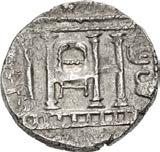
Ex Gemini VI (10 January 2010), lot 322.
316. JUDAEA, Bar Kochba Revolt. 132-135 CE. AR Zuz – Denarius (18mm, 2.88 g, 6h). Undated, attributed to year 3 (134/5 CE). Grape bunch on vine tendril / Two upright trumpets. Mildenberg 162 (O21/R85’”); Meshorer 277; Hendin 6458. Residual luster, indications of undertype, some weakness to strike on obverse. Near EF. ($1000)
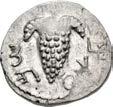
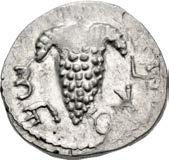
From the Libertas Collection, purchased 13 May 1981.
317. JUDAEA, Bar Kochba Revolt. 132-135 CE. AR Zuz – Denarius (18.5mm, 3.54 g, 6h). Undated, attributed to year 3 (134/5 CE). Grape bunch on vine tendril / Kinor with three strings. Mildenberg 213 (O24/R137); Meshorer 274a; Hendin 6462. Toned, with a hint of iridescence, slightly weak strike on obverse. Near EF. ($750)
From the CJR Collection.
80
Very Rare Askalon Drachm Modeled on the Athens Dekadrachm








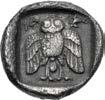
(PALESTINE), Askalon. Mid 5th century-333 BC. AR Drachm (17mm, 4.00 g, 6h). Imitating Athens reverse type. Head of female right, with oriental hairstyle / Owl standing facing, wings spread; faint nå (Phoenician ’aleph and nun) to upper left, dolphin to upper right; all within incuse square. Gitler & Tal III.3D; HGC 10, 495; Traité II 1040. Toned, porosity, scrape on obverse. VF. Very rare. ($5000)

318.
(PALESTINE), Askalon. Circa 353-333 BC. AR Drachm (13mm, 4.04 g, 3h). Imitating Athens pistyle coinage. Helmeted head of Athena right, with profile eye and pi-style palmette / Owl standing right, head facing; [olive spray and crescent to left]; å (retrograde A in Aramaic) to right; all within shallow incuse square. Gitler & Tal III.20D var. (letter not retrograde); HGC 10, –. Toned, rough surfaces, off center on reverse. Near VF. Very rare. ($750)

320.
(PALESTINE), Azotos (Ashdod). Mid 5th century-333 BC. AR Drachm (13mm, 3.72 g, 9h). Bearded head of male right / Heifer standing left, suckling calf, right, below; DDk[a]DD (AŠDD in Aramaic) above; all in dotted square within incuse square. Gitler & Tal II.4D; HGC 10, 470. Lightly toned, graffito on obverse, test cut on reverse. VF. Extremely rare. ($5000)


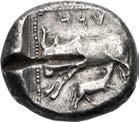
(PALESTINE), Gaza (‘Azah). Mid 5th century-333 BC. AR Drachm (15.5mm, 3.74 g, 12h). Head of bearded male right / Owl standing right; olive spray to left, `zh (AZH in Aramaic) to right; all in dotted square border within incuse square. Gitler & Tal V.1D. Toned, porous, test cut at edge on reverse. VF. Very rare. ($2500)
322 323
322. PHILISTIA (PALESTINE), Gaza (‘Azah). Circa 353-333 BC. AR Drachm (14.5mm, 3.88 g, 6h). Imitating Athens pi-style coinage. Helmeted head of Athena right, with profile eye and pi-style palmette, 7 (Aramaic M) on cheek / Owl standing right, head facing; olive spray and crescent to left; all within shallow incuse square. Gitler & Tal V.25D; HGC 10, 542. Toned, some porosity, scattered marks, scratches on edge, deposit on obverse. Good VF. ($1000)
323. PHILISTIA (PALESTINE), Uncertain mint. Mid 5th century-333 BC. AR Drachm (15mm, 3.79 g, 10h). Imitating Athens. Helmeted head of Athena right, with frontal eye / Owl standing right, head facing; olive spray to left; all within incuse square. Gitler & Tal VIII.1D (same obv. die as illustration). Lightly toned, much find patina remaining. Good VF. Well struck on a broad flan. ($500)
81
PHILISTIA
319. PHILISTIA
PHILISTIA
321. PHILISTIA
Imitating the Famous Athens Dekadrachm
324. PHILISTIA (PALESTINE), Uncertain mint. Mid 5th century-333 BC. AR Drachm (16mm, 4.05 g, 1h). Imitating Athens reverse type. Head of female right, with oriental hairstyle / Owl standing facing, wings spread; olive sprays in upper corners; all in dotted square within incuse square. Gitler & Tal XIV.33D var. (olive spray in only one corner); HGC 10, –. Toned, light roughness, indications of undertype, small test cut at edge on reverse. VF. Well centered on a broad flan. Very rare. ($5000)



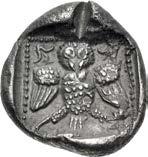
The reverse of this issue copies that of the famous Athenian dekadrachms, underscoring the impact of the design even as far as the southern Levant.
325. PHILISTIA (PALESTINE), Uncertain mint. Mid 5th century-333 BC. AR Obol (9mm, 0.69 g, 12h). Bearded head right / Gorgoneion facing. Gitler & Tal XVI.16O. Find patina, light roughness. Near EF. Exceptional for issue. Very rare. ($750)
326. PHILISTIA (PALESTINE), Uncertain mint. Mid 5th century-333 BC. AR Drachm (13mm, 2.59 g, 5h). Bearded head left / Paradise flower/Phoenician palmette; h`[;]¥ (YN’H or YW’H in Aramaic) clockwise around from upper right; in dotted square within incuse square. Gitler & Tal XVII.1D; HGC 10, 604. Toned, minor porosity, die break on obverse, test cut on reverse. VF. ($1000)





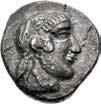
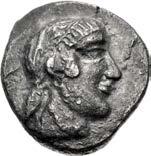




327. PHILISTIA (PALESTINE), Uncertain mint. Mid 5th century-333 BC. AR Obol (10mm, 0.72 g, 11h). Antithetic standing horses framing two facing heads of Bes; b (B in Aramaic) above; all in pearled guilloche-pattern border / Janiform male heads, the left facing; all in pearled guilloche-pattern border within incuse circle. Gitler & Tal XVIII.8O. Toned, some roughness on obverse. Good VF. Exceptional reverse for this very rare issue. ($1500)
with Shuqailat II. AD 70/1-105/6. AR Quarter Sela‘ – “Obol” (9.5mm, 0.87 g, 11h). Petra mint. Dated RY 2(?) (AD 71/2). Laureate head of Rabbell right; date to right / Bare head of Shuqailat II right; date to right. CN 217; Meshorer, Nabataea –; Al-Qatanani 225t3. Slight roughness, area of slightly weak strike. Near EF. Exceptional for issue. Very rare. ($750)



82
328. NABATAEA. Rabbel II,
Unique Ma’in Folded Flan Drachm
329. ARABIA, Southern. Ma’in (Minaia)(?). Circa 250-150 BC. AR nsf – “Drachm” (13mm, 3.29 g, 12h). Imitating Athens. [Stylized helmeted head of Athena right] / Owl standing right, wings folded; stylized olive spray and crescent to left. Unpublished as a drachm, but Cf. M. Huth, “The ‘folded flan’ coinage of eastern Arabia: some preliminary comments” in Arabian Archaeology and Epigraphy 9 (1998), 1–3, for the blṭt (”tetradrachm”) corresponding to this issue. Toned, struck on a folded flan, minor porosity and flan flaws, struck with worn obverse die. Good Fine. Apparently unique as a drachm. ($500)
This fascinating coin is the first drachm-sized denomination of a derivative Athenian series that was struck on a folded flan of another coin. Previously only known in a tetradrachm-sized denomination, the series was originally attributed by Huth (1998) to a mint in eastern Arabia, where all of the six then-extant examples had been found. The discovery of the al-Jawf hoard in 2002, however, definitively changed his view of this intriguing coinage. In his analysis of the hoard (M. Huth, “Monetary Circulation in South West Arabia” in CCK, pp. 85–9), Huth determined that these coins were struck from a single mint, in three phases that employed increasingly simplified methods. In the first phase, the coins were struck on previous tetradrachms that were folded over twice, forming a triangular shaped flan upon which derivative Athenian types were struck. The second phase consisted of coins struck on previous coins that had only been folded over once, forming a semicircular shaped flan. Finally, in the third phase, the host tetradrachms were cut into two halves that were then each folded once, then both halves were placed upon each other and joined by hammering, resulting in a triangular shape. The identification of the undertype used for this series in uncertain. While Huth originally surmised that Alexanders were the common host coin, his analysis of the al-Jawf hoard suggested that this was not likely. Though the question of the undertype remains unresolved, the hoard provided strong evidence that this series was not of eastern Arabian origin, but rather from a mint in the region of Wadi al-Jawf,
trading sphere.
temp
I to Darios II. Circa 485-420 BC. AV Daric (14mm, 8.31 g). Lydo-



standard. Sardes mint. Persian king or hero, wearing kidaris and kandys, quiver over shoulder, in kneeling-running stance right, holding spear and bow / Incuse punch. Carradice Type IIIb, Group A/B (pl. XIII, 27); Meadows, Administration 321; BMC Arabia pl. XXIV, 26; Sunrise 24. Lustrous. EF. Well centered and struck. ($2000)
Ex CNG inventory 751123 (December 2004).
Achaemenid Die
331.
II.
420-375 BC. Daric or Siglos Die (29mm, 56.49 g). Incuse Persian king or hero, wearing kidaris and kandys, quiver over shoulder, in kneeling-running stance right, holding dagger and bow / Rough surface. For coin type, see Carradice Type IV B. Brown patina with earthen deposits. As made. Extremely rare. ($5000)
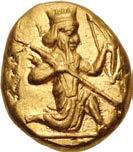
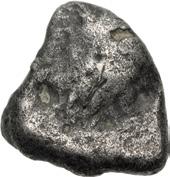

The type engraved on this die appears on both Achaemenid darics and sigloi. While the high state of preservation of the details suggests the die may be unused, it is also possible that it had limited use striking the softer gold used for darics. What remains uncertain, though is whether this is an official die, or that of a counterfeiter. Most known ancient dies are of the latter type, but one also wonders whether this die may have had a non-numismatic use. Regardless, all aspects of this piece clearly indicate its ancient origin is not in doubt.
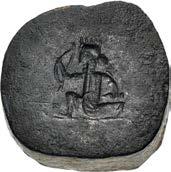
83
in the Minaian
330. PERSIA, Achaemenid Empire.
Xerxes
Milesian
PERSIA, Achaemenid Empire. temp Darios II to Artaxerxes
Circa
332. PERSIA, Achaemenid Empire. temp Artaxerxes III to Darios III. Circa 350-333 BC. AR Tetradrachm (23mm, 14.47 g). Chian standard. Uncertain mint in western Asia Minor (Ionia or Sardes?). Persian king, wearing kidaris and kandys, in kneeling-running stance right, holding spear in right hand, bow in left / Incuse rectangle, containing pattern possibly depicting relief map of the hinterland of Ephesos. Johnston, Earliest 33; Meadows, Administration 328; Mildenberg, Münzwesen pp. 25–6 and pl. XII, 110; BMC Ionia p. 324, 3 and 6; Jameson 1787; Pozzi 3138. Lightly toned, rough and porous surfaces, small scrapes on reverse. Good VF. Well centered. ($1000)
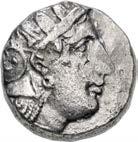

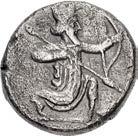

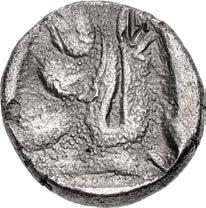

Johnston has interpreted this remarkable reverse design as a relief map of the hinterland of Ephesos, which would make it the earliest Greek map and first physical relief map known. On the right (north) are the mountains Tmolos and Messogis between the river valleys of the Caÿster and Maeander, to the left of which are three mountain ridges (Madranbaba Dagi, Karincali Dagi, and Akaba Tepesi). Johnston follows Six in suggesting that the coins were probably struck under the Persian general Memnon at Ephesos, circa 336-334 BC, in order to pay his army after he had captured the city, but before his defeat by Alexander at the Battle of Granicus in 334. However, Johnston’s map theory has been the subject of some doubt, most notably by Leo Mildenberg.
333. PERSIA, Achaemenid Empire. Gamerses. Satrap of Lydia, early 4th century BC. Æ (13mm, 1.67 g, 1h). Uncertain mint in Lydia. Youthful head right, wearing short hair with long braid, earring, and necklace / Zeus Aëtophoros standing right; star to left. Winzer 15.1; Schultz, Aphroditekopf, p. 113; Klein 563. Attractive dark green patina, a few hairlines in field on obverse. EF. Well struck and high relief. ($500)
From the Tiny Art Collection.
Artaxerxes III as Pharaoh of Egypt
334. EGYPT, Achaemenid Province. Artaxerxes III Okhos. As Pharaoh of Egypt, 343/2-338/7 BC. AR Tetradrachm (21.5mm, 16.61 g, 9h). Imitating Athens. Head of Athena right, with profile eye, wearing earring and crested Attic helmet decorated with three olive leaves over visor and a spiral palmette on the bowl / Owl standing right, head facing; to left, olive spray and crescent above kxz (ZHK in Aramaic); to right, [w]^¥ztz above [...Cx∏] (uncertain/unknown script). Van Alfen Type IVa, 10 var. (unlisted dies); Price, More 154; Anderson & van Alfen 43 (same dies); CNG E-466, lot 232 (same rev. die). Lightly toned, trace deposits, bankers’ marks, test cut on reverse. VF. Very rare, and comparable to the CNG E-466, lot 232 coin that hammered at $6500. ($750)
From the Don T. Hayes Collection, purchased from Nilus Coins.

84
335. PTOLEMAIC KINGS of EGYPT. Ptolemy I Soter. As satrap, 323-305/4 BC. AR Tetradrachm (27mm, 17.02 g, 12h). In the name and types of Alexander III of Macedon. Arados mint. Struck circa 320/19-315 BC. Head of Herakles right, wearing lion skin / Zeus Aëtophoros seated left, legs crossed; 1 in left field. Price 3426 (Byblos mint). Deep iridescent tone, traces of find patina. EF. High relief. ($500)
Mint State Tetradrachm of Ptolemy I
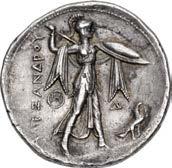
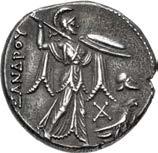

336. PTOLEMAIC KINGS of EGYPT. Ptolemy I Soter. As satrap, 323-305/4 BC, or king, 305/4-282 BC. AR
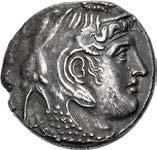
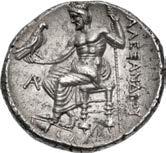
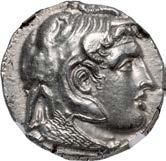
Tetradrachm (27mm, 15.44 g, 1h). Ptolemaic standard. In the name of Alexander III of Macedon. Alexandreia mint. Struck circa 306-300 BC. Diademed head of the deified Alexander right, wearing elephant skin, aegis around neck / ŬE$Å@droU, Athena Alkidemos advancing right, brandishing spear in right hand and wearing shield on extended left arm; to right, helmet, », and eagle standing right on thunderbolt. CPE 63; Svoronos 168; Zervos Issue 24, unlisted dies; SNG Copenhagen 19. In NGC encapsulation 4276144-001, graded MS, Strike: 5/5, Surface: 4/5. ($5000)
337. PTOLEMAIC KINGS of EGYPT. Ptolemy I Soter. As satrap, 323-305/4 BC, or king, 305/4-282 BC. AR
Tetradrachm (26mm, 15.42 g, 12h). Ptolemaic standard. In the name of Alexander III of Macedon. Alexandreia mint. Struck circa 306-300 BC. Diademed head of the deified Alexander right, wearing elephant skin, aegis around neck with tiny d in scales / Athena Alkidemos advancing right, brandishing spear and wearing shield on arm; to right, helmet, (, and eagle standing right on thunderbolt. CPE 69; Svoronos 162; Zervos Issue 28, dies 503/b; SNG Copenhagen 29. Much find patina remaining, with some roughness on obverse, edge split. Good VF. ($1000)
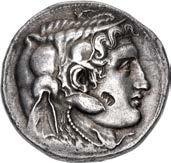
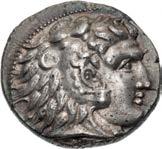
Ex Künker 365 (4 April 2022), lot 5166.
338. PTOLEMAIC KINGS of EGYPT. Ptolemy I Soter. As satrap, 323-305/4 BC, or king, 305/4-282 BC. AR Tetradrachm (28.5mm, 15.60 g, 12h). Ptolemaic standard. In the name of Alexander III of Macedon. Uncertain mint 2 (Naukratis?). Struck circa 306-303 BC. Diademed head of the deified Alexander right, wearing elephant skin, aegis around neck; c/m: uncertain symbol or letter within incuse square / Athena Alkidemos advancing right, brandishing spear and wearing shield on arm; ” to left; to right, 6 above eagle standing right on thunderbolt. CPE 79; Svoronos 142; Zervos Issue 58, dies 612/c; SNG Copenhagen 21. Attractive light iridescent tone, light scratches on obverse, minor doubling on reverse. Near EF. ($1500)
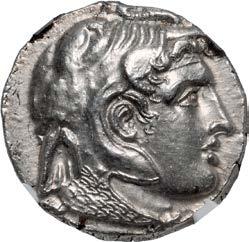
85
From the D.K. Collection.
337
338
339. PTOLEMAIC KINGS of EGYPT. Ptolemy II Philadelphos. 285-246 BC. Æ (26mm, 17.68 g, 12h). Uncertain mint in Sicily. Struck circa 264–263 BC. Laureate head of Zeus right; dotted border / Eagle standing left on thunderbolt; shield to left; dotted border. CPE B288; Svoronos 610; Wolf & Lorber, ‘Alexandrian’ Style, P01–54; SNG Copenhagen 114. In NGC encapsulation 2400929-009, graded MS★, Strike: 5/5, Surface: 5/5, Fine Style. ($1000)
Ex Jonathan K. Kern Collection.
The series of Ptolemaic bronze coins that display an obviously “Sicilian” style have long puzzled numismatic scholars and collectors. The latest research, by Daniel Wolf and Catharine Lorber in the 2011 Numismatic Chronicle, indicate these coins were struck in Sicily by Hieron II, in alliance with Ptolemy II Philadelphos of Egypt. Hieron was named Strategos (commanding general) of the Greek armies fighting Carthage in Sicily circa 269 BC. He likely made overtures to Ptolemy II, and the Egyptian king probably responded by sending a Ptolemaic contingent of soldiers, along with a large quantity of bronze to be made into coins to pay the troops. The Syracusan die engravers produced a close approximation to the contemporary bronze issues of Egypt, but with a more “western-looking” head of Zeus and lacking the distinctive beveled edges seen on Alexandrian bronzes. This coinage likely ceased in 264/3 BC, when Hieron proclaimed himself king and became embroiled in a conflict against Rome, another ally of Egypt, which then probably ended fiscal and military support for Syracuse.
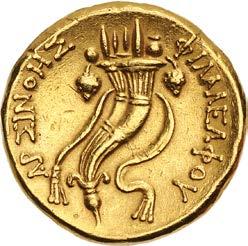
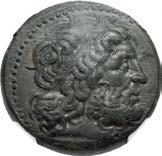
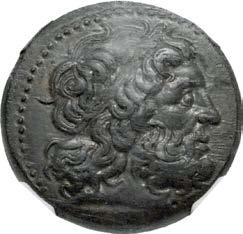
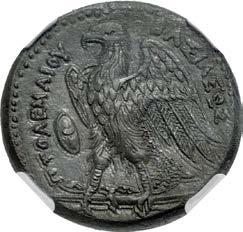
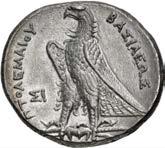

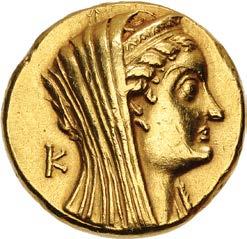
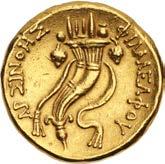
340. PTOLEMAIC KINGS of EGYPT. Ptolemy II Philadelphos. 285-246 BC. AR Tetradrachm (27mm, 14.03 g, 12h). Sidon mint. Undated issue, struck circa 274 BC. Diademed head of Ptolemy I right, aegis around neck / Eagle with closed wings, standing left on thunderbolt; s5 to left. CPE 505a; Svoronos 713; SNG Copenhagen 506–7 var. (tiny Δ behind ear). Lightly toned. EF. Well struck from fresh dies. ($500)
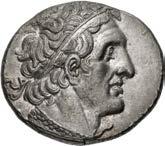
From the Weise Collection. Ex Triton I (2 December 1997), lot 630.
341. PTOLEMAIC KINGS of EGYPT. Arsinoe II Philadelphos. Died 270/268 BC. AV Mnaïeion – ‘Oktadrachm’ (27mm, 27.41 g, 12h). Alexandreia mint. Struck under Ptolemy VI, circa 180-145 BC. Head right with ram’s horn, veiled and wearing stephanos; lotus-tipped scepter in background, ˚ to left / År%5@o˙% f5¬ÅdE¬foU, double cornucopia, grape bunches hanging at sides, bound with fillet. Olivier Group 5, 3463–70 (obv. die D32); Svoronos 1374β (same obv. die); cf. SNG Copenhagen 322; SNG Delepierre 3063; BMC 45; Boston MFA 2293. Lustrous, minor marks. Good VF. ($7500)
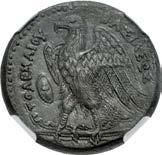
86 NGC Graded MS★ 5/5, 5/5, Fine
Style
342. PTOLEMAIC KINGS of EGYPT. Kleopatra VII Thea Neotera. 51-30 BC. Æ Obol – 40 Drachmai (21.5mm, 10.52 g, 12h). Alexandreia mint. Diademed and draped bust right / Eagle standing left on thunderbolt; cornucopia to left, Â (mark of value) to right. Svoronos 1872; SNG Copenhagen 422–4. Brown surfaces, light roughness, a little off center. VF. ($1500)
Ex Freeman & Sear 10 (11 February 2004), lot 275.
343. KYRENAICA, Kyrene. temp. Magas. Circa 294-275 BC. AR Didrachm (20mm, 7.64 g, 6h). Head of Zeus Karneios left / Silphion plant; ä to upper left. BMC 249; SNG Copenhagen 1240. Light deposits, a little off center on reverse. VF. ($500)
From the JTB Collection.
344. KYRENAICA, Kyrene. temp. Magas. Circa 294-275 BC. AR Didrachm (21mm, 7.71 g, 12h). Head of Zeus Karneios left / Silphion plant; 5u to lower left, ï to lower right. BMC 250 corr. (same dies; lower left monogram); SNG Copenhagen –. Light marks. VF. Well centered on a broad flan. ($750)
From the GTP Collection. Ex Classical Numismatic Group 120 (11 May 2022), lot 534.
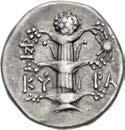
345. KYRENAICA, Kyrene. temp. Magas. Circa 294-275 BC. AR Didrachm (19.5mm, 7.69 g, 12h). Head of Zeus

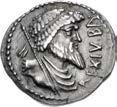
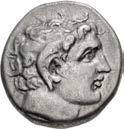
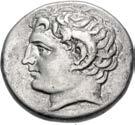
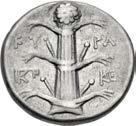
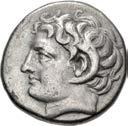
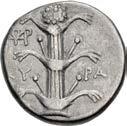
Karneios right / Silphion plant; 0 to upper left, crab to upper right. BMC 255; SNG Copenhagen 1243 var. (control marks in lower fields). Lightly toned, minor roughness, struck with worn obverse die. VF. ($500)
From the JTB Collection.
346. KINGS
Juba I. Circa 60-46 BC. AR Drachm (18mm, 3.86 g, 12h). Utica mint. Diademed and draped bust right, scepter over shoulder / Octastyle temple. MAA 29; Mazard 379; SNG Copenhagen 523. Dark toning. VF. Well centered and struck from fresh dies. ($500)
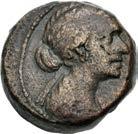
From the GTP Collection. Ex Deyo Collection (Classical Numismatic Group 90, 23 May 2012), lot 776; Classical Numismatic Auctions VI (1 March 1989), lot 160.
347. MAURETANIA, Lixus. Circa 50-1 BC. Æ (25.5mm, 11.04 g, 12h). Male head left, wearing tall bonnet with hanging cord / Two grape bunches. MAA 167; Mazard 632; SNG Copenhagen 692–3. Earthen dark green patina. Good VF. ($500)
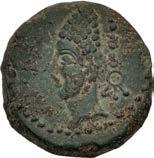
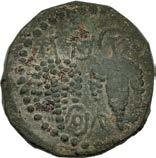
From the D.M.K. Collection.
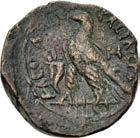
87
of NUMIDIA.
342 343 344 345 346 347
348. KINGS of MAURETANIA. Boccus I and successors. 118-33 BC. Æ (17.5mm, 3.31 g, 9h). ŠMŠ mint. Bearded head right / Star; grape bunch and grain ear flanking. MAA 45d; cf. Mazard 644/645 (Lixus; for obv./rev. types); cf. SNG Copenhagen 705/707 (same); J. Marion, “Les monnaies de Shemesh et des villes autonomes de Maurétanie tingitane au musée Louis-Chatelain à Rabat” in Antiquités africaines 6 (1972), 70. Earthen dark green patina. Good VF. Very rare. ($500)

From the D.M.K. Collection.
Unique Year 1 Juba Denarius
349. KINGS of MAURETANIA. Juba II. 25 BC-AD 24. AR Denarius (16mm, 2.18 g, 10h). Caesarea mint. Dated RY 1 (25/4 BC). re[x iu]BA, diademed head right / Capricorn right; filleted cornucopia above, ANNO pr-i-ÂO (date) around. Unpublished. Toned, a little off center, light scratches. VF. Apparently unique. ($500)
From the D.M.K. Collection.
350. KINGS of MAURETANIA. Juba II. 25 BC-AD 24. AR Denarius (18mm, 2.83 g, 5h). Caesarea mint. Diademed head right / Altar decorated with laurel branch; laurel branches flanking, star below. Mazard 158; MAA 82; SNG Copenhagen 556 var. (position of obv. legend). Toned, with some iridescence, traces of find patina. VF. Very rare. ($500)
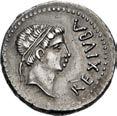
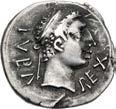

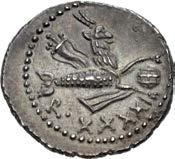
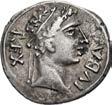
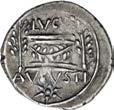


From the Weise Collection. Ex Classical Numismatic Group 78 (14 May 2008), lot 1006.
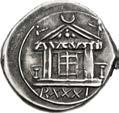
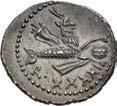
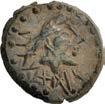
351. KINGS of MAURETANIA. Juba II. 25 BC-AD 24. AR Denarius (18.5mm, 3.22 g, 5h). Caesarea mint. Diademed head right / Eagle, with wings spread, standing right on thunderbolt; scepter to right. Mazard 205; MAA 87; SNG Copenhagen 583. Iridescent tone, minor cleaning marks, deposits on reverse. Near EF. Well centered. ($500)
From the Weise Collection, purchased from Freeman & Sear, 17 January 2003.
352. KINGS of MAURETANIA. Juba II. 25 BC-AD 24. AR Denarius (18.5mm, 3.15 g, 8h). Caesarea mint. Dated RY 31 (6/7 BC). Diademed head right / Distyle temple, surmounted by crescent, eagle in pediment; l ccc5 (date) below. SpoerriButcher Group 5.c, dies B2/R4; Mazard 147; MAA 120; SNG Copenhagen –; ANS inv. 1944.100.81061 (same dies). Toned, some find patina remaining. VF. ($500)
From the Libertas Collection.
Spoerri-Butcher Plate Coin – Pedigreed to 1929
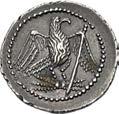
353. KINGS of MAURETANIA. Juba II. 25 BC-AD 24. AR Denarius (18mm, 2.94 g, 10h). Caesarea mint. Dated RY 41 (AD 16/7). Head right, wearing lion skin, club over shoulder / Capricorn right; filleted cornucopia above, globe to right, rxxxxi (date) below. Spoerri-Butcher Group 37.a, dies K14/R4, 318 (this coin); MAA 164; Mazard 211; SNG Copenhagen 587–8. Attractive iridescent toning, slightly off center. Near EF. ($750)
From the Weise Collection. Ex Coin Galleries (25 February 2004), lot 236; Glendining & Seaby 2 (15 July 1929), lot 521.
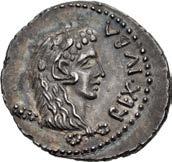
88
348
349
350 351
354. KINGS of MAURETANIA. Juba II. 25 BC-AD 24. AR Denarius (16mm, 2.83 g, 6h). Caesarea mint. Dated RY 41 (AD 16/7). Head right, wearing lion skin / Cornucopia; transverse trident in background, (-t-Å-Â (date) around. Spoerri-Butcher Group 38a, dies K1/R1, 373 (this coin); Mazard 256; MAA 167; SNG Copenhagen –; SNG Blackburn 311 (same dies); Bement 1892 (same dies); McClean 10038 (same dies). Iridescent tone, trace deposits, a few light scratches. Good VF ($500)
From the Weise Collection. Ex G. Hirsch 240 (2 May 2005), lot 471.
355. KINGS of MAURETANIA. Juba II. 25 BC-AD 24. AR Denarius (17mm, 3.02 g, 11h). Caesarea mint. Dated RY 42 (AD 17/8). Head right, wearing lion skin, club over shoulder / Bull standing right, head facing, wearing Isis crown; rxxxxii (date) below. Spoerri-Butcher Group 41, dies K24/R4; Mazard 226; MAA 172; SNG Copenhagen 589. Attractive iridescent toning, slightly off center. EF. ($750)
From the Weise Collection, purchased from R.M. Smythe, 13 January 2005.
Juba
with Kleopatra Selene. 25 BC-AD 24. AR Denarius (19mm, 3.01 g, 7h).
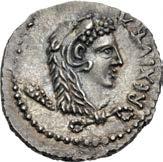
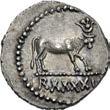
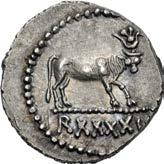
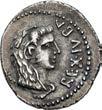
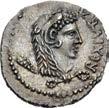
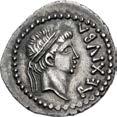
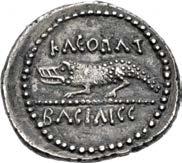
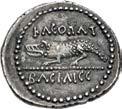
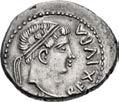


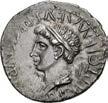
mint. Diademed head right / Star in crescent. Mazard 299; MAA 97; SNG Copenhagen 567. Toned. Good VF. ($500)
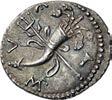
From the Weise Collection. Ex Bruce R. Brace Collection (Classical Numismatic Group Electronic Auction 279, 16 May 2012), lot 138.
KINGS of MAURETANIA. Juba II, with Kleopatra Selene. 25 BC-AD 24. AR Denarius (18.5mm, 3.37 g, 8h). Caesarea mint. Diademed head right / Crocodile standing left. Mazard 343; MAA 104; SNG Copenhagen 592. Toned, patches of find patina. Good VF. Well centered. ($500)
From the Weise Collection. Ex Peus 372 (30 October 2002), lot 809.
358. KINGS of MAURETANIA. Juba II, with Ptolemy. 25 BC-AD 24. AR Denarius (17mm, 3.38 g, 6h). Caesarea mint. Diademed head of Juba right, drapery on far shoulder / Diademed and draped bust of Ptolemy left. Spoerri-Butcher II, Group B, dies A13/R5, 26 (this coin); Mazard 379; MAA 111; SNG Copenhagen –. Toned, minor marks, a little off center on obverse. VF. ($750)
From the Weise Collection. Ex Gorny & Mosch 134 (11 October 2004), lot 1757.
89
356. KINGS of MAURETANIA.
II,
Caesarea
357.
A Further Selection of the Coins of Ptolemy of Mauretania






Ptolemy of Mauretania was the last independent king of North Africa and the final ruler who could plausibly claim descent from Ptolemy I Soter of Egypt. He was the son of Juba II and Kleopatra Selene, the daughter of the famous Egyptian queen Kleopatra VII, whose hand was given to Juba by Augustus. Ptolemy seems not to have been as strong a leader as his revered father or grandmother. After his father’s death in AD 24, increasing restiveness among the native tribes led to the outbreak of several revolts, which he could not quell. He eventually ran afoul of the emperor Caligula, and was called to Rome in AD 39 or 40, whereupon he was put to death. Mauretania was formally annexed to the Empire in AD 44, and the revolts were brutally crushed by Roman legions.
The exact date of the beginning of Ptolemy’s reign is not currently known, though he certainly ruled alongside his father during the final years of Juba’s reign. The only firm date in the historical record for Ptolemy’s reign is his final year, AD 40, but there is disagreement among scholars as to when Ptolemy was called to Rome, and when he actually departed Mauretania. This could have been as early as late AD 39, or as late as early AD 40. Assuming his year 20 coins are his latest, would place the beginning of his first year as early as AD 20 or as late as AD 21. It must be pointed out, though, that without knowing the date of his elevation by Juba, there is a possibility that the year 20 coins are not his latest.
359. KINGS of MAURETANIA. Ptolemy. AD circa 20/1-40. AR Denarius (16mm, 1.89 g, 11h). Caesarea mint. Dated RY 1 (circa AD 20/1 or 21/2). Diademed head right, drapery around neck / Winged kerykeion within wreath. Mazard 487; MAA 250; SNG Copenhagen 634. Find patina, light roughness, numerous cleaning scratches on obverse. VF. Very rare, three in CoinArchives. ($500)

From the D.M.K. Collection.
360. KINGS of MAURETANIA. Ptolemy. AD circa 20/1-40. AR Denarius (14.5mm, 1.99 g, 1h). Caesarea mint. Dated RY 5 (circa AD 24/5 or 25/6). Diademed head right, drapery around neck / Draped curule chair, surmounted by laurel wreath, against which rests a scepter. Mazard 440; MAA 258; SNG Copenhagen –. Find patina, light roughness. VF. Very rare, one in CoinArchives. ($500)



From the D.M.K. Collection.
361. KINGS of MAURETANIA. Ptolemy. AD circa 20/1-40. AR Denarius (14mm, 1.99 g, 5h). Caesarea mint. Dated RY 5 (circa AD 24/5 or 25/6). Diademed head right, drapery around neck / Palm frond surmounted by crescent between two cornucopias. Mazard 479 var. (no palm frond); MAA 261 var. (same); SNG Copenhagen –. Lightly toned, with some find patina remaining, roughness. VF. Unpublished with palm frond. Extremely rare, none in CoinArchives. ($500)
From the D.M.K. Collection.
362. KINGS of MAURETANIA. Ptolemy. AD circa 20/1-40. AR Denarius (15mm, 2.35 g, 6h). Caesarea mint. Dated RY 9 (circa AD 28/9 or 29/30). Diademed head right, drapery around neck / Club within wreath. Mazard 434; MAA 294; SNG Copenhagen –. Toned, with some find patina remaining. Good VF. Very rare, none in CoinArchives. ($750)
From the D.M.K. Collection.
363. KINGS of MAURETANIA. Ptolemy. AD circa 20/1-40. AR Denarius (15mm, 2.08 g, 11h). Caesarea mint. Dated RY 9 (circa AD 28/9 or 29/30). Diademed head right, drapery around neck / Draped curule chair, surmounted by laurel wreath, against which rests a scepter. Mazard 444; MAA 295; SNG Copenhagen –. Toned, with some find patina remaining, some roughness. Good VF. Very rare, one in CoinArchives. ($500)


From the D.M.K. Collection.
364. KINGS of MAURETANIA. Ptolemy. AD circa 20/1-40. AR Denarius (15.5mm, 1.96 g, 8h). Caesarea mint. Dated RY 13 (circa AD 32/3 or 33/4). Diademed head right, drapery around neck / Capricorn right; cornucopia over shoulder. Mazard 459; MAA 322; Mazard 459; SNG Copenhagen –. Find patina, some roughness, struck with worn dies. Good VF. Very rare, one in CoinArchives. ($500)
From the D.M.K. Collection.
90
359
360 361
362
363
364
365. KINGS of MAURETANIA. Ptolemy. AD circa 20/1-40. AR Denarius (15mm, 1.85 g, 7h). Caesarea mint. Dated RY 16 (circa AD 35/6 or 36/7). Diademed head right, drapery around neck / Three crossed grain ears. Mazard 424; MAA 334; SNG Copenhagen –. Lightly toned, typical compact flan, struck with worn obverse die. Good VF. Rare. ($750)
From the Libertas Collection.
366. KINGS of MAURETANIA. Ptolemy. AD circa 20/1-40. AR Denarius (14.5mm, 2.03 g, 5h). Caesarea mint. Dated RY 16 (circa AD 35/6 or 36/7). Diademed head right, drapery around neck / Capricorn right; cornucopia over shoulder. Mazard 462; MAA 336; SNG Copenhagen –. Traces of find patina, porous. VF. Very rare, none in CoinArchives. ($750)
From the D.M.K. Collection.
367. KINGS of MAURETANIA. Ptolemy. AD circa 20/1-40. AR Denarius (14mm, 1.72 g, 9h). Caesarea mint. Dated RY 16 (circa AD 35/6 or 36/7). Diademed head right, drapery around neck / Grain ear within wreath. Mazard 491 bis; MAA 339; SNG Copenhagen –. Toned, with much find patina remaining, light roughness, small edge chip. VF. Very rare, one in CoinArchives. ($500)


From the D.M.K. Collection.
368. KINGS of MAURETANIA. Ptolemy. AD circa 20/1-40. AR Denarius (14mm, 1.97 g, 10h). Caesarea mint. Dated RY 17 (circa AD 36/7 or 37/8). Diademed head right, drapery around neck / Cornucopia; transverse scepter in background. Mazard 476; MAA 342; SNG Copenhagen –. Lightly toned, with some find patina remaining, a little off center. VF. Very rare, one in CoinArchives. ($500)








From the D.M.K. Collection.
369. KINGS of MAURETANIA. Ptolemy. AD circa 20/1-40. AR Denarius (15.5mm, 1.73 g, 1h). Caesarea mint. Dated RY 17 (circa AD 36/7 or 37/8). Diademed head right, drapery around neck / Capricorn right; cornucopia over shoulder. Mazard 463; MAA 341; SNG Copenhagen –. Lightly toned, with some find patina remaining, a little off center. Good VF. Very rare, only one in CoinArchives (another has the date partially obscured, and another coin is incorrectly attributed). ($750)


From the D.M.K. Collection.
370. KINGS of MAURETANIA. Ptolemy. AD circa 20/1-40. AR Denarius (14.5mm, 2.10 g, 2h). Caesarea mint. Dated RY 18 (circa AD 37/8 or 38/9). Diademed head right, drapery around neck / Winged kerykeion between two branches. Cf. CNG 123, lot 293 for similar type, dated RY 20; otherwise, unpublished. Find patina, scratches. Near VF. Apparently unique. ($500)
From the D.M.K. Collection.
91
365 366 367 368 369 370
ORIENTAL GREEK COINAGE
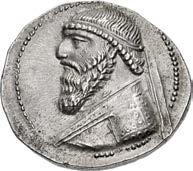
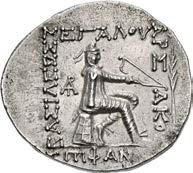
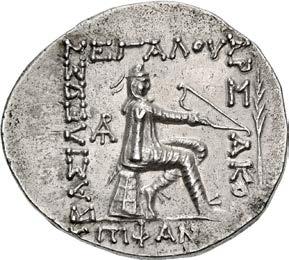
371. KINGS of PARTHIA. Artabanos I (Arsakes II). 211-185 BC. AR Drachm (16mm, 4.13 g, 12h). RhagaiArsakeia(?) mint. Struck circa 211-209 BC. Head left, wearing bashlyk / Archer (Arsakes I) seated right on backless throne, holding bow; to right, eagle standing facing, head left. Sellwood 6.1; A&S Type 6/1 (same dies); cf. Sunrise 241-3 (for type); cf. Shore 4 (same); Triton XII, lot 507 (same obv. die). Iridescent toning. EF. ($500)
From the Libertas Collection.
372. KINGS of PARTHIA. Mithradates II. 121-91 BC. AR Tetradrachm (31mm, 15.86 g, 12h). Seleukeia on the Tigris mint. Struck circa 120/19-109 BC. Diademed bust left / Archer (Arsakes I) seated right on omphalos, holding bow; t¨ in exergue. Sellwood 24.4 var. (additional palm); Sunrise 284 var. (same); Shore 67 var. (same). Iridescent toning, slight porosity, light marks, traces of undertype. EF. Attractive example. ($1500)
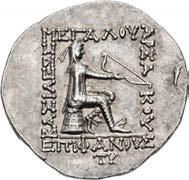
From the Nisa Collection.
373.
of PARTHIA. Mithradates II. 121-91 BC. AR Tetradrachm (32mm, 15.93 g, 12h). Seleukeia on the Tigris mint. Struck circa 120/19-109 BC. Diademed bust left / archer (Arsakes I) seated right on omphalos, holding bow; < to inner left, palm to outer right. Sellwood 24.5 corr. (monogram); Sunrise 282; Shore 68. Traces of deposits, minor porosity, a few light cleaning marks. Near EF. ($1500)
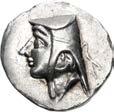
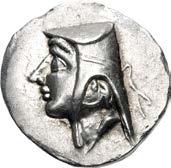
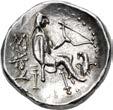
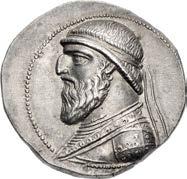
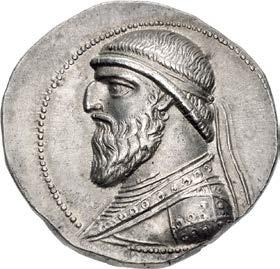
92
KINGS
of
draped
and wearing long beard and torque, and Anzaze, draped and wearing stephane and necklace, left; anchor symbol to right / Zeus-Belos enthroned left, holding in outstretched right hand Nike, standing right and holding wreath, and scepter in left; traces of ;G˚Ed∑@ to inner left; ˝2% (date) in exergue. van’t Haaff Type 7.1.1-1-2 (date unlisted); Alram 454 (date unlisted); Sunrise –. Light cleaning marks, scratch under chin, areas of weak strike. EF. Rare without the tooling or smoothing normally seen on this issue. ($1000)
The Kingdom of Elymais flourished as an autonomous sub-monarchy to the Seleukid and Parthian Kingdoms along the upper portion of the Persian Gulf, modern Khuzestan, Iran, from circa 188 BC to AD 222. The name derives from the ancient Biblical name for the region, Elam. Its earliest ruling dynasty, the Kamnaskirids, produced an intriguing coinage blending Hellenistic and Parthian elements. This attractive tetradrachm of Kamnaskires III depicts him alongside his wife, Anzaze, both of whom are named on the reverse as king and queen; both also sport royal diadems, indicating they ruled jointly.
Anzaze. Circa 82/1-73/2 BC. AR Tetradrachm (29mm, 16.15 g, 12h). Seleukeia on the Hedyphon
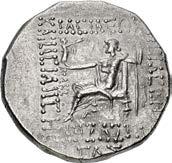
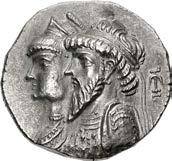
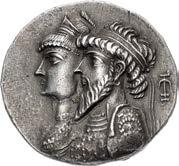
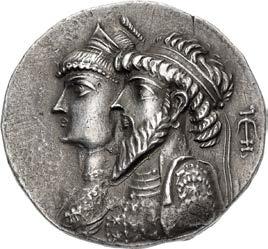
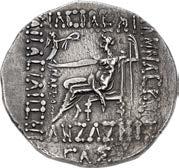
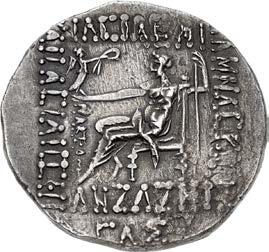
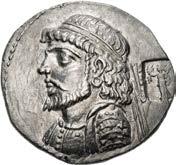

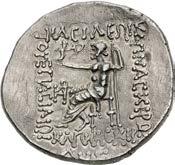
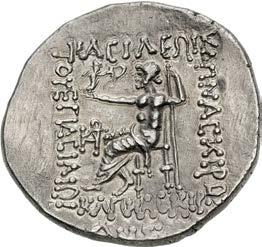
Dated SE 233 (80/79 BC). Conjoined busts of Kamnaskires III, diademed and draped bust and wearing long beard and torque, and Anzaze, draped and wearing stephane and necklace, left; anchor symbol to right / Zeus-Belos enthroned left, holding in outstretched right hand Nike, standing right and holding wreath, and scepter in left; traces of ;G˚Ed∑@ to inner left; ˝2% (date) in exergue. van’t Haaff Type 7.1.1-1-2 (date unlisted); Alram 454 (date unlisted); Sunrise –. Iridescent toning, traces of find patina, a coupe of light scratches under tone, tiny edge split, light roughness, hints of die rust and doubling. Near EF. Rare without the tooling or smoothing normally seen on this issue. ($1000)
New Monogram?
Uncertain mint. Dated 251 or 254 SE (62/1 BC or 59/8 BC). Diademed bust left, wearing short beard; c/m: Nike standing left, holding wreath and palm frond, within rectangular incuse / Zeus-Belos enthroned left, holding Nike, standing right and holding palm fronds, in outstretched right hand and scepter in left; monogram to inner left; Å or d@% (date) in exergue. van’t Haaff –, but
Type 8.3.1-1 (for obv.); cf. Alram 461 (for type); Zeno –. Iridescent toning, light cleaning marks, slight double strike on reverse. Coin: Near EF; c/m: VF. Apparently unique with this monogram. ($500)
93
Unrecorded Date
374. KINGS of ELYMAIS. Kamnaskires III, with Anzaze. Circa 82/1-73/2 BC. AR Tetradrachm (29mm, 15.99 g, 12h). Seleukeia on the Hedyphon mint. Dated SE 233 (80/79 BC). Conjoined busts
Kamnaskires III, diademed and
bust
375. KINGS of ELYMAIS. Kamnaskires III, with
mint.
376. KINGS of ELYMAIS. Kamnaskires IV. Circa 63/2-54/3 BC. AR Tetradrachm (29.5mm, 15.01 g, 12h).
cf.
From the Nisa Collection.
Ex Bellaria Collection
377. KINGS of PERSIS. Ardaxšir (Artaxerxes) I. 3rd century BC. AR Drachm (17mm, 4.12 g, 12h). Istakhr (Persepolis) mint. Head right, with mustache and earring, wearing kyrbasia / Fire temple of Ahura-Mazda; to left, Ardaxšir standing right; standard to right. van’t Haaff, Persis, Types 521/522/523/524, example d (this coin); K&M –; Alram –. Iridescent toning. EF. Rare variety with reverse letters retrograde, some inverted. ($1500)
From the Nisa Collection. Ex Bellaria Collection (Triton VII, 13 January 2004), lot 539; Sotheby’s (29 September 1988), lot 385 (part of).
378. KINGS of PERSIS. Vahbarz (Oborzos). 3rd century BC. AR Tetradrachm (28mm, 16.94 g, 4h). Istakhr (Persepolis) mint. Diademed head right, wearing kyrbasia / Fire temple of Ahura-Mazda; to left, Vahbarz standing right; standard to right; G (w = “V[ahbarz]” in Aramaic) to inner left, %RP (prs = “Persis” in Aramaic) down inner right. van’t Haaff, Persis Type 526/530; K&M 2/11; Alram 526. Obverse struck with slightly worn die. EF. ($2000)
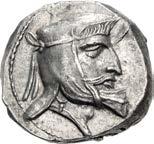

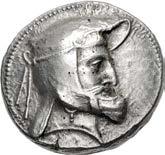
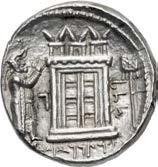
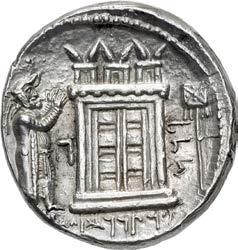
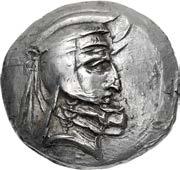
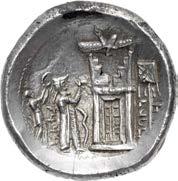
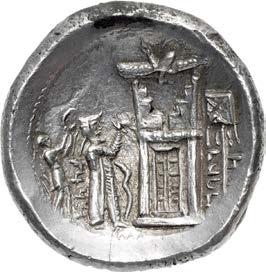

Extremely Rare Victory Type
379. KINGS of PERSIS. Vādfradād (Autophradates) I. 3rd century BC. AR Tetradrachm (30mm, 17.21 g, 3h). “Victory” type. Istakhr (Persepolis) mint. Diademed head right, wearing kyrbasia / Fire temple of Ahura-Mazda; to left, Vādfradād standing right, being crowned with wreath by Nike standing behind; bow set on ground before; standard to right; RP†w/†D (wtprdt in Aramaic) in two lines down right, traces of âKR†Rp (prtrk’... in Aramaic) in exergue, †r r4? (br rt in Aramaic) up inner left. Cf. van’t Haaff Type 544; K&M –; Alram –; Sunrise 573 var. (no legend up left); Zeno –. Iridescent toning, thick deposits on edge, obverse triple struck, tiny edge split. EF. Extremely rare variety of an extremely rare type. ($3000)

94
Overstruck on a Tetradrachm of Baydād (Bagadat)
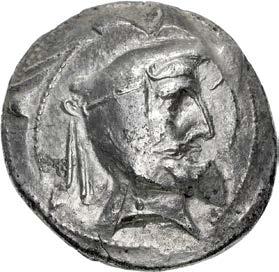

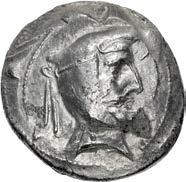
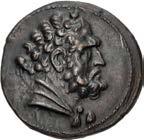
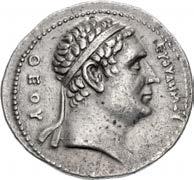
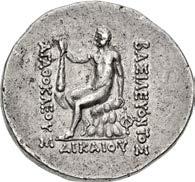

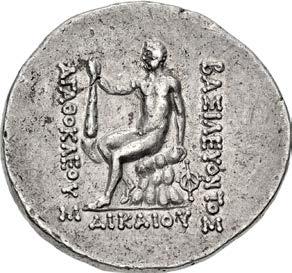
380. KINGS of PERSIS. Vādfradād (Autophradates) I. 3rd century BC. AR Tetradrachm (31mm, 16.09 g, 3h). Istakhr (Persepolis) mint. Diademed head right, wearing kyrbasia / Fire temple of Ahura-Mazda; to left, Vādfradād standing right; bow set on ground before; standard to right; †DRP†w/3z âKR†Rp (wtprdt/prtrk’ zy in Aramaic) in two lines down right, ⁄3%;⁄ (’lhy’ in Aramaic) up left. Cf. van’t Haaff Type 533/535/538; cf. K&M Nachtrage 2/18 (for a similar overstrike); Alram –; Sunrise –; Zeno –. Traces of find patina, cleaning marks, areas of horn silver, some smoothing, edge chip. VF. Overstruck on a tetradrachm of Baydād (Bagadat) with fire altar reverse (van’t Haaff Type 515/519). Rare. ($1500)
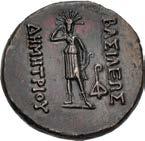
381. BAKTRIA, Greco-Baktrian Kingdom. Demetrios I Aniketos. Circa 200-185 BC. Æ Dichalkon (24mm, 7.91 g, 12h). Bearded bust of Herakles right, wearing lion skin; club over shoulder / Artemis standing facing, holding bow and drawing arrow from quiver; ‚ to inner left. Bopearachchi 4B; MPHB Goup VI. 62 (dies 33/51 – this coin); SNG ANS 201-3; HGC 12, 68. Red and brown patina, smoothing. EF. ($750)
Ex Triton IX (10 January 2006), lot 1114; Spink 175 (28 September 2005), lot 209.
Agathokles Commemorative Struck for Euthydemos I
382. BAKTRIA, Greco-Baktrian Kingdom. Agathokles Dikaios. Circa 185-175 BC. AR Tetradrachm (32.5mm, 17.00 g, 12h). Commemorative issue struck for Euthydemos I Theos. Diademed head of Euthydemos right / Herakles seated left on rocky outcropping, holding club set on knee; D to inner right. Bopearachchi 16B; Bopearachchi & Rahman –; MPHB dies O32/R97; SNG ANS 261; MIG Type 145a; HGC 12, 87. Lightly toned with traces of iridescence, traces of deposits, marks. Near EF. ($3000)
95
383. BAKTRIA, Greco-Baktrian Kingdom. Antimachos I Theos. Circa 180-170 BC. AR Tetradrachm (33.5mm, 16.93 g, 12h). Diademed and draped bust right, wearing kausia / Poseidon, laureate, standing facing, holding trident and filleted palm; Í to inner right. Bopearachchi 1A; MPHB Group II, dies 20/43; SNG ANS 274-5; HGC 12, 106. Toned, areas of slight double strike, light overall deposits. Near EF. ($1000)
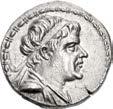
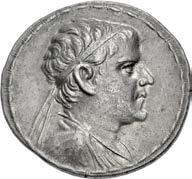
384. BAKTRIA, Greco-Baktrian Kingdom. Antimachos I Theos. Circa 180-170 BC. AR Drachm (19mm, 4.20 g, 12h). Diademed and draped bust right, wearing kausia / Poseidon, laureate, standing facing, holding trident and filleted palm; K to inner right. Bopearachchi 2B; MPHB Group III, dies 4/18; SNG ANS 280-1; HGC 12, 109. Traces of deposits in devices, a few cleaning marks. Good VF. ($500)
From the GTP Collection. Ex Münz Zentrum 181 (17 May 2017), lot 179.
Commemorative Issue for Euthydemos I Theos
385. BAKTRIA, Greco-Baktrian Kingdom. Antimachos I Theos. Circa 180-170 BC. AR Tetradrachm (31mm, 16.74 g, 12h). Commemorative issue struck for Euthydemos I Theos. EUQUd˙;oU down right, QEoU down left, diademed head of Euthydemos right / ∫Å%5¬EUo@to% down right, Å@t5;ÅcoU down left, QEoU in exergue, Herakles seated left on rocky outcropping, holding club set on knee; J to inner right. Bopearachchi 10A; Bopearachchi & Rahman 191-192; MPHB dies 3/12; SNG ANS 297-298; MIG Type 129; HGC 12, 108. In NGC encapsulation 6827246, graded Ch AU, Strike: 5/5, Surface: 4/5. ($5000)
386. BAKTRIA, Greco-Baktrian Kingdom. Eukratides I Megas. Circa 170-145 BC. AR Tetradrachm (32mm, 16.95 g, 12h). Diademed and draped bust right / the Dioskouroi, holding palm fronds and spears, on horses rearing right; } in lower right field. Bopearachchi 2B; SNG ANS 438 var. (placement of monogram); HGC 12, 135. Lightly toned with traces of iridescence. Good VF. ($750)
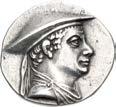
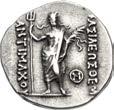
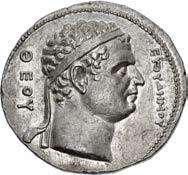
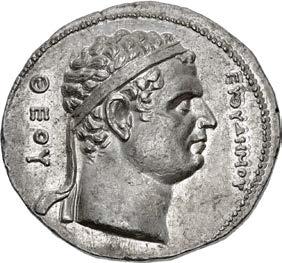
387. BAKTRIA, Greco-Baktrian Kingdom. Eukratides I Megas. Circa 170-145 BC. AR Drachm (20mm, 4.25 g, 12h). Diademed and draped bust right / The Dioskouroi, holding spears and palm fronds, on horses rearing right; Å in upper left field, I in lower right. Bopearachchi 2C; SNG ANS 439-41; HGC 12, 135. Lightly toned with traces of iridescence, slight porosity, hairline flan crack. Choice EF. ($750)
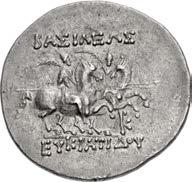
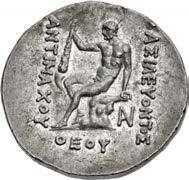
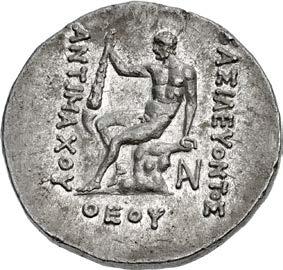
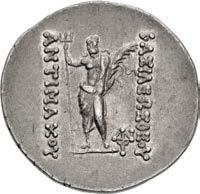
From the Weise Collection. Ex Classical Numismatic Group 54 (14 June 2000), lot 975.
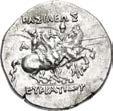

96
383 384 386 387
388. BAKTRIA, Greco-Baktrian Kingdom. Eukratides I Megas. Circa 170-145 BC. AR Tetradrachm (33mm, 17.01 g, 12h). Helmeted, diademed, draped, and cuirassed bust right / The Dioskouroi, holding couched spears and palm fronds, on horses rearing right;äin lower right field. Bopearachchi 6T; SNG ANS 468; HGC 12, 131. Light iridescent toning, traces of underlying luster. EF. ($1000)
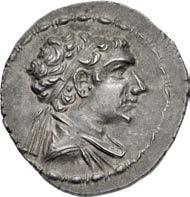
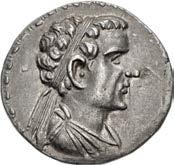
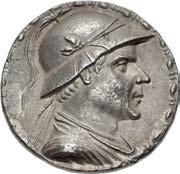
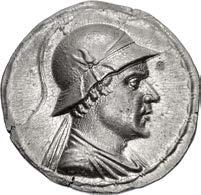
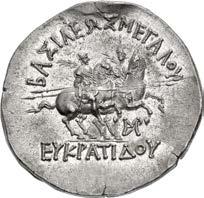
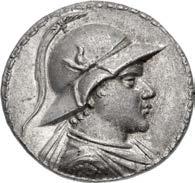
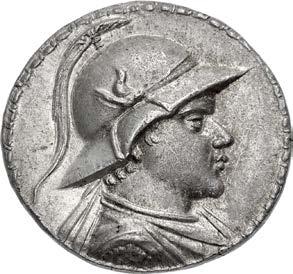
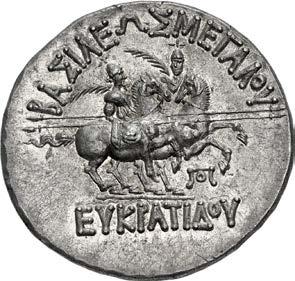
389. BAKTRIA, Greco-Baktrian Kingdom. Eukratides I Megas. Circa 170-145 BC. AR Tetradrachm (33mm, 17.06 g, 12h). Helmeted, diademed, draped, and cuirassed bust right / The Dioskouroi, holding couched spears and palm fronds, on horses rearing right; : in lower right field. Bopearachchi 6V; SNG ANS –; HGC 12, 131. Light iridescence with underlying luster, edge crimped with tiny associated flan crack. EF. ($1000)
390. BAKTRIA, Greco-Baktrian Kingdom. Eukratides I Megas. Circa 170-145 BC. AR Tetradrachm (30mm, 16.90 g, 12h). Helmeted, diademed, draped, and cuirassed bust right / The Dioskouroi, holding couched spears and palm fronds, on horses rearing right; § in lower right field. Bopearachchi 6DD; SNG ANS –; HGC 12, 131. Lightly toned. Near EF. ($1000)
391. BAKTRIA, Greco-Baktrian Kingdom. Eukratides II Soter. Circa 145-140 BC. AR Tetradrachm (29.5mm, 16.96 g, 12h). Diademed and draped bust right / Apollo standing left, holding arrow and bow set on ground; kr to inner left. Bopearachchi 1A; SNG ANS –; HGC 12, 161. Iridescent toning. Good VF. ($750)
392. BAKTRIA, Greco-Baktrian Kingdom. Eukratides II Soter. Circa 145-140 BC. AR Tetradrachm (32mm, 16.90 g, 12h). Diademed and draped bust right / Apollo standing left, holding arrow and bow set on ground; N to inner left. Bopearachchi 3B; SNG ANS 625-6; HGC 12, 162. Toned, slight flan flaws, struck with worn dies. Good VF. ($750)

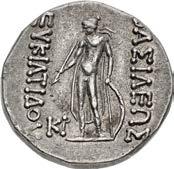
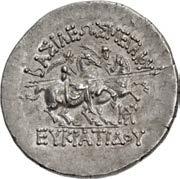
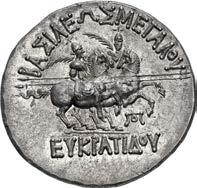
97
389 390 391 392
393. BAKTRIA, Indo-Greek Kingdom. Strato I Soter. Circa 105-85/0 BC. AR Tetradrachm (27mm, 9.59 g, 12h). Diademed and draped bust right / Athena Alkidemos advancing left, brandishing aegis and thunderbolt; b to inner left. Bopearachchi 26A; SNG ANS 999; HGC 12, 334. Toned, areas of find patina, laminations on reverse. Good VF. ($1000)
From the Weise Collection. Ex Classical Numismatic Group 54 (14 June 2000), lot 1001.
394. BAKTRIA, Indo-Greek Kingdom. Strato I Soter. Circa 105-85/0 BC. AR Drachm (18mm, 2.35 g, 12h). Diademed and draped bust right / Athena Alkidemos advancing left, brandishing aegis and thunderbolt; G to inner left. Bopearachchi 27C; SNG ANS –; HGC 12, 346. Deposits, reverse double struck. VF. Rare. ($500)
From the Weise Collection, purchased from Pegasi Numismatics, 11 July 1994.
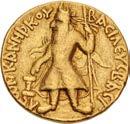
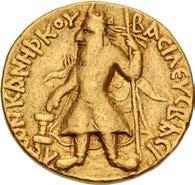
CENTRAL ASIAN COINAGE
Extremely Rare Helios Dinar
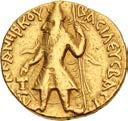
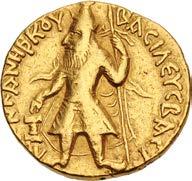
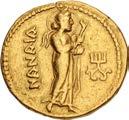

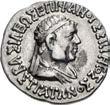
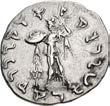
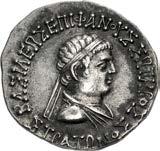
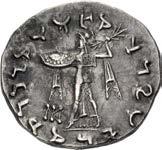
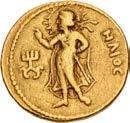
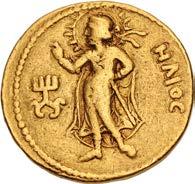
395. INDIA, Kushan Empire. Kanishka I. Circa AD 127-151. AV Dinar (20mm, 7.90 g, 12h). Main mint in Baktria (Balkh?). Early phase with Greek legend. ßAcilEyc ßAci lEwn kAnhskoy, Kanishka, diademed and crowned, standing facing, head left, holding goad and scepter, sacrificing over altar to left; flame at shoulder / hlioc to left, radiate and diademed Helios, left hand on hip, standing left, raising right hand in benediction; 8 to left. MK 25 (O1/R1) = Cribb & Bracey
D.G1i = A. Cunningham, “Coins of the Kushâns, or Great Yue-ti,” NC 1892, 1 = FdS 21 = Göbl, Antike 3358 = Rosenfield 90 = BM inv. 1888, 1208.537 (same dies); ANS Kushan –; Donum Burns –; Triton XXIII, lot 552 (same dies); NGSA 11, lot 7 (same dies); Triton XXI, lot 576 (same dies); CNG 105, lot 541 (same dies); CNG E-369, lot 316 (same dies); Triton XVI, lot 654 (same dies). Near VF. Extremely rare, only three examples cited by Göbl (one in the BM; the second in Berlin [possibly a forgery]; the third in Seaby Coin & Medal Bulletin 730 [June 1979], no. A602). ($5000)
Ex Classical Numismatic Group 105 (10 May 2017), lot 541.
396. INDIA, Kushan Empire. Kanishka I. Circa AD 127-151. AV Dinar (20mm, 794 g, 12h). Main mint in Baktria (Balkh?). Early phase with Greek legend. ßAcilEyc ßAci lEwn kAnhskoy, Kanishka, diademed and crowned, standing facing, head left, holding goad and scepter, sacrificing over altar to left; flame at shoulder / nAnAiA to left, Nana standing right, holding scepter and box; 9 to right. MK 27 (O2/R1) = Cribb & Bracey D.G1i = FdS 23 = Göbl, Antike 2339 = Rosenfield 32 = BM Inv. 1929,0725.1; ANS Kushan –; Donum Burns –. Near VF. Extremely rare, only two examples cited by Göbl, in public collections (the BM and The Hague). ($5000)
Ex Classical Numismatic Group 105 (10 May 2017), lot 542.
98
393 394
397. INDIA, Kushan Empire. Kanishka I. Circa AD 127-151. AV Dinar (22mm, 7.96 g, 12h). Main mint in Baktria (Balkh?). Late phase. Kanishka standing left, holding goad and scepter, sacrificing over altar to left; flame at shoulder / Siva standing left, pouring water from flask and holding goad, vajra (thunderbolt), trident, and he-goat; 9 to left. MK 78 (O41/R–[unlisted rev. die]); ANS Kushan –; Donum Burns 140. Good VF. ($2000)
398.
Empire. Kanishka I. Circa AD 127-151. AV Dinar (20mm, 7.99 g, 12h). Main mint in Baktria (Balkh?). Early phase. Kanishka, diademed and crowned, standing facing, head left, holding goad and scepter, sacrificing over altar to left; flame at shoulder / Nana, nimbate, wearing fillet and crescent, standing right, holding scepter and box; 8 to right. MK 35 (O6/R7); ANS Kushan 370; Donum Burns 117. Hint of die rust, lustrous. EF. Well centered strike. ($1500)
399.
Kushan Empire. Kanishka I. Circa AD 127-151. AV Dinar (20.5mm, 7.97 g, 12h). Main mint in Baktria (Balkh?). Early phase. Kanishka standing left, holding goad and scepter, sacrificing over altar to left; flame at shoulder / Siva standing left, pouring water from flask and holding vajra (thunderbolt), trident, and he-goat; 9 to left. MK 37 (O13/R2 [an unlisted die combination); ANS Kushan 371-2; Donum Burns 119-21. Traces of deposits in devices, slight scrape on obverse, slight double strike on reverse, traces of underlying luster. Near EF. ($1500)
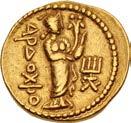
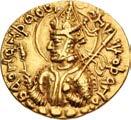
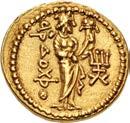
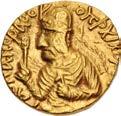
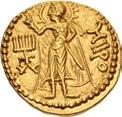
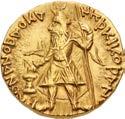

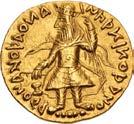
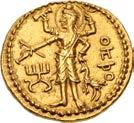
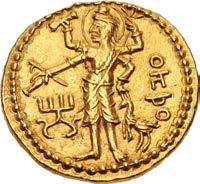
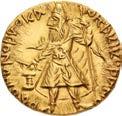

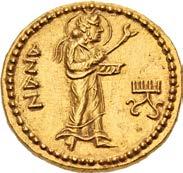
400. INDIA, Kushan Empire. Huvishka. Circa AD 151-190. AV Dinar (20mm, 7.92 g, 12h). Main mint in Baktria (Balkh?). Early phase. Crowned and diademed half-length bust left on clouds, holding mace-scepter and hilt of sword / Miiro (Mithras) standing facing, head left, raising hand in benediction; other hand on sword; 7 to left. MK 138.8 (O25/R36); ANS Kushan –; Donum Burns –. Traces of deposits, struck with slightly worn dies. Good VF. Rare. ($1000)
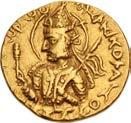
401. INDIA, Kushan Empire. Huvishka. Circa AD 151-190. AV Dinar (21mm, 7.96 g, 12h). Main mint in Baktria (Balkh?). Late phase. Nimbate, diademed, and crowned half-length bust left on clouds, holding mace scepter and filleted spear / Ardoxsho, wearing stephane, standing facing, head right, extending cornucopia with both hands; 7 to right. MK 286 (O1/R26); ANS Kushan 749; Donum Burns 263-264. Lightly toned, deposits in devices, slightly double struck. Near EF. ($1500)
402. INDIA, Kushan Empire. Huvishka. Circa AD 151-190. AV Dinar (21mm, 7.84 g, 12h). Main mint in Baktria (Balkh?). Late phase. Nimbate, diademed, and crowned half-length bust left on clouds, holding mace scepter and filleted spear / Ardoxsho, wearing stephane, standing facing, head right, extending cornucopia with both hands; 7 to right. MK 286 (O9/ R36); ANS Kushan 749; Donum Burns 263-264. Toned. VF. ($1000)
99
INDIA, Kushan
INDIA,
399 400 401 402
403. INDIA, Kushan Empire. Vasudeva I. Circa AD 190-230. AV Dinar (21mm, 7.99 g, 12h). Main mint in Baktria (Balkh?). Middle phase. Vasudeva, nimbate, helmeted, and diademed, standing facing, head left, holding trident, sacrificing over altar to left; filleted trident to left / Siva standing facing, holding a garland or diadem in extended right hand and trident in left; behind, the bull Nandi standing left; 6 to upper left. MK 509 (O4/R– [unlisted rev. die]); ANS Kushan 1088; Donum Burns 415. Toned, deposits in devices, slight doubling. Good VF. ($1000)
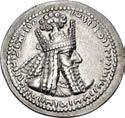
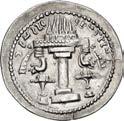

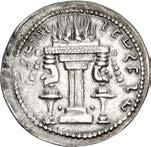

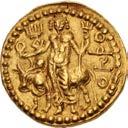
Ex Malter Galleries inventory.
404. INDIA, Kushan Empire. Vasudeva I. Circa AD 190-230. AV Dinar (21mm, 8.00 g, 12h). Main mint in Baktria (Balkh?). Middle phase. Vasudeva, nimbate, helmeted, and diademed, standing facing, head left, holding trident, sacrificing over altar to left; filleted trident to left / Siva standing facing, holding a garland or diadem in extended right hand and trident in left; behind, the bull Nandi standing left; 6 to upper left. MK 509 (O7/R– [unlisted rev. die]); ANS Kushan 1088; Donum Burns 414. Toned. VF. ($1000)
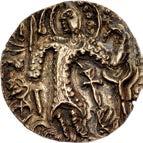
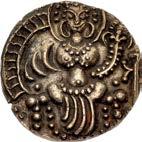

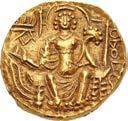
405. INDIA, Kushan Empire. Shaka. Circa AD 325-345. AV Dinar (20mm, 7.78 g, 12h). Uncertain mint. Shaka, nimbate, standing facing, head left, sacrificing over altar and holding filleted staff; filleted trident to left; M (bha in Brahmi) to right of altar; , (bhri in Brahmi) under Shaka’s left arm; _ (śaka in Brahmi) to outer right / Ardoxsho enthroned facing, holding diadem in right hand and cradling cornucopia in left arm; ^ to left. MK 580 (unlisted dies); ANS Kushan –; Donum Burns 749-50. Lightly toned, deposits, double strike on obverse. Good VF. ($750)
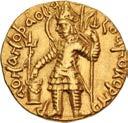
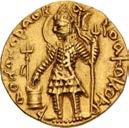
406. INDIA, Post-Kushan (Gandhara). Kidara Shahis. Sri Shahi Kidara. Mid 5th-6th centuries AD. AV Dinar (24mm, 7.87 g, 12h). Nimbate king standing left, sacrificing over [altar] and holding [filleted standard]; filleted trident to left, śri śahi in Brahmi to right of altar, Kidara monogram in inner right field / Ardoxsho, nimbate, seated facing on throne, [holding filleted investiture garland] and cornucopia. MK pl. 176, 18/1 = A. Cunningham, “Coins of the Later Indo-Scythians-Little Kushans,” NC 1893, 14; Donum Burns 1598. Toned, deposits. Near EF. ($500)
407. SASANIAN KINGS. Ardaxšīr (Ardashir) I. AD 223/4-240. AR Drachm (27mm, 4.19 g, 3h). Mint B (“Hamadan”). Phase 3, circa AD 233/4-238/9. Bust right, wearing diadem (type R) / Fire altar (flames 1) with diadems (type R); pellets flanking second tier of altar base. SNS type VII(4a)/3b(2b); Saaedi 71; Sunrise 710 var. (pellets on base of altar). Light iridescent toning. EF. Attractive example and rarer type for this ruler. ($1000)
Ex Classical Numismatic Group 121 (6 October 2022), lot 682 (hammer $1300); Stack’s Bowers & Ponterio 173 (8 January 2013), lot 282.
408. SASANIAN KINGS. Ardaxšīr (Ardashir) I. AD 223/4-240. AR Hemidrachm (21mm, 2.11 g, 3h). Mint C (“Ctesiphon”). Phase 3, circa AD 233/4-238/9. Bust right, wearing diadem (type R) and merlon crown / Fire altar (flames 2) with diadems (type R). SNS type V(4a)/3a(2b); Saeedi 59-60; Sunrise 722 var. (rev. diadems [type G]). Slight doubling on reverse. Near EF. Very rare. ($500)
From the Nisa Collection.
100
403 404 405 406 407 408
409. SASANIAN KINGS. Ardaxšīr (Ardashir) I. AD 223/4-240. AR Obol (16mm, 0.65 g, 12h). Mint C (“Ctesiphon”). Phase 3, circa AD 233/4-238/9. Bust right, wearing diadem (type R) and merlon crown / Fire altar (flames 2) with diadems (type G). SNS type V(4a)/3a(2b); Saeedi 56 var. (rev. diadems [type R]); Saeedi 61; Sunrise 723 var. (same). Iridescent toning. Good VF. ($750)
From the Nisa Collection.
410. SASANIAN KINGS. Šābuhr (Shahpur) I. AD 240-272. AV Dinar (21mm, 7.38 g, 3h). Mint I (“Ctesiphon”). Phase 2, circa AD 260-272. Bust right, wearing diadem and mural crown with korymbos / Fire altar; flanked by two attendants wearing mural crowns; ˘ to right of altar shaft. SNS type IIc/1b, style P, group b and plate 30, 126 var. (no pellets); Saeedi AV4 var. (same); Sunrise 739 var. (same). Lightly toned, hint of underlying luster. EF. ($2500)
411. SASANIAN KINGS. Šābuhr (Shahpur) I. AD 240-272. AV Dinar (21mm, 7.33 g, 3h). Mint I (“Ctesiphon”). Phase 2, circa AD 260-272. Bust right, wearing diadem and mural crown with korymbos / Fire altar; flanked by two attendants wearing mural crowns; ˘ to right of altar shaft. SNS type IIc/1b, style P, group b and plate 30, 126 var. (no pellets); Saeedi AV4 var. (same); Sunrise 739 var. (same). Lightly toned, hint of underlying luster. EF. ($2500)
412. SASANIAN KINGS. Vahrām (Bahram) II, with Prince 3. AD 276-293. AR Hemidrachm (22mm, 2.15 g, 3h). Style E. Uncertain mint. Bust of Bahram right vis-à-vis bust of Prince 3 left; Bahram wearing winged crown with korymbos, prince wearing kolah with boar’s head / Fire altar; flanked by two attendants, the left wearing mural crown, the right with winged crown with korymbos; ˘ to right of flames. SNS type III(1)/1(1a) and cf. pl. 21, A55 (obol); Saeedi –; Sunrise –. Iridescent toning . Near EF. Very rare. ($1000)
From the Nisa Collection.
413. SASANIAN KINGS. Vahrām (Bahram) II, with Queen and Prince 4. AD 276-293. AR Drachm (33mm, 4.32 g, 3h). Style A. ‘Ctesiphon’ mint. Jugate busts of Vahrām (Bahram), wearing winged crown with korymbos, and his queen, wearing kolah with boar’s head, right, vis-a-vis bust of Prince 4, wearing kolah with eagle’s head, left / Fire altar; flanked by two attendants facing outward, each wearing winged crown with korymbos; > to left of flames. SNS type VIa(1)/2(1a), Style A; Sunrise –. Light iridescence. Good VF. ($500)
Ex Classical Numismatic Group 121 (6 October 2022), lot 686; Classical Numismatic Group 88 (14 September 2011), lot 644.
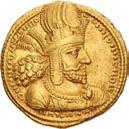
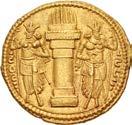

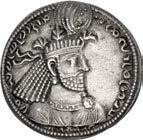
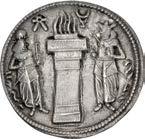

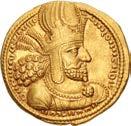

Ex Bellaria Collection
414. SASANIAN KINGS. Narseh (Narsē). AD 293-303AD 293-303. AR Drachm (24mm, 4.01 g, 3h). Style A/1. Ctesiphon mint. Phase 1. Bust right, wearing crown with arcades, three foliate branches, and korymbos; hair in single group / Fire altar; flanked by two attendants, both wearing mural crowns, the left with korymbos; > and ö flanking flames. SNS type Ia/1a, Style A/1; Sunrise 802-3. Toned, minor deposits. Near EF. ($750)
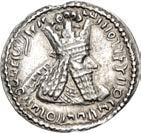


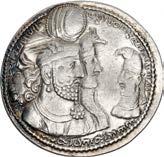
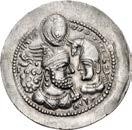
Ex Bellaria Collection (Triton VII, 12 January 2004), lot 605; Spink Numismatic Circular XC.6 (July 1982), no. 5625 (and illustrated on cover).

101
411 412 413 414 409 410
415. SASANIAN KINGS. Narseh (Narsē). AD 293-303AD 293-303. AR Obol (15mm, 0.65 g, 9h). Style A/3. Mint C (“Ctesiphon”). Phase 3. Bust right, wearing crown with arcades and korymbos / Fire altar; flanked by two attendants, both wearing mural crowns, the left with korymbos. SNS type II (zu 1)/5b (–), Style A/3 and pl. 31, A31 (same dies); Saeedi 185; Sunrise 799-800. Lightly toned. Near EF. Very rare. ($500)
From the Nisa Collection.
One of Three Known
416. SASANIAN KINGS. Yazdgird (Yazdgard) I, with Šābuhr (Shahpur) IV. AD 399-420. AR Drachm (28mm, 3.78 g, 3h). Uncertain (“Western”) mint. Struck AD 414-420. Bust right on floral ornament, wearing mural crown with frontal crescent and korymbos; pseudo-legend around / Ak;q 70q; g0 AL; Uejwπjc (šhpwhry lba zy ’lmn’n mlk’ [Shahpur the great king of the Armenians]) in Pahlavi), bust right, wearing


roughness, slight double strike on reverse, lightly crystallized surfaces. Good VF. Extremely rare, one of three known, and the only one with a fully readable legend. ($2000)
From the Nisa Collection.
Appointed king of Sasanian Armenia by his father Yazdgird I in AD 414, Šābuhr IV, ruled that territory with reconciliation and amicable relations with the local nobility. When Yazdgird I was assassinated at Hyrcania in AD 420, Šābuhr rushed to the capital at Ctesiphon to claim the succession. His reign, however, was brief, since he was subsequently murdered by the nobles and priests. As all three specimens appear to have been struck in an ad hoc manner, and perhaps suppressed shortly thereafter (an thus their extreme rarity), this coin may have been struck upon Šābuhr’s arrival at Ctesiphon.

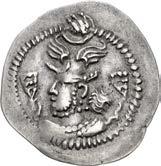
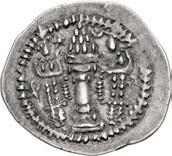
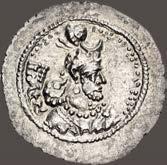
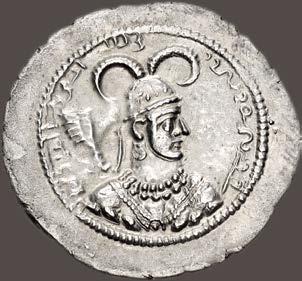
417. SASANIAN KINGS. Pērōz (Fīrūz) I. AD 457/9-484. AR Drachm (26.5mm, 4.13 g, 3h). Local issue of a Type 3. BYŠ (Bishapur) mint. Struck circa AD 477-484. Bust left, wearing crown with two wings, frontal crescent, and korymbos set on crescent, ribbon over each shoulder / Fire altar with ribbons; flanked by two attendants, star and crescent flanking flames; M (m in Pahlavi) on left, £ (BYŠ in Pahlavi) on right. SNS –, but cf. IIIb/1e (for standard type); SNS Schaaf 404; Saaedi –; Göbl –; De Morgan –; Sunrise –; Zeno –. Toned, deposits, cleaning marks. Good VF. Apparently unique variety with the bust left. None in CoinArchives or Zeno. ($2000)
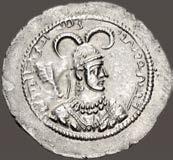
102
ram’s horn crown with ribbons. SNS type Ib1/7 (no example in catalog); SNS Schaaf 404; Saaedi –; Göbl –; De Morgan –; Sunrise –; Zeno –. Traces of find patina, porosity and light
418. SASANIAN KINGS. Vālaxš (Balāsh). AD 484-488. AR Obol (13.5mm, 0.47 g, 3h). ST (Stakhr) mint. Bust right, wearing merlon crown with korymbos set on crescent, ribbon on left shoulder, flames on right / Fire altar with ribbons and head of Balash right on shaft; attendants flanking, star and crescent flanking flames. Cf. SNS type Ib/1b (drachm); Saeedi –; Sunrise –. Iridescent toning, some surface granularity/porosity. EF. Extremely rare. ($500)
From the Nisa Collection.
419. SASANIAN KINGS. Kavād (Kavādh) II. AD 628. AR Drachm (31mm, 4.19 g, 3h). AYLAN (Susa?) mint. Dated RY 2 (AD 628). Bust right, wearing mural crown with frontal crescent and korymbos set on crescent / Fire altar with ribbons; attendants flanking; star and crescent flanking flame. Malek, Kavad 31-50 (this coin not recorded); Sunrise 991. Iridescent toning. EF. ($1000)
From the Nisa Collection. Ex Peus 386 (26 April 2006), lot 461.
420. SASANIAN KINGS. Bōrān. AD 630-631. AR Drachm (33mm, 4.05 g, 3h). SK (Sakastān) mint. Dated RY 2 (AD 630/1). Bust right, wearing crown with two wings and korymbos set on crescent; ribbon on left shoulder, crescent and ribbon on right; star and star-in-crescent flanking crown; star-in-crescents in margin / Fire altar with ribbons; flanked by two attendants; star and crescent flanking flames; RY date to left, mint signature to right; star-in-crescents in margin. Malek & Curtis 29-73; SC Tehran –; SNS Schaaf 689-91; Sunrise 1006. Toned with traces of iridescence, light marks under tone, areas of slight double strike. Near EF. ($750)
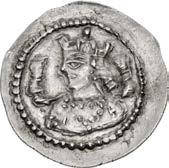
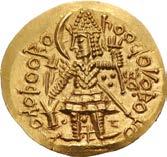
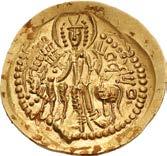

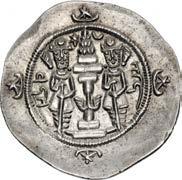
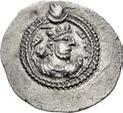

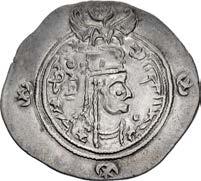
From the James Fox Collection, purchased 16 November 1986.
421. KUSHANO-SASANIANS. Ardaxšīr (Ardashir) (I–II). Circa AD 230-245. AV Dinar (26.5mm, 7.72 g, 12h). Imitating Kushan king Vasudeva I. Uncertain mint in Baktria. Early series. Vasudeva standing left, flames on shoulder, holding filleted standard, sacrificing over altar to left; filleted trident to left; • to right of altar; between legs, ·; τ to right of leg; ˘ below arm; 0 to right / Ithyphallic Siva standing facing, holding a garland or diadem and trident with o on shaft; behind, the bull Nandi standing left; • and : to upper left; ˘ below Nandi’s head. MK 688; ANS Kushan –; Donum Burns –. Traces of deposits, double struck. EF. Rare. ($750)
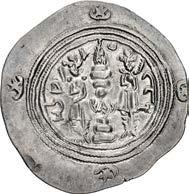
422. HUNNIC TRIBES, Hephthalites. Anonymous. Circa 484/8-560. AR Drachm (29.5mm, 4.15 g, 9h). Half-length bust of chieftain left, with hand on hip, holding drinking cup; bA ebAkA in Baktrian around / Sasanian-style bust imitating Vahrām (Bahram) V left. Cf. Vondrovec [Göbl, Hunnen] Type 287A-B; cf. Alram, Schatfund 47-8; cf. Göbl, Dokumente pl. 84, E25 = Zeno 42957 (all refs for type). Near EF. Very rare. ($1500)
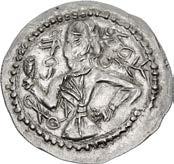
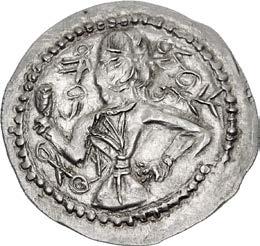

103
Queen Bōrān
418 419
421
422
423. HUNNIC TRIBES, Hephthalites. Anonymous. Circa 484/8-560. AR Drachm (29.5mm, 4.08 g, 3h). Half-length bust of chieftain left, with hand on hip, holding drinking cup; bA ebAkA in Baktrian around / Sasanian-style bust imitating Vahrām (Bahram) V right. Cf. Vondrovec [Göbl, Hunnen] Type 287A-B; cf. Alram, Schatfund 47-8; cf. Göbl, Dokumente pl. 84, E25 = Zeno 42957 (all refs for type). Deposits in devices. VF. Very rare. ($750)
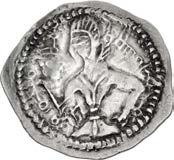
ROMAN PROVINCIAL COINAGE
424. GAUL, Nemausus. Augustus, with Agrippa. 27 BC-AD 14. Æ Dupondius (25mm, 13.33 g, 3h). Struck AD 10-14. Heads of Agrippa, wearing combined rostral crown and laurel wreath, and Augustus, laureate, back to back / Crocodile right, chained to palm frond with wreath at top with long ties to right; two palm fronds at base. RPC I 525; RIC I 159-61; SNG Copenhagen 700-1. Dark green patina, minor roughness. Good VF. ($750)
Ex Dr. Walter Stoecklin (†1975) Collection (Nomos Obolos 9, 25 March 2018), lot 140.
Published in Tachev and RPC
(26mm, 10.56 g, 1h). Struck AD 241-244. Laureate, draped, and cuirassed bust of Gordian right vis-à-vis draped bust of Tranquillina, wearing stephane right / Galley under sail right, with captain and oarsmen, waves below. Tachev,
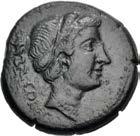
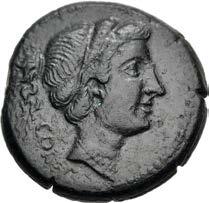
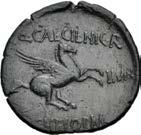
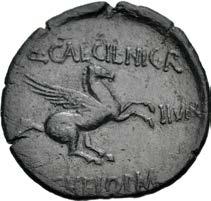
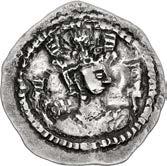
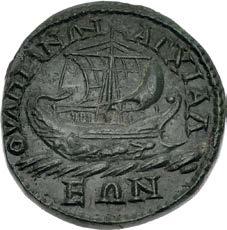
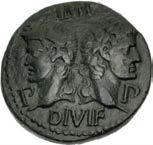
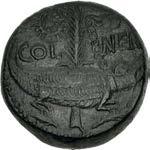
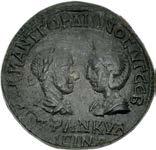
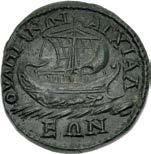
Ex
Ex BCD & Rhousopoulos Collections – Pedigreed to 1905
104
425. THRACE, Anchialus. Gordian III, with Tranquillina. AD 238-244. Æ Pentassarion
Anchialos 705 (O2/R155) = RPC VII.2 1156.15 (this coin); AMNG 682; Varbanov 699. Dark green patina, minor smoothing. Good VF. ($750)
Triton IX (10 January 2006), lot 1550.
426. CORINTHIA, Corinth. 34-31 BC. Æ As (22mm, 5.38 g, 9h). Q. Caecilius Niger and Gaius Heius Pamphilus, duoviri. Filleted head of Aphrodite right / Pegasus rearing right. Amandry VIb (D4/R151) = BCD Corinth 328 (this coin). Dark brown patina, light marks. Near EF. ($1000)
Ex Gary Davies Collection (Freeman & Sear 10, 11 February 2004), lot 285; BCD Collection (Lanz 105, 26 November 2001), lot 328; Rhousopoulos Collection (Hirsch XIII, 15 May 1905), lot 2313.
Ex BCD Collection
427. CORINTHIA, Corinth. Claudius. AD 41-54. Æ As (19mm, 7.68 g, 9h). Licinius and Octavius, duoviri. Struck AD 42/3-45/6. Laureate head left / View of the Acrocorinth: façade of hexastyle Temple of Aphrodite set on rock outcropping. Amandry XVIII4 (Db1/Raa3); RPC I 1180b; BCD Corinth 419 (this coin). Brown patina. VF. An attractive and well-struck example. Very rare. ($750)
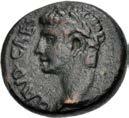

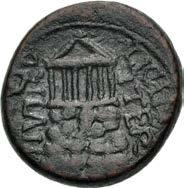
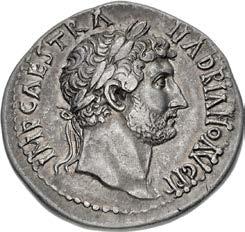

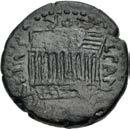
Ex Triton X (9 January 2007), lot 581; BCD Collection (Lanz 105, 26 November 2001), lot 419.
Ex BCD Collection
428. CORINTHIA, Corinth. Galba. AD 68-69. Æ As (21mm, 6.74 g, 6h). L. Caninius Agrippa, duoviri. Bare head right / Tetrastyle temple viewed in perspective. Amandry XXIV61.2 (Dd4/RIIIb4); RPC I 1219; BCD Corinth 496 (this coin). Green patina, light smoothing. VF. Rare. ($500)
Ex Classical Numismatic Group 70 (21 September 2005), lot 545; BCD Collection (Lanz 105, 26 November 2001), lot 496.
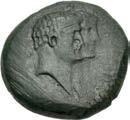
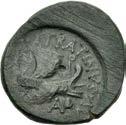
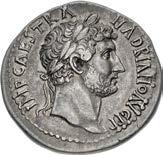
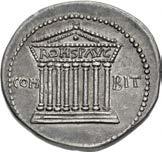
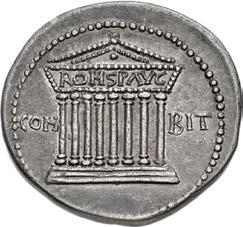
429. ACHAEA, Uncertain. Mark Antony, with Octavia. Summer 37 BC. Æ As (20.5mm, 5.65 g, 1h). Fleet Coinage. Light series. L. Sempronius Atratinus, consul designatus. Jugate bare heads of Antony and Octavia right / Galley sailing right; A and gorgoneion below, lituus above. Amandry, Bronze I, Series II.2.C, 5 (D4/R5); RPC I 1461. Green patina, flan preparation marks, off center on reverse. Good VF. A particularly clear example. Very rare. ($750)
Cited in RPC III
430. BITHYNIA, Koinon of Bithynia. Hadrian. AD 117-138. AR Cistophorus (27mm, 10.86 g, 7h). Nicomedia mint. Struck AD 128-138. Laureate head right / Octastyle temple set on podium with three steps, ROM S P AVG across frieze, pellet in pediment. Metcalf, Cistophori, Type B1, 1 (O1/R1); RPC III 968.28 (this coin); RSC 240b. Old cabinet tone, light golden iridescence. Near EF. Excellent portrait. ($2000) Ex Roma XVII (28 March 2019), lot 644.
105
AD 161-180. Æ Medallion (41mm, 35.58 g, 6h). A. Tyllios Kratippos, strategos. Struck AD 161-165. Laureate, draped, and cuirassed bust right / Helios driving biga galloping left. Weisser, Pergamon 990; RPC IV.2 Online 3100.2 (this coin); SNG BN –. Green patina, minor enhancement to portrait, repaired small pits in field on obverse, minor smoothing in reverse fields. Good VF. Very rare, only three known to RPC. ($750)
Ex Classical Numismatic Group Electronic Auction 145 (9 August 2006), lot 195; Garth R. Drewry Collection (Classical Numismatic Group 69, 8 June 2005), lot 984; Frank Sternberg 14 (24 May 1984), lot 348.
RPC Online Plate Coin
Pius. AD 138-161. Æ (34.5mm, 28.71 g, 12h). Laureate, draped, and cuirassed bust left / Driver within carpentum drawn by four horses left; ЄΦЄCIΩN in exergue. Karwiese, MvE 5 228 (V37/R67); RPC IV.2 Online 9816.2 (this coin). Dark green patina, light smoothing, some details enhanced. VF. Extremely rare, only two known to RPC including this coin. ($750)
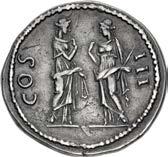
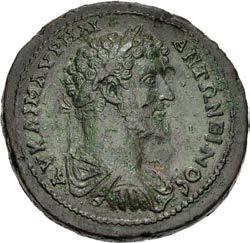
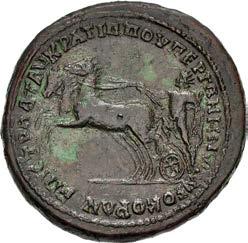

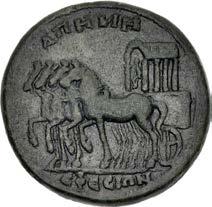
432.
Ex Triton XV (3 January 2012), lot 1387; Numismatica Ars Classica 59 (4 April 2011), lot 2004.
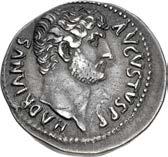
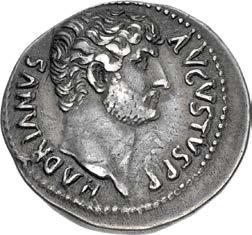
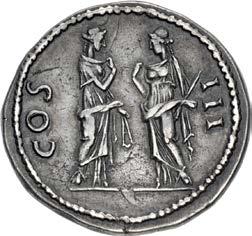
Hadrian. AD 117-138. AR Cistophorus (28mm, 10.98 g, 6h). Struck AD 128-138. Bare head right / Two Nemeses, draped, standing facing, vis-à-vis, each holding out fold of drapery; the left holds a bridle, the right a cubit rule. Metcalf, Cistophori, type 32, 143 (O21/R29 – this coin); RPC III 1361; RSC 326; SNG von Aulock 6627. Old cabinet toning, minor porosity and marks, slightly off center on obverse. Good VF. Hints of uncertain under type visible, partial legends faint in fields. ($1000)
Ex Peter Corcoran Collection; Pegasi Numismatics BBS 114 (13 July 1999), lot 174; Merzbacher (15 November 1910), lot 1633; Luigi Matteotti di Sassuolo Collection (Ratto, 5 November 1908), lot 910.
106 Illustrated in RPC Online
431. MYSIA, Pergamum. Marcus Aurelius.
IONIA, Ephesus. Antoninus
Ex Matteotti di Sassuolo Collection – Pedigreed to 1908
433. IONIA, Smyrna.
434. PISIDIA, Cremna. Valerian I. AD 253-260. Æ (33mm, 15.80 g, 6h). Laureate, draped, and cuirassed bust right / Augustus, as founder, plowing right with two oxen. von Aulock, Pisidiens 1518 (same dies); SNG BN –; SNG von Aulock 5115 (same dies). Golden brown surfaces, a few light scratches. EF. Very rare. ($500)
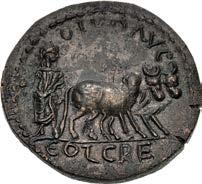
From the W. Toliver Besson Collection. Ex Classical Numismatic Group Electronic Auction 442 (17 April 2019), lot 750; Marian A. Sinton Collection (Triton III, 30 Nov. 1999), lot 777; Van der Dussen 24 (1 June 1995), lot 3217.
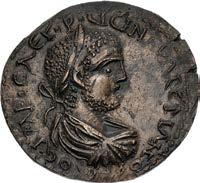
435. CILICIA, Augusta. Hadrian, with Aelius Caesar. AD 117-138. Æ (24mm, 11.54 g, 12h). Dated RY 117 (AD 136/7). Laureate head of Hadrian left / Bare head of Aelius right; ZIP (date) in legend. Karbach, Augusta 66; SNG BN –; RPC III 3321; SNG Levante –. Dark brown patina with light earthen highlights. Near EF. Extremely rare, only two known to RPC, this specimen finer than both. ($500)
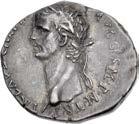
436. CILICIA, Seleucia ad Calycadnum. Julia Domna. Augusta, AD 193-217. AR Tridrachm (23mm, 8.65 g, 6h). IOVΛIA ΔOM-NA CЄBACTH, draped bust right / Tyche standing left, holding rudder in right hand and cornucopia in left. Prieur 740A; SNG BN 981 var. (obv. legend); SNG Levante 740 var. (same); SNG von Aulock 5828. Toned, minor porosity, edge roughness. VF. Extremely rare with this obverse legend, only one cited by Prieur, this coin one of two in CoinArchives. ($500)
437. CAPPADOCIA, Caesarea-Eusebia. Gaius (Caligula). AD 37-41. AR Drachm (18mm, 3.68 g, 12h). Bare head right / Simpulum and lituus. Ganschow, Münzen 39; RPC I 3624; Sydenham, Caesarea 48. A few light marks beneath attractive, grey tone, scratch on obverse, reverse slightly off center. Good VF. ($750)
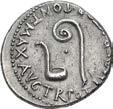
From the Quietus Collection. Ex Gorny & Mosch 249 (11 October 2017), lot 249.
438. CAPPADOCIA, Caesarea-Eusebia. Claudius. AD 41-54. AR Didrachm (22mm, 7.60 g, 12h). Struck circa AD 46-48. Laureate head left / Emperor in triumphal quadriga right, holding eagle-tipped scepter; [D]E BRITANNIS in exergue. Ganschow, Münzen 40; RPC I 3625; Sydenham, Caesarea 55. Old collection toning, small area of weakness on reverse. VF. ($750)
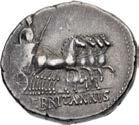
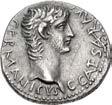
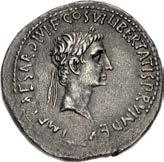
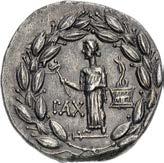
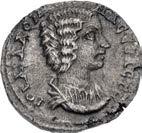

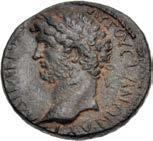
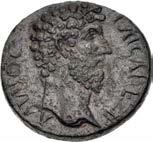
From the Libertas Collection.
439. ASIA MINOR, Uncertain. Augustus. 27 BC-AD 14. AR Cistophorus (27mm, 11.73 g, 1h). Ephesus mint(?). Struck 28 BC. Laureate head right / Pax standing left, holding caduceus; to right, serpent arising from cista mystica; all within laurel wreath. Sutherland Group I, 34 var. (O –/R34 [unlisted obv. die]); RPC I 2203 (Cistophoric mint); RSC 218. Lightly toned with hints of iridescence, minor porosity and cleaning marks. Good VF. ($750)
From the D.K. Collection.
107
435 436
437 438
Very Rare with Head Left
440. ASIA MINOR, Uncertain. Augustus. 27 BC-AD 14. AR Cistophorus (25mm, 11.45 g, 12h). Pergamum mint(?). Struck 27-26 BC. Bare head left; lituus to left / Six stalks of grain tied in a bundle. Sutherland Group IIIγ, – (O6/R– [unlisted rev. die]); RPC I 2206 (Cistophoric mint); RSC 32c. Light roughness and marks, flan flaw and slight die shift on reverse. VF. Very rare with head left, seven examples cited in RPC, six in CoinArchives. ($3000)
Ex Classical Numismatic Group 117 (20 May 2021), lot 483 (hammer $7000).
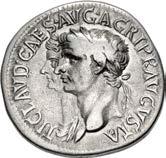
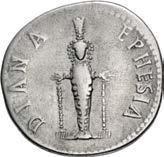
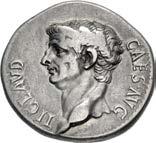
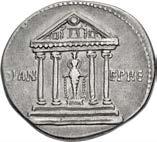
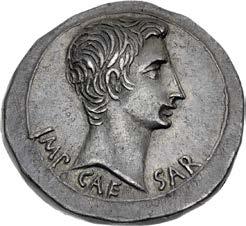
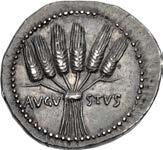
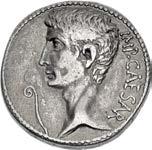
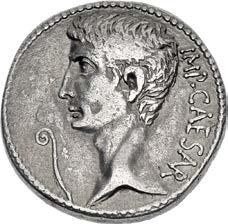

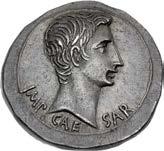
Choice Augustus Cistophorus
441. ASIA MINOR, Uncertain. Augustus. 27 BC-AD 14. AR Cistophorus (27mm, 11.95 g, 12h). Ephesus mint(?). Struck circa 25-20 BC. Bare head right / Six stalks of grain tied in a bundle. Sutherland Group VIβ, – (unlisted dies); RPC I 2214 (Cistophoric mint); RSC 32b. Lightly toned, minor die shift on obverse. Choice EF. Struck on a broad flan. ($5000)
Ex Father & Son Collection (Classical Numismatic Group 118, 13 September 2021), lot 968; Roma XVIII (29 September 2019), lot 749; Classical Numismatic Review XLIV.1 (Winter 2019), no. 497711; Numismatica Ars Classica 106 (9 May 2018), lot 539; ArtCoins Roma 8 (4 February 2014), lot 459; Schweizerische Kreditanstalt 1 (22 April 1983), lot 262.
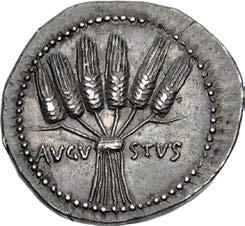
442. ASIA MINOR, Uncertain. Claudius. AD 41-54. AR Cistophorus (26mm, 11.27 g, 5h). Ephesus mint(?). Struck circa AD 41-42. Bare head left / Temple of Diana Ephesia: cult statue of Diana of Ephesus within tetrastyle temple, pediment decorated with figures flanking a central table with disk above, two tables and recumbent figures in angles. RPC I 2222 (Cistophoric mint); RSC 30. Light marks. VF. ($750)
443. ASIA MINOR, Uncertain. Claudius, with Agrippina Junior. AD 41-54. AR Cistophorus (27mm, 10.94 g, 7h). Ephesus mint(?). Group II, AD 51. Laureate head of Claudius and draped bust of Agrippina left, jugate / Cult statue of Diana (Artemis) Ephesia standing facing, wearing calathus, fillets hanging from wrists. RPC I 2224 (Cistophoric mint); RSC 1. Light porosity and marks. VF. ($1000)
108
442
443
Ex von Aulock & Platt Hall Collections
444. ASIA MINOR, Uncertain. Titus. AD 79-81. AR Cistophorus (27mm, 10.99 g, 6h). Rome mint. Struck AD 80-81. Laureate head right / Legionary aquila between two signa; signa on left surmounted by a hand, on right, by a banner. RPC II 861.4 = SNG von Aulock 6577 = Franke, Kleinasien 486 (this coin); RSC 398. Old cabinet toning, minor scratches, a couple of flan flaws. VF. ($750)
From the Libertas Collection. Ex Hans von Aulock Collection; Henry Platt Hall Collection (Part II, Glendining, 16 November 1950), lot 1216.
von Aulock Collection
445. ASIA MINOR, Uncertain. Hadrian. AD 117-138. AR Cistophorus (29mm, 10.93 g, 6h). Uncertain mint in Asia Minor. Struck after AD 128. Bare head right / Cult statue of Artemis Ephesia standing facing, extending hands and flanked by stags and thymiateria. Metcalf, Cistophori, type 88, 327 (O2/R2) = SNG von Aulock 6622 (this coin); RPC III 1437 (Cistophoric mint); RSC 319. Toned, green deposits, minor scratches from old cleaning. Good VF. Overstruck on another cistophorus of uncertain type. ($1500)
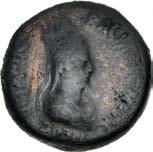
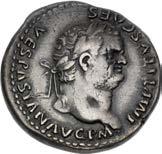
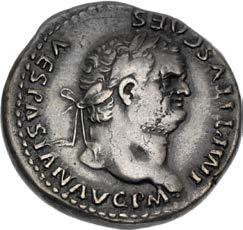
Ex Sierra Collection (Classical Numismatic Group 88, 14 September 2011), lot 1330; Triton VII (13 January 2004), lot 966; Leu 33 (3 May 1983), lot 54; Hans von Aulock Collection.
Rare Armenian 8 Chalkoi
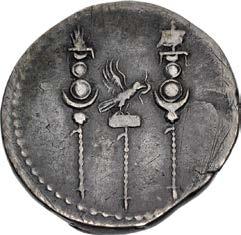
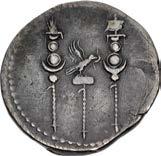
446. KINGS of ARMENIA. Tigranes IV, with Augustus. Second reign, circa 2 BC-AD 1. Æ 8 Chalkoi (26mm, 15.00 g, 1h). Artaxata mint. Diademed and draped bust of Tigranes right, wearing Armenian tiara / Bare head of Augustus left. Kovacs 178; CAA 167; AC 184; RPC I 3841 (Tigranes III or Tigranes V). Dark green-brown patina with some bare metal revealed, cleaning scratches. Fine. Rare. ($750)
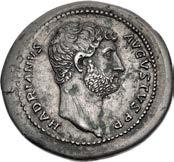
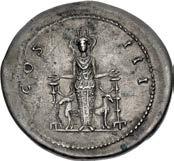
Situated between the two major powers of the day, Armenia could not remove itself from the frequent Romano–Persian conflicts. We are told that anti–Roman sentiment in Armenia was high during the reign of Tigranes IV, with the king supporting Parthia until he was eventually forced to ally with Rome to maintain his throne. His decision to do so must have proved unpopular in the kingdom, and it is possible that the battle in which Tigranes lost his life was an internal one aimed at quelling a rebellion.
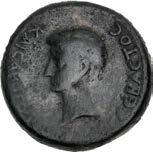
109
Ex
447. CYPRUS, Koinon of Cyprus. Diva Faustina Senior, with Galerius Antoninus. Died AD 140/1 and before AD 138, respectively. Æ As or Dupondius (30mm, 10.60 g, 12h). Dies likely produced in Rome. Struck AD 140/1. Veiled and draped bust of Diva Faustina right / Bareheaded and draped bust of Galerius Antoninus right. Overbeck, Galerius 9-16 (Vs:9/ Rs:1); Parks 22; RPC IV.3 Online 8345. Red-brown patina, roughness, heavily smoothed. VF. ($750)
From the Libertas Collection.
Marcus Galerius Aurelius Antoninus was the son of Antoninus Pius and Faustina Senior. He died in infancy or childhood, before Antoninus became emperor in AD 138; a sepulchral inscription for him is in the Mausoleum of Hadrian. This provincial issue is the only coin naming him.
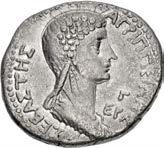
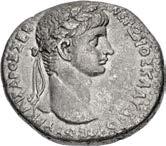
Of the sixteen specimens illustrated in RPC, half of the museum pieces are casts or outright forgeries, illustrating how difficult it was for the major museums to acquire authentic specimens for their permanent collections.
448. SELEUCIS and PIERIA, Antioch. Augustus. 27 BC-AD 14. AR Tetradrachm (26mm, 15.15 g, 12h). Dated year 28 of the Actian Era and Cos. XII (4/3 BC). Laureate head right / Tyche seated right on rocky outcropping, holding palm frond; below, half-length figure of river-god Orontes swimming right; in right field, monogram (=ΥΠΑTOY) and IB (consular date) above monogram (=ANTIOXIEΩN?). McAlee 182; RPC I 4153; Prieur 52; DCA 400. Minor porosity, small metal flaw on reverse. EF. ($1000)
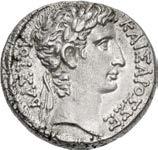
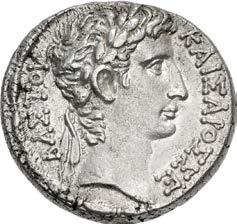
449. SELEUCIS and PIERIA, Antioch. Nero, with Agrippina Junior. AD 54-68. AR Tetradrachm (27mm, 14.33 g, 12h). Dated RY 3 and year 105 of the Caesarean Era (AD 56/7). Head of Nero right, wearing oak wreath / Draped bust of Agrippina Junior right; Γ EP (date) to right. McAlee 253; RPC I 4175; Prieur 74. Light porosity, areas of luster, lightly double struck on reverse. VF. ($500)
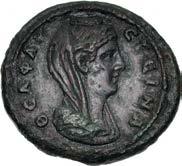

From the Andre Ronde Collection.
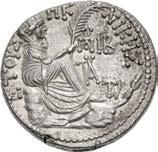
110
Excellent Portraits of Antony & Cleopatra
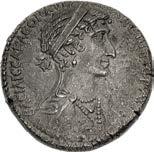
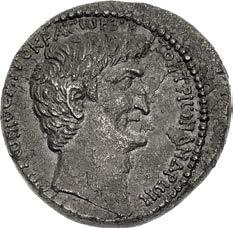
450. SELEUCIS and PIERIA, Antioch. Mark Antony & Cleopatra VII of Egypt. 36 BC. AR Tetradrachm (25.5mm, 14.90 g, 12h). Struck circa 36-34 BC. BACIΛICCA KΛЄOΠATPA ΘЄA NЄωTЄPA, diademed bust of Cleopatra right, wearing earring, necklace, and embroidered dress / ANTωNIOC AVTOKPATωP TPITON TPIωN ANΔPωN, bare head of Antony right. McAlee 174; RPC I 4094; Prieur 27; HGC 9, 1361. Toned, light porosity, small scrapes on reverse. Near EF. Two excellent portraits. ($20,000)

451. SELEUCIS and PIERIA, Antioch. Mark Antony & Cleopatra VII of Egypt. 36 BC. AR Tetradrachm (26mm, 13.28 g, 12h). Struck circa 36-34 BC. BACIΛICCA KΛЄOΠATPA ΘЄA NЄωTЄPA, diademed bust of Cleopatra right, wearing earring, necklace, and embroidered dress / ANTωNIOC AVTOKPATωP TPITON TPIωN ANΔPωN, bare head of
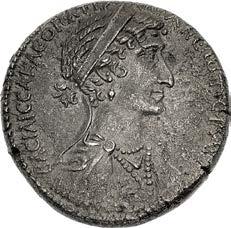
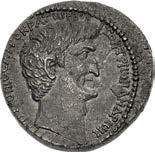
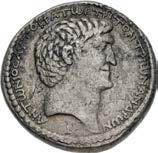
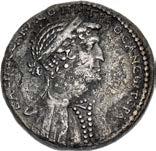
From the Libertas Collection, purchased 3 February 1981.
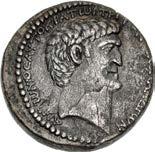
111
Antony right. McAlee 174; RPC I 4094; Prieur 27; HGC 9, 1361. Toned, areas of porosity, scratches on reverse. Near VF. Well centered with complete legends on both sides. ($7500)
452. SELEUCIS and PIERIA, Antioch. Mark Antony & Cleopatra VII of Egypt. 36 BC. AR Tetradrachm (26mm, 14.61 g, 12h). Struck circa 36-34 BC. BACIΛICCA KΛЄOΠATPA ΘЄA NЄωTЄPA, diademed bust of Cleopatra right, wearing earring, necklace, and embroidered dress / ANTωNIOC AVTOKPATωP TPI[TON TPIωN] ANΔPωN, bare head of Antony right. McAlee 174; RPC I 4094; Prieur 27; HGC 9, 1361. Toned, porosity, roughness, scratches. Near VF. ($7500)
453. SELEUCIS and PIERIA, Laodicea ad Mare. Caracalla. AD 198-217. AR Tetradrachm (27mm, 13.44 g, 1h). Struck AD 208-209. Laureate and draped bust right / Eagle standing facing, head and tail left, with wings displayed, holding wreath in beak; star between legs. Prieur & Amandry Group III, 41; McAlee, Severan –; Prieur 1156. Lightly toned, minor deposits on reverse. Choice EF. Very rare, only one known to Prieur, seven in CoinArchives. Excellent portrait. ($500)
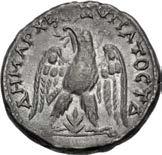
From the Andre Ronde Collection.
454. COELESYRIA, Chalcis ad Belum. Mark Antony and Cleopatra. 32-31 BC. Æ (20mm, 6.03 g, 1h). Dated RY 21 (Egyptian) and 6 (Phoenician) of Cleopatra (32/1 BC). Diademed and draped bust of Cleopatra right / Bare head of Antony right. Svoronos 1887; RPC I 4771; DCA 476; SNG München 1006; Sofaer 43. Green patina, flan preparation marks, minor porosity. Near VF. ($500)
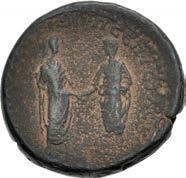
455. PHOENICIA, Dora. Septimius Severus. 193-211 AD. Æ (31mm, 22.77 g, 12h). Dated CY 265 (AD 202/3). Laureate, draped, and cuirassed bust right, seen from behind / Caracalla, on left, and Geta, on right, both togate, standing facing one another, clasping right hands; [ΔωPI ЄΞC] (date) in exergue. Meshorer, Dora 44 var. (rev. legend); Motta 8 var. (same); Rosenberger –; Sofaer 39 var. (same). Brown and red patina, porosity. Near VF. Very rare. ($750)
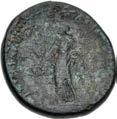
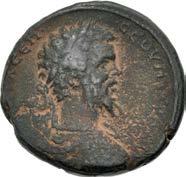
From the Kenneth S. Abramowitz Collection.
456. JUDAEA, Roman Administration. Agrippa I, with Caesonia and Drusilla. 37-43 CE. Æ (19.7mm, 6.29 g, 1h). Caesarea Panias mint. Dated RY 5 of Agrippa I (40/1 CE). Draped bust of Caesonia left / Drusilla standing facing, head left, holding Nike and palm frond; L E (date) to lower left. Meshorer 117; RPC I 4977; Hendin 6271; Sofaer 150. Dark green patina, light roughness, a few cleaning scratches. Good Fine. Rare. ($750)
Ex Classical Numismatic Group 120 (11 May 2022), lot 668 (hammer $2,250).
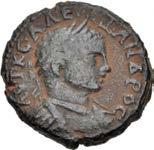
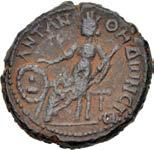
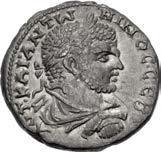
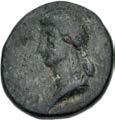

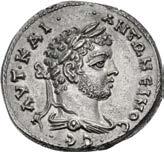
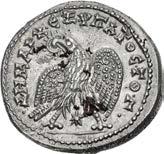
457. JUDAEA, Aelia Capitolina (Jerusalem). Caracalla. 198-217 CE. BI Tetradrachm (26.5mm, 11.92 g, 12h). Struck AD 215-217. Laureate, draped, and cuirassed bust right / Eagle standing facing on filleted thyrsus, head and tail left, with wings displayed, holding wreath in beak; vine leaf between legs. Meshorer, Aelia 95; Prieur 1617; Sofaer 82-3. Toned, small scrapes on obverse. VF. Rare. ($750)
458. JUDAEA, Anthedon. Severus Alexander. 222-235 CE. Æ (24mm, 10.93 g, 6h). Dated RY 9 (230/1 CE). Laureate and cuirassed bust right, seen from the front / Tyche seated left, resting hand on shield decorated with facing bust, and holding scepter; ЄT Θ (date) in legend. RPC VI Online 9159.2 (this coin); Rosenberger 7 var. (rev. legend); Sofaer 7. Dark brown patina with red earthen highlights. Near VF. Rare mint. ($750)
Ex Dr. Jay M. Galst Collection, purchased from Brian Kritt.
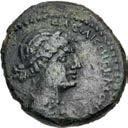
112
453 454 455 456 457 458
Prieur Plate Coin

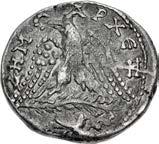

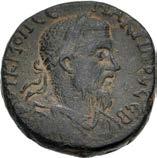

459. JUDAEA, Ascalon. Diadumenian. As Caesar, 217-218 CE. BI Tetradrachm (26mm, 12.78 g, 12h). Bareheaded, draped bust right, seen from the front / Eagle standing facing, head left, with wings displayed, holding wreath in beak, on palm branch; below, dove right, olive branch in its beak. Prieur 1656 (this coin). Toned, some roughness, die flaw on reverse. Near VF. Extremely rare, only this coin known to Prieur, one more in CoinArchives. ($750)
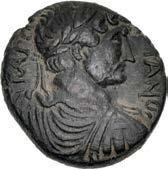
From the Andre Ronde Collection.
460. JUDAEA, Gaza. Hadrian. 117-138 CE. Æ (28mm, 15.35 g, 11h). Dually dated CY 193 and Epidemia 4 (132/3 CE). Laureate, draped, and cuirasssed bust right, seen from behind / Artemis, on left, standing right, drawing arrow from quiver at shoulder with right hand and holding bow with left, and Marnas, on right, standing left, holding short scepter with left hand and uncertain object in right; all within distyle temple; floral element in pediment; Δ EΠI ΓЧP (dates) in exergue. RPC III 4028.9 corr. (bust type; this coin); Rosenberger –; Sofaer 53. Dark brown patina with earthen highlights. Good VF. ($600)
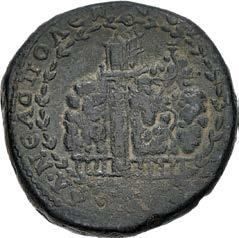
113
Ex Dr. Stephen Gerson Collection (Gemini VI, 10 January 2010), lot 711 (hammer $1100).
461. JUDAEA, Neapolis. Macrinus. 217-218 CE. Æ (26mm, 22.77 g, 12h). Laureate, draped, and cuirassed bust right, seen from the front / Mount Gerizim with two peaks; between, ravine with sloping roadway; left peak with temple in perspective, steep stairway with shrines attached; right peak with altar on top and trees at base; colonnade before. Rosenberger 32 var. (bust seen from behind); SNG ANS 993; Sofaer 83 var. (same). Dark brown patina with red earthen deposits. Good VF. Very rare. ($500)
From the Kenneth S. Abramowitz Collection.
462. JUDAEA, Nicopolis-Emmaus. Elagabalus. 218-222 CE. Æ (27mm, 17.22 g, 6h). Dated CY 2 (219/20 CE). Radiate, draped and cuirassed bust right, seen from behind / NEI/KOΠO/ΛIC in three lines within wreath with large central jewel; all supported by eagle standing facing, head and tail right, with wings spread; Є B (date) between legs. RPC VI Online 8999; Rosenberger 4; Sofaer 1; SNG ANS 1043 var. (placement of date). Brown surfaces, some porosity. Fine. Very rare. ($1000)
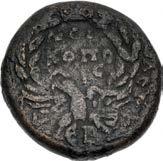


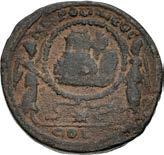
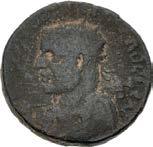
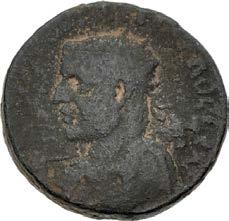

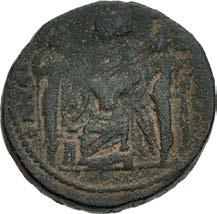
Ex Dr. Jay M. Galst Collection, purchased from Herb Kreindler, January 2004; Robert Schonwalter Collection.
463. JUDAEA, Neapolis. Philip I, with Philip II. 244-249 CE. Æ (26.5mm, 17.88 g, 1h). Jugate busts of Philip I and II right, both laureate, draped, and cuirassed busts right, seen from behind / Two Victories standing facing each other, holding wreath enclosing Mount Gerizim; below, star. Harl 43 (A9/P41); RPC VIII Online 2381; Rosenberger 90; Sofaer 171. Earthen brown patina, some roughness. Near VF. Very rare. ($500)
From the Kenneth S. Abramowitz Collection.
RPC Plate Coin – Unique Reverse for This City
464. JUDAEA, Neapolis. Trebonianus Gallus. 251-253 CE. Æ (24mm, 12.13 g, 12h). Radiate and cuirassed bust left, holding trophy over right shoulder, shield on left shoulder / The Capitoline Triad: Cult statues of Zeus seated on throne facing, holding long scepter, sacrificing from patera over low altar to his right; at left, Athena standing right, holding spear in right hand and shield in left, at right Hera, standing left, holding short scepter in left hand; above, Mount Gerizim. Harl – (type unlisted, but obv. die A30); RPC IX 2149A (this coin); Rosenberger –; Sofaer –. Brown patina with red earthen highlights, minor roughness. Near VF. Extremely rare. ($1000)
From the Kenneth S. Abramowitz Collection.
114
Ex Weber Collection
117-138.
23.64 g, 11h). Dated RY 12 (AD 127/8). AYT KAI TPAI AΔPIA CЄB, laureate, draped, and cuirassed bust right, seen from behind / Nilus reclining left on crocodile, holding reed and cornucopia from which emerges a Genius; Iς above, L ΔωΔЄK (date) in exergue. Köln 991; Dattari (Savio) 1806; K&G 32.461; RPC III 5717.93 = Weber 8336 (this coin); Emmett 1014.12. Brown and red patina with patches of green deposits. Good VF. ($750)
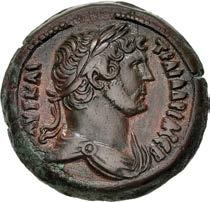
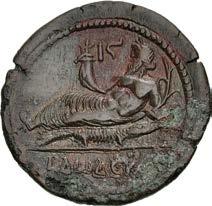
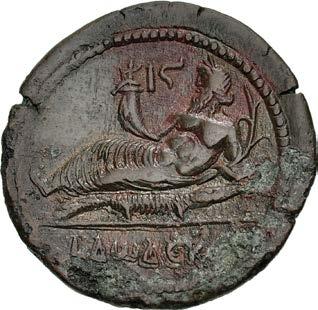
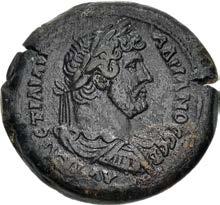
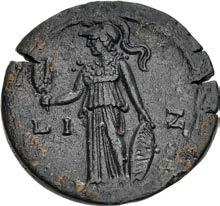
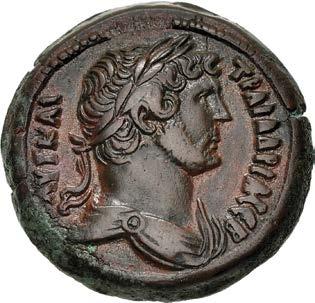
Ex Sir Hermann Weber Collection (†1918). Reportedly found in Luxor, 1894.
Ex Ebert and Platt Hall Collections – Pedigreed to 1897
From the W. Toliver Besson Collection. Ex Robert O. Ebert Collection (Stack’s, Bowers, and Ponterio 174, 12 January 2013), lot 5536; Gemini V (6 January 2009), lot 5354 (part of); Henry Platt Hall Collection (Part I, 19 July 1950), lot 347 (part of), purchased from Puttick, 16 December 1897, with his ticket.
115
465. EGYPT, Alexandria. Hadrian. AD
Æ Drachm (35mm,
466. EGYPT, Alexandria. Hadrian. AD 117-138. Æ Drachm (36mm, 24.34 g, 11h). Dated RY 17 (AD 132/3). Laureate, draped, and cuirassed bust right, seen from behind / Athena standing left, holding two grain ears in right hand, left hand on grounded shield; L I Z (date) across field. Köln 1068; Dattari (Savio) 1627-8; K&G 32.537; RPC III 5825; Emmett 924.17. Dark brown patina, light roughness, small edge splits. VF. ($500)
Herakles’ Second Labor
467. EGYPT, Alexandria. Antoninus Pius. AD 138-161. Æ Drachm (36mm, 29.35 g, 12h). Labors of Herakles series. Dated RY 10 (AD 146/7). Laureate head right / Herakles and the Lernaean Hydra - Herakles standing right, seen from the front, lion skin tied at his neck, holding club overhead with his right hand; before him; the anthropomorphized Lernaean Hydra holding her right arm-tentacle upward; L ∆ЄKATOV (date) in exergue. Köln –; Dattari (Savio) –; K&G –; RPC IV.4 Online 17159; Emmett 1545.10 (R5). Brown surfaces, smoothing, metal flaws, small flan crack, scrapes on reverse. Good Fine. Extremely rare, only one known to RPC, none in CoinArchives. ($750)
For his second labor, Herakles had to kill the Lernaean Hydra, the offspring of Typhon and Echidna, and the sibling of the Nemean Lion, the Chimaera, and Kerberos. Inhabiting the swamp near Lake Lerna in the Argolid, the creature possessed numerous mortal and one immortal head on its single body; should one head be removed, two more would grow in its place. When Herakles reached the swamp where the Hydra dwelt, he drew it out of its lair near the spring of Amymone. Thereupon, wielding a harvesting sickle, he attempted to decapitate the creature. When this proved unsuccessful, because of the Hydra’s regenerative ability, Herakles enlisted the assistance of his nephew Iolaos, who devised a plan: once Herakles had cut off one of the creature’s heads, Iolaos would cauterize the stump with a burning firebrand. The plan succeeded, and the Hydra was destroyed. Herakles placed its one immortal head under a large rock on the sacred way between Lerna and Elaius and dipped his arrows in its poisonous blood.
On this rare Alexandrian type, Hydra is anthropomorphized as a giantess, which has been interpreted in the past as “the giantess Echidna raising her son Hydra against Herakles in defense.” It remains a mystery as to why the engravers at the Alexandrian mint chose this noncanonical interpretation for the Lernaean Hydra, especially when other provincial mints that struck coins for the various labors used the more traditional representation.
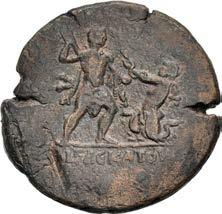
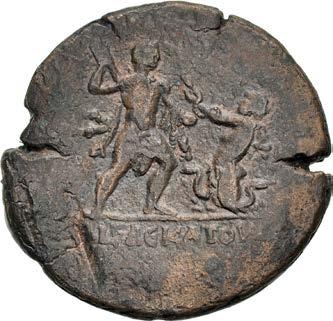
ROMAN REPUBLICAN COINAGE
468. Anonymous. Circa 280 BC. Æ Aes Grave As (69mm, 327.70 g, 12h). Rome mint. Beardless head of Janus; i (mark of value) above; all on a raised disk / Head of Mercury left, wearing winged petasus; i (mark of value) above; all on a raised disk. Crawford 14/1; ICC 25; HN Italy 268; RBW –. Light green-brown patina, minor casting pits on obverse. Fine. ($1000)
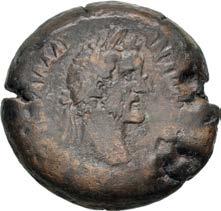
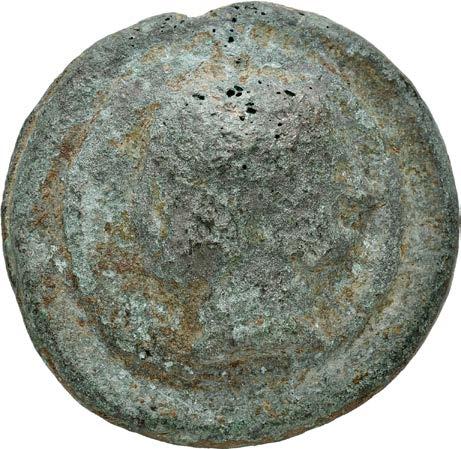
Ex Z.P. Collection (Roma E-Sale 97, 26 May 2022), lot 800.
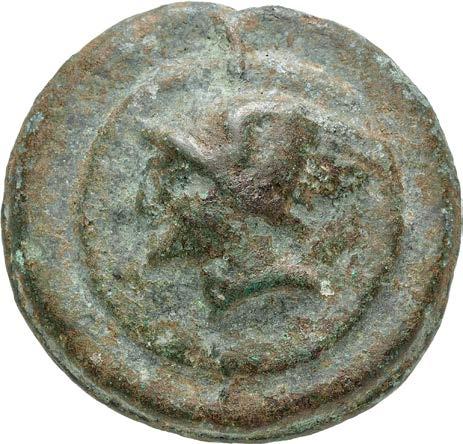
116
469. Anonymous. Circa 264-255 BC. AR Didrachm (20mm, 6.77 g, 6h). Rome mint. Diademed head of Hercules right, wearing lion skin headdress around neck; club on shoulder / She-wolf standing right, head left, suckling the twins (Romulus and Remus). Crawford 20/1; Sydenham 6; RSC 8; RBW 23. Deep iridescent toning, minor scrapes and scratches under tone. VF. ($1500)
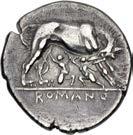
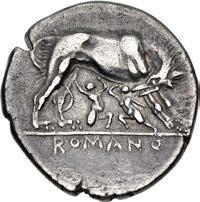
470. Anonymous. Circa 250-240 BC. AR Didrachm (17.5mm, 6.62 g, 6h). Neapolis(?) mint. Head of Roma (or Diana) right, wearing Phrygian helmet; wing to left / Victory standing right, attaching wreath to long palm frond; O to right. Crawford 22/1; Burnett, Romano, pl. I, 19; Sydenham 21; RSC 7; RBW –. Attractive deep and iridescent toning, a pair of minor delaminations. Good VF. ($2000)
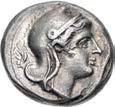
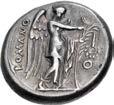
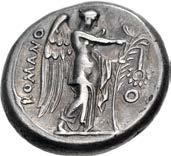
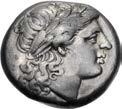

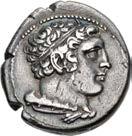
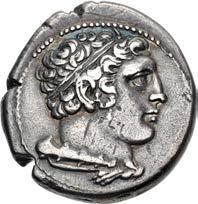
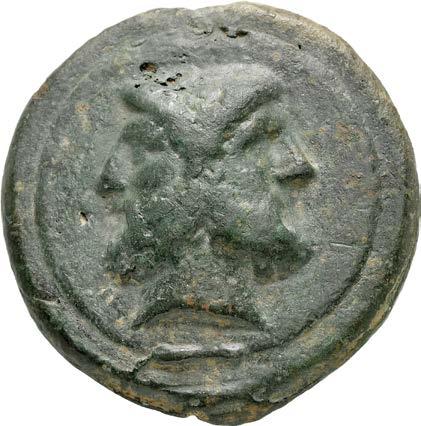
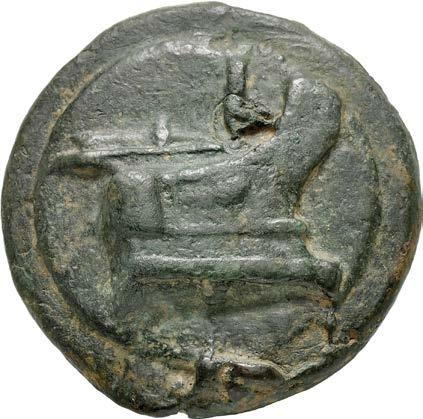
From the CJR Collection.
From the CJR Collection.
117
471. Anonymous. Circa 235 BC. AR Didrachm (19mm, 6.64 g, 3h). Rome mint. Laureate head of Apollo right / Horse rearing left. Crawford 26/1; Sydenham 27; RSC 37; RBW 47–8. Toned. VF. ($750)
472. Anonymous. Circa 225-217 BC. Æ Aes Grave As (63mm, 254.9 g, 12h). Rome mint. Head of bearded Janus; –(mark of value) below; all on a raised disk / Prow of galley right; i (mark of value) above; all on a raised disk. Crawford 35/1; ICC 74; Sydenham 71; HN Italy 337; RBW 83. Green patina, a few minor casting flaws. Near VF. ($1500)
Ex
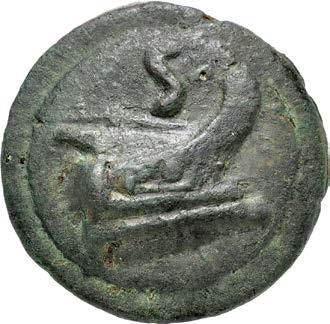
From
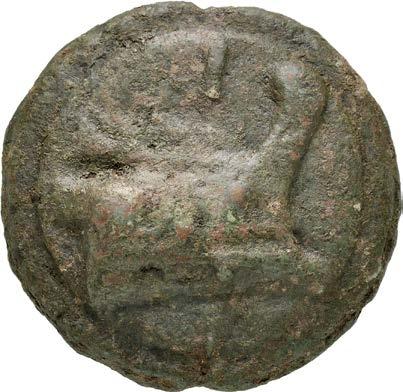
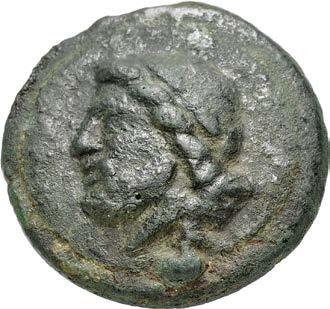
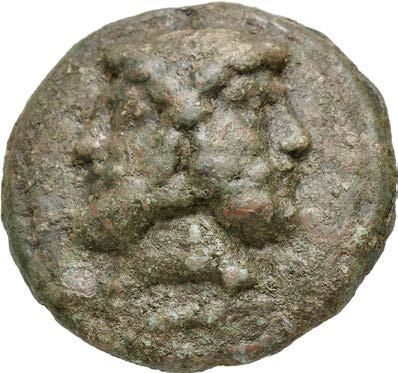
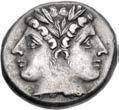
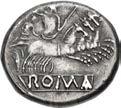
118
473. Anonymous. Circa 225-217 BC. Æ Aes Grave As (59mm, 273.00 g, 12h). Rome mint. Head of bearded Janus; –(mark of value) below; all on a raised disk / Prow of galley right; i (mark of value) above; all on a raised disk. Crawford 35/1; ICC 74; Sydenham 71; HN Italy 337; RBW 83. Green-brown and red patina, minor cleaning marks. Near VF. ($1500)
474. Anonymous. Circa 225-217 BC. Æ Aes Grave Semis (50mm, 122.30 g, 12h). Rome mint. Laureate head of Saturn left; Í (mark of value) horizontally below; all on raised disk / Prow of galley right; Í (mark of value) above; all on raised disk. Crawford 35/2; ICC 76; Sydenham 73; HN Italy 338; RBW 86. Dark green patina, a few tiny casting pits. VF. ($1000)
WN Collection (Classical Numismatic Group 106, 13 September 2017), lot 637; Status International 287 (24 May 2012), lot 5453.
475. Anonymous. Circa 225-212 BC. AR Didrachm – Quadrigatus (18mm, 6.33 g, 7h). Rome mint. Laureate head of Janus; straight truncation / Jupiter, hurling thunderbolt and holding scepter, in galloping quadriga driven right by Victory; in exergue, rOÂA in relief within a linear frame. Crawford 28/3; Sydenham 65; RSC 24; RBW 68. Toned, minor die rust on obverse, edge scrape under tone. Good VF. ($500)
the Weise Collection. Ex Triton VI (13 January 2003), lot 609.
476. Anonymous. Circa 225-212 BC. AR Didrachm – Quadrigatus (21.5mm, 6.48 g, 5h). Uncertain mint. Laureate head of Janus, with indented truncation / Jupiter, hurling thunderbolt with right hand and holding scepter in left, in galloping quadriga driven right by Victory, holding reins in both hands; in exergue, rOÂa in relief on solid tablet. Crawford 29/3; Sydenham 64d; HN Italy 334; RSC 23/24; BMCRR Romano-Campanian 105; Kestner 104; RBW 75–6. Lightly toned, minor flan crack, minor marks. EF. ($1500)
477. Anonymous. Circa 217-215 BC. Æ Semuncia (18.5mm, 4.30 g, 3h). Rome mint. Draped bust of Mercury right, wearing winged petasus / Prow of galley right. Crawford 38/7; Sydenham 87; RBW 100-2. Green-blue patina, flan crack. Near EF. ($500)
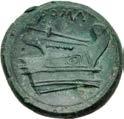

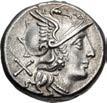
From the St. George Collection.
478. Anonymous. 211-208 BC. AV 60 Asses (14.5mm, 3.39 g, 11h). Rome mint. Helmeted head of Mars right; çc (mark of value) to left / Eagle standing right on thunderbolt, with wings spread. Crawford 44/2; Sydenham 226; Bahrfeldt 4a; Biaggi 3; RBW 160–1. Lightly toned with some luster, some light scratches. Near EF. ($5000)
Ex Heidelberger Münzhandlung 76 (14 May 2019), lot 109; The Bru Sale 2 (18 November 2010), lot 53; Ponterio 150 (8 August 2009), lot 8405.
479. Anonymous. 157-156 BC. AR Denarius (18mm, 3.86 g, 12h). Unmarked series. Rome mint. Helmeted head of Roma right; x (mark of value) to left / Victory, holding goad and reins, driving galloping biga right. Crawford 197/1a; Sydenham 376; RSC 6; RBW 846. Lightly toned with some iridescence. EF. ($500)
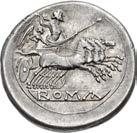
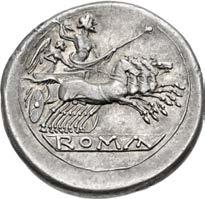
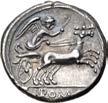
Ex Classical Numismatic Group 88 (14 September 2011), lot 1138.

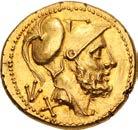

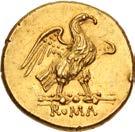
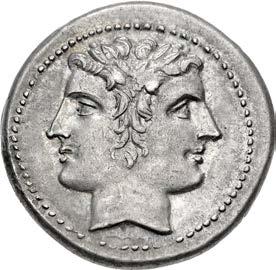
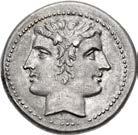
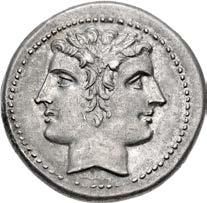
119
480. L. Cupiennius. 147 BC. AR Denarius (18.5mm, 4.17 g, 8h). Rome mint. Helmeted head of Roma right; cornucopia to left, x (mark of value) below chin / The Dioscuri, each holding spear, on horseback riding right; L • C(up) below horses, rOÂA in exergue. Crawford 218/1; Sydenham 404; Cupiennia 1; BMCRR Rome 850-5; Kestner 2070-1; RBW 937. Lightly toned with some luster under golden iridescence. EF. ($500)
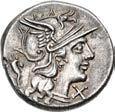
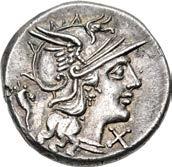
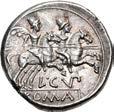
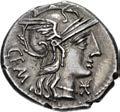
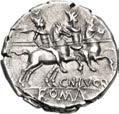
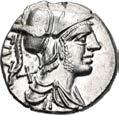
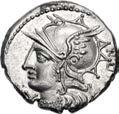
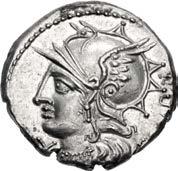
Ex Lanz 163 (7 December 2016), lot 170; Numismatica Ars Classica 8 (3 April 1995), lot 501.
481. Ti. Veturius. 137 BC. AR Denarius (19mm, 4.03 g, 1h). Rome mint. Helmeted and draped bust of Mars right; x (mark of value) to left / Oath-taking scene: youth kneeling left, head right, between two soldiers, each of whom holds a spear and sword that touches a pig held by the youth. Crawford 234/1; Sydenham 527; Veturia 1; RBW 969. Bright surfaces. EF. ($500)
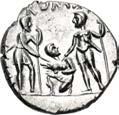
482. M. Baebius Q.f. Tampilus. 137 BC. AR Denarius (18.5mm, 3.97 g, 6h). Rome mint. Helmeted head of Roma left; x (mark of value) below chin / Apollo, holding bow, driving quadriga right. Crawford 236/1b; Sydenham 489; Baebia 12; RBW 976. Choice EF. Variety without arrow on bow. ($500)
483. Cn. Lucretius Trio. 136 BC. AR Denarius (18.5mm, 3.86 g, 7h). Rome mint. Helmeted head of Roma right; x (mark of value) below chin / The Dioscuri, each holding spear, on horseback riding right. Crawford 237/1a; Sydenham 450; Lucretia 1; RBW 978. Lightly toned, flan crack, some minor metal flaws and die breaks, trace die rust on obverse. EF. ($500)
Ex Numismatica Ars Classica 27 (12 May 2004), lot 218.
484. M. Aburius M.f. Geminus. 132 BC. AR Denarius (18.5mm, 3.97 g, 6h). Rome mint. Helmeted head of Roma right; • (mark of value) below chin / Sol, holding reins and whip, driving quadriga right. Crawford 250/1; Sydenham 487; Aburia 6; RBW 1027. Deep and iridescent toning, minor horn silver on obverse. EF. ($500)

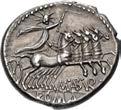
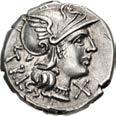
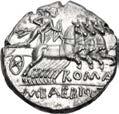
Ex Hagen Tronnier Collection (Künker 94, 27 September 2004), lot 1687.
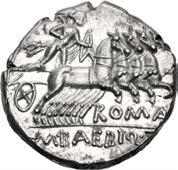
120
483 484
485. C. Caecilius Metellus Caprarius. 125 BC. AR Denarius (17mm, 3.88 g, 9h). Rome mint. Head of Roma right, wearing Phrygian helmet; • (mark of value) below chin / Jupiter, holding reins and thunderbolt, driving biga of elephants left; above, Victory flying right, holding wreath. Crawford 269/1; Sydenham 485; Caecilia 14; RBW 1085. Lightly toned, minor porosity on obverse, trace die rust on reverse. Near EF. An excellent reverse strike. ($500)

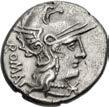
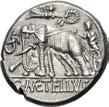
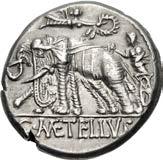
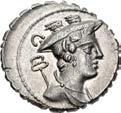
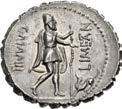
From the Quietus Collection. Ex Roma E-Live 1 (25 July 2018), lot 477.
486.
C. Mamilius Limetanus. 82 BC. AR Serrate Denarius (19mm, 4.00 g, 6h). Rome mint. Draped bust of Mercury right, wearing winged petasus; to left, C above caduceus / Ulysses walking right, holding staff and extending hand toward his dog, Argus. Crawford 362/1; Sydenham 741; Mamilia 6; RBW 1370 var. (control). Toned, slight porosity. Near EF. ($500)
From the Quietus Collection. Ex Dorotheum (22 May 2019), lot 841.
487 488
487. C. Annius T.f. T.n and L. Fabius L.f. Hispaniensis. 82-81 BC. AR Denarius (19mm, 3.88 g, 7h). Mint in northern Italy or Spain. Draped bust of Anna Perenna right, wearing stephane; winged caduceus to left, scales to right, • F • below / Victory, holding palm frond and reins, driving galloping quadriga right; œ • above. Crawford 366/1b; Sydenham 748a; Annia 2b; RBW 1376 var. (control). Attractively toned with golden hues around devices. Near EF. ($500)
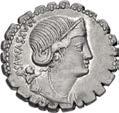
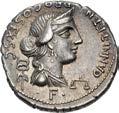
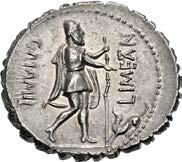
488. Cn. Egnatius Cn.f. Cn.n. Maxsumus. 76 BC. AR Serrate Denarius (18.5mm, 3.88 g, 4h). Rome mint. Diademed and draped bust of Venus right, Cupid on shoulder; uii below / Libertas, holding reins, in quadriga left; pileus to right, Victory flying right, holding wreath, above. Crawford 391/1b; Sydenham 786a; Egnatia 1; RBW 1427 var. (control). Lightly toned, reverse struck slightly off center, hairlines. VF. Very rare. ($500)
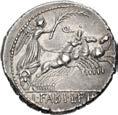
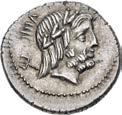
Ex Manhattan Sale I (5 January 2010), lot 148.
489. L. Lucretius Trio. 74 BC. AR Denarius (19mm, 3.87 g, 6h). Rome mint. Laureate head of Neptune right, trident over shoulder; uiii to upper left / Winged Genius riding dolphin right. Crawford 390/2; Sydenham 784; Lucretia 3; RBW 1425 var. (control). Toned, with some iridescence, minor delamination on obverse, some light scratches on reverse. EF. An attractive specimen in hand. ($500)

From the Libertas Collection, purchased 6 June 1985.
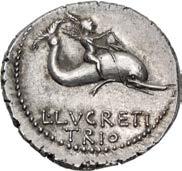
121
490. Lucius Axius L.f. Naso. 70 BC. AR Denarius (18.5mm, 3.88 g, 6h). Rome mint. Head of young beardless Mars right, wearing helmet ornamented with plumes; T to left / Diana, holding spear and reins, driving biga of stags right; two hounds following behind, additional hound below stags; T to left. Crawford 400/1a; Sydenham 794; Axia 1; RBW 1441 var. (control). A few small digs on reverse, hairlines. VF. Rare. ($750)
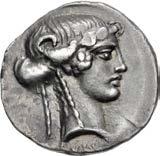
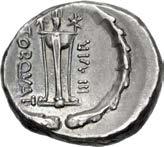
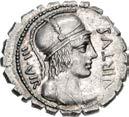
Ex Manhattan Sale I (5 January 2010), lot 149.
491. Mn. Aquillius Mn.f. Mn.n. 65 BC. AR Serrate Denarius (20mm, 4.06 g, 8h). Rome mint. Helmeted and draped bust of Virtus right / Mn. Aquillius standing right, holding shield and raising up kneeling figure of Sicily to left. Crawford 401/1; Sydenham 798; Aquillia 2; RBW 1443. Toned with some iridescence. EF. ($500)
492. C. Hosidius C.f. Geta. 64 BC. AR Denarius (18.5mm, 3.93 g, 6h). Rome mint. Diademed and draped bust of Diana right, with bow and quiver over shoulder / Calydonian Boar standing right, pierced by spear and harried by hound below. Crawford 407/2; Sydenham 903; Hosidia 1; RBW 1456. Attractively toned with golden hues around devices, scratch on obverse. Near EF. ($750)
Ex Numismatica Ars Classica 78 (26 May 2014), lot 656; Numismatica Ars Classica 40 (16 May 2007), lot 477.
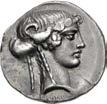



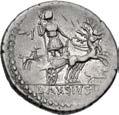
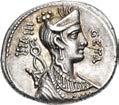
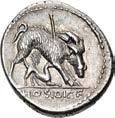
Ex Brand and Hofmarschall von Baldinger-Stuttgart (1911) Collections
493. L. Torquatus. 58 BC. AR Denarius (18mm, 3.98 g, 6h). Rome mint. Wreathed head of Sibyl right / Tripod surmounted by an amphora between two stars; all within torque. Crawford 411/1b; Sydenham 836; Manlia 12a; RBW 1490. Deeply toned with traces of iridescence and lustrous, off center on reverse. Good VF. ($1000)
Ex Numismatica Ars Classica 23 (19 March 2002), lot 1370; Virgil Brand Collection (Part V, Sotheby’s (2 February 1984), Lot 356; Hofmarschall von Baldinger-Stuttgart Collection (Cahn, 5 April 1911), lot 359.
122
490 491
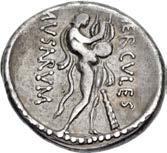
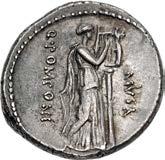

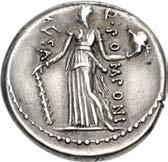
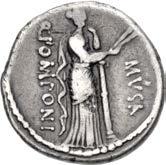
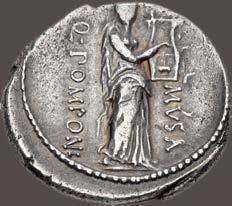
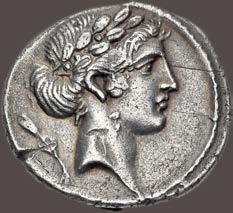
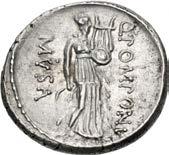
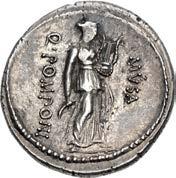
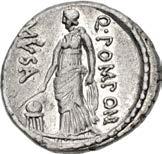
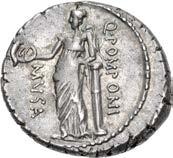
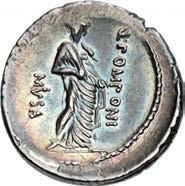 Lot 494
Hercules Musagetes Conductor of the Muses
Lot 495
Calliope Muse of Epic Poetry
Lot 496
Clio Muse of History
Lot 497
Melpomene Muse of Tragedy
Lot 498 Euterpe Muse of Music and Poetry
Lot 499 Erato Muse of Erotic Poetry
Lot 500
Terpsichore Muse of Dance
Lot 501
Terpsichore Muse of Dance
Lot 502 Urania Muse of Astronomy
Lot 503 Thalia Muse of Comedy
Lot 504 Polyhymnia Muse of Divine Hymns and Sacred Poetry
Lot 494
Hercules Musagetes Conductor of the Muses
Lot 495
Calliope Muse of Epic Poetry
Lot 496
Clio Muse of History
Lot 497
Melpomene Muse of Tragedy
Lot 498 Euterpe Muse of Music and Poetry
Lot 499 Erato Muse of Erotic Poetry
Lot 500
Terpsichore Muse of Dance
Lot 501
Terpsichore Muse of Dance
Lot 502 Urania Muse of Astronomy
Lot 503 Thalia Muse of Comedy
Lot 504 Polyhymnia Muse of Divine Hymns and Sacred Poetry
A Chorus of Muses
Coinage of Q. Pomponius Musa – The Hercules Musarum and the Muses
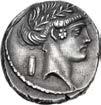
Although the moneyer Q. Pomponius Musa is unknown to history, his choice of Hercules Musarum and the nine Muses as coin types is remarkable and clearly connected to his cognomen.
The reverses of this series – Hercules playing the lyre and the Muses, can be none other than the celebrated statue group by an unknown Greek artist, taken from Ambracia and placed in the Aedes Herculis Musarum, which was erected by M. Fulvius Nobilior in 187 BC after the capture of Ambracia in 189 BC (Plin. NH xxxv.66; Ov. Fast. vi.812). By the second century BC Rome had overrun most of Greece and was captivated by Hellenic art and culture, not the least of which was its sculpture. Fulvius is said to have taken the statues to Rome because he learned in Greece that Hercules was a musagetes (leader of the Muses). Remains of this temple have been found in the area of the Circus Flaminius close to the south-west part of the circus itself, and north-west of the porticus Octaviae. An inscription found nearby, ‘M. Fulvius M. f. Ser. n. Nobilior cos. Ambracia cepit;’ may have been on the pedestal of one of the statues. The official name of the temple was Herculis Musarum aedes, which Servius and Plutarch called Herculis et Musarum aedes.
Hercules Musagetes – Conductor of the Muses
494. Q. Pomponius Musa. 56 BC. AR Denarius (17.5mm, 4.15 g, 6h). Rome mint. Diademed head of Apollo right / Hercules Musagetes, Conductor of the Muses, standing right, wearing lion skin and playing lyre; club to right. Crawford 410/1; Sydenham 810; Pomponia 8; RBW –. Deeply toned, some light scratches under tone. VF. ($500)
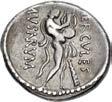
Ex Waddell E-Sale 44 (December 2001), lot 60.
Calliope – Muse of Epic Poetry
495. Q. Pomponius Musa. 56 BC. AR Denarius (16.5mm, 3.97 g, 5h). Rome mint. Laureate head of Apollo right; plectrum to left / Calliope, the Muse of Epic Poetry, standing right, playing lyre set on column. Crawford 410/2b; Sydenham 812; CNR Pomponia 15/4 (this coin); Pomponia 10; RBW –. Deeply toned. Near EF. ($1000)
Ex Eton College Collection (Sotheby’s, 1 December 1976), lot 247.
Clio – Muse of History
496. Q. Pomponius Musa. 56 BC. AR Denarius (15.5mm, 4.00 g, 9h). Rome mint. Laureate head of Apollo right; volumen to left / Clio, the Muse of History, standing left, holding and reading from an open scroll, resting left elbow on draped column. Crawford 410/3; Sydenham 813; Pomponia 11; RBW 1485. Deeply toned, flan flaw on obverse, minor die break on reverse. Near EF. ($1000)

Ex Waddell E-Sale 44 (December 2001), lot 61.
Melpomene – Muse of Tragedy
497. Q. Pomponius Musa. 56 BC. AR Denarius (17.5mm, 4.19 g, 8h). Rome mint. Laureate head of Apollo right; scepter to left / Melpomene, the Muse of Tragedy, standing right, wearing sword, holding club and tragic mask. Crawford 410/4; Sydenham 816; CNR Pomponia 24/6 (this coin); Pomponia 14; RBW 1486. Toned, tiny test cut at edge, trace horn silver, minor hairlines. Good VF. ($750)
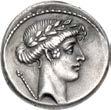
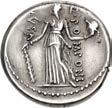
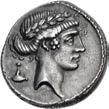
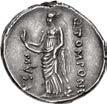
Ex Claude Collection (Triton VIII, 10 January 2005), lot 894; C. Bernardi Collection.
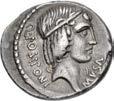
124
Euterpe – Muse of Music and Poetry
498. Q. Pomponius Musa. 56 BC. AR Denarius (17.5mm, 3.75 g, 5h). Rome mint. Laureate head of Apollo right; two crossed tibiae to left / Euterpe, the Muse of Music and Lyric Poetry, standing right, leaning head on hand and holding two tibiae. Crawford 410/5; Sydenham 815; Pomponia 13; RBW 1487. Deeply toned, minor marks mostly under tone. VF. ($500)
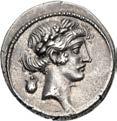

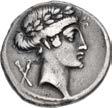
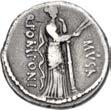
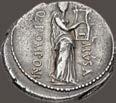
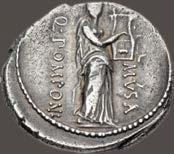
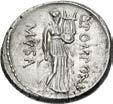
Ex Waddell E-Sale 55 (July 2002), lot 5.
Erato – Muse of Erotic Poetry
56
AR
(18mm, 3.84 g, 8h). Rome mint. Laureate head of Apollo right; flower on stem to left / Erato, the Muse of Erotic Poetry, standing slightly right, head facing, holding lyre and striking it with plectrum. Crawford 410/6; Sydenham 814; CNR Pomponia 21/6 (this coin); Pomponia 12; RBW –. Deeply toned with golden and iridescent highlights around devices, pair of scratches and some minor marks under tone, minor porosity. Good VF. Extremely rare. ($15,000)

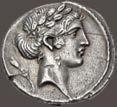
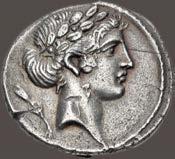
Ex Claude Collection (Triton VIII, 10 January 2005), lot 896; C. Bernardi

Terpsichore – Muse of Dance
Ex
From
125
499. Q. Pomponius Musa.
BC.
Denarius
Collection.
500. Q. Pomponius Musa. 56 BC. AR Denarius (17.5mm, 3.88 g, 9h). Rome mint. Laureate head of Apollo right; tortoise to left / Terpsichore, the Muse of Dance, standing right, holding plectrum and round-bottomed lyre. Crawford 410/7a; Sydenham 819a; Pomponia 18a; RBW –. Toned with some luster, light scratch on reverse. EF. ($1000)
Garth Drewry Collection (Triton VIII, 10 January 2005), lot 897; Gallerie des Monnaies 1 (25 June 1976), lot 763.
501. Q. Pomponius Musa. 56 BC. AR Denarius (18.5mm, 3.85 g, 6h). Rome mint. Laureate head of Apollo right; tortoise to left / Terpsichore, the Muse of Dance, standing right, holding plectrum and lyre. Crawford 410/7c; Sydenham 820; Pomponia 18; RBW –. Attractively toned and lustrous, trace horn silver, minor die break on obverse. Near EF. ($750)
the Libertas Collection, purchased 22 January 1986.
Urania – Muse of Astronomy
502. Q. Pomponius Musa. 56 BC. AR Denarius (16mm, 3.99 g, 5h). Rome mint. Laureate head of Apollo right; star of eight rays to left / Urania, the Muse of Astronomy, standing left, touching globe set on base with a wand. Crawford 410/8; Sydenham 823; Pomponia 22; RBW 1488. Lustrous, hairlines. Near EF. ($1000)
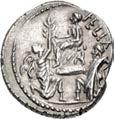
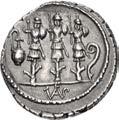
Thalia – Muse of Comedy
503. Q. Pomponius Musa. 56 BC. AR Denarius (16.5mm, 4.11 g, 3h). Rome mint. Laureate head of Apollo right; sandal to left / Thalia, the Muse of Comedy, standing left and leaning on column, holding persona (comic mask). Crawford 410/9b; Sydenham 821; Pomponia 19; RBW –. Attractively toned with some iridescence. Near EF. ($1000)
Ex Triton VII (12 January 2004), lot 827.
Polyhymnia – Muse of Divine Hymns and Sacred Poetry
504. Q. Pomponius Musa. 56 BC. AR Denarius (20mm, 3.88 g, 9h). Rome mint. Laureate head of Apollo right; wreath tied with fillet to left / Polyhymnia, the Muse of Divine Hymns and Sacred Poetry, standing facing, her head bound with wreath. Crawford 410/10a; Sydenham 817; CNR Pomponia 28/5 (this coin); Pomponia 15; RBW –. Vibrant deep and iridescent toning, lustrous, minor horn silver. Near EF. ($1000)
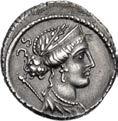
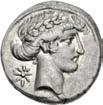
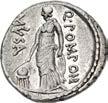
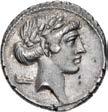

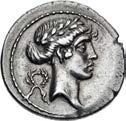
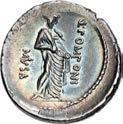
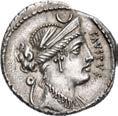
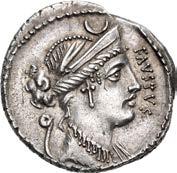
Ex Gemini II (11 January 2006), lot 253; Knobloch Collection (Stack’s 3 May 1978), lot 472; Leu 17 (3 May 1977), lot 565.
505. Faustus Cornelius Sulla. 56 BC. AR Denarius (18mm, 3.97 g, 8h). Rome mint. Diademed and draped bust of Diana right; crescent above, lituus to left / Sulla seated left on raised seat; to left, Bocchus, king of Mauretania, kneels, offering an olive branch; to right, Jugurtha, king of Numidia, also kneeling, his hands tied behind him. Crawford 426/1; Sydenham 879; Cornelia 59; RBW 1525. Old collection toning with some iridescence, hairlines, light scratch on obverse, reverse slightly off center. EF. ($2000)
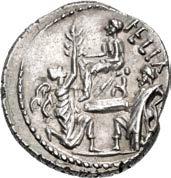
506. Faustus Cornelius Sulla. 56 BC. AR Denarius (18.5mm, 3.82 g, 12h). Rome mint. Laureate, diademed, and draped bust of Venus right; scepter to left / Three military trophies; capis to left, lituus to right. Crawford 426/3; Sydenham 884; Cornelia 63; RBW 1528. Attractive deep toning, trace lacquer deposits, slightly off center. Near EF. ($750)
From the Libertas Collection. Ex Clarence S. Bement Collection (Naville VIII, 25 June 1924), lot 141.
126
507. Q. Cassius Longinus. 55 BC. AR Denarius (19mm, 4.26 g, 6h). Rome mint. Young male head of Bonus Eventus (or Genius Populi Romani?) right; scepter to left / Eagle with wings spread standing right on winged thunderbolt; lituus to left, capis to right. Crawford 428/3; Sydenham 916; Cassia 7; RBW 1535. Striking vibrant iridescent toning over lustrous surfaces. Near EF. ($500)
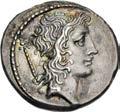
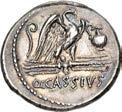
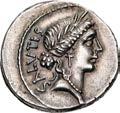
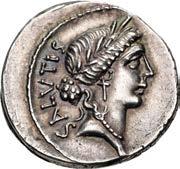
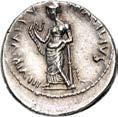
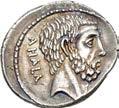
Ex Gadoury (15 November 2019), lot 302.
508. Q. Servilius Caepio (M. Junius) Brutus. 54 BC. AR Denarius (18.5mm, 4.01 g, 6h). Rome mint. Bare head of L. Junius Brutus right / Bare head of C. Servilius Ahala right. Crawford 433/2; Sydenham 907; Junia 30; RBW 1543. Iridescent toning, minor flan flaw on reverse. Good VF. ($750)
509. Q. Servilius Caepio (M. Junius) Brutus. 54 BC. AR Denarius (18mm, 3.80 g, 3h). Rome mint. Bare head of L. Junius Brutus right / Bare head of C. Servilius Ahala right. Crawford 433/2; Sydenham 907; Junia 30; RBW 1543. Deep and iridescent toning. VF. ($500)
From the Libertas Collection.
510. Q. Pompeius Rufus. 54 BC. AR Denarius (17mm, 3.89 g, 12h). Rome mint. Bare head of the consul Q. Pompeius Rufus right / Bare head of Sulla right. Crawford 434/1; Sydenham 908; Pompeia 4; RBW 1544. Porosity, scratches on reverse. VF. ($500)
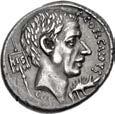
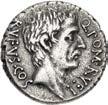
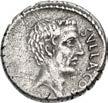
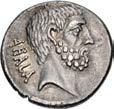
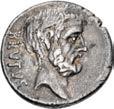
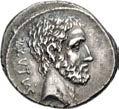
From the GTP Collection. Ex Gorny & Mosch 216 (15 October 2013), lot 3776 (hammer €1,000).
Ex Niggeler Collection
511. C. Coelius Caldus. 53 BC. AR Denarius (18.5mm, 4.00 g, 12h). Rome mint. Bare head of the consul C. Coelius Caldus right; signum inscribed hiÍ to left, boar atop signum below chin / Veiled figure seated left on inscribed lectisternium; trophies flanking. Crawford 437/2a; Sydenham 894; CNR Coelia 8/1 (this coin); Coelia 7; RBW 1551. Deeply toned, minor die rust, a few light scratches under tone. Good VF. ($1000)

From the Weise Collection. Ex Classical Numismatic Group 55 (13 September 2000); Münzen und Medaillen AG 61 (7 October 1982), lot 307; Walter Niggeler Collection (Part 2, Münzen und Medaillen AG & Bank Leu, 21 October 1966), lot 872.
512. Moneyer issues of Imperatorial Rome. Man. Acilius Glabrio. 49 BC. AR Denarius (19mm, 3.78 g, 9h). Rome mint. Laureate head of Salus right / Valetudo (Salus) standing left, holding serpent in right hand and resting left arm on column to right. Crawford 442/1a; CRI 16; Sydenham 922; Acilia 8; RBW 1556. Iridescent toning and lustrous, slightly off center. EF. ($500)
Ex Peus 431 (27 April 2022), lot 3391; Künker 52 (29 September 1999), lot 3234; Numismatica Ars Classica I (19 May 1999), lot 1524.
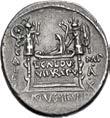
127
509 510 511
Pedigreed to 1913
513. Moneyer issues of Imperatorial Rome. Mn. Cordius Rufus. 46 BC. AR Sestertius (10.5mm, 0.84 g, 6h). Rome mint. Diademed head of Venus right / Cupid advancing right, holding wreath and palm frond. Crawford 463/5a; CRI 67; Sydenham 980a; CNR Cordia 20/2 (this coin); Cordia 7; RBW –. Old collection toning, find patina, marks under tone. VF. Very rare. ($1000)
Ex Dupriez 112 (7 April 1913), lot 377.
514. Moneyer issues of Imperatorial Rome. L. Livineius Regulus. 42 BC. AR Denarius (17mm, 4.02 g, 3h). Rome mint. Bare head right / Venatio scene: in foreground, lion charging right toward a bestiarius who spears it; in background on left, a wounded bear sits right; on right, another bestiarius, holding sword and shield, defends himself against a tiger charging left. Crawford 494/30; CRI 179; Sydenham 1112; Livineia 12; RBW 1735. Toned with some light iridescence, a couple minor areas of weakness at peripheries, minor scratches. Near EF. ($500)
From the St. George Collection, purchased from A.H. Baldwin & Sons.
515. The Pompeians. Q. Caecilius Metellus Pius Scipio. 47- Spring 46 BC. AR Denarius (17mm, 4.12 g, 6h). Military mint traveling with Scipio in Africa. Laureate head of Jupiter right / African elephant walking right. Crawford 459/1; CRI 45; Sydenham 1046; Caecilia 47; RBW 1601. Lightly toned. Near EF. ($500)
From the Quietus Collection. Ex Roma XIV (21 September 2017), lot 537.
516. The Caesarians. Julius Caesar. April-August 49 BC. AR Denarius (18mm, 4.00 g, 8h). Military mint traveling with Caesar. Elephant advancing right, trampling on horned serpent / Emblems of the pontificate: simpulum, aspergillum, securis, and apex. Crawford 443/1; CRI 9; Sydenham 1006; RSC 49; RBW 1557. Lightly toned. EF. ($1500)
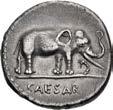
Ex Spink 228 (25 March 2015), lot 106; Classical Numismatic Group XXXII (7 December 1994), lot 340.
517 514 515
517. The Caesarians. Julius Caesar. April-August 49 BC. AR Denarius (19.5mm, 3.66 g, 2h). Military mint traveling with Caesar. Elephant advancing right, trampling on horned serpent / Emblems of the pontificate: simpulum, aspergillum, securis, and apex. Crawford 443/1; CRI 9; Sydenham 1006; RSC 49; RBW 1557. Lightly toned, obverse struck slightly off center, minor area of weakness on reverse. EF. ($1000)
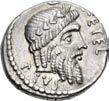

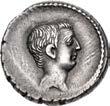



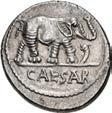
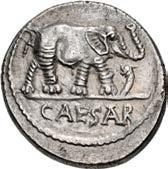
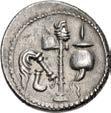

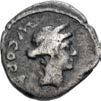
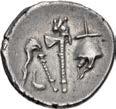

Ex CNG inventory 757842 (August 2005).
518. The Caesarians. Julius Caesar. April-August 49 BC. AR Denarius (17.5mm, 3.58 g, 5h). Military mint traveling with Caesar. Elephant advancing right, trampling on horned serpent / Emblems of the pontificate: simpulum, aspergillum, securis, and apex. Crawford 443/1; CRI 9; Sydenham 1006; RSC 49; RBW 1557. Toned. Good VF. ($750)
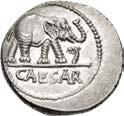
128
Ex Numismatic Ars Classica 92 (Part 2, 24 May 2016), lot 1688. 518
519. The Caesarians. Julius Caesar. April-August 49 BC. AR Denarius (19mm, 3.97 g, 5h). Military mint traveling with Caesar. Elephant advancing right, trampling on horned serpent / Emblems of the pontificate: simpulum, aspergillum, securis, and apex. Crawford 443/1; CRI 9; Sydenham 1006; RSC 49; RBW 1557. Toned, struck slightly off center. Good VF. ($750)
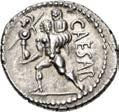
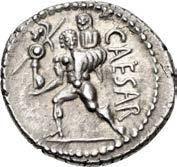
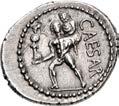
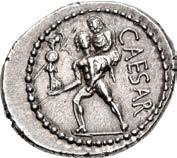
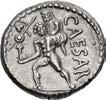
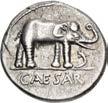
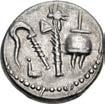
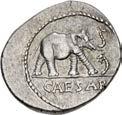
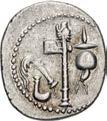
520. The Caesarians. Julius Caesar. April-August 49 BC. AR Denarius (17mm, 4.08 g, 7h). Military mint traveling with Caesar. Elephant advancing right, trampling on horned serpent / Emblems of the pontificate: simpulum, aspergillum, securis, and apex. Crawford 443/1; CRI 9; Sydenham 1006; RSC 49; RBW 1557. Toned, a few minor die breaks and minor scrape on reverse. Good VF. ($750)
521. The Caesarians. Julius Caesar. Late spring-early summer 48 BC. AR Denarius (17.5mm, 3.88 g, 8h). Military mint traveling with Caesar. Diademed female head (Clementia?) right, wearing oak wreath; %ii (= 52, Caesar’s age) to left / Gallic trophy, holding oval shield and carnyx surmonted by wolf’s head; securis to right. Crawford 452/2; CRI 11; Sydenham 1009; RSC 18; DCA 937; RBW –. Deeply toned with some iridescence. Good VF. ($750)
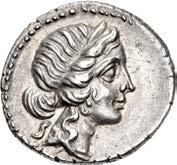
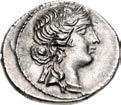
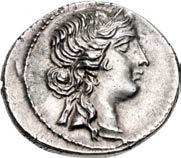

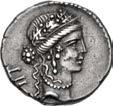
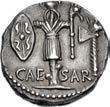
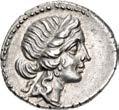
522. The Caesarians. Julius Caesar. Late 48-47 BC. AR Denarius (18.5mm, 3.87 g, 6h). Military mint traveling with Caesar in North Africa. Diademed head of Venus right / Aeneas advancing left, holding palladium and bearing Anchises on his shoulder. Crawford 458/1; CRI 55; Sydenham 1013; RSC 12; RBW 1600. Light golden toning with some luster. EF. ($1500)
Julius Caesar traced his descent to the Trojan hero Aeneas. According to legend, Aeneas was the result of a liaison between the goddess Venus and Anchises, a herdsman who was related to the Trojan royal family. In a scene recounted in Virgil’s Aeneid, as the Mycenaean confederation torched Troy, Aeneas escaped the burning city carrying his aged father Anchises on his shoulder and the sacred Palladium, the cult statue of Pallas Athena saved from the household shrine. This scene is depicted on the reverse of this denarius of Caesar, struck in 48-47 BC, at least two decades before the Aeneid was composed. Venus, the mother of Aeneas (and thus the divine progenitor of Caesar) appears on the obverse.
Ex Gorny & Mosch 224 (13 October 2014), lot 403.
129
523. The Caesarians. Julius Caesar. Late 48-47 BC. AR Denarius (19mm, 3.87 g, 6h). Military mint traveling with Caesar in North Africa. Diademed head of Venus right / Aeneas advancing left, holding palladium and bearing Anchises on his shoulder. Crawford 458/1; CRI 55; Sydenham 1013; RSC 12; RBW 1600. Light iridescent tone. EF. ($1500)
524. The Caesarians. Julius Caesar. Late 48-47 BC. AR Denarius (16.5 mm, 3.82 g, 6h). Military mint traveling with Caesar in North Africa. Diademed head of Venus right / Aeneas advancing left, holding palladium and bearing Anchises on his shoulder. Crawford 458/1; CRI 55; Sydenham 1013; RSC 12; RBW 1600. Minor porosity. Near EF. ($750)
519 520 521
Finest Obverse Die in the Series
525. The Caesarians. Julius Caesar. Early 46 BC. AV Aureus (19mm, 8.01 g, 6h). Rome mint; A. Hirtius, praetor. Veiled head of female (Vesta or Pietas?) right; C • CAeÍAr COÍ Ter around / Emblems of the augurate and pontificate: lituus, capis, and securis; A • hirTiuÍ • pr around from lower left. Crawford 466/1; Molinari 17-28 (D1/R208); CRI 56; Sydenham 1018; Calicó 37; Biaggi –; RBW 1634. Lightly toned, minor deposits. Good VF. Struck from the finest style obverse die in the series. ($5000)
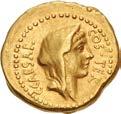
526. The Caesarians. Julius Caesar. Early 46 BC. AV Aureus (20mm, 7.94 g, 8h). Rome mint; A. Hirtius, praetor. Veiled head of female (Vesta or Pietas?) right; C • CAeÍAr COÍ Ter around / Emblems of the augurate and pontificate: lituus, capis, and securis; A • hirTiuÍ • pr around from lower left. Crawford 466/1; Molinari 536-7 (D111/R322); CRI 56; Sydenham 1018; Calicó 37; Biaggi –; RBW 1634. Minor deposits on obverse, banker’s mark on reverse. Good VF. ($5000)
527. The Caesarians. Julius Caesar. January-April 46 BC. AR Denarius (18mm, 3.82 g, 2h). Uncertain mint, possibly Utica. Head of Ceres right, wearing wreath of grain / Emblems of the augurate and pontificate: simpulum, aspergillum, guttus, and lituus; Â (munus = gift) to right. Crawford 467/1b; CRI 57a; Sydenham 1024; RSC 4; RBW 1638. Lightly toned with some iridescence, a few light scratches under tone on reverse. Near EF. ($750)
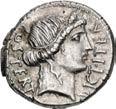
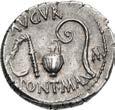
Ex Lanz 163 (7 December 2016), lot 243.
528. The Caesarians. Julius Caesar. Late 46-early 45 BC. AR Denarius (20mm, 3.89 g, 12h). Military mint traveling with Caesar in Spain. Diademed head of Venus right, with Cupid over her shoulder / Trophy of Gallic arms, composed of helmet and cuirass, oval shield and carnyx in each hand; two seated captives at base, the one on left a female in attitude of dejection, the one on right a bearded male with hands bound behind him. Crawford 468/1; CRI 58; Sydenham 1014; RSC 13; RBW 1639. Lightly toned with some luster, reverse struck slightly off center. Near EF. ($500)
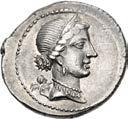

Ex Numismatica Ars Classica 92 (23 May 2016), lot 1896.
529. The Caesarians. Julius Caesar. Late 46-early 45 BC. AV Aureus (21mm, 7.90 g, 6h). Rome mint; L. Munatius Plancus, praefectus Urbi. Draped and winged bust of Victory right, hair rolled back and collected into a knot behind; C • CAeÍ upward to left, DiC • Ter downward to right / Guttus (single-handled sacrificial jug); L • pLANC upward to left, prAeF • œB downward to right. Crawford 475/1a; CRI 60; Sydenham 1019; Bahrfeldt 20; Calicó 45; RBW 1663. Minor scrape on reverse. VF. ($5000)
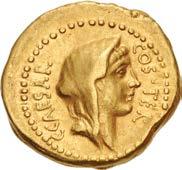
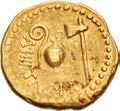
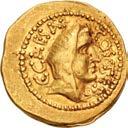
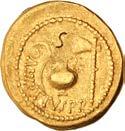
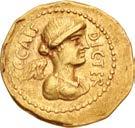
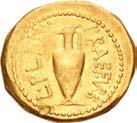
130
527
528
530. The Caesarians. Julius Caesar. Late 46-early 45 BC. Æ Dupondius (26mm, 14.13 g, 12h). Rome mint; C. Clovius, prefect. Winged and draped bust of Victory right; star to left / Minerva advancing left, holding trophy, spear, and shield decorated with gorgoneion; at feet to left, snake gliding left with head erect. Crawford 476/1b; CRI 62a; Sydenham 1026; RBW 1668; RPC I 601. Brown-green patina. Good VF. ($1000)
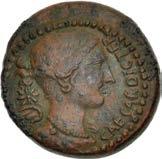
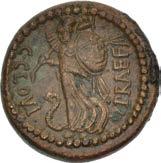
Ex Collection of an Archaeologist (Künker 347, 22 March 2021), lot 363, purchased from Kobe von Koppenfels, October 1986.
531. The Caesarians. Julius Caesar. January-February 44 BC. AR Denarius (18.5mm, 3.99 g, 9h). Lifetime issue. Rome mint; P. Sepullius Macer, moneyer. Laureate head right; star of eight rays to left / Venus Victrix standing left, holding Victory and scepter resting on star. Crawford 480/5b; Alföldi Type V, 1-8 (A1/R1); CRI 106a; Sydenham 1071; RSC 41; RBW 1679. Toned with some luster, reverse struck slightly off center. Good VF. ($2000)

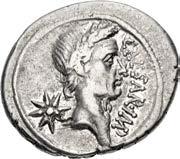
532. The Caesarians. Julius Caesar. February-March 44 BC. AR Denarius (17mm, 3.74 g, 3h). Lifetime issue. Rome mint. L. Aemilius Buca, moneyer. Laureate head right / Venus Victrix seated right, holding Victory and transverse scepter. Crawford 480/7b; Alföldi Type XV, 33-4 and 36-8 (A7/R10); CRI 104a; Sydenham 1062; RSC 24; RBW 1682. Toned, struck slightly off center, pair of minor scrapes under tone on obverse, minor weakness and die rust on reverse. VF. ($2000)
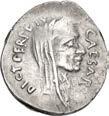
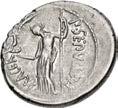
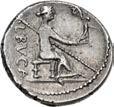
From the Libertas Collection.
533. The Caesarians. Julius Caesar. February-March 44 BC. AR Denarius (17mm, 3.28 g, 9h). Lifetime issue. Rome mint; P. Sepullius Macer, moneyer. Laureate and veiled head right / Venus Victrix standing left, holding Victory and scepter; shield set on ground to right. Crawford 480/13; Alföldi Type IX, 126–7 (A38/R51=R52); CRI 107d; Sydenham 1074; RSC 39; RBW 1685. Lightly toned, irregular flan, some usual weakness, minor flan flaw on obverse. VF. ($1500) Ex Pegasi XV (24 October 2006), lot 368; New York Sale XI (11 January 2006), lot 240.
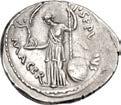
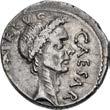
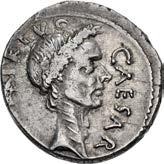
131
534. The Caesarians. Julius Caesar. February-March 44 BC. AR Denarius (18.5mm, 3.64 g, 8h). Lifetime issue. Rome mint; P. Sepullius Macer, moneyer. Laureate and veiled head right / Venus Victrix standing left, holding Victory and scepter; shield set on ground to right. Crawford 480/13; Alföldi Type IX, 173-5 (A54/R26); CRI 107d; Sydenham 1074; RSC 39; RBW 1685. Lightly toned, minor scratches mostly under tone, minor test cut on edge, banker’s mark on obverse. Near VF. ($1500)
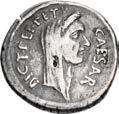

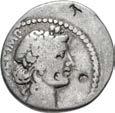

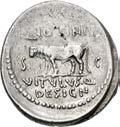
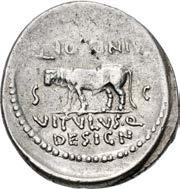
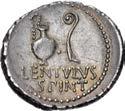
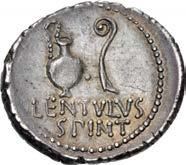
535. The Caesarians. Divus Julius Caesar. 40 BC. AR Denarius (19mm, 3.71 g, 6h). Rome mint; Q. Voconius Vitulus, moneyer. Laureate head right / Bull-calf walking left. Crawford 526/4; CRI 331; Sydenham 1133; RSC 45; RBW 1813. Lightly toned, areas of soft strike, minor porosity on reverse, slightly off center. Near EF. ($2000)
536. The Republicans. C. Cassius Longinus. Spring 42 BC. AR Denarius (19.5mm, 3.85 g, 6h). Military mint, probably at Smyrna; P. Cornelius Lentulus Spinther, legatus. Veiled, diademed, and draped bust of Libertas right / Capis and lituus. Crawford 500/5; CRI 223; Sydenham 1305; RSC 6; RBW 1764. Attractive deep and iridescent toning. Near EF. ($750)
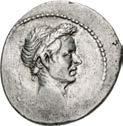
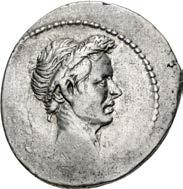
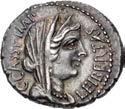
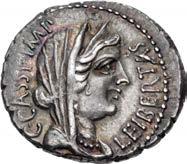
537. The Republicans. C. Cassius Longinus. Summer 42 BC. AR Denarius (18mm, 3.44 g, 6h). Military mint traveling with Brutus and Cassius, probably at Sardis; M. Servilius, legatus. Laureate head of Libertas right / Crab, holding apluster in its claws; open diadem and rose below. Crawford 505/3; CRI 226; Sydenham 1313; RSC 10; RBW 1774. Toned, struck slightly off center, bankers’ marks, trace deposits. Good Fine. Very rare. ($1500)
Ex Peter Erikson Collection; Cederlind 141 (19 December 2006), lot 192; Gorny & Mosch 147 (7 March 2006), lot 1937.
132
Superb Brutus Denarius
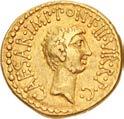
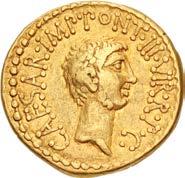
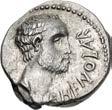

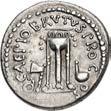
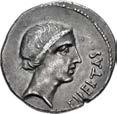
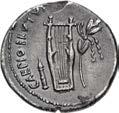


538. The Republicans. Brutus. Early 42 BC. AR Denarius (18.5mm, 3.75 g, 12h). Military mint, probably at Smyrna; P. Cornelius Lentulus Spinther, legatus. Emblems of the pontificate: securis, simpulum, and secespita; BruTuÍ below / Emblems of the augurate: capis and lituus; LeNTuLuÍ/ÍpiNT in two lines below. Crawford 500/7; CRI 198; Sydenham 1310; RSC 6; BMCRR East 80-1; Kestner 3770; RBW 1766. Attractive golden toning with some luster, light deposits at periphery. Superb EF. Well centered. ($5000)
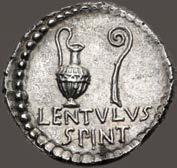
539. The Republicans. Brutus. Spring-early summer 42 BC. AR Denarius (19mm, 3.62 g, 1h). Military mint traveling with Brutus in Lycia. Head of Libertas right / Lyre between quiver and filleted laurel branch. Crawford 501/1; CRI 199; Sydenham 1287; RSC 5; RBW 1767. Deep cabinet tone, minor test cut at edge, edge chip. Good VF. ($750)
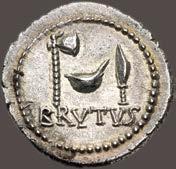
Ex Lanz 88 (23 November 1998), lot 794.
540. The Republicans. Brutus. Spring-early summer 42 BC. AR Denarius (17mm, 3.80 g, 12h). Military mint traveling with Brutus in southwestern Asia Minor; L Sestius, proquaestor. Veiled and draped bust of Libertas right / Tripod; securis to left, simpulum to right. Crawford 502/2; CRI 201; Sydenham 1290; RSC 11; RBW 1768. Toned, some weakness on obverse. Good VF. ($750)
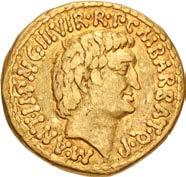
541. The Republicans. Cn. Domitius L.f. Ahenobarbus. 41-40 BC. AR Denarius (17.5mm, 3.71 g, 6h). Uncertain mint in the region of the Adriatic or Ionian Sea. Bare head of Ahenobarbus right, wearing short beard / Prow right surmounted by a military trophy. Crawford 519/2; CRI 339; Sydenham 1177; Domitia 21; RBW 1803. Toned, irregular flan. Good VF. ($750)

• ANT if Yg iii uir
around / Bare head of Octavian right, with slight beard; CAeÍAr
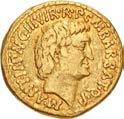
iÂp
pONT
uir
around.
133
•
• p • C •  BArBAT • œ • p
•
•
• iii •
• r • p • C •
539 540 541
542. The Triumvirs. Mark Antony and Octavian. Spring-early summer 41 BC. AV Aureus (19.5mm, 7.99 g, 12h). Ephesus mint; M. Barbatius Pollio, quaestor pro praetore. Bare head of Mark Antony right; Â
r
Crawford 517/1a; CRI 242; Sydenham 1180; Calicó 109; Biaggi 66; RBW 1797. Lightly toned, a few minor marks. Near VF. ($7500)
543. The Triumvirs. Mark Antony and Octavian. Spring-early summer 41 BC. AR Denarius (19mm, 3.92 g, 12h). Ephesus mint; M. Barbatius Pollio, quaestor pro praetore. Bare head of Mark Antony right / Bare head of Octavian right, with slight beard. Crawford 517/2; CRI 243; Sydenham 1181; RSC 8a; RBW 1798. Lightly toned, reverse struck slightly off center, light scratch under tone on reverse. EF. A pair of excellent portraits. ($1000)
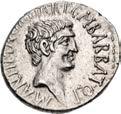
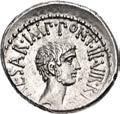
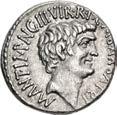
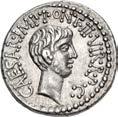
544. The Triumvirs. Mark Antony and Octavian. Spring-early summer 41 BC. AR Denarius (18.5mm, 4.29 g, 12h). Ephesus mint; M. Barbatius Pollio, quaestor pro praetore. Bare head of Mark Antony right / Bare head of Octavian right, with slight beard. Crawford 517/2; CRI 243; Sydenham 1181; RSC 8a; RBW 1798. Deeply toned with some iridescence, trace deposits, trace die rust and some faint hairlines on reverse. Good VF. A pair of excellent portraits. ($1000)
From the St. George Collection. Ex CNG inventory 823541 (August 2008).
545. The Triumvirs. Mark Antony and Octavian. Spring-early summer 41 BC. AR Denarius (18mm, 4.06 g, 12h). Ephesus mint; M. Barbatius Pollio, quaestor pro praetore. Bare head of Mark Antony right / Bare head of Octavian right, with slight beard. Crawford 517/2; CRI 243; Sydenham 1181; RSC 8a; RBW 1798. Toned, some minor scratches on obverse. Near EF. ($750)
Extremely Rare Antony & Octavia Aureus from the Athens Mint
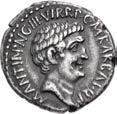
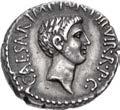
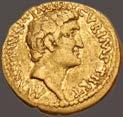
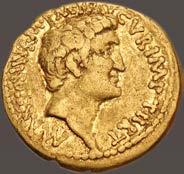
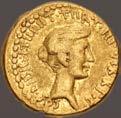
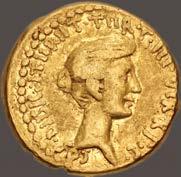
546. The Triumvirs.
iiT
TiirT
iii
uir
• ANTONiuÍ
C around. Crawford 533/3b;
268a;
Augur
iÂp
TiirT around / Head of Octavia right, her hair tied in a knot behind with one long plait arranged as a loop on top of her head; COÍ
DiiÍig
91; Calicó 116; Sydenham 1201;
iTiir
–. Lightly toned, underlying luster trace deposits on obverse, small ink collection mark on reverse. Near VF. Extremely rare. ($20,000)
145;
134
•
• F • Â • N •
•
•
•
•
•
•
•
•
• r •
•
Mark Antony and Octavia. Summer-autumn 39 BC. AV Aureus (19.5mm, 7.90 g, 11h). Athens mint. Bare head of Mark Antony right; Â
Â
p
CRI
Bahrfeldt
BMCRR East
RBW
547. The Triumvirs. Mark Antony. Summer 38 BC. AR Denarius (19.5mm, 3.92 g, 5h). Athens mint. Mark Antony, veiled, and wearing the priestly robes of an augur, standing right, holding lituus / Radiate head of Sol right. Crawford 533/2; CRI 267; Sydenham 1199; RSC 13a; RBW 1820. Lightly toned, some weakness on obverse. Good VF. ($500)
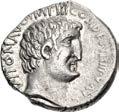
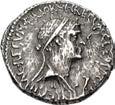
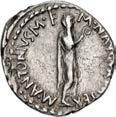
From the Shetland Sheepdog Collection. Ex Classical Numismatic Group Electronic Auction 335 (24 September 2014), lot 443.
548. The Triumvirs. Mark Antony. Summer 38 BC. AR Denarius (17.5mm, 3.86 g, 6h). Athens mint. Mark Antony, veiled, and wearing the priestly robes of an augur, standing right, holding lituus / Radiate head of Sol right. Crawford 533/2; CRI 267; Sydenham 1199; RSC 13a; RBW 1820. Toned. VF. ($500)
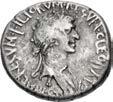
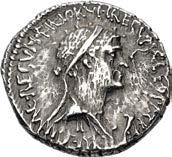
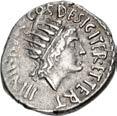
549. The Triumvirs. Mark Antony and Cleopatra. Autumn 34 BC. AR Denarius (17mm, 3.99 g, 12h). Alexandria mint(?). Bare head of Mark Antony right; Armenian tiara to left / Diademed and draped bust of Cleopatra right; at point of bust, prow right. Crawford 543/1 note; CRI 345; Sydenham 1210 var. (rev. legend); RSC 1c; RBW –. Toned, hairline flan crack, obverse struck slightly off center, die wear and porosity on reverse. Good VF. ($3000)
550. The Triumvirs. Mark Antony and Cleopatra. Autumn 34 BC. AR Denarius (17.5mm, 3.72 g, 1h). Alexandria mint(?). Bare head of Mark Antony right; Armenian tiara to left / Diademed and draped bust of Cleopatra right; at point of bust, prow right. Crawford 543/1 note; CRI 345; Sydenham 1210 var. (rev. legend); RSC 1b; RBW –. Toned. Near VF. ($2000)
From the CJR Collection.
551. The Triumvirs. Mark Antony. Summer 32 BC. AR Denarius (17mm, 3.85 g, 12h). Athens mint; M. Junius Silanus, proconsul. Bare head right; small p (engraver’s signature) in hair behind ear /  • ÍiLANuÍ • Aug/ œ • prO • COÍ in two lines. Crawford 542/1; CRI 346; Sydenham 1208; RSC 71; RBW 1830. Lightly toned, off center, area of weakness on obverse. Good VF. ($500)
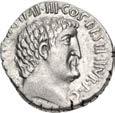
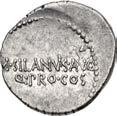
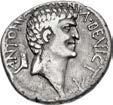
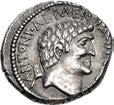
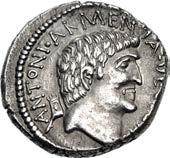
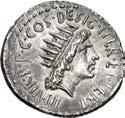
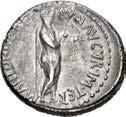
552. The Triumvirs. Mark Antony. Summer 32 BC. AR Denarius (18mm, 3.65 g, 3h). Athens mint. Bare head right; small p (signature) in hair below ear / ANTONiuÍ/Aug • iÂp • iii in two lines. Crawford 542/2; CRI 347; Sydenham 1209; RSC 2; RBW 1831. Lightly toned with some luster, struck slightly off center, light hairlines on reverse. Near EF. ($750)
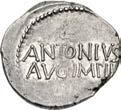
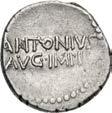
553. The Triumvirs. Mark Antony. Summer 32 BC. AR Denarius (18.5mm, 3.79 g, 12h). Athens mint. Bare head right; small p (signature) in hair below ear / ANTONiuÍ/Aug • iÂp • iii in two lines. Crawford 542/2; CRI 347; Sydenham 1209; RSC 2; RBW 1831. Lightly toned with some luster, struck slightly off center. Good VF. ($500)
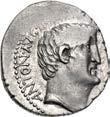
135
547 548 550 551 552 553
An Offering of Antony’s Legionary Denarii
After Mark Antony left his wife Octavia in Greece to resume his liaison with Cleopatra VII of Egypt in 36 BC, full-scale war for control of the Roman world became inevitable between Antony and Octavian, his fellow triumvir and brother of Octavia. A propaganda campaign began as both sides started marshaling forces and producing the money needed to pay the vastly expanded armies. However, their resources were unequal, with Antony possessing the wealthy eastern provinces and Egypt, while Octavian controlled the relatively impoverished west. Consequently, silver and gold coins struck in Antony’s name greatly outnumbered those of Octavian even before the legionary series commenced. Antony’s coinage of 34 BC, struck after the infamous Donations of Alexandria, stressed his partnership with Cleopatra, but this provided fodder for Octavian’s propagandists, who claimed Antony had become the queen’s slave and had ceased being a Roman. In 32 BC, Octavian forced Antony’s supporters out of the Senate and obtained a declaration of war against Egypt. Antony anticipated this action and had already begun moving his legions to Greece, with the intention of staging up for an invasion of Italy. It was there, probably at Antony’s winter quarters in Patrae, that the legionary denarius entered production in the fall of 32 BC, naming the individual units making up his formidable force.
Unusually for the era, the coins eschew any portraiture and instead celebrate both the land and naval components of Antony’s military force, with the obverse depicting a war galley under oar, and the reverse depicting a legionary eagle (aquila) flanked by two cohort standards (signa). Antony is identified as the issuer by name and his titles, ANT AVG III VIR R.P.C, abbreviating Antonii auguris, tresviri rei publicae constituendae (”Antony, Augur and Triumvir for the Organizing of the Republic”). The reverses name 22 legions (Legiones II - XXIII); all examples naming a “first legion” (LEG PRI) seem to be forgeries of later eras. Three legions, specifically raised by Antony, receive special names along with their numerals, LEG XII ANTIQVAE (“venerable”), LEG XVII CLASSICAE (“of the fleet”), and LEG XVIII LYBICAE (“Lybian”); coins with the same legionary numeral but no epithet were also struck, making it unclear whether these are the same or different units. Several legionary numerals are also rendered in different forms (i.e. IV and IIII, IX and VIIII, XIX and XVIIII). Thus the actual varieties far outnumber the legions represented. Two specialized units also receive coins: The Praetorian Cohorts, Antony’s personal guard, and the Speculatores, or scouts, with the latter signified by specially decorated naval standards. Antony’s total forces numbered perhaps 200,000, so as many as 30 million legionary denarii were struck to pay them.
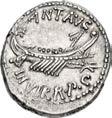
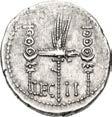

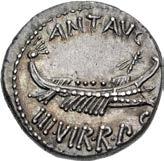
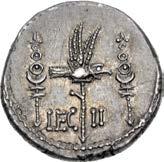
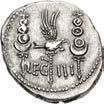
Tests have shown the silver alloy employed was about 92% pure, slightly more base than that used by the Rome mint (96%). Oddly enough, this ensured that Antony’s legionary denarii remained in circulation for centuries after his defeat at the naval battle of Actium, as the government made no special effort to recall and remint them in the Imperial period, as was frequently done with coins of purer silver. Hoards in the late third century AD still contain significant numbers of heavily worn legionary denarii, a testament to Gresham’s Law (”bad money drives out good”).
554. The Triumvirs. Mark Antony. Autumn 32-spring 31 BC. AR Denarius (17mm, 3.75 g, 6h). Legionary type. Patrae(?) mint. Praetorian galley right / Aquila between two signa; Leg ii across lower field. Crawford 544/14; CRI 349; Sydenham 1216; RSC 27; RBW 1838. Toned. Good VF. ($750)
Ex Haeberlin Collection – Pedigreed to 1933
555. The Triumvirs. Mark Antony. Autumn 32-spring 31 BC. AR Denarius (17mm, 4.08 g, 6h). Legionary type. Patrae(?) mint. Praetorian galley right / Aquila between two signa; Leg ii across lower field. Crawford 544/14; CRI 349; Sydenham 1216; RSC 27; RBW 1838. Attractive iridescent toning. Near EF. ($750)
From the Collection of a Texas Wine Doctor. Ex Classical Numismatic Review XVIII.1 (First Quarter 1993), no. 196; Haeberlin Collection (Cahn, 17 July 1933), lot 3095.
556. The Triumvirs. Mark Antony. Autumn 32-spring 31 BC. AR Denarius (15mm, 3.95 g, 6h). Legionary type. Patrae(?) mint. Praetorian galley right / Aquila between two signa; Leg iii across lower field. Crawford 544/15; CRI 350; Sydenham 1217; RSC 28; RBW 1839. Toned, obverse graffito. Good VF. ($500)
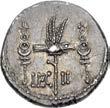

136
557. The Triumvirs. Mark Antony. Autumn 32-spring 31 BC. AR Denarius (16.5mm, 3.74 g, 6h). Legionary type. Patrae(?) mint. Praetorian galley right / Aquila between two signa; Leg iu across lower field. Crawford 544/17; CRI 352; Sydenham 1219; RSC 30; RBW –. Toned. EF. Well centered and struck. ($1000)
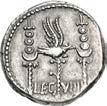
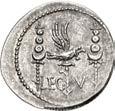
558. The Triumvirs. Mark Antony. Autumn 32-spring 31 BC. AR Denarius (17.5mm, 3.87 g, 12h). Legionary type. Patrae(?) mint. Praetorian galley right / Aquila between two signa; Leg u across lower field. Crawford 544/18; CRI 354; Sydenham 1221; RSC 32; RBW 1840. Toned. Near EF. ($750)

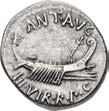
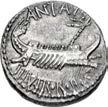
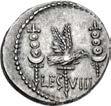
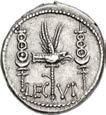
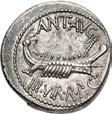
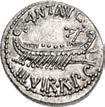
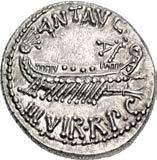
559. The Triumvirs. Mark Antony. Autumn 32-spring 31 BC. AR Denarius (16.5mm, 3.84 g, 6h). Legionary type. Patrae(?) mint. Praetorian galley right / Aquila between two signa; Leg ui across lower field. Crawford 544/19; CRI 356; Sydenham 1223; RSC 33; RBW 1841. Lightly toned, minor edge split. Near EF. ($750)
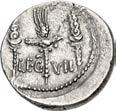
560. The Triumvirs. Mark Antony. Autumn 32-spring 31 BC. AR Denarius (17.5mm, 3.93 g, 3h). Legionary type. Patrae(?) mint. Praetorian galley right / Aquila between two signa; Leg uii across lower field. Crawford 544/20; CRI 357; Sydenham 1224; RSC 34; RBW 1842. Toned, reverse off center. Good VF. ($500)
561. The Triumvirs. Mark Antony. Autumn 32-spring 31 BC. AR Denarius (17mm, 3.62 g, 12h). Legionary type. Patrae(?) mint. Praetorian galley right / Aquila between two signa; Leg uiii across lower field. Crawford 544/21; CRI 358; Sydenham 1225; RSC 35; RBW –. Lightly toned with some iridescence, reverse struck slightly off center. Near EF. ($750)
From the Collection of a Texas Wine Doctor. Ex CNG inventory 903520 (circa 1991-3).
562. The Triumvirs. Mark Antony. Autumn 32-spring 31 BC. AR Denarius (17mm, 3.90 g, 6h). Legionary type. Patrae(?) mint. Praetorian galley right / Aquila between two signa; Leg uiii across lower field. Crawford 544/21; CRI 358; Sydenham 1225; RSC 35; RBW –. Toned, reverse struck slightly off center, a few light scratches on reverse. VF. ($500)
563. The Triumvirs. Mark Antony. Autumn 32-spring 31 BC. AR Denarius (16.5mm, 3.93 g, 7h). Legionary type. Patrae(?) mint. Praetorian galley right / Aquila between two signa; Leg ix across lower field. Crawford 544/23; CRI 359; Sydenham 1227; RSC 37; RBW –. Lightly toned, obverse struck slightly off center. Good VF. ($500)
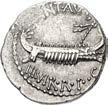
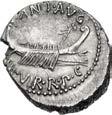
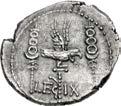
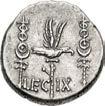
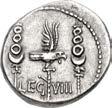
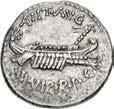
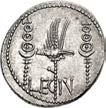
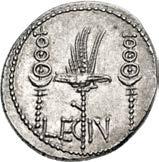
564. The Triumvirs. Mark Antony. Autumn 32-spring 31 BC. AR Denarius (17mm, 3.74 g, 6h). Legionary type. Patrae(?) mint. Praetorian galley right / Aquila between two signa; Leg ix across lower field. Crawford 544/23; CRI 359; Sydenham 1227; RSC 37; RBW –. Toned, slight off center on obverse, edge split. Good VF. ($500)
From the Collection of a Texas Wine Doctor. Ex CNG inventory 903520 (circa 1991-3).
565. The Triumvirs. Mark Antony. Autumn 32-spring 31 BC. AR Denarius (16mm, 3.78 g, 11h). Legionary type. Patrae(?) mint. Praetorian galley right / Aquila between two signa; Leg uiiii across field. Crawford 544/22; CRI 360; Sydenham 1226; RSC 36; RBW –. Toned, obverse struck slightly off center. VF. ($500)
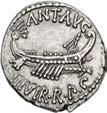
137
558 559 560 561 562 563 564 565
566. The Triumvirs. Mark Antony. Autumn 32-spring 31 BC. AR Denarius (16mm, 3.92 g, 10h). Legionary type. Patrae(?) mint. Praetorian galley right / Aquila between two signa; Leg uiiii across field. Crawford 544/22; CRI 360; Sydenham 1226; RSC 36; RBW –. Lightly toned, light hairlines. VF. ($500 )
567. The Triumvirs. Mark Antony. Autumn 32-spring 31 BC. AR Denarius (18mm, 3.81 g, 9h). Legionary type. Patrae(?) mint. Praetorian galley right / Aquila between two signa; Leg x across lower field. Crawford 544/24; CRI 361; Sydenham 1228; RSC 38; RBW –. Toned, obverse struck slightly off center. Good VF. ($750)
568. The Triumvirs. Mark Antony. Autumn 32-spring 31 BC. AR Denarius (17.5mm, 3.32 g, 5h). Legionary type. Patrae(?) mint. Praetorian galley right / Aquila between two signa; Leg x across lower field. Crawford 544/24; CRI 361; Sydenham 1228; RSC 38; RBW –. Lightly toned, minor die rust, pair of minor edge marks. Good VF. ($500)
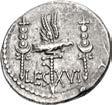
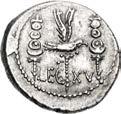
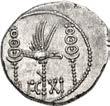
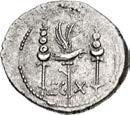
569. The Triumvirs. Mark Antony. Autumn 32-spring 31 BC. AR Denarius (17mm, 3.84 g, 6h). Legionary type. Patrae(?) mint. Praetorian galley right / Aquila between two signa; Leg xi across lower field. Crawford 544/25; CRI 362; Sydenham 1229; RSC 39; RBW –. Toned, slightly off center on reverse. EF. ($1000)
570. The Triumvirs. Mark Antony. Autumn 32-spring 31 BC. AR Denarius (16.5mm, 3.45 g, 6h). Legionary type. Patrae(?) mint. Praetorian galley right / Aquila between two signa; Leg xii across lower field. Crawford 544/26; CRI 365; Sydenham 1230; RSC 41; RBW –. Toned, minor smoothing. Near EF. ($500)
From the Collection of a Texas Wine Doctor. Ex Classical Numismatic Group 75 (23 May 2007), lot 963.
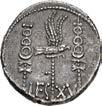
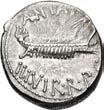

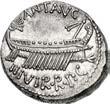
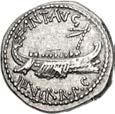
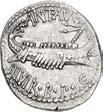
571. The Triumvirs. Mark Antony. Autumn 32-spring 31 BC. AR Denarius (17.5mm, 3.76 g, 9h). Legionary type. Patrae(?) mint. Praetorian galley right / Aquila between two signa; Leg xii across lower field. Crawford 544/26; CRI 365; Sydenham 1230; RSC 41; RBW –. Lightly toned. Good VF. ($500)
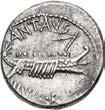
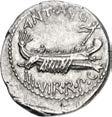
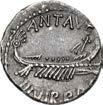
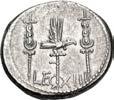
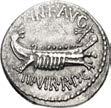
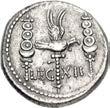

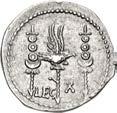

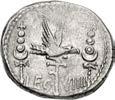
572. The Triumvirs. Mark Antony. Autumn 32-spring 31 BC. AR Denarius (16mm, 3.77 g, 4h). Legionary type. Patrae(?) mint. Praetorian galley right / Aquila between two signa; Leg xiii across lower field. Crawford 544/27; CRI 367; Sydenham 1232a; RSC 42; RBW 1844. Lightly toned, light hairlines. Good VF. ($500)
From the Collection of a Texas Wine Doctor. Ex CNG inventory 84944 (late 1994 - early 1995); Giessener Münzhandlung 69 (18 November 1994), lot 522.
573. The Triumvirs. Mark Antony. Autumn 32-spring 31 BC. AR Denarius (16mm, 3.51 g, 6h). Legionary type. Patrae(?) mint. Praetorian galley right / Aquila between two signa; Leg xu across lower field. Crawford 544/30; CRI 371; Sydenham 1235; RSC 47; RBW 1845. Deeply toned. Near EF. ($750)
From the Collection of a Texas Wine Doctor. Ex CNG inventory 903520 (circa 1991-3).
574. The Triumvirs. Mark Antony. Autumn 32-spring 31 BC. AR Denarius (17mm, 3.85 g, 8h). Legionary type. Patrae(?) mint. Praetorian galley right / Aquila between two signa; Leg xu across lower field. Crawford 544/30; CRI 371; Sydenham 1235; RSC 47; RBW 1845. Lightly toned, minor flan flaw at edge on reverse. Near EF. ($750)
575. The Triumvirs. Mark Antony. Autumn 32-spring 31 BC. AR Denarius (16mm, 3.98 g, 4h). Legionary type. Patrae(?) mint. Praetorian galley right / Aquila between two signa; Leg xui across lower field. Crawford 544/31; CRI 372; Sydenham 1236; RSC 48; RBW –. Lightly toned, obverse struck slightly off center, scratch on obverse. Good VF. ($500)
138
566 567 568 569 570 571 572 573 574 575
576. The Triumvirs. Mark Antony. Autumn 32-spring 31 BC. AR Denarius (17mm, 3.82 g, 9h). Legionary type. Patrae(?) mint. Praetorian galley right / Aquila between two signa; Leg xuii across lower field. Crawford 544/32; CRI 374; Sydenham 1237; RSC 49; RBW 1846. Lightly toned, off center. Good VF. ($500)
577. The Triumvirs. Mark Antony. Autumn 32-spring 31 BC. AR Denarius (17mm, 3.70 g, 3h). Legionary type. Patrae(?) mint. Praetorian galley right / Aquila between two signa; Leg xuiii across lower field. Crawford 544/33; CRI 376; Sydenham 1239; RSC 51; RBW –. Lightly toned, slightly off center, some weakness. Good VF. ($500)
578. The Triumvirs. Mark Antony. Autumn 32-spring 31 BC. AR Denarius (16mm, 4.01 g, 12h). Legionary type. Patrae(?) mint. Praetorian galley right / Aquila between two signa; Leg xix across lower field. Crawford 544/35; CRI 378; Sydenham 1242; RSC 55; RBW 1847. Lightly toned, slightly off center, metal flaws, some weakness. Good VF. ($500)
579. The Triumvirs. Mark Antony. Autumn 32-spring 31 BC. AR Denarius (16mm, 3.73 g, 6h). Legionary type. Patrae(?) mint. Praetorian galley right / Aquila between two signa; Leg xx across field. Crawford 544/36; CRI 380; Sydenham 1243; RSC 57; RBW 1848. Toned. Near EF. A bold strike. ($1000)
From the Collection of a Texas Wine Doctor. Ex CNG inventory 903520 (circa 1991-3).
580. The Triumvirs. Mark Antony. Autumn 32-spring 31 BC. AR Denarius (17.5mm, 3.83 g, 12h). Legionary type. Patrae(?) mint. Praetorian galley right / Aquila between two signa; Leg xx across field. Crawford 544/36; CRI 380; Sydenham 1243; RSC 57; RBW 1848. Toned, slightly off center. VF. ($500)
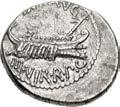
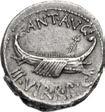
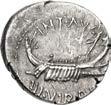
581. The Triumvirs. Mark Antony. Autumn 32-spring 31 BC. AR Denarius (18.5mm, 3.98 g, 3h). Legionary type. Patrae(?) mint. Praetorian galley right / Aquila between two signa; Leg xxii across lower field. Crawford 544/38; CRI 382; Sydenham 1245; RSC 59; RBW –. Toned, off center. Near EF. ($500)


582. The Triumvirs. Mark Antony. Autumn 32-spring 31 BC. AR Denarius (17mm, 3.91 g, 6h). Legionary type. Patrae(?) mint. Praetorian galley right / Aquila between two signa; Leg xxiii across lower field. Crawford 544/39; CRI 383; Sydenham 1246; RSC 60; RBW –. Lightly toned, slightly off center. Near EF. ($750)
583. The Triumvirs. Mark Antony. Autumn 32-spring 31 BC. AR Denarius (18mm, 3.72 g, 8h). Legionary type. Patrae(?) mint. Praetorian galley right / Three signa decorated with wreaths and rostra; ChOrTiÍ • ÍpeCuLATOru above. Crawford 544/12; CRI 386; RSC 6; Sydenham 1214; RBW 1837. Toned, minor area of roughness on reverse. Good VF. ($750)
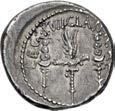
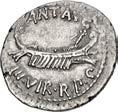
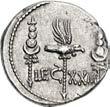
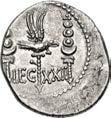
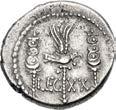
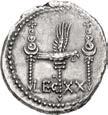
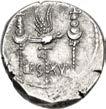
584. The Triumvirs. Mark Antony. Autumn 32-spring 31 BC. AR Denarius (17.5mm, 3.47 g, 9h). Legionary type. Patrae(?) mint. Praetorian galley right / Three signa decorated with wreaths and rostra; ChOrTiÍ • ÍpeCuLATOru above. Crawford 544/12; CRI 386; RSC 6; Sydenham 1214; RBW 1837. Deeply toned, struck slightly off center. Near VF. ($500)
From the Collection of a Texas Wine Doctor. Ex Classical Numismatic Group 43 (24 September 1997), lot 1739.
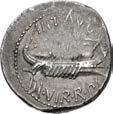
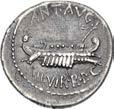
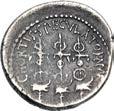
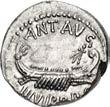
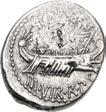
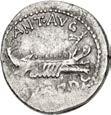
585. The Triumvirs. Mark Antony. Autumn 32-spring 31 BC. AR Denarius (19mm, 3.74 g, 12h). Legionary type. Patrae(?) mint. Praetorian galley right / Aquila between two signa; Leg xuii • CLAÍÍiCAe above. Crawford 544/10; CRI 373; Sydenham 1238; RSC 50; BMCRR East 223; Kestner 3839; RBW 1835. Iridescent toning, area of peripheral weakness on obverse, reverse slightly off center. Good VF. ($500)
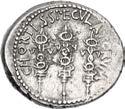
Ex Leo Benz Collection (Part 1, Lanz 88, 23 November 1998), lot 871.
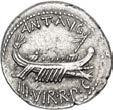
139
576 577 578 579 580 581 582 583 584 585
586. The Triumvirs. Octavian and Divus Julius Caesar. 38 BC. Æ Sestertius (or Dupondius?) (29.5mm, 23.61 g, 12h). Southern Italian(?) mint. Bare head of Octavian right, wearing slight beard / Laureate head of Divus Julius Caesar right. Crawford 535/1; Alföldi & Giard 24 (D11/R16); CRI 308; Sydenham 1335; RPC I 620; RBW 1822. Dark green-brown surfaces, smoothing. VF. ($1500)
From the Collection of a Texas Wine Doctor, purchased from C. H. Wolfe, 6 January 1988.
587. The Triumvirs. Octavian. Summer 37 BC. AR Denarius (19.5mm, 4.10 g, 10h). Mint in southern or central Italy. Bare head right, wearing beard / Emblems of the augurate and pontificate: simpulum, aspergillum, guttus, and lituus. Crawford 538/1; CRI 312; Sydenham 1334; RSC 91; RBW 1826. Toned, minor area of weakness on reverse. Good VF. ($500)
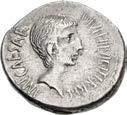
588. The Triumvirs. Octavian. Autumn 30-summer 29 BC. AR Denarius (20mm, 3.96 g, 3h). Uncertain mint in Italy (Rome?). Bare head right / Naval and military trophy facing, composed of helmet, cuirass, shield, and crossed spears, set on prow of galley right; crossed rudder and anchor at base. CRI 419; RIC I 265a; RSC 119. Deep iridescent toning, reverse struck slightly off center, a couple of minor reverse die breaks. VF. ($750)
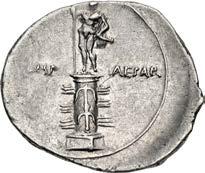
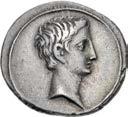

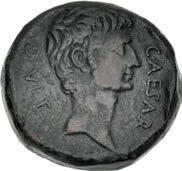
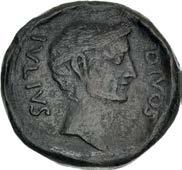
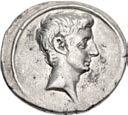
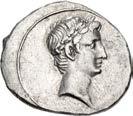
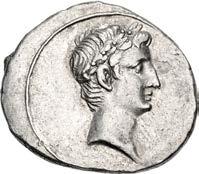
From the Shetland Sheepdog Collection, purchased from Fred Shore, 15 December 2015.
589. The Triumvirs. Octavian. Autumn 30-summer 29 BC. AR Denarius (19.5mm, 3.88 g, 8h). Uncertain mint in Italy (Rome?). Bare head right / Octavian’s Actian arch (arcus Octaviani), showing a single span surmounted by Octavian in facing triumphal quadriga; iÂp • CAeÍAr on the architrave. CRI 422; RIC I 267; RSC 123. Toned, traces of find patina, a few light scratches. Good VF. ($750)
From the Libertas Collection.
590. The Triumvirs. Octavian. Autumn 30-summer 29 BC. AR Denarius (20.5mm, 3.55 g, 12h). Uncertain mint in Italy (Rome?). Laureate head of Octavian, as Apollo, right / Rostral column ornamented with two anchors and six beaks of galleys, surmounted by a statue of Octavian, holding spear and parazonium. CRI 423; RIC I 271; RSC 124. Toned, with some luster, slightly off center, light hairlines, trace die rust on reverse. Near EF. ($1000)
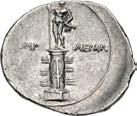
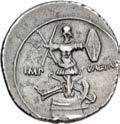
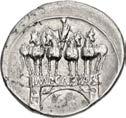
140
587
588
591
592
591. The Triumvirs. Octavian. Autumn 30-summer 29 BC. AR Denarius (16mm, 3.82 g, 12h). Uncertain mint in Italy (Rome?). Laureate head of Apollo of Actium right, with features resembling Octavian / Octavian, as city founder, holding whip and plow-handle, plowing right with yoke of oxen. CRI 424; RIC I 272; RSC 117. Toned and lustrous, trace die rust on obverse. EF. ($750)

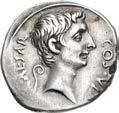
592. The Triumvirs. Octavian. Autumn 30-summer 29 BC. AR Denarius (18.5mm, 3.82 g, 8h). Uncertain mint in Italy (Rome?). Laureate head of Apollo of Actium right, with features resembling Octavian / Octavian, as city founder, holding whip and plow-handle, plowing right with yoke of oxen. CRI 424; RIC I 272; RSC 117. Attractive cabinet toning with some light iridescence and luster, banker’s mark on obverse. Good VF. ($1000)
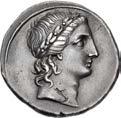
Ex Lampasas Collection (Classical Numismatic Group Electronic Auction 484, 27 January 2021), lot 706; Andrew McCabe Collection (Classical Numismatic Group 112, 11 September 2019), lot 577; Heritage 3030 (5 January 2014), lot 23913; Manhattan Sale 4 (8 January 2013), lot 129; Sotheby’s (30 March 1995), lot 1034.
593. The Triumvirs. Octavian. 28 BC. AR Denarius (18.5mm, 3.69 g, 6h). “Aegypto Capta” commemorative. Uncertain mint in Italy (Rome?). Bare head right; lituus behind neck / Crocodile standing right with jaws open; AegupTO above, CApTA below. CRI 430; RIC I 275a; RSC 2. Lightly toned, bent, minor edge chip, light scrapes at edge on reverse. VF. ($1500)
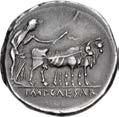
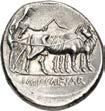
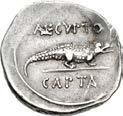
From the Kalevala Collection. Ex Soler y Llach 1122 (26 October 2021), lot 528.
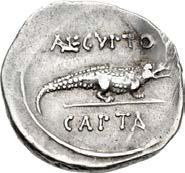
End of Session 2
141
ROMAN IMPERIAL COINAGE
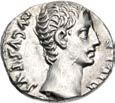
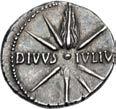
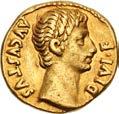
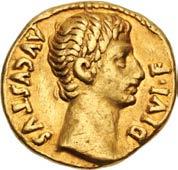
594. Augustus. 27 BC-AD 14. AR Denarius (20mm, 3.90 g, 6h). Uncertain Spanish mint (Colonia Caesaraugusta?). Struck circa 19-18 BC. Head left, wearing oak wreath / DIVVS • IVLIVS across field, comet with eight rays and tail. RIC I 37b; RSC 97. Lightly toned, hairlines, a few minor marks. Good VF. ($1500)
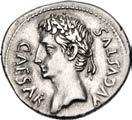
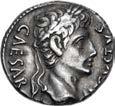
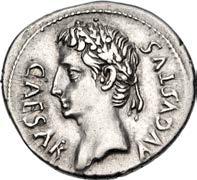
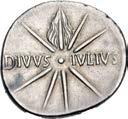
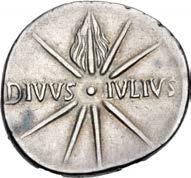
From the Libertas Collection, purchased 13 March 1988.
Session 3 – Wednesday, September 20, 2023 — 9 AM 595
596
595. Augustus. 27 BC-AD 14. AR Denarius (18mm, 3.95 g, 7h). Uncertain Spanish mint (Colonia Patricia?). Struck circa 18 BC. Laureate head right / DIVVS • IVLIV[S] across field, comet with eight rays and tail. RIC I 102; RSC 98. Deeply toned, small flan flaw on obverse. VF. ($500)
Ex Áureo & Calicó 367 (2 June 2021), lot 2068.
596. Augustus. 27 BC-AD 14. AR Denarius (19mm, 3.80 g, 6h). Uncertain Spanish mint (Colonia Patricia?). Struck circa 18-17/16 BC. Bare head right / Capricorn right, holding globe attached to rudder between front hooves; cornucopia above its back. RIC I 126; RSC 21. Lightly toned. Good VF. ($500)

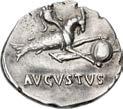
Ex Numismatica Ars Classica 92 (23 May 2016), lot 467.
597. Augustus. 27 BC-AD 14. AV Aureus (18.5mm, 7.64 g, 8h). Lugdunum (Lyon) mint. Struck 15 BC. Bare head right / Apollo Citharoedus standing left, holding plectrum and lyre. RIC I 170; Lyon 27; Calicó 215; BMCRE 459-60; BN 1394-5; Adda 10; Biaggi 112; Mazzini 143. Toned, minor marks, a few shallow scratches on reverse. VF. ($4000)

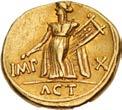
From the Libertas Collection. Ex A. J. Donald Collection (Spink 25, 24 November 1982), lot 165, purchased from Spink, May 1946.
598. Augustus. 27 BC-AD 14. AR Denarius (18mm, 3.79 g, 1h). Lugdunum (Lyon) mint. Struck 11 BC. Bare head right / Diana standing right, holding spear and bow; at her feet to left, dog standing left. RIC I 182; Lyon 35; RSC 168. Lustrous, struck on a compact flan. EF. ($750)
Ex A. Lynn Collection (Manhattan Sale 1, 5 January 2010), lot 189.

142
Ex Knobloch and Levis Collections – Pedigreed to 1925
From the Libertas Collection. Ex Frederick S. Knobloch Collection (Stack’s, 1 May 1980), lot 22; H. C. Levis Collection (Ars Classica XI, 18
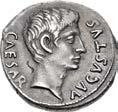
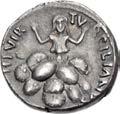

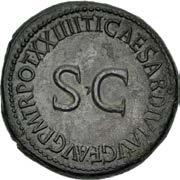
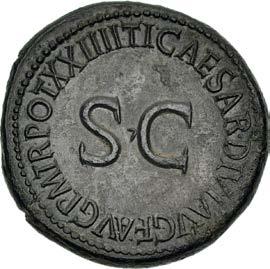
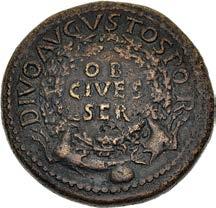
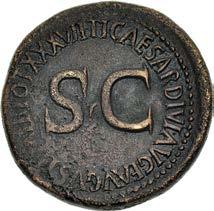
In the story of the abduction of the Sabine women, Tarpeia was a Vestal Virgin who betrayed the city of Rome to the Sabines when they were attempting to rescue their wives and daughters. Her price for betraying Rome was what the Sabine soldiers wore on their left arms, meaning their gold bracelets, but the Sabines were so offended by Tarpeia’s reprehensible greed and treason that they took her request literally. She met her death under the crushing weight of the soldiers’ shields.
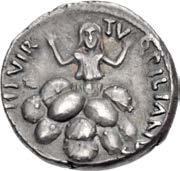
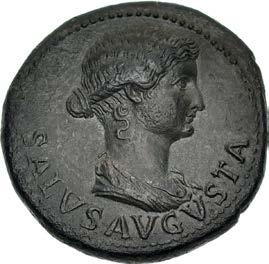
143
599. Augustus. 27 BC-AD 14. AR Denarius (18.5mm, 4.02 g, 10h). Rome mint; P. Petronius Turpilianus, moneyer. Struck 19-18 BC. Bare head right / Tarpeia standing facing, raising both hands, buried to her waist under shields; broken spear below. RIC I 299; RSC 494. Old collection tone, some iridescence, a couple of bankers’ marks, a few scratches under tone on reverse, traces of die rust. Good VF. ($750)
June 1925), lot 239.
600. Divus Augustus. Died AD 14. Æ Sestertius (35.5mm, 27.86 g, 12h). Rome mint. Struck under Tiberius, AD 35-36. OB/ CIVES/ SER in three lines on shield within oak-wreath supported by two capricorns; globe below / Legend around large S • C. RIC I 63 (Tiberius); CNR VI, 927/7 (this coin). Brown surfaces, minor roughness. VF. ($750)
From the Libertas Collection, purchased 21 April 1984. Ex Seaby Coin & Medal Bulletin 655 (March 1973), no. A282.
601. Julia Augusta (Livia). Augusta, AD 14-29. Æ Dupondius (30mm, 14.04 g, 12h). Rome mint. Struck under Tiberius, AD 22-23. Bareheaded and draped bust of Julia Augusta (Livia) as Salus Augusta right, wearing waved hair and fastened in a knot at the back / Legend around large S • C. RIC I 47 (Tiberius); BMCRE 81-84 (Tiberius); BN 63-7 (Tiberius). Dark green patina, light smoothing. Near EF. An outstanding portrait struck in high relief. ($1000) From the CJR Collection.
As his great-grandfather Augustus did with Divus Julius Caesar, Gaius had coins struck which included a deified ancestor, in this case Divus Augustus. While later emissions of this type leave no doubt, since the legend DIVVS AVG PATER PATRIAE is included, this earlier denarius, struck in the opening months of the new reign, is more ambiguous: it is anepigraphic, the inclusion of stars argue for recent divinity (Augustus had been deified 23 years earlier), and the features on some of these coins somewhat resemble those of Tiberius. Combined with the historical evidence that Gaius had personally given Tiberius’ funeral oration and had asked the Senate to consider deification for Tiberius, this suggests that Gaius was testing the idea. The Senate, however, refused to pursue the matter further, and the portrait was soon altered to more closely resemble Divus Augustus.
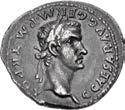
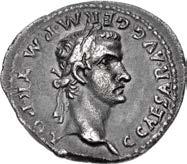
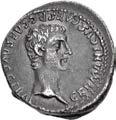
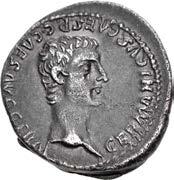
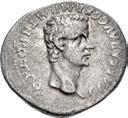
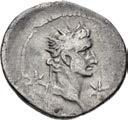

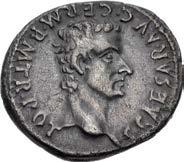

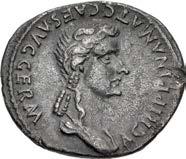
From the CJR Collection.
From
144
602. Gaius (Caligula), with Divus Augustus. AD 37-41. AR Denarius (20mm, 3.39 g, 12h). Lugdunum (Lyon) mint. 1st emission, after 18 March AD 37. Bare head of Gaius (Caligula) right / Radiate head of Divus Augustus right; two stars flanking. RIC I 2 (Rome mint); Lyon 157 (unlisted dies); RSC 11 (Caligula and Augustus). Porosity, scratches. Near VF. ($2000)
603. Gaius (Caligula), with Agrippina Senior. AD 37-41. AR Denarius (19mm, 3.54 g, 12h). Lugdunum (Lyon) mint. 2nd emission, 1st phase, late AD 37. bare head of Gaius (Caligula) right / Draped bust of Agrippina right. RIC I 8 (Rome mint); Lyon 162/6 (D57/R54); RSC 4 (Caligula and Agrippina Senior). Deeply toned, light porosity. VF. Two excellent portraits. ($2000)
604. Gaius (Caligula), with Germanicus. AD 37-41. AR Denarius (20mm, 3.51 g, 9h). Lugdunum (Lyon) mint. 2nd emission, 1st phase, late AD 37. Bare head of Gaius (Caligula) right / Bare head of Germanicus right. RIC I 12 (Rome mint); Lyon 165 (unlisted dies); RSC 4 (Caligula and Germanicus). Deep old cabinet tone with a hint of porosity. Good VF. ($3000)
the CJR Collection.
Before a battle, or on parade, the emperor would address his troops in an event known as an adlocutio cohortium (address to the cohorts). This was an important opportunity for the emperor to be present among his troops to inspire morale. This sestertius was issued on the occasion of a donative for the Praetorian Guard and was the first to employ the adlocutio as a reverse type.
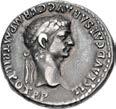
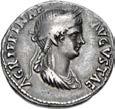
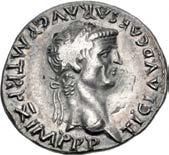
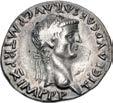
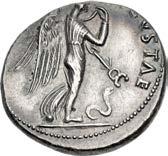
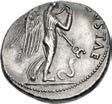
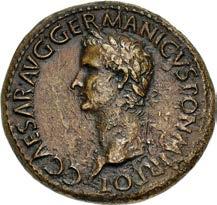
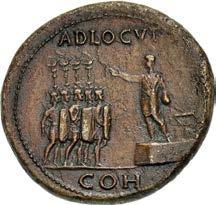
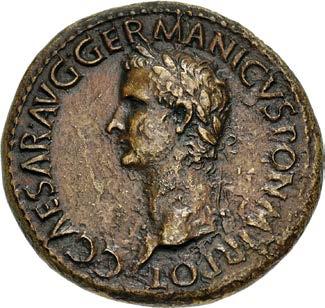
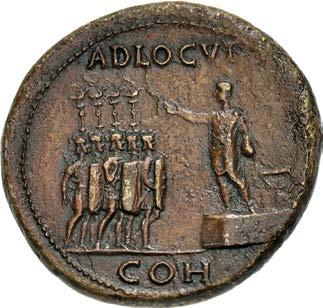
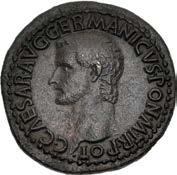
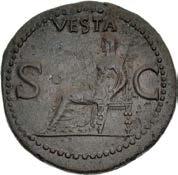
145 First Adlocutio Issue
605. Gaius (Caligula). AD 37-41. Æ Sestertius (36mm, 26.88 g, 6h). Rome mint. Struck AD 37-38. laureate head left / Gaius, bareheaded and togate, standing left on daïs, extending right hand in gesture of address; behind him a sella castrensis (chair); in front of him stand five soldiers right, all helmeted, holding shields, and parazonia; four aquilae behind them. RIC I 32; BMCRE 33-35; BN 45-46. Red-brown patina, minor roughness. Good VF. ($2000)
606. Gaius (Caligula). AD 37-41. Æ As (29mm, 10.64 g, 7h). Rome mint. Struck AD 37-38. Bare head left / Vesta, veiled and draped, seated left on ornamental throne, holding patera and scepter. RIC I 38; BMCRE 45-48; BN 54-72. Brown patina, minor roughness. Near EF. ($750) Ex Freeman & Sear inventory KEL018 (ND).
607. Claudius. AD 41-54. AR Denarius (18mm, 3.03 g, 7h). Rome mint. Struck AD 50-51. Laureate head right / PaxNemesis, winged and draped, advancing right, holding out fold of drapery below chin, and holding winged caduceus, pointing down at snake erect, gliding right. RIC I 52; von Kaenel Type 40 (unlisted dies); RSC 65. Iridescent toning, lustrous, a few scratches, areas of weak strike, flan flaws on obverse, reverse slightly off center. Near EF. ($2000)
608. Claudius, with Agrippina Junior. AD 41-54. AR Denarius (18mm, 3.67 g, 6h). Rome mint. Struck AD 51. Laureate head of Claudius right / Draped bust of Agrippina right, wearing wreath of grain ears. RIC I 81; von Kaenel Type 50, 781 (V665/R683); RSC 4. Old collection toning with some iridescence, weakness on high points. VF. ($1000) From the Libertas Collection, purchased 4 April 1984.
609. Divus Claudius. Died AD 54. AV Aureus (19mm, 7.56 g, 6h). Rome and Lugdunum (Lyon) mint. Struck under Nero, AD 54-55. DIVVS CLAVDIVS AVGVSTVS, laureate head left / EX S C in exergue, slow quadriga right, with tensa (car) in form of small temple, showing front, the tensa with pediment like a temple and decorated with two pateras and a lituus, surmounted by four miniature horses, flanked by Victories left and right; on the side and front are figures (Victory and Virtus(?) and wreath). RIC I 4 (Nero); WCN 1; von Kaenel Type 53 (Divus Claudius [Nero] – unlisted dies); Lyon 2/2a (dies D6/R7 – Denarius); Calicó 354; BMCRE 4-5 (Nero); BN 1-2 (Nero); Biaggi 203; Mazzini 31; LHS 100, lot 467 (same dies). Extensive edge filing marks, ex jewelry, polished. Near VF. ($5000)
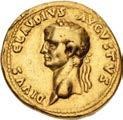
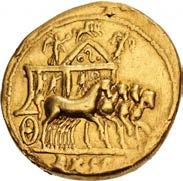
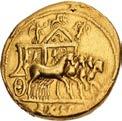
From the Libertas Collection.
610. Nero. As Caesar, AD 50-54. AR Denarius (17mm, 3.71 g, 6h). Rome mint. Struck under Claudius, AD 51. Young bareheaded and draped bust right / EQVESTER/OR DO/PRINCIPI/IVVENT in four lines on a shield; behind it, a vertical spear, pointing upward. RIC I 79 (Claudius); von Kaenel Type 53 (V819/R–, unlisted rev. die); RSC 97. Cabinet tone, slightly off center, minor die wear on reverse. Good VF. ($750)
611. Nero, with Agrippina Junior. AD 54-68. AR Denarius (18mm, 3.56 g, 7h). Rome mint. Struck circa OctoberDecember AD 54. Bare head of Nero right, facing draped bust of Agrippina Junior left / Legend within oak wreath. RIC I 2; RSC 7. Old collection toning, area of flat strike. VF. Rare. ($1500)
From the Libertas Collection, purchased 14 December 1980.
612. Nero. AD 54-68. AR Denarius (19mm, 3.38 g, 12h). Rome mint. Struck AD 60-61. Youthful bare head of Nero right / [PON]TIF
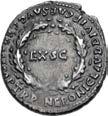
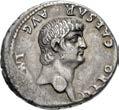
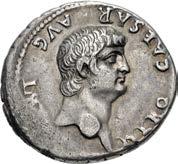
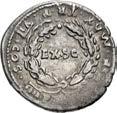
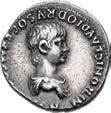
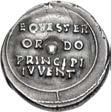


MAX •TR
P
VII
COS
IIII • P • [P] around oak wreath enclosing EX • S C. RIC I 22; RSC 216. Areas of flat strike. Good VF. Beautiful old cabinet tone. Wonderful portrait. ($750)
Ex Peter Corcoran Collection; Berk BBS 198 (7 July 2016), lot 202; Lanz 138 (26 November 2007), lot 577.
146
•
•
•
•
•
613. Nero. AD 54-68. AV Aureus (18mm, 7.12 g, 7h). Rome mint. Struck circa AD 64-66. Laureate head right / Closed doors of the Temple of Janus. RIC I 50 and 58; Calicó 409. Scrape on obverse, marks, hairlines. Good Fine. ($1500)
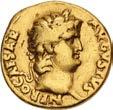
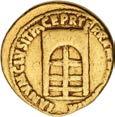
From the Libertas Collection, purchased 29 November 1989.
614. Nero. AD 54-68. AR Denarius (17mm, 2.98 g, 6h). Rome mint. Struck circa AD 64-65. Laureate head right / Jupiter seated left on throne, holding thunderbolt and scepter. RIC I 53; RSC 119. Lustrous, minor marks. Good VF. ($750)
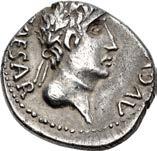
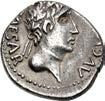
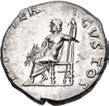
From the Weise Collection. Ex Marian A. Sinton Collection (Triton III, 30 November 1999), lot 1008.
615. Nero. AD 54-68. Æ As (26mm, 10.67 g, 6h). Rome mint. Struck circa AD 65. Laureate head right / Victory flying left, holding shield inscribed S P Q R. RIC I 312; WCN 285, 290. Green patina, minor deposits. Near EF. ($500)
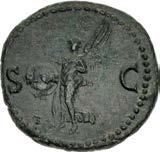

Ex New York Sale XXIII (6 January 2010), lot 136.
Caesar’s Comet Revisited
616. Civil War. AD 68-69. AR Denarius (17mm, 3.35 g, 4h). Augustus, with Divus Julius type. Uncertain mint in Spain or Gaul. Struck 3 April-late June AD 68. Laureate head of Augustus right / DIVVS IVLIVS across field, Sidus Iulium: eightrayed comet with tail upwards. RIC I 92; AM A10; RSC 98 (Augustus); Mairat 146.1 (this coin); BMCRE 49 = Nicolas, Néron A8. Lightly toned; a few minor marks, obverse slightly off-center. Good VF. Extremely rare. ($4000)
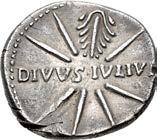
Ex Dipl.-Ing. Christian Gollnow Collection, privately acquired from Yves Gunzenreiner in March 2014.
The civil wars at the end of Nero’s reign began with the revolt of the governor of Gallia Lugdunensis, Gaius Julius Vindex, probably around the beginning of March of AD 68. Vindex offered the leadership of the revolt to Servius Sulpicius Galba, then governor of Hispania Tarraconensis, who was hailed imperator by the Spanish legions at Carthago Nova in April of the same year. The title was cautiously refused, but Galba did declare himself the legatus of the senate and people of Rome. Just a month later, Galba’s confidence would be shaken by the crushing defeat of Vindex near Besançon by the general Lucius Verginius Rufus, governor of Germania Superior. But in another twist of fate, by 9 June, Nero was dead, having taken his own life. Galba began his march to Rome, and his brief reign was underway
Coinage, of course, was needed during these precarious months of revolt and without an emperor to strike in the name of (save for that in honor of the “model emperor” of Roman history, Augustus) the coinage was struck with messages suiting the political climate. The issues struck under Vindex possess a more aggressive air that underscores the militant nature of his revolt, while Galba’s tend to be more constitutional and optimistic in tone.

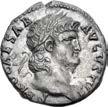
147
617.
AD 68-69. Æ
(35mm, 25.87 g, 6h). Rome mint. Struck circa AD 65. Laureate head right / ROMA R XL, Roma, helmeted and in military dress, standing left, holding statue of Fortuna on globe in right hand and transverse aquila in left, resting left arm on top of trophy and left foot on helmet; at feet to left, a shield. RIC I 451 corr. (Victory on globe); ACG 7a (A15/P22). Green patina, traces of red, areas of roughness and smoothing. VF. Rare with R XL on reverse. ($1000)
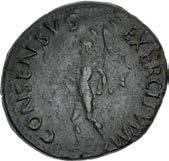
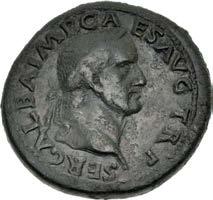
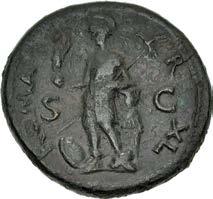

Ex White Mountain Collection (Triton XII, 6 January 2009), lot 565.
The legend R XL stands for remissa quadragesima, celebrating Galba’s repeal of the 2 1/2 percent tax on goods entering Gaul in appreciation of the help which Gaul and Spain had lent him. According to Suetonius (Suetonius Vespasian., 16), that very tax was reimposed by Vespasian shortly thereafter. The statue which Roma holds has been variously described by the major references: RIC calls it Victory, which it cannot be, since the statue has no wings and is holding no wreath; ACG and BN identify the statue as Pax, but Pax is not usually portrayed standing on a globe and typically holds an olive branch and scepter; BMCRE and Cohen identify the statue as Fortuna, which makes the most sense, since Fortuna commonly holds a cornucopia and is depicted in the presence of a globe.

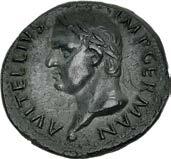
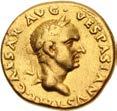
618. Vitellius. AD 69. Æ As (28mm, 9.51 g, 7h). Spanish mint (Tarraco?). Struck January-June. Laureate head left, globe at point of bust / Mars advancing left, holding spear, aquileia, and vexillum. RIC I 40; BMCRE 99-102. Dark green patina, areas of minor roughness. Good VF. Wonderful Spanish-style portrait. ($1000)
Ex White Mountain Collection (Triton XII, 6 January 2009), lot 567; Numismatica Ars Classica N (26 June 2003), lot 1824.
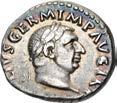
619. Vitellius. AD 69. AR Denarius (18mm, 3.12 g, 6h). Rome mint. Struck circa late April-20 December. Laureate head right / Tripod-lebes surmounted by dolphin right; below, raven perched right. RIC I 109; RSC 111. Lightly toned, lustrous, with iridescence. Good VF. ($500)
From the St. George Collection. Ex Classical Numismatic Group Electronic Auction 156 (17 January 2007), lot 155.
620. Vespasian. AD 69-79. AV Aureus (18mm, 7.03 g, 6h). Uncertain Spanish mint (Tarraco?). Struck circa late AD 6970. Laureate head right / Mars Ultor advancing right, holding transverse spear and trophy over shoulder. RIC II.1 1297; CSB Au-2 (dies A2/Rma3); Calicó 651 (same dies as illustration). Slightly granular surfaces. VF. ($2000)
From the Libertas Collection. Ex Superior (19 August 1975), lot 3062.
148
Galba.
Sestertius
617 618
621.
AD 69-79. AV Aureus (18.5mm, 7.15 g, 5h). Rome mint. Struck January-June AD 70. Laureate head right / Pax seated left, holding olive branch and winged caduceus. RIC II.1 28; Calicó 607a. Granular surfaces, a couple of deposits on obverse. VF. ($3000)
From the Libertas Collection.
622.
AD 69-79. Æ Sestertius (33mm, 23.25 g, 6h). “Judaea Capta” commemorative. Rome mint. Struck AD 71. Laureate head right / Palm tree; to left, bound male captive standing right; to right, Judaea seated right in attitude of mourning; both figures surrounded by arms. RIC II.1 159; Hendin 6530. Green and brown patina, smoothed and tooled. Good VF. ($1500)
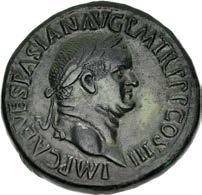
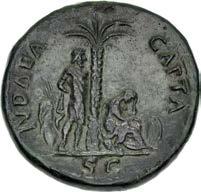
Ex Triton XVII (7 January 2014), lot 665.
623.
AD 69-79. AV Aureus (19mm, 7.25 g, 12h). Rome mint. Struck AD 73. IMP CAES VESP AVG CEN, laureate head right / PAX ΛVG, Pax, draped, standing left, extending winged caduceus in right hand over follis (purse) lying on tripod to left, holding olive branch in left hand, resting left arm on column. RIC II.1 512; Calicó 659; BMCRE 95; BN 80; Biaggi –; Jameson –; Mazzini –. Lustrous, light scratch in field on reverse, some minor hairlines. EF ($10,000)
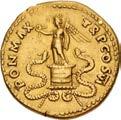
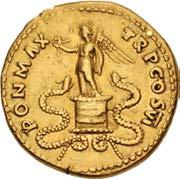
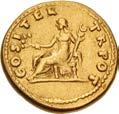
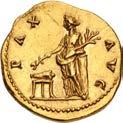
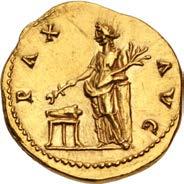
Ex Triton XXIII (14 January 2020), lot 688; Jonathan P. Rosen Collection (Triton XXI, 9 January 2018), lot 733; The New York Sale XXIII (6 January 2010), lot 144; Nomisma 1 (20 February 1993), lot 227.
Ex Vicomte de Sartiges Collection
624. Vespasian. AD 69-79. AV Aureus (19mm, 7.23 g, 6h). Rome mint. Struck AD 75. IMP CΛESΛR VESPΛSIΛNVS ΛVG, laureate head right / PON MAX TR P COS VI, Victory standing left on cista mystica, holding wreath and palm frond; snake erect on either side. RIC II 775; Calicó 665a (same rev. die); D.A. Longuet, Collection du Vicomte De Sartiges, Series Grecque et Romaine (Paris, ca. 1910), pl. XXVI, 105 (this coin). Edge marks, ex-mount. Good VF. ($5000)
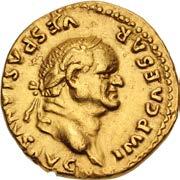
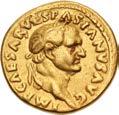
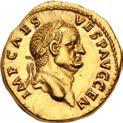
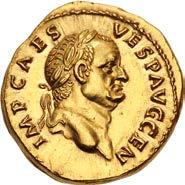
Ex Triskeles 21 (29 September 2017), lot 392; Vicomte de Sartiges Collection (Ars Classica XVIII, 10 October 1938), lot 144.
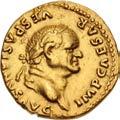
149
Vespasian.
Vespasian.
Vespasian.
625. Divus Vespasian. Died AD 79. AR Denarius (17.5mm, 3.59 g, 6h). Rome mint. Struck under Titus, AD 80-81. Laureate head right / Foreparts of two capricorns, left and right, back to back, supporting round shield; globe below. RIC II.1 357 (Titus); RSC 497. Lustrous. Choice EF. ($500)
Ex Berk BBS 202 (26 October 2017), lot 176; Berk BBS 121 (10 July 2001), lot 326.
626. Titus. As Caesar, AD 69-79. AR Denarius (19mm, 3.31 g, 6h). Rome mint. Struck under Vespasian, July AD 77-December 78. Laureate head right / Sow advancing left with three piglets. RIC II.1 986 (Vespasian); RSC 104. Lightly toned, light porosity. Good VF. ($500)
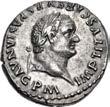
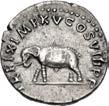

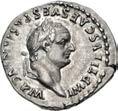
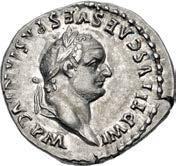
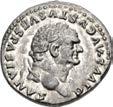
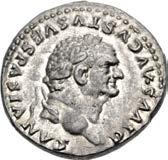
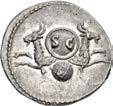
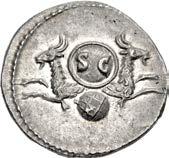
Ex Áureo & Calicó 367 (2 June 2021), lot 2088.
627. Titus. As Caesar, AD 69-79. AR Denarius (16mm, 3.48 g, 4h). “Judaea Capta” commemorative. Antioch mint. Struck under Vespasian, AD 72-73. Laureate and draped bust right / Titus driving triumphal quadriga right, holding scepter, branch, and reins. RIC II 1563; Hendin 1493; RPC 1935; RSC 395. Toned, light golden iridescence, struck on a compact flan, minor porosity and surface marks. Good VF. ($500)
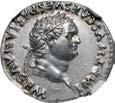
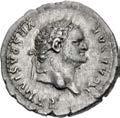
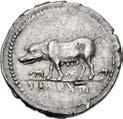
From the DFA Collection. Ex Dipl.-Ing. Adrian Lang Collection (Leu 12, 15 May 2022), lot 1087.
628. Titus. AD 79-81. AR Denarius (17mm, 3.23 g, 6h). “Judaea Capta” commemorative. Rome mint. Struck AD 79, after 1 July. Laureate head right / Male Jewish captive kneeling right below trophy. RIC II.1 49; Hendin 1583b; RSC 295. Attractively toned with golden hues around devices. In NGC encapsulation 6556067-002, graded Ch AU★, Strike: 5/5, Surface: 4/5. ($1000)


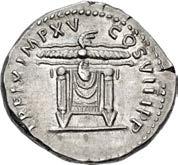
629. Titus. AD 79-81. AR Denarius (17mm, 3.37 g, 5h). Rome mint. Struck 1 January-30 June AD 80. Laureate head right / Elephant walking left on exergual line. RIC II.1 115; RSC 303. Toned, minor marks, slight weakness of strike and small die flaw on reverse. Near EF. ($750)
Ex Berk BBS 202 (26 October 2017), lot 182; Numismatic Fine Arts XXXII (10 June 1993), lot 307.
Titus. AD 79-81. AR Denarius (15.5mm, 3.43 g, 6h). Rome mint. Struck 1 January-30 June AD 80. Laureate head left / Pulvinar (throne) of Jupiter and Juno: square seat, draped and surmounted by winged thunderbolt. RIC II.1 120; RSC 314. Light iridescent toning over residual luster. Near EF. ($500)
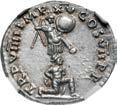
150
630.
626 627 628 629
From the Weise Collection.
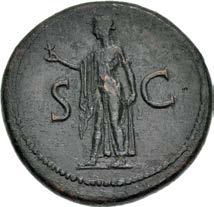
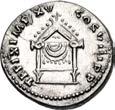
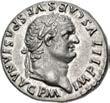
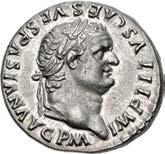
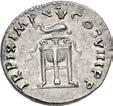
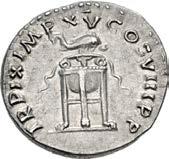
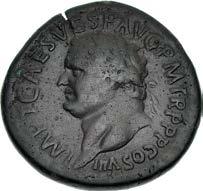

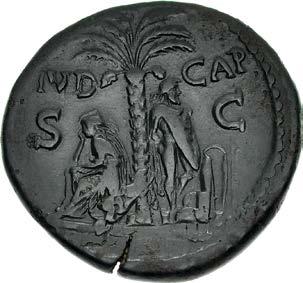
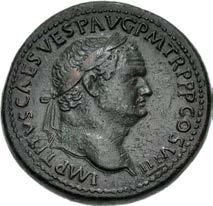
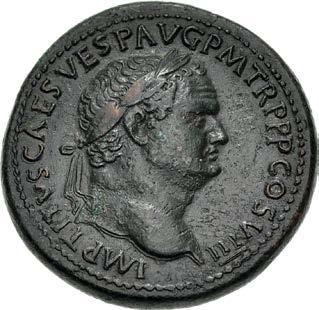
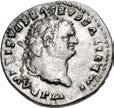
151
631. Titus. AD 79-81. AR Denarius (18mm, 3.47 g, 5h). Rome mint. Struck 1 January-30 June AD 80. Laureate head right / Pulvinar (throne) of Jupiter and Juno: square seat, draped, with tassels: it has a triangular frame on it, on which are three vertical bars on each side and one palmette in center. RIC II.1 124; RSC 313a. Lustrous, small die flaws on reverse. EF. ($500)
632. Titus. AD 79-81. AR Denarius (17mm, 3.57 g, 6h). Rome mint. Struck 1 January-30 June AD 80. Laureate head right / Filleted tripod surmounted by dolphin. RIC II.1 128; RSC 321. Lightly toned with residual luster, minor marks. Good VF. Well centered. ($1000)
Ex Benito Collection.
633. Titus. AD 79-81. Æ Sestertius (33.5mm, 19.68 g, 6h). “Judaea Capta” commemorative. Rome mint. Struck AD 8081. Laureate head left / IVD CAP/ S C in two lines across field, palm tree; to left, Judaea seated left, in attitude of mourning, on pile of arms; to right, male Jewish captive standing right, with hands bound behind back; arms around. RIC II.1 153; Hendin 6624c. Dark green patina, minor flan crack. VF. ($1500)
From the Libertas Collection. Ex Lanz 30 (26 November 1984), lot 491.
634. Titus. AD 79-81. Æ Sestertius (35mm, 28.24 g, 6h). Rome mint. Struck AD 80-81. Laureate head right / Spes advancing left, holding flower and raising hem of skirt. RIC II.1 169. Dark green patina, light porosity. Good VF. Portions of the die engraver’s guide circle remain on the reverse. Rare variant with IMP TITVS instead of IMP T in obverse legend. ($1000)
From the James Fox Collection. Ex James Fox Collection (Classical Numismatic Group 40, with Numismatica Ars Classica, 4 December 1996), lot 1447.
Colosseum Sestertius
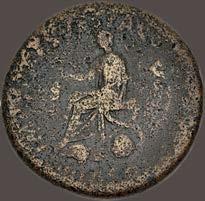
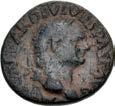
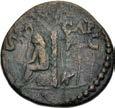
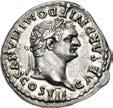
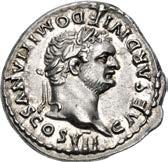
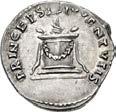
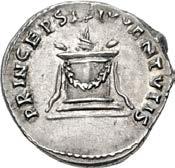
635. Titus. AD 79-81. Æ Sestertius (34mm, 24.17 g, 6h). Rome mint. Struck AD 80-81. View of the Flavian Amphitheater (The Colosseum), seen from aerial perspective; to left, porticus of the Baths of Titus; to right, Meta Sudans; interior dotted with spectators / IMP T CAES VESP AVG P M TR P P P COS VIII, S C across field, Divus Titus seated left on curule chair, holding branch; arms around. RIC II.1 184; Elkins Type B, – (A3/P – unlisted rev. die). Brown surfaces, pitting. Fine. Very rare and of great historical interest. ($7500)
From the Libertas Collection. Ex Dr. John A. Sawhill Collection/James Madison University Foundation (Stack’s, 15 March 1979), lot 800.
This sestertius offers a bird’s eye view of the most famous landmark of ancient Rome. Construction on the Colosseum began in AD 71 during the reign of Vespasian, and dedication ceremonies were held in 75 after the completion of the first three stories. In 80, the remaining two stories were completed, and new dedication ceremonies were conducted in June, celebrated on this sestertius of Titus. Elkins, in his article on these pieces, argues that they were commemorative pieces distributed by Imperial munificence at games held in the Colosseum.
Rare Judaea Capta Semis

Ex
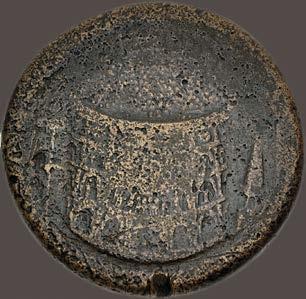
152
636. Titus. AD 79-81. Æ Semis (18mm, 3.41 g, 12h). “Judaea Capta” commemorative. Eastern mint (Thrace?). Struck AD 80-81. Laureate head right / Palm tree; to left, Judaea, veiled and draped, seated left, in attitude of mourning; shields below tree; to right, two upright spears, helmet, and yoke. RIC II.1 504; Hendin 6629; RPC I p. 137 (attributed to Rome). Earthen brown surfaces, cleaning marks, porosity. Good Fine. Very rare denomination in the Judaea Capta series. ($600)
Gemini XI (12 January 2014), lot 415; Classical Numismatic Group 76 (12 September 2007), lot 1432.
637. Domitian. As Caesar, AD 69-81. AR Denarius (19mm, 3.54 g, 6h). Rome mint. Struck under Titus, AD 80-81. Laureate head right / Garlanded and lighted altar. RIC II.1 266 (Titus); RSC 397a. Lovely light toning, lustrous, minor marks. EF. ($500)
638. Domitian. As Caesar, AD 69-81. AR Denarius (18mm, 3.50 g, 6h). Rome mint. Struck under Titus, AD 80-81. Laureate head right / Pulvinar (throne) of Minerva: crested Corinthian helmet set on draped square seat. RIC II.1 271 (Titus); RSC 399a. Lightly toned, underlying luster, light scrape on reverse. EF. ($500)
Ex San Vicente Collection.
639. Domitian. AD 81-96. AV Aureus (19mm, 7.83 g, 5h). Rome mint. Struck AD 82. IMP CΛES DOMITIΛNVS ΛVG P M, laureate head right / TR POT IMP II COS VIII DES VIIII P P, cuirassed bust of Minerva left, wearing crested Corinthian helmet and aegis; transverse scepter over right shoulder. RIC II.1 137; Calicó 936. Minor marks, some luster remains. Good VF. Excellent portraits. Very rare. ($7500)
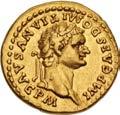
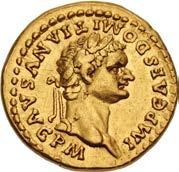
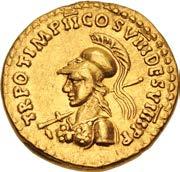
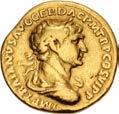
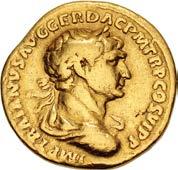
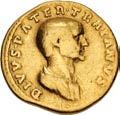
From the Libertas Collection.
Ex Mazzini Collection – Published in 1957
640. Trajan, with Trajan Pater. AD 98-117. AV Aureus (19mm, 7.17 g, 7h). Rome mint. Struck circa mid AD 112-spring 113. IMP TRAIANVS AVG GER DAC P M TR P COS VI P P, laureate, draped, and cuirassed bust of Trajan right / DIVVS • PATER • TRAIANVS, bareheaded and draped bust of Trajan the Elder right. RIC II 763; Beckmann, Early, Group I (dies a3/ P2); Woytek 408f3 (same dies); Strack 214 (same dies as illustration); Calicó 1135; BMCRE 505-8; BN 691-2 (same dies); Biaggi 460; Jameson 98; Mazzini 2 (this coin). Minor marks. Good Fine. Rare. ($5000)
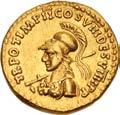
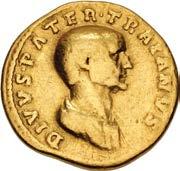
From the Libertas Collection. Ex Lanz 34 (25 November 1985), lot 533; Giuseppe Mazzini Collection (publ. 1957).
641. Plotina. Augusta, AD 105-123. AR Denarius (19mm, 3.76 g, 6h). Rome mint. Struck under Trajan, AD 112-summer
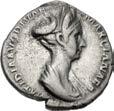
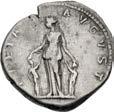
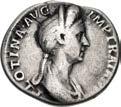


114. Draped bust right, wearing hair bunched high in front and held in position by a double stephane, hair elaborately waved at back and falls down in a queue / Vesta seated left on chair without back, holding palladium and scepter. RIC II 730 (Trajan); Woytek 705-1; RSC 3. Toned, minor porosity, deposits in recesses. Near VF. Rare. ($1000)
From the CJR Collection. Ex Tony Hardy Collection (Classical Numismatic Group 67, 22 September 2004), lot 1448.
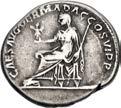
642. Matidia. Augusta, AD 112-119. AR Denarius (18mm, 3.22 g, 6h). Rome mint. Struck under Trajan, AD 112-117. Draped bust right, wearing stephane / Pietas standing left, placing hands on heads of two children, Sabina and Matidia, who stand on either side, raising hands to her. RIC II 759 (Trajan); Woytek 729; RSC 10. Lightly toned, edge split, light porosity and marks. Near VF. ($1000)
From the CJR Collection.
153
641 642
643. Hadrian. AD 117-138. Æ Sestertius (33.5mm, 26.75 g, 12h). “Travel series” issue. Rome mint. Struck circa AD 130-133. Bareheaded and draped bust left / AFRICA, S C in exergue, Africa, wearing elephant skin headdress, reclining left on rock, holding scorpion and cornucopia; basket of grain ears at feet. RIC II.3 1612; Banti 93. Green-brown patina, light marks. VF. Very rare with left facing bust, only three known to Banti, two in CoinArchives. ($750)
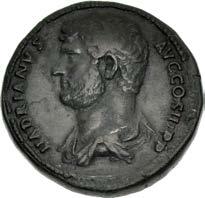
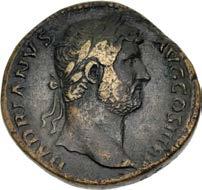
From the Libertas Collection.
644. Hadrian. AD 117-138. Æ Sestertius (33mm, 26.82 g, 6h). “Travel series” issue. Rome mint. Struck circa AD 130133. Laureate head right / BRITANNIA, S C in exergue, Britannia seated slightly left on rocks, drawing hood of her birrus Britanicus and holding spear over her knee; her right foot set on rocks; to right, a large shield with spike at center rests against her. RIC II.3 1631; Banti 115; SCBC 637. Brown patina, roughness at the periphery. Near VF. Very rare, only four known to Banti, three in CoinArchives. ($2000)
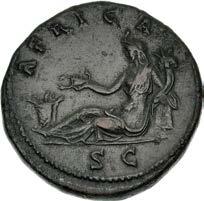
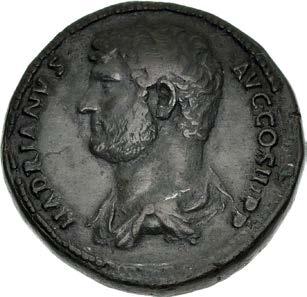
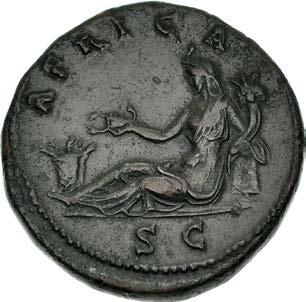
From the Libertas Collection. Ex Sotheby’s (5 October 1989), lot 155; Glendining’s (11 December 1974), lot 231.
645. Antoninus Pius. AD 138-161. AV Aureus (18.5mm, 6.83 g, 6h). Rome mint. Struck AD 138. Bareheaded and draped bust right / Pietas standing left, raising hand over altar set on ground to left and holding acerra (incense box). RIC III 14b; Calicó 1478 (same obv. die as illustration); Biaggi –. A few light marks, residual luster. VF. ($2000)
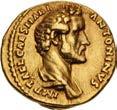
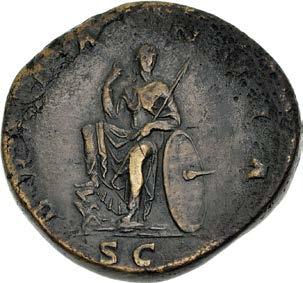
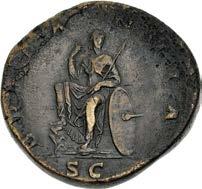
646. Antoninus Pius. AD 138-161. AV Aureus (18mm, 6.78 g, 6h). Rome mint. Struck circa AD 141-143. Laureate, draped and cuirassed bust right / Jupiter, naked, standing facing, holding vertical scepter and thunderbolt. RIC III 72c; Calicó 1552 (same dies as illustration); Biaggi –. Small lamination flaw on reverse. Near EF. Very rare. ($2500)

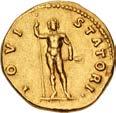

154
645
646
From the Libertas Collection, purchased from Harlan J. Berk, December 1986. The scene in which the emperor makes liberal distributions to citizens is known as a congiarium. This distribution can be thought of as an ancient version of the modern “stimulus check,” as recently offered by the U.S. government in the form of pandemic
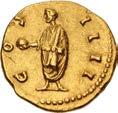

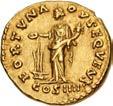
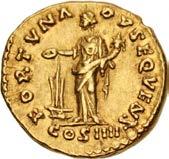


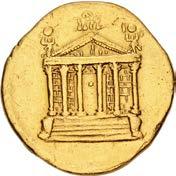
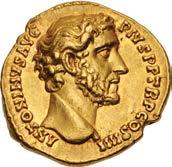

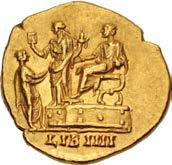
The Temple of Diva Faustina
From the Libertas Collection, purchased 4 April 1984.

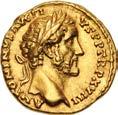

155
647. Antoninus Pius. AD 138-161. AV Aureus (18mm, 7.15 g, 6h). Rome mint. Struck AD 147. Bare head right / Antoninus Pius, togate, seated left on curule chair on platform, extending right hand and holding volumen in left; to left, Liberalitas standing left, holding abacus and cornucopia; on ground to left, citizen, togate, standing right, holding out fold of toga with both hands to receive distribution. RIC III 141a; Calicó 1570 (same dies as illustration); Biaggi 739 (same dies as illustration); Adda 195 (same dies as illustration). Underlying luster, small edge chip. Near EF. ($5000)
relief.
648. Antoninus Pius. AD 138-161. AV Aureus (18.5mm, 7.17 g, 6h). Rome mint. Struck AD 154-155. Laureate head right / Antoninus Pius standing left, holding globe and volumen. RIC III 241; Calicó 1531a; Biaggi 721. Edge marks. Good VF. ($2500)
649. Antoninus Pius. AD 138-161. AV Aureus (18mm, 7.35 g, 6h). Rome mint. Struck AD 159. Laureate bust right, draped left shoulder / Fortuna standing left, holding patera and cornucopia; to left, rudder set on prow. RIC III 286b; Calicó 1540 (same dies as illustration); Biaggi –. Minor marks, residual luster. Near EF. Extremely rare, only one specimen in CoinArchives. ($3000)
650. Diva Faustina Senior. Died AD 140/1. AV Aureus (18.5mm, 6.80 g, 6h). Rome mint. Struck under Antoninus Pius, AD 143-144. Draped bust right, wearing hair bound in pearls on top of her head / Hexastyle Temple of Diva Faustina on five steps; in center above, facing quadriga; on corners, sculptures. RIC III 406B (Pius); Beckmann dies daf25/T– [unlisted rev. die]; Calicó 1741 (same dies as illustration); BMCRE p. 51, ǁa; Adda –; Biaggi –; Jameson –; Mazzini –. Minor marks. VF. Very rare. None in Coin Archives and the reverse die not represented in Beckmann’s exhaustive study. ($3000)
651. Diva Faustina Senior. Died AD 140/1. AV Aureus (19.5mm, 7.04 g, 6h). Rome mint. Struck under Antoninus Pius, circa AD 146-161. Draped bust right, wearing hair bound in pearls on top of her head / Juno standing left, raising hand and holding scepter. RIC III 365 (Pius); Beckmann dies df11/AG2; Calicó 1769a (same rev. die as illustration). Some scratches. Good VF. ($2000)
Ex Levis Collection – Pedigreed to 1925
652. Diva Faustina Senior. Died AD 140/1. Æ Sestertius (29mm, 19.93 g, 12h). Rome mint. Struck under Antoninus Pius, circa AD 146-161. Draped bust right, wearing pearls bound on top of her head / Vesta standing left, holding long torch and palladium with shield. RIC IV 1151 (Pius); Banti 101. Dark green patina, minor smoothing. VF. ($750)
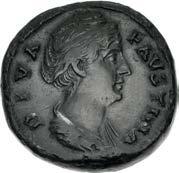
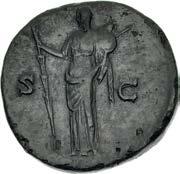
From the Libertas Collection. Ex H. C. Levis Collection (Ars Classica XI, 18 June 1925), lot 599.
Fine Style Diva Faustina
653. Diva Faustina Senior. Died AD 140/1. AV Aureus (20mm, 7.28 g, 6h). Rome mint. Struck under Antoninus Pius, AD 150-161.
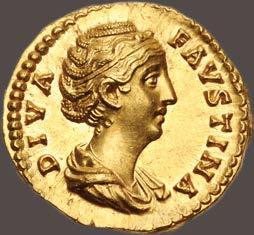
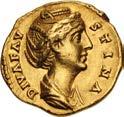
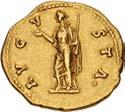

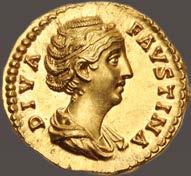
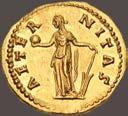
From the Willamette Valley Collection. Ex Tauler and Fau 50 (5 February 2020), lot 234; Roma XVIII (29 September 2019), lot 1168; Triton XXII (8 January 2019), lot 1101; Numismatica Ars Classica 106 (9 May 2018), lot 964; PML Collection (Numismatica Ars Classica 100, 29 May 2017), lot 504.

156
DIVA FAVSTINA, draped bust right, wearing hair bound in pearls on top of her head / AETE R NITAS, Aeternitas standing left, holding globe in outstretched right hand and rudder set on ground in left. RIC III 348; Beckman dies Df31/AB6; Calicó 1747 (same dies as illustration); BMCRE 359 (Pius); Adda 239; Mazzini 5. Fully lustrous and fine style, some insignificant scratches and very small dig on reverse. Superb EF. ($15,000)
From
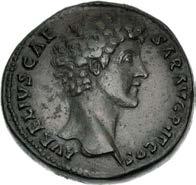
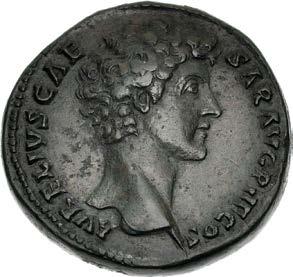
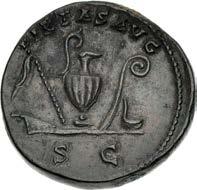
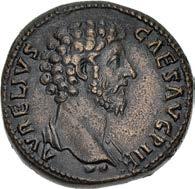
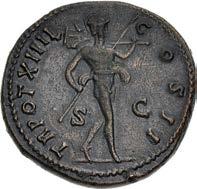
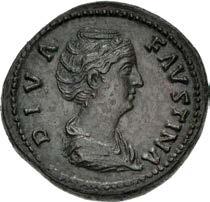
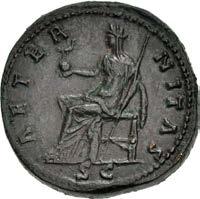
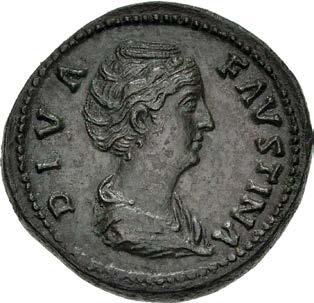
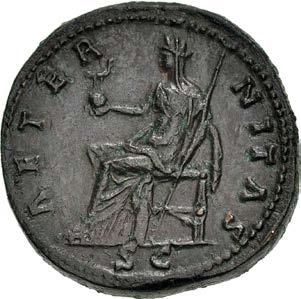
157
654. Diva Faustina Senior. Died AD 140/1. Æ Sestertius (34mm, 26.19 g, 11h). Rome mint. Struck under Antoninus Pius, circa AD 150-late 150s. Draped bust right, wearing hair bound in pearls on top of her head / Aeternitas seated left, holding phoenix on globe and scepter. RIC III 1103A (Pius); Banti 7 var. (arrangement of obv. legend). Dark brown and green patina, smoothing in fields. Near EF. ($1000)
Ex Triton IV (5 December 2000), lot 570; Leu 20 (25 April 1978), lot 327 (hammer CHF 2100).
655. Marcus Aurelius. As Caesar, AD 139-161. Æ Sestertius (32mm, 26.27 g, 12h). Rome mint. Struck under Antoninus Pius, AD 140-144. Bare head right / Emblems of the pontificate: secespita, aspergillum, guttus, lituus, and simpulum. RIC III 1234a (Pius); Banti 230. Attractive, mottled green and brown patina. Near EF. Portrait of artistic merit. ($750)
Ex Jonathan K. Kern Collection.
656. Marcus Aurelius. As Caesar, AD 139-161. Æ Sestertius (32mm, 24.33 g, 11h). Rome mint. Struck under Antoninus Pius, AD 159-160. Bareheaded bust right, slight drapery / Mars advancing right, holding spear and trophy over shoulder. RIC III 1352Aa (Pius); Banti 383. Brown patina, minor roughness, some shallow cleaning marks. Good VF. ($500)
the W. Toliver Besson Collection. Ex Gemini VIII (with Heritage, 14 April 2011), lot 350.
Pedigreed to 1969
From the Libertas Collection, purchased 2 November 1982. Ex Coin Galleries (25 November 1969), lot 1409.
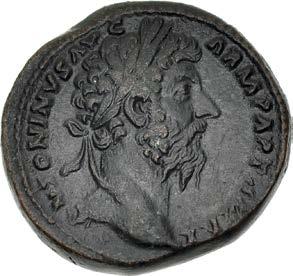
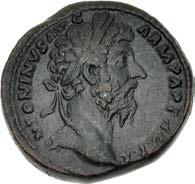
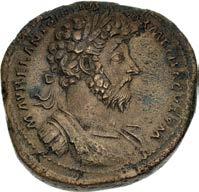
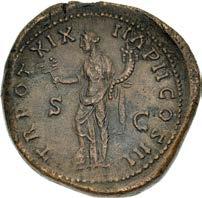
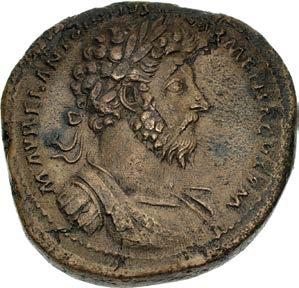
Banti Plate Coin – Pedigreed to 1914
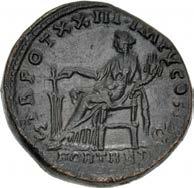
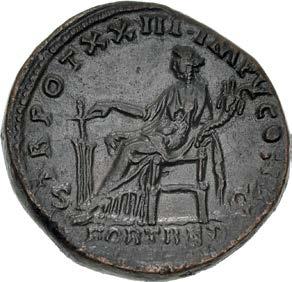
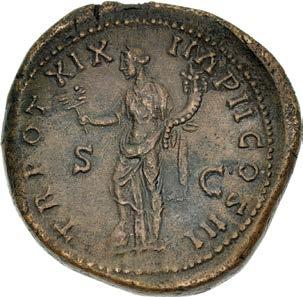
Ex Dupriez 115 (20 April 1914),
357.
158
657. Marcus Aurelius. AD 161-180. Æ Sestertius (33mm, 25.48 g, 11h). Rome mint. Struck AD 165. Laureate, draped, and cuirassed bust right / Felicitas standing left, holding caduceus and cornucopia, foot on globe. RIC III 902; MIR 18, 996/38; Banti 413. Brown patina, flan flaw on obverse. Good VF. ($500)
658. Marcus Aurelius. AD 161-180. Æ Sestertius (32mm, 26.01 g, 6h). Rome mint. Struck AD 169. Laureate head right / Fortuna seated left, holding rudder and cornucopia. RIC III 962; MIR 18, 178-6/30; Banti 87 (this coin illustrated and referenced). Attractive brown patina. Good VF. ($500)
lot
Ex Sir Arthur J. Evans Collection – Pedigreed to 1934
From the Libertas Collection, purchased 10 November 1985. Ex Sir Arthur J. Evans Collection (Ars Classica XVII, 3 October 1934), lot 1473. The year AD 173 provides the occasion for a major issue of coins commemorating the subjugation of the Germanic tribes.
around and rising from altar,
chair. RIC III 1667 (Aurelius); MIR 18, 30-6a; Banti 104. Attractive dark green patina, some pitting. EF. ($500)
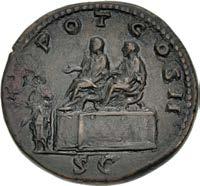
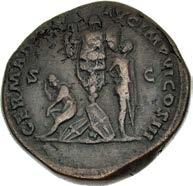
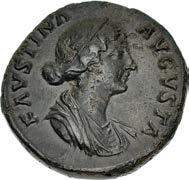
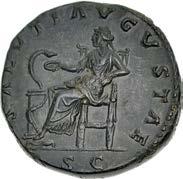
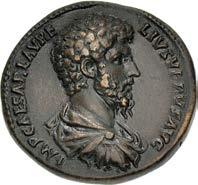
on
Ex Triton XII (5 January 2009), lot 641.
Apparently Unique Transitional Sestertius
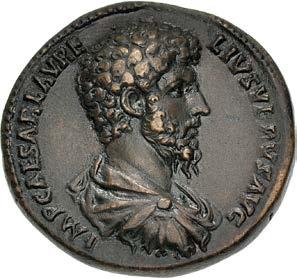
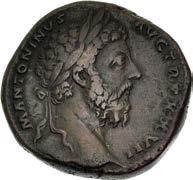
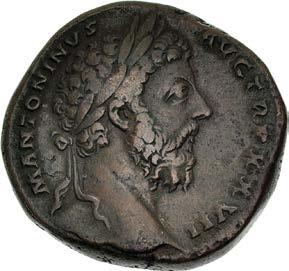

Ex Rye Collection (Classical Numismatic Group 112, 11 September 2019), lot 633 (hammer
The longer obverse legend was used only in the first emission, according to Szaivert, in MIR 18. He does not list this reverse legend and type until the second emission. Thus, this is likely from the very first phase of the second emission, as it still retains the obverse legend of the first emission.
159
659. Marcus Aurelius. AD 161-180. Æ Sestertius (32mm, 25.71 g, 6h). Rome mint. Struck AD 173. Laureate head right / Trophy; on left, German woman seated left on shields; on right, German man standing right, head left, hands bound behind him; on ground, a shield. RIC III 1062 var. (S C in exergue); MIR 18, 255-6/30; Banti 102 (this coin); BMCRE 1434. Brown patina. VF. Very rare with S C across field. ($750)
660. Faustina Junior. Augusta, AD 147-175. Æ Sestertius (31mm, 21.51 g, 11h). Rome mint. Struck under Marcus Aurelius, AD 161-164. Draped bust right / Salus seated left, feeding out of patera a serpent coiled
resting arm
side of
661. Lucius Verus. AD 161-169. Æ Sestertius (32.5mm, 22.77 g, 12h). Rome mint. Struck AD 161. IMP CAESAR L AVRELIVS VERVS AVG, bareheaded, draped, and cuirassed bust right / TR POT COS II, S C in exergue, Marcus Aurelius and Lucius Verus seated left on sella castrensis set on platform; below, on left, officer standing left, holding baton and spear. RIC III 1307 var. (shorter obv. legend); MIR 18, 13-16/17 var. (same); Banti 106 var. (same). Brown patina, a rough patch on reverse. Good VF. Medallic high relief portrait. Apparently unique. ($1500)
$3000).
Rome Grants Armenia a King
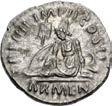
662. Lucius Verus. AD 161-169. AV Aureus (19mm, 7.35 g, 6h). Rome mint. Struck AD 164. • L • VERVS ΛVG ΛRMENIΛCVS, laureate, draped, and cuirassed bust right / TR P IIII IMP II COS II, REX ΛRMEN/ DΛT in two lines in exergue, Lucius Verus, in military dress, seated left on curule chair set on raised daïs; to left, a soldier, holding spear in right hand over right shoulder, looking right; on right, an officer standing left; in front of daïs to left, the Roman-appointed Armenian king, Sohaemus, standing left, raising hand to head. RIC III 511; MIR 18, 92-12/17; Calicó 2151 (same obv. die as illustration); BMCRE 300-301 var. (bust type, Aurelius and Verus); Biaggi 955 var. (same); Mazzini 157. Underlying luster, minor marks, ex-mount. Near EF. ($5000)
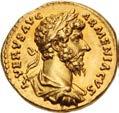
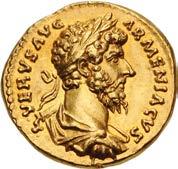
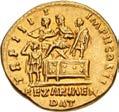
The reverse records the re-installation of Gaius Julius Sohaemus as king of Armenia. Sohaemus, a member of the royal household of the Syrian caravan city of Emesa, was originally crowned as king by Antoninus Pius in AD 144, an event also recorded on that emperor’s coins. In AD 161, the Parthians invaded Armenia and drove him into exile. An offensive led by Verus cleared out the Parthians and re-established the pro-Roman regime of Sohaemus, who is seen here receiving his crown. The exceptional artistry of the obverse portrait, together with the complex reverse composition, marks this as a special issue celebrating Verus’s feat of arms.
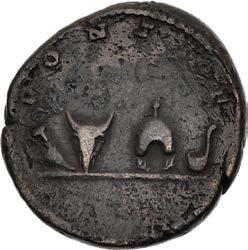
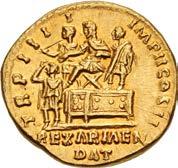
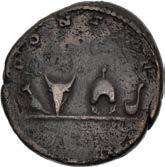
663. Lucius Verus. AD 161-169. AR Denarius (17.5mm, 3.50 g, 6h). Rome mint. Struck AD 164. Bareheaded and cuirassed bust right / Armenia seated left on ground in attitude of mourning; shield and vexillum to left, bow and quiver to right. RIC III 509 var. (bust type); MIR 18, 69-14/15; RSC 8 var. (same). Lightly toned, underlying luster, traces of green deposits on obverse. EF. Rare bust variety. ($500)
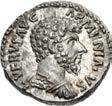
Ex Künker 262 (13 March 2015), lot 8116.
Very Rare Commodus Medallion
664. Commodus. As Caesar, AD 166-177. Æ Medallion (27mm, 13.27 g, 12h). Rome mint. Struck under Marcus Aurelius, AD 175. Bareheaded, draped, and cuirassed bust right / Emblems of the pontificate: secespita, bucranium, apex, and simpulum. Gnecchi III, p. 38, 202, pl. 152, 4; MIR 18, 1065-1/13; Banti –. Brown surfaces, minor marks, roughness, hairline flan crack. VF. Very rare. ($500)
From the Libertas Collection. Ex Müller 17 (23 April 1976), lot 270. The reverse type celebrates Commodus becoming a member of the Pontifical College, the highest college of priests.
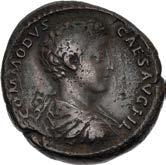
160
Ex Platt Hall and Weber Collections – Pedigreed to 1893
665.
(29.5mm, 24.87 g, 12h). Rome mint. Struck with Marcus Aurelius, AD 178. Laureate and cuirassed bust right / Commodus standing left, sacrificing out of patera over tripod-altar in center and holding scepter at side; on left, victimarius standing front, head right, raising ax to strike bull standing right with lowered head. RIC III 1595 (Aurelius); MIR 18, 428-16/35; Banti 508. Dark gray patina, smoothing. Good VF. Rare. ($750)
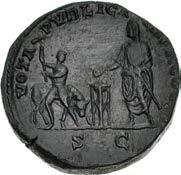
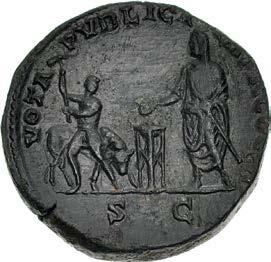
From the Libertas Collection, purchased 5 October 1986. Ex Henry Platt Hall Collection (Part II, Glendining, 16 November 1950), lot 1628; Sir Hermann D. Weber Collection (Sotheby, Wilkinson and Hodge, 29 June 1893), lot 198.
Very Rare Commodus Medallion
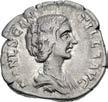
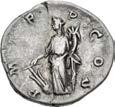
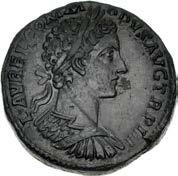
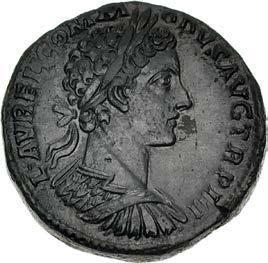
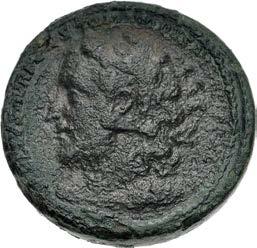
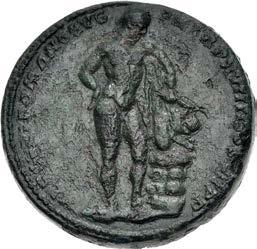
(42mm, 71.36 g, 11h). Rome mint. Struck AD 192. Head of Commodus as Hercules left, wearing lion skin headdress / Hercules laureate with features of Commodus, nude to right, right hand on hip and bow in left. With his armpit he leans on the club, around which the skin of a lion can be seen, and which rests on a pile of rocks. Gnecchi II p.55, 33 and pl. 80, 5/p. 54, 29 and pl. 80, 2 (for obv./rev. types); MIR 18, 1163-2/73; Banti 109; Vermeule, Roman, 45. Green and brown patina, corrosion on obverse, smoothing in the fields on reverse. Near VF. Very rare. ($4000)
666.
From the W. Toliver Besson Collection.
667
From the CJR Collection.
668.
Augusta, AD 193. AR Denarius (17mm, 3.15 g, 12h). Rome mint. Struck under Didius Julianus. Draped bust right / Juno standing left, holding patera and scepter; at feet, peacock standing left. RIC 7a (Julianus); RSC 2. Attractive
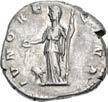
From the CJR Collection.
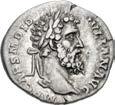
161
Commodus. AD 177-192. Æ Sestertius
Commodus. AD 177-192. Bimetallic Medallion
667. Didius Julianus. AD 193. AR Denarius (18mm, 2.78 g, 12h). Rome mint. Laureate head right / Fortuna standing left, holding rudder on globe and cornucopia. RIC IV 2; RSC 10. Toned, a couple of short edge splits. VF. ($1000)
Manlia Scantilla.
light toning. VF. ($1000)
668
From the CJR Collection.
670. Clodius Albinus. AD 195-197. AR Denarius (17mm, 3.81 g, 12h). Lugdunum (Lyon) mint. 2nd emission. Laureate head right / clasped right hands, holding aquila, the eagle perched on thunderbolt. RIC IV 20b, pl. II, 19 (same dies as illustration); Lyon 23/3 (D49/R50); RSC 24. Toned. Near EF. ($500)
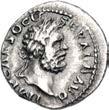
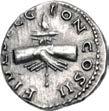

From the Libertas Collection.
Extremely Rare and Historical Aureus The Peoples of Arabia and Adiabene
scratches and test cuts. Near EF. Exceedingly rare and missing from most of the greatest collections. ($10,000)
Ex Classical Numismatic Group 114 (13 May 2020), lot 926.
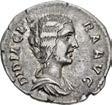
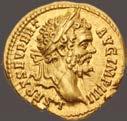
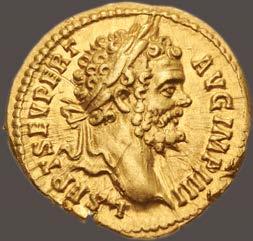
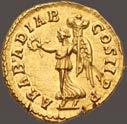
Adiabene and Scenite Arabia were small buffer states between the Roman and Parthian Empires, nominally allied to the Parthians. Adiabene, located east of the Roman client kingdom of Osrhoene, was ethnically diverse, with a substantial Jewish population. The Scenite (“tent dwelling”) Arabs occupied another part of Mesopotamia. During the Roman civil war of AD 193-194 between Septimius Severus and Pescennius Niger, both principalities seized on the opportunity to enlarge their kingdoms at the expense of Roman client states. After Severus defeated and killed Niger in May of 194, he lingered in Syria the rest of the year, meting out punishment to cities and regions who had supported Niger and rewarding those who had shown loyalty to the Severan cause. Wintering at Antioch, Severus entertained embassies from the Adiabeni and Scenite Arabs, who protested that they had only attacked Roman possessions that had backed Niger. Severus rejected these entreaties and, early in AD 195, marched his army into Mesopotamia, formally annexed Osrhoene, and attacked in quick succession the Adiabeni and Scenite Arabs. He easily overcame both and assumed the titles Parthicus Arabicus and Parthicus Adiabenicus, which are preserved on this extremely rare aureus type, as well as on the Arch of Severus in Rome. The curious reference to “Parthicus” in each acclamation acknowledges that both of these peoples were Parthian vassals, without overtly claiming a victory over the Parthians themselves (this would come in a subsequent campaign). Severus struck silver denarii and gold aurei celebrating these titles with two main reverse types: Two captives bound at the base of a trophy, and, as seen here, Victory advancing with wreath and trophy. Denarii are known from Rome, Alexandria and Laodicea; the much rarer aurei are only recorded from Rome.
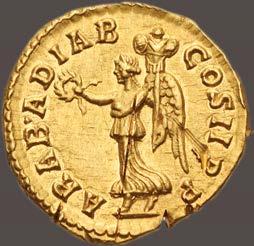
162
669. Didia Clara. Augusta, AD 193. AR Denarius (17.5mm, 2.99 g, 6h). Rome mint. Struck under Didius Julianus. Draped bust right / Hilaritas standing left, holding long palm frond and cornucopia. RIC IV 10 (Julianus); RSC 3. Attractively toned. Good VF. ($1000)
671. Septimius Severus. AD 193-211. AV Aureus (20mm, 7.38 g, 12h). Rome mint. Struck AD 194-195. L SEPT SEV PERT AVG IMP IIII, laureate head right / ARAB • ADIAB COS II P P, Victory, winged and draped, advancing left, holding wreath in right hand and trophy in left. RIC IV 41; Calicó 2433 (same obv. die as illustration); BMCRE p. 33, note †; Biaggi –; Jameson –; Mazzini –; Santamaria (20 November 1920), lot 895 (same obv. die); NAC 71, lot 247 (same obv. die; hammer 75,000 CHF). Some
669 670
From the Libertas Collection.
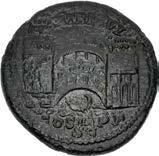
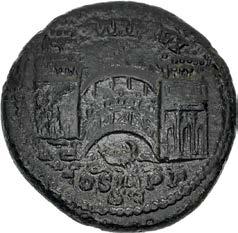
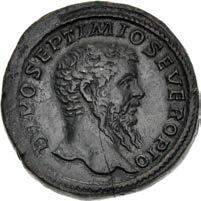

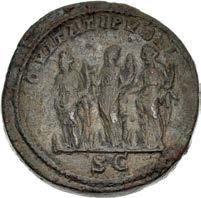
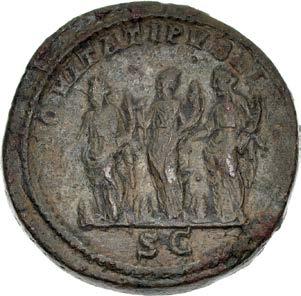
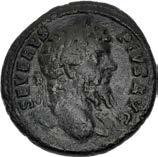
This
Spectacular Bridge Reverse
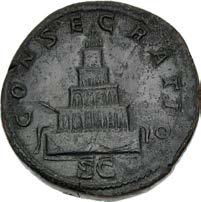
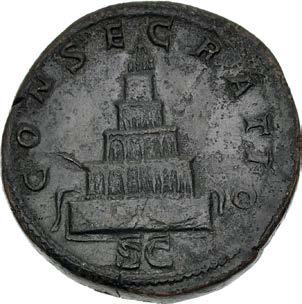
163
672. Septimius Severus. AD 193-211. Æ As (26mm, 9.89 g, 6h). Rome mint. Struck circa AD 208. Laureate bust right, wearing aegis / Bridge with curved side and curved roof, with four pillars above; on bridge, five figures–heads and shoulders showing; below, boat on river: at each end of bridge, triumphal arch with three arches below and groups of statuary on top. RIC IV 786b; BMCRE 857 var. (bust type); Hill 203; Mazzini 523 (same obv. die); cf. Gorny & Mosch 265, lot 1402 (hammer €1800). Brown patina, smoothing. VF. Very rare. ($1500)
rare coin copies the Danubian bridge type of Trajan (RIC II 569), and is possibly the bridge over the Firth of Forth, built for Severus’ Scottish campaigns.
673. Divus Septimius Severus. Died AD 211. Æ Sestertius (33mm, 29.47 g, 12h). Consecration issue. Rome mint. Struck under Caracalla and Geta, AD 211. Bareheaded and bearded head right / Five-tiered funeral pyre: lowest tier draped, the other four tiers arched with statues; uppermost tier surmounted by triumphal quadriga. RIC IV 490B (Caracalla); Banti 20. Brown patina, areas of porosity, smoothing, hairline flan crack. VF. ($750)
From the Libertas Collection, purchased 16 December 1982.
674. Julia Domna. Augusta, AD 193-217. Æ Sestertius (32.5mm, 28.74 g, 12h). Rome mint. Struck under Septimius Severus, circa AD 207-211. Draped bust right / The three Monetae standing facing, heads left, each holding cornucopia and scale above a stack of coins at their feet. RIC IV 847 (Septimius); Banti 1. Green-brown patina, some red, hairline flan crack. VF. ($1000)
From the Libertas Collection.
Founder of Rome
probably be considered minor brush marks in the fields. Superb EF. ($10,000)
From the Willamette Valley Collection. Ex Brexit Collection (Classical Numismatic Group 111, 29 May 2019), lot 769.
This reverse type depicting Severus Alexander as Romulus can be seen to have both past and future iconographic significance when it was struck circa AD 230. Since he was required to conduct campaigns against both the Sassanians and Germanic tribes for the well-being of the empire, a likening to Romulus is obvious. As the 1,000th anniversary of the founding of the city lay only 17 years away, however, a similar reference to Rome’s legendary founder also seems appropriate.
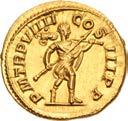
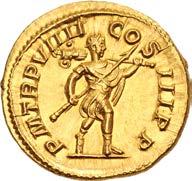

Outstanding Severus Alexander Sestertius
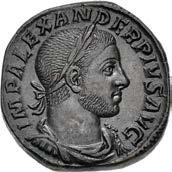
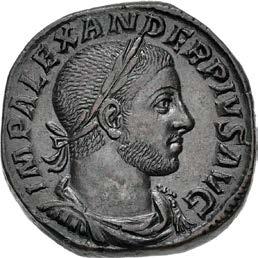
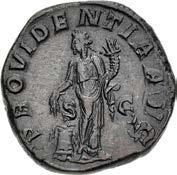
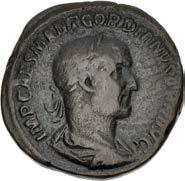
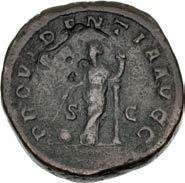
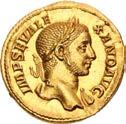
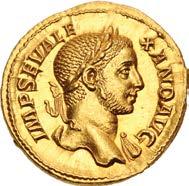
164
675. Severus Alexander. AD 222-235. AV Aureus (20mm, 6.48 g, 7h). Rome mint. 11th emission, AD 230. IMP SEV ALE XAND AVG, laureate bust right, slight drapery / P M TR P VIIII CO S III P P, Severus Alexander, as Romulus, in military dress, advancing right, holding transverse spear in right hand and trophy over left shoulder in left. RIC IV 103; Calicó 3121 (same dies as illustration); BMCRE 620; Biaggi 1330 (same dies). Fine style, under high magnification what would
676. Severus Alexander. AD 222-235. Æ Sestertius (28mm, 21.56 g, 12h). Rome mint. 15th emission, AD 232. Laureate, draped, and cuirassed bust right / Providentia standing left, holding cornucopia and grain ears over modius filled with grain ears. RIC IV 642; BMCRE 881; Banti 148. Dark brown patina, some red. EF. Fine style portrait. Exceptional. ($500)
677. Gordian I. AD 238. Æ Sestertius (30.5mm, 23.85 g, 12h). Rome mint. Struck 1-22 April. Laureate, draped, and cuirassed bust right / Providentia standing left, legs crossed, holding wand over globe and cornucopia, resting arm on column. RIC IV 9; BMCRE 5-6; Banti 4. Dark green and brown patina, a few flan flaws on reverse. Near VF. ($1500)
From the CJR Collection.
678. Gordian II. AD 238. AR Denarius (21mm, 3.25 g, 5h). Rome mint. Struck 1-22 April. Laureate, draped, and cuirassed bust right / Providentia standing left, legs crossed, holding wand over globe and cornucopia, resting arm on column. RIC IV 1; BMCRE 19-20; RSC 5. Light tone, short edge split, a couple of tiny flan flaws on obverse. Superb EF. Well struck on a broad flan. ($2000)
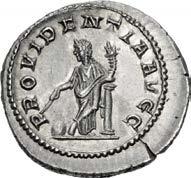
From the Quietus Collection. Ex Nomos Obolos 7 (9 July 2017), lot 398 (hammer CHF 3800).
679. Gordian II. AD 238. Æ Sestertius (28mm, 14.96 g, 11h). Rome mint. Struck 1-22 April. Laureate, draped, and cuirassed bust right / Roma seated left on throne, holding Victory and scepter; oval shield in front of throne. RIC IV 5; BMCRE 23-6; Banti 4. Green and brown surfaces, smoothing. Near VF. ($1000)
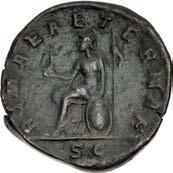
From the CJR Collection.
680. Pupienus. AD 238. AR Denarius (19mm, 2.98 g, 6h). Rome mint. 1st emission. Laureate, draped, and cuirassed bust right / Pax seated left on throne, holding olive branch and scepter. RIC IV 4; BMCRE 46-7; RSC 22. Lightly toned, some underlying luster remains, a few tiny green deposits. EF. Wonderful portrait. ($500)
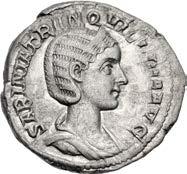

From the James Fox Collection. Ex James Fox Collection (Classical Numismatic Group 40, with Numismatica Ars Classica, 4 December 1996), lot 1627; Classical Numismatic Auctions VII (4 May 1989), lot 393.
681. Pupienus. AD 238. AR Denarius (20mm, 3.17 g, 6h). Rome mint. 1st emission. Laureate, draped, and cuirassed bust right / Pupienus standing left, holding branch and parazonium. RIC IV 5; BMCRE 50; RSC 29. Light golden tone. Near EF. Attractive in hand. ($500)
From the CJR Collection.
682. Gordian III. As Caesar, AD 238. AR Denarius (22mm, 3.05 g, 6h). Rome mint. 1st emission of Balbinus & Pupienus. Bareheaded and draped bust right / Emblems of the pontificate: lituus, secespita, guttus, simpulum, and aspergillum. RIC IV 1; BMCRE 62-3 (Balbinus & Pupienus); RSC 182 corr. (no patera). Lightly toned. EF. Well struck on a broad flan. ($750) Ex Pecunem 7 (Gitbud & Naumann, 1 September 2013), lot 398.
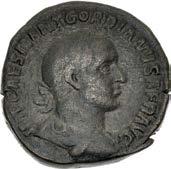
Rare Tranquillina Denarius
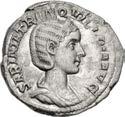
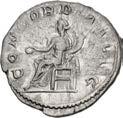
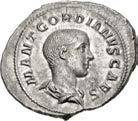
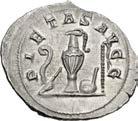
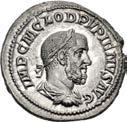
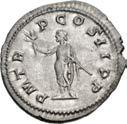
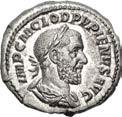

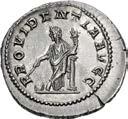
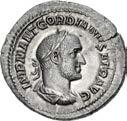

165
680 681 682
683. Tranquillina. Augusta, AD 241-244. AR Denarius (20mm, 2.84 g, 6h). Rome mint. Special emission of Gordian III, mid AD 243. Draped bust right, wearing stephane / Concordia seated left on throne, holding patera and double cornucopia. RIC IV 252 (Gordian III); RSC 1a. Lightly toned, underlying luster, slightly granular surfaces. Good VF. Rare. ($2500)
Pedigreed to 1956
684. Valerian II. Caesar, AD 256-258. Æ As (23.5mm, 7.85 g, 6h). Rome mint. 2nd-5th issue, AD 256-8. Bareheaded and draped bust right / Emblems of the pontificate: lituus, secespita, patera, guttus, simpulum, and aspergillum. RIC V 36; MIR 36, 248v. Green-brown patina. VF. ($500)
From the Libertas Collection. Ex Münzen und Medaillen AG FPL 155 (March 1956), no. 65.
685. Macrianus. Usurper, AD 260-261. AR Antoninianus (18mm, 3.90 g, 12h). Samosata mint. 2nd emission. Radiate and cuirassed bust right / Sol standing left, hand raised and holding globe; *|–//–. RIC V 12 (Antioch); MIR 44, 1741k; RSC 12a. Lightly toned, small flan flaw on obverse. EF. Unusually high quality silver. The reverse struck with a fresh die. ($500)
From the DFA Collection. Ex Leu Web Auction 18 (18 December 2021), lot 3233.
686. Laelianus. Romano-Gallic Usurper, AD 269. Antoninianus (19mm, 2.68 g, 6h). Colonia Agrippinensis (Cologne) mint. 3rd emission. Radiate and cuirassed bust right / Victory running right, holding wreath and palm frond. RIC V 9; CGE 532; Gilljam 54 (dies XVIII/11); AGK 1c. Mostly silvered, toned a pleasing dark gray. Good VF. ($750)
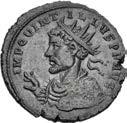
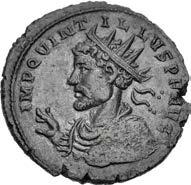
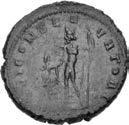
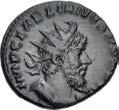
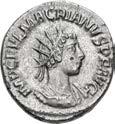
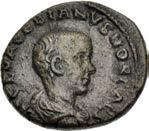
From the Weise Collection. Ex CNG inventory 719925 (April 2000).
The Gallo-Roman usurper Ulpius Cornelius Laelianus was apparently a high-ranking officer under Postumus at the city of Moguntiacum (modern Mainz, Germany) on the Rhine, home base of Legio XXII Primigenia. In February or March of AD 269, his legion proclaimed him emperor in revolt against Postumus. His family name of Ulpius suggests a distant connection to the Spanish imperial line of Trajan, perhaps supported by his use of Hispania as a reverse type on one of his gold aurei. His revolt against Postumus apparently came after his soldiers repulsed a German invasion, and may have had the tacit support of the legitimate Roman Emperor Claudius II Gothicus. Postumus, however, quickly placed Moguntiacum under siege and Laelianus was soon killed by his own soldiers, but Postumus was himself slain when he refused to let his soldiers plunder the city. The turmoil led to a rapid turnover of rulers in the Gallo-Roman realm and the loss of Spain to the central Roman Empire. An unresolved mystery of his brief “reign” lasting, at most, two months, is the location of his mint: Laelianus’ rare coinage is neatly engraved and struck, with excellent portraiture, suggesting it was produced at a regular mint. Mainz, however, had no mint facilities, and if his coinage was produced at Colonia Agrippensis (Colonge) or Treveri (Trier), his revolt must have extended to those cities as well as Mainz.
Extremely Rare Quintillus Bust Type
687. Quintillus. AD 270. Antoninianus (20mm, 3.40 g, 12h). Cyzicus mint. 1st emission, circa September-October AD 270. Radiate, draped, and cuirassed bust left, right hand raised and holding globe / Jupiter standing left, holding thunderbolt and long scepter; at feet to left, an eagle standing left, head right; –|–//–. RIC V Online 1263; D. Hollard, “Un antoninien à buste exceptionnel frappé à Cyzique pour Quintille (270)” in BSFN 8 (2008), A–C (same obv. die); RIC V 84 var. (bust type). Dark green-brown patina, area of flat strike, some die wear on reverse. Good VF. Extremely rare, RIC V Online lists just four examples of this extremely rare type, all from the same obverse die. Apparently the fifth, and finest, known. ($750)



166
685
686
688. Diocletian. AD 284-305. AR Argenteus (17.5mm, 3.04 g, 12h). Rome mint, 2nd officina. 2nd emission, AD 295296. Laureate head right / The four Tetrarchs sacrificing over tripod before city gate with six turrets; B. RIC VI 37a; Gautier, Argent 84a (same rev. die); RSC 488g. Iridescent toning, minor deposits. EF. ($750)
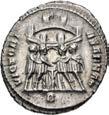
Ex DMS Collection; Harlan J. Berk inventory cc62154 (nd).
689. Diocletian. AD 284-305. AR Argenteus (19.5mm, 3.37 g, 12h). Nicomedia mint, 3rd officina. 4th emission, AD 298-299. Laureate head right / Four-turreted city gate, open doors, star on lintel. RIC VI 25a; Gautier, Argent 17; RSC 492b. Lightly brushed. EF. A handsome coin in hand. ($500)
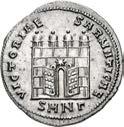
From the Quietus Collection.
Hercules in the Garden of the Hesperides
690. Maximianus. First reign, AD 286-305. Antoninianus (22.5mm, 3.88 g, 12h). Ticinum mint. Struck AD 295. Radiate and cuirassed bust right / Hercules, holding club in right hand, apple in left, lion’s skin over left arm, standing right in the Garden of the Hesperides; serpent-entwined apple tree to right; –|–//XXIT. RIC V 569. Some silvering remains, toned dark gray. Near EF. Rare. ($1500)
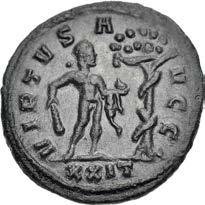
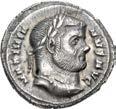
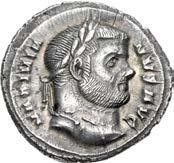
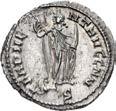
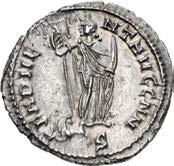
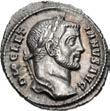
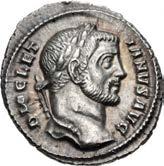
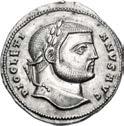

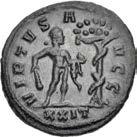
Published
691. Maximianus. First reign, AD 286-305. AR Argenteus (18mm, 3.23 g, 12h). Carthage mint, 2nd officina. 1st emission, 2nd series, AD 297. Laureate head right / Africa standing facing, head left, holding standard and tusk; at her feet, lion seated left, head right, with bucranium to left; –|–//S. RIC 13b; Gautier, Argent 14h (this coin); RSC 92. Toned, some light iridescence, hairline flan crack. EF. ($750)
From the Quietus Collection. Ex Rauch E-Auction 26 (15 March 2018), lot 497.
167
by Gautier
692. Carausius. Romano-British Emperor, AD 286-293. Antoninianus (22.5mm, 4.60 g, 6h). ‘C’ mint. radiate, draped, and cuirassed bust right / Pax standing left, holding olive branch and scepter; S|C//–. RIC V 481. Brown patina, some weakness at edge, slightly off center on reverse. EF. ($500)
From the James Fox Collection. Ex James Fox Collection (Classical Numismatic Group 40, with Numismatica Ars Classica, 4 December 1996), lot 1729; CNG inventory 10247 (29 October 1988).
Unpublished
693. Carausius. Romano-British Emperor, AD 286-293. Antoninianus (22mm, 4.58 g, 6h). ‘C’ mint. IMP CARAVSIVS P F AVF, radiate and draped bust right / HERCVLI CONS AVG, Hercules standing right, holding club set on ground to left and lion’s skin; MC. RIC V – but cf. 801 (for similar type). Dark brown patina. Good VF. Extremely rare and unpublished. ($750)
A new issue for Carausius with a hitherto unlisted reverse legend and type. Remarkably clear and in excellent condition for similar issues.
694. Allectus. Romano-British Emperor, AD 293-296. Antoninianus (24mm, 4.94 g, 9h). Londinium (London) mint. Radiate, draped, and cuirassed bust right / Pax standing left, holding olive branch and scepter; S|P//ML. RIC V 28; Burnett, Coinage 16. Dark brown-green patina. Near EF. A nice portrait. ($400)
695. Allectus. Romano-British Emperor, AD 293-296. Antoninianus (22mm, 4.60 g, 7h). Londinium (London) mint. Radiate and cuirassed bust right / Virtus standing right, holding reversed spear and resting hand on shield set on ground to right; S|A//ML. RIC V 49; Burnett, Coinage 86. Dark brown patina, minor die rust on obverse. Near EF. ($500)
From the James Fox Collection. Ex James Fox Collection (Classical Numismatic Group 40, 4 December 1996), lot 1731; CNG inventory 10249 (12 August 1986).
696. Constantius I. As Caesar, AD 293-305. AR Argenteus (17.5mm, 2.28 g, 12h). Rome mint. 6th emission, AD 300301. Laureate head right / XC/VI in two lines within laurel wreath with large central jewel. RIC VI 16a (Carthage); Gautier, Argent 268; RSC 345. Attractive golden iridescence, underlying luster, a couple of hairline flan cracks. EF. ($750)
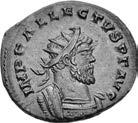
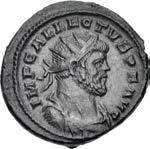
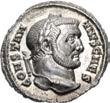
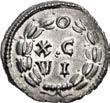


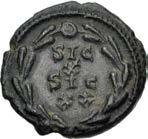
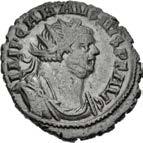
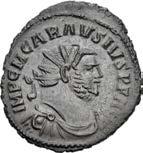

From the Quietus Collection. Ex Roma XVI (26 September 2018), lot 800; Numismatica Ars Classica 92 (24 May 2016), lot 2451.
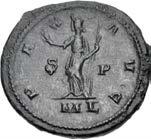

Rare Galerius Fraction
697. Galerius. As Caesar, AD 293-305. Æ Quarter Follis (15.5mm, 1.87 g, 12h). Treveri (Trier) mint. 3rd emission, on the occasion of the decennalia of Constantius I, March AD 302. Laureate head left / SIC/ X/ SIC/ XX in four lines within wreath. RIC VI 567; Zschucke 3.14. Dark brown patina, traces of earthen deposits. VF. Rare. ($500)
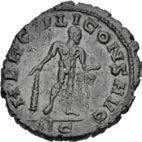
From the Libertas Collection, purchased from Numismatic Fine Arts, 10 July 1980.
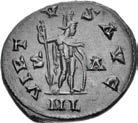
168
693
695
692
694
Two Argentei Published by Gautier
AD 293-305. AR Argenteus (19mm, 2.32 g, 6h). Ticinum mint. 1st emission, 2nd series, AD 294-295. Laureate head right / Tetrarchs sacrificing over tripod before city enclosure with six turrets; –|–//–. RIC VI 17b; Gautier, Argent 12ar (this coin); RSC 208c. Light iridescent tone, lustrous. Choice EF. ($750)
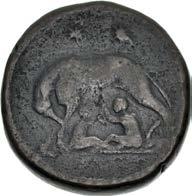



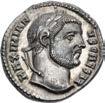
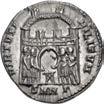

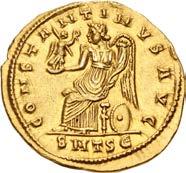
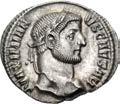
698.
Ex DMS Collection; Berk BBS 168 (16 March 2010), lot 320.
699.
As Caesar, AD 293-305. AR Argenteus (16.5mm, 3.16 g, 12h). Nicomedia mint, 3rd officina. 1st emission, late AD 295-296. Laureate head right / four tetrarchs sacrificing over tripod before city enclosure with six turrets; SMNΓ. RIC VI 20; Gautier, Argent 4j (this coin); RSC 234Ab. Attractive iridesent toning, underlying luster, traces of deposits on reverse. Superb EF. A beautiful coin. ($750)
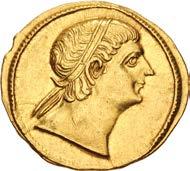
From the Weise Collection. Ex Triton III (30 November 1999), lot 1185.
Eyes to God
Biaggi 1959. Lustrous, light edge marks, small die flaw on obverse. Near EF. Well struck. ($10,000)

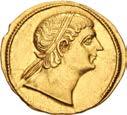
Very Rare Medallion
9 b-c, 105 (V76/R72); Gnecchi II, p. 138, 7, pl. 132, 8. Brown patina, porosity. Good Fine. Very rare. ($1000)
169
Galerius. As Caesar,
Galerius.
700. Constantine I. AD 307/310-337. AV Solidus (20mm, 4.41 g, 5h). Thessalonica mint, 5th officina. Struck AD 324. Diademed head right, eyes to God / CONSTANTINVS AVG, Victory seated left, holding Victory and cornucopia; shield set on ground to right; SMTSЄ. RIC 131; Alföldi 45; Depeyrot 10/1; Adda 583 corr. (officina);
701. Commemorative Series. AD 330-354. Æ Medallion (32mm, 28.91 g, 6h). Rome mint. Struck AD 340-350. Helmeted bust of Roma right, wearing imperial mantle / She-wolf standing left, head right, suckling the twins (Romulus and Remus); two stars above. RIC VIII 390; Ntantalia Series C, Group
From the Libertas Collection. Ex Stack’s (8 December 1988), lot 2319.
702. Constans. AD 337-350. AV Solidus (22mm, 4.35 g, 6h). Decennalia issue. Treveri (Trier) mint. Struck AD 345. Pearl-diademed, draped, and cuirassed bust right / Two Victories standing facing one another, holding wreath inscribed VOT/ X/ MVLT/ XX in four lines between them; TR. RIC VIII 135; Depeyrot 6/3; Biaggi 2123. Choice EF. ($2000)
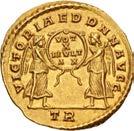
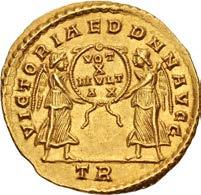
Ex Sternberg XIX (18 November 1987), lot 838.
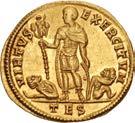
703. Constans. AD 337-350. AV Solidus (22mm, 4.39 g, 6h). Thessalonica mint. Struck AD 337-340. Pearl-and-rosettediademed, draped, and cuirassed bust right / Constans standing facing, head left, wearing military attire, holding a trophy mounted on a spear with his right hand and a shield on the ground with his left; a captive seated to either side at his feet, the one on the left with his hands bound, and the one on his right holding his head with his left hand, both are looking upward at the emperor; TES. RIC VIII 34; Depeyrot 4/7; Biaggi 2126. Underlying luster, slight weakness on reverse. EF. ($1500)
From the CJR Collection.
704. Constans. AD 337-350. AR Siliqua (20mm, 3.24 g, 11h). Thessalonica mint. Struck AD 342-346. Pearl-and-rosettediademed, draped, and cuirassed bust right / Victory advancing left, holding wreath and palm; TES. RIC VII 96; RSC 115d. Attractive iridescent tone, minor flan cracks. Choice EF. ($500)
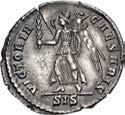

From the Quietus Collection. Ex Brian Henry Grover Collection (Roma XIX, 26 March 2020), lot 953.
705. Constantius II. AD 337-361. AV Solidus (21mm, 4.38 g, 12h). Tricennalia issue. Constantinople mint. Struck AD 351-355. Pearl-diademed, helmeted, and cuirassed bust facing slightly right, holding spear and shield / Roma, holding spear and head facing, and Constantinopolis, head left, holding scepter and foot on prow, seated on thrones facing one another, holding between them wreath inscribed VOT/ XXX/ MVLT/ XXXX in four lines; CONS. RIC VIII 96; Depeyrot 3/4; Biaggi 2141. Residual luster. Near EF. ($1000)
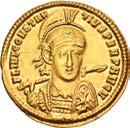
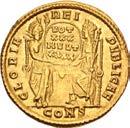
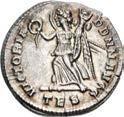
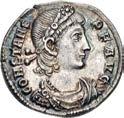

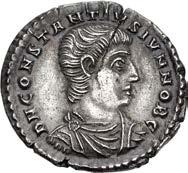
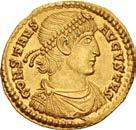
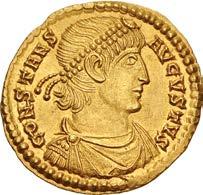
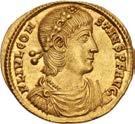
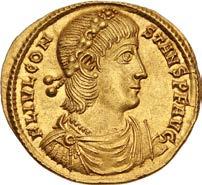
170
706. Constantius Gallus. Caesar, AD 351-354. AR Siliqua (12mm, 2.98 g, 12h). Siscia mint. Struck AD 351. Bareheaded, draped, and cuirassed bust right / Victory advancing left, holding palm frond in right hand and trophy in left; SIS. RIC VIII 299; RSC 45†. Toned, flan crack. Near EF. Rare. ($1000)
704
705
707. Julian II. AD 360-363. Æ (27.5mm, 8.40 g, 6h). Sirmium mint, 2nd officina. Struck summer AD 361-26 June 363. Pearl-diademed, draped, and cuirassed bust right / Bull standing right; two stars above; *BSIRM(wreath). RIC VIII 106; LRBC 1621. Superb EF. Wonderful dark green patina. ($1000)
From the DFA Collection. Ex Classical Numismatic Group 69 (8 June 2005), lot 1767.
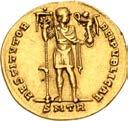
708. Valentinian I. AD 364-375. AV Solidus (20mm, 4.26 g, 6h). Treveri (Trier) mint. Struck October AD 367. Pearldiademed, draped, and cuirassed bust right / Valentinian standing facing, head right, holding labarum with Christogram and crowning Victory on globe; SMTR. RIC IX 14a; Depeyrot 26/1; Biaggi –. Attractive toning in the recesses, light marks and scratches, clipped. VF. ($1000)
Ex George Bernert Collection (Classical Numismatic Group Electronic Auction 406, 27 September 2017), lot 798.
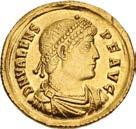
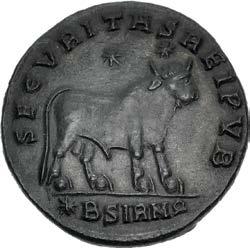
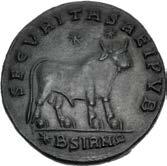
709. Valens. AD 364-378. AV Solidus (22mm, 4.45 g, 6h). Constantinople mint. Struck circa AD 367. Pearl-diademed, draped, and cuirassed bust right / Valens standing facing, head right, holding labarum and Victory on globe; CONS(wreath). RIC IX 3d.2; Depeyrot 20/2; Biaggi 2254. Light scratches, edge marks. EF ($1000)
From the CJR Collection. Ex Classical Numismatic Group 61 (25 September 2002), lot 2126.
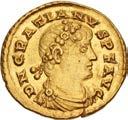

710. Gratian. AD 367-383. AV Solidus (20.5mm, 4.48 g, 6h). Treveri (Trier) mint, 2nd officina. Struck mid AD 373-April 375. Rosette-diademed, draped, and cuirassed bust right / Valentinian I and Gratian enthroned facing, holding globe between them; Victory above throne, with wings spread; palm frond between legs; TROBT. RIC IX 17g.5; Depeyrot 43/3; Biaggi –. Minor marks, short flan crack, underlying luster. Near EF. ($1000)
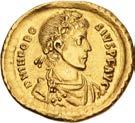
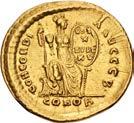

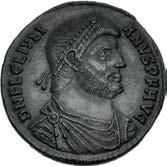
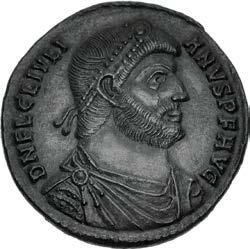
From the CJR Collection.
711. Theodosius I. AD 379-395. AV Solidus (21.5mm, 4.44 g, 12h). Constantinople mint, 2nd officina. Struck AD 382383. Rosette-diademed, draped, and cuirassed bust right / Constantinopolis seated facing, head right, foot on prow, holding scepter and globe; B//CONOB. RIC IX 45d.2; Depeyrot 33/3; Biaggi 2299 var. (officina). Lustrous, a few light hairlines. Near EF. ($750)
From the CJR Collection.
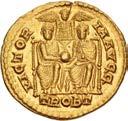
171
708 709 710 711
712. Arcadius. AD 383-408. AV Solidus (21mm, 4.47 g, 6h). Ravenna mint. Struck AD 402-408. Pearl-diademed, draped, and cuirassed bust right / Arcadius standing right, holding labarum and Victory on globe, foot on captive; R|V// COMOB. RIC X 1286; Ranieri 2; Depeyrot 7/2. Underlying luster, light scratches at the periphery, minor marks, edge chips. Good VF. ($750)
From the CJR Collection.
Pedigreed to 1963
713. Aelia Eudoxia. Augusta, AD 400-404. AV Solidus (20mm, 4.43 g, 6h). Constantinople mint. Struck AD 400/1. Rosette-diademed and draped bust right; manus Dei above, crowning her / Victory seated right on cuirass, inscribing Christogram on shield set on column; CONOB. RIC X 12; Depeyrot 55/4; Biaggi –. Some luster. Near EF. Very rare. ($3000)
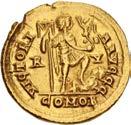
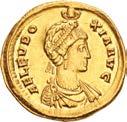
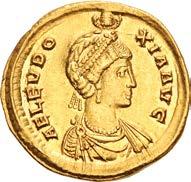
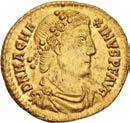
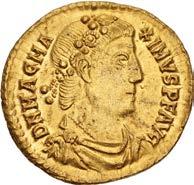
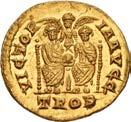
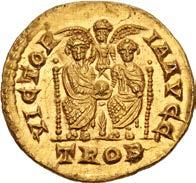
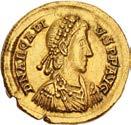
Ex Sternberg XXXV (29 October 2000), lot 904; Dr. Meyer Coloniensis Collection (Münz Zentrum 65, 9 December 1988), lot 1533; Frankfurter Münzhandlung Button 107 (7 January 1963), lot 34.
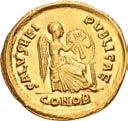

714. Magnus Maximus. AD 383-388. AV Solidus (21mm, 4.47 g, 6h). Treveri (Trier) mint. Struck AD 385-386. Rosettediademed, draped, and cuirassed bust right / Theodosius I and Valentinian II enthroned facing, each with right hand on globe between them; above, Victory facing with wings spread; palm fond between legs; TROB. RIC IX 77b; Depeyrot 52/1; Biaggi 2311. Underlying luster, light marks and deposits, small die break on reverse. EF. Rare. ($3000)
From the CJR Collection.
715 716
715. Flavius Victor. AD 387-388. AR Siliqua (16mm, 1.66 g, 6h). Treveri (Trier) mint. Pearl-diademed, draped, and cuirassed bust right / Roma seated facing, head left, holding globe and reversed spear; TPRS. RIC IX 84d.2; RSC 6Ab. Deeply toned, clipped. Near EF. ($750)

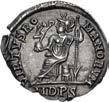


From the CJR Collection.
716. Eugenius. AD 392-394. AR Siliqua (16mm, 1.31 g, 8h). Mediolanum (Milan) mint. Struck AD 393-394. Pearldiademed, draped, and cuirassed bust right / Roma seated left on cuirass, holding Victory on globe and reversed spear; MDPS. RIC IX 32c; Toffanin 479; RSC 14†b. Attractive cabinet toning with some iridescence, minor edge split and flan crack, thin die break on obverse. Near EF. ($500)
From the CJR Collection.
172
717. Honorius. AD 393-423. AV Solidus (20.5mm, 4.48 g, 6h). Ravenna mint. Struck AD 402-406. Pearl-diademed, draped, and cuirassed bust right / Honorius standing right, foot on captive, holding labarum and Victory on globe; R|V//COMOB. RIC X 1287; Ranieri 11; Depeyrot 7/1; Biaggi 2319. Lightly toned, minor flan flaw at edge. Near EF. ($750)
From the CJR Collection.
718. Honorius. AD 393-423. AV Solidus (21mm, 4.49 g, 6h). Constantinople mint, 7th officina. Struck 397-402. Pearldiademed, helmeted, and cuirassed bust facing slightly right, holding spear over shoulder and shield decorated with horseman motif / Constantinopolis enthroned facing, head right, foot on prow, holding scepter and Victory on globe; Z//CONOB. RIC X 8; Depeyrot 55/2; Biaggi –. Light scrape on obverse, light scratches and hairlines on reverse. EF ($500)
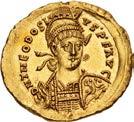
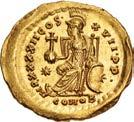
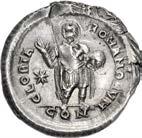

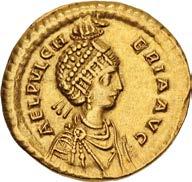
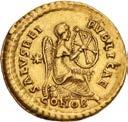
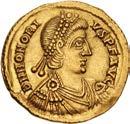
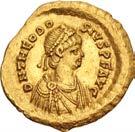
719. Theodosius II. AD 402-450. AV Tremissis (14mm, 1.47 g, 12h). Constantinople mint. Struck AD 402/8-450. Pearldiademed, draped, and cuirassed bust right / Victory advancing right, head left, holding wreath and globus cruciger; star to right; CONOB. RIC X 213 and 249; Depeyrot 70/1; Biaggi 2305. Double struck on reverse. Superb EF ($500)
Ex Classical Numismatic Group 87 (18 May 2011), lot 1178.
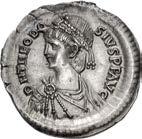
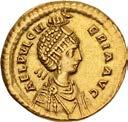

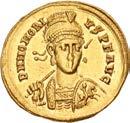
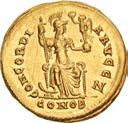
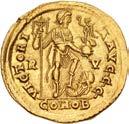


720. Theodosius II. AD 402-450. AR Light Miliarense (24mm, 4.26 g, 12h). Constantinople mint. Struck circa AD 408420. Pearl-diademed, draped, and cuirassed bust left / Theodosius II, nimbate, wearing military attire and draped, standing facing, head left, gesturing with raised right hand and holding globe in left; *|-//CON. RIC X 370; RSC 20A. Lightly toned, flip-over double strike. Good VF. ($500)
From the Quietus Collection. Ex Collection of a Philhellene (Heritage 271848, 2 Decenber 2018), lot 36279; Classical Numismatic Group 49 (17 March 1999), lot 1889.
721. Theodosius II. AD 402-450. AV Solidus (21.5mm, 4.47 g, 6h). Constantinople mint. Struck AD 443-450. Pearldiademed, helmeted, and cuirassed bust facing slightly right, holding spear over shoulder and shield / Constantinopolis seated left, holding globus cruciger and scepter, foot on prow; shield to right; star to left; COMOB. RIC X 293; Depeyrot 84/1. Lightly toned with some luster, minor flan flaw at edge, a few minor marks on reverse. Superb EF. ($750)
From the CJR Collection.
722. Aelia
AD 414-453. AV Solidus (20.5mm, 4.46 g, 6h). Constantinople mint. Struck 414. Pearldiademed and draped bust right, wearing earring and necklace; crowned by manus Dei / Victory seated right on cuirass, inscribing Christogram on shield set on knee; star to left; CONOB. RIC X 205; Depeyrot 60/2; Biaggi –. Some light scratches and minor deposits. Good VF. Rare. ($2000)
From the CJR Collection.
173
Pulcheria. Augusta,
717
720
718
721
723. Constantine III. AD 407-411. AR Siliqua (16mm, 1.56 g, 12h). Lugdunum (Lyon) mint. 2nd emission, AD 408-409. Pearl-diademed, draped, and cuirassed bust right / Roma seated left on throne, holding Victory on globe and reversed spear; SMLD. RIC X 1531; King, Fifth, p. 287, pl. 22, 2; Lyon 251; RSC 4b. Toned with some iridescence. Near EF ($750)
From the St. George Collection.
724. Constantine III. AD 407-411. AR Siliqua (16mm, 1.76 g, 7h). Lugdunum (Lyon) mint. 2nd emission, AD 408-409. Pearl-diademed, draped, and cuirassed bust right / Roma seated left on throne, holding Victory on globe and reversed spear; SMLD. RIC X 1531; King, Fifth, p. 287, pl. 22, 2; Lyon 251; RSC 4b. Light iridescent toning, double struck, minor die break on obverse, light scratch on reverse. Near EF. ($750)
From the CJR Collection.
Powerful and Influential Empress in the West
725. Galla Placidia. Augusta, AD 421-450. AV Semissis (16.5mm, 2.04 g, 6h). Ravenna (or Rome) mint. Struck AD 440455. Pearl-diademed and draped bust right / Christogram within wreath with large central jewel; COMOB . RIC X 2054 (Rome and/or Ravenna); Ranieri 79 (Ravenna); Depeyrot 47/5 (Rome). Slight wave in flan. Near EF. Very rare. ($4000)
Lot includes a David Sear Certificate of Authenticity
726. Galla Placidia. Augusta, AD 421-450. AV Solidus (21.5mm, 4.45 g, 6h). Constantinople mint. Struck 423-429. Pearldiademed and draped bust right, wearing earring and necklace; crowned by manus Dei / Victory standing left, holding long jeweled cross; *|–//CONOB. RIC X 231; Depeyrot 75/5; Biaggi –. Lightly toned, light hairlines on obverse. VF. ($3000)
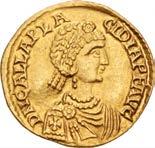


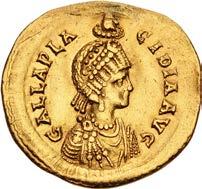
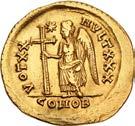
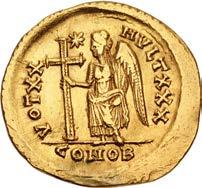
From the CJR Collection.
727.
AD 450-457. Æ (11mm, 1.20 g, 7h). Nicomedia mint. Pearl-diademed, draped, and cuirassed bust right / Monogram of Marcian within wreath; NIC. RIC X 548 var. (legend); LRBC 2463 var. (same). Green brown patina. Choice EF. An outstanding example. ($1000)
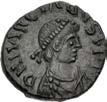



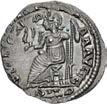



Ex Triton XVII (7 January 2014), lot 818.

174
Marcian.
723 724
728. Leo II, with Zeno. AD 474. AV Solidus (19.5mm, 4.42 g, 6h). Constantinople mint, 9th officina. Pearl-diademed, helmeted, and cuirassed bust facing slightly right, holding spear and shield decorated with horseman motif / Leo and Zeno seated facing on double throne, both nimbate and holding mappa; star and cross above; Θ//CONOB. RIC X 803; Depeyrot 98/1; Biaggi –. Lightly toned with some underlying luster, slightly clipped, faint graffito in margin on obverse, minor dig on reverse. Near EF. ($1500)
From the CJR Collection.
Among the most pressing concerns of the aging East Roman Emperor Leo I was finding a successor. Having no son, his hope rested with his eldest daughter, Aelia Ariadne, who had married an Isaurian soldier named Zeno. The couple soon produced a son, Leo II. When the elder Leo’s health began to falter, he raised his eponymous grandson to the rank of Caesar in October AD 473, then Augustus in January AD 474. Leo I died a few days later, and the sickly seven-year-old Leo II became sole emperor. Leo’s widow Aelia Verina arranged for Leo II to appoint his own father, Zeno, co-emperor on 9 February AD 474, an arrangement that lasted until Leo II died in November of the same year. Afterwards, Zeno ruled as sole emperor. This solidus was struck during their brief joint-reign.
BYZANTINE COINAGE
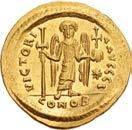

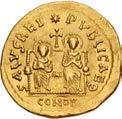
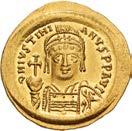
($500)
From the Iconodule Collection.
730.
I. 491-518. Æ Follis (32mm, 17.94 g, 7h). Constantinople mint, 2nd officina. Struck 512-517. Diademed, draped, and cuirassed bust right, star on shoulder / Large M, cross above; stars flanking; B below; CON. DOC 23c/23b (obv./ rev.); MIBE 27; SB 19. Even brown patina with some verdigris at edge, a tiny edge split, minor cleaning marks, usual doubling on reverse. Near EF. ($500) From the Iconodule Collection.
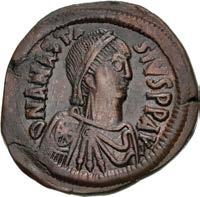
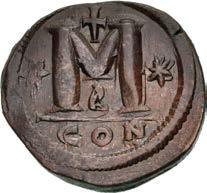
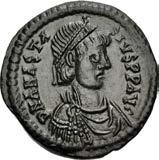
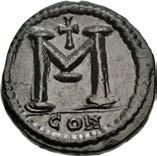
731.
AV Solidus (21mm, 4.48 g, 6h). Constantinople mint, 10th officina. Struck 537-542. Helmeted and cuirassed bust facing, holding globus cruciger, shield on left shoulder / Angel standing facing, holding long cross and globus cruciger; star to right; I//CONOB. DOC 8h; MIBE 6; SB 139. Bent, hairlines, light scratch on reverse. EF. Well centered and struck. ($500)
From the Gasvoda Collection. Ex Leu Numismatik Web Auction 15 (27 February 2021), lot 2258.
175
729. Anastasius I. 491-518. Æ Follis (25mm, 8.80 g, 6h). Constantinople mint. Struck 498. Diademed, draped, and cuirassed bust right / Large M; cross above; CON. DOC 16; MIBE 22; SB 14. Dark olive green patina, minor doubling as usual, some smoothing. Near EF. An excellent strike.
Anastasius
Justinian I. 527-565.
729
730
732.
I. 527-565. Æ Follis (38mm, 23.36 g, 6h). Constantinople mint, 2nd officina. Dated RY 14 (540/1). Helmeted and cuirassed bust facing, holding globus cruciger, shield on left shoulder; cross to right / Large M, cross above; A/N/N/O - X/II/II (date) across field; B//CON. DOC 39b; MIBE 95a; SB 163. Even brown patina with some light verdigris, minor cleaning scratches on reverse. Near EF. Well struck. ($500)
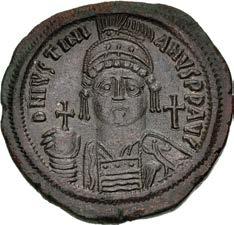
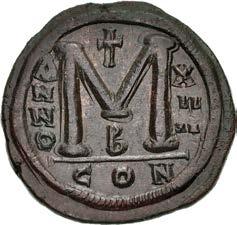
From the Iconodule Collection.
733. Justin II. 565-578. AV Solidus (19mm, 4.44 g, 6h). Carthage mint. Dated RY 5 (569/70). Helmeted and cuirassed bust facing, holding Victory on globe and shield / Constantinopolis seated facing on throne, head right, holding scepter and globus cruciger; Є//CONOB. DOC 190c; MIBE 18b; Morrisson 11-14; SB 391. Lightly toned with some luster, a few light scratches on reverse. Near EF. Rare. ($750)
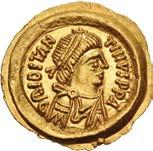
From the Gasvoda Collection. Ex Roma XXI (24 March 2021), lot 886.
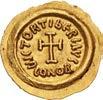
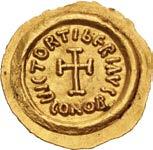
Ranieri Plate Coin
734.
II
578-582. AV Tremissis (16mm, 1.44 g, 6h). Ravenna mint. Diademed, draped, and cuirassed bust right / Cross potent; CONOB. DOC 64; MIBE 17; Ranieri 445 (this coin illustrated); SB 470. Some luster, minor deposits on reverse. Choice EF. ($1000)
From the Gasvoda Collection. Ex Künker 351 (25 September 2021), lot 592; Leu Numismatics & Numismatica Ars Classica (26 May 1993), lot 504.
AV Solidus (18mm, 4.39 g, 6h). Carthage mint. Dated IY 6 (587/8). Helmeted, draped, and cuirassed bust facing, holding globus cruciger / Angel standing facing, holding long staff surmounted by staurogram and globus cruciger; S//CONOB. DOC 220; MIBE 25a; SB 548. Good VF. ($750)
From the Gasvoda Collection. Ex Classical Numismatic Group 118 (13 September 2021), lot 1190.
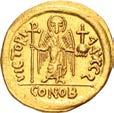
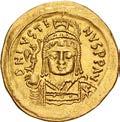
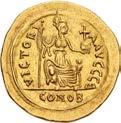
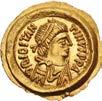
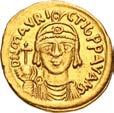
176
Justinian
Tiberius
Constantine.
735. Maurice Tiberius. 582-602.
736. Phocas. 602-610. AV Solidus (17.5mm, 4.39 g, 6h). Carthage mint. Dated IY 8 (604/5). Draped and cuirassed bust facing, wearing crown with pendilia, holding globus cruciger; AN H (date) at end of legend / Angel standing facing, holding long staff surmounted by staurogram and globus cruciger; H (date)//CONOB. DOC 109; MIBE 32; SB 681. Good VF. Very rare. ($1500)
From the Gasvoda Collection. Ex Classical Numismatic Group 118 (13 September 2021), lot 1194.
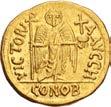
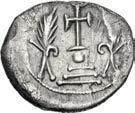
Carthage-mint solidi of Phocas are known from Indictional Years 6 (AD 602/3) to 11 (AD 607/8). In 608, the exarch of Carthage, Heraclius the Elder, revolted against Phocas and the mint switched to striking coins in the name of Heraclius and his eponymous son.
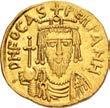
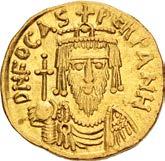



737. Phocas. 602-610. AV Solidus (16mm, 4.44 g, 6h). Carthage mint. Dated IY 8 (604/5). Draped and cuirassed bust facing, wearing crown with pendilia, holding globus cruciger; AN H (date) at end of legend / Angel standing facing, holding long staff surmounted by staurogram and globus cruciger; H (date)//CONOB. DOC 109; MIBE 32; SB 681. A few light scratches on reverse. Good VF. Very rare. ($1000)
738. Heraclius, with Heraclius Constantine and Heraclonas. 610-641. AR Miliaresion (21.5mm, 3.95 g, 6h). Ceremonial issue. Constantinople mint. Struck 638-641. Crowned facing figures of Heraclius Constantine, Heraclius, and Heraclonas standing facing, each wearing chlamys and holding globus cruciger / Cross potent set on globe on three steps; palm fronds flanking. DOC 60; MIB 131; SB 791. Lightly toned, slightly off center, porosity, some scattered scratches mostly under tone, slight clashing on reverse. VF. Among the finest known for this difficult issue. ($1500)
From the Iconodule Collection.
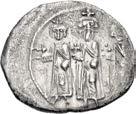
177
Unique Issue of Intriguing and Rare Series
739. Heraclius, with Heraclius Constantine. 610-641. AV Solidus (20.5mm, 4.49 g, 6h). Uncertain eastern mint, 5th(?) officina. Struck circa 613-circa 616(?). Crowned, draped, and cuirassed facing busts of Heraclius and Heraclius Constantine; cross above; all set on exergual line / Cross potent set on three steps; Є//CONOB. DOC 187a var. (unlisted officina; Alexandria); MIB 772-3 var. (same; Cyprus?); Bendall, Jerusalem 8 and 10 var. (same; Uncertain eastern military mint); SB 851 var. (same; Jerusalem). Lightly toned. Good VF. Unique. ($750)

From the David Welsh Collection. Ex Geneva Collection (Heritage 351, 3 June 2004), lot 12211 (erroneously as Constantinople, SB 734).
This solidus of Heraclius and Heraclius Constantine belongs to a rare and difficult series that has long consternated scholars and numismatists. The series is distinctly different from the common Constantinople solidi both stylistically and in the legend. Chronologically, it must date no earlier than 613, however, where exactly within the given timeframe it was struck remains a mystery. Additionally, as evidenced by the preponderance of diverging mint hypotheses, identifying the mint(s) wherein it was stuck also remains elusive.
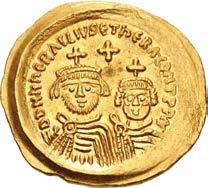
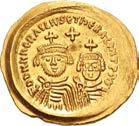
This series has two distinct subtypes: those whose reverse legend ends simply in I, and those which end in IX or IΠ. The former is far rarer. Bendall wrote in his 2003 article that “the rare coins with I ... are possibly the earliest variety since there exists a solidus with the reverse legend ending I which later had an X added” (Bendall, 316). From the limited evidence available, the chronology of this series places the coins ending in I first followed by IX and IΠ.
This new coin first appeared in a 2004 auction. It was there, however, erroneously attributed alongside the Constantinople soldi and consequently went largely unnoticed. Appearing in the same distinctive style as its eastern solidi relatives, this coin presents a crucible in furthering the understanding of this difficult series. This note will focus on the potential explanations for this coin with a reverse legend ending in Є and what that may represent, as well as the series’ historical context. For more information on the stylistic differences of this series, please consult from Grierson, Two, pp. 175–9 (1965).
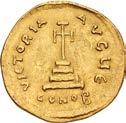
After Phocas deposed Maurice Tiberius, the Sasanians invaded the eastern borders of the Byzantine Empire. Byzantine-Sasanian relations had been at their zenith since Maurice supported Khosrau II’s successful bid for the Sasanian throne. But once Maurice, Khosrau’s benefactor and father-in-law, was executed by Phocas, the Sasanian king used the unfavorable change in government to launch a retaliatory invasion. The war would drag on for over two decades and span the reigns of Phocas and Heraclius from 602-628. During the conflict, Jerusalem itself fell to the Sasanian forces in 614, and Egypt was occupied for the last ten years from 618-628. The losses and recaptures of major cities and mints during this conflict muddies the waters for better understanding this eastern series. Ultimately, it remains difficult to say which mint this series was struck at, or if it belongs to a transient military mint as Bendall suggested in 2003.
If this series followed the usual officinae of Byzantine coinage, this coin with an Є would make it the earliest example in this series. But given that the other known specimens end in I, IX, and IΠ, which does not follow a particular known sequence, it is difficult to say if the terminal letters even represent officina. The alternative possibility of them representing indiction or regal years is likewise speculative. Finally, it is also possible that this reverse die could be a mule from the Constantinople solidi.

In the end, this coin represents an exciting new data point for this series with a new terminal letter in the reverse legend. However, until a new substantial group of this series is uncovered, it will likely remain difficult to effectively argue a thesis for this series’ ultimate attribution.
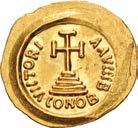
178
740. Heraclius, with Heraclius Constantine. 610-641. AV Solidus (22mm, 4.47 g, 6h). Ravenna mint. Struck 613-629. Crowned and draped facing busts of Heraclius and Heraclius Constantine; cross above / Cross potent set on four steps; B// CONOB. DOC 271a; MIB 110d; Ranieri 540; SB 896. Lustrous, some minor hairlines. Superb EF. Rare. ($1000)
From the Gasvoda Collection. Ex Leu Numismatik Web Auction 11 (22 February 2020), lot 2178.
741. Constans II. 641-668. AV Solidus (19mm, 4.42 g, 6h). Constantinople mint, 6th officina. Dated IY 5 (647). Crowned facing bust, wearing chlamys, holding globus cruciger / Cross potent set on three steps; Є (date) to right; S//CONOB. DOC 5c; MIB 9; SB 942. Some luster, minor hairlines, slight clashing and a minor die break on reverse. Superb EF. ($500)
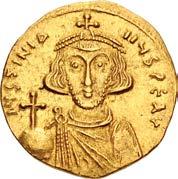
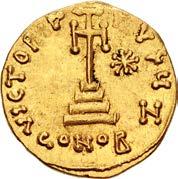
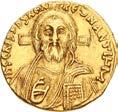
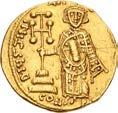


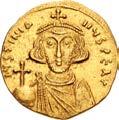

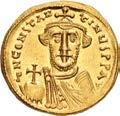
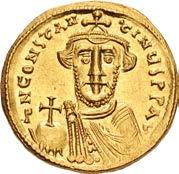

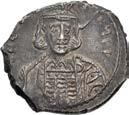

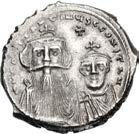
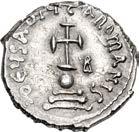
From the Gasvoda Collection. Ex Leu Numismatik Web Auction 15 (27 February 2021), lot 2369.
742. Constans II, with Constantine IV. 641-668. AR Hexagram (21.5mm, 6.82 g, 7h). Constantinople mint. Crowned facing busts of Constans and Constantine, each wearing chlamys; cross above / Cross potent set on globe on three steps; B to right; CONOB. DOC 55; MIB 150; Yannopoulos Type II, Class I; SB 996. Lightly toned with some iridescence, hairlines. EF. Exceptional for issue. ($750)
From the Gasvoda Collection. Ex Triton XVIII (5 January 2015), lot 1313.
743. Constantine IV Pogonatus. 668-685. AR Miliaresion (20mm, 4.25 g, 6h). Ceremonial issue. Constantinople mint. Struck 674-681. Helmeted and cuirassed bust facing slightly right, holding spear over shoulder in right hand, shield on left shoulder / Cross potent set on globe on three steps; palm fronds flanking. DOC 20; MIB 61; SB 1165. Deeply toned with some iridescence, scattered light scratches and marks. Good VF. Very rare. Exceptional in this grade for issue. ($750)
issue of 23 siliquae. Constantinople mint, 7th officina. Struck 686/7. Crowned facing bust, wearing chlamys, holding globus cruciger / Cross potent set on three steps; star in right field; Z//CONOB. DOC 2b corr. (light weight; unlisted officina); MIB 10 var. (unlisted officina); SB 1250 var. (same). Some light scratches, minor deposits. Near EF. An extremely rare variety of an already very rare issue. No others in CoinArchives. ($2500)
From the Gasvoda Collection.
179
744. Justinian II. First reign, 685-695. AV Solidus (19mm, 4.15 g, 6h). Light weight
Ex MacKay Collection (Classical Numismatic Group 117, 20 May 2021), lot 668; Spink 206 (22 June 2011), lot 457.
745. Justinian II. First reign, 685-695. AV Semissis (16.5mm, 2.05 g, 6h). Constantinople mint. Struck 687-692. Crowned facing bust, wearing chlamys, holding globus cruciger / Cross potent set on globe. DOC 9; MIB 11; SB 1251. Minor bend in flan. Good VF. ($750)
From the Gasvoda Collection. Ex Numismatik Naumann 92 (2 August 2020), lot 959.
746. Justinian II. First reign, 685-695. AV Solidus (19mm, 4.32 g, 6h). Constantinople mint, uncertain officina. Struck 692-695. Facing bust of Christ Pantokrator / Justinian standing facing, wearing crown and loros, holding cross potent set on two steps and akakia; [...]//CONOP. DOC 7; MIB 8; SB 1248. Lightly toned, clipped, light deposits, graffito on reverse. Good VF. ($1500)
742
743
745
746
Syracuse Solidus of Leontius

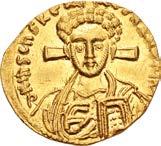

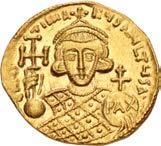

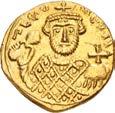
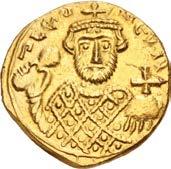
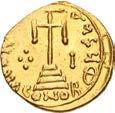
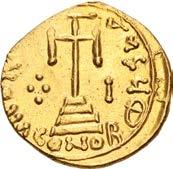
747. Leontius. 695-698. AV Solidus (18mm, 4.14 g, 6h). Syracuse mint, 9th officina. Crowned facing bust, wearing loros, holding akakia and globus cruciger / Cross potent set on three steps; four pellets in left field, I to right; Θ//CONOB. DOC 13; MIB 9; Anastasi 290; SB 1340. Minor die breaks, clipped in flan preparation. Near EF. Very rare. ($2000)
Under Justinian II the weight standard for solidi at Syracuse was reduced from 4.5 to approximately 4.1 grams. Syracuse solidi from this time often exhibit clipping from flan preparation. This ‘clipping’ should not be confused with that which occurred in circulation and was likely done at the mint to bring down the weight of these flans to the new standard. Grierson writes in DOC II.1 that “by the time of Justinian II ... a different weight standard, in the region of 4.10 g, [was] adopted, and ... maintained in subsequent reigns ... The later coins themselves have often what appear to be clipped edges, but this clipping may have been done before the coins left the mint and perhaps even before they were struck” (DOC p. 16).
748. Justinian II. Second reign, 705-711. AV Semissis (17mm, 2.14 g, 6h). Constantinople mint. Struck 705. Facing bust of Christ Pantokrator / Crowned facing bust of Justinian, wearing loros, holding cross potent set on globus and patriarchal globus cruciger inscribed PAX. DOC 3.2; MIB 3; SB 1416. Some luster, lightly clipped, some light hairlines. Superb EF. Rare. ($2000)
From the Gasvoda Collection. Ex Rauch 110 (2 July 2020), lot 341 (hammer €6500).

Unpublished Denomination for Ruler
749. Anastasius II Artemius. 713-715. Æ Decanummium (20mm, 2.02 g, 12h). Uncertain Sardinian mint, Cagliari(?). Crowned facing half-length figure, wearing chlamys, holding akakia / Large I; S to left, cross to right. DOC –; cf. MIB 30 (for similar Half Follis); cf. SB 1471A (same). Rough brown patina. Fine. Extremely rare and unpublished. ($500)
Around the tine of the fall of Byzantine Carthage and consequent loss of the mint to Umayyad forces in 698, a number of small issues appear that have been attributed to a Sardinian mint, likely Cagliari. Starting in the reign of Leontius (695-698) and continuing into that of Leo III (715-717), a small corpus of gold and bronze issues have been recorded with an S mint mark. This mark usually appears in the right field on the gold issues and in the left on the bronze. Hahn recorded in MIB 3 (1981) an issue of this series as a half follis that he attributed to the reign of Anastasius II. Appearing here for the first time is a new coin of this series in a new denomination for Anastasius. This new decanummium is not only new for the rare Sardinian mint, but constitutes the first known decanummium for the whole coinage of Anastasius II.
180
Unpublished Denomination for Ruler
750. Theodosius III of Adramytium. 715-717. Æ Decanummium (18mm, 0.52 g, 6h). Constantinople mint(?). Dated RY 1 (715). Crowned facing bust, wearing loros, holding patriarchal globus crucgier / Large I; A/[...] - I (date) across field; [C] ON. Cf. DOC 6 (for similar half follis); cf. MIB 14 (same); cf. SB 1493 (same). Rough brown surfaces, ragged flan, a pair of tiny pinholes. Fine. Extremely rare and unpublished. ($500)

An unpublished denomination for the short reign of Theodosius III. The coin has similarities to the half folles that feature regnal years across the fields on the reverse. But while all of those issues have been attributed to Constantinople, it is difficult to rule out the possibility of this coin belonging to Syracuse, since the mint mark is unclear and the flan fabric would be unusual for Constantinople at this time. Regardless of its ultimate mint attribution, this coin represents a fascinating new find and an entirely new denomination for the rare coinage of Theodosisus III.

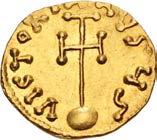

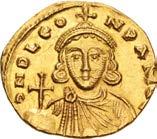
751. Leo III the “Isaurian”. 717-741. AV Semissis (17mm, 2.16 g, 6h). Constantinople mint. Struck 717-720. Crowned facing bust, wearing chlamys, holding globus cruciger / Cross potent set on globe. DOC 8; MIB 3; SB 1505. Lightly toned and lustrous, hairlines, slight clashing on obverse. EF. Very rare, only three in CoinArchives including this coin. ($2000)
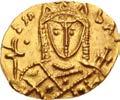
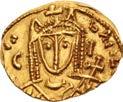
From the Gasvoda Collection. Ex Classical Numismatic Group 118 (13 September 2021), lot 1209 (hammer $5000).
Unpublished Type
the “Isaurian”, with Constantine V. 717-741. Æ Decanummium (17mm, 1.63 g, 12h). Constantinople mint. Crowned facing busts of Leo and Constantine, each wearing chlamys and holding akakia / Large I; cross above; [...]N/N/N across field. Cf. DOC 38-41 (for similar type as folles and half folles); cf. SB 1521-2 (for denomination). Brown patina, roughness, some cleaning scratches. Good Fine. Extremely rare and unpublished. ($500)
752.
A new type of decanummi for Leo III and Constantine V. While decanummi are known for these rulers (SB 1521-2), this new type follows the designs of the folles and half



181
Leo III
folles of DOC 38-41 rather than the distinctly different types found as DOC 27 and 35.
753. Irene. 797-802. AV Solidus (19mm, 3.87 g, 7h). Syracuse mint. Crowned facing bust, wearing loros, holding globus cruciger and cruciform scepter; • to left / Crowned facing bust, wearing loros, holding globus cruciger and cruciform scepter; C - I across field. DOC –; Anastasi 455; SB –; Berk BBS 202, lot 30 = Gemini XIII, lot 256 = Stack’s (8 January 2016), lot 30192 (same dies). Lightly toned, minor scratches and deposits on reverse. EF. Rare. ($1500)
From the Gasvoda Collection. Ex Classical Numismatic Group 114 (13 May 2020), lot 1051.
754. Nicephorus I. 802-811. AV Solidus (20mm, 3.79 g, 6h). Sicilian mint, probably Syracuse. Crowned facing bust, wearing chlamys, holding cross potent and akakia / Cross potent set on three steps; C - I across field. DOC –; Anastasi –; SB –; Triton XXIII, lot 932 (same dies). Some luster, die rust, hairlines. EF. Very rare. ($2000)




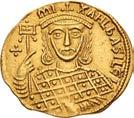
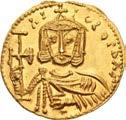
From the Gasvoda Collection. Ex Nomos 20 (10 July 2020), lot 431; Nomos 17 (26 October 2018), lot 318.
755. Michael I Rhangabe, with Theophylactus. 811-813. AV Solidus (20mm, 4.38 g, 6h). Constantinople mint. Crowned facing bust of Michael, wearing chlamys, holding cross potent hand and akakia / Crowned facing bust of Theophylactus, wearing loros, holding globus cruciger and cruciform scepter; X at end of legend. DOC 1a; Füeg 1.B; SB 1615. Toned with some luster, some minor scratches, trace deposits. Good VF. Rare. ($4000)
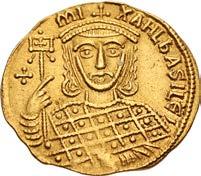
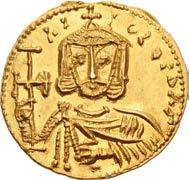
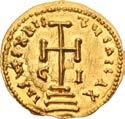
From the Gasvoda Collection, purchased from Herb Kreindler, August 2019. Ex Andre Constantine Dimitriadis Collection (Heritage 3035, 3 September 2014), lot 29544.
756. Michael I Rhangabe. 811-813. AV Tremissis (12.5mm, 1.18 g, 6h). Syracuse mint. Struck 811. Crowned facing bust, wearing chlamys, holding globus cruciger and akakia / Crowned facing bust wearing chlamys, holding cross potent and akakia. DOC 6; Anastasi 481; SB 1623. Toned. Good VF. ($1500)
From the Gasvoda Collection. Ex Künker 326 (7 October 2019), lot 1835; Giessener Münzhandlung 84 (13 October 1997), lot 6174.
757. Michael II the Amorian, with Theophilus. 820-829. AV Solidus (11mm, 3.67 g, 6h). Syracuse mint. Stuck 821829. Crowned facing bust of Michael, wearing loros and holding cross potent / Crowned facing bust of Theophilus, wearing chlamys, holding globus cruciger. DOC 14b; Anastasi 503; SB 1645. Lightly toned and lustrous. EF. ($500)
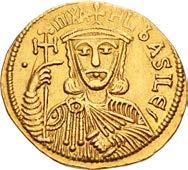
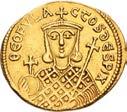


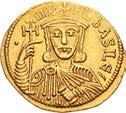
From the Gasvoda Collection. Ex Künker 351 (25 September 2021), lot 628.
758. Michael III “the Drunkard”. 842-867. AV Solidus (21.5mm, 4.29 g, 6h). Constantinople mint. Struck 856-867. Facing bust of Christ Pantokrator / Crowned facing bust of Michael, wearing loros, holding labarum. DOC 3; Füeg 3.A; SB 1688. Minor deposits. Good VF. Rare. ($3000)
From the Gasvoda Collection. Ex Triton XXIV (19 January 2021), lot 1191.
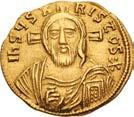
182
756
757
759. Constantine VII Porphyrogenitus, with Romanus I and Christopher. 913-959. AV Solidus (21mm, 4.37 g, 6h).
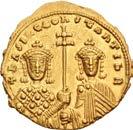
Constantinople mint. Struck 921-931. Christ Pantokrator enthroned facing / Crowned facing busts of Romanus, wearing loros, and Christopher, wearing chlamys, holding long patriarchal cross between them. DOC 7; Füeg 7.C.6; SB 1745. Lightly toned, light scratch, a few tiny edge splits. EF. ($2000)
From the Gasvoda Collection. Ex Numismatik Naumann 86 (20 February 2020), lot 744.
760. Basil II Bulgaroktonos, with Constantine VIII. 976-1025. AV Histamenon Nomisma (21mm, 4.38 g, 6h).
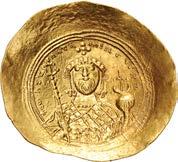
Constantinople mint. Struck 977-circa 989. Facing bust of Christ Pantokrator, • in upper bar of nimbus, – in left and right quarters / Crowned facing busts of Basil, wearing loros, and Constantine, wearing chlamys, holding long patriarchal cross between them. DOC 2c; Füeg II 2.C; SB 1796. Toned, somewhat irregular flan. Near EF. ($750)
761. Basil II Bulgaroktonos, with Constantine VIII. 976-1025. AV Histamenon Nomisma (23mm, 4.44 g, 6h).
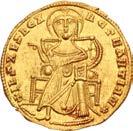
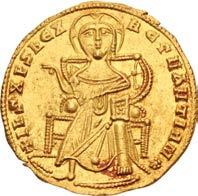

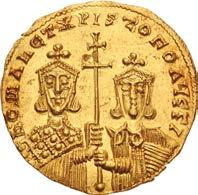
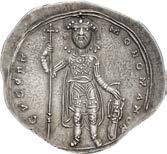
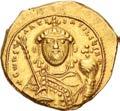
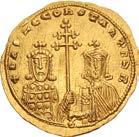
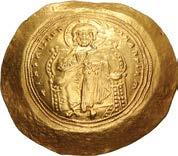
Constantinople mint. Struck circa 989-circa 1001. Facing bust of Christ Pantokrator, •• in bars of nimbus / Crowned facing busts of Basil, wearing loros, and Constantine, wearing chlamys, holding long patriarchal cross-crosslet between them. DOC 3a; Füeg II 3.A; SB 1797. Lightly toned, trace deposits. EF. ($750)
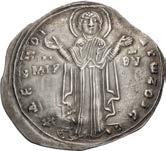
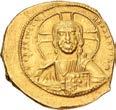
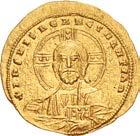
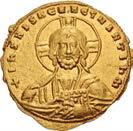
From the Iconodule Collection.
($500)
($1000)
From the Bellwether Collection Ex Classical Numismatic Group 97 (17 September 2014), lot 803; Sincona 3 (25 October 2011), lot 3530; Tkalec (22 April 2007), lot 402.
764. Constantine IX Monomachus. 1042-1055. AR Miliaresion (27mm, 2.39 g, 6h). Constantinople mint. Struck 10421055. The Theotokos standing facing, orans / Constantine standing facing, wearing crown and military attire, holding long cross and sheathed sword. DOC 7a; SB 1834. Toned, minor scratches. Near EF. ($750)
From the Gasvoda Collection. Ex German collection of late Byzantine silver coins, formed in the late 1990s and early 2000s (Leu 7, 24 October 2020), lot 1961.
183
762. Constantine IX Monomachus. 1042-1055. AV Histamenon Nomisma (29mm, 4.39 g, 6h). Constantinople mint. Christ Pantokrator enthroned facing / Crowned facing bust, wearing loros, holding cruciform scepter with tendril ornament and globus cruciger with crescent. DOC 1b; Füeg II 1.C; SB 1828A. Lustrous. EF
763. Constantine IX Monomachus. 1042-1055. AV Tetarteron Nomisma (18.5mm, 4.07 g, 6h). Constantinople mint. Facing bust of Christ Pantokrator / Crowned facing bust of Constantine, wearing jeweled chlamys, holding trefoil scepter and globus cruciger. DOC 5a; Füeg II 5.A.2; SB 1832. Lightly toned, slightly off center, a few light scratches under tone. EF.
760
761 763 764
765. Constantine IX Monomachus. 1042-1055. AR 2/3 Miliaresion (24mm, 2.05 g, 6h). Constantinople mint. Facing bust of the Theotokos, orans / Legend in five lines. DOC 8a; SB 1835. Toned, flan crack, a few light scratches. EF. Rare. ($1500)
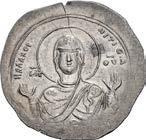
From the Gasvoda Collection. Ex Iconodule Collection (Triton XXIV, 19 January 2021), lot 1196.
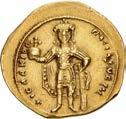
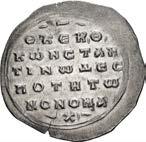
766. Theodora. 1055-1056. AV Histamenon Nomisma (23mm, 4.44 g, 6h). Constantinople mint. Christ Pantokrator standing facing on suppedion; one pellet in bars of nimbus / Theodora, wearing crown and loros, and the Theotokos standing facing, holding between them a labarum on long staff with pellet on shaft and beneath. DOC 1a; Füeg II 1.A; SB 1837. Minor die wear and rust on reverse. Near EF. ($1500)
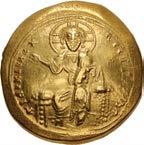
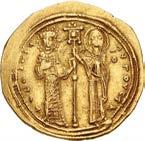
From the CJR Collection.
767. Isaac I Comnenus. 1057-1059. AV Histamenon Nomisma (23.5mm, 4.37 g, 6h). Constantinople mint. Christ Pantokrator enthroned facing / Isaac standing facing, wearing military attire, holding drawn sword and resting hand on scabbard. DOC 2; Füeg II 2.C.x; SB 1843. Lightly toned and lustrous, a few light scratches. Near EF. ($1000)
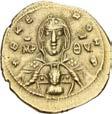
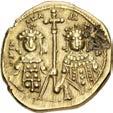
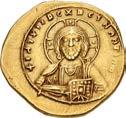
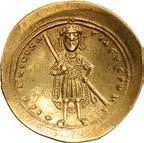
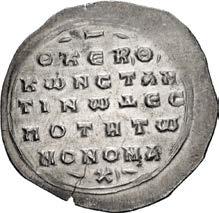
Ex Triton XVI (9 January 2013), lot 1300.
768. Isaac I Comnenus. 1057-1059. AV Tetarteron Nomisma (20mm, 4.04 g, 6h). Constantinople mint. Facing bust of Christ Pantokrator / Isaac standing facing, holding globus cruciger and resting hand on sword in scabbard. DOC 3; Füeg II 3.x; SB 1845. Lightly toned, hairlines. Good VF.

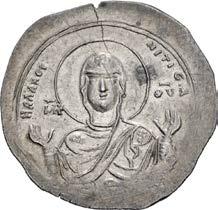
From the Gasvoda Collection, purchased from Herb Kreindler, August 2019.
Ex Johns Hopkins University and Garrett Collections – Pedigreed to 1922
769. Michael VII Ducas, with Maria. 1071-1078. EL Tetarteron Nomisma (18mm, 3.97 g, 6h). Constantinople mint. Facing bust of the Theotokos, holding facing bust of Holy Infant on lap / Crowned facing half-length figures of Michael, wearing loros, and Maria, draped, holding between them jeweled long cross. DOC 3.5; SB 1870. Flan flaw on reverse. Good VF. ($1000)
From the Bellwether Collection. Ex Johns Hopkins University Collection [inv. 1295] (Part III, Numismatic Fine Arts & Bank Leu, 29 March 1985), lot 526; John Work Garrett Collection, purchased from Wayte Raymond, 30 December 1922.
184
($1000)
766 767 768 769
(Alexius I). Brown surfaces, struck somewhat off center. Good VF. Very rare. ($1000)

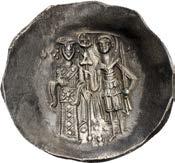
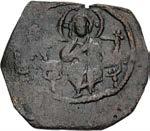

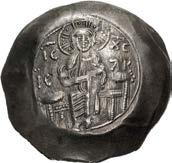
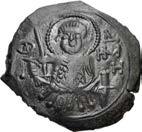
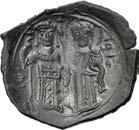
At the disastrous battle of Manzikert on August 26th 1071, the Byzantine forces under the command of emperor Romanus IV were decisively defeated and Romanus himself taken prisoner by the Seljuk Turks. Following the disaster, the eastern city of Trebizond was captured. It was later recovered by the effective general Theodore Gabras in 1075 during the ineffective reign of emperor Michael VII. So far removed from the court drama of Constantinople, Trebizond was relatively insulated from the tumultuous years that followed, which included the downfall of Michael VII, the brief reign of Nicephorus III, and the three subsequent revolts of Nicephorus Bryennius, Basilacius, and Melissenus. However, once Nicephorus III’s capable general Alexius was crowned as emperor Alexius I, the new Comnenian dynasty took a more assertive role along the eastern frontier. After having been left alone to rule his fiefdom for the past 6 years, Alexius ensured Theodore’s loyalty by holding his son hostage in Constantinople. A rescue attempt orchestrated by Theodore in 1091/2 proved unsuccessful. This, however, made Theodore even less inclined to heed the central government in Constantinople and he largely pursued his own agenda and policies while in power in Trebizond. During Theodore’s rule of Trebizond, a number of interesting issues were stuck there, such as this rare follis. Ultimately, Theodore’s lordship of Trebizond came to an end when he was captured and killed by Turkish forces in 1098.
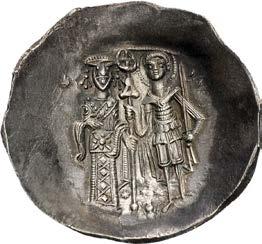
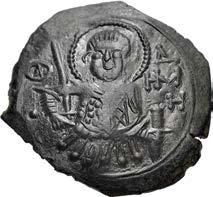
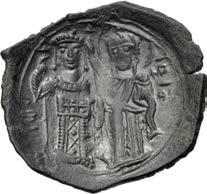
185
770. Theodore Gabras. Ruler of Trebizond, circa 1075-1098. Æ Follis (25mm, 4.02 g, 12h). Trebizond mint. Struck circa 1075-1085. Christ Pantokrator enthroned facing / Jeweled Latin cross with three pellets at end of each extremity and crescent at base. DOC Class M (Anonymous Folles); S. Bendall, “The mint of Trebizond under Alexius I and the Gabrades” in NC 137 (1977), Issue 5; SB 1903
771. Theodore Comnenus-Ducas. As emperor of Thessalonica, 1227-1230. AR Aspron Trachy (27mm, 3.29 g, 6h). Thessalonica mint. Christ Pantokrator enthroned facing / Theodore, wearing crown and loros, and St. Demetrius, standing facing, holding staff with triangle and cross in circle between them. DOC 1a/1c (obv./rev.); SB 2158. Deeply toned with some iridescence. Superb EF. Very rare. The finest example of this difficult issue in CoinArchives. ($2500)
From the Gasvoda Collection. Ex Roma XVIII (29 September 2019), lot 1317.
772. John Comnenus-Ducas. As emperor of Thessalonica, 1237-1242. BI Trachy (22mm, 1.92 g, 6h). Thessalonica mint. Struck 1237-circa 1242. Half-length bust of St. Demetrius facing, holding sword over shoulder and sheath / Facing figures of John, wearing crown and loros, holding labarum and akakia, and the Theotokos, crowning John. DOC 7; SB 2193. Green patina, tiny edge split. Near EF. Very rare and outstanding for issue. ($500)
From the Iconodule Collection.
773. Theodore II Ducas-Lascaris. Emperor of Nicaea, 1254-1258. AR Trachy (28.5mm, 2.65 g, 6h). Magnesia mint. Struck 1255/1256. St. Tryphon standing facing, holding cross to chest, lys flanking / Crowned facing figure of Theodore, wearing chlamys, holding labarum-tipped scepter and patriarchal globus cruciger. DOC 6; SB 2138. Toned, a couple minor areas of weakness. Good VF. Very rare. ($750)
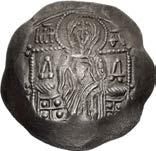
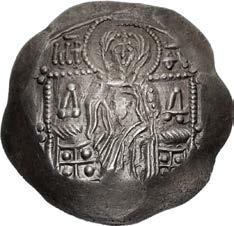

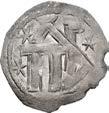
774. Theodore II Ducas-Lascaris. Emperor of Nicaea, 1254-1258. AR Trachy (26.5mm, 2.82 g, 6h). Magnesia mint. Struck 1256/1257. Christ Pantokrator enthroned facing; Γ to left, Γ to right / Facing figures of Theodore, wearing crown and loros, holding cruciform scepter, and St. Tryphon, holding between them long staff surmounted by labarum with lys at base. DOC
7.5; SB 2139. Toned, a couple minor areas of weakness, a few light scratches at periphery. Good VF. Very rare. ($750)
775. Theodore II Ducas-Lascaris. Emperor of Nicaea, 1254-1258. AR Trachy (25mm, 2.74 g, 6h). Magnesia mint. Struck 1257/1258. The Theotokos enthroned facing, holding head of Holy Infant on lap; Δ to left, A to right / Theodore enthroned facing, wearing crown and loros, holding labarum-tipped scepter and globus cruciger. DOC 8; SB 2140. Toned, a few light scratches at periphery. Near EF. Extremely rare. Only one in CoinArchives, Triton XXIII, lot 939 (hammer $5500). ($1000)
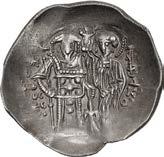

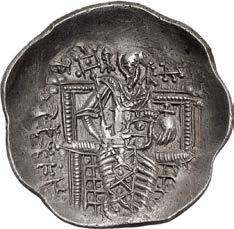
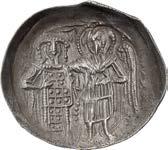
776.
VIII
As
AR
(27.5mm, 2.07 g, 6h). Magnesia mint. Struck 1259/1260. The Theotokos enthroned facing, holding head of Holy Infant on lap; B to left, B to right / Facing figures of Michael, wearing crown and loros, and St. Michael the Archangel, clasping hands. DOC 27 (line drawing); SB 2246. Toned. Good VF. Very rare. ($1000)
1282-1328. BI Tornese (17mm, 0.63 g, 6h). Constantinople mint. Struck 1282-1295. Crowned half-length figure of Andronicus facing, wearing loros, holding labarum and globus cruciger; manus Dei above / Large Palaeologan monogram; three stars around. DOC – but cf. V.1, p. 148, 5 (for type); LPC 38, 6 var. (no stars); PCPC 96 var. (same); cf. SB 2329 (for type). Lightly toned, usual weakness, porosity. VF. Extremely rare. ($500)
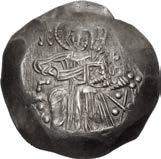
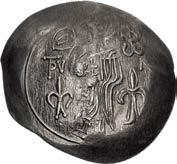
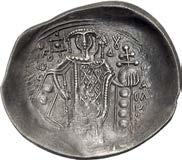
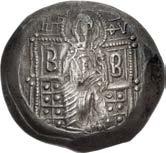
186
Michael
Palaeologus.
Emperor of Nicaea, 1258-1261.
Trachy
777. Andronicus II Palaeologus.
From the Iconodule Collection.
773
774
778. John V Palaeologus(?). Circa 1341-circa 1391. Æ (15mm, 1.44 g, 6h). Crowned half-length figure of emperor, holding scepter and akakia / Long cross, three pellets in each quarter, all within diagonal border of four large B’s. DOC –; LPC –; PCPC 384 (Sub-Byzantine); Schlumberger, Sigillographie pl. XX, 24 (Rhodes); SB –; CNG 54, lot 1954 (John III); cf. CNG 488, 673 (for similar type). Brown patina. VF. Extremely rare, only two examples in CoinArchives. ($500)
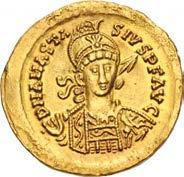
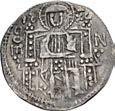
From the Iconodule Collection.
779. John VI Cantacuzene. Second reign, 1353-1354. AR Basilikon (18.5mm, 1.03 g, 6h). Constantinople mint. Christ Pantokrator enthroned facing / Standing facing figures of John, wearing crown and loros and raising hands in adoration, and St. Demetrius, raising hand and holding cross to chest. DOC 1205 var. (sigla); LPC 148, 1 var. (same); PCPC 301 var. (same) SB 1240 var. (same). Attractively toned. VF. Rare. ($1000)

From the Gasvoda Collection. Ex Numismatik Naumann 85 (5 January 2020), lot 729.
EARLY MEDIEVAL COINAGE

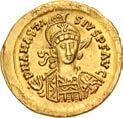
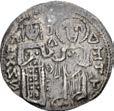


780. AXUM. Ebana. Circa 430-460. AV (17.5mm, 1.46 g, 12h). Crowned and draped bust right, holding scepter, between two grain ears; all within circular border / Draped bust right, wearing head-cloth, holding branch or fly-whisk, between two grain ears; all within circular border. Hahn, Aksumite 34.1; Munro-Hay type 71; BMC Axum 303 var. (H above crown); SACAM 256. Areas of peripheral flat strike, underlying luster. Near EF. ($750)
781. VANDALS. Pseudo-Imperial coinage. Circa 440-490. AV Tremissis (13.5mm, 1.48 g, 3h). Hybrid Ravenna mint issue in the name of Honorius. D И HOИORI VS P F AVC, pearl-diademed, draped, and cuirassed bust right / Cross pattée within wreath with large central jewel; COM[...]. Cf. RIC XI, pl. 51 (for Ravenna mint issues of Valentinian III); MEC 1, –, but cf. 1-2 (AR siliqua [for type]); Bertolami 67, lot 619 (same dies). Lightly toned, deposits in devices, a few marks. Near EF. Extremely rare. ($1000)
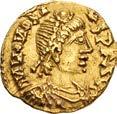
782. OSTROGOTHS. Theoderic. 493-526. AV Solidus (20.5mm, 4.41 g, 12h). In the name of Byzantine emperor Anastasius I (491-518). Rome mint. D N ANASTA SIVS P F AVG, diademed, helmeted, and cuirassed bust facing slightly right, holding spear over shoulder and shield decorated with horseman motif / VICTORI A AVCCC, Victory standing left, holding long, jeweled cross; 1 to left, star to right; Θ//COMOB. COI 6; Lacam 91; MIB 7; BMC Vandals 63; MEC 1, –. Lightly toned, hint of smoothing in obverse field, traces of underlying luster. EF. Rare. ($2000)
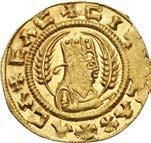

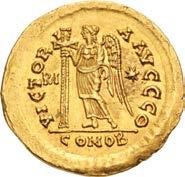
From the Gasvoda Collection, purchased from Sovereign Rarities, January 2020.

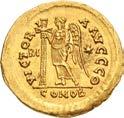
187
778 779
783. OSTROGOTHS. Athalaric to Witigis. 526-534. AV Tremissis (16mm, 1.48 g, 6h). In the name of Byzantine emperor Justinian I (527-565). Rome or Ravenna mint. Struck 527-539. D N IVSTINI ΛNVS P Г ΛVC (sic), diademed, draped, and cuirassed bust right / VICTORIΛ ΛVCVSTORVM, Victory advancing right on ground line with pellet at each end, head left, holding wreath and globus cruciger; star to right; COMOB. COI 37.2 (Rome or Ravenna); MIB 29 (Rome); Ranieri 296 (Ravenna); BMC Vandals 13; MEC 1, 123. Lightly toned, deposits in devices. Good VF. ($750)
From the St. George Collection, purchased from Eternity Coins.
784. VISIGOTHS, Spain. Reccared I. 586-601. AV Tremissis (17mm, 1.45 g, 7h). Toleto (Toledo) mint. ๘ ʽ⍟⍛⍛©ʽ⍟⍷V⌽
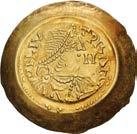
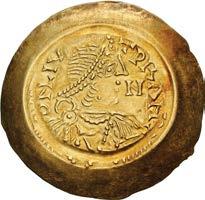
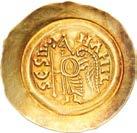
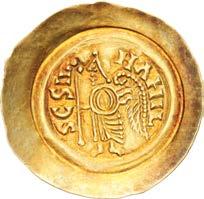
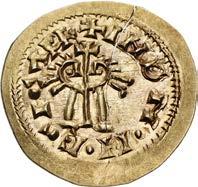
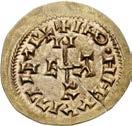

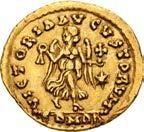
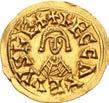
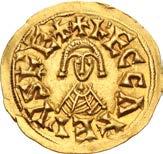
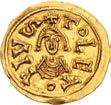
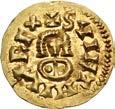
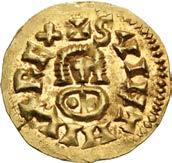

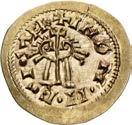
ʽ⍟๘ , facing bust / ๘ ⍆⌴⌦⍟⍆ʊƩV˞ , facing bust. CNV 73.2; MEC 1, 223. Lightly toned. Slight double strike on reverse. EF. ($750)
From the St. George Collection. Ex Classical Numismatic Group inventory 735585 (August 2003); Numismatica Ars Classica 25 (25 June 2003), lot 658.

785. VISIGOTHS, Spain. Swinthila. 621-631. AV Tremissis (19mm, 1.38 g, 6h). Emerita (Mérida) mint. ส ⌽VƩn˶ƊƩǧ© ʽ⍟ᛸ , facing bust / ๘ ⍟Ȱ⍟ʽƩ˶ © ʊƩV⌽ , facing bust. CNV 327; MEC 1, –. Toned, areas of double strike, die rust, traces of underlying luster. Near EF. ($500)
From the CJR Collection.
786. VISIGOTHS, Spain. Egica, with Wittiza. 687-702. AV Tremissis (21mm, 1.34 g, 6h). Emerita (Mérida) mint. ๘ Ʃ n Ć n / Ȱ / ⍟gƩ⍛© Pส , cruciform scepter between confronted busts / Ʃ ( nĆ ) PƩ nƊ⍟ VVƩ˶˶ƩZ ( ©Pส ), EMERITΛ monogram. CNV 580.9 = Pliego 753f.2; MEC –; ME 43. Lightly toned, flan crack. EF. Fragile – not suitable for encapsulation ($750)
) Ʃ⎍ ˶P⎁© ( n⎁X ), pearl-diademed, draped, and cuirassed bust right; n to right / ⌽⍛⌽ ƩƩ H©HƩǮ (sic), St. Michael standing left,
–;
From
188
787. LOMBARDS, Lombardy & Tuscany. Liutprand. 712-744. AV Tremissis (23mm, 1.20 g, 9h). Pavia mint. ē ( n⌦
holding long cross in right hand and round shield in left. Cf. Bernareggi 87-8; Bernareggi, Moneta 8; Arslan –; BMC Vandals
MEC 1, –. Richly toned. EF. ($1000)
the St. George Collection, purchased from Andy Singer.
788. MEROVINGIANS, Tours, St. Maurice. Circa 725-750. AR Denier (13mm, 0.95 g, 12h). แ ⌽üƩ ȵ±ʽ˶Ʃn , diademed bust right / แ ⌽üƩ ȵ±ʽ˶Ʃn , large ⌽ ; pellets flanking. Schiesser, Monnaies 90 (this coin); Garipzanov 83; NM 13; Belfort 4576; MEC 1, –. Richly toned, minor peripheral weakness. Good VF. ($600)

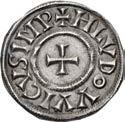
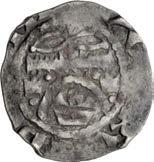
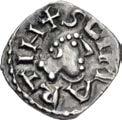
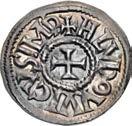
From the St. George Collection. Ex CNG inventory 737091 (February 2004).
789. CAROLINGIANS. Louis ‘le Pieux’ (the Pious). As Emperor Louis I, 814-840. AR Denier (21.5mm, 1.74 g, 8h). Class 2. Bituriges (Bourges) mint. Struck 819-822. แ ƊǮVē⌴VVI⍛Vs IȵP , cross pattée / BI˶V / ʽIűes in two lines; • between. Coupland, Money –; Depeyrot 177; M&G 410; MEC 1, 766-767. Deep iridescent toning. Near EF. ($750)
From the James Fox Collection.
790. CAROLINGIANS. Louis ‘le Pieux’ (the Pious). As Emperor Louis I, 814-840. AR Denier (21mm, 1.71 g, 3h). Class 2. Venecias (Venice) mint. Struck 819-822. แ ƊǮVē⌴VVI⍛Vs IȤ , cross pattée / แ Ven / e⍛I²s in two lines; • between. Coupland, Money –; Depeyrot 1116D; M&G 456; MEC 1, 789. A few light marks under rich tone. EF. ($750)
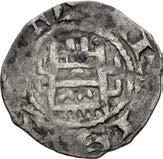

From
The Siege of Jerusalem, 1187
791.
BI Denier
1.13
12h). Struck
of Jerusalem, 1187. แ [• ˶ ] Vē [ ē ] IS [ ē˶V ] Iē (sic), Tower of David / แ [ VV ] Ě [ PVǮýſˊV ] ȉ ēɠȉIɕI , view of the Church of the Holy Sepulcher. Slocum 288; cf. C.J. Sabine, “Numismatic iconography of the Tower of David and the Holy Sepulchre,” NC 1979, pl. 17, 3; N. du Quesne Bird, “Two deniers from Jerusalem, Jordan,” NumCirc LXXIII.5 (May 1965), p. 109; Metcalf, Crusades, p. 77; CCS 51. Toned. Fine. Very rare and of great historical interest. ($2500)
Ex Classical Numismatic Group 96 (14 May 2014), lot 1061.
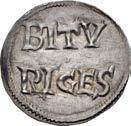
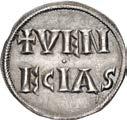
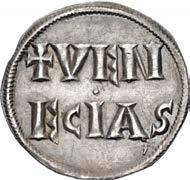
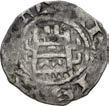
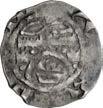

‘Then Balian and the patriarch went and had the tomb edicule of the Sepulchre which was all covered in silver uncovered; and then they had it taken away to be struck into money to give to the knights and sergeants.’– The Chronicle of Ernoul
C. J. Sabine has convincingly argued that these very rare anonymous deniers were an emergency issue struck during the siege of Jerusalem in September 1187. A small Christian force led by Balian of Ibelin mounted a heroic defence against the armies of Saladin, capitulating on October 2nd after the walls were breached. News of the loss of the Holy City sent shock waves through Western Europe and resulted in the Third Crusade.
189
the St. George Collection, purchased from Jean Elsen.
CRUSADERS, Latin Kingdom of Jerusalem. temp. Sybelle. 1186-1190.
(17mm,
g,
during the siege
An Offering of Mongol and Mongol-Related Coinage
To the Western imagination, the word Mongol conjures visions of ruthless hordes sweeping from the East on horseback. This assessment is accurate, especially for the rise of the Mongol Empire and its founder, Chingiz Khan. Born Temüjin, the son of a Mongol chieftain, Chingiz became sole ruler over the Mongol tribes and adopted the name by which he is remembered in AD 1206. Until his death in AD 1227, Chingiz Khan pursued a policy of conquest – first against the Jin and Xia in China and the Qarakhitai and the Khwarizmshahs in Central Asia – then westward, into Georgia and the Volga River area. Compelled to return to Mongolia to deal with the Jin and Xia, Chingiz died after a fall from his horse.
Following the death in AD 1241 of Ögedei, the son and successor of Chingiz as Great Khan, power struggles arose over the succession to the Mongol Empire. Initially, the position of Great Khan passed to Güyük, Ögdei’s son (and grandson of Chingiz). He, in turn, was succeeded by Möngke, the son of Chingiz’s son Tolui. With Möngke’s death, a war of succession arose, and the Mongol Empire irrevocably disintegrated into four independent khanates as a result. While Möngke’s son, Qublai, was nominally Great Khan, he was officially emperor of China and founder of the Yuan dynasty. The others were the Ilkhanate (eastern Anatolia, Mesopotamia, and Persia), the Chaghatai Khanate (south of the Aral Sea to the Altai Mountains), and the Golden Horde (northern Black Sea, north of the Aral and Caspian Seas into the Urals). Each of these khanates continued to rule their respective territories until they themselves were replaced through death or conquest.
Prototype for the Issue of Chingiz Khan
792. Khwarizmshahs. ‘Ala al-Din Muhammad II. AH 596-617 / AD 1200-1220. AR Dirham (18mm, 3.11 g, 3h). Citing the ‘Abbasid caliph al-Nasir. Unnamed (Ghazna) mint. ‘Ala al-Dunya/wa al-Din Muhammad/bin Sultan in three lines; border of small pellets between two lines, all within outer line / al-Nasir/li-Din Allah/Amir al-mu’minin in three lines; border of small pellets between two lines, all within outer line. Tye 207.; cf. SNA Tübingen XIVd, 608; Album 1721. Iridescent toning. Near EF. Excellent condition for this type. ($500)
This particular issue was the prototype for coins of Chingiz Khan that were struck in Ghazna during the Mongol pursuit of Muhammad’s son, Jalal al-Din Mangubarni, who fled south towards India.
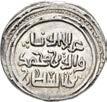
Extremely Rare Mangubarni Dirham
793. Khwarizmshahs. Jalal al-Din Mangubarni. AH 617-628 / AD 1220-1231. AR Dirham (17mm, 3.06 g, 11h). Kurraman mint. Citing the ‘Abbasid caliph al-Mustansir. Uncertain mint. Struck circa AH 623/4-628 / AD 1226-1231. Kufic legend: Jalal al-Dunya wa/al-Din Mangubarn[i]/bin al-Sultan / Kufic legend: al-Mustansir/billah amir/al-mu’minin. Cf. Tye 306/308 (for similar obv./rev. type); SNA Tübingen –; cf. Album 1745.2; ICV 1907. Toned, light cleaning scratches, areas of peripheral weakness. VF. Extremely rare. ($600)
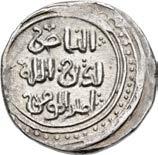
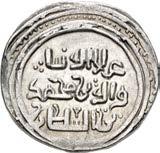
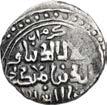
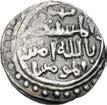
Ex BRN Collection (Classical Numismatic Group Electronic Auction 409, 8 November 2017), lot 817; Classical Numismatic Group Electronic Auction 297 (27 February 2013), lot 525.
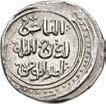
190
Chingiz Khan
794. Great Mongols. Chingiz (Genghis). AH 602-624 / AD 1206-1227. AV Dinar (21mm, 1.82 g, 8h). Bukhara mint. AH date not visible. Shahada in three lines; mint above / Chingiz qa’/an al-’adil a/l a’zam (Chingiz Khan, the just, the great) in three lines; traces of mint and date legend around. Nyamaa –; cf. SNAT XVa 267; Album 1964. Deposits in devices, some areas of weakness. VF. Very rare. ($2500)
Ex Album 33 (17 January 2019), lot 821 (there hammered for $4250).
795. Great Mongols. temp. Chingiz (Genghis). AH 602-624 / AD 1206-1227. AV Dinar (22mm, 2.39 g, 6h). Shum mint. Dated AH [6]18 (AD 1221/2). Kalima in three lines; knotted quadrilobe above; tendrils below; mint formula and AH date in outer margin / Kalima in four lines; mint name above; mint formula and AH date in outer margin. Nyamaa –; L. Adams & W. Warden, Jr., “An unpublished Mongol dinar from the mint of Shum issued by Chingiz Khan,” ONS Newsletter 159 (Spring 1999), p. 7 (this coin illustrated); Album B1967. Traces of toning in devices, a few scrapes and areas of flat strike at periphery. VF. ($750)
Ex Dr. Lawrence A. Adams Collection (Part I, Classical Numismatic Group 100, 7 October 2015), lot 512; purchased from William B. Warden, Jr., September 1998.
796. Great Mongols. Chingiz (Genghis). AH 602-624 / AD 1206-1227. AR Dirham (16mm, 3.08 g, 8h). Citing the

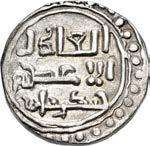

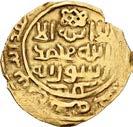
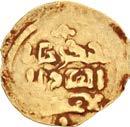
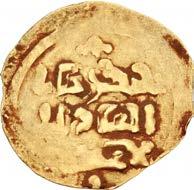
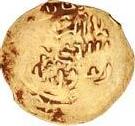
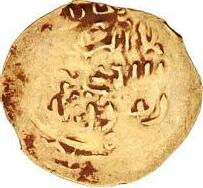
caliph a1-Nasir. Without mint-name (probably struck at Ghazna). Struck circa AH 617/8 (AD 1221/2). Kufic legend: al-adil/al-a’zam/Chingiz khan (The just/The great/Chingiz Khan) / Kufic legend: al-Nasir/li-Din Allah/amir al-mu’minin (al-Nasir/li-Din Allah/Commander of the faithful). Zeno dies A3/B2; Nyamaa 2; Tye 327; SICA 9, 1007 (same dies); SNA Tübingen XIVd, 646 (same dies); Album 1967; ICV 1941. Toned, a touch of horn silver on obverse. EF. Well struck for issue. Rare. ($1000)
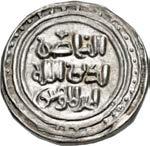
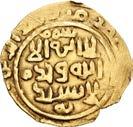
Ex BRN Collection (Classical Numismatic Group Electronic Auction 409, 8 November 2017), lot 820 (includes his collection ticket); purchased from Andy Singer (includes his inventory ticket).
This is the sole silver coin type bearing the name of Chingiz Khan. It was apparently a long-lived issue, evidenced by a declining silver quality, from fine silver to nearly bronze. Good silver issues, as the present coin, are fairly rare. The obverse has the titles and name of Chingiz, while the reverse has the name and title of the reigning Abbasid caliph. The struck date of this issue is based on SICA 9, with the commentary that these coins are “believed to have been struck at Ghazna during the Mongol pursuit of Jalal al-Din
191
‘Abbasid
Khwarizmshah in [AH] 617-618.”
797. Great Mongols. Chingiz (Genghis). AH 602-624 / AD 1206-1227. AR Dirham (16mm, 3.24 g, 6h). Citing the ‘Abbasid caliph a1-Nasir. Without mint-name (probably struck at Ghazna). Struck circa AH 617/8 (AD 1221/2). Kufic legend: al-adil/al-a’zam/Chingiz khan (The just/The great/Chingiz Khan) / Kufic legend: al-Nasir/li-Din Allah/amir al-mu’minin (al-Nasir/li-Din Allah/Commander of the faithful). Zeno dies A3/B2; Nyamaa 2; Tye 327; SICA 9, 1007 (same dies); SNA Tübingen XIVd, 646 (same dies); Album 1967; ICV 1941. Find patina, worn at high points. VF. ($500)
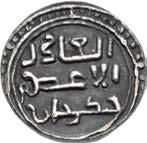


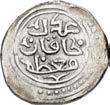
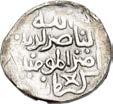
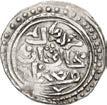
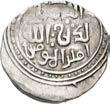
Ex Classical Numismatic Group Electronic Auction 400 (28 June 2017), lot 714.
Kurraman Mint
798. Great Mongols. temp. Chingiz (Genghis). AH 602-624 / AD 1206-1227. AR Dirhem (18mm, 3.10 g, 8h). Kurraman mint. ‘adl/khaqan/mu’azzam in three lines; border of large pellets between two lines / lillah/al-Nasir li-Din/amir al-mu’minin/ Kurraman in four lines; border of small pellets between two lines, all within outer line. Tye 328; Album 1967A. Iridescent toning, areas of peripheral weakness. VF. Extremely rare. ($500)

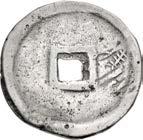
Ex Album 25 (21 September 2012), lot 652.
799. Great Mongols. temp. Chingiz (Genghis). AH 602-624 / AD 1206-1227. AR Dirhem (17mm, 3.14 g, 5h). No mint (prob. Ghaznai or Kurraman). ‘adl/khaqan/mu’azzam in three lines; border of large pellets between two lines / al-Nasir/li-Din Allah/Amir al-mu’minin in three lines; border of small pellets between two lines, all within outer line. Cf. Tye 330 (for obv. [Kurraman]), Tye 327 (for rev. [Ghazna]); Zeno 157718 (this coin). Lightly toned, obverse off center, reverse light double strike. VF. Extremely rare. ($500)
Ex Classical Numismatic Group Electronic Auction 358 (26 August 2015), lot 464; Album 14 (21 September 2012), lot 627.
800. Great Mongols. temp. Chingiz (Genghis) or Qubilay (Kublai). AH 602-624 / AD 1206-1227 or AH 658-693 / AD 1260-1294. AR Cash (23mm, 3.53 g). Qaraqorum type. Uncertain mint. Da Chao Tōng Bǎo (Great dynasty circulating treasure) in Hànzì characters / Blank; countermarks. For coin: Hartill 19.1; cf. B&S, Newly, Type 2, Coin 3; for countermark: B&S, Apropos, p. 43, second example. Traces of deposits, pitting, light marks. VF. ($750)
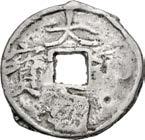
801. Great Mongols. temp. Chingiz (Genghis) or Qubilay (Kublai). AH 602-624 / AD 1206-1227 or AH 658-693 / AD 1260-1294. AR Cash (23.5mm, 3.39 g). Qaraqorum type. Uncertain mint. Da Chao Tōng Bǎo (Great dynasty circulating treasure) in Hànzì characters / Blank; countermarks. For coin: Hartill 19.1; cf. B&S, Newly, Type 2, Coin 3; for countermark: B&S, Apropos, p. 43, second example. Traces of deposits, pitting, light marks. VF. ($750)
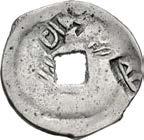
192
800 801
802. Great Mongols. temp. Töregene Khatun. Regent, AH 639-644 / AD 1241-1246. AV Dinar (19.5mm, 4.11 g, 11h). Anonymous Kalima issue. Samarqand mint. Dated AH [6]40 (AD). Album D3750; Zeno 162763 (this coin). Reddish deposits, minor marks and areas of weakness, slightly bent. Near VF. Extremely rare. ($1000)
Ex Album 24 (14 January 2016), lot 455 (there misattributed to time of Chingiz).
803. Great Mongols. Möngke. AH 649-658 / AD 1251-1260. BI Dirham (16mm, 3.09 g, 11h). Uncertain mint. Tamgha flanked by ornament; border of large pellets between two lines / bi-quwwat/afridgar-i/’alam (By the Power of the Creator of the World) in Persian. Nyamaa –; cf. Album 1978E; Zeno 170947. Near EF. Attractive example and rare thus. ($500)


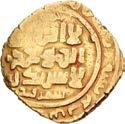

WORLD COINAGE
Australian Convict Token
804. AUSTRALIA, Private Token Issues. Humphrey Wormleighton, convict, transported 1830. Æ Convict Token (36mm, 23.57 g, 11h). Figure standing facing wearing top hat, holding pipe and cup; Humphrey Wormlaton above, aged 23 across field / when/ this you see/ remember mee/ and have mee/ in your mind/ let the world/ say what they/ will Speak/ of me as/ you find stipillated on a smoothed copper penny. Brown surfaces. Very lightly engraved. VF. ($1500)

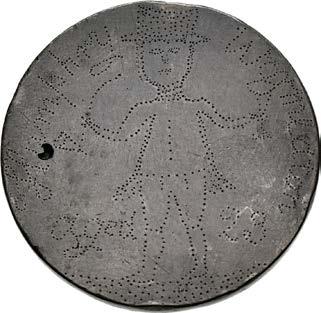
Humphrey Wormleighton (or Wormlaton) was born in 1806 to William and Mary Wormleighton and baptized in Birmingham, England on 18 August. On 13 July 1829, in a trial at the Warwick Quarter Session, Humphrey was convicted of stealing lead and sentenced to 14 years transportation to Australia. The transportation records provide a description: about 5’5”, with hazel eyes and red-brown hair and whiskers. He had several tattoos, including an anchor and fish on his right arm, a mermaid, flower pot, and man’s head on his left arm, a ring on his middle finger, and stars on the back of his left hand and his left forefinger. Traveling aboard the David Lyon, he arrived in Van Dieman’s Land (Tasmania) on 18 August 1830, where he would reside for most of his life. Humphrey married Alfrada Rollings in 1836, with whom he had six children. Humphrey Wormleighton died in Parramatta, New South Wales on 22 November, 1877
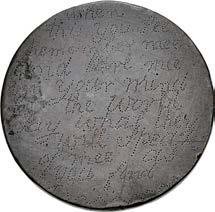
193
802 803
A Female Convict?
Elizabeth Jackson may have been a convict transported to Australia. At least three individuals bearing this name can be found in the records. One, transported aboard the Marquis Cornwallis in 1795-1796 is too early for the host coin. A second, transported aboard the Duchess of Northumberland in 1852-1853 seems too late. If the individual named on this token was indeed a convict, the most likely person appears to be
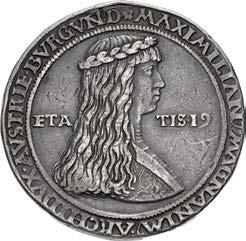
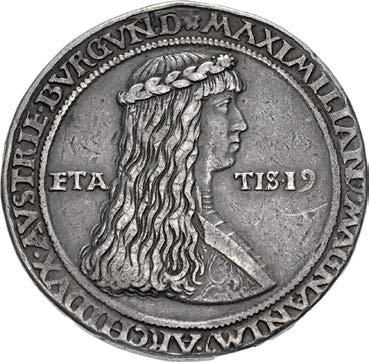
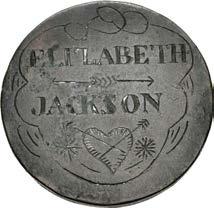
Ursentaler. Dated 1479 (though struck after 1511). ḥ MAXIMILIAN’ • MAGNANIM’ • ARCHIDVX • AVSTRIE • BVRGVND, laureate and mantled bust of Maximilian right; ETA TIS ·19· across field / ḥ MARIA • KAROLI • FILIA • HERES • BVRGVND • BRAB • CONIVGES, draped bust of Maria right; ·ETAT IS ·20· across field. Moser & Tursky 83. Toned. In NGC encapsulation 6529307-006, graded XF Details, obverse tooled. ($3000)

From the CJR Collection.
807.
Holy Roman
Maximilian III. Archduke, 1595-1618. AR Taler (41mm, 28.85 g, 12h). Hall mint. Dated 1614 CO. Armored bust right, wearing ruff / Crowned coat-of-arms within thin wreath. Moser & Tursky 395 var. (CO not in frame); KM 188.2: Davenport 3319. Golden toning with underlying luster, trace of weakness at center, a few light scratches. AU. ($500)


From the James Fox Collection.

194
805. AUSTRALIA, Private Token Issues. Elizabeth Jackson, convict(?). Æ Token (35mm, 20.76 g, 2h). ELIZABETH/ JACKSON over heart pierced by two arrows and flanked by stars; all within decorative border / Serpent (coral snake?) entwined around anchor flanked by stars. All engraved on a smoothed copper coin with an engrailed edge, likely an 1805 Irish penny. Brown surfaces, some roughness. VF. ($750)
the Elizabeth Jackson transported on the Mary Anne in 1839. The possibility also exists that this is simply a love token. The heart pierced by arrows is a classic symbol of love, and the anchor & snake of the reverse might suggest that Elizabeth’s sweetheart was a sailor.
806. AUSTRIA, Holy Roman Empire. Maximilian I, with Mary of Burgundy. As Duke and Duchess of Burgundy, 1477-1482. AR Hochzeitsguldiner (40mm, 10h). On their marriage. Hall mint. By Ulrich
AUSTRIA,
Empire.
808. AUSTRIA, Holy Roman Empire. Maximilian III. Archduke, as Grand Master of the Teutonic Order, 1585-1618. AR Dopeltaler (46mm, 57.28 g, 12h). Hall mint. Dated 1614. Maximilian standing slightly left, holding reversed sword; to left, lion facing, supporting coat-of-arms; to right, crested helmet left; all within wreath / Teutonic knight on horseback rearing right, holding banner and reins; garnished coat-of-arms below; all within border of fourteen smaller coats-of-arms. Moser & Tursky 412; Davenport 5854; KM 30. Toned, minor rim bumps and flan flaw at edge. VF. ($1000)
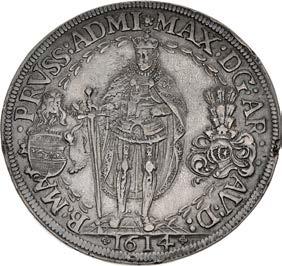
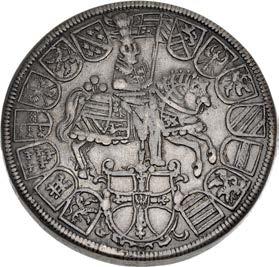
From the Libertas Collection, purchased from Coin Galleries of Westchester.
809. AUSTRIA, Holy Roman Empire. Leopold V. Archduke, 1619-1632. AR Doppeltaler (47mm, 57.25 g, 11h). Hall mint. Posthumous issue, struck 1635. Crowned jugate busts of Leopold, armored and draped, and Claudia right, each wearing ruff / Crowned eagle facing, head left, wings spread; garlanded wreath above. Moser & Tursky 487; Davenport 3331; KM 639. Toned, faint hairlines, some green deposits, edge marks. Near EF. ($500)
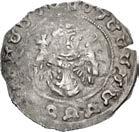
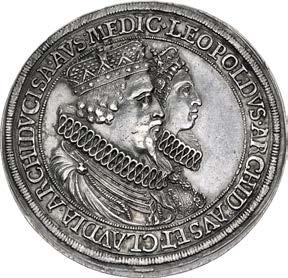
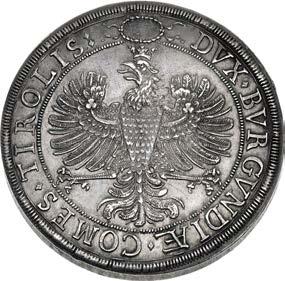
From the CJR Collection. Ex Classical Numismatic Group 53 (15 March 2000), lot 2120.
Pfennigs from Formbach
810
811
810. AUSTRIA, Formbach (Abbey). Anonymous. Circa 1140-1165. AR Pfennig (22mm, 0.83 g). Neunkirchen mint. Six-petalled rosette with pellets at center and in angles, annulets at tips; horseshoes in margin / Abbot facing, holding long cross and crozier. CNA B 52. Traces of find patina, small edge split. VF. ($500)
811. AUSTRIA, Formbach (Abbey). Anonymous. Circa 1140-1165. AR Pfennig (22mm, 0.82 g). Neunkirchen mint. Six-petalled rosette with triple annulets in angles, annulets at center and tips; horseshoes in margin / Abbot facing, holding long cross and crozier. CNA B 52 var. (obverse ornamentation). VF. ($500)
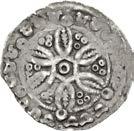


195
812. AUSTRIA, Formbach (Abbey). Anonymous. Circa 1140-1165. AR Pfennig (21mm, 0.90 g). Neunkirchen mint. Six-petalled rosette with trefoils at center and in angles, annulets at tips; horseshoes in margin / Abbot facing, holding long cross and crozier. CNA B 52 var. (obverse ornamentation). Find patina, slightly ragged edge. VF. ($500)
813. AUSTRIA, Formbach (Abbey). Anonymous. Circa 1140-1165. AR Pfennig (21mm, 0.98 g). Neunkirchen mint. Six-petalled rosette with trefoils at center and in angles, annulets at tips; horseshoes in margin / Facing head within polylobe; horseshoes in margin. CNA B 52A. Hints of luster. Good VF. Rare and well struck for issue. ($500)
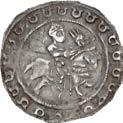
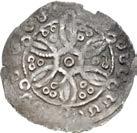
814. AUSTRIA, Formbach (Abbey). Anonymous. Circa 1140-1165. AR Pfennig (21mm, 0.96 g). Neunkirchen mint. Six-petalled rosette with trefoils at center and in angles, annulets at tips; horseshoes in margin / Facing head within polylobe; horseshoes in margin. CNA B 52A. Toned. VF. Rare. ($400)
815. AUSTRIA, Formbach (Abbey). Anonymous. Circa 1140-1165. AR Pfennig (21mm, 0.86 g). Neunkirchen mint. Six-petalled rosette with annulets at centerm in angles, and at tips; horseshoes in margin / Facing head within polylobe; horseshoes in margin. CNA B 52A var. (obverse ornamentation). Traces of find patina. VF. ($400)
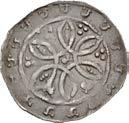
816. AUSTRIA, Formbach (Abbey). Anonymous. Circa 1140-1165. AR Pfennig (22mm, 0.68 g). Neunkirchen mint. Cruciform crosses potent around voided square with star at center; faces in angles / Crowned facing bust holding two long crosses(?); horseshoes in margin. CNA B 53. Find patina. Good VF. Very rare. ($750)
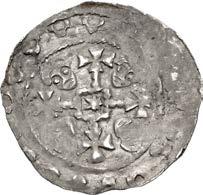
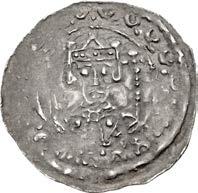
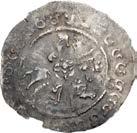
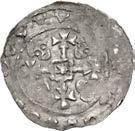

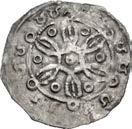
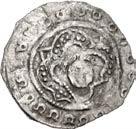
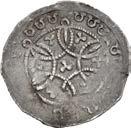
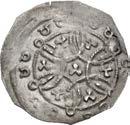
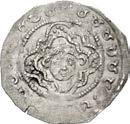
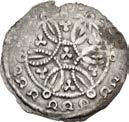
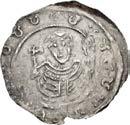
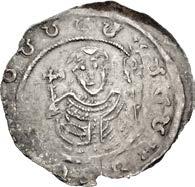
817. AUSTRIA, Formbach-Pütten (County). Ekbert II-Ekbert III. Early 12th century-1158. AR Pfennig (22mm, 0.76 g). Neunkirchen mint. Six-petalled rosette with triple annulets at center, annulets at tips and in angles; horseshoes in margin / Figure on horseback right, holding banner; horseshoes in margins. CNA B 61 var. (obverse ornamentation). Find patina, small edge chip. VF. ($750)
818. AUSTRIA, Formbach-Pütten (County). Ekbert II-Ekbert III. Early 12th century-1158. AR Pfennig (20mm, 0.87 g). Neunkirchen mint. Six-petalled rosette with trefoils at center and in angles, lines of three pellets in lobes; horseshoes in margin / Figure on horseback right, holding banner; horseshoes in margins. CNA B 61 var. (obverse ornamentation). Toned. VF. Remarkably well struck for the series. ($400)
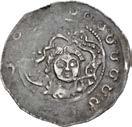
196
813 814 815 817 818
819. AUSTRIA, Formbach-Pütten (County). Ekbert II-Ekbert III. Early 12th century-1158. AR Pfennig (20mm, 0.88 g). Neunkirchen mint. Six-petalled rosette with trefoils at center and in angles, annulets at tips; horseshoes in margin / Figure on horseback right, holding banner; horseshoes in margins. CNA B 61 var. (obverse ornamentation). Toned. Near VF. ($400)
820. AUSTRIA, Formbach-Pütten (County). Ekbert II-Ekbert III. Early 12th century-1158. AR Pfennig (22mm, 0.91 g). Neunkirchen mint. Six-petalled rosette with annulets at center and tips, faces in angles; horseshoes in margin / Figure on horseback right, holding banner; horseshoes in margins. CNA B 61 var. (obverse ornamentation). Areas of weak strike, wavy flan. VF. Unpublished with this unusual ornamentation. ($400)
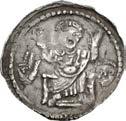
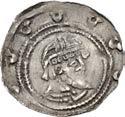
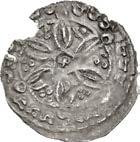
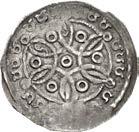
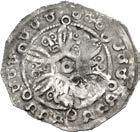
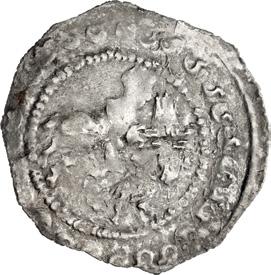
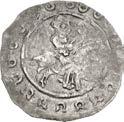
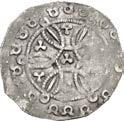
821. AUSTRIA, Formbach-Pütten (County). Ekbert II-Ekbert III. Early 12th century-1158. AR Pfennig (22mm, 0.88 g). Neunkirchen mint. Six-petalled rosette with annulets at center, tips, and in angles; horseshoes in margin / Figure on horseback right, holding banner; horseshoes in margins. CNA B 61B. Toned. VF. Well struck for issue. ($400)

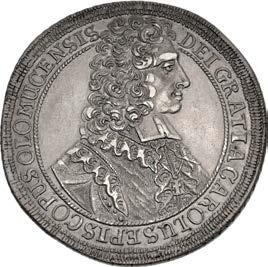
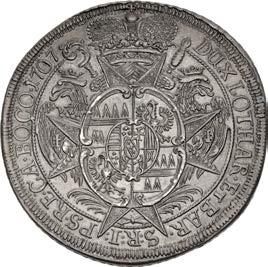
822. AUSTRIA, Formbach-Pütten (County). Ekbert II-Ekbert III. Early 12th century-1158. AR Pfennig (23mm, 0.69 g). Neunkirchen mint. Six-petalled rosette with cross(?) at center, triple annulets in angles, and annulets at tips; horseshoes in margin / Figure standing facing with eyes to heaven, holding sword and shield; small crosses flanking. CNA –; Hauck & Aufhäuser 20, lot 617; Lanz 153, lot 761 = Lanz 147, lot 639. Find patina, double struck, chipped. Good Fine. Very rare. This combination of obverse and reverse type not recorded in CNA. FRAGILE. ($400)
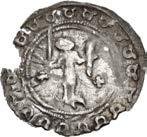
197
823. AUSTRIA, Olmütz (Bistum). Karl III von Lothringen. 1695-1710. AR Taler (44mm, 28.26 g, 12h). Dated 1707 Bust right / Crowned coat-of-arms on crossed sword and crozier; crowned griffn supporters. KM 378; Davenport 1211. Attractively toned, minor cabinet friction, a few edge marks. EF. ($500) From the CJR Collection.
824. AUSTRIA, Steiermark (Margrave). Otakar III. 1124-1164. AR Pfennig (20mm, 0.81 g). Enns mint. Crowned bust right / Figure enthroned facing, raising both arms; benediction hand to left, face to right. CNA B 74a. Toned. VF. Rare. ($750)
819
820
821
822
825. AUSTRIA, Steiermark (Margrave). Otakar III. 1124-1164. AR Pfennig (20mm, 0.81 g, 4h). Enns mint. Helmeted bust right / Figure enthroned facing, raising both arms; candlesticks flanking. CNA B 74b. Small spot of find patina, hints of luster. VF. Rare. Well struck for issue. ($400)
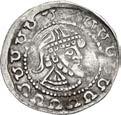
826. AUSTRIA, Steiermark (Margrave). Otakar III. 1124-1164. AR Pfennig (20mm, 0.83 g, 7h). Enns mint. Helmeted bust right / Figure enthroned facing, raising both arms; to either side, leaves within circular frams. CNA B 74 var. (reverse ornamentation). Lightly toned. VF. Rare. Well struck for issue. ($600)
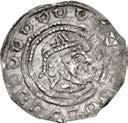
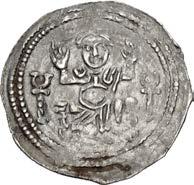
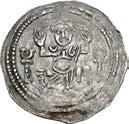
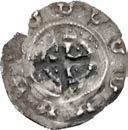
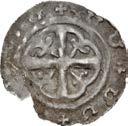
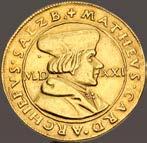
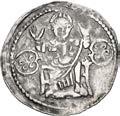
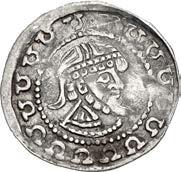
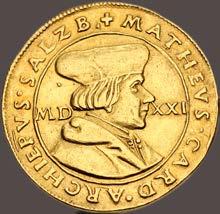
827. AUSTRIA, Steiermark (Margravate or Duchy). Otakar IV. 1164-1192. AR Pfennig (21mm, 0.68 g). Fischau mint. Cross moline; horseshoes in margin / Small cross(?) with pellets in angles, within border; horseshoes in margin. CNA B 71 var. (reverse ornamentation). Find patina, stain, edge chip and crack. Good Fine. ($400)
One of Two Known
828. AUSTRIA, Salzburg (Archbishophric). Matthäus Lang von Wellenburg. 1519-1540. AV 3 Dukat (23mm, 10.61 g, 4h). Dated 1521. Bust right, wearing biretta and mozetta / St. Rupert standing facing, holding salt cellar and crozier; two coatsof-arms flanking. Zöttl 133; Probszt 148; Friedberg 583. Wiped, edge marks, nicks and scratches. Good VF. Extremely rare, apparently one of only two known. ($15,000)
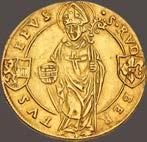
Ex Numismatica Genevensis SA 14 (15 November 2021), lot 220.
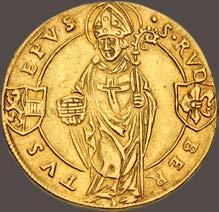
198
Impressive Gold 12 Dukat
Ex Numismatica Genevensis SA 14 (15 November 2021),
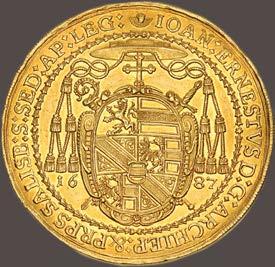
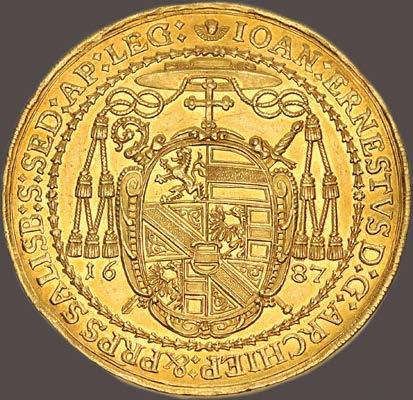
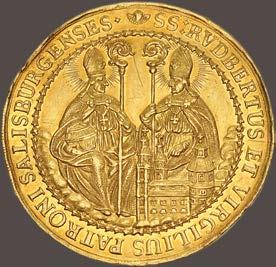
225.

199
829. AUSTRIA, Salzburg (Archbishophric). Johann Ernst von Thun und Hohenstein. 1687-1709. AV 12 Dukat (46mm, 41.85 g, 12h). Dated 1687. Coat-of-arms surmounted by tassled gallero / St. Rupert seated right, holding salt cellar and croizer, and St. Virgil seated left, holding croizer, facing one another; church to lower right. Zöttl 2094; Probszt 1746; KM 264; Friedberg 822. Edge bumps, marks, and a few scratches. Near EF. A very impressive gold multiple. ($30,000)
lot
830. BRAZIL, Empire. Pedro II. 1831-1889. AV 20000 Réis (31mm, 17.90 g, 6h). Rio de Janiero mint. Dated 1852. Bare head left / Crowned coat-of-arms within wreath. KM 463; Friedberg 121. Edge bump. EF. ($750) Ex New York Sale XXIII (6 January 2010), lot 754.
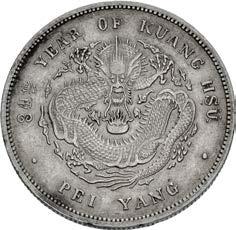
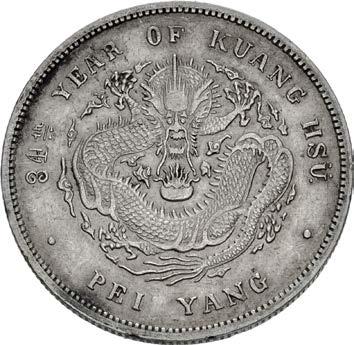
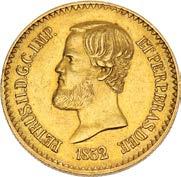
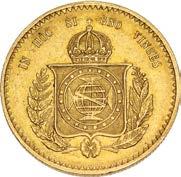
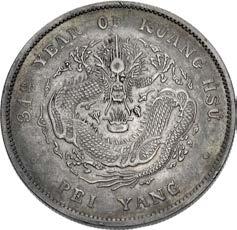
831. CHINA, Qīng dynasty. Dézōng (Guāngxù). AD 1875-1908. AR 7 Mace 2 Candareens – Dollar (38mm, 12h). Zhílì province. Běiyáng Arsenal (Tiānjīn) mint. Dated RY 34 (AD 1908). Legend in Hànzì characters / Flying imperial dragon facing, coiled leftward around fireball and surrounded by stylized clouds. L&M 465; KM (Y) 73.2. Toned. In NGC encapsulation 6529360-013, graded XF 45. ($750)
832. CHINA, Qīng dynasty. Dézōng (Guāngxù). AD 1875-1908. AR 7 Mace 2 Candareens – Dollar (38mm, 12h). Zhílì province. Běiyáng Arsenal (Tiānjīn) mint. Dated RY 34 (AD 1908), though a Republican-era restrike. Legend in Hànzì characters / Flying imperial dragon facing, coiled leftward around fireball and surrounded by stylized clouds. Crosslet 4 in date. L&M 466; KM (Y) 73.3. In NGC encapsulation 6529360-011, graded AU Details, cleaned. ($1500)
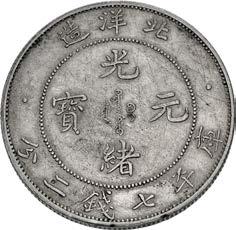
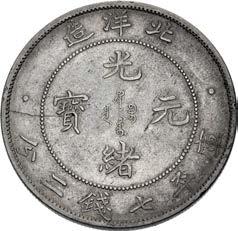
833. CHINA, Republic of China. General issues. 1912-1949. AR Yuán – Dollar (38mm. 12h). Central mint at Shànghǎi. Dated year 9 of the Republic (AD 1920). Bust of Yuán Shìkăi (Yuan Hsi-kai) left, fine hair variety / Value within wreath. L&M 77A; KM (Y) 329.6. In PCGS encapsulation 47538185, graded MS 63. ($1000)
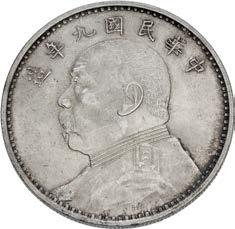
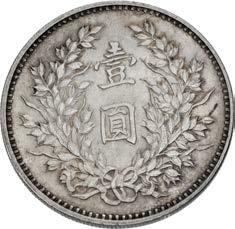
200
834. CHINA, Republic of China. General issues. 1912-1949. AR Yuán – Dollar (39mm, 12h). Central mint at Shànghǎi. Dated year 23 of the Republic (AD 1934). Bust of Sūn Yìxiān (Dr. Sun Yat-sen) left / Junk under sail right. L&M 110; KM (Y) 345. Warm golden toning. In NGC encapsulation 2885717-002, graded MS 63. ($400)
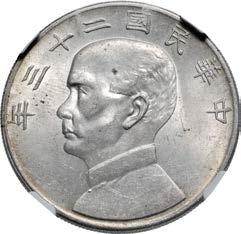
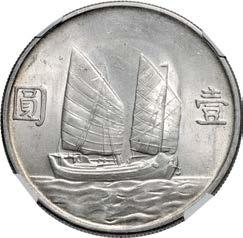
835. CHINA, Republic of China. Provincial issues. 1912-1949. AR Half Tael (35mm, 11h). Húnán (Yunnan) province. Hanoi mint. Struck 1943. Fu in Hànzì characters / Legend in two lines in Burmese and Hànzì characters. L&M 434; KM (X) 1. Toned. In NGC encapsulation 6844159-003, graded MS 63. ($4000)
From the Libertas Collection, purchased 18 September 1974.
836. CHINA, Republic of China. Provincial issues. 1912-1949. AR Tael (38mm, 18.14 g, 10h). Xīnjiāng province. Tihwa (Ürümqi) mint. Dated year 6 (AD 1917). Legend in Hànzì characters / Legend in Persian within wreath. L&M 837; KM (Y) 45. Toned. In NGC encapsulation 6844159-002, graded AU 55. ($2000)
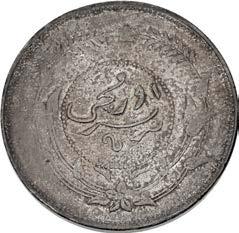
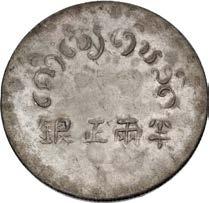
From the Libertas Collection.
837. CHINA, People’s Republic of China. 1949-pres. Proof AV 200 Yuan (27mm, 15.55 g, 12h). Longmen Grotto commemorative. Dated 2002. Carving of Vairocana Buddha at the Longmen Grottoes / Devata flying right, holding tray. KM 1434; Friedberg 232. Proof. In original case and box with certificate of authenticity. AGW: 0.4962 ($1000)
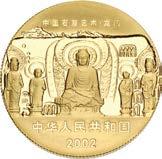
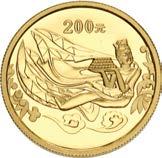
Ex Künker 298 (28 September 2017), lot 4117.
1757 NR J. Armored and draped bust right / Crowned and collared coat-of-arms. KM 32.1; Friedberg 15. In NGC encapsulation 4978416-006, graded AU 53. ($3000)
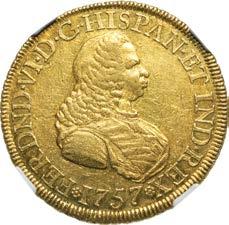
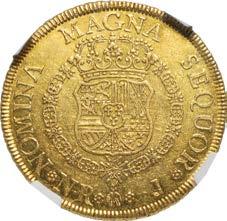
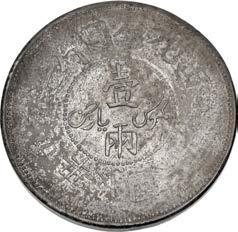
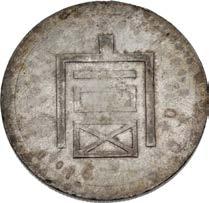
201
838. COLOMBIA, Colonial. Ferdinand VI. King of Spain, 1746-1759. AV 8 Escudos (37mm, 12h). Nuevo Reino (Santa Fé de Bogotá) mint. Dated
836
837
840. CROATIA, Adriatic Coastal Cities. Ragusa (Dubrovnik). Republic of Ragusa. 1358-1807/1814. AR Talir – Taler (43mm, 6h). Dated 1736. Half-length bust of San Blasius right, wearing episcopal regalia, raising hand in benediction and holding crozier and model of city; S B across upper field / Crowned coat-of-arms on crossed sword and scepter. Viščević 14.12; KM 16; Davenport 1636. Light golden toning. In NGC encapsulation 6532176-003, graded AU 58. Top Pop. ($1500)

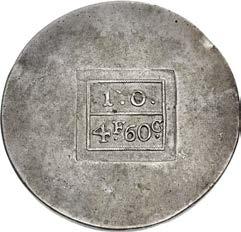
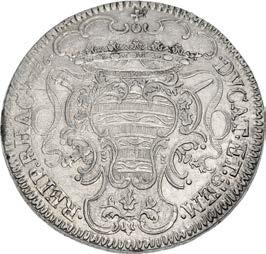

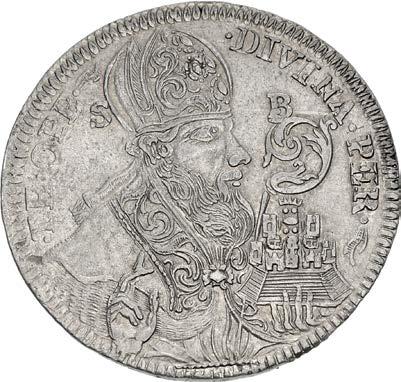
841. CROATIA, Adriatic Coastal Cities. Zadar (Zara). AR 4 Francs 60 Centimes (39mm, 29.87 g, 10h). Siege of Zadar. War of the Sixth Coalition issue. Dated 1813. Crowned eagle standing left on thunderbolt, head right, with wings spread; ZAR to left, 1813 to right; all within diamond incuse / 1.0./4F 60C in two lines on tablet; all within incuse square. On edge: SB, SP and MF in three incuse squares. Korchnak 664; Maillet pl. CXXX, 3; De Mey & Poindessault 854; KM 1. Toned, diagnostic die break. Near EF. Rare. ($1500)
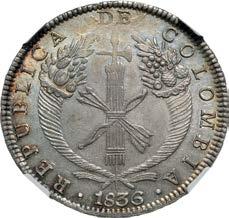
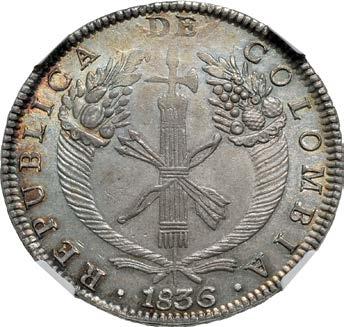
From the Libertas Collection, purchased May 1986.
During the late Napoleonic era, Zara (modern-day Zadar in Croatia) was part of the Illyrian Provinces, a group of states located between Austria and the Adriatic Sea. In the early 1800s, the area was held by Austria, which was embroiled in the Napoleonic Wars. After its defeat at the Battle of Wagram, Austria ceded the territory to France in the 1809 Treaty of Schönbrunn. In an attempt to take back its lost territory, in 1813 Austria declared war on France. When the Austrian General Franz Tomassich entered the Illyrian Provinces, many Croatian soldiers abandoned their French commanders and joined him. After a 34-day siege, the Austrians succeeded in capturing Zara from the French on 6 December 1813. This piece was produced by the French garrison that held the town during the siege.
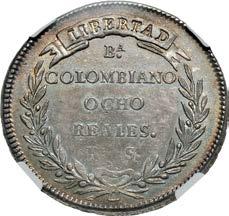
202
839. COLOMBIA, Republic of New Granada. 1831-1858. AR 8 Reales (37mm, 6h). Bogotá mint. Dated 1836 BA RS. Fasces over crossed bow and arrows; all within wreath of two cornucopiae / Legend in five lines within wreath. KM 89. Lovely silken toning. In NGC encapsulation 6383231-006, graded MS 63. Tied for finest at NGC. ($3000)
1934 Reopening of the Kremnica Mines
842. CZECHOSLOVAKIA, Republic. 1918-1939. Set of four (4) gold issues. Commemorating the Re-opening of the Kremnica Mines. Kremnica mint. Dated 1934. St. Catherine kneeling right in prayer; to left, coat-of-arms on rose bush; to right, mining windlass; all within polylobe set within hexagon; floral sprays in margins / Mining scene depicting medieval and modern miners within hexagon; coat-of-arms below, floral sprays in margins.
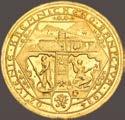
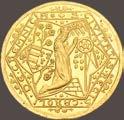

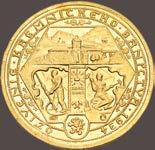
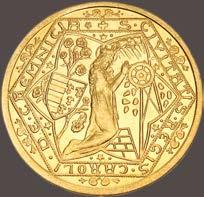
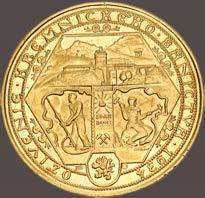
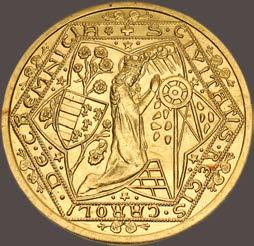
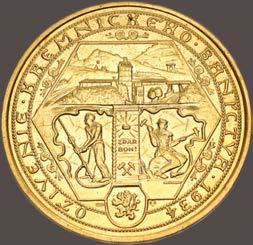
Includes:
(a) 10 Dukát (42mm, 34.92 g, 12h). KM (X) 21; Friedberg 13. In NGC encapsulation 6844908-004, graded MS 63
(b) 5 Dukát (33mm, 17.46 g, 12h). KM (X) 20; Friedberg 14. In NGC encapsulation 6844924-001, graded MS 64 PL.
(c) 2 Dukát (24mm, 6.99 g, 12h). KM (X) 19; Friedberg 15. In NGC encapsulation 6844924-002, graded MS 63 PL
(d) Dukát (20mm, 3.50 g, 12h). KM (X) 14.1; Friedberg 16. In NGC encapsulation 6844924-003, graded MS 64 PL. All NGC encapsulated MS. Four (4) coins in lot. ($30,000)
From the Libertas Collection.
203
a b c d
843. FRANCE, Royal. Philippe VI de Valois (of Valois). 1328-1350. AV Écu d’or à la chaise (28mm, 4.49 g, 10h). 1st emssion. authorized 1 January 1337. Philippe enthroned facing, holding sword; coat-of-arms to right; all within tressure of arches / Ornate cross fleurée with voided quatrefoil at center and leaves in quarters; all within quadrilobe with arches ending in trefoils. Duplessy 249; Ciani 282; Friedberg 270. In NGC encapsulation 6532176-004, graded MS 62. ($1000)
844. FRANCE, Royal. Philippe VI de Valois (of Valois). 1328-1350. AV Écu d’or à la chaise (28mm, 4.50 g, 1h). 1st emssion. authorized 1 January 1337. Philippe enthroned facing, holding sword; coat-of-arms to right; all within tressure of arches / Ornate cross fleurée with voided quatrefoil at center and leaves in quarters; all within quadrilobe with arches ending in trefoils. Duplessy 249; Ciani 282; Friedberg 270. In NGC encapsulation 6844920-012, graded MS 61. ($1000)
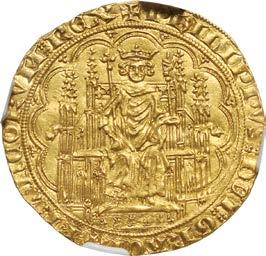
From the St. George Collection. Ex Elsen FPL 243 (January-March 2008), no. 562.
Ex de Wit Collection
845. FRANCE, Royal. Philippe VI de Valois (of Valois). 1328-1350. AV Chaise d’or (28mm, 4h). Authorized 17 July 1346. Philippe seated facing on ornate Gothic throne, lis-tipped scepter in right hand and lis in outstretched left; all within tressure of seven arches; each arch ending in lis; trefoil in spandrels / Ornate cross fleurée with central four petalled flower, bars end in lis flanked by leaves; lis in quarters; all within quadrilobe with arches ending in trefoils, crowns in spandrels. Duplessy 258C; Ciani –; Friedberg 269. In NGC encapsulation 4216450-003, graded MS 64. ($5000)
Ex G.W. de Wit Collection (Part I, Künker 121, 12 March 2007), lot 291; Vinchon (3 February 1986), lot 147.
846. FRANCE, Royal. Jean II le Bon (the Good). 1350-1364. AV Royal d’or (26mm, 3.49 g, 5h). 2nd emission, authorized 15 April 1359. Jean standing facing under gothic dais, holding scepter / Ornate cross fleurée with central rosette; lis in angles; all within tressure of arches. Duplessy 293A; Ciani 359; Friedberg 278. In NGC encapsulation 6532176-005, graded AU 58. ($1000)
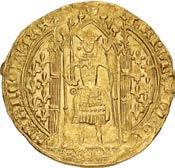

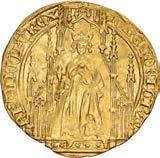
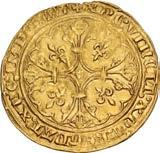
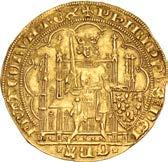
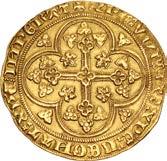
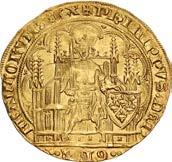
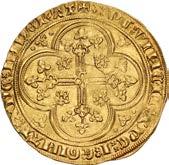
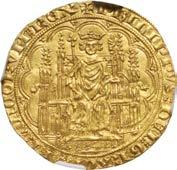
847. FRANCE, Royal. Charles V le Sage (the Wise). 1364-1380. AV Franc à pied (28mm, 3.81 g, 7h). Authorized 20 April 1365. King standing facing within Gothic arch; semé of seven lis to left and right, holding sword with annulet pommel, and main de Justice / Cross tréflée; in center of cross, annulet within angled quadrilobe; lis in first and fourth quarters, crown in second and third; all within angled quadrilobe; lis in spandrels. Duplessy 360A; Ciani 457A; Friedberg 284. In NGC encapsulation 6532187-047, graded MS 65. ($1500)

204
843 844 846 847
848. FRANCE, Royal. Charles V le Sage (the Wise). 1364-1380. AV Franc à pied (28mm, 3.73 g, 6h).
Authorized 20 April 1365. King standing facing within Gothic arch; semé of seven lis to left and right, holding sword with annulet pommel, and main de Justice / Cross tréflée; in center of cross, annulet within angled quadrilobe; lis in first and fourth quarters, crown in second and third; all within angled quadrilobe; lis in spandrels. Duplessy 360A; Ciani 457A; Friedberg 284. In NGC encapsulation 6532187-032, graded MS 65. ($1500)
849. FRANCE, Royal. Charles V le Sage (the Wise). 1364-1380. AV Franc à pied (28mm, 3.78 g, 5h).
Authorized 20 April 1365. King standing facing within Gothic arch; semé of seven lis to left and right, holding sword and main de Justice / Cross tréflée; in center of cross, pellet within angled quadrilobe; lis in first and fourth quarters, crown in second and third; all within angled quadrilobe; lis in spandrels. Duplessy 360; Ciani 457; Friedberg 284. In NGC encapsulation 6532187-001, graded MS 64. ($1500)
850. FRANCE, Royal. Charles V le Sage (the Wise). 1364-1380. AV Franc à pied (28mm, 3.85 g, 3h). Authorized 20 April 1365. King standing facing within Gothic arch; semé of seven lis to left and right, holding sword with annulet pommel, and main de Justice / Cross tréflée; in center of cross, annulet within angled quadrilobe; lis in first and fourth quarters, crown in second and third; all within angled quadrilobe; lis in spandrels. Duplessy 360A; Ciani 457A; Friedberg 284. In NGC encapsulation 6532187-011, graded MS 64. ($1500)
851. FRANCE, Royal. Charles V le Sage (the Wise). 1364-1380. AV Franc à pied (28mm, 3.81 g, 5h).
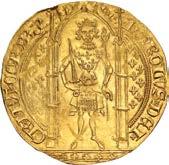
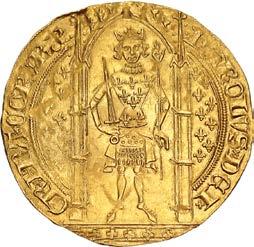
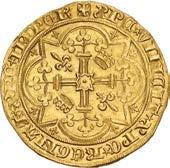
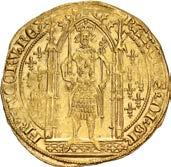
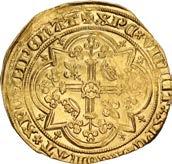
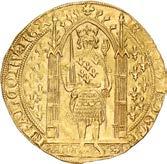

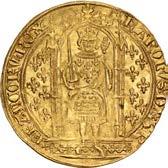
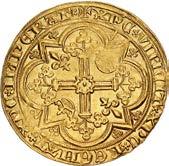
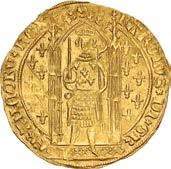
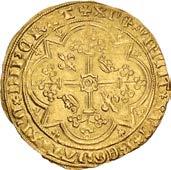
Authorized 20 April 1365. King standing facing within Gothic arch; semé of seven lis to left and right, holding sword with annulet pommel, and main de Justice / Cross tréflée; in center of cross, annulet within angled quadrilobe; lis in first and fourth quarters, crown in second and third; all within angled quadrilobe; lis in spandrels. Duplessy 360A; Ciani 457A; Friedberg 284. In NGC encapsulation 6532187-052, graded MS 63. ($1500)
852. FRANCE, Royal. Charles V le Sage (the Wise). 1364-1380. AV Franc à pied (28mm, 3.80 g, 1h). Authorized 20 April 1365. King standing facing within Gothic arch; semé of seven lis to left and right, holding sword and main de Justice / Cross tréflée; in center of cross, pellet within angled quadrilobe; lis in first and fourth quarters, crown in second and third; all within angled quadrilobe; lis in spandrels. Duplessy 360; Ciani 457; Friedberg 284. In NGC encapsulation 6532187-054, graded MS 63. Exquisite style. ($1500)
205
848 849 850 851
853.
Royal. Charles V le Sage (the Wise). 1364-1380. AV Franc à pied (28mm, 3.77 g, 8h). Uncertain provincial mint. Struck after 1368. King standing facing within Gothic arch; semé of seven lis to left and right, holding sword with annulet pommel, and main de Justice / Cross tréflée; in center of cross, pellet within angled quadrilobe; lis in first and fourth quarters, crown in second and third; all within angled quadrilobe; lis in spandrels. Duplessy 360A/360 (obv./rev.); Dieudonné 792; Ciani –; Friedberg 284; Triton XVII, lot 1000 (hammer $2900). In NGC encapsulation 6844159-001, graded MS 64. The king particularly well struck up. Rare. ($1500)
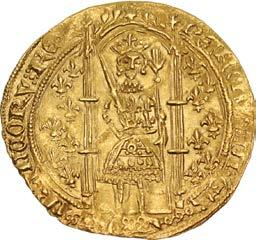
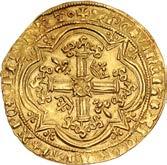

In 1356, French fortunes in the Hundred Years’ War hit their nadir. The French king, Jean the Good, had been captured at Poitiers by Edward the Black Prince of Aquitaine. Negotiations concluded by Charles, the Dauphin, in 1360 saw a significant expansion of Edward’s territory, although in return the English king Edward III promised to renounce his claim to the French throne. In any event the English prevaricated, never fulfilling their part of the agreement, and in 1368 Charles, now king, launched a new campaign against Aquitaine. By 1374 he had taken back all the lands that had been assigned to Aquitaine in 1360, and the Black Prince had departed, a broken man. The newly re-conquered land included the Anglo-Gallic mints of Limoges, Poitiers and La Rochelle, and issues of the franc à pied were struck at these mints, with appropriate mintmarks to distinguish them from the Paris issues. The present specimen is clearly not in the style of the Paris mint, and the annulet mark in the reverse legend most likely indicates a provincial issue. If not an official regal issue, it may have been struck by one of the lesser French lords in the newly recovered province of Aquitaine.
854. FRANCE, Royal. Louis XIV le Roi Soleil (the Sun King). 1643–1715. AR Écu au buste drapé à l’antique (38mm, 27.40 g, 6h). Paris mint; différents: globus cruciger/crescent. Dated 1685 A. Draped bust right / Crowned coat-of-arms. Edge: DOMINE SALVVM FAC REGEM. Duplessy 1506; Ciani 1882; KM 257.1. Adjustment marks with some light hairlines. Lustrous. AU. The first French currency issue to feature a lettered edge. Rare. ($3000)
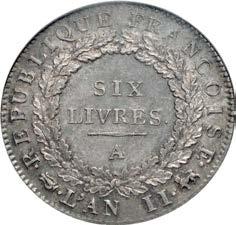

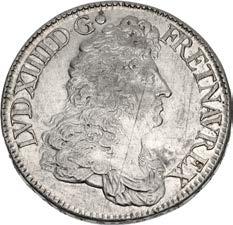
855. FRANCE, First Republic. National Convention. 1792-1795. AR Écu de 6 Livres (37mm, 5h). Paris mint; différents: lyre & lion. Dually dated 1793 A and L’an 2. Winged genius of France standing right, inscribing tablet set on column; fasces surmounted by cap to left; to right, rooster standing left / Denomination within wreath. VG 58; KM 624.1. Toned. In NGC encapsulation 3165951-013, graded MS 62. ($1000)
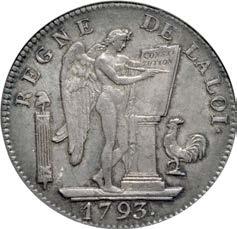
Ex Grundy Collection (Heritage 3004, 4 January 2009), lot 20951; John Jay Pittman Collection (Part III, David Akers, 6 August 1999), lot 4115, purchased from L.S. Forrer, January 1950.
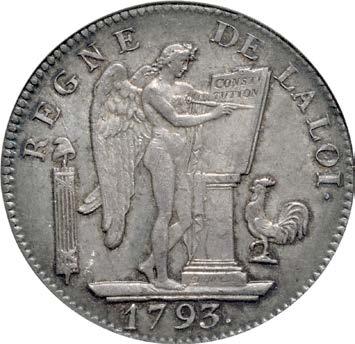
206
FRANCE,
856. FRANCE, First Republic. Consulat. Napoléon Bonaparte. Premier Consul, 1799-1804. AR Franc (24mm, 6h). Paris mint; différents: signature/rooster. Dated L’An 12 A (AD 1803/4). Bare head right / Denomination within wreath. VG 442; KM 649.1. Purple and blue iridescent toning with traces of luster at edges. In NGC encapsulation 6846813-002, graded MS 64. ($500)
From the James Fox Collection.
857. FRANCE, Second Republic. 1848-1852. AR 5 Francs (36mm, 6h). Paris mint; différents: hand and dog’s head. Dated 1849 A. Wreathed head of Ceres left; star above / Denomination and date within wreath. VG 719; KM 761.1. Beautifully toned with significant luster. In PCGS encapsulation 7420685, graded MS 63. A “generation 3.0” slab, circa 1990-1993. Undergraded by modern standards. ($500)

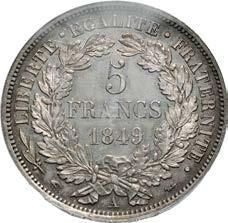

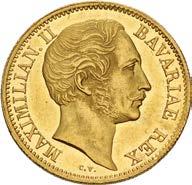
Choice Bavarian Rarity
858. GERMANY, Bayern (Kingdom). Maximilian II. 1848-1864. AV Dukat (20mm, 3.49 g, 12h). München (Munich) mint. Dated 1850. MAXIMILIAN II BAVARIAE REX, bare head right / Crowned coat-of-arms with crowned leonine supporters; EIN DUCATEN above, 1850 below. KM 840; Friedberg 277 note. In NGC encapsulation 6529307-003, graded MS 62. Top pop. With considerable brilliance. A superb example of this extremely rare muled type which combines with the Latin
obverse with German legend on the reverse. Friedberg notes only 100 examples were struck. ($5000)
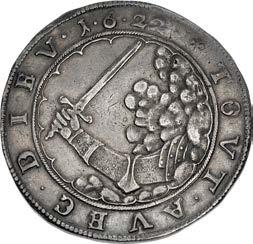
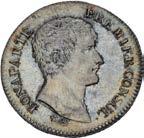
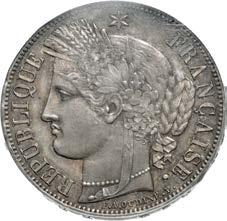
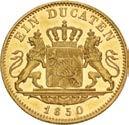

From the CJR Collection.
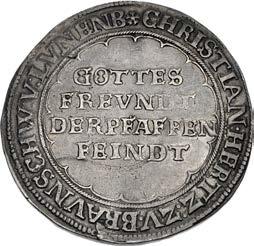
207
legend
859. GERMANY, Braunschweig-Lüneburg-Celle (Principality). Christian. 1611-1633. AR Taler (43mm, 28.82 g, 2h). Pfaffenfeindtaler type. Lippstadt mint. Dated 1622. Legend in four lines / Armored arm wielding sword emerging from clouds to right. Welter 1381; KM 26; Davenport 6320. Toned. Good VF. ($750)
860. GERMANY, Braunschweig-Lüneburg-Celle (Principality). Christian Ludwig. 1648-1665. AR 3 Taler – Löser zu 3 Reichstalern (78mm, 96.14 g, 12h). Zellerfeld mint; mm: crossed keys. Dated 1665 HS. Crowned CL monogram within wreath; around, fourteen crowned coats-of-arms on vines / SINGERE · ET · CON STANTER · AO 1665, wildman standing left, holding tree trunk; in background, view of the countryside including miners and woodworkers. Welter 1501; Davenport 192; KM 256.2. Deep old cabinet tone with minor staining. In NGC encapsulation 6529317-001, graded AU Details, obverse repaired. The repair NGC notes is likely the removal of an old mount, visible on the obverse. ($3000)
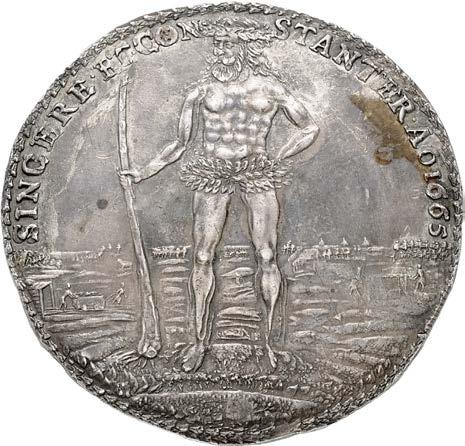
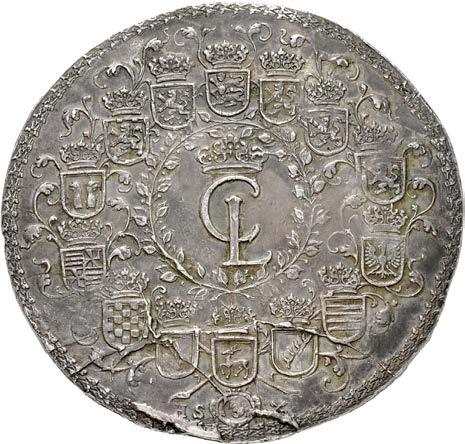
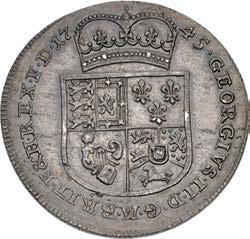
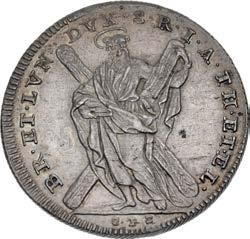
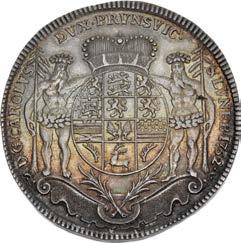
861. GERMANY, Braunschweig-Lüneburg (Principality & Electorate). Georg II. King of Great Britain, 1727-1760. AR Taler (42mm, 29.21 g, 6h). Clausthal mint. Dated 1745 CPS. Crowned coat-of-arms / St. Andrew standing left, head right, carrying cross. Smith 122; Welter 2558; KM 232.1; Davenport 2089. Rich iridescent toning. Choice EF. ($500)
From the Libertas Collection.
862. GERMANY, Braunschweig-Wolfenbüttel (Principality). Karl I. 1735-1780. AR Taler (40mm, 29.04 g, 6h). Yield of the König Carl Mine. Clausthal mint. Dated 1752 IBH. Crowned coat-of-arms with wildman supporters / Two crowned columns flanking marker reading KC; in background, two mining surveyors, each holding stadia rod and surveying chain with level between then; above, banner reading PLVS VLTRA. Welter 2726; KM 946; Davenport 2168. Deep iridescent toning. Near EF. ($1500)
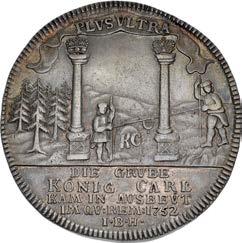
208
From the Libertas Collection, purchased October 1980.
From the Libertas Collection, purchased April 1969.
From the Libertas Collection, purchased December 1991. This lot includes an old flip, copyright 1937, made by H. Sergl,
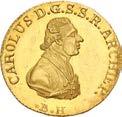
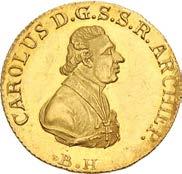
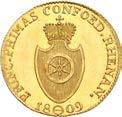
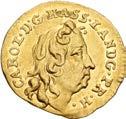


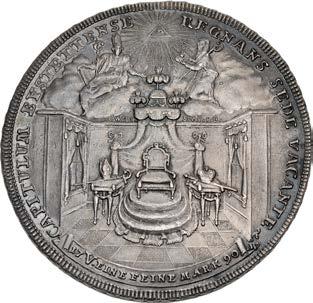
may have at one time been
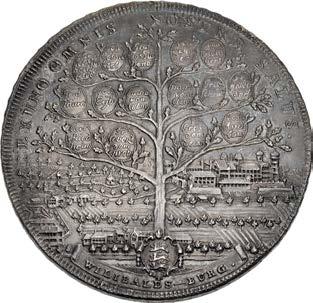
209
863. GERMANY, Eichstätt (Bishophric). Sede Vacante. 1790. AR Doppeltaler (53mm, 55.97 g, 12h). Dated 1790 W. Empty throne on pedestal below baldachin in throne room; above, patron saints Willibald and Walburgis in clouds below streaming eye of God / Oak tree with shields on branches, each inscribed with the name of a member of the college of canons of Eichstätt, before city scene. Cahn 148; KM 90; Davenport 2212. Rich old cabinet toning with deep blue fields. EF. A superb coin with exceptional eye appeal. ($1500)
864. GERMANY, Hessen-Kassel (Landgravate). Karl I. 1670-1730. AV Quarter Dukat (14mm, 0.87 g, 12h). Kassel mint. Struck 1720. Bare head right / Swan right with crown around neck. Schütz 1503; KM 375; Friedberg 1279. Traces of luster. EF. A charming gold fraction. ($500)
865. GERMANY, Rhine Confederation. Karl von Dalberg. Prince-Primate, 1806-1813. AV Dukat (19mm, 3.46 g, 12h). Frankfurt mint. Dated 1809 BH. Bust right / Crowned coat-of-arms. Joseph & Fellner 995; KM 8; Friedberg 2582. Lustrous, a few minor marks. AU. ($1000)
a coin dealer active on Fulton Street in Manhattan in the mid 20th century. The coin
in Sergl’s stock.
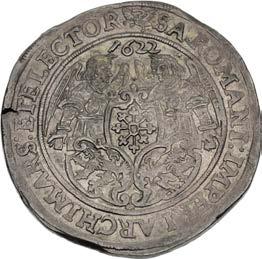
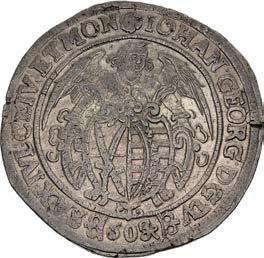
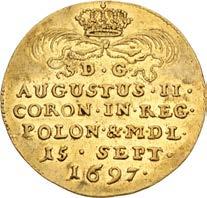
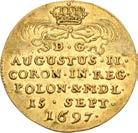
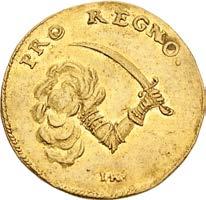
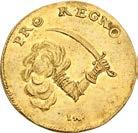
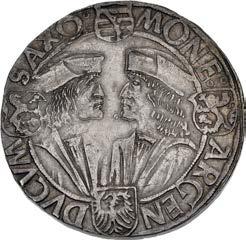
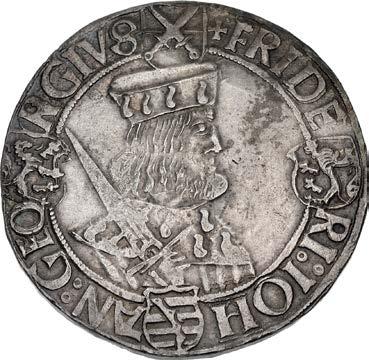
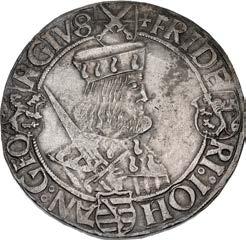
210
866. GERMANY, Sachsen (Duchy & Electorate). Friedrich III der Weise (the Wise), with Johann and Georg. 14861525. AR Taler (41mm, 29.08 g, 4h). Annaberg mint; mm: cross. Struck 1507-1525. Mantled bust of Friedrich right, wearing elector’s cap and holding sword over shoulder / Confronted capped busts of Johann and Georg. Keilitz 44.1; Davenport 9709. Toned, slightly double struck on reverse. Near EF. A high grade example of the type. ($1500)
From the Libertas Collection, purchased September 1980.
867. GERMANY, Sachsen (Duchy & Electorate [Albertine line]). Johann Georg I. Elector, 1611-1656. AR 60 Kipper Groschen (44.5mm, 23.21 g, 12h). Dresden mint. Dated 1622. Angel facing, holding coat-of-arms / Pair of angels holding three coats-of-arms. Rahnenführer/Krug 161; KM 364. Iridescent toning, slight edge splits. EF ($500)
868. GERMANY, Sachsen (Duchy & Electorate). Friedrich August I der Starke (the Strong). Elector, 1694-1733. AV Dukat (22mm, 3.57 g, 3h). Commemorating his Election and Coronation as King of Poland. Dresden mint. Dated 15 September 1697 IK. Arm in armor, protruding from a cloud, holding curved Polish saber / Crown over crossed palm fronds and legend in six lines. Kahnt 247; KM 695; Friedberg 2830. Hints of luster. EF. ($1500)
From the Libertas Collection.
869. GERMANY, Sachsen (Duchy & Electorate). Friedrich August I der Starke (the Strong). Elector, 1694-1733. AV Dukat (22mm, 3.46 g, 10h). On the Vikariat. Dresden mint. Dated 1711. Friedrich on hoseback right; coat-of-arms below / Two crowns and scepters, each on draped table. Kahnt 281; KM 805; Friedberg 2822. Traces of mount. Good VF. ($1000)
From the Libertas Collection.
870. GERMANY, Sachsen-Gotha-Altenburg (Duchy). Friedrich I. 1675-1691. AR Taler (39mm, 14.54 g, 3h). On his death. Gotha mint. Dated 5 August 1691 IT. Draped and cuirassed bust right / Legend in nine lines within border of coats-ofarms, the topmost crowned. KM 116; Davenport 7475. Toned, faint hairlines, small flan flaw at edge. Near EF. ($1000)
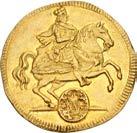
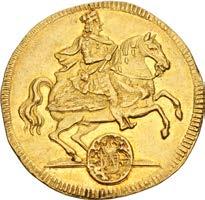
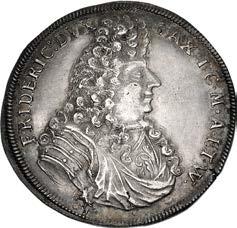
From the Libertas Collection.
871. GERMANY, Sachsen-Weimar (Duchy). Johann Ernst I, with his brothers. 1605-1620. AR Halbtaler (35mm, 14.44 g, 2h). Saalfeld mint. Dated 1615 WA. Armored half-length figures of Johann Ernst, Friedrich, Wilhelm, and Albrecht facing, all wearing ruffs / Armored half-length figures of Johann Friedrich, Ernst, Friedrich Wilhelm, and Bernhard facing, all wearing ruffs. Koppe 199; KM 16. Toned, minor edge marks. Good VF. ($400)

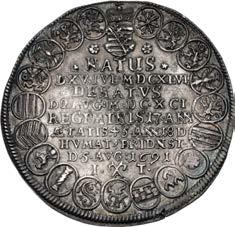
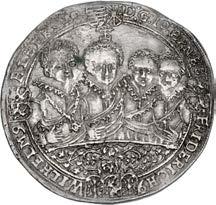
From the CJR Collection. Ex Classical Numismatic Group 49 (17 March 1999), lot 2108.
End of Session 3
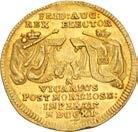
211
Session 4 – Wednesday, September 20, 2023 — 2 PM
872. HUNGARY, Holy Roman Empire. Kingdom of Hungary. Lipót I. 1657-1705. AR Taler (44mm, 28.27 g, 12h). Körmöcbánya (Kremnitz) mint. Dated 1682 KB. Laureate, armored, and draped bust right / Crowned double-headed eagle facing with wings spread, holding sword and scepter; crowned and collared coat-of-arms on breast. Huszár 1371; KM 205; Davenport 3259 (Austria). Toned. Good VF. ($500)
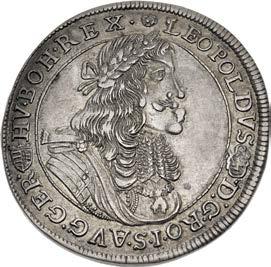
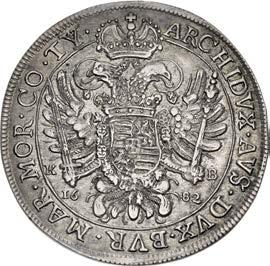
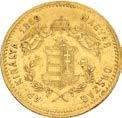
From the Libertas Collection, purchased January 1984.
873. HUNGARY, Austro-Hungarian Empire. Ferenc József. 1867-1916. AV Dukát (20mm, 3.46 g, 10h). Gyulafehérvár (Karslburg / Alba Iulia) mint. Dated 1869 GYF. Károly standing right, holding globus cruciger and scepter / Coat-of-arms set on wreath, being crowned by two angels. Huszár 2108; KM 448.2; Friedberg 238. Traces of luster, scattered marks. Near EF. ($1000)
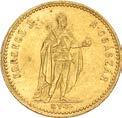
874. HUNGARY, Hungarian People’s Republic. 1949-1989. Proof AV 500 Forint (46mm, 12h). Sesquicentennial of the Birth of Ignaz Semmelweis. Budapest mint. Dated 1968 BP. Bare head of Ignaz Semmelweis right / Coat-of-arms within wreath of wheat ears; star above. Huszár 2368; KM 587; Friedberg 623. In NGC encapsulation 6844918-001, graded PF 65 Ultra Cameo. AGW: 1.2166. ($2000)
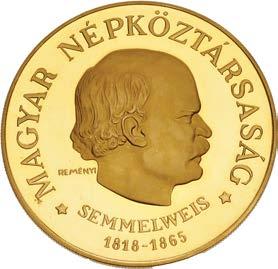
From the Libertas Collection, purchased May 1970.
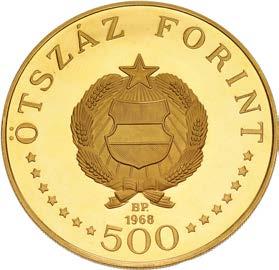
212
875. INDIA, Islamic Sultanates. Gujarat. Nasir al-Din Ahmad Shah I. AH 813-846 / AD 1411-1442. AR Adli. Pedigree issue. Anhilwada Patan mint. Dated AH 815 (AD 1413/4). Shahada; hizz al-’adlee ba-hazrat shahr nahr wala (urf) patan khams wa ‘ashar wa thamanmayah in outer margin / zarb fi zaman al-’abid al raji rahamat allah, ahmad shah bin muhammad shah bin muzaffar shah. CIS –; Zeno 260928 (this coin). In NGC encapsulation 6678825-003, graded AU 53. Extremely rare, none in CoinArchives. ($4000)
876. INDIA, Islamic Sultanates. Gujarat. Ghiyath al-Din Muhammad Shah II. AH 846-855 / AD 1442-1451. AV Tanka. Dated AH 850 (AD 1446/7). al-sultan al-a’zam ghiyath al-dunya wa’l-din / abu’l-mahamad muhammad shah al-sultan; date below. CIS –, but cf. G41 ([CU Falus] for type). In NGC encapsulation 6678825-002, graded AU 55. ($4000) Ex Baldwin’s 53 (25 September 2007), lot 1695.
877.
Gujarat
Qutb al-Din Ahmad Shah II. AH 855-862/3 / AD 1451-1458. AV Fractional Tanka (15.5mm, 3.00 g, 11h). Qutb al-dunya wa’l din Ahmad Shah in four lines / al-khalifa amir al-mu’minin khulidat khilafatahu in five lines. CIS –, but cf. G58 (BI tanka); Zeno 260932 (this coin). Toned, traces of deposits, small delamination on reverse. Good VF. Not suitable for encapsulation. ($5000)

Ex New York Sale XI (11 January 2006), lot 593.
878. INDIA, Islamic Sultanates. Gujarat. Nasir al-Din Mahmud Shah III. AH 944-961 / AD 1537-1553. AV Tanka (20mm, 11.98 g, 7h). Dated AH 952 (AD 1467/8). al-wathiq legend / Name and titles of Nasir al-Din Mahmud Shah III; date above mahmud. CIS G412; Rajgor Type 2376. In NGC encapsulation 6679156-005, graded MS 64. Rare. ($1000)
879. INDIA, Islamic Sultanates. Gujarat. Shams al-Din Muzaffar Shah III. First reign, AH 968-980 (AD 1560-1573). AV Half Tanka (16mm, 5.98 g, 1h). Dated AH 96[8] (AD 1560/1). al-mu’ayyad nasir legend / Name and titles of Shams al-Din Muzaffar Shah III. CIS G566 (weight given as 9.00g). In NGC encapsulation 6679156-001, graded MS 64. ($1000)
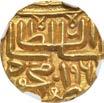
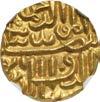

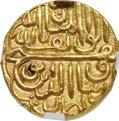

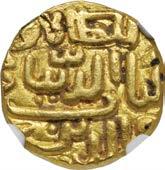
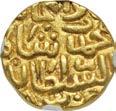
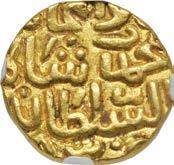

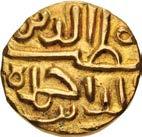
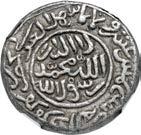
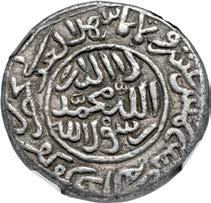
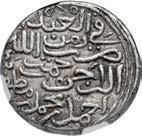
213
INDIA, Islamic Sultanates.
.
878
879
Ex Dix Noonan Webb 164 (9 October 2019), lot 3067; Baldwin’s 45 (3 May 2006), lot 1291 (there reattributed to Malwa).
Nazarana
of the Last Mughal Emperor
Nazarana issues, or presentation coins, for Abu Zafar Siraj al-Din Muhammad Bahadur Shah II are known only for for his regnal years 1 to 6 (1837-1844). Beginning with his predecessor, Akbar II, the British now treated the Mughal emperor – whose rule was limited the Red Fort in Shahjahanabad (Delhi) – as a pensioner, referring to him as ‘King of Delhi.’ In June 1818, the EIC officially closed the mint, although it continued to produce from time to time small numbers of Nazarana issues, which the British Resident at Delhi could present to His Majesty on the occasion of his accession anniversary “to satisfy his feelings” (S. Garg, p. 236).
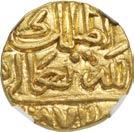
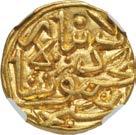
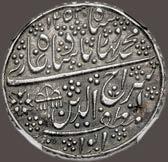
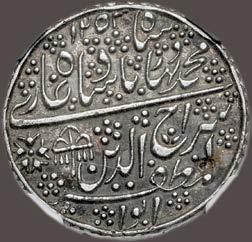
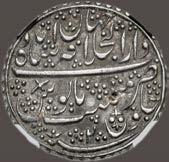
Muhammad Bahadur was the last Mughal Emperor of India and taken prisoner by the British for his suspected support during what the English would call, the Great Indian Mutiny of 1857. He was expelled to Rangoon where he lived in exile till he died on November 7th, 1862.
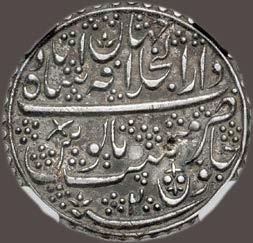
214
880. INDIA, Islamic Sultanates. Malwa. ‘Ala al-din Mahmud I. AH 839-873 / AD 1436-1469. AV Tanka (22mm, 12.74 g, 12h). Citing him as al-khalji. Dated AH 872 (AD 1467/8). CIS G75 ([Gujarat]this coin); ICV 2878 (this coin cited). In NGC encapsulation 6678825-004, graded UNC DETAILS. Test Punch Damage. ($2000)
Rupee
881. INDIA, Mughal Empire. Abu Zafar Siraj al-Din Muhammad Bahadur Shah II. AH 1252-1274 / AD 1837-1857. AR Nazarana Rupee. Dar al-Khalifat Shahjahanabad mint. Dually dated AH 1254 and RY 2 (AD 1839/40). Abu Zafar Siraj al-Din Muhammad Bahadur Shah Badshah Ghazi; AH date above; mintmark for Shahjahanabad to lower left / zarb dar alkhalifat Shahjahanabad sanat 2 maimanat jalus manus. KM 790; cf. Zeno 24255 (fr issue date AH 1253 and ahd). In NGC encapsulation 6679156-006, graded AU Details, edge filing. Shroff marks and small scrape on reverse. An extremely rare coin of great historical interest. ($20,000)
882. INDIA, Independent States. Sikh Empire. temp. Ranjit Singh. VS 1858-1896 / AD 1801-1839. AR Rupee (24mm, 7.95 g, 1h). Mule issue. Peshawar mint. Struck under Hari Singh Nalwa. Dated VS 1893/1894 (AD 1836/7). Gobindshahi couplet; VS date to lower left / Mint and date formula; pipal leaf and star; VS date across field. Cf. Wiggins & Goron Type I (for type); Herrli 13.02.04 (same); Zeno –. Toned, areas of peripheral weakness, small scrape on reverse. Good VF. Rare. ($1000)
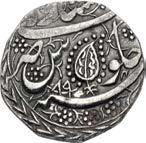
883. ITALY, Milano. First Republic. 1250-1310. AR Grosso ambrosino da 12 imperiali (21mm, 2.93 g, 7h). Class E.3. Struck circa 1278-1280/98. Cross pattée; trilobes in quarters / St. Ambrose enthroned facing, raising hand in benediction and holding croizer. MIR 67; MEC 12, 577-8. Deeply toned with iridescence, a few faint scratches. Near EF. ($500)
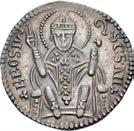


From the James Fox Collection.
884. ITALY, Milano (Duchy). Filippo II di Spagna. 1554-1598. AR Scudo d’argento (41mm, 32.15 g, 11h). Dated 1588. Armored bust right, wearing ruff / Crowned coat-of-arms. MIR 308/14; Crippa 14D. Rich toning with some iridescence in margins, traces of luster, slightly weak and double struck. Near EF. ($500)
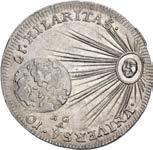
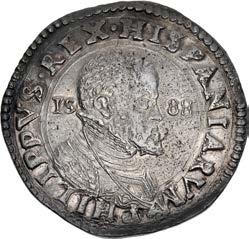
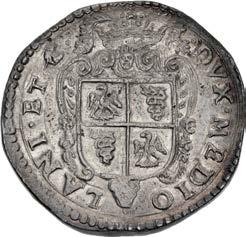
From the Libertas Collection, purchased October 1980.
885. ITALY, Napoli (Kingdom). Carlos I d’Angiò. 1266-1285. AV Saluto d’oro (24mm, 4.38 g, 12h). Napoli (Naples) mint. Struck 1278-1285. Stars, rosettes, and crescent around two-part coat-of-arms of Jerusalem and Anjou / The Annunciation: Archangel Gabriel standing right, holding lily and pointing toward the Virgin standing left, orans, both wearing nimbus crown; lily in vase between. MIR 18; Pannuti-Riccio 1; MEC 14, 675-6; Friedberg 808. In NGC encapsulation 6844936-005, graded MS 60. ($2000)
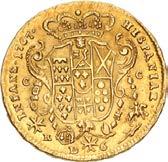
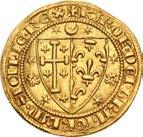
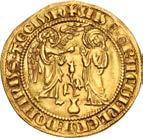
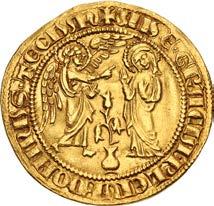
From the Libertas Collection, purchased August 1987.
886. ITALY, Napoli (Kingdom). Filippo V di Borbone. 1700-1707. AR Tarì (25mm, 4.29 g, 6h). Napoli (Naples) mint. Dated 1701 IM AG A. Cuirassed and draped bust right / Globe illuminated by radiant sun to right. MIR 311; Pannuti-Riccio 3; KM 126. Lightly cleaned. AU. ($600)
887. ITALY, Napoli (Kingdom). Ferdinando IV di Borbone. First reign, 1759-1799. AV 6 Ducati (27mm, 8.82 g, 6h). Napoli (Naples) mint. Dated 1767 DЄG CC. Bust right / Crowned and collared coat-of-arms. MIR 352/14; Pannuti-Riccio 10; KM 167; Friedberg 846a. Adjustment marks. Good VF. ($600)
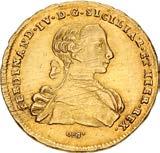
From the St. George Collection.
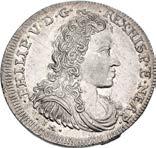
215
882 883 886 887
888. ITALY, Papal (Papal state). temp. Urban V. 1362-1370. AV Fiorino (20mm, 3.52 g, 7h). Avignon mint; segni: crossed keys/mitre. Ornate Lily of Florence / St. John standing facing, holding cross-tipped scepter decorated with pellet and raising hand in benediction. MIR 223/2 (Anonymous issues); Muntoni 2 (Anonymous issues); Berman 201. Toned, a few light scratches. Near EF. ($750)
From the Libertas Collection, purchased 12 August 1987.
889. ITALY, Papal (Papal state). Clement VII. 1523-1534. AV Fiorino di camera (24mm, 3.36 g, 12h). Rome mint. Coat-of-arms surmounted by crossed keys and Papal tiara / St. Peter in boat left, raising fishing net. MIR 787/2; Muntoni 16; Berman 830; Friedberg 60 (Vatican). Slightly wavy flan, minor deposits. Good VF. ($1500)
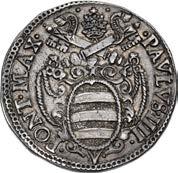
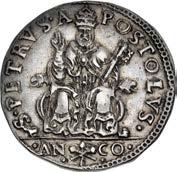
From the Libertas Collection, purchased April 1986.
890. ITALY, Papal (Papal state). Julius III. 1550-1555. AV Scudo d’oro (23mm, 3.40 g, 6h). Rome mint. Dated RY 2 (AD 1552/3). Coat-of-arms surmounted by crossed keys and Papal tiara / Nimbate bust of Christ left. MIR 977/1; Muntoni 4; Berman 984; Friedberg 69 (Vatican). Toned, slightly wavy flan, light scratch. Near EF. Very rare. ($5000)
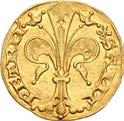
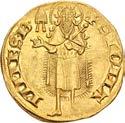
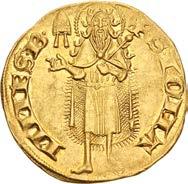
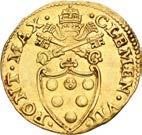

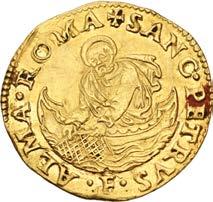
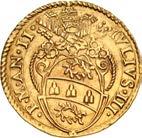
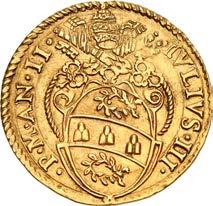
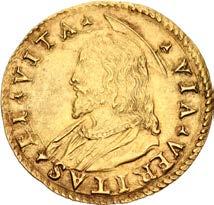
Ex Baldwin’s 71 (29 September 2011), lot 2026 (‘a delightful coin of fine style’); Numismatica Genevensis SA 5 (2 December 2008), lot 886.
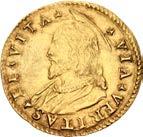
891. ITALY, Papal (Papal state). Paul IV. 1555-1559. AR Triplice Giulio – Testone (29mm, 9.49 g, 8h). Ancona mint. Coat-of-arms surmounted by crossed keys and Papal tiara / St. Peter enthroned facing, holding keys and raising hand in benediction. MIR 1031/12; Muntoni 35; Berman 1045. Richly toned. Near EF ($300)
From the Libertas Collection, purchased June 1984.
216
Pedigreed to 1958
892. ITALY, Papal (Papal state). Sixtus V. 1585-1590. AR Scudo d’argento – Piastra (42mm, 31.88 g, 12h). Rome mint. Dated 1588 and RY 4. Bust left, wearing zucchetto and mantum / St. Francis kneeling left, receiving the Stigmata, rays from on high to upper left; tree to right, city in background to left. MIR 1324/1; Muntoni 7; Berman 1313. Toned. VF. Rare. ($1000)
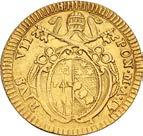
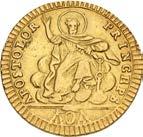
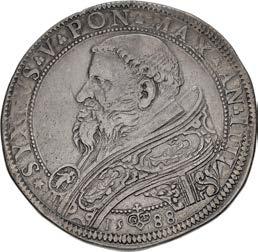
From the St. George Collection. Ex Classical Numismatic Group 115 (16 September 2020), lot 880; Seaby Coin & Medal Bulletin 484 (September 1958), no. C933.
893 894
893. ITALY, Papal (Papal state). Pius VI. 1775-1799. AV Mezza doppia romana (19mm, 2.73 g, 12h). Bologna mint. Dated 1788 GP. Lily plant / Two coats-of-arms, the left surmounted by tasseled gallero. Muntoni 193b var. I; Berman 3034; KM 281; Friedberg 387 (Vatican). Lustrous. AU. ($500)
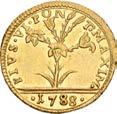
From the Libertas Collection, purchased March 1987.
894. ITALY, Papal (Papal state). Pius VII. 1800-1823. AV Doppia (23mm, 5.52 g, 12h). Rome mint. Dated RY 4 (AD 1803/4). Coat-of-arms surmounted by crossed keys and Papal tiara / St. Peter seated facing in clouds, holding keys and raising hand in benediction. Muntoni 1c; Berman 3217; KM 1070; Friedberg 248 (Vatican). Lightly toned, traces of deposits. VF. ($750)
895. ITALY, Papal (Papal state). Sede Vacante. 1829. AR Mezzo scudo (35mm, 13.22 g, 12h). Rome mint. Dated 1829 R (in Roman numerals). Coat-of-arms surmounted by crossed keys and canopy; above, radiant dove flying left / Personification of the Church seated facing in clouds, holding cross; Papal tiara to left, façade of church in background. Muntoni 3; Berman 3264; KM 1302. Attractive cabinet toning, minor adjustment marks, small edge cut. Superb EF. ($1000)
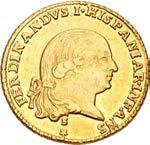
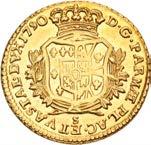
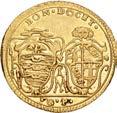
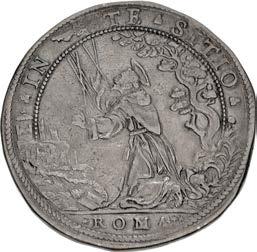
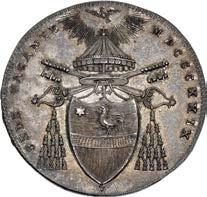

From the Libertas Collection, purchased October 1980.
18a; Friedberg 930. Toned. EF. ($500)
217
896. ITALY, Parma & Piacenza (Duchy). Ferdinando di Borbone. 1765-1802. AV Doppia (24mm, 7.15 g, 6h). Dated 1790 S. Head right / Crowned coat-of-arms within wreath. MIR 1064/6; KM (C)
897. ITALY, Parma & Piacenza (Duchy). Ferdinando di Borbone. 1765-1802. AV Doppia (24mm, 6h). Dated 1791 S Head right / Crowned coat-of-arms within wreath. MIR 1064/7; KM (C) 18a; Friedberg 930. In NGC encapsulation 5863782042, graded AU 58. ($500)
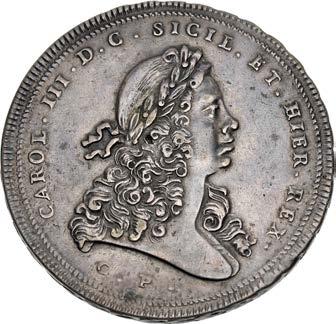
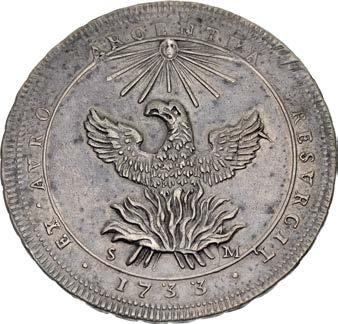
From the St. George Collection.
898. ITALY, Sardegna (Kingdom). Filippo V di Spagna. 1700-1719. AV Scudo d’oro (23mm, 3.24 g, 12h). Cagliari mint. Dated 1701. Crowned coat-of-arms / Cross fleurée. MIR 93/1; KM 27 (Cagliari); Friedberg 145 (Cagliari). Some luster, faint ghosting. Good VF. ($600)
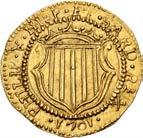
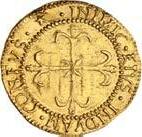
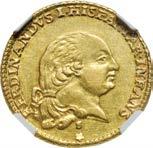
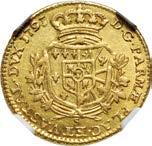

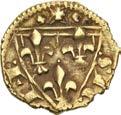
From the St. George Collection, purchased from Baldwin’s. Ex Áureo & Calicó 307 (25 April 2018), lot 2312; Ramon de Muntaner Collection (Áureo & Calicó 259, 24 April 2014), lot 1071.
899. ITALY, Sardegna (Kingdom). Carlo Alberto. 1831-1849. AV 50 Lire (27mm, 6h). Turin mint; mm: eagle head.
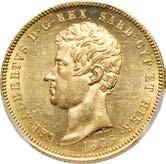
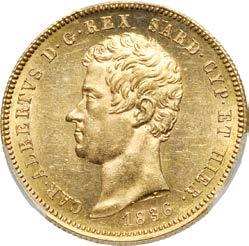
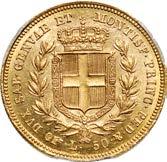

40812052, graded MS 62+. Very rare, with a mintage of only 385. Only one graded higher. ($10,000)
From the Libertas Collection, purchased March 1989.
From the Libertas Collection, purchased October 1980.
218
Dated 1836 P. Bare head left / Crowned and collared coat-of-arms within wreath. MIR 1044c; KM 137.1; Friedberg 1140. In PCGS encapsulation
900. ITALY, Sicily (Kingdom). Carlo I d’Angiò. 1266-1282. AV Tarì (12mm, 0.92 g, 4h). Early coinage, class C1. Struck 1266-1278. Large k ; pellets flanking / Coat-of-arms. MIR 150; Spahr 5; MEC 14, 625. Toned, deposits, usual ragged edge. VF. Very rare. ($750)
901. ITALY, Sicily (Kingdom). Carlo III di Spagna. 1720-1735. AR Oncia – 30 Tarì (55mm, 73.19 g, 6h). Palermo mint. Dated 1733 CP SM. Laureate head right / Crowned eagle facing with wings spread, head left; radiant sun above. MIR 516; Spahr 54; Davenport 1414; KM 134. Toned. In NGC encapsulation 6844918-002, graded XF 45. ($2500)
897 898
From the St. George Collection. Ex Elsen 73 (15 March 2003), lot 1875.
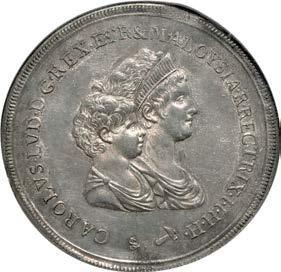
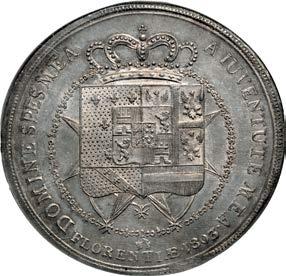

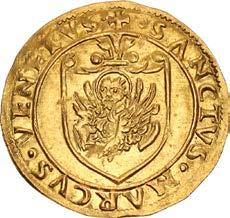
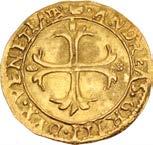
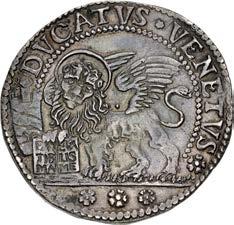
From the St. George Collection.
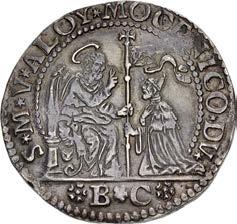
219
902. ITALY, Tuscany (Grand Duchy). Carlo Lodovico, with Maria Luigia. 1803-1807. AR Scudo da 10 lire – Dena (44m, 6h). Series I. Florence mint; mm: hammer. Dated 1803 (LS). Jugate draped busts of Carlo Ludovico, draped, and Maria Luigia, diademed and draped, right / Crowned and collared coat-of-arms. MIR 422/1; KM (C) 491.1. Deep golden toning with significant luster. In NGC encapsulation 6213224-006, graded AU 58. ($500)
903. ITALY, Venice. Andrea Gritti. 1523-1538. AV Scudo d’oro (26mm, 3.37 g, 11h). Cross fleurée; pinecone at end of each bar / Coat-of-arms. Paolucci 3; Friedberg 1448. Highly lustrous. In NGC encapsulation 6844920-013, graded MS 64. ($1500)
904. ITALY, Venice. Alvise II Mocenigo. 1700-1709. AR Ducato (39mm, 20.90 g, 2h). Struck 1700-1701. St. Mark seated right, presenting cross-tipped banner to Doge kneeling left; B C in exergue / Lion of St. Mark standing left, resting paw on Gospel; tower to left. Paolucci 12; KM 454. Toned, some light edge marks. Good VF. ($600)
905. ITALY, Venezia (Venice). Alvise IV Giovanni Mocenigo. 1763-1779. AR Osella (34mm, 9.74 g, 12h). Commemorating the breaking of a treaty by Adriatic pirates. Mario Soranzo, maestra di zecca. Dually dated RY 3 and 1765 BINIS IMMOTA MANEBO, galley at sea left; fortifications to left and right; in exergue, · M : : S / ALOYSII/ MOCENICO/ PRINC : VENE :/ MUNUS AN 3/ 1765 five lines within cartouche; corno Ducale at top. Paolucci, Zecca 248; Werdnig 246. Toned with traces of underlying luster, some adjustment marks. Near EF. ($1500)
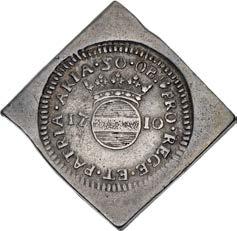
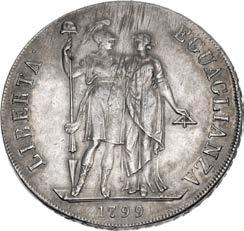
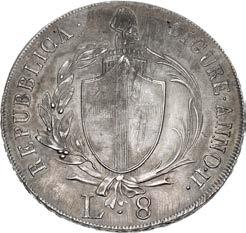
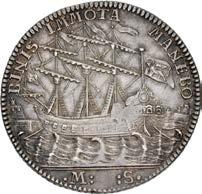
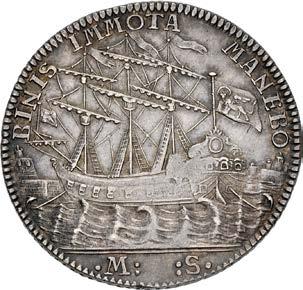
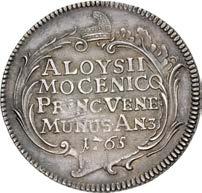
From the St. George Collection. Ex El Medina Collection (Classical Numismatic Group 115, 17 September 2020), lot 905; Luma Collection (Spink 136, 7 October 1999), lot 584 (part of).
906. ITALY, Ligurian Republic. 1798-1805. AR 8 Lire (40mm, 33.25 g, 12h). Genova mint. Dated 1799 and year 2. Liberty, standing right, holding liberty cap set on inverted spear, embracing Liguria standing left, holding level / Coat-of-arms on fasces surmounted by liberty cap; all within wreath. MIR 379; KM 266.1. Toned, adjustment marks. Near EF. ($500)
From the Libertas Collection, purchased January 1984. Reportedly ex Dr. Clifton Wheeler Collection (Part III, Thomas Elder, 17 September 1938), lot 1060.
907. LOW COUNTRIES, Ariën-aan-de-Leie (Airé). AR 50 Sols (30x28mm, 14.69 g). War of the Spanish Succession issue. Besieged by the Austrian and English troops under the command of John Churchill, 1st Duke of Marlborough and François-Eugène de Savoie. Dated 1710. Crowned coat-of-arms / Blank. Korchnak 9; Mailliet pl. I, 5; KM 16.1 (French States). Toned. Good VF. ($500)
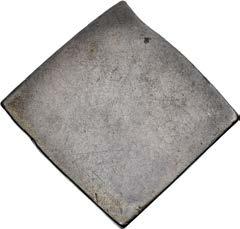
From the Libertas Collection, purchased October 1980.
Throughout its history, the town of Ariën-aan-de-Leie was besieged numerous times. During the War of the Spanish Succession, the Alliance forces, under the command of John Churchill, 1st Duke of Marlborough and François-Eugène de Savoie laid siege to the town with Marlborough’s headquarters near the Priory of St. Andrew. After a siege of two months, the Marquis de Goesbriand, governor of the town, surrendered, handing over the city keys to Marlborough.
220
908. LOW COUNTRIES, Brabant (Duchy). Johanna van Brabant. 1355-1406. AV Franc à cheval (28mm, 3.82 g, 7h). Leuven (Louvain) mint. Struck after 1361. Rider, crowned and in full armor, left on caparisoned horse, holding sword / Cross tréflée and feuillue; in center of cross, • within quadrilobe; all within quadrilobe, trefoil fleurée at end of each arc; trilobe in spandrels. Delmonte, Or 46; Delmonte, Brabant 200; De Mey, Louvian & Brabant 226; Friedberg 10. In NGC encapsulation 6532176-006, graded AU 58. ($1500)
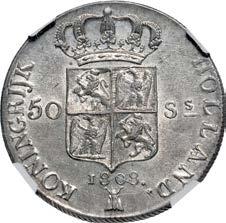
909. LOW COUNTRIES, Vlaanderen (Flanders [County]). Lodewijk II van Male. 1346-1384. AV Gehelmde gouden leeuw – Lion heaumé d’or (34mm, 5.30 g, 2h). Gand (Gent) mint. Struck 1365-1367 and 1370. Helmeted lion standing left before spired Gothic throne / Voided composite cross fleurée with ĕ at center; f ǭ ¨ N in quarters. Elsen 28; Delmonte, Or 460; De Mey, Flanders 196; Friedberg 157. Short scratch on obverse. Near EF. ($3000)
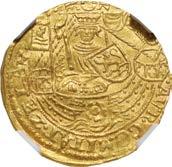
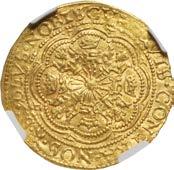
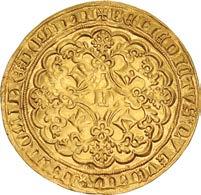
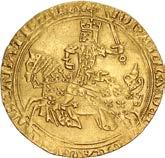
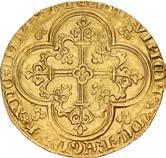
910. LOW COUNTRIES, Burgundian Netherlands. Filips de Goede (the Good). 1419-1467. AV Gouden rijder –Cavalier d’or (28mm, 10h). Dordrecht in Holland mint. First emission, 1434-1454. Knight in full armor and brandishing sword, right on galloping caparisoned horse; ƌɨǭĕ= in exergue / Coat-of-arms over cross quernée. Vanhoudt 1.DO; G&H 1-4; Delmonte, Or 743. In NGC encapsulation 2124314-002, graded AU 55. ($1000)
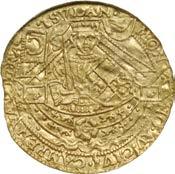
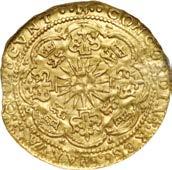
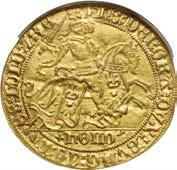
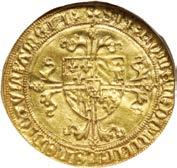
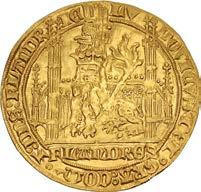
911. LOW COUNTRIES, Republic of the Seven Netherlands (Dutch Republic). Kampen. 1581-1795. AV Halve rozenobel (28mm, 3.72 g, 6h). Im: castle. Struck 1600-1602. Half-length figure standing facing within ship, holding sword and shield; retrograde æ on banner to left, rose on ship / Rayed rose; around, alternating lion passant below crown and lis; all within octalobe. P&W Ka06; CNM 2.30.7; Delmonte, Or 1110; KM 11; Friedberg 152. In NGC encapsulation 2728608-004, graded MS 63. ($1000)
912. LOW COUNTRIES, Republic of the Seven Netherlands (Dutch Republic). Zeeland. 1581-1795. AV Halve rozenobel (28mm, 3.73 g, 1h). Struck 1591-1602. Half-length figure standing facing within ship, holding sword and shield; rampant lion on banner to left, rose on ship / Rayed rose; around, alternating lion passant below crown and lis; all within octalobe. P&W Ze13; CNM 2.49.14; Delmonte, Or 872; KM 3; Friedberg 303. In NGC encapsulation 6613619-009, graded MS 62. ($1000)
913. LOW COUNTRIES, Kingdom of Holland. Lodewijk I Napoleon. 1806-1810. AR 50 Stuivers (36mm, 6h). Utrecht mint; mm: bee. Dated 1808. Bare head right / Crowned coat-of-arms. Schulman 149; KM 28. In NGC encapsulation 5960531-007, graded MS 62. ($500)
From the St. George Collection.

221
908 909 910 911 912 913
914. MAURITIUS, Colonial (as Îles de France et Bonaparte). French. Napoléon I. Emperor, 1804-1814. AR 10 Livres – 10 Piastres (40mm, 26.83 g, 6h). Port Louis mint. Dated 1810. Crowned eagle standing left, head right, clutching thunderbolts in claws / [Denomination] within wreath. MCF 9; KM 1. Toned, usual weak strike on reverse. Good Fine. Rare. ($500)
From the Libertas Collection, purchased September 1974.
This coinage was issued by Charles Decaen, Governor General of Pondicherry and the Isle de France, using silver captured from the Dutch East India Company ship Ovidor. The French commander Pierre Bouvet (1775-1860) was much involved in commerce raiding in the East Indies and with his 16 gun brig the Entreprenant he was successful in taking the Dutch Ovidor with only a single broadside after the ship became separated from a British convoy in the Malacca Straits. Carrying Chinese trade goods and 200,000 piastres, the silver was taken back to the Isle de France and struck into coins in 1810. However, the British captured the island in the same year and melted down the majority of the coins that had been struck.
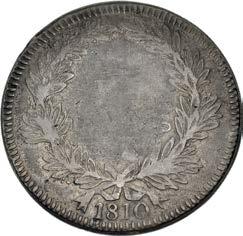
The First Issue of 4 Reales in the Americas
915. MEXICO, Colonial. Juana y Carlos. Queen & King of Spain, 1506-1516. AR 4 Reales (32mm, 13.38 g, 7h). Early series. Mexico City mint; Francisco del Rincón, assayer. Struck 1537-1538. Crowned coat-of-arms / Crowned Pillars of Hercules; PLVS in oval lozenge at center. Nesmith 6b/6a (for obv./rev.); Menzell Mx-11; BW 8. Toned, usual double strike. Good VF. Rare. Among the earliest coinage of the New World and the first 4 Real struck in the hemisphere. Excellent condition for the type with a very clear strike. ($2500)
On 18 November 1537 a royal decree authorized the minting of 4 and 8 Reales at the Mexico City mint, the earliest instance of these denominations in the New World. Only a handful of trial strikes were made for the 8 Real, making the 4 Real the largest collectable denomination from this issue and the first “half dollar” struck in this hemisphere.
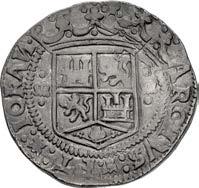
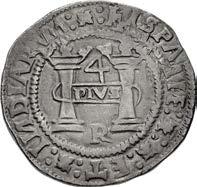

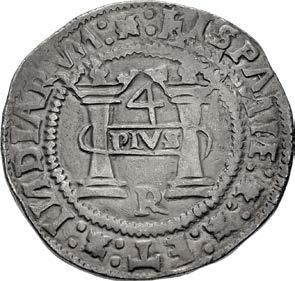

222
A Choice Columnario from the Reijgersdaal Wreck
From the Libertas Collection, purchased August 1981. Ex 1747 Reijgersdaal wreck.
On 24 October 1747, the Dutch East Indiaman Reijgersdaal (or Reygjersdahl) anchored to resupply near Dassen Island, just north of Cape Town, South Africa. But during a storm, the ship’s anchor line snapped and she was dashed on the rocks. A handful of the crew survived and attempted to salvage the eight chests of coins held aboard, but only one was recovered, as the area was too dangerous. Modern recovery efforts began in 1979.
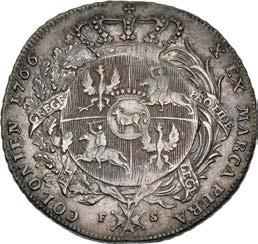
From the Libertas Collection, purchased 13 May 1981.
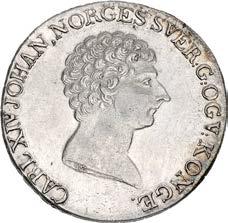
From the Libertas Collection.
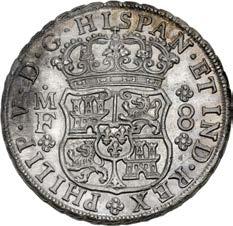
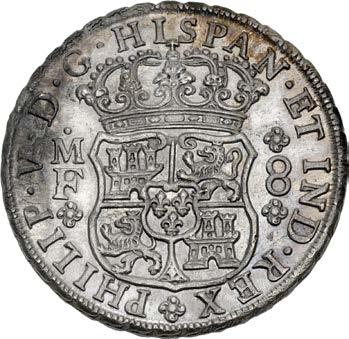

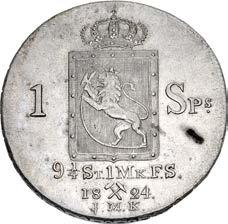
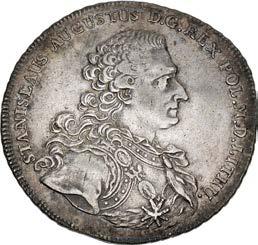
223
916. MEXICO, Colonial. Felipe V. King of Spain, second reign, 1724-1746. AR 8 Reales (38mm, 27.14 g, 12h). Columnario type. Mexico City mint. Dated 1742 Mo MF. Crowned coat-of-arms / Crowned hemispheres between crowned pillars ornamented with banners; all set on waves. Gilboy M-8-4; BW 28.1; KM 103. Minor cleaning marks and traces of shipwreck effect. Choice EF. A superbly preserved shipwreck coin. ($750)
917. NORWAY. Karl III Johan. 1818-1844. AR Speciedaler (38mm, 28.61 g, 12h). Kongsberg mint; mm: crossed hammers. Dated 1824 JMK. Bare head right / Crowned coat-of-arms. ABH 4B; Davenport 240; KM 290. Lustrous, hairlines, spot on reverse. EF. ($1500)
918. POLAND, Monarchy. Stanislaw August Poniatowski. 1764-1795. AR Talar koronny (43mm, 27.80 g, 10h). Warsaw mint. Dated 1766 FS. Armored bust right / Crowned coat-of-arms within wreath of oak and palm fronds. Kopicki 2456; MP 1228; Davenport 1618; KM 187. Toned, faint hairlines. VF. ($750)
919. RUSSIA, Empire. Petr I Alexeyevich Velikiy (Peter the Great). 1682-1725. AR Rouble (41mm, 12h). Kadashevsky mint. Dated 1721 (in OCS numerals). Laureate, draped, and cuirassed bust right / Crowned double-headed eagle with wings spread, holding scepter and globus cruciger. Diakov 32; Bitkin 13.8; KM 157.5. In NGC encapsulation 6529360-003, graded AU Details, cleaned. ($1000)
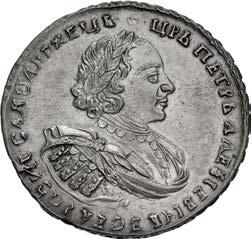
920. RUSSIA, Empire. Petr I Alexeyevich Velikiy (Peter the Great). 1682-1725. AR Rouble (41mm, 12h). Kadashevsky mint. Dated 1722. Laureate, draped, and cuirassed bust right / Crowned cruciform П monogram; I in each quarter. Diakov 15; Bitkin 491; KM 162.1. Toned, delamination on obverse. In NGC encapsulation 6529360-002, graded XF 40. ($1500)
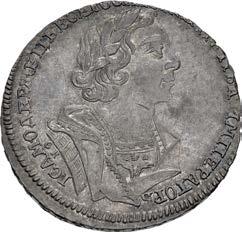
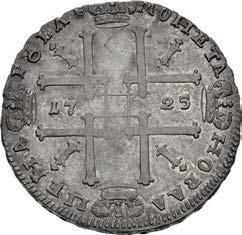
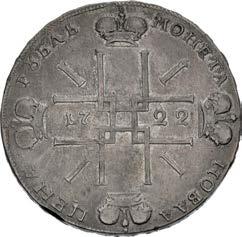
921. RUSSIA, Empire. Petr I Alexeyevich Velikiy (Peter the Great). 1682-1725. AR Rouble (40mm, 12h). Krasny (Red) mint. Dated 1725. Laureate, draped, and cuirassed bust right; ок below bust / Crowned cruciform П monogram; I in each quarter. Diakov 56; Bitkin 986; KM 162.6. Toned. In NGC encapsulation 6529307-010, graded AU 55. ($1000)
From the CJR Collection.
922. RUSSIA, Empire. Yelizaveta Petrovna (Elizabeth). 1741-1762. AR Rouble (41mm, 25.93 g, 12h). St. Petersburg mint. Dated 1743 СПБ. Crowned bust right / Crowned double-headed eagle facing, wings spread, holding scepter and globus cruciger; collared coat-of-arms on breast. Diakov 67; Bitkin 251; KM 19.4b. In NGC encapsulation 6529299-009, graded AU Details, cleaned. ($750)
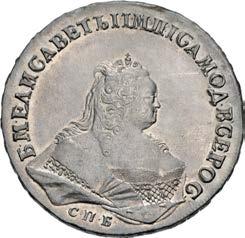
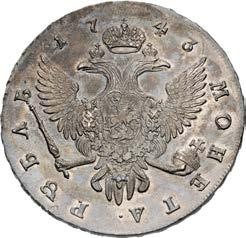
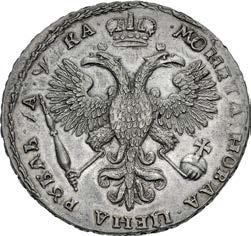
Ex Elsen 149 (10 December 2021), lot 2025.
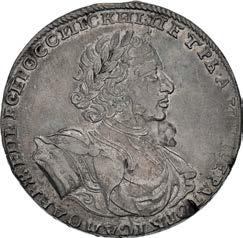
224
From the CJR Collection.
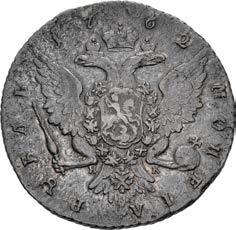
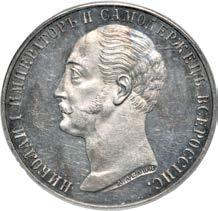
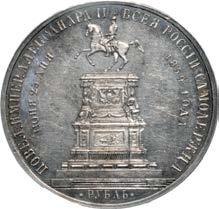
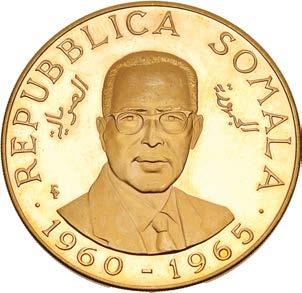
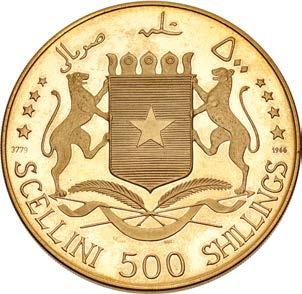
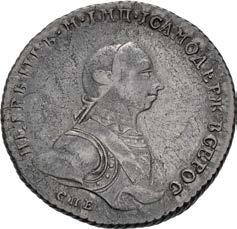
225
923. RUSSIA, Empire. Petr III Fyodorovitch. 1762. AR Rouble (40mm, 12h). St. Petersburg mint. Dated 1743 СПБ HK. Armored bust right / Crowned double-headed eagle facing, wings spread, holding scepter and globus cruciger; collared coat-of-arms on breast. Edge: ////. Diakov 7; Bitkin 11; KM (C) 47.2. In NGC encapsulation 6529307-014, graded AU Details, environmental damage. ($1000)
924. RUSSIA, Empire. Nikolai I Pavlovich. 1825-1855. AR Rouble (35mm, 11h). Commemorating the Monumenta Imperatoru Nikolaiyu I in Sankt-Peterburg. St. Petersburg mint. Dated 25 April 1859. Bare head left / Equestrian statue of Nikolai I Pavlovich left on ornate multi-tier pedestal. Bitkin M569 (Nikolai I); KM (Y) 28. Toned with splashes of blue iridescence and a faint cameo effect. In PCGS encapsulation 4449427, graded AU 50. A “generation 3.0” slab, circa 19901993. ($750)
925. SOMALIA, Republic of Somalia. 1960-1969. Proof AV 500 Scellini – 500 Shillings (50mm, 6h). Fifth Anniversary of Independence. Numismatica Italiana (Arezzo) mint . Dated 1960, 1965 and 1966. Facing bust of president Aden Abdullah Osman Daar / Coat-of-arms with cheetah supporters. Numbered 3779. KM 14; Friedberg 1. In NGC encapsulation 6844918003, graded PF 64 Ultra Cameo. AGW: 2.0254. ($2500)
From the Libertas Collection, purchased October 1970.
926. SPAIN, Aragon. Juan II. 1458-1479. AV Ducat (21mm, 3.48 g, 4h). Aragon mint. Crowned facing bust, holding scepter; fish over C to right / Crowned coat-of-arms. ME 1797; Crusafont 497; cf. MEC 6, 238 (for type); Friedberg 29a. In NGC encapsulation 6488920-008, graded AU 58. Richly toned. Well struck. Rare. ($4000)
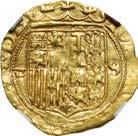
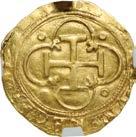
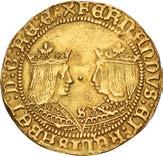
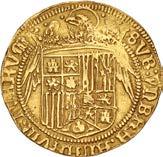

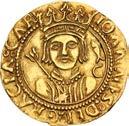
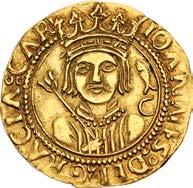
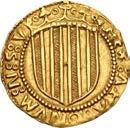
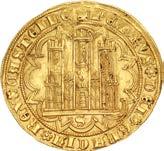

From the St. George Collection, purchased from Baldwin’s.
927. SPAIN, Castile & León. Pedro I el Cruel (the Cruel). 1350-1369. AV Dobla (26mm, 4.51 g, 10h). First period. Seville mint. Struck 1350-1366. Castle façade; ˫ below; all within polylobe / Lion rampant left within polylobe; ʁ to lower left. ME 1280; cf. MEC 6, 532 (for type); Friedberg 108. In NGC encapsulation 6844920-009, graded MS 62. Slight double strike on obverse. Lustrous. ($2500)
From the St. George Collection, purchased from Baldwin’s. Ex Schulman 360 (18 October 2019), lot 81; Münzen und Medaillen AG 30 (5 November 1965), lot 673.
928. SPAIN, Castile & León. Fernando V & Isabel I (Los Reyes Católicos - the Catholic royals). 1474-1504. AV Dobla excelente (26mm, 7.02 g, 10h). Sevilla (Seville) mint. Struck after 1497. Crowned confronted busts of Fernando and Isabel; ˫ between / Crowned coat-of-arms surmounted by nimbate eagle facing, head left, with wings displayed. ME 2926; cf. MEC 6, 772 (for type); Friedberg 129. Edge marks and scratches. VF. ($750)
From the St. George Collection.
929. SPAIN, Castile & León. Juana & Carlos I. 1516-1555. AV Escudo (22mm, 3.37 g, 7h). Sevilla (Seville) mint. Struck after 1535. Crowned coat-of-arms; quadrate D to left, S to right / Cross potent within quadrilobe; each arc ending in annulet surmounted by parsley leaf. ME 3148; Friedberg 153. In NGC encapsulation 6281272-015, graded AU 58. ($500)
From the St. George Collection. Ex Album 43 (12 May 2022), lot 1389.
226
928
929
From the Libertas Collection, purchased October 1980.
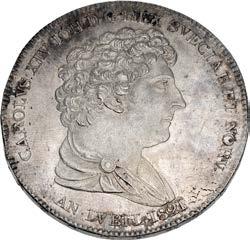
From the Libertas Collection, purchased September 1989.
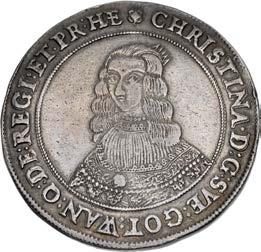
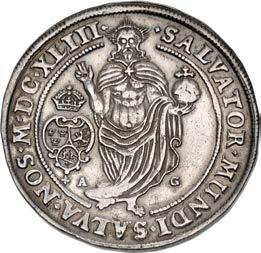
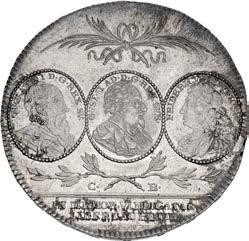
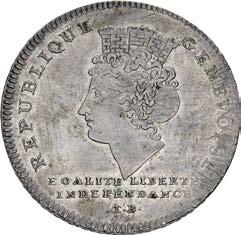
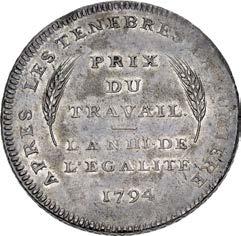
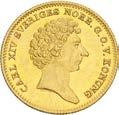
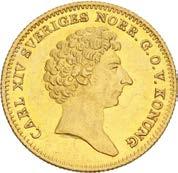
From the Libertas Collection, purchased January 1984.
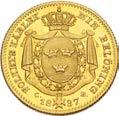
227
930. SWEDEN. Kristina. 1632–1654. AR Riksdaler (43mm, 28.77 g, 12h). Stockholm mint. Dated 1643 AG (in Roman numerals). Crowned bust facing slightly left / Christ standing facing, holding globus cruciger and raising hand in benediction. Delzanno 23; Davenport 4525; KM 187. Toned with some iridescence, a few faint marks on edge. VF. ($1000)
931. SWEDEN. Karl XIV Johan. 1818–1844. AV Dukat (20mm, 3.54 g, 12h). Stockholm mint. Dated 1837 CB. Bare head right / Crowned and mantled coat-of-arms. Delzanno, Guldmynt 36; KM 628a; Friedberg 87. Some light scratches. EF. ($1000)
932. SWEDEN. Karl XIV Johan. 1818–1844. AR Riksdaler (42mm, 29.49 g, 12h). Stockholm mint. Dated 1821 CB Draped bust right / Medallions with busts of Gustav I Vasa, Gustav II Adolf, and Fredrik I; crossed palms above, crossed olive branches below. Delzanno 16; Davenport 350; KM 610. Lightly toned, a few faint hairlines. AU. ($500)
933. SWITZERLAND, Republic and Canton of Genève. Genève. AR Taler (400mm, 30.22 g, 7h). Dated 1794 TB and year 3. Turreted head of Geneva left / Legend and date in six lines between sheafs of wheat. HMZ 2-339g; Davenport 1768; KM 98. Attractive cabinet toning, a few adjustment marks. AU. ($500)
934. SWITZERLAND, Swiss Confederation. 1848-present. AR 5 Francs (37mm, 24.95 g, 6h). Bern mint. Dated 1874 B. Helvetia seated left, resting arm on coat-of-arms; plow in background to right, mountains in background to left / Denomination and date within wreath. HMZ 2-1197d; Davenport 376; KM 11. Lightly toned. AU. ($500)
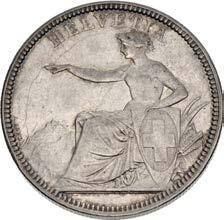

935. TIBET, Qīng Chinese authority. 1724-1913. AR Sho (26mm, 3.55 g, 12h). Dated year 60 of Gāozōng (Qiánlóng) (AD 1795). Legend in Hànzì characters / Legend in Tibetan characters. L&M 640; KM (C) 72. Toned. Near EF. ($750) From the St. George Collection.
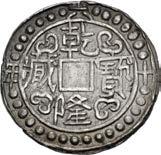
936. TRANSYLVANIA, Principality. Zsigmond Báthory. Third reign, 1601-1602. AR Taler (34x34mm, 28.21 g, 12h). Brassó (Kronstadt / Brașov) mint. Dated 1601. Crowned double-headed eagle facing with wings spread; crowned coat-of-arms on breast / Crowned tree roots. Resch 4; MBR 613; Davenport 4682A; KM 7. Toned. In NGC encapsulation 2144638-001, graded VF 25. ($1500)


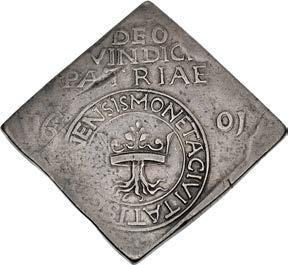
From the Libertas Collection.
937. TRANSYLVANIA, Principality. Gábor Báthory. 1608-1613. AR Taler (38mm, 29.16 g, 12h). Nagybánya (Frauenbach / Baia Mare) mint. Dated 1609/8. Armored half-length bust right, holding mace over right shoulder and resting hand on hilt of sword / Crown over three coats-of-arms; all within ourouboros. Resch 33; MBR 851; Davenport 4700; KM 52. Toned. In NGC encapsulation 6844936-004, graded AU 50. ($2500)
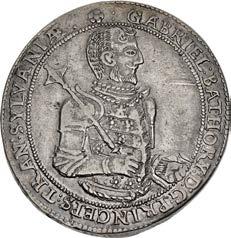
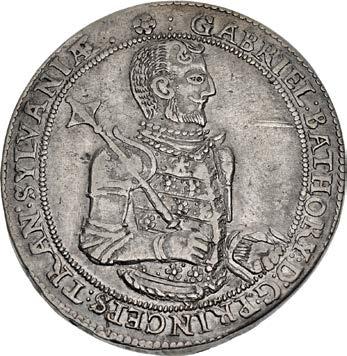
From the Libertas Collection, purchased October 1980.
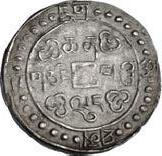
228
From the Libertas Collection, purchased February 1985.
From the Libertas Collection.

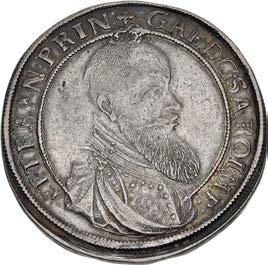
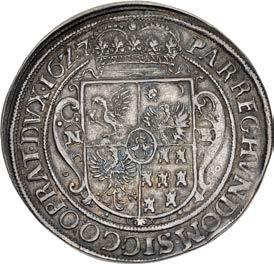
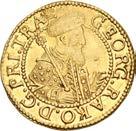
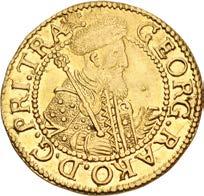
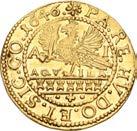
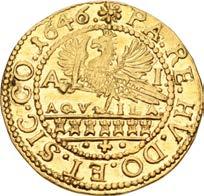
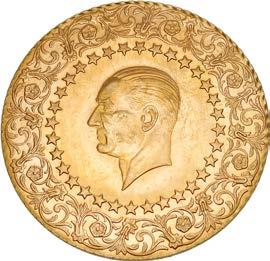
229
938. TRANSYLVANIA, Principality. Gábor Bethlen. 1613-1629. AR Taler (44mm, 28.32 g, 2h). Nagybánya (Frauenbach / Baia Mare) mint. Dated 1627 NB. Armored and draped bust right / Crowned coat-of-arms. Resch 395; MBR 1752; Davenport 4720; KM 182. Rich iridescent toning, weak strike on obverse. VF. ($1000)
939. TRANSYLVANIA, Principality. György Rákóczi I. 1630-1648. AV Dukát (22mm, 3.44 g, 12h). Gyulafehérvár (Karslburg / Alba Iulia) mint. Dated 1646 AI. Half-length armored bust right, holding scepter over shoulder and resting hand on hilt of sword, wearing short brimmed fur cap with feather / Crowned eagle standing left, holding sword, atop seven small towers. Resch 46; MBR 2004; KM 261; Friedberg 384. In NGC encapsulation 6844932-014, graded AU 58. ($3000)
940. TURKEY, Republic. 1923-present. AV 500 Kurush (45.5mm, 35.15 g, 12h). Monnaie de Luxe. Istanbul mint. Dated 1969. Head of Kemal Ataturk left within border of stars and floral pattern / Legend within border of stars and floral pattern. KM 874; Friedberg 94. Toned, proof-like fields, some hairlines and marks. UNC. 1.0338 oz AGW ($1500)
From the Libertas Collection, purchased from Joel Coen, 22 October 1969.
WORLD MEDALS
The Arch of Titus
941. ANCIENT THEMES. Panel of Relief from the Arch of Titus Showing Spoils from the Fall of Jerusalem. Cast Brass Plaquette (157x95mm, 441.53 g). Unsigned, but by the school of Andrea Briosco detto il Riccio (1470 – 1532). Circa late 15th-early 16th century. Panel from the Arch of Titus showing the menorah and the table of the showbread being carried by the victorious Romans / Blank. Calveri, Creazione del Rinascimento (Rome, 2003), 56 (this example). Brown patina with traces of red. As made. Very rare. ($4000)
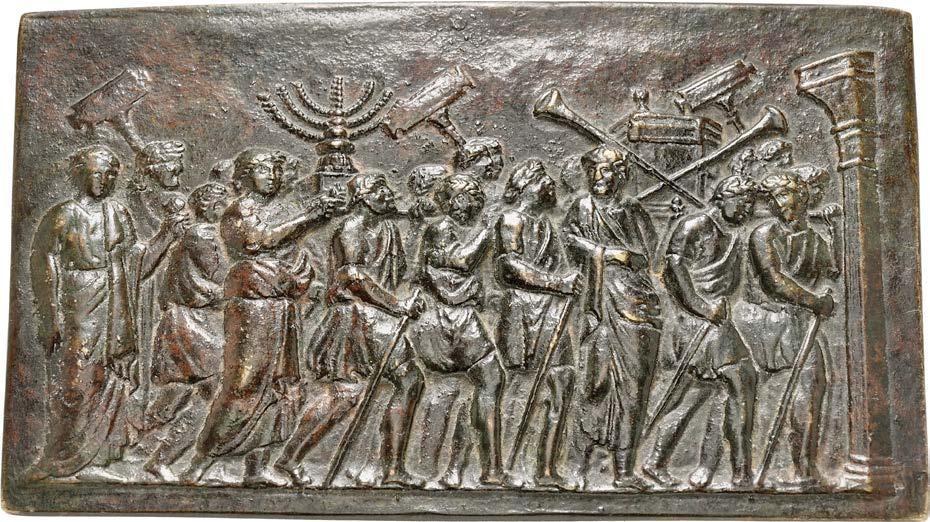
Ex Numismatica Ars Classica 53 (7 November 2009), lot 751.
942. AUSTRIA, Austro-Hungarian Empire. Franz Josef I. 1867-1916. Nickel-plated Æ Medal (72mm, 136.60 g, 12h). Bicentennial of the Liberation of Vienna from the Turks. By A. Scharff and J. Tautenhayn. Dated 1693 and 12 September 1893 (in Roman numerals). ★ IN DANKBARER ERINNERUNG AN VERTHEIDIGUNG UND ENTSATZ ★DIE STADT
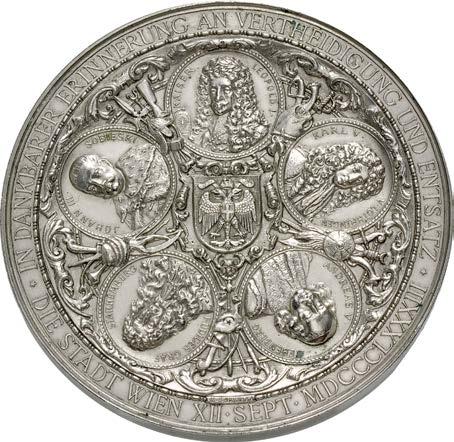
WIEN XII ◊ SEPT ◊ MDCCCLXXXIII, five rondels depicting Emperor Leopold I, Karl V Duke of Lorraine, Andreas van Liebenberg, Rüdiger Count of Starhemberg, Jan II Sobieski around central coat-of-arms; all divided by arms and armor in ornate scroll; below in cartouche, A · SCHARFF / VRBS ◊ PRO ◊ ORBE, warrior standing facing, holding spear, atop fallen Ottoman and his shield; to either side, Law, seated left and hold fasces, and Vienna, seated right, head left, holding coat-ofarms; J TAUTENHAYN · to lower right; in exergue, MDCLXXXIII. Hauser 1693. Lightly toned. EF. ($1000)
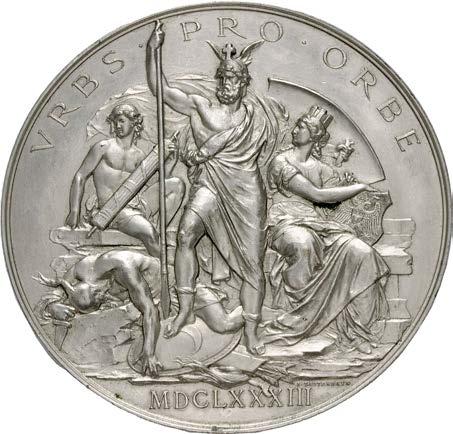
230
943. AUSTRIA, Austro-Hungarian Empire. temp. Franz Josef I. 1867-1916. AR Medal (69mm, 142.27 g, 12h). 150th Anniversary of the Birth of Johann Wolfgang von Goethe. By Anton Scharff. Dated 1899. GOETHE to left, bust right; A. Scharff/1899 in two lines right / Depiction of the Prologue in Heaven of Goethe’s Faust; dialogue between God in center and Mephistopheles to right; behind God stand the Archangels Raphael, Gabriel, and Michael; castle below clouds. Edge: hallmarks and collector’s stamp. Förschner 158. Iridescent toning, some light marks. EF. ($750)
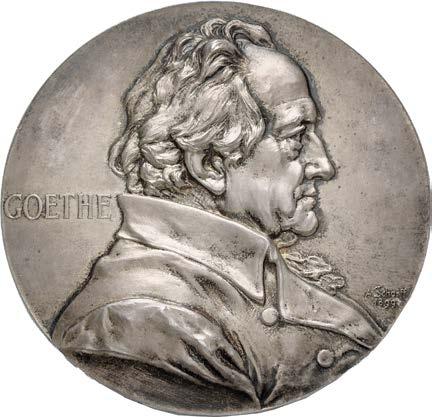
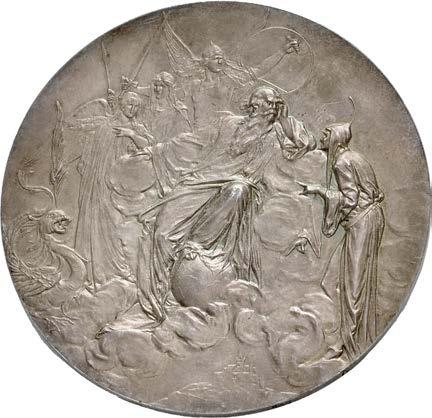
Ex J. Eric Engstrom Collection; J. Henri Ripetra Collection (COAT, 13 February 1975), lot 1556.
944. BRAZIL, Empire. Pedro II. 1831-1889. AR Proclamation Medal (60mm, 84.32 g, 12h). By Azvedo. Dated 18 July 1841. PETRUS II BRAS. IMP., bareheaded bust left, wearing coronation robes / ORDO ET FELICITAS., Indian, with foot on dragon, standing right, crowning Pedro enthroned slightly left; in exergue 18 – 41 with 18 above and 7 below. Meili 20. Iridescent toning, hairlines. EF. ($750)
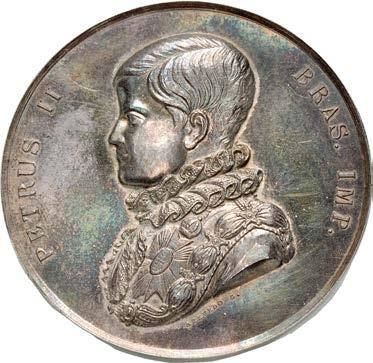
Ex Hess-Divo 332 (31 May 2017), lot 849; NASCA (27 May 1980), lot 149.
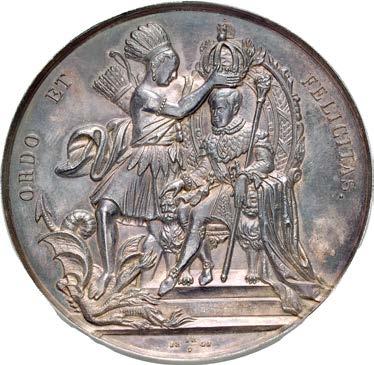
231
945. FRANCE, Royal. Charles IX, with Elizabeth of Austria. 1560-1574. AR Medal (37mm, 20.28 g, 12h). By Pillon(?). Dated 1572. CAROLVS · D · G · FRANCORVM REX · INVIC, laureate, armored, and draped bust of Charles left; · 1572 · below / (rosette) ELIZABETH · D · G · FRANCORVM · REGINA (rosette), bust of Elizabeth left. Cf. Jones I 122 (for cast bronze example, noting a struck gilt silver piece in the BN). Toned, minor mount marks on edge, hairlines. Good VF. ($500) From the Libertas Collection, purchased October 1984.
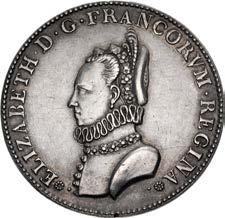
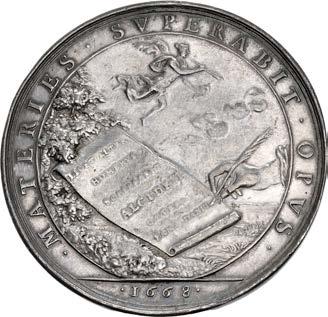
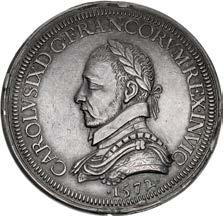
946. FRANCE, Royal. Louis II de Bourbon, Prince of Condé. 1621-1686. AR Medal (55mm, 57.85 g, 12h). Success in the War of Devolution. Unsigned, but by J. Warin. Dated 1668. · LVD · DVX · BORBONIVS · PRINCEPS · CONDÆVS ·, bareheaded, draped, and armored bust right / · MATERIES · SVPERABIT · OPVS ·, hand left, holding quill and inscribing LICET ALTER/HOMERVS/SCRIPSERIT/ALCIDEM/CÆTERA/FAMA DABIT on scroll set on field of flowers; above, Fama flying right, blowing trumpet and holding wreath. Jones 2. Iridescent toning, some marks. Good VF. ($400) Ex Numismatica Ars Classica 122 (14 November 2020), lot 619.
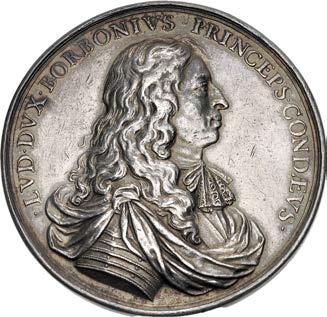
947 948
947. FRANCE, First Empire. temp. Napoléon I. 1804-1814. AV Medal (27mm, 13.91 g, 6h). Société de médecine de Bordeaux. By Brenet. Struck 1809. Head of Hippocrates right / (star)/ SOCIÉTÉ/ De MÉDECINE/ DE BORDEAUX over crossed olive branches. Bramsen 907. A few light marks. Warm red toning particularly evident at periphery. EF. ($2000)
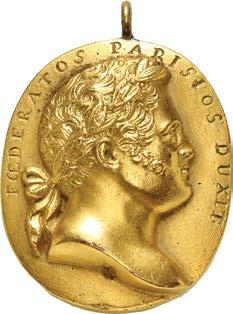
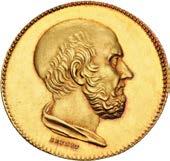
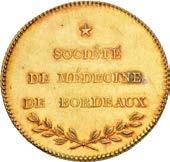
948. FRANCE, Royal (Restored). Charles Ferdinand d’Artois, Duke of Berry. 1778-1820. Gilt Æ Badge (37x44mm, 58.53 g, 12h). Appointment as Commander-in-Chief of the Army of Paris. Struck 1814. FŒDERATOS · PARISIOS · DUXIT, laureate head right / Blank, but for thin piece of sheet brass to support attachment of suspension loop. Lightly toned, light marks and pits on reverse. EF. ($400)
Ex Stack’s Bowers Galleries (8 January 2016), lot 40343.
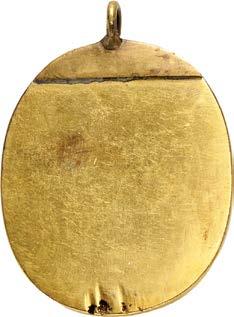
232
A Near Complete Set of the Kings of France
Selections from Lot 949 949. FRANCE, Royal (Restored). A near complete set of the Les Rois de France (The Kings of France) medallic series by Caqué. Lot of seventy-three (73) Æ Medals. Struck 1835-1840. Includes nearly every French monarch from Pharamon, the mythical first king of the Franks, to citizen-king Louis Philippe (Collignon 1508-1580). All medals measure about 51mm and bear on the obverse a portrait of the ruler with a biographical legend on the reverse. Only the medal for Napoléon I (Collignon 1577) is not present. All EF or better. An exquisite set with uniform attractive brown surfaces. The medals of the earliest monarchs in particular have a rich red mahogany color with the delicate purple toning usual to well preserved 19th century bronzes, while those of the later rulers appear in a slightly paler, muted brown-red. Seventy-three (73) medals in lot. See online for further illustrations.
($2000)
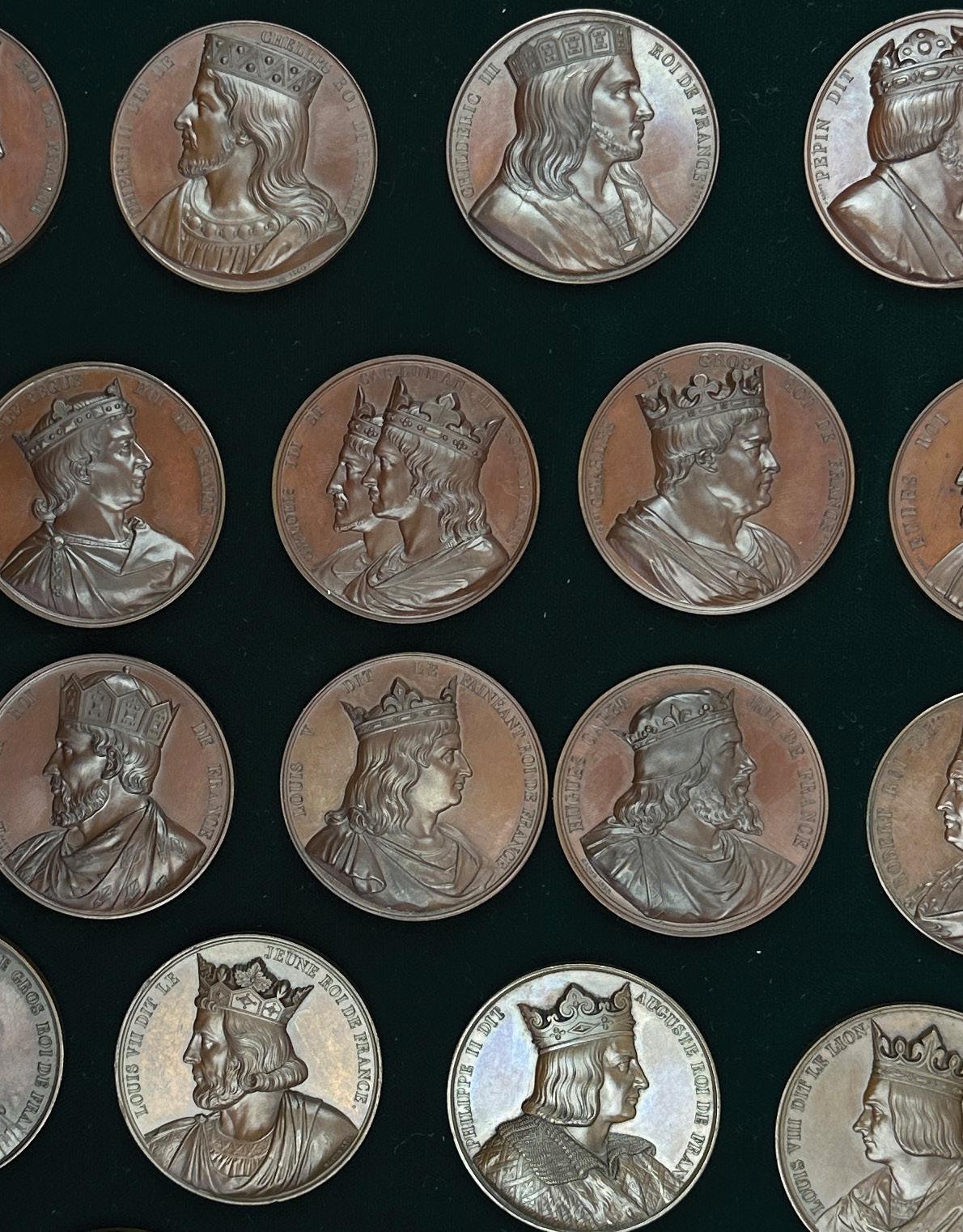
233
950. GERMANY, Frankfurt (City). AR Klippe Medal (22x22mm, 2.73 g, 12h). Dated 19 November 1618. Comet left toward horizon line; · ANNO 1618/· 19 : NO’; all within wreath with floral elements in outer voids / Reeds and smoldering candle set on pedestal, each set on waves, flanking pair of hands in prayer; sun above; · ESA · 42 · in exergue; all within circular border inscribed • KEINS WIRT (VE)RSERT · WER GOTT REC(HT) E(HR)T; cherubim in outer voids. D.L. Walter, “Medallic Memorials of the Great Comets, Part VI,” AJN (April 1890), 3. Lustrous. AU. ($500)
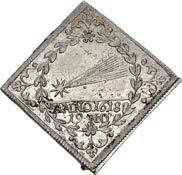
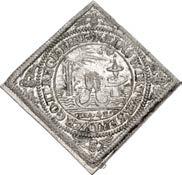
From the St. George Collection.
Throughout history, sudden astronomical appearances have often been interpreted as heralds of doom or harbingers of great change. Among these, the comet was the most notable, since it infrequently appeared, and when it did, its long tail (cometa) caused it to stand out in the heavens. During the Middle Ages and the Early Modern Period, a number of great comets are recorded. Among these, the “Great Comet of 1618”, also known as “the Angry Star” due to its extremely long tail, its reddish hue, and its strength and duration of its appearance, was particularly noteworthy. Appearing in the first autumn 1618, this comet was visible to the naked eye for over seven weeks until early 1619, even being discernible during the day. Its appearance across Europe during the early months of the Thirty Year’s War (1618-1648) prompted excited interpretations of its its meaning, many of which portended gloom. Even James I of England, a noted author of the occult, is known to have written a poem about it.
Commemorating the Protestant Reformation
951. GERMANY, Nürnberg (city). Set of Eight (8) AR Medallets in Wooden Presentation Box. The 1530 Augsburg Confession. By P.P. Werner. Dated 1730 (in chronogram). Seven medallets, each 22mm, with five representing five German Princes (John, Elector of Saxony; George, Margrave of Brandenburg-Ansbach; Ernest of Brunswick-Lüneburg; Philip I, Landgrave of Hesse; and Wolfgang, Prince of Anhalt-Köthen), and two representing Imperial Free Cities (Nuurnberg and Reutlingen); reverses are incriptions in Fraktur script, each expressing some aspect of faith. Group includes a cental medallet (26mm) depicting Christ with reverse and Latin inscription revealing the chronogram of 1730 (DILICVVVDLICLIVVLCIC). Weights of the 22mm medallets vary slightly, but average 3.75g. Weight of Christ medallet is 7.43g. Erlanger 1104; Schnell 222. Iridescent toning. As made. Comes complete with original cedar circular presentation case, marked 1730, top of case broken and expertly repaired. Rare. ($1000)
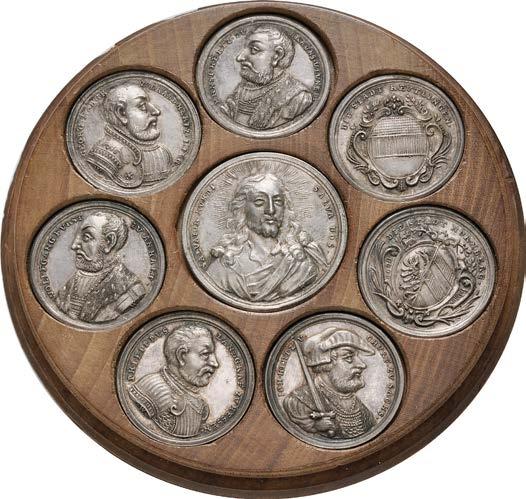
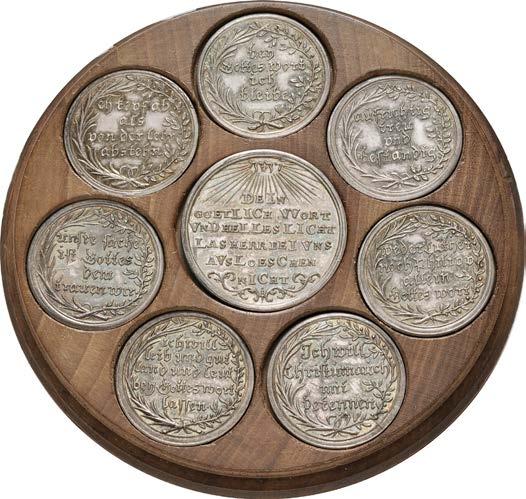
234
Offerings From Selvi’s Medici Series
Photos of Lots 952 to 955 reduced by 60%
952. ITALY, Firenze. Salvestro di Alamanno de’ Medici. Circa 1331-1388. Cast Æ Medal (87mm, 171.50 g, 12h). Selvi’s Medici Series. By Antonio Francesco Selvi (1679-1753). SILVESTER · MEDIC · ÆQV · R · PVB · FLOR (diamond), Bareheaded and armored bust right / AMPLISS./DONIS · ET. EQVESTRI./ORDINE/MAX · CONSENSV. CIVIT./DECORATVS/M · CCC · LV · in six lines. V&T 244. Brown surfaces, edge marks. As made. With original suspension loop intact. ($500)
953. ITALY, Firenze. Lorenzo di Pierfrancesco de’ Medici. 1463-1503. Cast Æ Medal (87mm, 159.60 g, 12h). Selvi’s Medici Series. By Antonio Francesco Selvi (1679-1753). LAVRENT · MEDIC · PETR · FRAN · FILIVS, bust right, wearing brimless cap and overgown with ornate collar / MVLCET · VT · SEVIAT., bear lying down to right on rocky ground with cub. V&T 279. Brown surfaces, edge marks. As made. With original suspension loop intact. ($400)

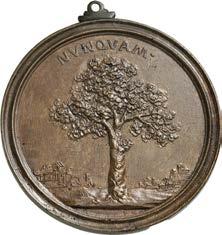
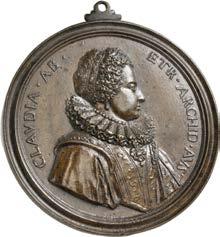
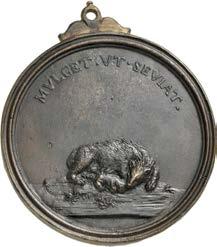
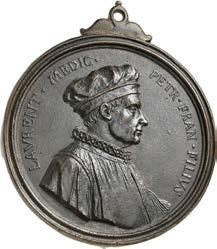
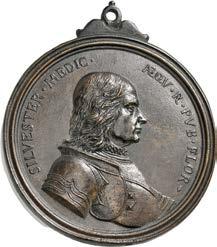
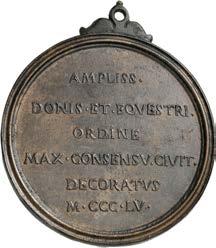
954. ITALY, Firenze. Caterina Sforza Riario. 1463-1509. Cast Æ Medal (87mm, 159.60 g, 12h). Selvi’s Medici Series. By Antonio Francesco Selvi (1679-1753). CATHARINA · SFORZA · MEDICES, veiled bust left / VICTORIAΩ · FAMA · SEQVETVR, badge of Milan: biscione (serpent) left, either eating or giving birth to human. V&T 287. Brown surfaces, fields lightly chased, edge marks. As made. With original suspension loop intact. ($400)
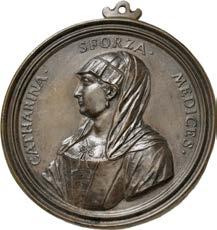
Ex Michael Hall Collection (Baldwin’s 64, 4 May 2010), lot 529.
955. ITALY, Firenze. Claudia de’ Medici. 1604-1648. Cast Æ Medal (87mm, 169.30 g, 12h). Selvi’s Medici Series. By Antonio Francesco Selvi (1679-1753). CLAVDIA · AB · ETR · ARCHID · AVST, bust right, wearing ornate coiffure and gown with collar / NVNQVAM ·, large oak tree; in back ground, rural scene with farm houses. V&T 329. Brown surfaces, fields lightly chased, edge marks. As made. With original suspension loop intact. ($400)
Ex Michael Hall Collection (Baldwin’s 64, 4 May 2010), lot 549.
235
953
954
955
956. ITALY, Papal (Papal state). Pius VI. 1775-1799. AV Medal (26mm, 21.54 g, 12h). Foundation of San Lorenzo Nuovo. By F. Hamerani. Dated 1777 and RY 3. PIVS · SEXTVS PONT · MAX · A · III ·, bust right, wearing zucchetto, mozzetta, and pallium / OPPIDANIS SERVATIS, view of the square of San Lorenzo Nuovo; in exergue, OPP · S · LAVR · IN · SAL ·/ LOCVM · TRANSI/ 1777. Mazio 514; Lincoln 1953 var. (metal). A few hairlines and faint scratches. Choice EF. ($7500)
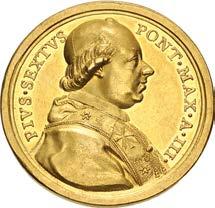
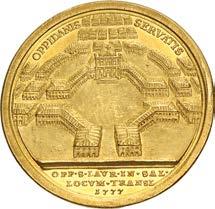
Ex Numismatica Ars Classica 121 (13 November 2020), lot 12; Numismatica Ars Classica 37 (17 February 2007), lot 1023.
The old location of the village of San Lorenzo, in the marshes and swamps along Lake Bolseno, made malaria a constant problem. In the 1770s, Papal authorities contructed a new village on a hill overlooking the lake.
957. ITALY, Kingdom of Italy (Napoleonic). 1805-1814. AR Prize Medal (62mm, 96.30 g, 12h). Award for the Napoleonic Accademia Reale di Belle Arti. By L. Manfredini. Undated, but struck 1807. R. ISTITUTO DI BELLE ARTI IN VENEZIA, Minerva seated left on stone seat decorated with lion’s legs, owl on amphora, and sphinx, holding statuette of Three Graces; L. MANFEDINI F. to lower right / PREMIO across field within laurel wreath. Bramsen 584/586 (obv./rev.). Iridescent toning, proof-like surfaces, light hairlines and fingerprints. EF. Attractive. ($500)
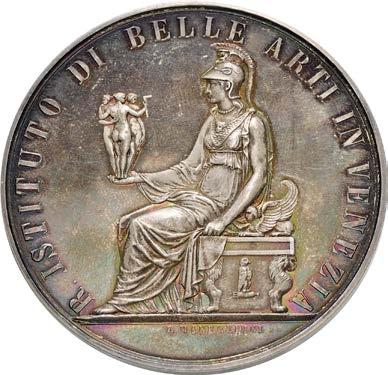
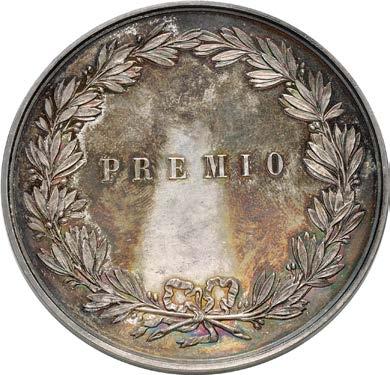
Ex MDC 7 (12 June 2021), lot 618.
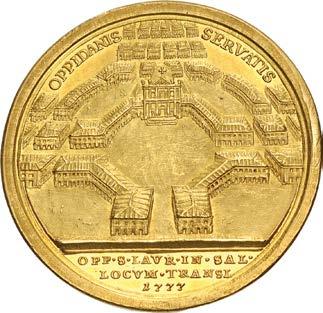
236
From
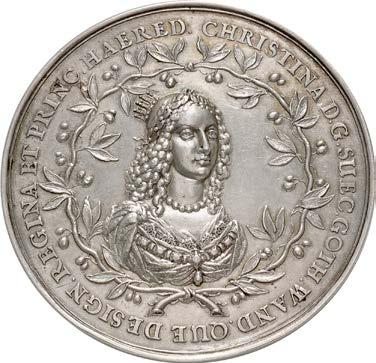

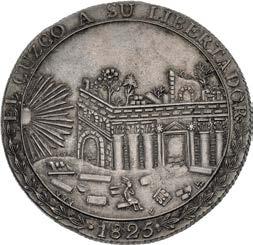
Purchased

237
958. PERU, Republic. Simón Bolívar. President of Peru, 1824-1827. AR Medal (41mm, 28.53 g, 12h). Cuzco Proclamation. Dated 1825. SIMON BOLIVAR LIBR COLOMB Y DEL PERU, uniformed bust right / EL CUZCO A SU LIBERTADOR 1825, native seated right amid ruins of Cuzco; sun to left. Fonrobert 9205. Beautiful even gray toning with splashes of iridescence. EF. ($750)
the Libertas Collection, purchased March 1989.
959. SWEDEN. Kristina. 1632–1654. Tin Medal (60mm, 55.51 g, 12h). By Daniel Kock. Dated 1647 (in Roman numerals. CHRISTINA D. G. SUEC. GOTH. WAND. QUE DESIGN. REGINA ET PRINC. HAERED., crowned bust facing slightly right, set on laurel wreath / SALVATOR MUNDI SALVA NOS. MDCLXVII ᛟ , Christ standing facing slightly left, raising hand in benediction and holding globus cruciger, within ornate frame consisting of angels and fruits; crowned coatsof-arms above; D K flanking lower frame. Cf. Maué 66 (for silver); Delzanno p. 598; Hildebrand, Sveriges 19. Light hairlines and marks. EF. ($750)
from Otto Helbing, 15 November 1928 (includes ticket).
Enigmatic Medal
Photos reduced by 50%
960. WESTERN EUROPE. Cast “Æ Medal” (174mm, 473.50 g, 12h). Dated 1497 or 1503 (in Roman numerals), but a later production. Laureate male bust right; · VMILITAS ·/τΑωύροςις (sic) in two lines below; Hebrew inscription in two lines around; Hebrew acrostic noting Benjamin, son of the papal physician Elijah ben Shabbetai Be’er, across fields / POST TENEBRA SPERO LVCEM FELICITATIS IVDEX DIES VLTIMVS • D • III • M, incuse of obverse bust. Armand II 142, 16; Hill 878; Stern 211; Friedenberg, p. 73; Peus 412, lot 759. Brown surfaces, worn at high points, fields smoothed, edge marks, possible mount or sprue removed at 12 o’clock. As made. An enigmatic and historically important piece. ($3000)
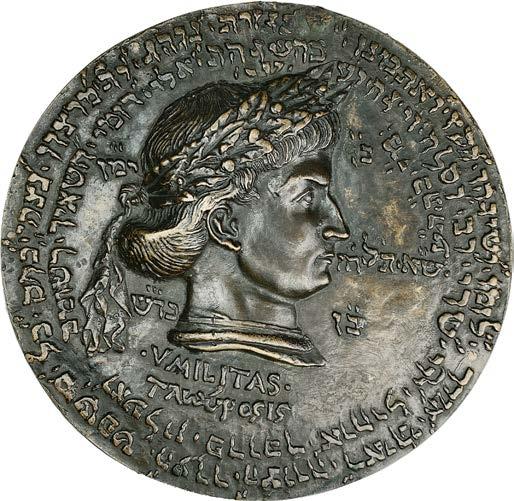
Since the discovery of the original example in Lyon in 1656, from which all subsequent copies – including this example – were cast, a number of conflicting opinions have arisen over its purpose and meaning. While this medal has clear Judaic connections, the association of it with Pope Julius II and his end of the persecution of Jews by the papacy is based on circumstantial evidence and subjective reasoning, and should be questioned. Dr. Rebekka Voß, Frankfurt Professor of the History of German and European Jewry at Goethe University, who translated the blundered and defective Hebrew legend for the Peus specimen, has argued that the medal is connected with Jewish Messianic expectation at the turn of the 16th century. It appears to have an association with Ascherben Meir Lemlein, a northern Italian rabbi, kaballist, and alleged harbinger of the Jewish Messiah. The name of Elijah ben Shabbetai Be’er, which appears in acrostic, was a well-known physician who served popes, Italian nobility, as well as Henry IV of England. A teacher of medicine at the University of Pavia, he was awarded for his services a knighthood and Roman citizenship in 1405. His son, Benjamin, may be the portrait here, referencing his possible connection to the messianic association. For more information on Jewish Messianism, see Rebekka Voß, Umstrittene Erlöser Politik. Ideologie und jüdisch-christlicher Messianismus in Deutschland, 1500-1600 (Göttingen, 2011).
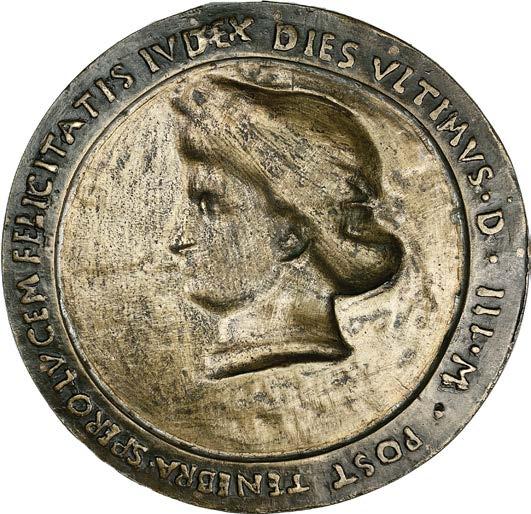
238
Examples of the
UNITED STATES COINAGE
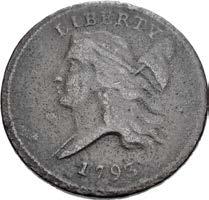
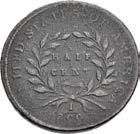
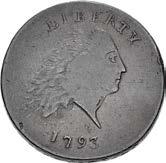
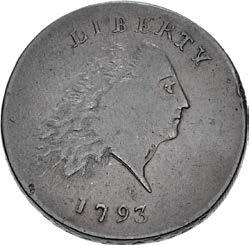
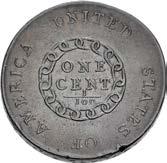
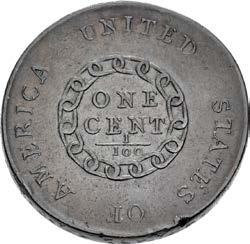
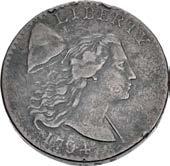
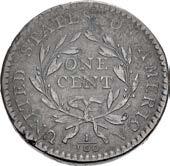
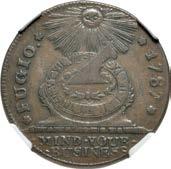
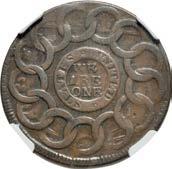
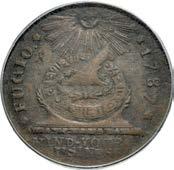

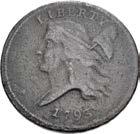
From the CJR Collection.
From the CJR Collection.
rather scarce.
is fully detailed and quite attractive in hand.
Flowing Hair Chain Cent
239
961. Federal contract coinage. 1787 Fugio Cent. Newman 7-T (die states B/A); W-6735. PCGS XF 40. 13005307. New Haven mint. STATES UNITED, Four Cinquefoils. Light die crack from rim through sunrays to the right of the sunface. Perfect reverse. ($500)
962. Federal contract coinage. 1787 Fugio Cent. Newman 12-U (die states A/B); W-6810. NGC XF 45. 3428820004. New Haven mint. STATES UNITED, Four Cinquefoils. Perfect obverse die, heavily clashed reverse die. ($500)
Fugio Cent with the complete and fully struck up legend “Mind Your Business” are
This coin would make a wonderful type set example. The clashed reverse die only adds to the desirability of this piece.
963. 1793 Liberty Cap Half Cent. C-4. Rarity 3. NGC VF Details, Environmental Damage. 6529313-003. A one-year type coin, this is also the key date in the half cent series. This coin
($3000)
964. 1793 Flowing Hair, Chain Cent. AMERICA. S-3. Rarity Low 3. NGC VF 30 BN. 6529314-001. Light edge bumps but overall a problem-free coin. ($20,000) From the CJR Collection.
965. 1794 Liberty Cap Large Cent. Head of 1794. S-42. Rarity 4. NGC XF Details. 6529313-002. EF. NGC notes “Environmental Damage”. Mottled brown surfaces, light surface roughness, an edge flan flaw, and some scratches and marks are noted for accuracy. Attractive in hand. ($1500)
961
962
966. 1795 Flowing Hair Half Dime. LM-10. Rarity 3. VF. Toned. Star 1 joined to tip of curl 2, star 15 joined to bust. On the reverse, no inner berries, one outer berry under left wing. The more affordable date of the two-year type. ($1500)
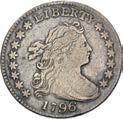
From the CJR Collection.
967. 1797 Draped Bust Half Dime. 15 Stars. LM-1. Rarity 3. Choice VF details. Cleaned a long time ago, now with attractive toning, edge smoothed at 12 o’clock, likely ex jewelry. Otherwise, a high-grade, lightly-circulated example of this two-year type. ($1000)
From the CJR Collection.
968. 1800 Draped Bust Half Dime. LM-1. Rarity 3. Fine. Toned. An attractive example of the Heraldic Eagle type. ($1000)
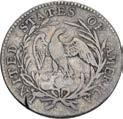
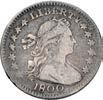



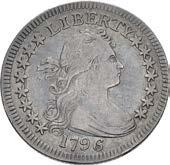
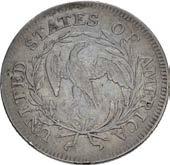
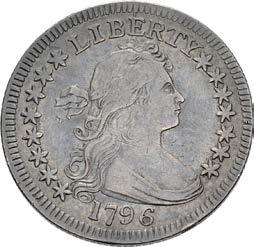
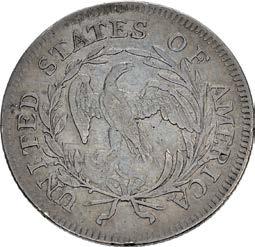


From the CJR Collection.
969. 1796 Draped Bust Dime. JR-3. Rarity 5. Choice VF. Once cleaned, now attractively toned. On several examples “the reverse shows a planchet cut at 7 to 8 o’clock due to a small chip adhering to the die. The metal chip moves along the edge, ranging between U and T1.” This coin exhibits this diagnostic, verifying its authenticity. JR-3 is the third rarest die marriage for 1796. An important and elusive coin of this first year of the denomination and of the two-year type. ($2000)
From the CJR Collection.
Key Date Early Type Coin
970. 1796 Draped
From the CJR Collection.
Quarter. B-1.
Cleaned long ago and now retoned with attractive blue iridescence, scattered light scratches. A very rare “Small Eagle” one-year type coin with a tiny mintage of 6,146 examples, that is always in demand in any grade. ($10,000)
240
Bust
Rarity 4. NGC XF Details, reverse scratched. 6529314-002.
966 967 968 969
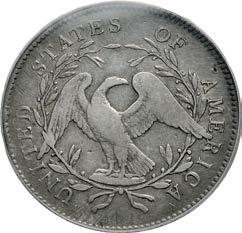
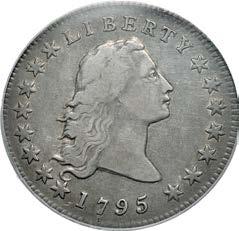
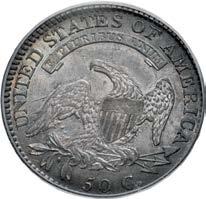
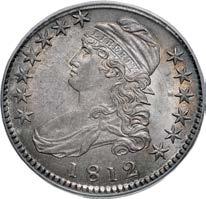
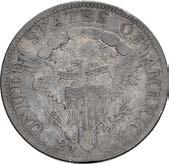
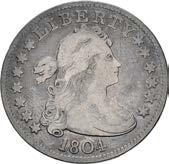
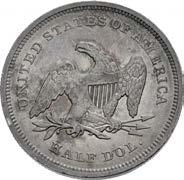
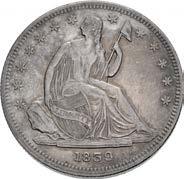

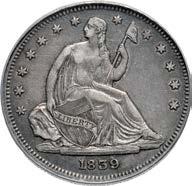
241
971. 1804 Draped Bust Quarter. B-1. Rarity 3. NGC Fine Details, cleaned. 6529313-006. “Heraldic Eagle” type. Once cleaned but now retoned with light blue iridescence, scattered light scratches. A very rare date with a mintage of a mere 6,738 pieces. ($5000)
From the CJR Collection.
972. 1812 Capped Bust Half Dollar. Large 8. O-109. Rarity 3. PCGS AU55 CAC sticker. 14849621. Appealing iridescent tone. This Overton variety identified by a round lump at star 10. ($500)
973. 1839 Liberty Seated Half Dollar. No Drapery. NGC AU Details, cleaned. 6529313-005. Toned, some iridescence, a one-year type coin. ($1000)
From the CJR Collection.
974. 1839 Liberty Seated Half Dollar. No Drapery. PCGS VF30. 21268500. Toned. ($500)
975. 1795 Flowing Hair Dollar. Two Leaves. BB-21, B-1. Rarity 2. PCGS VF20. 19881865. Handsome gray toning, faint adjustment marks on the reverse. An excellent choice for a type set. ($3000)
973
974
From
From
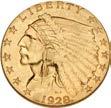
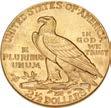
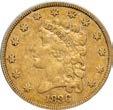
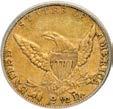
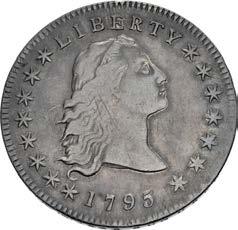

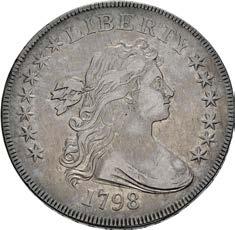

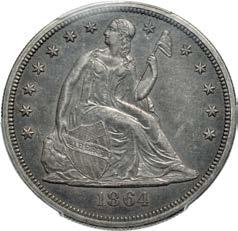
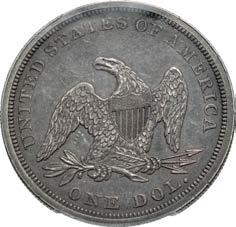
242
976. 1795 Flowing Hair Dollar. Three Leaves. BB-27, B-5. Rarity 1. VF Details. Toned, adjustment marks on obverse, engraved devices, thus not suitable for encapsulation. SOLD AS IS. NO RETURNS. ($2000)
the Libertas Collection.
977. 1798 Draped Bust Dollar. Small Eagle, 13 Stars. BB-82, B-1. Rarity 3. NGC XF Details, cleaned. 6529313-004. Light tone. A pleasing example of the type. ($5000)
the CJR Collection.
978. 1864 Liberty Seated Dollar. Repunched Date. OC-1. Rarity 2. PCGS XF45. 24296716. Even toning. A pretty coin. Light repunching on the 18. ($750)
979. 1836 Classic Head Quarter Eagle. Large Head, Block 8. HM-1. Rarity 3. PCGS XF40. 15730244. This obverse is also known as Head of 1834 or Booby Head. Haynor estimates that there are about 285 examples of this die marriage. Excellent choice for inclusion in a type set. ($500)
980. 1928 Indian Head Quarter Eagle. Choice UNC. Frosty mint luster. A lovely example of the type. ($500)
979 980
981. 1795 Capped Bust Right Half Eagle. Small Eagle. NGC XF Details, removed from jewelry. 6529314-003. The first year of this short-lived and desirable type. Always in demand by the type set collector. ($15,000)
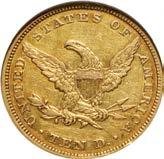
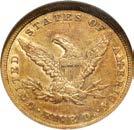
From the CJR Collection.
982. 1802/1 Capped Bust Right Half Eagle. Centered Overdate. NGC AU 55. 6529313-001. A simply stunning coin in hand. ($7500)
From the CJR Collection.
983. 1836 Classic Head Half Eagle. HM-7. Rarity 3. NGC XF 40. 3219514-003. With a Tall 1, a Block 8, with no berry on the olive sprig. Haynor says that this die marriage “represents 26% of the surviving coins”, making this a good choice for a type set. ($500)
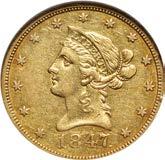
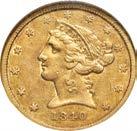
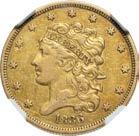
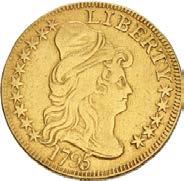
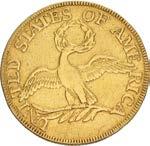
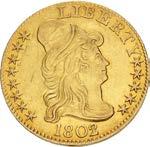
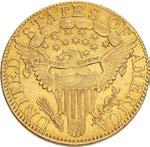
984. 1840 Liberty Head Half Eagle. Large Diameter. NGC AU 55. 1806958-001. Attractive reddish-gold tone. ($750)
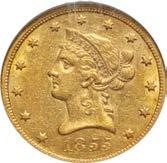
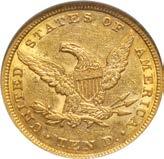
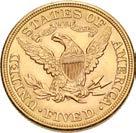
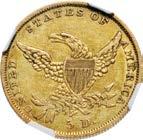
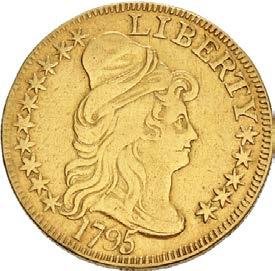

986.
Head Eagle. NGC AU 53. 3209642-005. Since this date has one of the higher mintages in the No Motto Liberty Head Eagle series, this is an excellent choice for a type collection. ($750)
987. 1855
Head Eagle. NGC AU 55. 1715849-009. A pleasing higher grade No Motto Eagle. ($1000)
243
985. 1908 Liberty Head Half Eagle. Choice UNC. Rich luster over appealing surfaces. ($500)
1847 Liberty
Liberty
983
984 986 987
990.
UNITED STATES MEDAL
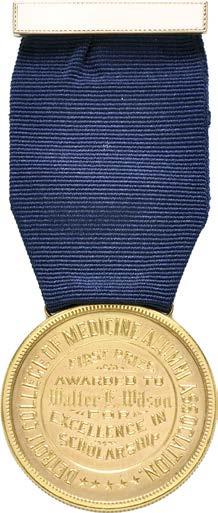
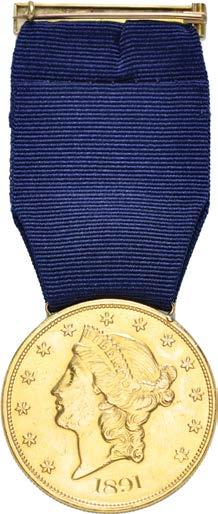
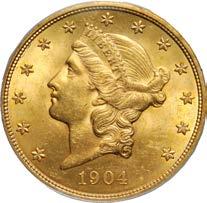
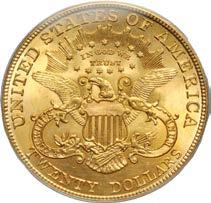
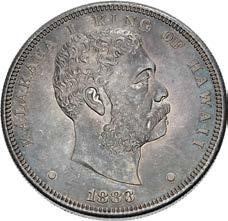
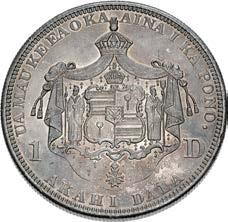
a
Award.
Presented to Walter
by effacing the date it was struck by the US
and skillfully engraving the award year of 1891. Reverse engraved: DETROIT COLLEGE OF MEDICINE ALUMNI ASSOCIATION. ***** around; at center: FIRST PRIZE / AWARDED TO / Walter E. Wilson / FOR / EXCELLENCE IN / SCHOLARSHIP. Suspension loop attached at top, suspended from a gold pinback suspension bar, with a dark blue ribbon attaching the whole. Overall 34 x 84mm. Polished. Otherwise, about as made. ($1500)
According to the “Directory of Deceased American Physicians, 1804-1929”, Dr. Walter E. Wilson was born to Elizabeth Patterson and Charles Wilson (both of Ireland) on 12 May 1859 in Birmingham, Michigan. He graduated from Wayne State University School of Medicine, Detroit: Detroit College of Medicine & Surgery in 1891. He died on 6 February 1916 in Grand Ledge, Eaton County, Michigan at the age of 56 years, 8 months, and 24 days.
244
988. 1904 Liberty Head Double Eagle. PCGS MS63. 12839799. Wonderful frosty mint luster. ($2000)
989. 1883 Hawaii Dollar Medcalf-Russell 2CS-5. NGC UNC Details, artificial toning. 6529353-006. We believe this is natural, attractive iridescent toning. ($1500) Ex Gadoury (22 October 2021), lot 2013 (hammer €2600).
Detroit College of Medicine – Alumni Association Scholarship
AV Medal.
E. Wilson, 1891. Liberty Head Double Eagle crafted into
scholarship award
Mint
BRITISH COINAGE
991. CELTIC, Atrebates & Regni. Uninscribed. Circa 60-20 BC. AV Stater (17mm, 5.79 g). Selsey Uniface type (Atrebatic B). Blank / Disjointed horse right; ‘arm’ above, wheel below. Bean Q1-6; Van Arsdell 216-1; ABC 488; SCBC 39. Lightly toned, a few minor scratches, flan flaw on obverse. VF. ($600)
Ex Stack’s Bowers & Ponterio 173 (8 January 2013), lot 13.
992. CELTIC, Trinovantes & Catuvellauni. Cunobelin. Circa AD 10-43. AV Stater (15mm, 5.36 g, 8h). Cunobelinus Classic, stalk type (Trinovantian X). Camulodunum mint. Grain ear with central stalk; [C]A Â[u] / Horse prancing right; branch above, CuNO below. Allen, Cunobelin – (dies J/k; unlisted combination); ABC 2798; Van Arsdell 2027-1; SCBC 288. Soft strike on obverse. Minor marks. Good VF. ($1000)
Ex Gemini V (6 January 2009), lot 410.
993.
Dobunni. Corio. Circa 30-15 BC. AV Stater (20mm, 5.48 g, 1h). Corio Tree type (Dobunnic B). Stylized tree with pellet at base / Disjointed horse right; COriO and crescent above, wheel below, pellets in fields. ABC 2048; Van Arsdell 1035-1; SCBC 386. A few minor marks and scratches, areas of weak strike. VF. Rare. ($1500)
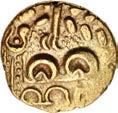
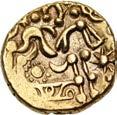
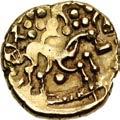
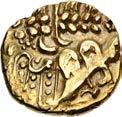
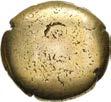
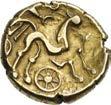


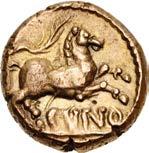
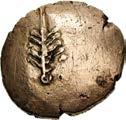
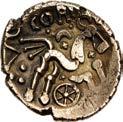
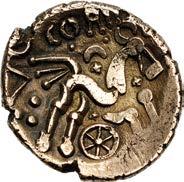
Ex St. James’s 21 (19 April 2012), lot 114.
994. CELTIC, North-Eastern series (‘Corieltauvi’). Uninscribed. Circa 60-20 BC. AV Stater (19mm, 6.21 g, 10h). North East Coast, right type (Corieltauvian A). Head of Apollo right, devolved to wreath and crescents / Disjointed horse right; below, pellet over zig-zag line; pellets around. ABC 1716; Van Arsdell 800-1; SCBC 28. Light marks and minor deposits. VF. An extremely early pedigree for a Celtic coin. ($600)
Ex Archbishop Sharp (†1714) (Morton & Eden 91, 7 December 2017), lot 1.
995. CELTIC, North-Eastern series (‘Corieltauvi’). Uninscribed. Circa 60-20 BC. AV Stater (19mm, 5.94 g, 2h). North East Coast, right type (Corieltauvian A). Devolved head of Apollo right / Disjointed horse right; below, pelleted sun over line with wavy pattern; pellets around, sun to right. ABC 1719; Van Arsdell 800-9; SCBC 28. A few very light marks. Good VF. Very well centered for this series. ($600)
Ex Anton Beasley Collection; Chris Rudd FPL 84 (November 2005), no. 35.
245
CELTIC,
994
995
996. CELTIC, North-Eastern series (‘Corieltauvi’). Uninscribed. Circa 50-20 BC. AV Stater (19mm, 5.77 g, 12h). South Ferriby Legs type (Corieltauvian D). Devolved head of Apollo right / Disjointed horse left; eight-pointed star below, ‘anchor’ face above. ABC 1743; Van Arsdell 811-1; SCBC 390. Edge split. Near EF. ($600)
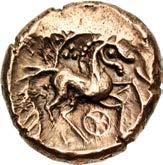
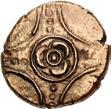
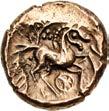


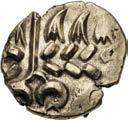
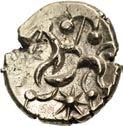
From the W. Hansen Collection, purchased from Calgary Coin Gallery, March 2015.
997. CELTIC, Iceni. Uninscribed. Circa 50 BC - AD 10. AV Stater (18mm, 5.50 g). Snettisham, rings type (Trinovantian F). Traces of crossed wreaths type / Horse prancing right; pellets-in-annulets above and below. CCI 00.0987 (this coin); MfT Snettisham, die group 2, dies G/11; ABC 1411; Van Arsdell 1505-1; Hobbs 3365-83; SCBC 425. Good VF. ($1500)
Ex Pythagoras Collection; Jon Kardatzke (Part III, Goldberg, 7 June 2000), lot 3022.
998. CELTIC, Iceni. Uninscribed. Circa 20 BC - AD 10. AV Stater (17mm, 5.60 g). Freckenham Flower, crescent type (Icenian B). Three-petalled flower in central ring set on pelleted spokes / Horse prancing right; triple pellets and crown-like motif above, six-spoked wheel below. MfT Irstead, die group 3, dies G/7; ABC 1423; Van Arsdell 626-1; Hobbs 3396-3404; SCBC 428. Toned. Good VF. ($1500)
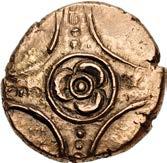
Ex Pythagoras Collection, purchased from Wolfshead Gallery.
Unique York Type Thrymsa
999. ANGLO-SAXON, Substantive Gold Phase. Circa 620-645. AV Thrymsa – Shilling (12mm, 1.28 g, 9h). ‘York’ type. Half-length bearded figure standing facing, with stylized face; crosses flanking / Blundered inscription around central cross pommée in circle. EMC 1994.503 = Blackburn, “A Variant of the Seventh-Century ‘York’ Group of Shillings Found in Lincolnshire,” in NC 154 (1994), pl. 21, 6 = T. Abramson, England’s, Variety Bi.6, dies Bi1/Bi1 = Naylor & Allen 4 = A&W type V.xxi, 323 = Metcalf 51 (all this coin); Sutherland –; MEC 8 table 3, type 24; cf. North 27; SCBC 762. Light mark on reverse. Good VF. A unique and important thrymsa in the York group series. Not seen since this piece was recorded by Blackburn for the EMC in 1994. ($15,000)
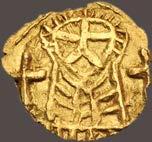
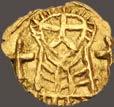

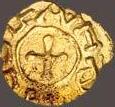

Found in Burton-by-Lincoln, Lincolnshire, 1991.
With a stylized depiction of an evangelist proclaiming the power of the cross on the obverse this significant coin belongs to a fascinating series of gold Thrymsas, believed to have been struck at York, which have been associated with the mission of Bishop Paulinus to convert heathen Northumbria and Lindsey during the reign of King Edwin. It was discovered by John Derry in 1991 in a field four miles north of Lincoln where, according to the Venerable Bede, Paulinus founded a church in c. 628. Published in the Numismatic Chronicle in 1994 this coin is the only example known of its type and is considered to be the earliest Thrymsa in the ‘York’ group to have a reverse inscription, the reading of which has been much debated by scholars. Abramson argues that it conveys a divine blessing on York. Thoroughly Christian and non regal in conception this Thrymsa demonstrates that the stimulus for a native Anglo-Saxon coinage in the north of England was inexorably linked to the spread of the Gospel.
246
996 997
1000. ANGLO-SAXON, Primary Sceattas. Circa 710. AR Sceatt (12mm, 1.01 g, 3h). Aethiliraed Series (E), type 105. Mint in east Kent. ‘Porcupine’ right; wavy line below / ᚪᚦᛁᛚᛁ/ᚱᚪᛞ (AThILI/RAD in Runic) in two lines around central line; all within double pelleted border. Abramson 92.10; MEC 8 Series AEÐ; North 155; SCBC 780. Minor edge flaw. Good VF. ($750)
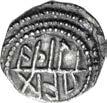
1001. ANGLO-SAXON, Secondary Sceattas. Circa 720-735. AR Sceatt (12mm, 0.99 g, 12h). Series K, type 32a. Mint in Essex or Kent. Diademed and draped bust right, holding cross, knot behind head / Wolf-headed serpent clockwise. Metcalf & Walker Group A-B, 10; Abramson 39-10; MEC 8 Series Kb; North 89; SCBC 803D. Rich find patina, small edge chip. Good VF. Exquisite style. ($750)
1002. ANGLO-SAXON, Secondary Sceattas. Circa 720-735/50. AR Sceatt (13mm, 1.31 g, 5h). Series H, type 49. Hamwic mint. ‘Wodan’ head within pelleted border; ten roundels around / Bird standing right; rosette below head. Abramson 48-1010; MEC 8 Series Hc; North 103; SCBC 801A. Toned, very slight porosity. Good VF. Well struck. ($750)
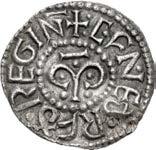




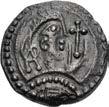

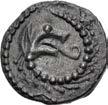



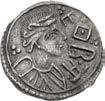

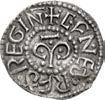


Cynethryth Queen of Mercia
1003. ANGLO-SAXON, Kings of Mercia. Cynethryth. Wife of Offa, 757-796. AR Penny (16mm, 1.19 g, 3h). Light coinage, portrait type. Canterbury mint; Eoba, moneyer. Struck 784/5. Draped bust right; to left, Latin cross with pellets in angles; Ḩ Ḩ ģ/ℽḨዛ/¥/ around / ม Ḧ ü/Ŋ⌭⌓ D /⎀Ŋ D / ⎀⌓ŻƗn / around M in pelleted circle. Chick 143g (same obv. die); SCBI 16 (Norweb), 93 (same obv. die); North 339; SCBC 909. Lightly creased with some porosity. VF. Very rare. The portrait of fine
Ex Baldwin’s FPL (Winter 2012-2013), no. AS007; Spink 211 (13 December 2011), lot 12, purchased from Spink, 2007. The only Queen to appear on an English coin prior to the portrait issues of Mary Tudor.
ʼዞҟ
ม in the angles of
247
style. ($15,000)
1004. ANGLO-SAXON, Kings of Mercia. Coenwulf. 796-821. AR Penny (19mm, 1.23 g, 7h). Tribrach type. Canterbury mint; Æthelmod, moneyer. Struck 797/8-circa 805. ม üℽዞዧ⎍⎍⌦ዟ
, M /
three-lined tribrach moline, inner line pelleted. Naismith C.11.2; North 342; SCBC 914. Lightly toned, some porosity. VF. ($1000)
From the St. George Collection. Ex Classical Classical Group Electronic Auction 432 (14 November 2018), lot 522.
1005. ANGLO-SAXON, Kings of East Anglia. Edmund. 855-869. AR Penny (20mm, 1.30 g, 1h). Late phase. Mint in East Anglia (Ipswich?); Eadmund, moneyer. Struck circa 862-869.
, large barred A /
cross pattée, pellets in angles. Naismith E65j = Pagan, Coinage p. 76, VIII (this coin); SCBI 4 (Copenhagen), 103; North 456; SCBC 954 . Richly toned. Near EF. Unusually fine metal for this issue. ($1500)
From the St. George Collection. Ex Classical Numismatic Review XLIV.2 (Summer 2019), no. 514969; Spink Numismatic Circular LXXXIX.4 (April 1981), no. 3104.
1006. ANGLO-SAXON, Anglo-Viking (Danish Northumbria). Cnut. Circa 900-905. AR Penny (20mm, 1.32 g, 2h). Class IIe/Cunneti type. York mint. Inverted patriarchal cross with pellets in upper angles / Short cross pattée with pellets in first and fourth quarters. L&S class IIe; SCBI 29 (Merseyside), 321 (same obv. die); North 501; SCBC 993. Rich old iridescent toning. Near EF. ($1000)
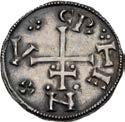
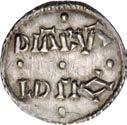

1007. ANGLO-SAXON, Anglo-Viking (Danish Northumbria). Cnut. Circa 900-905. AR Penny (20mm, 1.44 g, 11h). Class IIe/Cunneti type. York mint. Inverted patriarchal cross with pellets in upper angles / Short cross pattée with pellets in first and fourth quarters. L&S class IIe; SCBI 29 (Merseyside), 285 (same dies); North 501; SCBC 993. Rich old iridescent toning, slight double strike. EF. ($750)
From the St. George Collection, purchased from Kirk Davis.
1008. ANGLO-SAXON, Kings of Wessex. Alfred the Great. 871-899. AR Penny (21mm, 1.57 g, 6h). Two-line type (BMC xvii). Dorobernia (Canterbury) mint; Deorweald, moneyer. Struck circa 880-899. ม ዞዥዟያዞዝ ያዞҠ ዝℽያℽ , small cross pattée / ዝዢaʼ⎍a / ⌦ዝ ዦℽ in two lines; pellets above and below, three pellets between. SCBI 20 (Mack), 733; North 638; SCBC 1069. Toned, some ghosting in obverse field. Near EF. Rare. ($2000)
From the St. George Collection. Ex C.S. Shute (Noble 109, 28 July 2015), lot 1832, purchased from L. Bennet, September 1988.
1009. ANGLO-SAXON, Kings of Wessex. Æthelstan. 924-939. AR Penny (23mm, 1.62 g, 5h). Circumscription Rosette type (BMC vi). Chester mint; Mægenferth, moneyer. Rosette / ม ዦዞűʼዞዝ ዦɭ üዞዢ/©üዢü , rosette. Blunt, Aethelstan 354; SCBI 34 (BM), 1088; North 680; SCBC 1098. Traces of luster, some very light marks. Near EF. Overstruck on a two-line type. Rare. ($2000)
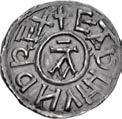
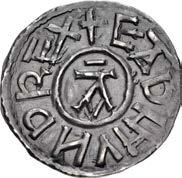
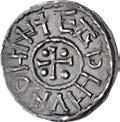

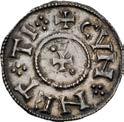

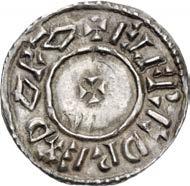

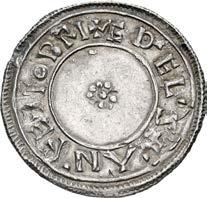
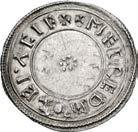
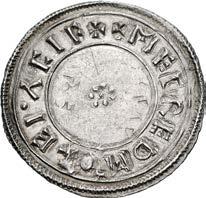
From the St. George Collection, purchased from AMR Coins.
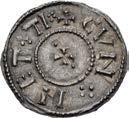
248
ม ⌓¥ዝȲ⎍ኋዝ ያ⌓ҟ
ม ⌓¥ዝȲ⎍ዧዝ Ȳ ᚻ,
1006
1007
1010. ANGLO-SAXON, Kings of All England. Eadgar. 959-975. AR Penny (20mm, 1.13 g, 6h). Small cross/HorizontalTrefoil 1 (HT 1) type (BMC i). North-Eastern V dies; Farthein, moneyer. Struck circa 959-968/9. Small cross pattée / ü©ʼ T/ ዞዢዢ
in two lines; three crosses pattée between, trefoils above and below. Walker, “A Hoard of Anglo-Saxon Coins form Tetney, Lincolnshire,” NC 1945, 229 (this coin); CTCE 38; SCBI 42 (South-Eastern), 789 (same dies); North 741; SCBC 1129. Old cabinet toning, slightly weak strike. Near EF. ($600)
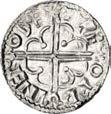
From the St. George Collection, purchased from Baldwin’s. Ex 1945 Tetney Hoard.
1011. ANGLO-SAXON, Kings of All England. Cnut. 1016-1035. AR Penny (18mm, 0.91 g, 6h). Quatrefoil type (BMC viii, Hild. E). Maldon mint; Ælfwine, moneyer. Struck circa 1016-1023. Crowned and draped bust left within quatrefoil /
, voided long cross with triple-crescent ends and pellet at center; all over quatrefoil. North 781; SCBC 1157. Light earthen deposits, worn reverse die. EF. ($400)
From the St. George Collection, purchased from M. Vosper.
1012. ANGLO-SAXON, Kings of All England. Cnut. 1016-1035. AR Penny (18mm, 0.86 g, 9h). Quatrefoil type (BMC viii, Hild. E). Thetford mint; Leofwine, moneyer. Struck circa 1016-1023. Crowned and draped bust left within quatrefoil /
ዢnዞዢ ɭ ዝዞ , voided long cross with triple-crescent ends and pellet at center; all over quatrefoil. North 781; SCBC 1157. Some die wear. EF. ($400)
From the CJR Collection.
1013. ANGLO-SAXON, Kings of All England. Edward the Confessor. 1042-1066. AR Penny (18mm, 1.14 g, 3h). Trefoil Quadrilateral type (BMC iii, Hild. C). York mint; Ioli, moneyer. Struck circa 1046-1048.
diademed and draped bust left; scepter pommée to left; trefoil of pellets to left / ม ዢɭ⌦² ɭn ዞɭዟዞʽዩዢüü / , quadrilateral, with pellet in center and trefoils at angles, over voided short cross. Freeman 193; SCBI 2 (Hunterian), 1018 (same dies); Hild –; BMC –; North 817 var. (trefoil on obv.); SCBC 1174 var. (same). Richly toned. Good VF. Very rare variety. ($750)
Ex Dr. J. Hulett (Part II, Dix, Noonan, & Webb 143, 12 December 2017), lot 688.
1014.
All England. Edward the Confessor. 1042-1066. AR Penny (20mm, 1.52 g, 6h).
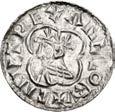
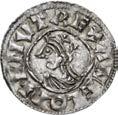
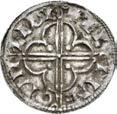


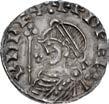
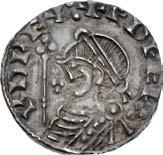
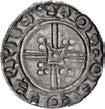
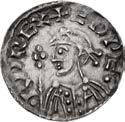
Cross type, heavy issue (BMC v, Hild. E). London mint; Ælfgar, moneyer. Struck circa 1050-1053. Diademed bust left; scepter to left / ม ® ⌦ዟű¥ʽ ɭn ⌦⎍nዝ , voided short cross with expanding limbs; at center, circle around pellet-in-circle.
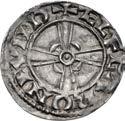
249
ò ɭ
® ⌦ ዩዢɉ ɭn ዦ ® ⌦ዝӎ
ม
ม ⌦ዞ
ɭዟዩ
ม ዞዝዩዞ Ḧ ʽዝ ʽዞม Ḧ ,
ANGLO-SAXON, Kings of
Expanding
Freeman 55; North 823; SCBC 1177. Richly toned. VF. ($500)
From the St. George Collection, purchased from M. Rasmussen.
1011
1012
1015. ANGLO-SAXON, Kings of All England. Edward the Confessor. 1042-1066. AR Penny (19mm, 1.36 g, 9h). Hammer Cross type (BMC xia, Hild. G var.). Hastings mint; Dunning, moneyer. Struck circa 1059-1062. Crowned bust right, scepter before / ม ዝ⎍nዢnü ɭn ዡ ® ˞˸ , voided cross, arms terminating in inward-facing crescents; annulet in fist quarter. North 828; SCBC 1182. A few minor marks under iridescent toning. Good VF. ($500)
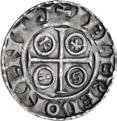
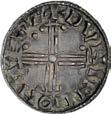
From the Libertas Collection, purchased December 1980.
1016. ANGLO-SAXON, Kings of All England. Harold II. 1066. AR Penny (19mm, 1.28 g, 6h). Pax type (BMC i, Hild. A). Lewes mint; Oswold, moneyer. Crowned head left; scepter before /
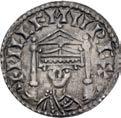
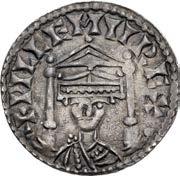
across central field. King 278, pl. XXX, 35 (same dies); SCBI 20 (Mack), 1338 (same dies); North 836; SCBC 1186. Richly toned, minor area of waekness on neck. Good VF. ($4000)
From the St. George Collection. Ex Classical Numismatic Group inventory 505827 (February 2019).
1017. NORMAN. William I ‘the Conqueror’. 1066-1087. AR Penny (19.5mm, 1.31 g, 8h). Canopy type (BMC iii). Wallingford mint; Brandr, moneyer. Struck circa 1070-1072. Crowned facing bust within canopy of two columns / ม ዛʼ²nዝ ɭn ዩ²⌦⌦ዢnűዢ , double quadrilateral, with incurved sides, annulet at center, and fleur at each limb. SCBI 20 (Mack) 1386 (same dies); BMC 215; North 843; SCBC 1252. Toned, spot of red wax. Good VF. Struck on a broad flan. ($1500)
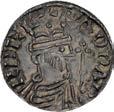
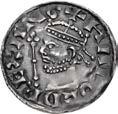
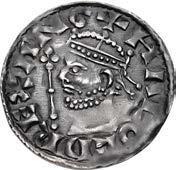
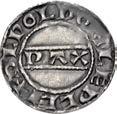
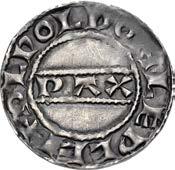
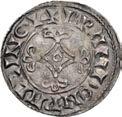
Ex Spink Numismatic Circular XCIX.10 (December 1991), no. 7980 (there as ‘about EF’).
1018.
William I ‘the Conqueror’. 1066-1087. AR Penny (19.5mm, 1.37 g, 3h). Paxs type (BMC viii). Canterbury mint; Ælfræd, moneyer. Struck circa 1083-1086. Crowned facing bust, holding scepter / ม ዢዞ⌦ዟያዢ ɭn ün˸⌦ዢ , cross pattée; letters of P A X S in annulets within quarters. BMC 544; North 850; SCBC 1257. Worn dies. Toned. Good VF. ($500)
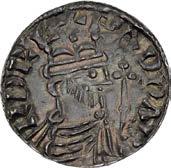
From the CJR Collection.

250
ม ɭәዩɭ⌦ዝ ɭn ⌦ዞዩዞዞዢ , ዩ
a ҟ
NORMAN.
1019.
and
(BMC ii). Castle Rising mint; Rodbert, moneyer. Struck circa 1145-1150. Crowned bust facing slightly left, holding scepter / ม ʽɭዝዛ [ ዞʽ˸ ] Ḧ ɭn Ḧ ʽዢS , voided cross; mullets in quarters. Mack 56; SCBI 26 (East Anglia), 1459; North 878; SCBC 1280. Richly toned, surface crack on reverse. Good VF. A bold portrait and a rare mint. ($2000)
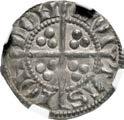

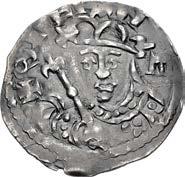
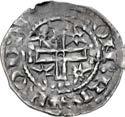
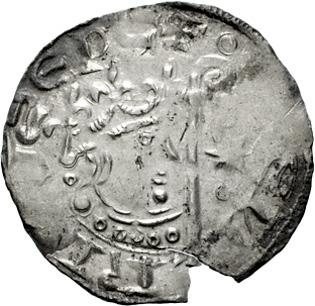

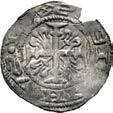
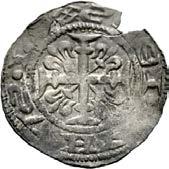

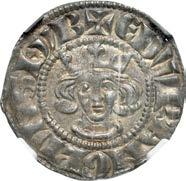
From the St. George Collection, purchased from Sovereign Rarities (£5750). Ex Dix Noonan Webb 167 (23 January 2020), lot 159.
Archbishop Murdac Penny
(19mm, 1.15
๘ ∂ [ ƌ ] ģɃˆƩæ⎍˝ ģPæ , crowned bust right, holding lis-tipped scepter; in right field, star over pelleted annulet / ˝ [ Ϳ ] ģPƌ¥H⎍˝ ˆģҠ , cross pattée with bar in each limb, over saltire fleurée. Cf. Allen, York 56-7 (unlisted dies); Mack ; SCBI 20 (Mack), 1637; North 934; SCBC 1322. Small chip and associated edge crack. Minor lamination on reverse. Speckled find patina and some golden luster in parts. VF. Extremely rare and of considerable interest. ($5000)
Known from only a handful of specimens this extraordinary type, with a crowned bust holding a crozier and legend naming Bishop Henry on the obverse, is exceptional in the Norman series. Not since the issues of the Anglo-Saxon Archbishops of Canterbury in the ninth century had man of the church been portrayed and named on an English coin. Early authorities gave the type to Henry of Blois, Bishop of Winchester and brother of King Stephen. This attribution held till Mark Blackburn, recognising the similarities to other remarkable issues struck at York during the Anarchy, identified the Bishop as Henry Murdac, Archbishop of York from 1147 to 1153. A native of Yorkshire, Henry Murdac became a Cistercian monk at the instigation of of Bernard of Clairvaux. He was consecrated as Archbishop by his friend and fellow Cistercian Eugenius III. This brought him into conflict with King Stephen who had nominated his nephew William Fitz Herbert as candidate. Consequently Henry Murdac supported the Scottish invasion of Northern England. The Archbishop and English king were reconciled in 1150 and Henry Murdac led a mission to Rome to secure support for the proposed coronation of Stephen’s son Eustace as heir apparent. It may be during this period that these extremely rare coins that name Stephen as king on the reverse were struck. Henry Murdac is the last ecclesiastic to be depicted on a coin in the English series.
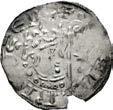
251
NORMAN. Stephen. 1135-1154. AR Penny (19.5mm, 1.28 g, 12h). Voided Cross
Mullets type
1020. NORMAN, Civil War. Henry Murdac. Archbishop of York, 1147/51-1153. AR Penny
g, 5h). York mint.
1021. PLANTAGENET. Edward I. 1272-1307. AR Penny (18mm, 1.41 g, 7h). New coinage, class 3a. London (Tower) mint. Struck circa June 1280–December 1281. Crowned facing bust / Long cross pattée; triple pellets in quarters. SCBI 39 (North), 77; North 1016; SCBC 1387. Golden iridescent toning. In NGC encapsulation 6437573-003, graded MS 62. A beautiful penny and rare in this condition. ($500)
Ex E.J. Harris (Dix Noonan Webb 56, 11 December 2002), lot 10; E.W. Rashleigh (Sotheby, Wilkinson, & Hodge, 21 June 1909), lot 645 (part of); Henry Webb Collection (1809-1894); John Frederick Neck Collection (circa 1835-1910); 1873 Northampton Hoard.
1022. PLANTAGENET. Edward III. 1327-1377. AV Noble (33mm, 7.69 g, 9h). Pre-Treaty period, class G. Tower (London) mint; im: cross 3. Struck 1356-1361. Edward standing facing in ship with bowsprit, holding sword and shield; ornaments -1-1-, ropes 2/1, quatrefoils 3/3, lis 5. E for d in king’s name / Voided short cross potent over cross fleurée; in each angle, crown over lion passant over trefoil; at center, E within quadrilobe; lis in second quarter; all within polylobe, with trefoils in spandrels. Lawrence AS/80; Schneider 43 (same obv. die); North 1179; SCBC 1498. Toned, a few edge marks. Good VF. An interesting engraver’s error in the name. ($2000)
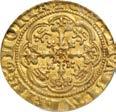
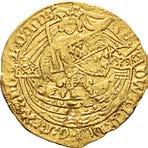

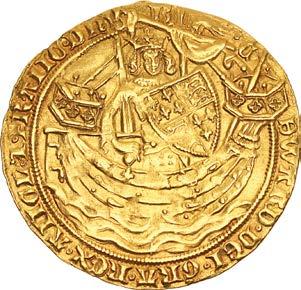
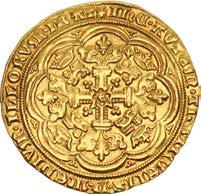
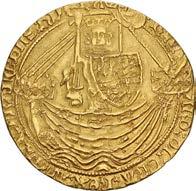
1023. PLANTAGENET. Edward III. 1327-1377. AV Half Noble (25mm, 3.77 g, 9h). Fourth coinage, Treaty period, Series A (Transitional). Tower (London) mint. Struck 1361. King standing facing, holding sword and shield, in ship with bowsprit; ornaments 1-1-1-1, ropes 3/3, quatrefoils 4/3, lis 3, ship’s planks divided / Ornate cross with lis at ends and small Ě in center; crowned lions in quarters, pellets on corners of central panel. Cf. Schneider 58-66 (for type); North 1223; SCBC 1500. Some scuffing. Near VF. Very rare. ($1500)
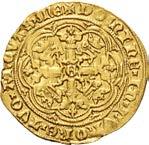
Known as the Cursing Half noble due to the omission of the NE in the reverse legend, giving a reading “Lord, Rebuke Me in Thine Anger!” Most examples of this scarce type are found with annulets around the central panel on reverse whereas this specimen has pellets.
1024. PLANTAGENET. Edward III. 1327-1377. AV Quarter Noble (18mm, 7h). Fourth coinage, Treaty period. Tower (London) mint. Struck 1361-1369. Coat-of-arms; all with double polylobe / Cross fleurée, with lis-in-quadrilobe at center; in each angle, lion passant above lis; all within double polylobe. Cf. Schneider 81-4 (for type); North 1243; SCBC 1510. In PCGS encapsulation 21697846, graded AU 53. ($500)

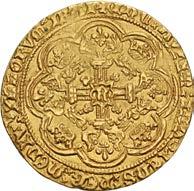
From the St. George Collection.
1025.
Richard
AV Noble (33mm, 6.93 g, 2h). Type IIIA. Tower (London) mint. Richard, holding sword and shield, standing facing in ship; ornaments -1-1-, ropes 3/1, quatrefoils 4/4 / Voided short cross potent over cross fleurée; in each angle, crown over lion passant over trefoil; at center, ˆ within quadrilobe; all within polylobe, with trefoils in spandrels. Cf. Schneider 158-162 (for type); North 1303; SCBC 1656. Clipped down to circulate at the 1412 light coinage weight. Toned. VF. ($2000)
252
PLANTAGENET.
II. 1377-1399.
1023 1024
1026. PLANTAGENET. Richard II. 1377-1399. AV Noble (34mm, 7.70 g, 7h). Type IIIC. Tower (London) mint. Richard standing facing in ship with bowsprit, holding sword and shield; ornaments -1-1-(?), ropes 3/1, quatrefoils 4/4(?); trefoil by shield / Voided short cross potent over cross fleurée; in each angle, crown over lion passant over trefoil; at center, ˊ within quadrilobe; all within polylobe, with trefoils in spandrels. Schneider 177; North 1303; SCBC 1657. In PCGS encapsulation 47538186, graded MS 61. Double struck. Some toning. Bold portrait. ($5000)
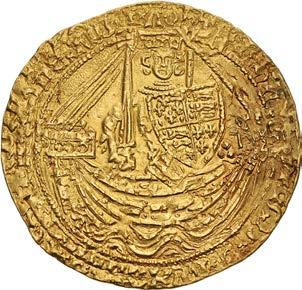
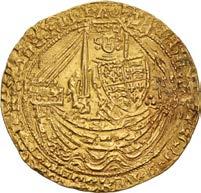
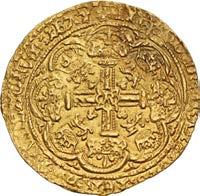
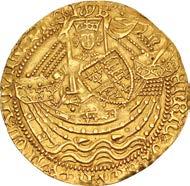
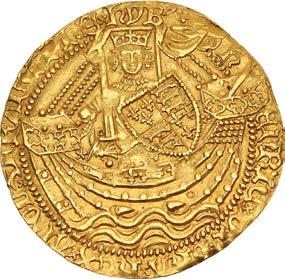




1027. LANCASTER. Henry V. 1413-1422. AV Noble (32mm, 6.94 g, 7h). Class D. Tower (London) mint. Henry standing facing in ship with bowsprit, holding sword and shield; mullet and annulet by hand; ornaments -11-11, ropes 3/2, quatrefoils 3/3, lis 1-2-1; broken annulet on hull / Voided short cross potent over cross fleurée; in each angle, crown over lion passant over trefoil; small cross in second quarter; at center, ƌ within angled quadrilobe; all within polylobe, with trefoils in spandrels. Schneider 245 (same dies); North 1371; SCBC 1743. Attractively toned with underlying luster. In NGC encapsulation 6844930-015, graded MS 63. ($6000)
From the St. George Collection, purchased from Andy Singer.
Extremely Rare Henry V Farthing
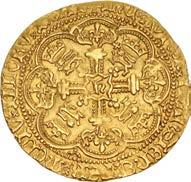
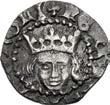
1028. LANCASTER. Henry V. 1413-1422. AR Farthing (9mm, 0.20 g, 6h). London (Tower) mint. Crowned facing head / Long cross pattée; triple pellets in quarters. Withers III 1; North –; SCBC 1797A. VF. A superb little coin. Extremely rare and possibly the first to appear at auction. ($1500)
The portrait punch is found on Nobles of this reign.
253
1029. LANCASTER. Henry VI. First reign, 1422-1461. AV Noble (33mm, 6.83 g, 10h). Henry V Class F/Annulet issue mule. Tower (London) mint; im –/lis. Struck 1422-circa 1430. Henry standing facing in ship with bowsprit, holding sword and shield; ornaments -11-1, ropes 2/1, quatrefoils 4/43/3; cinquefoil and annulet at wrist, trefoil on side of ship, quatrefoil above sail / Voided short cross potent over cross fleurée; in each angle, crown over lion passant over trefoil; at center, ƌ within quadrilobe; all within polylobe, with trefoils in spandrels, annulet in one spandrel. Schneider 268 (same obv. die); North 1374/1414; SCBC 1800. In NGC encapsulation 6529353-002, graded AU Details, cleaned. Rare mule with obverse of Henry V. ($2500)
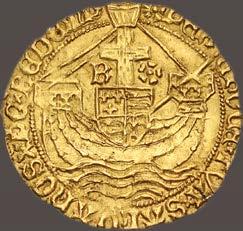
1030. YORK. Edward IV. First reign, 1461-1470. AV Angel (27mm, 5.07 g, 5h). Type XXI. Tower (London) mint; im: cinquefoil. Struck 1480-1483. Archangel Michael slaying the Dragon / Ship bearing shield and cross, E Ⴙ flanking cross. Cf. Schneider 467-8 (for type); North 1626; SCBC 2091. Toned, small repair on rim, a few scatches. VF. ($1000)
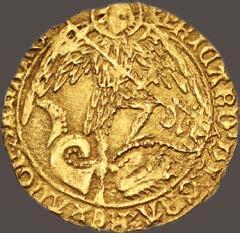
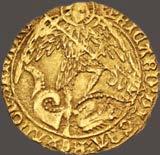
From the St. George Collection, purchased from Baldwin’s.
Mint State Richard III Angel
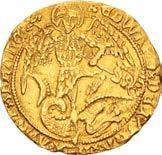
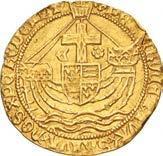
1031. YORK (Restored). Richard III. 1483-1485. AV Angel (27mm, 5.20 g, 8h). Type 2b/3 mule. Tower (London) mint; im: boar’s head 2/sun & rose 2. (boar’s head 2) ˊƩýaˊd⎡
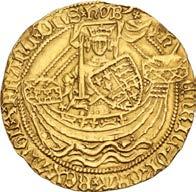
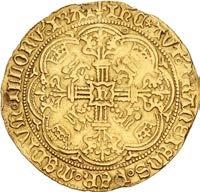
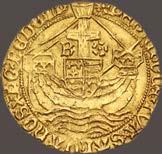
, Archangel Michael slaying dragon to lower right, spear topped by cross-crosslet / (halved sun & rose 2) ʖEˊ ᚤ
ᚤ ˊEdE⍴ʖͿ (saltire stops), ship bearing shield and cross, ˊ and rose flanking cross. Winstanley 14.1 and pl. 1, no. 12 (this coin); Schneider 494; North 1677; SCBC 2151/2152. In NGC encapsulation 6522065-001, graded MS 63. Richly toned with some luster. Struck near the end of this infamous reign. Very rare.
($15,000)
Ex R.C. Lockett (English Part III, 4 November 1958), lot 3716, purchased from Spink; P. Carlyon-Britton (Sotheby, Wilkinson, & Hodge, 30 November 1905), lot 52 (unillustrated but likely this coin).
Lockett’s manuscript catalog notes that he purchased this coin from Spink for 12/-, and that it is “Ex Carlyon Britton Coll.” An example of this same very rare type appears in P. Carlyon-Britton’s 1905 sale and, though it is unillustrated, is most likely this coin.
254
ˊEҢ
ýˊѝýE ᚤ Ϳѝa ᚤ ˫aǭѝa ᚤ Nɨ˫ ҢʖE
dƩ⎡ ŷˊa⎡
aNŷǭ⎡ Ӳ fˊaNý
1032. TUDOR. Henry VIII. 1509-1547. AV Angel (28mm, 5.15 g, 4h). First coinage. Tower (London) mint; im: portcullis. Struck circa 1513-1526. Archangel Michael slaying dragon to lower right, spear topped by cross-crosslet / Ship bearing shield and cross, ƌ k and rose flanking cross. Cf. Schneider 560-563 (for type); North 1760; SCBC 2265. In NGC encapsulation 6529307-007, graded MS 62. Slight ghosting. Struck on a full flan. Toned. ($4000)
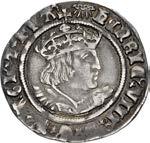
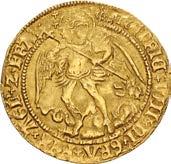
1033. TUDOR. Henry VIII, with Katharine of Aragon. 1509-1547. AV Crown of the Double Rose (26mm, 3.54 g, 5h). Second coinage. Tower (London) mint; im: rose. Struck November 1526-1529. Crowned double rose; crowned ƌ k flanking / Crowned coat-of-arms. Schneider 579-580 var. (legend and stops); North 1788; SCBC 2273. Polished, edge smoothed. Near VF. A scarce early issue with Roman lettering both sides. ($1500)
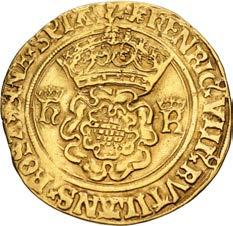
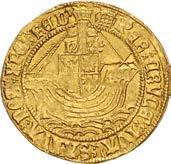
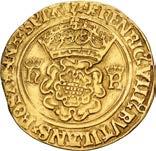
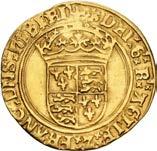
Sunburst Initial Mark
ĕ⎡ ŷ⎡ ˆ⎡ ɀŷȄ⎡ Z ᛆ Ŗˆa= ,
bust (Laker D) right / (sunburst) ʖɨ˫ѝƩ ĕEѝ=Ḻ a
Among the scarcer marks on Henry VIII’s silver coinage, the sunburst likely held some special function beyond that of the usual initial marks. It likely commemorates the birth of Henry’s son and successor Edward, born to Jayne Seymour on 12th October 1537 in Hampton

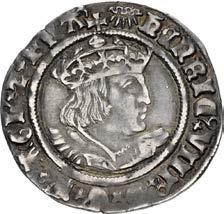
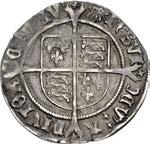
255
From the CJR Collection.
1034. TUDOR. Henry VIII. 1509-1547. AR Groat (25mm, 2.71 g, 7h). Second coinage. Tower (London) mint; im: sunburst. Struck 1526-1544. (sunburst) ƇEɀˆƩý⎡ѝƩƩƩ⎡
crowned
ĕƩѝͿɨˆ E=Ḻ ⍴Eѝ , coat-of-arms over long cross fourchée; saltires in forks. Whitton (v), 1; North 1797; SCBC 2337E. Toned, a very light scratch on face. VF. With a clear mintmark. Rare. ($750)
Court Palace.
1035. TUDOR. Henry VIII. 1509-1547. AR Groat (26mm, 2.67 g, 2h). Second coinage. York mint; im: voided cross. Thomas Wolsey, archbishop. Struck 1526-1530. Crowned bust right (Laker D) / Crowned coat-of-arms over long cross fourchée; tasseled gallero at base of cross. Whitton (i) (a); North 1799; SCBC 2340. Brushed, edge crack, slightly double struck, area of flat strike. Near VF. Very rare variety omitting the initials of Archbishop Wolsey from the reverse. ($1000)
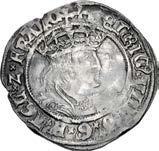
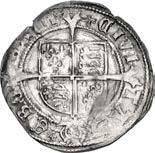
Portrait Gold of the Boy King
1036. TUDOR. Edward VI. 1547-1553. AV Half Sovereign (5.24 g). Second period. Tower (London) mint; im: arrow. Struck 1549. Crowned and armored bust right / Crowned coat-of-arms; E R flanking. Schneider 672 (same dies); North 1911; SCBC 2438. In NGC encapsulation 6844924-004, graded AU 53. Attractive orange tone. The portrait well struck up. Rare. ($7500)
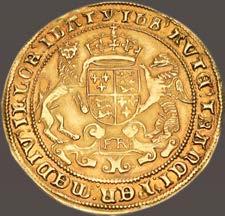
1037. TUDOR. Edward VI. 1547-1553. AV Sovereign (37mm, 11.16 g, 11h). Third period, crown gold coinage. Tower (London) mint; im: У. Struck 1551–1553. Crowned and armored half-length bust right, holding sword over right shoulder and globus cruciger in left hand / Crowned coat-of-arms with crowned leopard and griffin supporters; all set on ornate frame with central titulus inscribed ⌓ˊ . Schneider 690; North 1927; SCBC 2450. Richly toned with underlying luster. In NGC encapsulation 6844908-002, graded XF 45. A pleasing and well pedigreed example of this rare Sovereign. Conservatively graded by NGC in our opinion. ($20,000)
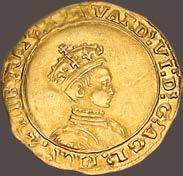
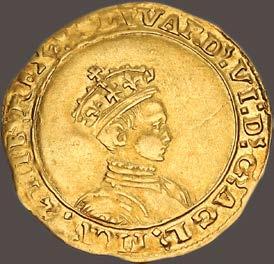
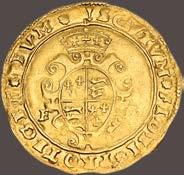
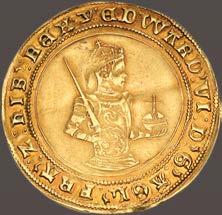
Ex Dr. Paul Broughton (Spink 235, 22 March 2016), lot 434; Spink 181 (30 March 2006), lot 1028; Glendining (6 June 1991), lot 841; Glendining (17 June 1962), lot 20; C.H.B. Morton, Earl of Ducie (Glendining, 5 October 1949), lot 16.
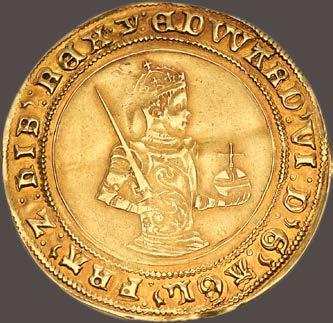
256
1036
1037
1.17 g, 6h). First period. Canterbury mint; im: –. Struck April 1547-February 1548. Crowned bust right; EDWARD in legend / Coat-of-arms over long cross fourchée. North 1901; SCBC 2459. Toned with traces of luster, minor areas of weakness. Good VF. ($750)
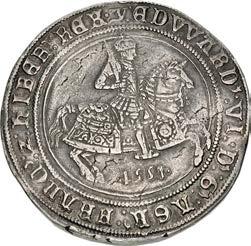
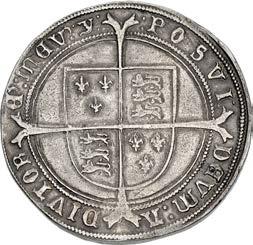
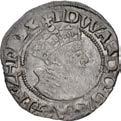
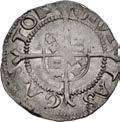
flan flaws. VF. A well struck horse and king. ($2000)
Mary
11h). Fine gold coinage. Tower (London) mint; im:
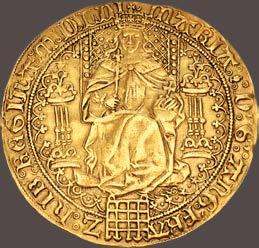
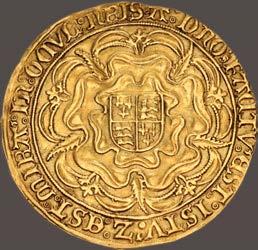
Dated 1553 (in Roman numerals). Ḽ Ȏ¨ˆƱ¨ Ḽ ռ Ḽ ĕ= Ḽ ŷ= Ḽ ¨ɀŷ= ი ōˆ¨
Mary enthroned facing, holding scepter in left hand, globus cruciger in right; portcullis below; all within ornate border / ¨ Ḽ
ი , royal shield within Tudor rose. Schneider 704 (same obv. die); North 1956; SCBC 2488. Rich old orange-pink toning. In PCGS encapsulation 4767120, graded AU 50. An even strike with strong detail. Rare. ($25,000)
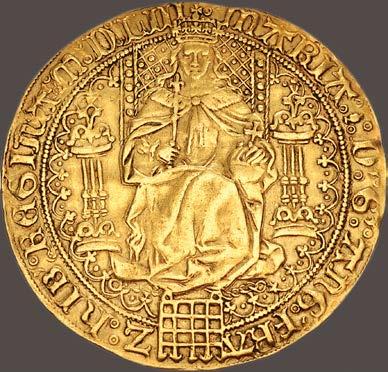
257
1038. TUDOR. Edward VI. 1547-1553. AR Halfgroat (19mm,
1039. TUDOR. Edward VI. 1547-1553. AR Crown (42mm, 30.97 g, 9h). Third period, fine silver issue. Tower (London) mint; im: У. Dated 1551. Edward on horseback riding right / Coat-of-arms over long cross fourchée. Woodbridge dies A/16; North 1933; SCBC 2478. Toned, some edge marks and
Tudor Sovereign
Ӳ ი ƌƱB= Ḽ ˆĚŷƱɀ¨ Ḽ Ȏ Ḽ ĕ Ḽ ǴƱƱƱ ,
ĕɀɭ= ռ ō¨ý˸⎍= ი ĚS˸ Ḽ ƱS˸⎍= ი ә Ḽ ĚS˸ Ḽ ȎƱˆ¨= ი Ʊɀ Ḽ ɭý⎍Ǵ=
1040. TUDOR. Mary. 1553-1554. AV Sovereign (44mm, 15.15 g,
pomegranate.
Ḽ ɀˆƱS=
Ex Archbishop Sharp (Morton & Eden 91, 7 December 2017), lot 217.
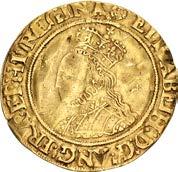
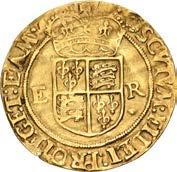
Dr. John Sharp (1644-1714) was a clergyman who rose through the offices of the Church of England to become Archbishop of York in 1691. Sharp started collecting coins in 1687 and focused his energies primarily on the issues of the British Isles, acquiring many highly important rarities. Sharp was in contact with several other leading numismatists of his age, including Ralph Thoresby, to whom he addressed his manuscript, ‘Observations on the Coinage of England’, published in 1785. The great 19th Century numismatist, Roger Ruding, regarded this work as, “the first systematic treatise ever composed on the subject.” On Sharp’s death, the collection was left to his son and was kept together for some 250 years by his descendants. In the words of the late Harry Manville, ‘Sharp pedigrees are among the oldest available in British numismatics.’
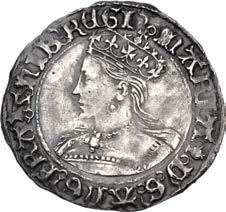
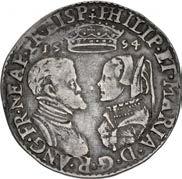
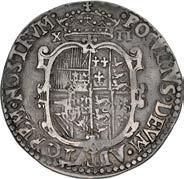
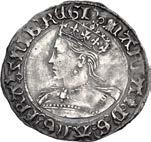

258
1041. TUDOR. Mary 1553-1554. AR Groat (24mm, 2.13 g, 6h). London (Tower) mint; im: pomegranate. Crowned bust left / Coat-of-arms over long cross fourchée. North 1960; SCBC 2492. Toned, trace of crease. VF. ($750)
1042. TUDOR. Philip & Mary. 1554-1558. AR Shilling (30mm, 6.28 g, 11h). Tower (London) mint. Dated 1554. Confronted busts of Philip, armored, and Mary, veiled; crown above / Crowned coat-of-arms; X II (mark of value) flanking crown. North 1967; SCBC 2500. Deeply toned, a few very minor scratches. Near VF. Well balanced portraits. ($1000)
From the Libertas Collection.
1043. TUDOR. Elizabeth I. 1558-1603. AV Half Pound (30mm, 4.62 g, 4h). Third coinage, crown gold. Tower (London) mint; im: rose. Struck 1565. Crowned bust left, wearing ruff / Crowned coat-of-arms. Brown & Comber G9; Schneider 741; North 1994; SCBC 2520. Clipped, crimps. Fine. ($1500)
From the Malthouse Collection.
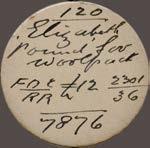
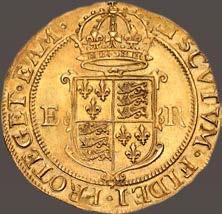
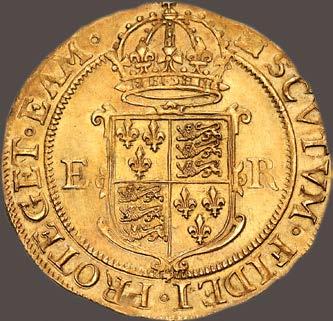
Majestic Mint State Elizabeth Pound

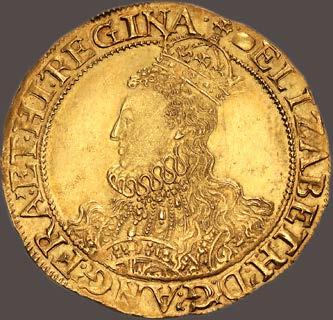
259
1044. TUDOR. Elizabeth I. 1558-1603. AV Pound (37mm, 11.23 g, 4h). Sixth coinage, crown gold. Tower (London) mint; im: woolpack. Struck 1594-1596. (woolpack) ELIZABETH’· D’· G’· ANG’· FRA’· ET · HI’· REGINA ·, crowned bust left, wearing ruff / (woolpack) · SCVTVM · FIDEI · PROTEGIT · EAM ·, crowned coat-of-arms; E R flanking. Brown & Comber F9; Schneider 799 var. (legends); North 2008; SCBC 2534. In NGC encapsulation 6522064-001, graded MS 63. Top Pop. Delicate peach blossom toning over near pristine fields. A crisply struck coin with excellent detail. Rare and highly desirable in this state. ($50,000)
1045. TUDOR. Elizabeth I. 1558-1603. AV Pound (38mm, 11.28 g, 5h). Sixth coinage, crown gold. Tower (London) mint; im: –/O. Struck 1600. Crowned bust left, wearing ruff / Crowned coat-of-arms; E R flanking. Brown & Comber F22; Schneider 804 var. (no im on obv.); North 2008; SCBC 2534. In NGC encapsulation 6844908-003, graded AU Details, edge filing. ($10,000)


1046. TUDOR. Elizabeth I. 1558-1603. AV Crown (23mm, 2.73 g, 6h). Sixth coinage, crown gold. Tower (London) mint; im: O. Struck 1600. Crowned bust left, wearing ruff / Crowned coat-of-arms. Brown & Comber H22; Schneider 815 (same rev. die); North 2010; SCBC 2536. Pierced and plugged. VF. Very rare. ($2500)
Ex Spink Numismatic Circular CXV.1 (February 2007), no. HS2791.
1047. TUDOR. Elizabeth I. 1558-1603. AR Crown (42mm, 29.81 g, 9h). Seventh coinage. Tower (London) mint; im: 1. Struck 1601. Crowned and draped bust left, wearing ruff, holding lis-tipped scepter and orb / Coat-of-arms over long cross

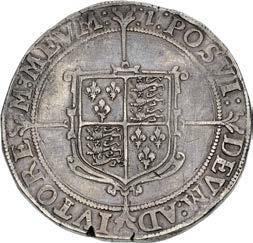
13.59 g, 1h). Second coinage, fine gold. Tower (London) mint; im: rose. Struck 1605-1606. James enthroned facing, head slightly left, wearing crown and mantle, holding scepter and orb; portcullis below; all within polylobe / Coat-of-arms in ornate polylobe within decorative rose. Stewartby dies A/d; Schneider 6 (same obv. die); North 2079; SCBC 2613. In NGC encapsulation 6844930-012, graded AU Details, damaged. ($6000)
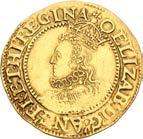
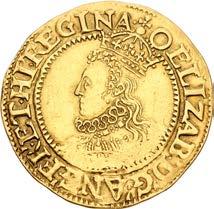

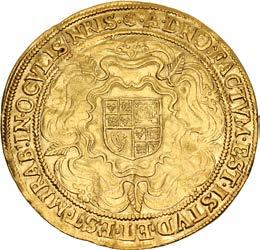

260
fourchée. Barr/Cooper dies C/3; BCW 1-1/1-a3; North 2012; SCBC 2582. Toned, lightly tooled. Near VF. ($1500)
1048. STUART. James I. 1603-1625. AV Rose Ryal (43mm,
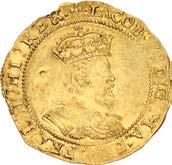
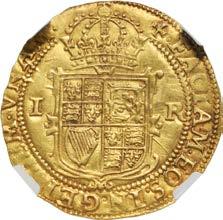
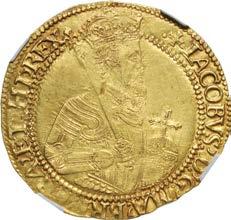
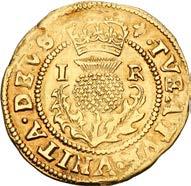

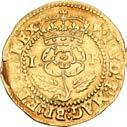
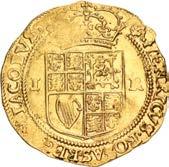
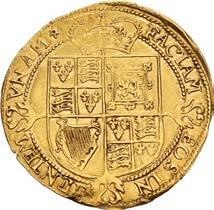
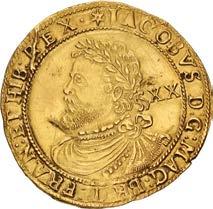
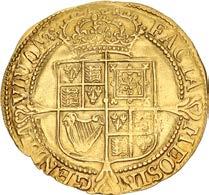

261
1049. STUART. James I. 1603-1625. AV Unite (36mm, 10.22 g, 9h). Second coinage, crown gold. Tower (London) mint; im: plain cross. Struck 1618-1619. Crowned and armored half-length bust right, holding lis-tipped scepter and globus cruciger / Crowned coat-of-arms; I R flanking. Schneider –; North 2085; SCBC 2620. In NGC encapsulation 6380983-009, graded “Genuine,” our grade Good VF, hairlines, slightly weakly struck on face. ($1500) Ex 2019 Ellerby Hoard (PAS: YORYM-18E848).
1050. STUART. James I. 1603-1625. AV Double Crown (29mm, 5.03 g, 10h). Second coinage, crown gold. Tower (London) mint; im: plain cross/(plain cross over crescent). Struck 1618-1619. Crowned fifth bust right / Crowned coat-of-arms. Cf. Schneider 41; North; SCBC 2623. Lustrous, area of weak strike, small dig in reverse field. Good VF. ($1500)
1051. STUART. James I. 1603-1625. AV Thistle Crown (21mm, 1.97 g, 4h). Second coinage, crown gold. Tower (London) mint; im: lis. Struck 1604-1605. Crowned rose with two leaves; I R flanking / Crowned thistle with two leaves; I R flanking. Schneider 57; North 2096; SCBC 2627. In NGC encapsulation 6844932-010, graded AU 55. ($1000)
1052. STUART. James I. 1603-1625. AV Unite – Laurel (35mm, 9.06 g, 12h). Third coinage, crown gold. Tower (London) mint; im: spur ryal. Struck 1619-1620. Laureate, draped, and cuirassed bust left (second head); XX (mark of value) to right / Crowned coat-of-arms over long cross fourchée. Schneider 83; North 2114; SCBC 2638. Lustrous, scattered scrapes and marks. Good VF. ($2000)
1053. STUART. James I. 1603-1625. AV Laurel – Unite (34mm, 8.91 g, 4h). Third coinage, crown gold. Tower (London) mint; im: lis. Struck 1623-1624. Laureate, draped, and cuirassed bust left (fourth head); XX (mark of value) to right / Crowned coat-of-arms over long cross fourchée. Schneider –; North 2114; SCBC 2638B. Edge smoothed, pinhole at margin, hairlines. Near VF. ($1500)
1052 1053
1054. STUART. James I. 1603-1625. AV Laurel – Unite (34mm, 8.94 g, 4h). Third coinage, crown gold. Tower (London) mint; im: lis. Struck 1623-1624. Laureate, draped, and cuirassed bust left (fourth head variety); XX (mark of value) to right / Crowned coat-of-arms over long cross fourchée. Cf. Schneider 86 (for type); North 2114; SCBC 2638C. In NGC encapsulation 6529353-003, graded AU 55. ($2000)
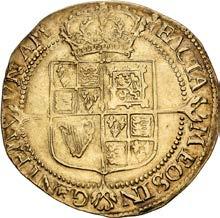
1055. STUART. James I. 1603-1625. AV Half Laurel – Double Crown (29mm, 4.42 g, 2h). Third coinage, crown gold. Tower (London) mint; im: rose. Struck 1620-1621. Laureate, draped, and cuirassed bust left (fourth head); X (mark of value) to right / Crowned coat-of-arms over long cross fourchée. Schneider 90; North 2117; SCBC 2641A. Edge smoothed, hairlines. Near VF. ($1000)
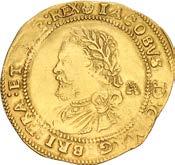
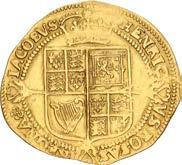

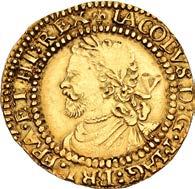
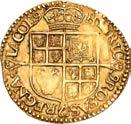
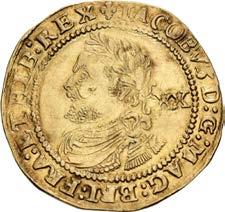
1056. STUART. James I. 1603-1625. AV Quarter Laurel (20.5mm, 2.28 g, 4h). Third coinage, crown gold. Tower (London) mint; im: lis. Struck 1623-1624. Laureate, draped, and armored bust left; V (mark of value) to right; beaded inner circle / Crowned coat-of-arms over long cross fourchée. Schneider 98 var. (legends); North 2118; SCBC 2642B. Warm rose toning. VF. Well centered. ($750)
Ex Classical Numismatic Review XLL.1 (Winter 2017), no. 447000; Baldwin’s 101 (28 September 2016), lot 3204.
1057. STUART. James I. 1603-1625. AR Crown (43mm, 29.74 g, 12h). Third coinage. Tower (London) mint; im: lis. Struck 1623-1624. James fight on caparisoned horse, holding sword and reins; grass ground line / Coat-of-arms within ornate frame. Cooper, English, dies X/XVIII; North 2120; SCBC 2664. Uneven light toning, a few marks and scratches, hairlines. VF. ($1500)


262
1058. STUART. Charles I. 1625-1649. AV Unite (34mm, 9.06 g, 2h). Crown gold coinage, group A, class II. Tower (London) mint; im: lis. Struck 1625. Crowned bust left, wearing ruff; XX (mark of value) to right (bust 1) / Crowned and garnished coat-of-arms. Brooker 22; Schneider 112; North 2146; SCBC 2685. In NGC encapsulation 6844932-009, graded AU 58. Struck from somewhat worn dies. Toned with luster. ($4000)
1059. STUART. Charles I. 1625-1649. AV Unite (34mm, 8.90 g, 10h). Crown gold coinage, group B, class I. Tower (London) mint; im: cross calvary. Struck 1625-1626. Crowned second bust left; XX (mark of value) to right / Crowned coatof-arms. Brooker 30-1 var. (legend); Schneider 120-1 var. (same); North 2148; SCBC 2687. In NGC encapsulation 6844932011, graded AU Details, cleaned. ($2000)
1060. STUART. Charles I. 1625-1649. AV Double Crown (27mm, 4.60 g, 8h). Crown gold coinage, group A. Tower (London)
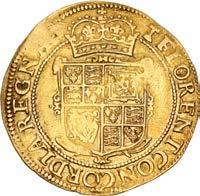
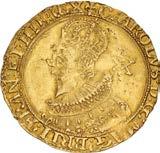
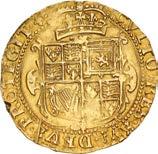
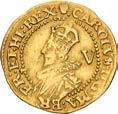
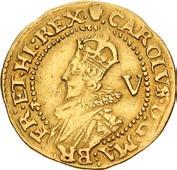
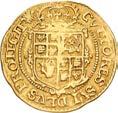
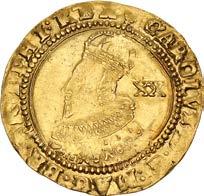
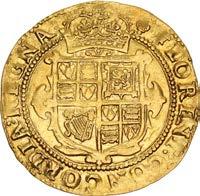
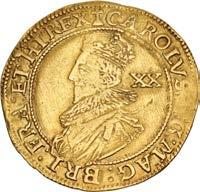
263
mint; im: lis. Struck 1625. Crowned first bust left, wearing ruff; X (mark of value) to right / Crowned coat-of-arms. Schneider, Tower Class I, 1; Brooker –; Schneider 173; North 2158; SCBC 2697. Toned, double struck, edge filed, scuff on reverse. Near VF. ($1500)
1061. STUART. Charles I. 1625-1649. AV Crown (19mm, 2.25 g, 6h). Crown gold coinage, group B. Tower (London) mint; im: plumes. Struck 1630-1631. Crowned bust 3 left, wearing ruff; V (mark of value) to right / Crowned coat-of-arms. Schneider, Tower Class II, 2; Brooker 199A (same rev. die); Schneider 236 (same rev. die); North 2182; SCBC 2712. Slightly crimped. VF. Struck on a broad flan. ($750)
1063.
(44mm, 29.87 g, 8h). Group III, type 3a. Tower (London) mint; im: crown/ (crown over bell). Struck 1635-1636. Charles on caparisoned horse left, holding reins and sword over shoulder / Coat-of-arms. Cooper, Silver dies XVI/XX*; Brooker 258 (same dies); North 2195; SCBC 2758. In NGC encapsulation 6133356-002, graded AU 58. Top Pop. Slight weakness of strike in center. Otherwise attractively toned and with excellent detail. ($3000)
Ex Sovereign Rarities 6 (28 June 2022), lot 26; St. James’s 13 (6 May 2010), lot 572; St. James’s 2 (11 May 2005), lot 132; London Coins (27 November 2004), lot 590; Spink Numismatic Circular CII.8 (October 1994), no. 6508; Spink Numismatic Circular C.4 (May 1992). no. 2580; Bridgewater House (Sotheby’s, 15 June 1972), lot 240.
The Bridgewater House Collection was possibly begun as early as the mid-17th century by John, the second Earl of Bridgewater, with a collection certainly passing to Scrope, the fourth Earl, in 1701. The collection appears to have been effectively completed by about 1740, as few coins of later date appear.
(46mm, 29.87 g, 10h). Group IV, type 4. Tower (London) mint; im: sun. Struck under Parliament, 1645-1646. Charles on horseback left, holding reins and sword / Coat-of-arms. Cooper, Silver dies XXIV/XXXVII; Brooker 272 (same dies); North 2198; SCBC 2761. Weakly struck on king’s head. Minor marks under tone. Good VF. ($3000)
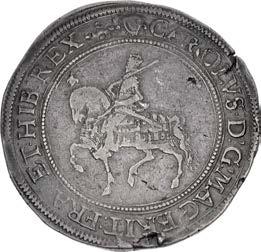


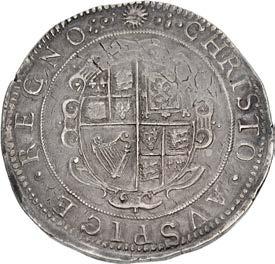
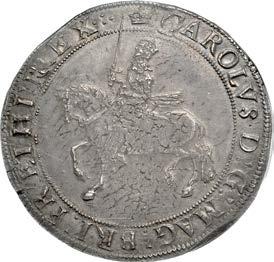
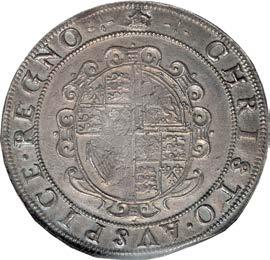
264
1062. STUART. Charles I. 1625-1649. AR Crown (43mm, 29.89 g, 10h). Group II, type 2a. Tower (London) mint; im: (harp over rose over plumes)/harp. Struck 1632-1633. Charles on caparisoned horse left, holding reins and sword over shoulder / Coat-of-arms over cross fourchée; C R above. Cooper, Silver dies X*/XIV; Brooker 246 (same dies); North 2193; SCBC 2755. Toned, flan crack and flan flaws. Near VF. ($750)
From the CJR Collection.
STUART. Charles I. 1625-1649. AR Crown
1064. STUART. Charles I. 1625-1649. AR Crown
1065. STUART. Charles I. 1625-1649. AR Halfcrown (35mm, 14.82 g, 10h). Group I, type 1a1. Tower (London) mint; im: lis. Struck 1625. (lis) CA ROLVS D · G · MAG · BR · FR · ET HI · REX, Charles on caparisoned horse left, holding sword in raised right hand, reigns in left; plume on horse / (lis) CHRI STO AV SPICE REGNO, coat-of-arms over long cross fleurée. Bull 5/1d-I; Brooker 277 (same obv. die); North 2200; SCBC 2763. Attractive toning with shades of blue iridescence, minor flan flaws. VF. Bold strike. Rare. ($1500)
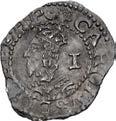
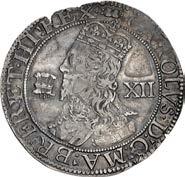

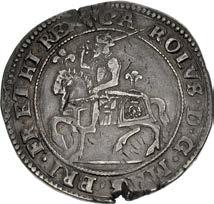
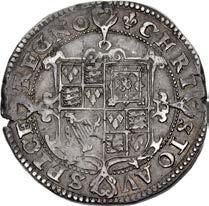


1066. STUART. Charles I. 1625-1649. AR Shilling (31mm, 5.60 g, 8h). Aberystwyth mint; im: open book. Struck 1638/9-1642. Crowned bust left; plumes to left, XII (mark of value) to right / Coat-of-arms; plumes above. Morrieson, Aberystwyth, C-2; Brooker 753 (same dies); North 2331; SCBC 2883. Toned, area lacquer on obverse, some light marks. Good VF. Rare. ($1500)
1067. STUART. Charles I. 1625-1649. AR Penny (12mm, 0.46 g, 5h). Exeter mint: im: rose. Dated 1644. Crowned bust left; I (mark fo value) to right / Rose. Brooker 1075 (same dies); North 2583; SCBC 3092. Toned, double struck on date. Good VF. Bold portrait. Lot includes an old Baldwin’s ticket. ($750)
1068. STUART, Siege money. Newark. 1645-1646. AR Ninepence (24x30mm, 4.01 g, 12h). In the name of Charles I. Dated 1646. Large crown; C R across field, IX (mark of value) below / OBS :/ NEWARK/ 1646. Brooker 1227 (same dies); North 2641; SCBC 3144. Pierced and plugged. VF. Retaining some detail from the original plate and much of the original gilding. Rare. ($1000)
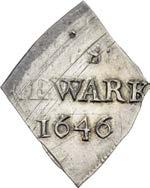

From the Libertas Collection, purchased October 1984.
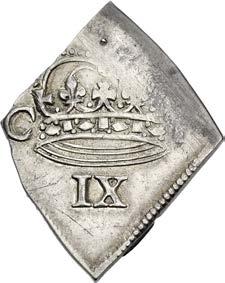
265
1065
1066
1069. COMMONWEALTH. 1649-1660. AV Unite (34mm, 9.09 g, 7h). Tower (London) mint; im: sun. Dated 1653. Coat-of-arms within wreath / Two coats-of-arms; XX (mark of value) above. Schneider 341; North 2715; Bull, Gold I 14; SCBC 3208. In NGC encapsulation 6844930-010, graded XF 45. ($3000)

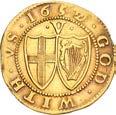
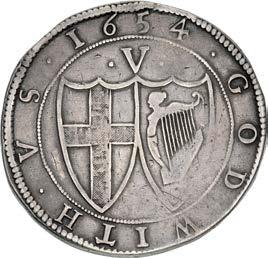
1070. COMMONWEALTH. 1649-1660. AV Unite (34mm, 9.09 g, 3h). Tower (London) mint; im sun. Dated 1654. Coatof-arms within wreath / Two coats-of-arms; XX (mark of value) above. Schneider 342; North 2715; Bull, Gold I 20; SCBC 3208. Some light smoothing around shield on obverse. Minor flaw in center. Toned. VF. ($3000)
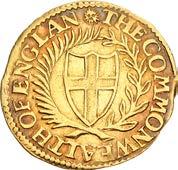
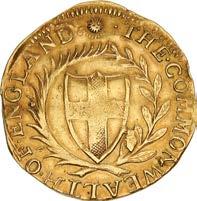
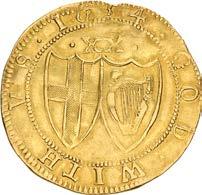
1071. COMMONWEALTH. 1649-1660. AV Crown (19mm, 2.20 g, 5h). Tower (London) mint; im: sun. Dated 1652/0. (sun) THE COMMONWEALTH OF ENGLAN (sic), coat-of-arms within wreath / Two coats-of-arms; ·V· (mark of value) above. Cf. Schneider 360 (for type); Bull, Gold North 2719; SCBC 3212. Attractive blue-purple toning. In NGC encapsulation 6844930-011, graded AU 50. Rare overdate and obverse legend engraver’s error. ($2500)
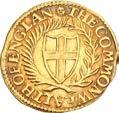
1072. COMMONWEALTH. 1649-1660. AR Crown. Tower (London) mint; im sun. Dated 1654. Inverted A in VS. Bull 9; ESC 9A; North 2721; SCBC 3214. Toned, even strike, smoothed on edge. Fine. Rare date. ($1000)
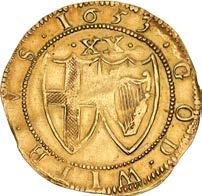
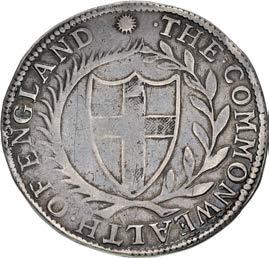
266
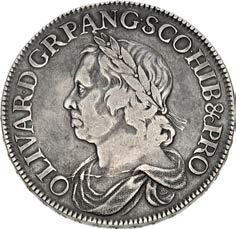
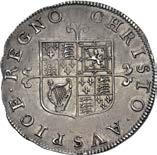

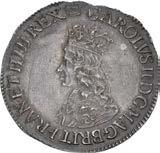
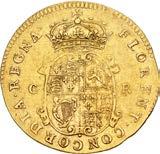
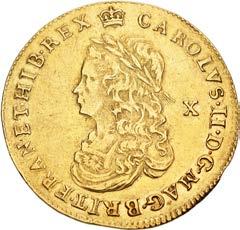
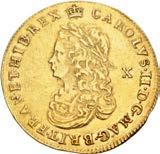

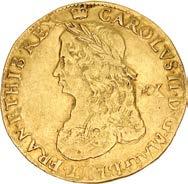

267
1073. COMMONWEALTH. Oliver Cromwell. Lord Protector, 1653-1658. AR Crown. Dated 1658/7. Lessen E12; Bull 240; ESC 10; North 2745; SCBC 3226. Toned, bruise at edge. Fine. ($1500)
1074. STUART. Charles II. 1660-1685. AV Unite (31mm, 8.84 g, 5h). Hammered coinage, second issue. Tower (London) mint; im: crown. Struck 1660-1662. Laureate, draped, and cuirassed bust left; XX (mark of value) to right / Crowned coatof-arms. Schneider, Hammered dies O4/R5; Schneider 396 (same dies); North 2754; Bull, Gold I 139; SCBC 3304. In NGC encapsulation 6844932-012, graded VF 30. ($3000)
1075. STUART. Charles II. 1660-1685. AV Double Crown (25mm, 4.48 g, 3h). Hammered coinage, second issue. Tower (London) mint; im: crown. Struck 1660-1662. Laureate, draped, and cuirassed bust left; X (mark of value) to right / Crowned coat-of-arms. Schneider, Hammered dies O3/R5; Schneider 417 (same dies); North 2756; Bull, Gold I 161; SCBC 3305. In NGC encapsulation 6844936-001, graded AU Details, scratched. Toned. Evenly struck on a broad flan. Very rare. ($5000)
1076. STUART. Charles II. 1660-1685. AR Sixpence (28mm, 3.06 g, 2h). Hammered coinage, first issue. Tower (London) mint; im: crown. Struck 1660-1662. ՟ CAROLVS II D G MAG BRIT FRAN ET HIB REX, crowned and mantled bust left / · CHRISTO · AVSPICE · REGNO, coat-of-arms over short cross fourchée. ESC 1507; North 2765; SCBC 3309. A few light marks under rich old cabinet toning. Some luster. Near EF. ($1500)
Ex Baldwin’s FPL (February 2016), no. 92; Baldwin’s 96 (24 September 2015), lot 3395; Classical Numismatic Review XXV (Summer/Fall 2000), no. 119; Davissons 13 (2 May 2000), lot 227.

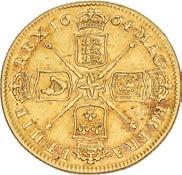
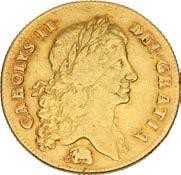
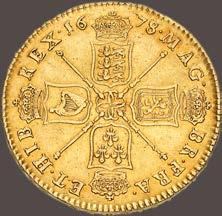
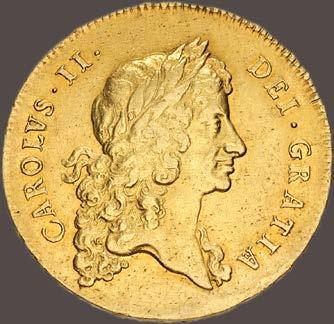
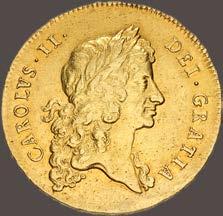

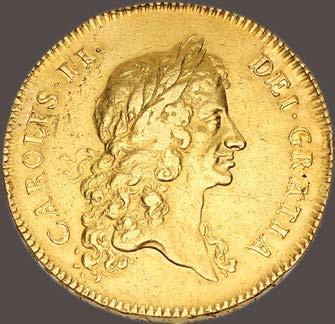
268
1077. STUART. Charles II. 1660-1685. AV Five Guineas. Dated 1672 and RY V. QVARTO. First bust. Bull, Gold 175; MCE 7; SCBC 3328. In NGC encapsulation 6844908-005, graded AU Details, Scratches. Small area of scratches on reverse. Rare date. ($15,000)
1078. STUART. Charles II. 1660-1685. AV Five Guineas. Dated 1678/7 and RY TRICESIMO. First bust. Bull, Gold 188; MCE 17; SCBC 3328A. In NGC encapsulation 6846809-001, graded AU Details, obverse rim repair. Warm orange tone with flashes of luster. ($15,000)
1079. STUART. Charles II. 1660-1685. AV Two Guineas. Dated 1664. Elephant & castle. First bust. Bull, Gold 204; MCE 32; SCBC 3334. In NGC encapsulation 6844932-005, graded XF Details, obverse scratched. ($2500)
1077 1078
1666 – The Year of the Great Fire of London
1081
We see no evidence of cleaning. Appears to be a wholesome coin with good detail.
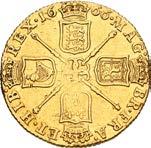
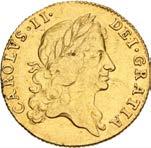
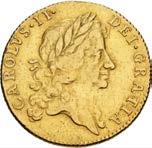
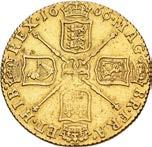
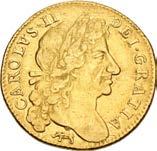
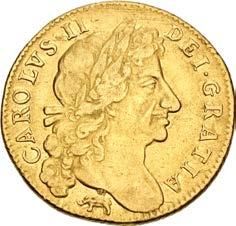
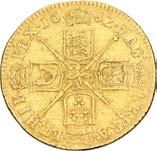
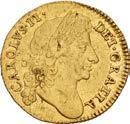
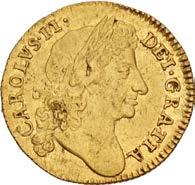
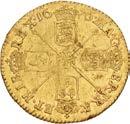
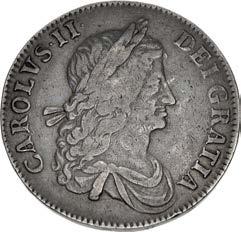
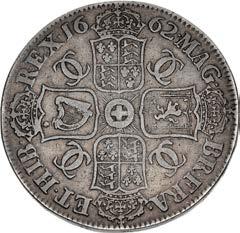
269
1080. STUART. Charles II. 1660-1685. AV Guinea. Dated 1666. Third bust. Bull, Gold 236; MCE 60; SCBC 3342. In NGC encapsulation 6529353-004, graded XF Details, cleaned. ($2000)
1081. STUART. Charles II. 1660-1685. AV Guinea. Dated 1666. Third bust. Bull, Gold 236; MCE 60; SCBC 3342. In NGC encapsulation 6844932-003, graded XF Details, obverse scratched. ($1000)
1082. STUART. Charles II. 1660-1685. AV Guinea. Dated 1682. Elephant & castle. Fourth bust. Bull, Gold 279; MCE 87; SCBC 3345. In NGC encapsulation 6844932-001, graded XF Details, cleaned. ($1500)
1083. STUART. Charles II. 1660-1685. AV Half Guinea. Dated 1676. Second bust. Bull, Gold 292; MCE 100; SCBC 3348. Some luster, trace of crease, a few light marks. VF. ($1000)
1084. STUART. Charles II. 1660-1685. AR Crown. Dated 1662. First bust, no rose below. Edge undated. Die axis 12h (en medaille). Bull 348 (R5); ESC 19 var. (die axis); SCBC 3353 var. (same). Toned. Good Fine. Extremely rare. ($750)
Ex Gainsborough Collection; Spink Numismatic Circular CX.4 (August 2002), no. MS2850 (‘the first example seen with no rose of this die axis’).
1080
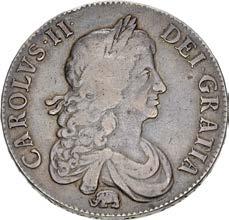
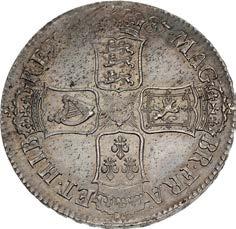
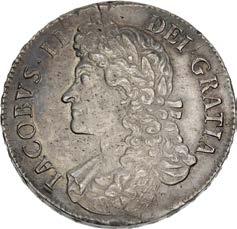
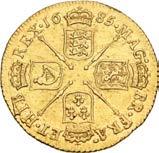
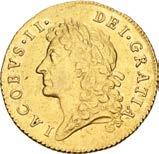
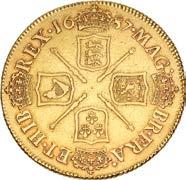

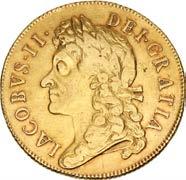
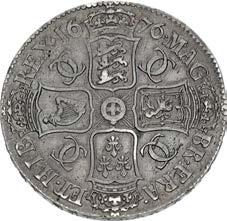


270
1085. STUART. Charles II. 1660-1685. AR Crown. Dated 1666 and RY XVIII. Bull 368; ESC 33; SCBC 3356. Toned, a few light scratches, small edge bump. Fine. ($750)
1086. STUART. Charles II. 1660-1685. AR Crown. Dated 1676 and RY V. OCTAVO. Bull 397; ESC 51; SCBC 3358. Richly toned. Good VF. ($750)
1087. STUART. James II. 1685-1688. AV Two Guineas. Dated 1687. Bull, Gold 318; MCE 121; SCBC 3399. In NGC encapsulation 6844932-008, graded VF 35. A pleasing, circulated example. Richly toned. Very rare. ($5000)
1088. STUART. James II. 1685-1688. AV Guinea. Dated 1685. First bust variety. Bull, Gold 321; MCE 123 var. (bust); SCBC 3406. In NGC encapsulation 6844936-003, graded AU Details, cleaned. ($1500)
1089. STUART. James II. 1685-1688. AR Crown. Dated 1687 and RY TERTIO. Bull 743; ESC 78; SCBC 3407. In NGC encapsulation 6844932-013, graded UNC Details, cleaned. ($1500)
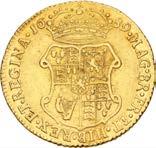
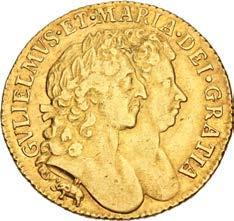
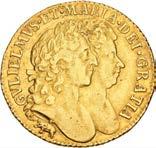

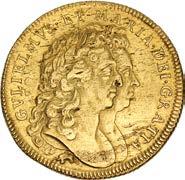
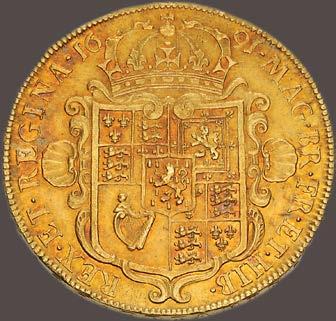

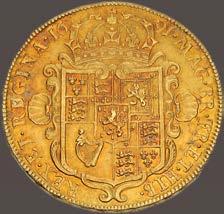
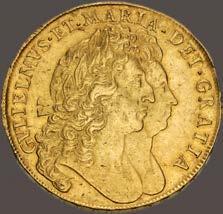
271
1090. STUART (ORANGE). William III & Mary. 1688-1694. AV Five Guineas. Dated 1691 and RY TERTIO. Bull, Gold 344; MCE 136; SCBC 3422. In PCGS encapsulation 47547467, graded AU 53. Excellent surfaces with considerable luster and attractive orange purple toning on reverse. ($25,000)
1091. STUART (ORANGE). William III & Mary. 1688-1694. AV Two Guineas. Dated 1694/3. Bull, Gold 359; MCE 147; SCBC 3425. In PCGS encapsulation 47226824, graded AU Details, cleaned. Toned. Some metal flaws and haymarks. ($7500)
1092. STUART (ORANGE). William III & Mary. 1688-1694. AV Guinea. Dated 1689. Elephant & castle. Bull, Gold 361; MCE 149; SCBC 3427. Warm old tone. In NGC encapsulation 6844930-005, graded AU Details, obverse scratched. ($2500)
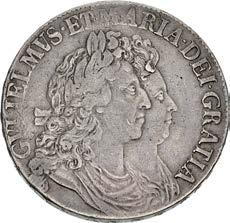
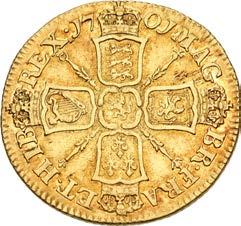
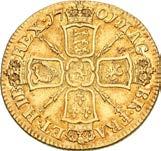
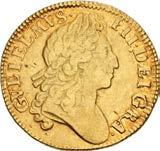
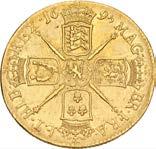
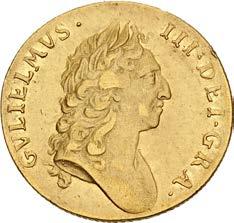
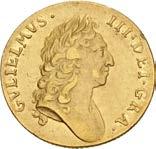
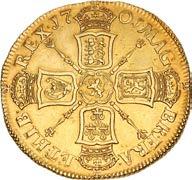
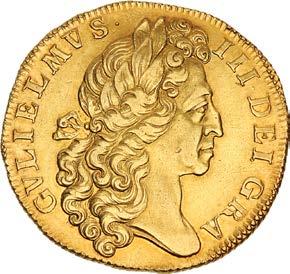

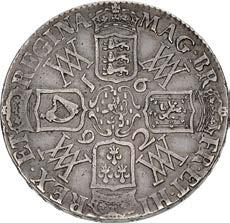
272
1093. STUART (ORANGE). William III & Mary. 1688-1694. AR Crown. Dated 1692 and RY QVARTO. Bull 822; ESC 83; SCBC 3433. Toned. Near VF. ($750)
1094. STUART (ORANGE). William III. 1694-1702. AV Two Guineas. Dated 1701. Bull, Gold 402; MCE 173; SCBC 3457. In NGC encapsulation 6844932-008, graded AU Details, repaired. A small scratch or flaw apparently removed on reverse. Richly toned. ($4000)
1095. STUART (ORANGE). William III. 1694-1702. AV Guinea. Dated 1695. First bust. Bull, Gold 403; MCE 174; SCBC 3458. In NGC encapsulation 6844930-003, graded XF 45. ($1000)
1096. STUART (ORANGE). William III. 1694-1702. AV Guinea. Dated 1701. Second bust. Bull, Gold 425; MCE 186; SCBC 3460. In NGC encapsulation 6844932-002, graded VF 25. A toned coin with even wear. ($1000)
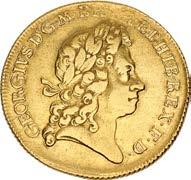
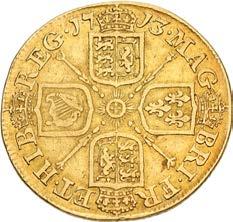
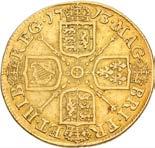
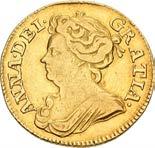
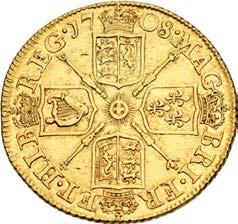
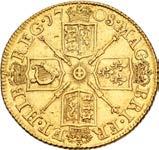
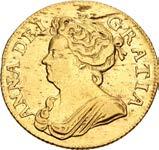
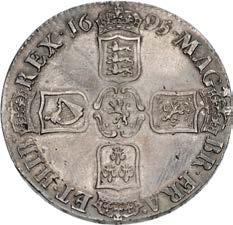
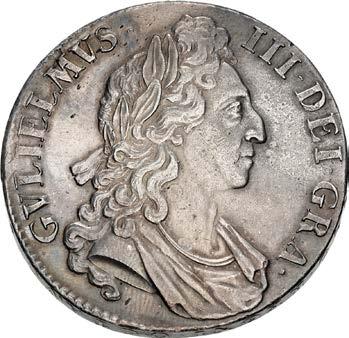
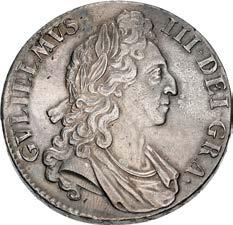
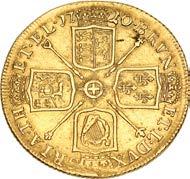
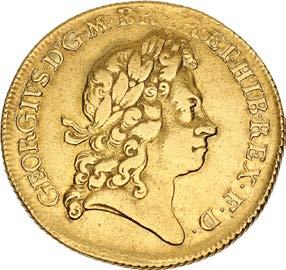
273
1097. STUART (ORANGE). William III. 1694-1702. AR Crown. Dated 1695 and RY OCTAVO. First bust. Bull 991; ESC 87; SCBC 3470. Iridescent toning, hairlines and finger mark. EF. ($750)
1098. STUART. Anne. 1702-1714. AV Guinea. Dated 1708. Second bust. Bull, Gold 470; MCE 218; SCBC 3572. In NGC encapsulation 6844936-002, graded AU Details, obverse cleaned. ($1500)
1099. STUART. Anne. 1702-1714. AV Guinea. Dated 1713. Second bust. Bull, Gold 477; MCE 225; SCBC 3574. In NGC encapsulation 6844930-006, graded VF 35. ($1500)
1100. HANOVER. George I. 1714-1727. AV Two Guineas. Dated 1720/17. Bull, Gold 500; MCE 243; SCBC 3627. In NGC encapsulation 6844932-006, graded AU Details, cleaned. ($3000)
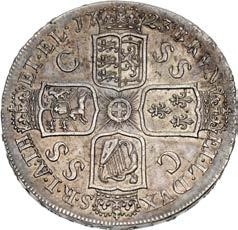
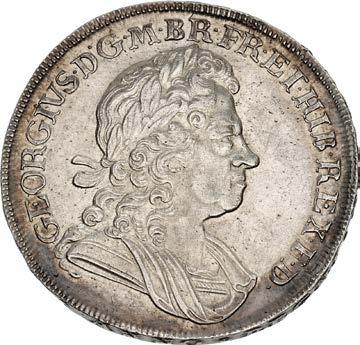
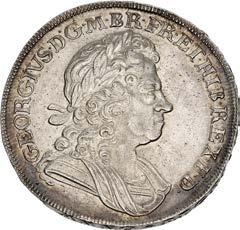
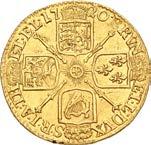
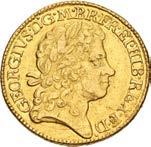
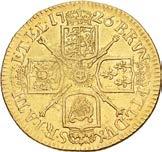


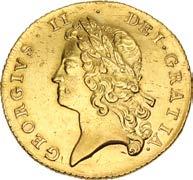
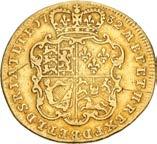
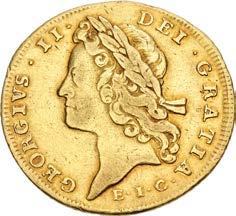
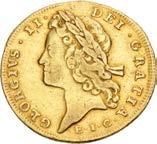
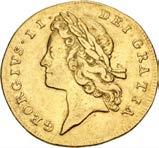

274
1101. HANOVER. George I. 1714-1727. AV Guinea. Dated 1720. Bull, Gold 512; MCE 252; SCBC 3633. Edge nicks, scratch. Good VF. ($1000)
1102. HANOVER. George I. 1714-1727. AV Guinea. Dated 1726. Bull, Gold 525; MCE 261; SCBC 3633. In NGC encapsulation 6844930-002, graded XF Details, obverse repaired. ($750)
1103. HANOVER. George I. 1714-1727. AR Crown. Dated 1723 SSC and RY DECIMO. Bull 1545; ESC 114; SCBC 3640. In NGC encapsulation 6844920-004, graded AU 58. Very well struck with excellent detail. ($4000)
1104. HANOVER. George II. 1727-1760. AV Two Guineas. Dated 1738. Bull, Gold 591; MCE 291; SCBC 3667A. In NGC encapsulation 6844920-001, graded AU Details, repaired. ($1000)
1105. HANOVER. George II. 1727-1760. AV Guinea. Dated 1731. Bull, Gold 586; MCE 303; SCBC 3672. In NGC encapsulation 6844930-001, graded AU Details, cleaned. ($1000)
1101 1102 1104 1105
1106. HANOVER. George II. 1727-1760. AV Guinea. Dated 1732 E.I.C. Bull, Gold 588; MCE 306; SCBC 3673. In NGC encapsulation 6844930-004, graded VF Details, scratches. Rare East India Company issue. ($1000)
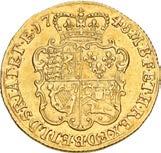


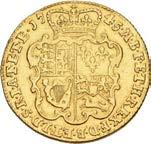
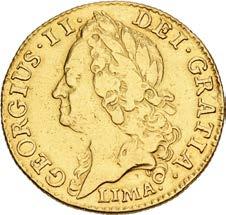

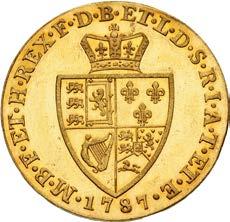
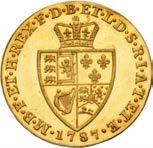

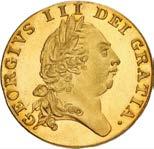
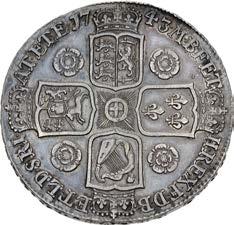
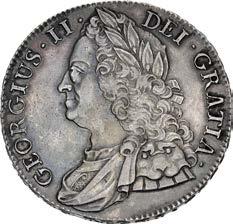
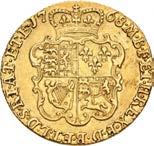
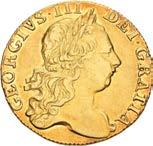
275
1107. HANOVER. George II. 1727-1760. AV Guinea. Dated 1745 LIMA. Bull, Gold 606; MCE 320; SCBC 3679. In NGC encapsulation 6844930-007, graded XF Details, harshly cleaned. Struck from the gold captured by Admiral Anson. Rare. ($1000)
1108. HANOVER. George II. 1727-1760. AV Guinea. Dated 1748. Bull, Gold 611; MCE 323; SCBC 3680. In NGC encapsulation 6844932-004, graded AU 55. Attractively toned. ($2000)
1109. HANOVER. George II. 1727-1760. AR Crown. Dated 1743 and D SEPTIMO. Roses in angles. Bull 1667; ESC 124; SCBC 3688. Richly toned, once cleaned. Good VF. ($750)
1110. HANOVER. George III. 1760-1820. AV Guinea. Dated 1768. Bull, Gold 678; MCE 373; SCBC 3727. Orange peel toning. VF. ($750)
1111. HANOVER. George III. 1760-1820. Proof AV Guinea. Dated 1787. ‘Spade’ type. Edge: plain. W&R 104; Bull, Gold 712; MCE 391; SCBC 3729. Small edge bruise, fields polished in parts. Toned. EF. Slight cameo. ($4000)
1109 1110
Previously catalogued by NGC as ‘Altered Surface’
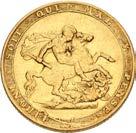
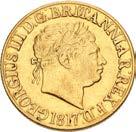
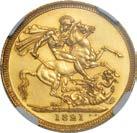
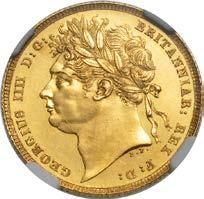
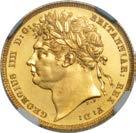
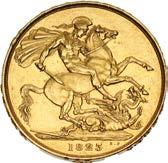
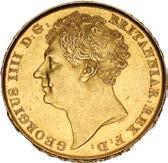
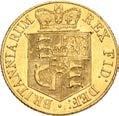
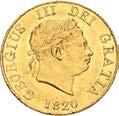
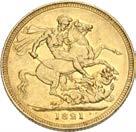

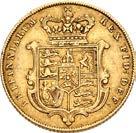

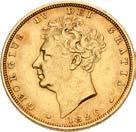
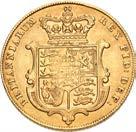
276
1112. HANOVER. George III. 1760-1820. AV Sovereign. Dated 1817. Marsh 1; SCBC 3785A. Good Fine. ($600)
1113. HANOVER. George III. 1760-1820. AV Half Sovereign. Dated 1820. Marsh 402; SCBC 3786. Lustrous, bag marks. EF. ($500)
From the St. George Collection.
1114. HANOVER. George IV. 1820-1830. AV Two Pounds. Dated 1823. SCBC 3798. In NGC encapsulation 6844920002, graded AU Details, cleaned. ($1500)
1115. HANOVER. George IV. 1820-1830. Proof AV Sovereign. Dated 1821. Edge: milled. W&R 231; Marsh 5A; SCBC 3800. In NGC encapsulation 6768860-005, graded Proof Details, cleaned. ($4000)
1116. HANOVER. George IV. 1820-1830. AV Sovereign. Dated 1821. St. George type. Marsh 5; SCBC 3800. Scattered light scratches and marks, small scratch on edge. VF. ($750)
1117. HANOVER. George IV. 1820-1830. AV Sovereign. Dated 1826. Shield type. Marsh 11; SCBC 3801. Reddish toning. Near VF. ($750)
1118. HANOVER. George IV. 1820-1830. AV Sovereign. Dated 1827. Shield type. Marsh 12; SCBC 3801. Toned, some light marks. Near VF. ($500)
From the St. George Collection.
1112 1113 1116 1117
An enigmatic coin. Very well struck. The die finished around chignon unlike most examples encountered of this small date variety.
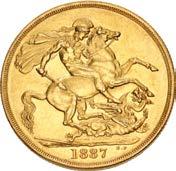
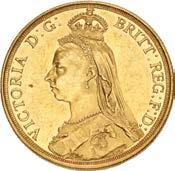
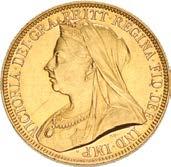
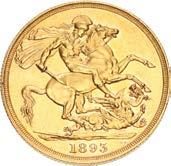
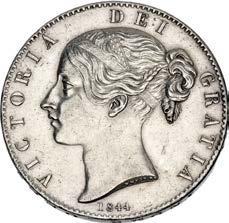

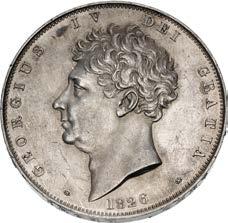
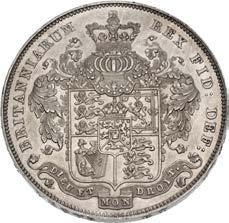
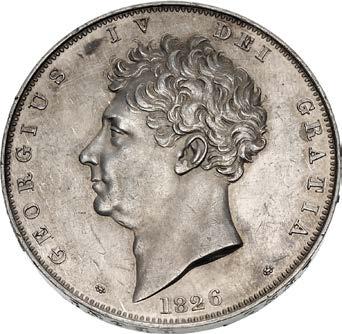
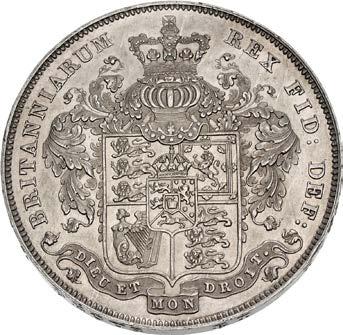

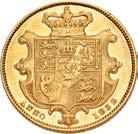
277
1119. HANOVER. George IV. 1820-1830. Proof AR Crown. Dated 1826 and RY SEPTIMO. Bull 2336; ESC 257; SCBC 3806. Toned. In NGC encapsulation 6844920-007, graded PF 58. ($5000) Conservatively graded in our opinion.
1120. HANOVER. William IV. 1830-1837. AV Sovereign. Dated 1832. Second bust. Marsh 17; SCBC 3829B. A few light marks. VF. ($750)
1121. HANOVER. Victoria. 1837-1901. AV Two Pounds. Dated 1887. Jubilee type. SCBC 3865. Light bag marks. Near EF. ($750)
1122. HANOVER. Victoria. 1837-1901. AV Two Pounds. Dated 1893. Old Head type. SCBC 3873. Toned, very light scratches. EF. ($750)
1123. HANOVER. Victoria. 1837-1901. Pattern AR Crown. Dated 1844 and RY VIII. Small date. Star stops on edge. Bull 2654; ESC –. In NGC encapsulation 6844920-006, graded AU Details, cleaned. A very rare pattern striking. ($1000)
1120
1121

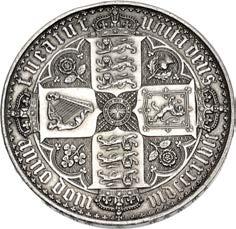
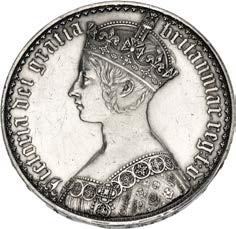
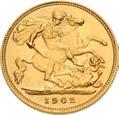
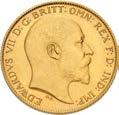
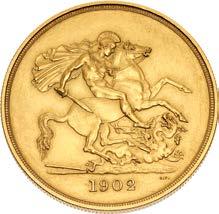

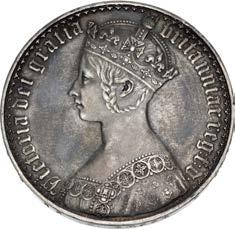
278
1124. HANOVER. Victoria. 1837-1901. Proof AR Crown. Dated 1847 and RY UNDECIMO. Gothic type. Bull 2571; ESC 288; SCBC 3883. Attractive iridescent toning, a few light scratches, minor wear. Proof. ($4000) Ex Davissons E-Auction 29 (24 April 2019), lot 119.
1125. HANOVER. Victoria. 1837-1901. Proof AR Crown. Dated 1847 and RY UNDECIMO. Gothic type. Bull 2571; ESC 288; SCBC 3883. In NGC encapsulation 6844920-005, graded Proof Details, cleaned. ($3000)
1126. SAXE-COBURG-GOTHA. Edward VII. 1901-1910. Matte Proof AV Five Pounds. Dated 1902. W&R 404; SCBC 3966. In NGC encapsulation 6844930-009, graded Proof Details, cleaned. ($2000)
1127. SAXE-COBURG-GOTHA. Edward VII. 1901-1910. Matte Proof AV Half Sovereign. Dated 1902. W&R 411; Marsh 505A; SCBC 3974A. Toned. Proof. ($300)
From the St. George Collection.
(a) AV Five Pounds. W&R 435;
PF 64★.
(b) AV Two Pounds. W&R 437; SCBC 4075. In NGC encapsulation 6529299-001, graded PF 64.
(c) AV Sovereign. Marsh 296B; W&R 439; SCBC 4076. In NGC encapsulation 6529299-002, graded PF 65.
(d) AV Half Sovereign. Marsh 543A; W&R 442; SCBC 4077. In NGC encapsulation 6529299-003, graded PF 64.

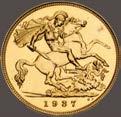
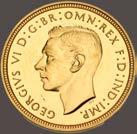
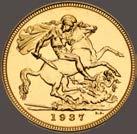
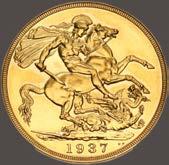
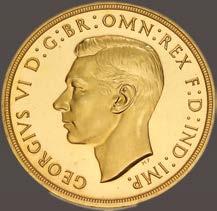
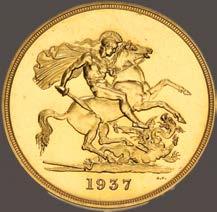

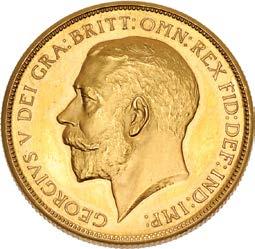
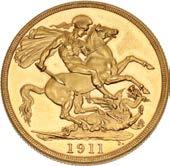
NGC PF 64 to PF 65. A superb matching set. The Five Pounds evidently an early striking with a medallic quality.
With original case of issue and letter from the manager of Barclay’s Bank, Totteridge ordering the coins.
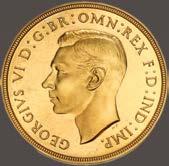
279
1128. WINDSOR. George V. 1910-1936. AV Two Pounds. Dated 1911. W&R 415; SCBC 3955. In NGC encapsulation 6844920-003, graded PF 63 Cameo. ($3000)
1129. WINDSOR. George VI. 1936-1952. Gold Proof Set. Dated 1937. Includes:
SCBC 4074. In NGC encapsulation 6529299-004, graded
($15,000)
a b c d
From the St. George Collection.

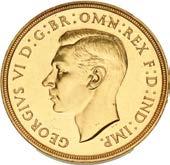
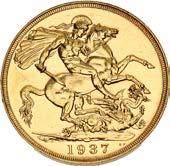
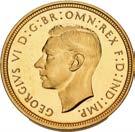

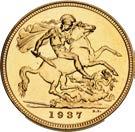
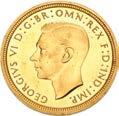
, unicorn standing left, holding coat-of-arms, crown around neck
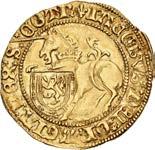
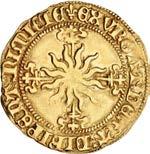
, large twelve-rayed
3 (fig. 627); SCBI 35 (Ashmolean & Hunterian), 817 (same dies) ; SCBC 5315. Slight double strike on obverse
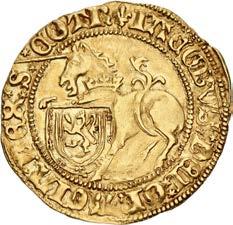
From the Libertas Collection, purchased 14 December 1990.
Toned. Good VF. Rare. ($4000)
280
1130. WINDSOR. George VI. 1936-1952. Proof AV Two Pounds. Dated 1937. W&R 438; SCBC 4075. In NGC encapsulation 6844930-008, graded PF 61. ($1500)
1131. WINDSOR. George VI. 1936-1952. Proof AV Sovereign. Dated 1937. Marsh 296B; W&R 439; SCBC 4076. In NGC encapsulation 6844930-013, graded PF 65★ ($3000)
1132. WINDSOR. George VI. 1936-1952. Proof AV Half Sovereign. Dated 1937. Marsh 543A; W&R 442; SCBC 4077. In NGC encapsulation 6844920-015, graded PF 64. ($1000)
ḹ ĕĚƩ ḹ ŷˆaýƩa ḹ ˆĚҢ ḹ ˫ ḹ ýɨ˸ˆ
/ ჭ ĚҢѝˆŷa˸
ḹ Ě˸ ḹ ĕƩ˫ƩʖN˸ ḹ NƩ⍴ƩýƩĚ
1133. SCOTLAND. James IV. 1488-1513. AV Unicorn (26mm, 3.75 g, 2h). Type I. Edinburgh mint; im: lis. ჭ ƩaýɨBѝ˫
ḹ ĕĚ
star over cross fleurée. Burns
legends.
James VI. 1567-1625. AR Thirty Shillings (35mm, 22.84 g, 6h). Fourth coinage. Edinburg mint. Dated 1583. Crowned and armored bust left, holding sword / Crowned royal coat-of-arms; I R and (XXX in triangle) S (mark of value) across field. Burns 3 (fig. 933); SCBI 58 (Edinburgh), 1461-5; SCBC 5487. Some light scratches and marks under rich old tone. Trace of deposit on reverse. Good VF. A bold example of the type. ($1500)
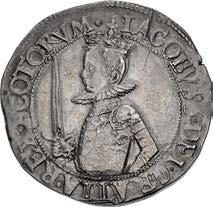
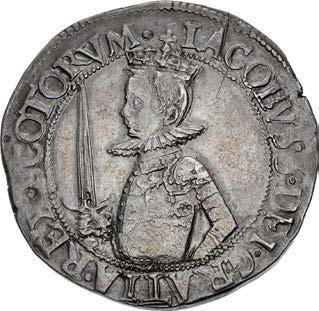
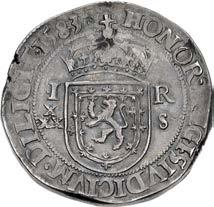
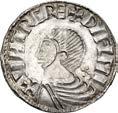
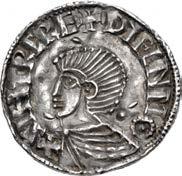
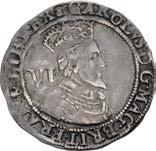
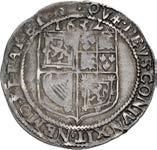

1134.
1135.
Charles I. 1625-1649. AR Six Shillings (26mm, 2.93 g, 5h). Edinburgh mint; im: thistle. Dated 1632. Crowned bust right; VI (mark of value) to left / Coat-of-arms. Burns 4-5 (fig. 999) var. (date); SCBI 35 (Ashmolean & Hunterian) 1418 (same dies); SCBC 5543. Rich old cabinet toning. VF. Very rare. ($1500)
Ex C. Comber Collection; Dix Noonan Webb 104 (5 December 2012), lot 678; J.K.R. Murray (Spink 57, 29 April 1987), lot 335; R.C. Lockett (Part V, Glendining, 18 June 1957), lot 413 (part of); R. Carlyon-Britton Collection; G. Murdoch (Sotheby, Wilkinson, & Hodge, 11 May 1903), lot 318.
1136.
Circa 995-1036. AR Penny (19.5mm, 1.51 g, 2h). Phase I coinage. Imitating Long Cross type of Æthelred II. ‘Lincoln’ mint; ‘Osgut,’ moneyer. Struck circa 995-1020. Draped bust left; pellet-in-rosette to right / ม ∂Ӳ ű⎍ዡ ዦቸ∂ ⌦ዢn∂ , voided long cross, with pellet at center and triple-crescent ends. SCBI 8 (BM), –; SCBI 22 (Copenhagen), –; SCBI 32 (Ulster), –; D&F 6; SCBC 6104. Toned, peckmarks, wavy flan. VF. Extremely rare with this moneyer named. Unpublished in the standard references. ($1500)
Ex ‘Good Money’ Collection (Noonans 259, 27 September 2022), lot 513, purchased from C.J. Denton. Ex W.J. Conte Collection; S.N. Lane (Spink 23, 21 September 1982), lot 6; A.N. Brushfield (Glendining’s, 28 March 1940), lot 132 (part of).
1137. IRELAND, Hiberno-Norse. Sihtric III Olafsson. Circa 995-1036. AR Penny (19mm, 1.48 g, 6h). Phase II coinage. Imitating Long Cross type of Æthelred II. Dublin mint; ‘Car,’ moneyer. Struck circa 1015-1035. Draped bust left; quatrefoil of pellets to right / ม ü¥ʽ ዦn ∂ ዝӎዟ ⌦ዢnʽ , voided long cross, with pellet at center and triple-crescent ends; pellets in quarters. SCBI 8 (BM), –; SCBI 22 (Copenhagen), 57; SCBI 32 (Ulster), 37 (same dies); D&F 23; SCBC 6122. EF. Rare moneyer. ($1000)
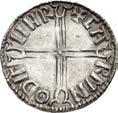
Ex ‘Good Money’ Collection (Noonans 259, 27 September 2022), lot 520.
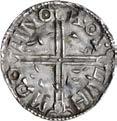
281
SCOTLAND.
From the James Fox Collection.
SCOTLAND.
IRELAND, Hiberno-Norse. Sihtric III Olafsson.
1138. IRELAND. Sihtric III Olafsson. Circa 995-1036. AR Penny (19mm, 1.26 g, 12h). Phase II coinage. Imitating Long Cross type of Æthelred II. Dublin mint; ‘Færemin,’ moneyer. Struck circa 1015-1035. Draped bust left; cross pattée to right / ม ዟ ® ʽዞዦዢ n ዦณ∂ ዝӎዟ⌦ዢ , voided long cross, with pellet at center and triple-crescent ends; pellets in quarters. SCBI 8 (BM), 64-6; SCBI 22 (Copenhagen), 59; SCBI 32 (Ulster), 41 (same rev. die); D&F 23; SCBC 6122. Deep iridescent toning. Near EF. Superb portrait. ($1500)
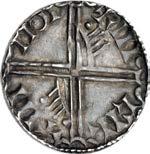
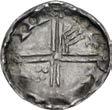
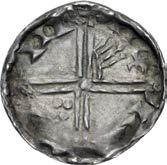

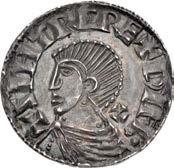
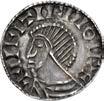
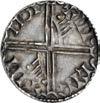
Ex ‘Good Money’ Collection (Noonans 259, 27 September 2022), lot 521 and front cover, purchased from C.J. Martin. The cover coin of the ‘Good Money’ Collection.
1139.
1035-1055/60. AR Penny (16mm, 1.07 g, 10h). Phase III coinage, Long Cross type. Draped bust left / Voided long cross, with triple crescent ends; ‘hand’ symbols in second and third quarters. SCBI 8 (BM), 83 (same dies); SCBI 22 (Copenhagen), 106-7 (same rev. die); SCBI 32 (Ulster), 134 (same rev. die); D&F 24; SCBC 6132. Richly toned. Near EF. ($750)
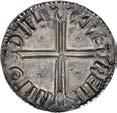
Ex ‘Good Money’ Collection (Noonans 259, 27 September 2022), lot 534; G.W. de Wit (Part III, Künker 137, 11 March 2008), lot 3307.
1140.
Hiberno-Norse. Phase V. Circa 1065-1085/95. AR Penny (18mm, 0.97 g). Phase V coinage, Long Cross type. Draped bust left; X to left / Voided long cross, with triple crescent ends; ‘hand’ symbol and quatrefoil of pellets in opposing quarters. SCBI 8 (BM), 208; SCBI 22 (Copenhagen), –; SCBI 32 (Ulster), –; D&F 28; SCBC 6138. Toned, flat strike with areas of weakness. VF. Extremely rare. ($1000)
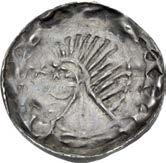
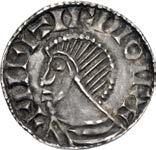
Ex ‘Good Money’ Collection (Noonans 259, 27 September 2022), lot 563.

282
IRELAND, Hiberno-Norse. Phase III. Circa
IRELAND,
Pedigreed Inchiquin Money
: 8” (denomination) in two lines within linear and beaded border. D&F 217; SCBC 6532. Old cabinet toning, minor marks and scratches, usual areas of weakness. VF. Rare. ($4000)
Ex Michael Gietzelt (Dix Noonan Webb 195, 22 September 2021), lot 176 (hammer £5500); Spink Numismatic Circular CIII.8 (October 1995), no. 5600; Classical Numismatic Group 34 (6 May 1995), lot 520.
Following the increase in ethnic and religious discrimination against the native Irish population during the first third of the seventeenth century, an open rebellion exploded in October 1641 as two Protestant Lords Justices had prevented the Irish parliament from passing a bill which would have alleviated Catholic grievances. Though the rebel forces failed in their attempt to seize Dublin Castle, they quickly found success at Ulster, whence the rebellion spread around the countryside. Following the outbreak of civil war between King Charles and the English parliament the next year in 1642, the rebel forces of Irish Catholics gave their support to the King, further placing them at odds with the English Protestants.
An emergency coinage was first issued during this period under the Lords Justices, with various denominations struck on cut pieces of flattened plate, commonly referred to as ‘Inchiquin Money’ after Lord Inchiquin, who was appointed to command the Protestant forces at Munster. The later issues of this coinage continued with more regular flans, though acknowledged allegiance to Charles with a crowned ‘C R’ on their obverses. Known as ‘Ormonde Money,’ they were named after the Earl of Ormonde, who was appointed Lieutenant of Ireland in 1643.
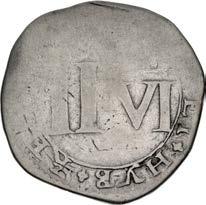
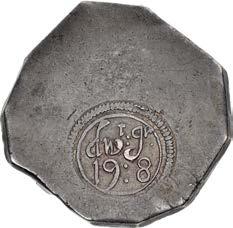
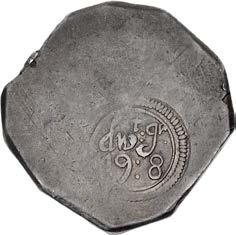
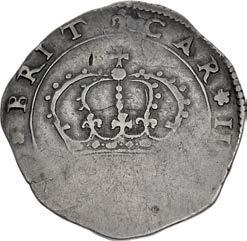
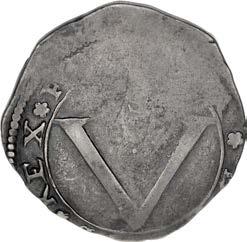
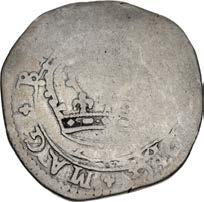
Ex ‘Good Money’ Collection (Noonans 259, 27 September 2022), lot 789; H.E.G.
February 1906),
134.
September
Ex ‘Good Money’ Collection (Noonans 259, 27 September 2022), lot 790; Ex Millennial Collection (Whyte’s, 29 April 2000), lot 263;
283
1141. IRELAND, The Great Rebellion. Issues of the Lords Justices. 1642-1649. AR Crown (36mm, 30.57 g, 6h). “Inchiquin Money,” first issue. Dublin mint. Struck 1642. “dwt: gr · 19 : 8” (denomination) in two lines within linear and beaded border / “dwt: gr · 19
1142. IRELAND, The Great Rebellion. Issues of the Lords Justices. 1642-1649. AR Crown (42mm, 25.44 g, 6h). Ormonde Money. Struck in the name of Charles II, 1649. Large crown / Large V; S above. D&F 336; SCBC 6553. Toned, scratches, usual areas of weak strike. VF. ($2000)
Paget (Glendining’s, 25
1946), lot 154; T.W. Barron (Sotheby, Wilkinson, & Hodge, 27
lot
1143. IRELAND, The Great Rebellion. Issues of the Lords Justices. 1642-1649. AR Halfcrown (33mm, 14.39 g, 12h). Ormonde Money. Struck in the name of Charles II, 1649. Large crown / V II; [S D above]. D&F 337; SCBC 6554. Toned, scratches, usual areas of weak strike. Fine. Very rare. ($1000)
Bridgewater House (Sotheby’s, 15 June 1972), lot 579.
1144. IRELAND. George III. 1760-1820. AR Six Shillings Token. Soho (Birmingham) mint. Dated 1804. D&F 614; SCBC 6615. Toned, a few light hairlines. EF. Overstruck on a Spanish American 8 Reales with traces of undertype visible. ($500)
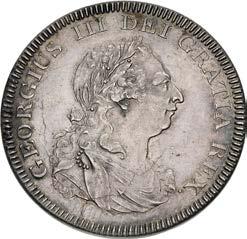
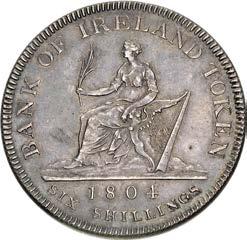
1145. ANGLO-GALLIC. Edward the Black Prince. As Prince of Aquitaine, 1362-1372. AV Léopard d’or (28mm, 3.49 g, 9h). Crowned lion left within tressure of arches; quatrefoils in spandrels, mullet in one spandrel / cross fleurée with voided quatrefoil at center; leopards in angles; all within polylobe with quatrefoils in spandrels. AGC 150, 1/a; Schneider 31; SCBC 8121. In NGC encapsulation 6844920-011, graded AU 55. Minor metal flaws. Rare. ($2500)
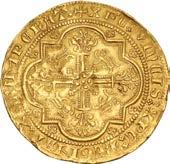
From the St. George Collection, purchased from Sovereign Rarities. Ex Commander Gerhardt (Spink 215, 4 December 2012), lot 133.
1146. ANGLO-GALLIC. Henry VI. 1422-1461. AV Salut d’or (27mm, 3.50 g, 9h). Second type. Paris mint. Struck 1422-1436. The Annunciation: the Virgin standing right, receiving tablet inscribed ¥ѝĚ from the Archangel Gabriel standing left; heavenly light above, two coats-of-arms below / Latin cross, with lis to left, lion passant guardant to right, and ƌ below; all within polylobe, with lis in each point. AGC 385B, 1/a; SCBC 8164. Toned, cleaned. Good VF. ($1500)
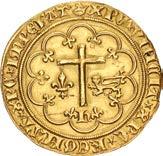

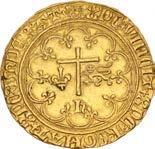
1147. ANGLO-GALLIC. Henry VI. 1422-1461. AV Salut d’or (26mm, 3.46 g, 8h). Second type. Rouen mint; im: leopard. Étienne Marcel, mintmaster. Second issue, 1433-1444. The Annunciation: the Virgin standing right, receiving tablet inscribed ¥ѝĚ from the Archangel Gabriel standing left; heavenly light above, two coats-of-arms below; pellet-in-annulet under last letter of legend / Latin cross, with lis to left, lion passant guardant to right, and ƌ below; all within polylobe, with lis in each point; pellet-in-annulet under last letter of legend. AGC 386F, 1/b; SCBC 8164. In NGC encapsulation 6844920-014, graded MS 62. ($1500)
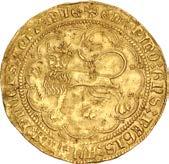
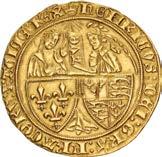
From the St. George Collection. Ex Classical Numismatic Group inventory 854972 (September 2009); Trésor de la guerre de cent ans (Beaussant Lefèvre, 30 June 2009), lot 337.
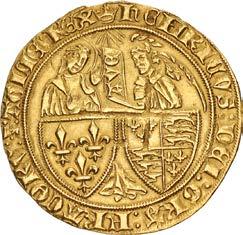
284
1148. ANGLO-GALLIC. Henry VI. 1422-1461. AV Salut d’or (26.5mm, 3.49 g, 12h). Second type. Rouen mint; im: leopard. Étienne Marcel, mintmaster. Second issue, 1433-1444. The Annunciation: the Virgin standing right, receiving tablet inscribed ¥ѝĚ from the Archangel Gabriel standing left; heavenly light above, two coats-of-arms below; pellet-in-annulet under last letter of legend / Latin cross, with lis to left, lion passant guardant to right, and ƌ below; all within polylobe, with lis in each point; pellet-in-annulet under last letter of legend. AGC 386F, 1/b; SCBC 8164. Underlying luster. EF. ($1500)
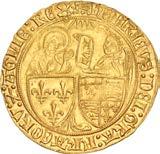
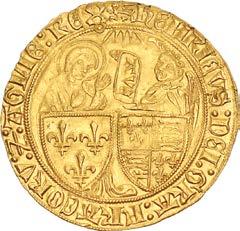
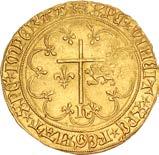
Ex WRG Collection (Classical Numismatic Group Electronic Auction 431, 24 October 2018), lot 631; Classical Numismatic Auctions XII (26 September 1990), lot 1309.
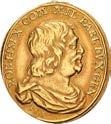
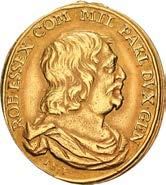

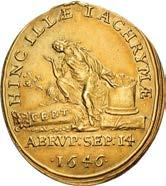
BRITISH MEDALS
1149. STUART. Robert Devereux, 3rd Earl of Essex. 1591-1646. AV Oval Medalet (19mm, 4.52 g, 12h). On His Death. By Thomas Simon. Dated 14 September 1646. ROB : ESSEX : COM MIL · PARL : DVX · GEN :, bareheaded and draped bust right; · T S · F · below / HINC · ILLÆ · LACHRYMÆ ·, Grief seated on ground between broken and fallen pillar with right foot on column and left hand on base, raising right hand in mourning; column inscribed F · E · R · T (for fortitudo eius rempublicam tenuit); ABRVP : SEP : 14/·1646 · in two lines in exergue. Platt II Type C and pp. 88-92; MI 327/167 (this medal cited); Eimer –. Attractive red toning, trace of original suspension loop. Good VF. Extremely rare. ($7500)
Ex North Yorkshire Moors [M. Lessen] (Part IV, Dix Noonan Webb 186, 21 January 2021) lot 1165; An Important Collection of Stuart Badges and British Commemorative Medals, the Property of a Gentleman (Spink 120, 9 July 1997), lot 343; A Fine Collection of British Historical and Commemorative Medals (Sotheby’s, 9 March 1989), lot 39; Greta Heckett (Sotheby’s, 25 May 1977), lot 213; J.G. Murdoch (Part IV, Sotheby, Wilkinson & Hodge, 2 June 1904), lot 64; T.M. Whitehead (Part IV, Sotheby, Wilkinson & Hodge, 5 May 1898), lot 42.
285
1150. COMMONWEALTH. Oliver Cromwell. Lord Protector, 1653-1658. AV Medal (29mm, 16.66 g, 11h). On his death. Of uncertain Dutch manufacture. Dated 3 September 1658. OLIVAR . D . G . RP . ANG . SCO . HIB . PRO, laureate and draped bust left / NIN . DEFITIENT . OLIVA . SEP 3 1658, tall olive tree with shepherd tending his flock below. Edge: plain. MI 434/84; Eimer 201. In NGC encapsulation 6529316-001, graded MS 62 DPL. A superb medal with a cameo effect. ($7500)
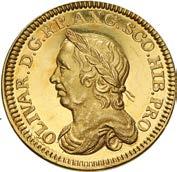
1151. HANOVER. George I. 1714-1727. AV Medal (36mm, 21.59 g, 12h). Coronation. By J. Croker. Dated 20 October 1714 (in Roman numerals). GEORGIVS · D : G · MAG · BR · FR · ET · HIB · REX ·, laureate, draped, and armored bust right / George seated right on throne, being crowned by Britannia standing left, holding spear and shield; in two lines in exergue, INAVGVRAT · XX · OCT ·/MDCCXIIII ·. MI 424/9; Eimer 470. A few tiny marks and hairlines. Superb EF. In original redvelvet lined case. A lovely gold coronation medal of the first Hanoverian king. ($5000)
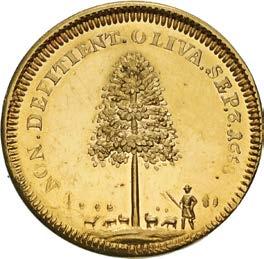
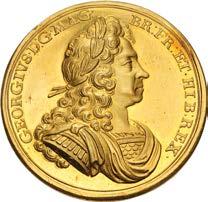
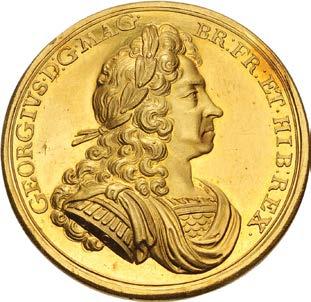
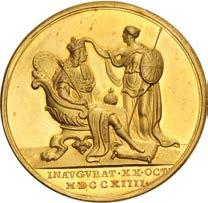

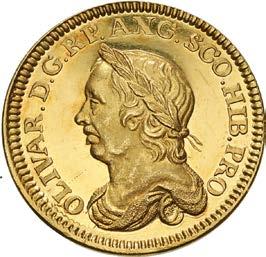
End of Session 4
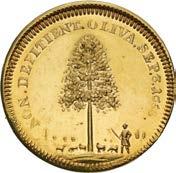
286
Banti
BMC
BMCRE
BN
Bodenstedt
Boehringer
Bopearachchi
Depeyrot
Calicó
CNS
Crawford
CRI
Fischer-Bossert
Flament
Hendin
HN Italy
Kumar
Meshorer
GENERAL BIBLIOGRAPHY
Please refer to our online bibliography at www.cngcoins.com for a complete listing of specialized and general references used, and abbreviations.
ANCIENT
A. Banti. I grandi bronzi imperiali. 9 Vols. Florence. 1983-1986.
Various authors. Catalogue of Greek Coins in the British Museum. 29 Vols. London. 1873-1927.
H. Mattingly et al. Coins of the Roman Empire in the British Museum. 6 Vols. London. 1932-1962.
J. Giard. Bibliothèque Nationale, catalogue des monnaies de l’empire romain. 3 Vols. Paris. 1976-present.
F. Bodenstedt. Die Elektronmünzen von Phokaia und Mytilene. Tübingen. 1981.
E. Boehringer Die Münzen von Syrakus. Berlin and Leipzig. 1929.
O. Bopearachchi. Monnaies Gréco-Bactriennes et Indo-Grecques. Paris. 1991.
G. Depeyrot. Les monnaies d’or (Diocletian à Constantin I, Constantin II à Zenon). Wetteren. 1995-1996.
X. Calicó. The Roman avrei catalogue. 2 Vols. Barcelona. 2002.
R. Calciati. Corpus Nummorum Siculorum: la monetazione di bronzo. 3 Vols. Italy. 1983-87.
M. Crawford. Roman Republican Coinage. 2 Vols. Cambridge. 1974.
D. Sear The History and Coinage of the Roman Imperators 49-27 BC. London. 1998.
W. Fischer-Bossert. Chronologie der Didrachmenprägung von Tarent 510-280 v.Chr. Berlin 1999.
C. Flament. Le monnayage en argent d’Athènes. De l’époque archaïque à l’époque hellénistique (c. 550-c. 40 av. J.-C.). Lovainla-Neuve. 2007.
D. Hendin. Guide to Biblical Coins 6th Edition. New York. 2021.
N.K. Rutter, ed. Historia Numorum. Italy. London. 2001.
S. Kumar. Treasures of the Gupta Empire. A Catalogue of Coins of the Gupta Dynasty. San Francisco. 2017.
Y. Meshorer. A Treasury of Jewish Coins from the Persian Period to Bar Kokhba Jerusalem. 2001.
MK R. Göbl. Münzprägung des Kušanreiches. Vienna. 1984.
MIR
Price
Prieur
R. Göbl, et al. Moneta Imperii Romani. 5 Vols. Vienna. 1984-present.
M.J. Price. The Coinage in the Name of Alexander the Great and Philip Arrhidaeus London. 1991.
M. Prieur A type corpus of the Syro-Phoenician tetradrachms and their fractions from 57 BC to AD 253. Lancaster. 2000.
RIC H. Mattingly, et al. The Roman Imperial Coinage. 10 Vols. London. 1923-1994.
RPC
RSC
SC
A. Burnett, et al. Roman Provincial Coinage. 3 Vols and 2 Suppls. London and Paris. 1992-present.
D. Sear, et al. Roman Silver Coins. 5 Vols. London. 1978-1987.
A. Houghton & C. Lorber. Seleucid Coins: A Comprehensive Catalog 2 Parts. Lancaster. 2002 and 2008.
Sellwood D. Sellwood. An Introduction to the Coinage of Parthia. 2nd edition. London. 1980.
SNG ANS Sylloge Nummorum Graecorum, American Numismatic Society. New York. 1969-present.
SNG BM Black Sea Sylloge Nummorum Graecorum, British Museum, 1: The Black Sea London. 1993.
SNG Copenhagen Sylloge Nummorum Graecorum, Danish National Museum. Copenhagen. 1942-1979.
SNG BN Sylloge Nummorum Graecorum, Cabinet des Médailles, Bibliothèque Nationale. Paris. 1993-2001.
SNG Kayhan Sylloge Nummorum Graecorum, Turkey 1: The Muharrem Kayhan Collection Istanbul. 2002.
SNG Levante Sylloge Nummorum Graecorum, Switzerland; E Levante - Cilicia. Bern. 1986.
SNG Lloyd Sylloge Nummorum Graecorum, Lloyd Collection. London. 1933-1937.
SNG Lockett Sylloge Nummorum Greacorum, Lockett Collection. London. 1938-1949.
SNG München Sylloge Nummorum Graecorum, München Staatlische Münzsammlung. Berlin. 1968-present.
SNG von Aulock Sylloge Nummorum Graecorum, Sammlung Hans Von Aulock Berlin. 1957-1968.
Starr C. Starr Athenian coinage 480-449 BC. London. 1970.
Svoronos
Traité
Weidauer
J. Svoronos. Τὰ νομίσματα τοῦ κράτους τῶν Πτολεμαίων. Athens. 1904-08.
E. Babelon. Traité des monnaies grecques et romaines 9 Vols. Paris. 1901-1932.
L. Weidauer. Probleme der frühen Elektronprägung. Fribourg. 1975.
BYZANTINE, MEDIEVAL, WORLD, and BRITISH
Album
Biaggi
Bitkin
BMC Vandals
CIS
S. Album. A Checklist of Popular Islamic Coins. 3rd ed. Santa Rosa. 2011.
E. Biaggi. Monete e zecche medievali italiane dal seculo VIII al seculo XV. Torino. 1992.
V. Bitkin. Composite Catalogue of Russian Coins. 2 vols. Kiev. 2003.
W. Wroth. Catalogue of the Coins of the Vandals, Ostrogoths and Lombards and of the Empires of Thessalonica, Nicaea and Trebizond in the British Museum London. 1911. (Reprinted as Western and Provincial Byzantine Coins in the British Museum.)
S. Goron and J.P. Goenka. The Coins of the Indian Sultanates. New Delhi. 2001.
CNI Corpus Nummorum Italicorum. 20 Vols. Rome. 1910-1943.
Davenport
J.S. Davenport. Various works on European crowns.
ESC H.A. Seaby & P.A. Rayner. The English Silver Coinage from 1649. London. 1992.
Friedberg
KM
Levinson
Lunardi
MEC
R. Friedberg. Gold Coins of the World. 8th ed. Clifton. 2009.
C.L. Krause & C. Mishler Standard Catalogue of World Coins Krause Publications. Iola.
R.A. Levinson. The Early Dated Coins of Europe. Clifton, NJ. 2007.
G. Lunardi. Le monete delle repubblica di genova. Genoa. 1975.
P. Grierson & M. Blackburn. Medieval European Coinage. Cambridge. 1986.
MIB W. Hahn. Moneta Imperii Byzantini. 3 Vols. Vienna. 1973-81.
MIBE W. Hahn and M.A. Metlich. Money of the Incipient Byzantine Empire Vienna. 2000.
MIR Various. Monete Italiane Regionali. 5 Vols. Pavia. ND.
NM G. Depeyrot. Le numéraire mérovingien. 5 vols. Wetteren. 1998-2001.
North J.J. North. English Hammered Coinage 2 Vols. London. 1963, 1975.
SB D. Sear, et al. Byzantine Coins and Their Values. 2nd edition. London. 1987.
SCBC Standard Catalogue of British Coins. London. Annually.
SCBI Various authors. Sylloge of the Coins of the British Isles.
287
288
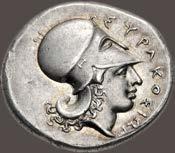
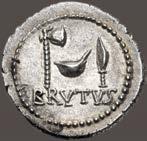
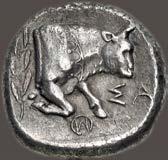
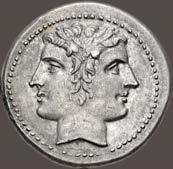
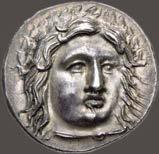
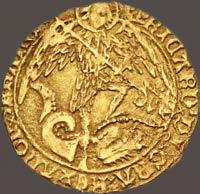
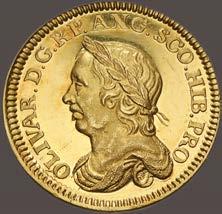
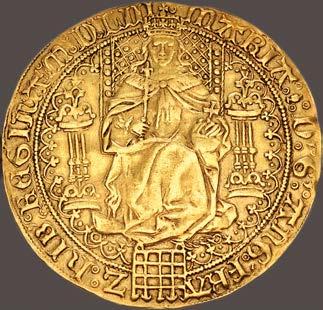
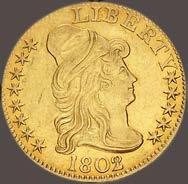
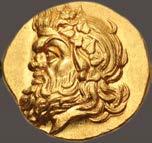
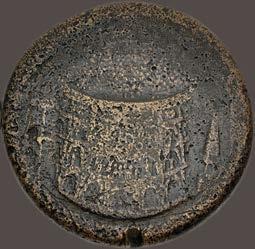
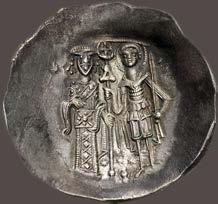
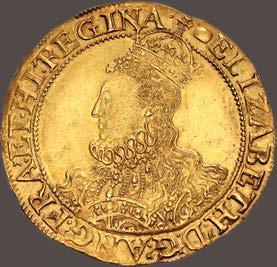
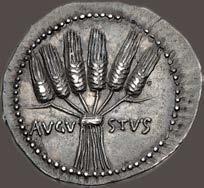
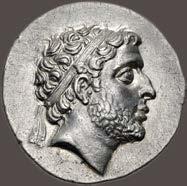
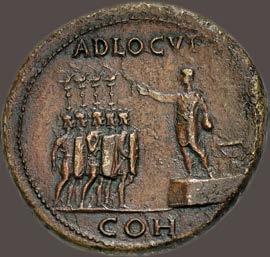
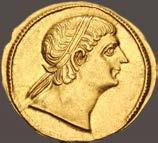
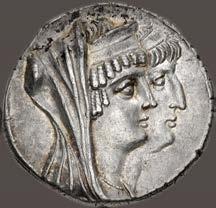
CNG Classical Numismatic Group, LLC Classical Numismatic Group, LLC (PA License Number AY002406) Jeffrey B. Rill (PA License No. AU006206); Brian Callahan (PA License No. AU005870) US OFFICE PO Box 479, Lancaster, PA 17608-0479 Phone (717) 390.9194 Fax (717) 390.9978 UK OFFICE 20 Bloomsbury Street, London WC1B 3QA, UK Phone +44.20.7495.1888 Fax +44.20.7499.5916 EU OFFICE Noordeinde 64a, 2514GK The Hague, NL Phone +31.85.1301541 EMAIL & WEBSITE Email cng@cngcoins.com Website www.cngcoins.com


































 Mike Gasvoda Managing Director Lancaster Office
Steve Pruzinsky Chief Financial Officer Lancaster Office
Victor England Consulting Director Lancaster Office
Eric McFadden Consulting Director London Office
Dave Michaels Director Shows & Consignments Lancaster Office
Mike Gasvoda Managing Director Lancaster Office
Steve Pruzinsky Chief Financial Officer Lancaster Office
Victor England Consulting Director Lancaster Office
Eric McFadden Consulting Director London Office
Dave Michaels Director Shows & Consignments Lancaster Office




















































































































































































































































































































































































































































































































































































































































































































































































































































































































































































































































































































































































































































































































 Lot 494
Hercules Musagetes Conductor of the Muses
Lot 495
Calliope Muse of Epic Poetry
Lot 496
Clio Muse of History
Lot 497
Melpomene Muse of Tragedy
Lot 498 Euterpe Muse of Music and Poetry
Lot 499 Erato Muse of Erotic Poetry
Lot 500
Terpsichore Muse of Dance
Lot 501
Terpsichore Muse of Dance
Lot 502 Urania Muse of Astronomy
Lot 503 Thalia Muse of Comedy
Lot 504 Polyhymnia Muse of Divine Hymns and Sacred Poetry
Lot 494
Hercules Musagetes Conductor of the Muses
Lot 495
Calliope Muse of Epic Poetry
Lot 496
Clio Muse of History
Lot 497
Melpomene Muse of Tragedy
Lot 498 Euterpe Muse of Music and Poetry
Lot 499 Erato Muse of Erotic Poetry
Lot 500
Terpsichore Muse of Dance
Lot 501
Terpsichore Muse of Dance
Lot 502 Urania Muse of Astronomy
Lot 503 Thalia Muse of Comedy
Lot 504 Polyhymnia Muse of Divine Hymns and Sacred Poetry




























































































































































































































































































































































































































































































































































































































































































































































































































































































































































































































































































































































































































































































































































































































































































































































































































































































































































